Satellite Docking Experiment (SpaDeX)

- 17 Jan 2025
In News:
The Indian Space Research Organisation (ISRO) achieved a historic milestone by successfully executing a satellite docking experiment, making India the fourth country after the United States, Russia, and China to accomplish this feat. This advancement represents a significant leap in India's space capabilities, positioning the nation at the forefront of space exploration and in-orbit servicing.
Key Highlights:
- The Space Docking Experiment (SpaDeX) is a critical technological demonstration by ISRO aimed at developing autonomous docking and undocking capabilities in space.
- The mission involves two satellites, SDX01 (Chaser) and SDX02 (Target), which were launched aboard PSLV C60 on December 30, 2024.
- The docking maneuver was overseen by the Mission Operations Complex (MOX) at the ISRO Telemetry, Tracking, and Command Network (ISTRAC) and was successfully completed in the early hours of January 18, 2025.
Key Steps in the Docking Process:
- Manoeuvre from 15m to 3m hold point.
- Precision docking initiation, leading to spacecraft capture.
- Retraction and rigidization for stability.
- Successful control of the docked satellites as a single object.
Significance of the Mission
- Technological Advancement: The docking of two spacecraft in orbit is a crucial capability that paves the way for:
- Autonomous spacecraft operations
- Refueling and maintenance of satellites
- Space station development
- Lunar and interplanetary missions
Future Applications
- Manned Missions: Enables India to develop technology for manned lunar missions and future space station operations.
- Satellite Servicing: Allows repair, maintenance, and extension of satellite lifespan, reducing costs and space debris.
- Sample Return Missions: Essential for lunar and planetary sample retrieval, crucial for deep-space exploration.
Challenges and Overcoming Setbacks
The SpaDeX docking was initially scheduled for January 7, 2025, but was postponed due to the need for further ground validation and an unexpected drift between the satellites. The issue was later resolved, and the docking was executed with precision.
The Road Ahead
Undocking and Power Transfer Demonstration
- ISRO will follow up with power transfer checks between the docked satellites.
- The satellites will later undock and operate separately for the remaining mission duration of up to two years.
Expanding Space Capabilities
- The successful execution of SpaDeX aligns with India’s plans for an independent space station by the 2030s.
- Strengthens India’s position in international space collaborations and commercial space services.
Conclusion
The SpaDeX mission represents a landmark achievement for India’s space program, placing it among the elite nations capable of satellite docking. This breakthrough will serve as a foundation for India’s ambitious future missions, including deep-space exploration, human spaceflight, and interplanetary research. As ISRO continues to develop advanced space technologies, India is set to play a crucial role in the future of global space exploration.
Unified District Information System for Education Plus (UDISE+) Report
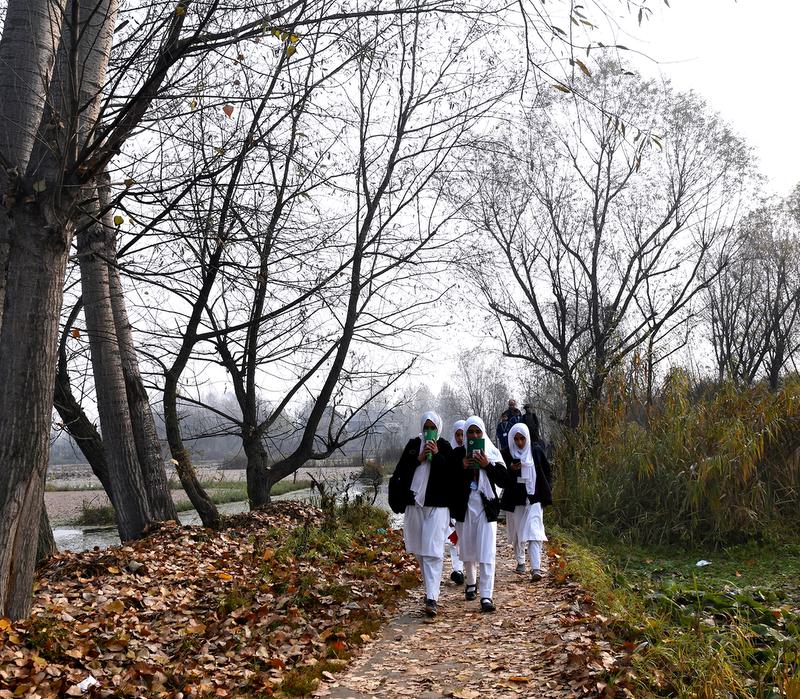
- 10 Jan 2025
In News:
The Unified District Information System for Education Plus (UDISE+) report for 2023-24 reveals a significant decline in school enrolment across India, highlighting critical challenges in the education sector. The total enrolment in grades 1-12 fell by over 1.55 crore students, from 26.36 crore (2018-2022 average) to 24.8 crore in 2023-24. This represents a 6% drop, with the biggest declines occurring in government schools.
Key Findings:
- Enrolment Decline:
- In 2023-24, enrolment decreased from 25.17 crore in 2022-23 to 24.8 crore.
- The drop was not only in government schools (5.59%) but also in private schools (3.67%).
- States like Bihar, Uttar Pradesh, and Maharashtra saw the largest decreases.
- The decline in enrolment is despite an increase in the number of schools, from 14.66 lakh in 2022 to 14.72 lakh in 2023.
- Methodology Change:
- A significant change in the data collection methodology occurred in 2022-23, including linking enrolment to Aadhaar numbers, aimed at reducing data duplication.
- While this has improved data accuracy, it has also led to the removal of inflated figures, explaining part of the enrolment drop.
- Despite these changes, there has been a notable decline of 37 lakh students from 2022-23 to 2023-24, which remains unexplained in the report.
- Gender and Age Trends:
- Boys’ enrolment declined by 6.04%, and girls’ by 5.76%, reflecting a uniform drop across gender groups.
- The dropout rates increase as students progress through school, with the highest dropout at the secondary level.
- Infrastructure and Facilities:
- While most schools have basic facilities like electricity and gender-specific toilets, advanced infrastructure like functional computers (57%) and internet access (53%) is lacking in nearly half of schools.
- This technological gap exacerbates regional disparities and affects educational quality, particularly in rural areas.
- State-Specific Impact:
- Jammu and Kashmir, Assam, Uttar Pradesh, and Madhya Pradesh saw the highest reductions in the number of schools.
- Many school closures or mergers have led to increased distances for students, causing further dropouts during re-admission processes.
Socio-Economic Barriers:
- Economic hardships, migration, and inadequate facilities contribute to the enrolment decline.
- Low-income families and backward regions struggle to prioritize education, further affecting enrolment and retention.
Government Initiatives:
- Initiatives like the National Education Policy (NEP) 2020, Sarva Shiksha Abhiyan, and Right to Education Act (RTE) have made strides in primary education but face challenges in secondary education.
- Education spending has hovered around 4-4.6% of GDP, which is insufficient to meet the needs of the education system.
Moving Forward:
- Targeted Interventions: Focus on expanding vocational training, incentivizing school attendance, and improving digital infrastructure in schools.
- Address Regional Disparities: Conduct audits to address school shortages in densely populated areas and consolidate underutilized urban schools.
- Enhancing Teacher Quality: Invest in teacher training and encourage innovative teaching methods.
- Community Engagement: Promote local participation in school management to address specific educational needs.
Conclusion:
The UDISE+ 2023-24 report underscores the need for urgent reforms in India's education system, focusing on increasing enrolment, reducing dropout rates, and ensuring equitable access to quality education. By addressing these challenges with targeted policies, India can move closer to achieving its educational goals.
Implications of China’s Mega-Dam Project on the Brahmaputra River Basin
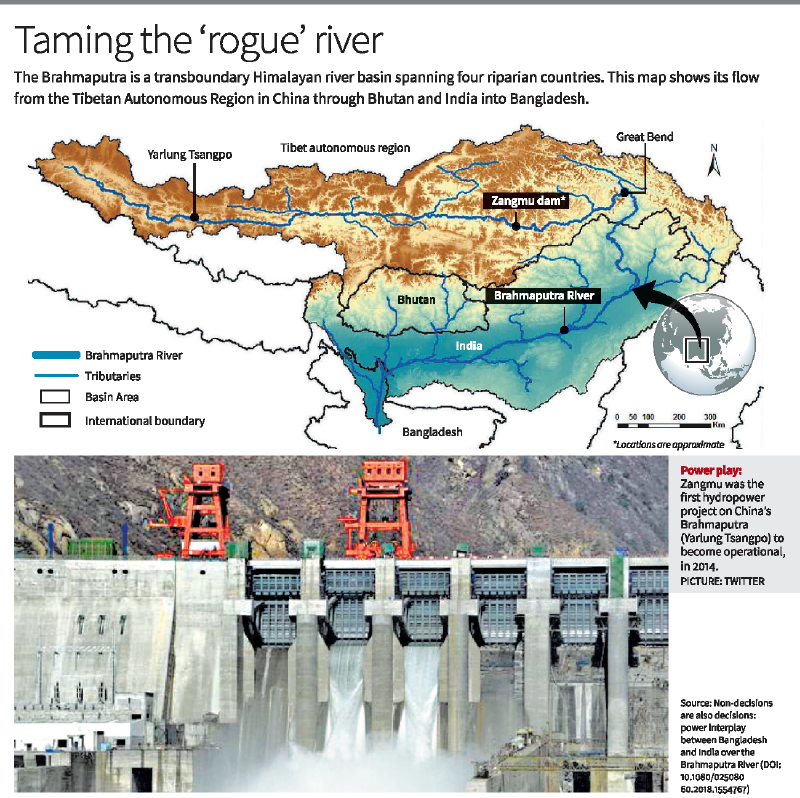
- 07 Jan 2025
Introduction:
China has approved the construction of the Yarlung Tsangpo hydropower project, the world's largest hydropower project, with a capacity of 60,000 MW, on the Brahmaputra River in Tibet. This mega-dam, located at the Great Bend in Medog county, has significant geopolitical, environmental, and socio-economic implications for India, Bhutan, and Bangladesh, the downstream riparian countries.
Geographical and Geopolitical Context:
- The Brahmaputra is a transboundary river system flowing through China, India, Bhutan, and Bangladesh.
- China, located at the river’s source in Tibet, is the uppermost riparian nation, controlling water flow into India and Bangladesh.
- All riparian countries, including China, India, Bhutan, and Bangladesh, have proposed major water infrastructure projects in the river basin, which has become a site for geopolitical rivalry, with mega-dams symbolizing sovereignty.
China’s Hydropower Ambitions:
- The Yarlung Tsangpo project is part of China’s 14th Five-Year Plan (2021-2025) and aims to address the country's energy needs while moving towards net carbon neutrality by 2060.
- The river's steep descent from Tibet provides an ideal location for hydroelectricity generation.
- China’s previous mega-projects, like the Three Gorges Dam, highlight the scale of these ambitions but also raise concerns about environmental and social consequences, including ecosystem disruption, displacement, and seismic risks.
Impact on Downstream Communities:
- Water Flow and Agriculture: China’s mega-dam may significantly alter water flow to India, particularly affecting agriculture and water availability in the northeastern regions. India, reliant on the Brahmaputra for irrigation and drinking water, could face disruptions.
- Silt and Biodiversity: The blocking of silt essential for agriculture could degrade soil quality and damage biodiversity in the river basin.
- Seismic Risks: The region’s seismic activity, coupled with the construction of large dams, heightens the risk of catastrophic events such as landslides and Glacial Lake Outburst Floods (GLOFs), which have previously caused devastation in the Himalayas.
Hydropower Competition Between China and India:
- Both China and India are competing to harness the Brahmaputra's potential for hydropower, with India planning its own large project at Upper Siang.
- Bhutan has also proposed several medium-sized dams, raising concerns in downstream countries about cumulative impacts.
- No comprehensive bilateral treaty exists between India and China to regulate shared transboundary rivers, though they have mechanisms for data sharing and discussions on river issues.
Environmental and Regional Concerns:
- The Brahmaputra river basin is an ecologically sensitive region. The construction of large dams threatens the fragile ecosystem, including agro-pastoral communities, biodiversity, and wetlands.
- Tibet’s river systems are vital for the global cryosphere, affecting climate systems, including monsoon patterns. Disruption to these systems could have broader implications for regional and global climate stability.
Challenges in Bilateral Cooperation:
- India and China have struggled with effective coordination on river management. China has shown reluctance to share critical hydrological data, a concern amplified by the lack of a binding agreement.
- The ongoing geopolitical tensions between the two countries, particularly over the border dispute, further complicate cooperation on transboundary water issues.
Recommendations for India:
- Enhanced Cooperation: India should push for renewed agreements and mechanisms for real-time data exchange with China to prevent ecological and socio-economic damage.
- Public Challenges: India needs to challenge China’s claims that its hydropower projects will have minimal downstream impact, ensuring that India's concerns are addressed in international forums.
- Diplomatic Engagement: Water issues should be prioritized in India’s diplomatic engagement with China, emphasizing the importance of transparency and cooperation to ensure mutual benefit and regional stability.
Conclusion:
The Yarlung Tsangpo mega-dam project poses significant risks to the entire Brahmaputra river basin. A collaborative approach, involving transparent dialogue and cooperation among riparian countries, is essential to mitigate the potential adverse impacts on downstream communities and the fragile Himalayan ecosystem.
Caste-Based Discrimination in Prisons

- 02 Jan 2025
In News:
The Union Ministry of Home Affairs has recently introduced significant revisions to the Model Prison Manual, 2016, and the Model Prisons and Correctional Services Act, 2023. These changes aim to eliminate caste-based discrimination in Indian prisons and establish a standardized approach to defining and treating habitual offenders across the country.
Background
In October 2024, the Supreme Court of India expressed concerns over the persistence of caste-based discrimination within prisons and the lack of consistency in how habitual offenders are classified. In response, the Court instructed the government to amend prison regulations to promote equality and fairness. The newly introduced reforms are in line with the Court's directives and focus on aligning prison practices with constitutional principles.
Addressing Caste-Based Discrimination in Prisons
The recent amendments take specific steps to combat caste-based discrimination within correctional facilities:
- Ban on Discrimination: Prison authorities are now mandated to ensure there is no caste-based segregation or bias. All work assignments and duties will be distributed impartially among inmates.
- Legal Provision Against Discrimination: A new clause, Section 55(A), titled "Prohibition of Caste-Based Discrimination in Prisons and Correctional Institutions", has been added to the Model Act, establishing a formal legal framework to address caste discrimination.
- Manual Scavenging Ban: The amendments extend the provisions of the Prohibition of Employment as Manual Scavengers and their Rehabilitation Act, 2013 to include prisons, prohibiting the degrading practice of manual scavenging or any hazardous cleaning within correctional facilities.
Redefining Habitual Offenders
The updated amendments also standardize the classification and treatment of habitual offenders, in accordance with the Supreme Court’s directions:
- Uniform Definition: A habitual offender is now officially defined as an individual convicted and sentenced to imprisonment for two or more separate offences within a continuous five-year period, provided the sentences were not overturned on appeal or review. Importantly, time spent in jail under sentence is excluded from this five-year period.
- National Consistency: States that do not have specific Habitual Offender Acts must amend their laws within three months to ensure consistency with the new national framework.
Importance of the Reforms
- Promoting Equality: These amendments seek to uphold the constitutional rights of prisoners, ensuring that all individuals, regardless of caste or background, are treated equally and with dignity.
- Eliminating Degrading Practices: The extension of the manual scavenging prohibition to prisons is a vital step in eliminating degrading and inhumane practices, ensuring a more humane environment for prisoners.
- Uniform Framework: The establishment of a standardized definition of habitual offenders ensures a consistent approach in handling repeat offenders across all states, reducing the possibility of arbitrary classifications.
Conclusion
The reforms introduced by the Union Home Ministry mark a significant milestone in India’s prison reform journey. By addressing caste-based discrimination and standardizing the classification of habitual offenders, these amendments reaffirm the country’s commitment to human rights and the rule of law. These changes not only improve the conditions within prisons but also set the stage for future reforms aimed at creating a fairer and more equitable correctional system.
Free Movement Regime
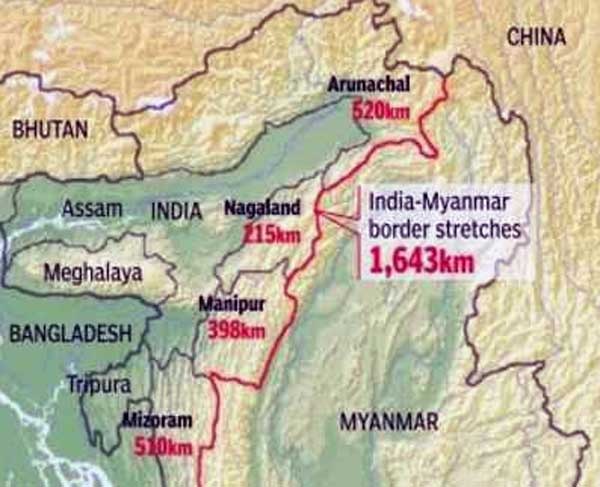
- 27 Dec 2024
In News:
The Indian government, through the Ministry of Home Affairs (MHA), has recently issued new guidelines to regulate the movement of people between India and Myanmar, especially along the border regions. These guidelines come after the suspension of the Free Movement Regime (FMR), which had previously allowed residents within a specified range of the border to move freely. The new protocol aims to enhance internal security and address concerns related to demographic shifts in India's northeastern states.
Background of the Free Movement Regime (FMR)
What is FMR?
The Free Movement Regime (FMR) is a bilateral arrangement between India and Myanmar that permits residents living in border areas to cross the international boundary without a visa. This agreement was established in 1968 to facilitate familial, cultural, and economic exchanges between people living on either side of the border.
Territorial Limits and Evolution
Initially, the FMR allowed free movement within a 40 km radius from the border. However, in 2004, this limit was reduced to 16 km, and additional regulations were introduced in 2016. The most recent development sees the limit further reduced to 10 km, with stricter regulations implemented to regulate the movement.
Recent Developments and New Guidelines
Suspension of FMR
In February 2023, Union Home Minister Amit Shah announced the suspension of the FMR along the India-Myanmar border, citing concerns about internal security and demographic changes, particularly in India's northeastern states. This decision came in the context of growing ethnic violence and political pressures, especially from states like Manipur.
Despite the announcement, the formal scrapping of the FMR is yet to be officially notified by the Ministry of External Affairs (MEA). However, the MHA has issued new guidelines to regulate cross-border movement, focusing on enhancing security without completely discontinuing the regime.
Key Features of the New Guidelines
The updated protocols issued by the MHA include several measures aimed at improving the security and regulation of movement across the border:
- Reduced Movement Limit: The new guidelines reduce the free movement limit from 16 km to 10 km from the border on both sides.
- Border Pass System: Residents wishing to cross into Myanmar or return to India must obtain a "border pass" from the Assam Rifles. This pass allows a stay of up to seven days in the neighboring country.
- Document and Health Checks: Upon entry into India, individuals will undergo a document inspection by the Assam Rifles, followed by security and health checks conducted by state police and health authorities. Biometrics and photographs will be collected, and a QR code-enabled border pass will be issued for verification.
- Designated Entry Points: There will be 43 designated entry and exit points across the border, with biometric verification and health screening required at all points.
- Monitoring and Enforcement: The Assam Rifles will oversee the movement, ensuring that individuals comply with the new regulations. Violations of the movement protocol will result in legal action.
Infrastructure and Technology Implementation
The government plans to establish infrastructure, such as biometric machines and software for border pass issuance. Pilot entry and exit points will be operational soon, with a phased implementation for the remaining points.
Political Reactions and Opposition
Regional Concerns and Opposition
The suspension of the FMR has been a contentious issue in India's northeastern states. The governments of Nagaland and Mizoram have raised objections to the scrapping of the regime, citing the cultural and familial ties of border communities. The Nagaland Assembly passed a resolution opposing the government's decision, while political leaders in Manipur argued that the unregulated movement of people had contributed to ethnic violence in the region.
Specific Concerns in Manipur
The chief minister of Manipur, N. Biren Singh, attributed ongoing ethnic conflicts in the state to the unchecked movement of people across the border. This was particularly evident in the violent ethnic clashes that broke out in 2023. As a result, Singh urged the Home Ministry to cancel the FMR along the India-Myanmar border, and the new guidelines reflect the state's concerns.
Conclusion
The suspension of the Free Movement Regime along the India-Myanmar border, followed by the introduction of stricter guidelines, marks a significant shift in India's border management policy. While the formal scrapping of FMR is yet to occur, the new protocols aim to balance security concerns with the region's long-standing cultural ties. The implementation of biometric checks and designated entry points signifies the government’s focus on modernizing border control while addressing regional concerns. The outcome of this policy shift will have important implications for internal security, demographic dynamics, and bilateral relations between India and Myanmar.
Revitalization of India-China Relations: A Diplomatic Turning Point
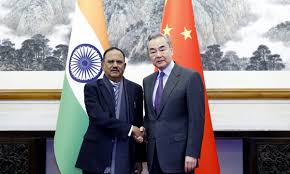
- 23 Dec 2024
In News:
The 23rd meeting between India’s National Security Adviser (NSA) and China’s Foreign Minister, held as Special Representatives (SRs), marks a pivotal moment in the complex bilateral relationship between the two nations. This dialogue, which follows years of strain exacerbated by the 2020 Galwan Valley clash, signals a renewed commitment to restoring stability and fostering peace along the border.
Special Representatives Mechanism: A Foundation for Dialogue
The SR mechanism, established in the early 2000s, has long served as a key platform for addressing bilateral disputes, particularly the contentious boundary issue. Past rounds of discussions have facilitated troop disengagement and efforts to maintain peace along the Line of Actual Control (LAC). The recent meeting, following the 2023 BRICS summit discussions between Prime Minister Narendra Modi and Chinese President Xi Jinping, demonstrates a positive step towards de-escalation, with the resumption of talks providing hope for progress.
Key Outcomes of the 23rd SR Meeting
Several significant developments emerged from the meeting, focusing on cultural, economic, and strategic cooperation:
- Cultural and Economic Cooperation:
- Kailash-Mansarovar Yatra: The resumption of this religious pilgrimage represents a significant cultural exchange, fostering people-to-people ties.
- Border Trade Revival: Border trade in Sikkim has been reestablished, potentially revitalizing local economies and improving trade relations.
- Scientific and Environmental Cooperation:
- Trans-boundary River Data Sharing: China’s commitment to sharing crucial river data with India will aid in flood management, directly addressing India’s long-standing concerns over water security, particularly in light of China's upstream dam projects.
- Connectivity and Exchange Programs:
- Discussions on restarting direct flights and visa easements for students and businesses, along with enhanced journalist exchanges, signal a move toward greater normalization of relations.
- Commitment to Border Peace:
- Both sides have reiterated their intent to maintain peace along the border, a critical factor in reducing tensions. While China expressed a six-point consensus, India has cautiously framed the outcome as “positive directions,” reflecting a reserved optimism.
Challenges in India-China Relations
Despite the positive momentum, numerous challenges persist in the bilateral relationship:
- Boundary Dispute:
- The core irritant remains the unresolved border issue, with divergent perceptions of the LAC. While some disengagement has occurred, full de-escalation and demilitarization across the entire border have not yet been achieved.
- Trust Deficit:
- The 2020 Galwan clash has left a lasting scar on mutual trust. Additionally, China’s aggressive patrolling and policy shifts continue to raise concerns in India, necessitating vigilance in future negotiations.
- Economic Imbalances:
- India’s trade relationship with China remains lopsided, with a significant trade deficit. Moreover, China’s growing influence in India’s neighborhood, particularly in Pakistan, Nepal, and Sri Lanka, challenges India’s strategic interests.
- Global Power Dynamics:
- India’s evolving alliances, particularly with the U.S., QUAD, and I2U2 group, alongside China’s assertive stance in Taiwan and the South China Sea, complicate bilateral relations and influence global perceptions.
The Way Forward
To navigate the challenges and harness opportunities, India must adopt a balanced approach, combining diplomatic engagement, economic resilience, and strategic vigilance:
- Confidence-Building Measures:
- Continued disengagement and de-escalation at the LAC, coupled with increased transparency in military activities, will be critical to maintaining peace.
- Broadening Cooperation:
- Exploring areas of mutual interest, such as climate change, public health, and infrastructure development, could foster deeper cooperation and help transcend contentious issues.
- Economic Realignment:
- India must address its trade deficit by pushing for greater market access for Indian products in China. Additionally, diversifying supply chains and promoting joint ventures in renewable energy and technology can reduce dependency.
- Multilateral Engagement:
- Engaging through global forums like BRICS, SCO, and G20, and strengthening regional alliances, will help mitigate tensions and counterbalance China's regional influence.
- Strategic Vigilance:
- Strengthening ties with regional allies, particularly in the Indo-Pacific, and enhancing military preparedness will safeguard India’s strategic interests in the face of China’s assertiveness.
Conclusion
The recent meeting between India and China represents a cautious but constructive step toward stabilizing their fraught relationship. By focusing on diplomacy, strengthening economic ties, and maintaining strategic vigilance, India can navigate its complex relationship with China in a rapidly shifting global context. A careful balance of engagement and vigilance will be crucial for India’s future dealings with its powerful neighbor.
Supreme Court Directs Policy for Sacred Groves Protection
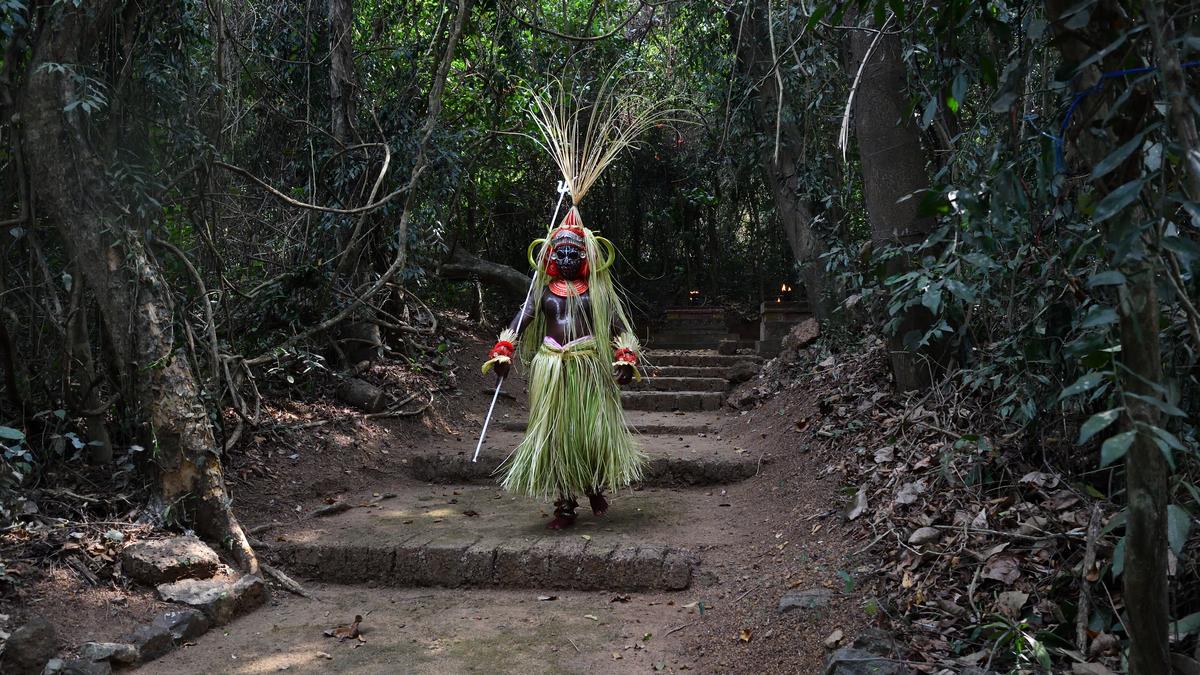
- 20 Dec 2024
In News:
Recently, the Supreme Court of India issued a significant judgment directing the Union Government to formulate a comprehensive policy for the protection and management of sacred groves across the country. These natural spaces, traditionally safeguarded by local communities, play a crucial role in preserving both ecological diversity and cultural heritage.
What are Sacred Groves?
Sacred Groves are patches of virgin forests that are protected by local communities due to their religious and cultural significance. They represent remnants of what were once dominant ecosystems and serve as key habitats for flora and fauna. Typically, sacred groves are not just ecological reserves, but also form an integral part of local traditions, often protected due to spiritual beliefs.
Key Features of Sacred Groves:
- Ecological Value: Sacred groves contribute significantly to biodiversity conservation.
- Cultural Significance: These groves are revered in various religious practices and are central to local traditions.
- Geographical Presence: Sacred groves are found in regions like Tamil Nadu, Kerala, Karnataka, Maharashtra, and parts of Rajasthan.
Supreme Court's Directive
The court's judgment was based on a plea highlighting the decline of sacred groves in Rajasthan, particularly those being lost due to deforestation and illegal land-use changes. While the Wildlife (Protection) Act of 1972 empowers state governments to declare community lands as reserves, the court recognized the need for a unified national policy to protect sacred groves as cultural reserves.
Recommendations:
- Nationwide Survey: The Ministry of Environment, Forest, and Climate Change (MoEF&CC) was instructed to conduct a nationwide survey to map and assess sacred groves, identifying their size and extent.
- Legal Protection: Sacred groves should be recognized as community reserves and protected under the Wildlife (Protection) Act, 1972.
- State-Specific Measures: The Rajasthan government was specifically directed to carry out detailed mapping (both on-ground and satellite) of sacred groves within the state, ensuring that the groves are recognized for their ecological and cultural significance.
The Role of Sacred Groves in Conservation
Sacred groves play a pivotal role in the conservation of biodiversity. They serve as refuges for various plant and animal species, and the traditional practices associated with these groves, such as tree worship, discourage destructive activities like logging and hunting.
Ecological and Cultural Importance:
- Sacred groves often act as critical biodiversity hotspots, preserving rare and indigenous species.
- They help maintain clean water ecosystems and act as carbon sinks, contributing to climate mitigation.
- Practices of non-interference with these areas have allowed flora and fauna to thrive over centuries.
Cultural Significance Across India
The importance of sacred groves is deeply embedded in India's diverse cultural heritage. They are considered the abode of deities, and various regions have unique names and rituals associated with these groves.
Examples of Sacred Groves in India:
- Himachal Pradesh: Devban
- Karnataka: Devarakadu
- Kerala: Kavu
- Rajasthan: Oran
- Maharashtra: Devrai
Piplantri Village Model
A key example highlighted in the judgment was the Piplantri village in Rajasthan, where the community undertook a remarkable transformation of barren land into flourishing groves. The initiative, driven by local leadership, involves planting 111 trees for every girl child born, which has led to several environmental and social benefits.
Impact of Piplantri's Community Efforts:
- Over 40 lakh trees have been planted, which has recharged the water table by 800-900 feet and lowered the local climate by 3-4°C.
- The initiative has contributed to the reduction of female foeticide and empowered women's self-help groups.
- The village now enjoys economic growth, better education opportunities, and increased local income.
Legal and Statutory Framework
Sacred groves are already recognized under existing Indian laws, notably the Wildlife (Protection) Act, 1972, which allows states to declare sacred groves as community reserves. Additionally, the National Forest Policy of 1988 encourages the involvement of local communities in the conservation of forest areas, a principle supported by the Godavarman Case of 1996.
Key Legal Provisions:
- Wildlife (Protection) Act, 1972: Empowers state governments to declare sacred groves as community reserves.
- National Forest Policy, 1988: Encourages community involvement in the conservation and protection of forests, including sacred groves.
- Scheduled Tribes and Other Traditional Forest Dwellers (Recognition of Forest Rights) Act, 2006: Suggests empowering traditional communities as custodians of sacred groves.
Looking Ahead: The Need for Action
The Supreme Court has scheduled further hearings to assess the progress of the survey and mapping efforts by Rajasthan. The court also stressed the importance of empowering traditional communities to continue their role as custodians of sacred groves, ensuring their sustainable protection for future generations.
By recognizing the ecological and cultural significance of sacred groves and encouraging community-driven conservation efforts, the Supreme Court’s ruling sets a precedent for more inclusive environmental policies in India. This could also inspire similar initiatives in other parts of the world, promoting the protection of sacred natural spaces for their critical role in maintaining biodiversity and fostering sustainable communities.
Commitment to Eradicating Naxalism in Chhattisgarh by 2026
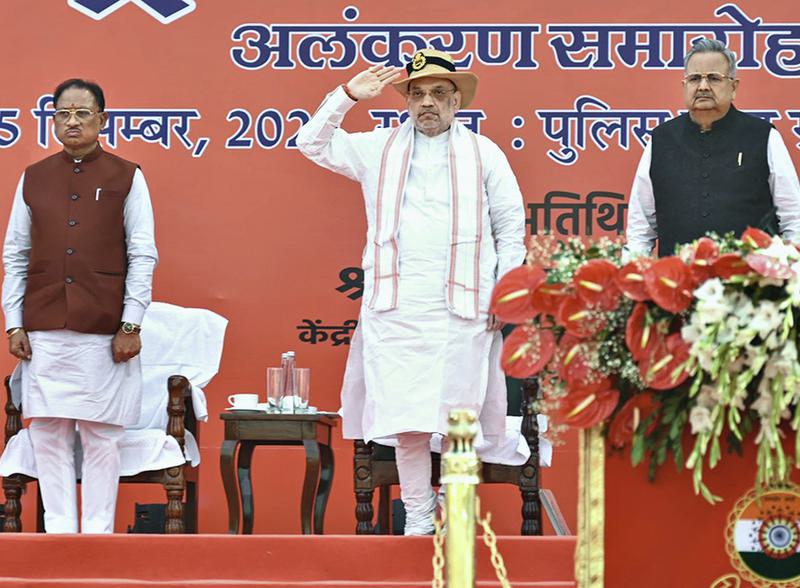
- 17 Dec 2024
Overview
Union Home Minister Amit Shah has reiterated India's commitment to eliminate Naxalism in Chhattisgarh by March 31, 2026. He emphasized the progress made in the fight against Naxalism, highlighting key successes and outlining the strategy for the coming years.
Key Pointers
- Government Commitment: Amit Shah emphasized the joint commitment of the Government of India and the Chhattisgarh state leadership to rid the state of Naxalism by 2026.
- Security Forces’ Success: Over the past year, Chhattisgarh police neutralized 287 Naxalites, arrested around 1,000, and saw 837 surrenders.
- Top Naxal Cadres Neutralized: The state forces successfully neutralized 14 high-ranking Naxal cadres.
- President’s Police Colour Award: Chhattisgarh Police received the President's insignia within 25 years, a significant achievement for the state.
The Three-Pronged Strategy for Eliminating Maoist Insurgency
- Security Measures (Force)
Deployment of Security Forces
- Enhanced Presence: Increased deployment of Central and State police forces in Left-Wing Extremism (LWE) areas.
- Joint Operations: Coordinated operations between state and central forces, including CRPF and COBRA units.
- Upgraded Technology: Incorporation of UAVs, solar lights, and mobile towers to enhance operational efficiency.
Operation SAMADHAN
- Key Elements:
- Smart Leadership: Leading with innovative strategies.
- Aggressive Strategy: Swift, decisive action against insurgents.
- Motivation and Training: Strengthening the capabilities of forces.
- Actionable Intelligence: Real-time intelligence for effective operations.
- Harnessing Technology: Using modern tech for strategic advantage.
2. Development Initiatives
Focused Development Schemes
- PMGSY: Rural road connectivity under the Pradhan Mantri Gram Sadak Yojana.
- Aspirational Districts Program: Improving infrastructure in Naxal-affected areas.
- Skill Development: Targeted schemes in 47 LWE-affected districts to reduce unemployment.
Infrastructure Development
- Special Infrastructure Schemes: Building schools, roads, and bridges in remote areas to integrate them into the mainstream economy.
- Rehabilitation: Focus on providing rehabilitation for former Naxals through education and vocational training.
3. Empowerment (Winning Hearts and Minds)
Public Engagement
- Tribal Empowerment: Strengthening communication with tribal communities to reduce alienation and mistrust.
- Rehabilitation Policies: Surrender schemes offering incentives like education and financial aid to reintegrate former insurgents into society.
Maoism: Ideology and Background
What is Maoism?
- Origin: A form of communism developed by Mao Tse Tung, focusing on armed insurgency to capture state power.
- Core Beliefs: Maoists believe in violence and insurrection as legitimate means to overthrow the state and establish a People’s Democratic Republic.
- Indian Maoism: The Communist Party of India (Maoist), formed in 2004, leads the largest Maoist insurgency in India.
Recent Achievements in Combatting Maoist Insurgency
Key Successes in 2023
- Maoist-Free Villages: Villages in Dantewada declared "Maoist-free," a significant victory for the state.
- Reduction in Security Forces’ Casualties: 14 deaths in 2024, a dramatic decrease from 198 deaths in 2007.
- Infrastructure and Logistical Support: Enhanced use of helicopters and fortified police stations.
Government’s Commitment to Rebuilding
- Rehabilitation and Welfare: The government is implementing policies to improve the living standards of affected families, including 15,000 houses for Naxal-affected regions.
- Economic Development: Focus on building infrastructure and providing employment through skills training programs.
Challenges in Eliminating Naxalism
Socio-Economic Issues
- Exploitation of Tribals: Marginalization of tribals due to displacement for mining and forestry.
- Lack of Infrastructure: Basic amenities like roads, schools, and healthcare are absent in many areas.
- Centralized Naxal Command: The CPI (Maoist) retains a strong leadership, despite fragmentation of its forces.
Governance and Trust Issues
- Alienation of Local Populations: Ineffective governance and poor implementation of welfare schemes fuel local support for Naxal groups.
- Resource Conflict: The Naxals exploit rich mineral resources in the region to fund their insurgency.
Way Forward
Governance and Economic Reforms
- Tribal Empowerment: Form Tribal Advisory Councils as per the Fifth Schedule for better resource management.
- Land Redistribution: Enforce the Land Ceiling Act to reduce inequality.
- Livelihood Programs: Offer alternative livelihoods to reduce dependency on illegal activities.
Security Measures
- Paramilitary Deployment: Specialized forces to secure tribal areas and enable local governance.
- Resource Management: Ensure sustainable exploitation of natural resources, involving tribal communities in the decision-making process.
Peace Dialogues
- Inclusive Policies: Engage in dialogue with Naxals to facilitate their reintegration into mainstream society.
Conclusion
Naxalism in India, particularly in Chhattisgarh, is a complex issue rooted in socio-economic inequalities, lack of development, and historical alienation of tribal communities. The government's approach, encapsulated in the SAMADHAN strategy, combines security operations with developmental initiatives and a focus on empowerment to tackle the problem. With a clear commitment to eliminate Naxalism by 2026, the Indian government is making significant strides in reducing violence, improving governance, and integrating affected communities into the mainstream.
How would a carbon market function?

- 16 Dec 2024
In News:
COP29, the ongoing climate conference in Azerbaijan’s capital Baku, has given a fillip to the idea of using carbon markets to curb carbon emissions by approving standards that can help in the setting up of an international carbon market as soon as the coming year.
Introduction to Carbon Markets
- Carbon markets allow the buying and selling of the right to emit carbon dioxide (CO2) into the atmosphere.
- Governments issue certificates known as carbon credits, each representing the right to emit 1,000 kilograms of CO2.
- The total number of credits issued is capped to control carbon emissions. Companies and individuals who don’t have credits cannot emit CO2.
Trading of Carbon Credits
- Carbon Credit Trading: Companies holding more carbon credits than needed can sell them to others who need more, with the price determined by market forces.
- Carbon Offsets: Businesses can also purchase carbon offsets, often provided by environmental NGOs, which promise to reduce emissions (e.g., by planting trees). These offsets counterbalance the firm’s carbon emissions.
- The trading of both credits and offsets is designed to create financial incentives for companies to reduce their carbon footprint.
Advantages of Carbon Markets
- Addressing Externalities: Carbon emissions are a classic example of an economic externality, where the costs of pollution are not reflected in market prices.
- Market Efficiency: By allowing firms to buy and sell carbon credits, the system internalizes the cost of carbon emissions, encouraging businesses to reduce emissions to avoid higher costs.
- Incentive for Emission Reduction: Carbon markets aim to create a financial reason for companies to lower their emissions, thus helping mitigate climate change.
Voluntary vs. Government-Mandated Carbon Markets
- Voluntary Carbon Reporting: Many corporations prefer voluntary systems like the Carbon Disclosure Project (CDP) for reporting their emissions, fearing government-imposed restrictions.
- Market Flexibility: Corporations like ExxonMobil and General Motors argue that carbon markets with freely traded credits allocate carbon allowances more efficiently than government-imposed limits. This allows firms to purchase credits from others, optimizing resource allocation without restricting output.
- Corporate Resistance to Government Intervention: Firms are often reluctant to accept strict government budgets for carbon emissions, fearing increased operational costs and production limitations due to diverse supply chains.
Issues and Criticisms of Carbon Markets
- Government Manipulation of Credit Supply: Governments may increase the number of carbon credits issued, leading to lower prices and reduced incentives for emission reductions.
- Lack of Accountability in Carbon Offsets: Critics argue that some companies buy carbon offsets as a form of virtue signalling, without genuine concern for their environmental impact. This undermines the effectiveness of the offsets.
- Government Mismanagement: Political decision-making may lead to the over-restriction of carbon credits, potentially slowing economic growth by limiting available emissions allowances. The ability of governments to accurately determine the optimal supply of carbon credits is a contentious issue.
The Concept of Carbon Credits and Their History
- Introduction of Carbon Credits: Carbon credits were first introduced in the 1990s in the U.S., specifically through a cap-and-trade model designed to control sulfur dioxide emissions. This approach later expanded to include carbon emissions.
- Role of Carbon Markets: In essence, these markets aim to create a financial mechanism where firms can trade the right to pollute, ensuring a balance between economic growth and environmental protection.
Criticism of Carbon Offsets
- Effectiveness of Offsets: Experts are critical of carbon offsets, arguing that they do not always lead to meaningful reductions in emissions. For example, some companies may purchase offsets without ensuring that the projects are genuinely offsetting their emissions.
- Moral Hazard: Critics suggest that offset programs may lead to firms simply paying for the right to pollute, rather than actually reducing emissions in their operations.
Conclusion
- Carbon Markets as a Tool for Emission Reduction: Despite the criticisms, carbon markets remain a promising tool for mitigating climate change, provided they are carefully regulated and implemented.
- The Future of Carbon Trading: As discussions at COP29 evolve, the development of international standards for carbon trading could potentially enhance the effectiveness of these markets, offering a viable path to global emission reductions.
Impeachment of Judges
- 12 Dec 2024
In News:
The recent controversy surrounding remarks made by Justice Shekhar Kumar Yadav of the Allahabad High Court has prompted calls for his impeachment. During an event organized by the Vishwa Hindu Parishad (VHP), Justice Yadav made statements that were perceived as communal, leading to concerns over judicial impartiality. This incident has reignited discussions about the impeachment process for judges in India, highlighting the delicate balance between judicial independence and accountability.
Impeachment Process for Judges in India
In India, the impeachment process for judges, although not explicitly mentioned in the Constitution, serves as a mechanism to ensure judicial accountability while safeguarding judicial independence. The process is outlined under Articles 124 and 218 of the Indian Constitution, which govern the removal of Supreme Court and High Court judges, respectively.
Grounds for Impeachment
Judges in India can be removed on two grounds:
- Proved Misbehavior: Conduct that breaches the ethical standards of the judiciary.
- Incapacity: A judge’s inability to perform judicial duties due to physical or mental infirmity.
These grounds are clearly specified to prevent arbitrary removal, ensuring that the process remains fair and just.
Steps in the Impeachment Process
- Initiation of Motion: The process begins when a motion for impeachment is introduced in Parliament, either in the Lok Sabha or Rajya Sabha. The motion must be supported by at least 100 members of the Lok Sabha or 50 members of the Rajya Sabha. This ensures significant parliamentary backing before the motion proceeds.
- Formation of an Inquiry Committee: If the motion is admitted, a three-member inquiry committee is constituted. This includes a Supreme Court judge, the Chief Justice of a High Court, and a distinguished jurist. The committee conducts a thorough investigation into the allegations.
- Committee Report and Parliamentary Debate: Following the investigation, the committee submits its findings. If the judge is found guilty, the report is debated in Parliament. Both Houses must approve the motion by a special majority, which requires a two-thirds majority of members present and voting, as well as a majority of the total membership.
- Final Removal by the President: Once the motion is passed in both Houses, it is presented to the President, who issues the removal order.
Safeguards Against Misuse
The impeachment process includes several safeguards to prevent misuse:
- High Threshold for Initiation: The requirement for significant support from Parliament ensures that the process cannot be initiated frivolously.
- Objective Inquiry: The inquiry committee, comprising legal experts, guarantees an impartial investigation.
- Parliamentary Scrutiny: Both Houses of Parliament are involved, ensuring that the process undergoes democratic scrutiny.
Challenges and Precedents
Despite the rigorous process, no Supreme Court judge has been successfully impeached to date. Past attempts, such as those against Justice V. Ramaswami (1993) and Chief Justice Dipak Misra (2018), were unsuccessful. These instances demonstrate the complexities involved in the impeachment process.
Guidelines for Judges’ Public Statements
Judges in India are entitled to freedom of speech, but they are expected to exercise caution in public statements to maintain the dignity of their office. The Bangalore Principles of Judicial Conduct (2002) and the Restatement of Values of Judicial Life (1997) outline key principles for judicial conduct, including:
- Non-Interference in Political Matters: Judges should refrain from commenting on political issues to avoid any perception of bias.
- Impartiality: Judges must avoid statements that could prejudice ongoing cases or align them with specific ideologies.
Upholding Judicial Impartiality in a Diverse Society
To maintain impartiality, judges must interpret laws based on constitutional values of justice, equality, and secularism. Furthermore, the judiciary must ensure representation from diverse backgrounds to foster inclusivity and reduce systemic biases. Training programs focused on cultural competence and social diversity are essential to ensure that judges are sensitive to the needs of marginalized communities.
Conclusion
The impeachment process, while stringent, plays a critical role in maintaining judicial accountability in India. As seen in the case of Justice Yadav, judicial conduct, particularly public statements, must be carefully scrutinized to preserve the integrity of the judiciary. Upholding impartiality and adhering to constitutional values are paramount in ensuring that the judiciary continues to function as a neutral arbiter in India’s democracy.
Building on the Revival of the Manufacturing Sector
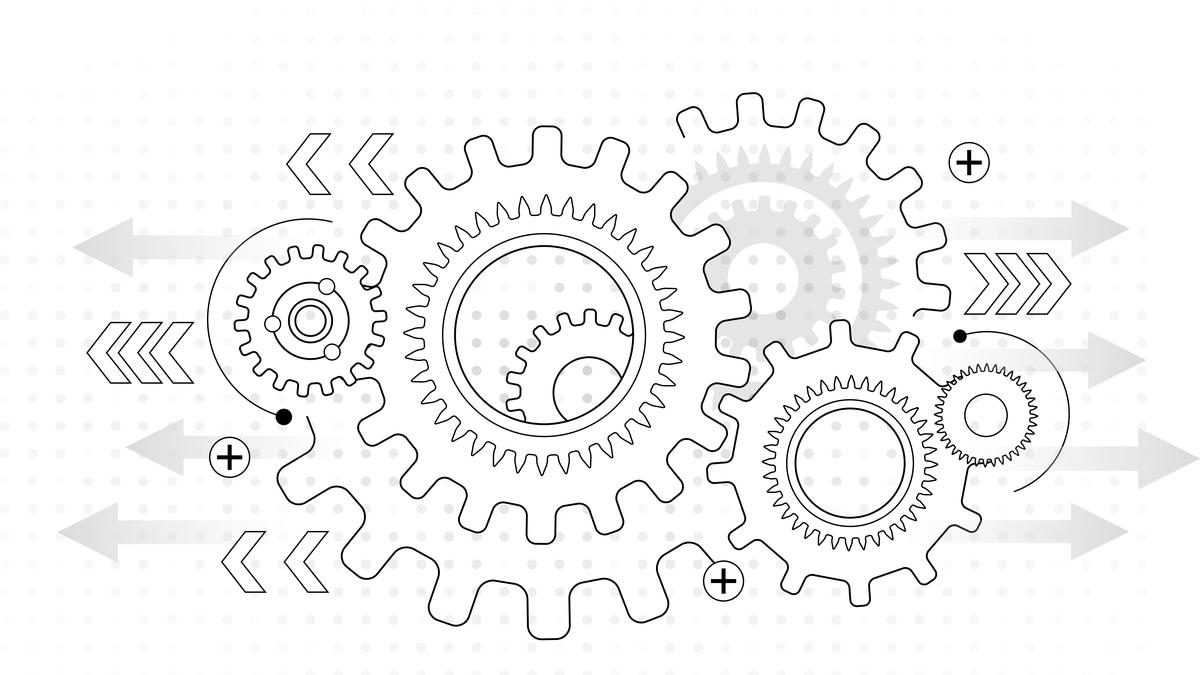
- 07 Dec 2024
In News:
India’s manufacturing sector has shown remarkable signs of recovery and growth, thanks to strategic policy initiatives like the Production Linked Incentive (PLI) scheme. To fully capitalize on this momentum and become a global manufacturing hub, however, deeper reforms are needed.
The Success of the PLI Scheme: A Catalyst for Growth
The government’s PLI scheme has been instrumental in revitalizing key sectors like electronics, pharmaceuticals, automobiles, and textiles. It has not only boosted production but also increased exports and job creation. According to the Annual Survey of Industries (ASI) 2022-23, manufacturing output grew by an impressive 21.5%, while gross value added (GVA) increased by 7.3%. Sectors such as basic metals, refined petroleum products, food products, and motor vehicles, which are beneficiaries of the PLI scheme, contributed 58% of total manufacturing output, registering growth of 24.5%.
This success underlines the potential of India’s manufacturing sector, with the PLI scheme acting as a key enabler. However, while the recovery is promising, there are significant challenges to overcome to sustain long-term growth.
Expanding PLI Incentives to New Sectors
The PLI scheme has largely benefitted traditional industries like electronics and automotive manufacturing. To further accelerate growth, the scope of the scheme must be extended to labour-intensive sectors such as apparel, footwear, and furniture, which hold immense potential for job creation. Additionally, emerging sectors like aerospace, space technology, and maintenance, repair, and overhaul (MRO) services offer new avenues for growth. By diversifying the incentive structure to these sectors, India could establish a more robust and resilient manufacturing ecosystem.
In sectors like capital goods, where India is heavily import-dependent, the potential for reducing supply chain vulnerabilities is significant. Moreover, promoting green manufacturing and advanced technologies could further bolster India’s competitiveness in global markets.
Addressing the Divergence Between Output and Value Addition
Despite a surge in production, India’s gross value added (GVA) has not kept pace with output growth. The ASI data shows that input prices soared by 24.4% in 2022-23, indicating that while production volumes are up, industries are grappling with high input costs. A more streamlined import regime could mitigate these costs. Simplifying tariffs into a three-tier system (for raw materials, intermediates, and finished goods) would reduce input costs, enhance competitiveness, and improve integration into global value chains.
Regional Imbalance: A Barrier to Inclusive Growth
The manufacturing sector’s growth is heavily concentrated in a few states such as Maharashtra, Gujarat, Tamil Nadu, Karnataka, and Uttar Pradesh, which account for over 54% of manufacturing GVA. This concentration not only restricts equitable development but also hampers the overall growth potential of the sector. To address this, it is crucial that states actively participate in India's manufacturing growth story by implementing market reforms in land, labour, and power. Additionally, infrastructure development and investment promotion in less industrialized regions could help balance growth and ensure that the benefits of manufacturing reach all corners of the country.
Fostering MSME Growth and Enhancing Female Workforce Participation
Micro, small, and medium enterprises (MSMEs) contribute about 45% of India’s manufacturing GDP and employ around 60 million people. To scale these businesses and integrate them into global value chains, PLIs should be tailored to accommodate their needs, such as lowering capital investment thresholds and reducing production targets.
Equally important is the enhancement of female workforce participation. Studies suggest that India’s manufacturing output could increase by 9% if more women enter the workforce. The development of supportive infrastructure, such as hostels and childcare facilities, can play a pivotal role in enabling women’s participation, thus driving inclusive growth.
Conclusion: The Path Forward
To transform into a developed economy by 2047, India must continue to focus on strengthening its manufacturing sector. According to industry estimates, manufacturing’s share in Gross Value Added (GVA) can rise from 17% to 25% by 2030 and further to 27% by 2047. Achieving this will require sustained efforts to enhance competitiveness through business reforms, cost reduction, and policy support. India is well-positioned to harness its manufacturing potential, but timely and focused interventions are necessary to turn this vision into reality.
Reflections on Baku’s ‘NCQG Outcome’ at COP29
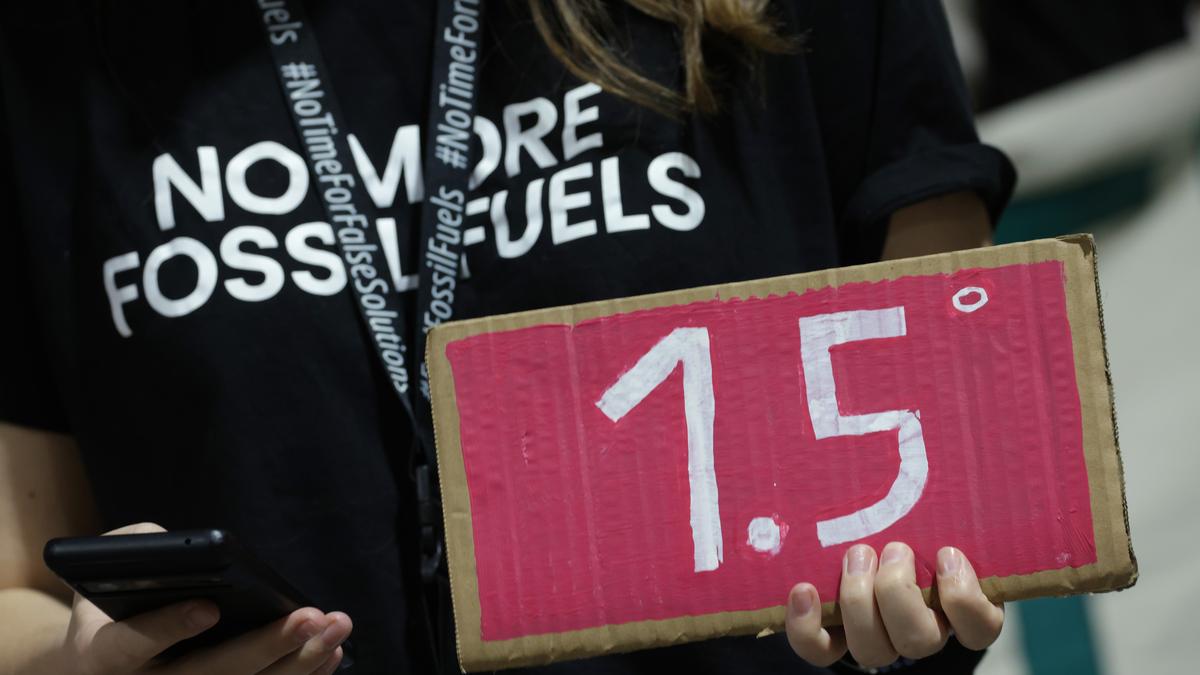
- 06 Dec 2024
In News:
The recently concluded COP29 in Baku, Azerbaijan, has brought the spotlight back to climate finance, particularly in relation to the New Collective Quantified Goal (NCQG). As the global community grapples with the escalating climate crisis, the discussions and outcomes from the COP29 summit are pivotal in shaping future climate action. However, the agreed-upon financial targets, which were expected to be a step towards transformative climate justice, have sparked significant concern, particularly among developing nations.
The Need for Climate Finance: A Global Responsibility
Climate finance is essential for supporting developing countries, which bear the brunt of climate change despite contributing minimally to global emissions. The Intergovernmental Panel on Climate Change (IPCC) has stressed the need to limit global warming to 1.5°C above pre-industrial levels, yet current policies could lead to a rise of up to 3.1°C. To counter this, developing nations require financial assistance to transition to green energy, adapt to climate impacts, and implement their Nationally Determined Contributions (NDCs).
The upfront costs of green technologies, such as renewable energy, are high, and while they offer long-term savings, their initial investments remain a significant barrier. Additionally, many developing countries face fiscal constraints, making it even more difficult to adopt climate-friendly technologies without external financial support.
The Role of NCQG in Addressing Climate Finance Gaps
The NCQG, an evolution of the 2010 $100 billion annual commitment, aims to provide clarity and accountability in climate financing. Established as a framework to ensure financial resources for climate action, the NCQG should ideally focus on the evolving needs of the Global South. However, at COP29, the target agreed upon was a mere $300 billion annually by 2035, far from the $1.3 trillion that developing countries had requested. This amount falls drastically short of what is necessary to meet the ambitious climate goals and fails to represent a transformative shift in financial flows.
Key Challenges and Discontent with the Outcome
Several challenges have been raised regarding the COP29 outcome:
- Equity and Responsibility: Developed nations are expected to bear a larger share of the financial burden, in line with the principle of 'Common but Differentiated Responsibilities' (CBDR). However, the NCQG outcome bypasses this principle, offering insufficient funds for climate action in developing countries.
- Types of Finance: There is debate over whether private finance should count towards the goal. Developing countries have stressed the importance of public finance over loans, which add to their debt burdens.
- Insufficient Commitment: While the $300 billion annual pledge is a step forward, it is far from adequate. The global climate finance needs, estimated at $5 trillion to $7 trillion by 2030, require bolder commitments from developed nations.
India's Position and Domestic Efforts
At COP29, India emphasized the need for developed countries to fulfill their financial commitments, advocating for at least $1.3 trillion annually until 2030. India, despite being a developing country, has also made significant strides in climate action through domestic policies. The 2024-25 Union Budget allocated substantial funds to renewable energy projects, including ?19,100 crore for the Ministry of New and Renewable Energy. These efforts demonstrate India’s commitment to climate goals, though the financial flow remains insufficient.
Conclusion: The Road Ahead
The NCQG outcome at COP29 highlights the ongoing disparities in global climate finance commitments. While the $300 billion annual target is a step forward, it does not align with the urgency or scale required to tackle the climate crisis. To achieve a just and equitable transition to a sustainable future, future climate finance discussions must prioritize transparency, accountability, and fairness, ensuring that developed nations shoulder their fair share of the responsibility. The path forward requires unwavering international cooperation to ensure that developing countries receive the necessary support to mitigate and adapt to the impacts of climate change.
Current Representation of Women in CAPFs
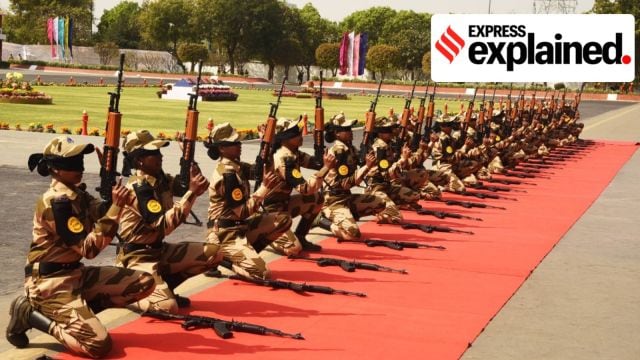
- 04 Dec 2024
In News:
The Central Armed Police Forces (CAPFs) of India, comprising forces like CRPF, BSF, CISF, and others, play a crucial role in maintaining internal security. Women’s participation in these forces has been historically limited, but recent efforts have focused on increasing their representation. As of 2024, women constitute only 4.4% of the total personnel in CAPFs, highlighting the slow progress despite various initiatives.
Current Representation and Changes Over Time
- Overall Representation: Women make up 4.4% of the 9.48 lakh-strong CAPFs. Within this, the Central Industrial Security Force (CISF) has the highest representation at 7.02%, followed by the Sashastra Seema Bal (SSB) at 4.43%, Border Security Force (BSF) at 4.41%, Indo-Tibetan Border Police (ITBP) at 4.05%, Assam Rifles at 4.01%, and Central Reserve Police Force (CRPF) at 3.38%.
- Growth of Women Personnel: From 15,499 women in 2014, the number has tripled to 42,190 in 2024, reflecting a steady increase in recruitment. However, the percentage remains low despite these gains.
- Recruitment Trends: In 2024, 835 women were recruited, with 5,469 more in the process. In 2025, 4,138 women are expected to be recruited.
Government Efforts and Parliamentary Committee Recommendations
- Policy Measures: The government has introduced several steps to encourage women’s participation in CAPFs, such as reservations in constable-level positions: one-third for CRPF and CISF, and 14-15% for border forces like BSF, SSB, and ITBP.
- Challenges in Recruitment: Despite these policies, recruitment has not kept pace with the targets. The 2022 Parliamentary Committee on Home Affairs expressed disappointment over the “abysmally low” number of women in CAPFs, noting that women made up only 3.68% of the forces at that time.
- Recommendations by Parliamentary Committees:
- The Home Affairs Committee recommended fast-tracking phase-wise recruitment of women, particularly in CISF and CRPF.
- The Standing Committee on Personnel (2023) suggested “soft postings” for women to avoid difficult working conditions, especially in remote or strenuous terrains. It also called for reservations for transgender individuals.
- In 2024, further steps like fee waivers, relaxed physical standards, and provisions for maternity and child care leave were introduced to make the work environment more inclusive.
Reasons Behind Low Representation
- Cultural Barriers: Traditional gender roles and societal expectations deter many women from pursuing careers in security forces.
- Work Environment: The demanding nature of the job, which includes postings in remote areas and high-risk operations, makes it less appealing, especially for women with family responsibilities.
- Infrastructure Issues: Lack of adequate accommodation, sanitation facilities, and safety measures for women are deterrents to joining and retaining female personnel.
Conclusion and Future Outlook
Although the representation of women in CAPFs has seen improvement, it remains below expectations due to persistent challenges. The government’s continuous focus on recruitment reforms, better working conditions, and policy incentives will be crucial to achieve gender parity in these forces. As societal attitudes evolve and the infrastructure improves, more women may be encouraged to serve in these vital security roles. Future efforts must include targeted recruitment drives and creating a more inclusive and supportive environment to enhance women’s participation in CAPFs.
Digital Arrests

- 01 Dec 2024
In News:
In 2024, India has witnessed an alarming rise in cybercrime, particularly a new scam called "digital arrests." This type of fraud involves criminals impersonating law enforcement officials to extort money from victims. With more than 92,000 people targeted and ?2,141 crore defrauded from victims, these scams are rapidly becoming a significant concern for the public and law enforcement.
Nature of ‘Digital Arrests’
The modus operandi of digital arrest scams is sophisticated and emotionally manipulative. Cybercriminals contact victims through video calls, often using fake police officers' profiles and official documents to build credibility. They accuse victims of serious crimes such as money laundering or drug trafficking, claiming urgent action is needed to avoid arrest. The scammers create a false atmosphere of fear and urgency, convincing the victim to transfer large sums of money under the pretext of settling legal dues.
A notable example involves Ruchi Garg, who was targeted by scammers posing as police officers, falsely claiming her son was involved in a major scam. She was coerced into transferring ?80,000 before realizing it was a scam. Similar cases have affected hundreds, with perpetrators using AI-generated voices and fake visuals to amplify the deception.
The Growth of Cybercrime in India
Digital arrest scams are part of a broader increase in cybercrime in India. The Indian Cyber Crime Coordination Centre (I4C) has reported a rise in cyber fraud, with financial losses exceeding ?27,900 crore between 2021 and 2024. The most significant sources of these losses include stock trading scams, Ponzi schemes, and digital arrest frauds. As criminals adapt to emerging technologies and use social engineering tactics, the scale and complexity of scams are growing.
The surge in cybercrimes is fueled by vulnerabilities in India's digital landscape. With over 95 crore Internet users, many people, particularly the elderly or less tech-savvy, remain susceptible to such fraud. Cybercriminals often exploit this lack of awareness, combining fear and confusion to manipulate victims.
International Scope and Challenges
One of the challenges in combating digital arrests is the transnational nature of cybercrime. Scams often originate from countries like China, Cambodia, and Myanmar, where "scam compounds" run operations to train individuals in fraudulent techniques. These groups use virtual private networks (VPNs) and encrypted apps to conceal their identities and locations, making it difficult for Indian authorities to trace them.
Moreover, the involvement of mule bank accounts to launder defrauded money complicates investigations. Thousands of such accounts are identified and blocked regularly, but the flow of money continues through multiple channels, including cryptocurrencies.
Government Efforts and Preventive Measures
To address the growing menace of digital frauds, the Indian government has initiated several measures. The I4C, launched in 2020, aims to strengthen the response to cybercrimes by coordinating with various law enforcement agencies. The National Cyber Crime Reporting Portal allows citizens to report cyber fraud, while real-time alerts are sent to banks to prevent financial losses.
Additionally, the Cyber Crime Coordination Centre and other initiatives like Cyber Surakshit Bharat and CERT-In are working to enhance cybersecurity awareness and support victims. The Digital Personal Data Protection Act, 2023, also aims to regulate data security, which can reduce the sale of personal data on the dark web, a key enabler of these scams.
Conclusion
‘Digital arrests’ exemplify the evolving nature of cybercrimes in India. As digital threats become more complex and widespread, it is essential for citizens to remain vigilant and informed. Effective law enforcement, technological innovations, and public awareness are critical to reducing the impact of these scams and safeguarding the digital economy.
Biomedical Waste Regulations
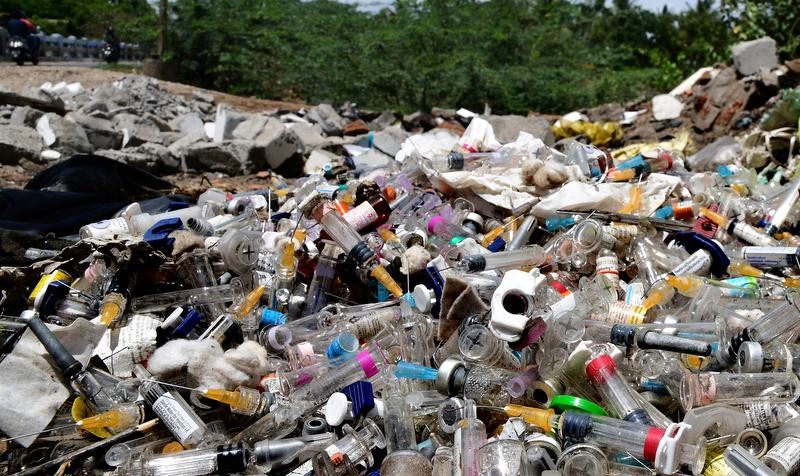
- 30 Nov 2024
The Emergence of HIV and Global Panic
In 1983, scientists Luc Montagnier and Robert Gallo independently identified the virus responsible for AIDS. By the mid-1980s, HIV/AIDS was perceived as a biological death sentence, with the virus primarily attacking immune cells, making medical intervention difficult. The epidemic quickly became associated with fear, ignorance, and stigma, as it was often linked to marginalized groups.
The "Syringe Tide" Incident and Public Outrage
In August 1987, the U.S. faced a public health crisis when discarded medical waste, including syringes and blood vials, washed up on beaches along the Atlantic coast. Known as the "Syringe Tide," this incident shocked the public and fueled anxiety, especially when children were seen playing with syringes. Traced to improper waste disposal in New York City, the event highlighted the hazardous nature of medical waste, which had been previously underestimated. Combined with the HIV/AIDS epidemic, this incident amplified public fear and economic losses of up to $7.7 billion due to the decline in tourism.
U.S. Response: Medical Waste Tracking Act of 1988
The widespread outrage led to the U.S. government passing the Medical Waste Tracking Act in 1988. This was the first law to formally categorize hospital waste as hazardous. The Act introduced stringent guidelines for the handling, transportation, and disposal of medical waste, establishing systemic regulation and oversight. It marked a significant turning point in both public health and environmental safety, changing how medical waste was managed in the healthcare sector.
India’s Journey in Biomedical Waste Management
Initial Steps and Delays
While the U.S. responded swiftly to the crisis, India’s approach to managing biomedical waste was slower. In 1986, India enacted the Environmental Protection Act, which marked the country’s first significant step towards environmental conservation. That same year, India identified its first HIV case. However, biomedical waste was not yet recognized as hazardous, and the Hazardous Waste (Management and Handling) Rules of 1989 failed to address the issue. As a result, local bodies were left to manage waste disposal, leading to inefficiencies.
Judicial Intervention and Legislative Action
In the 1990s, as pollution levels rose, particularly in urban areas like Delhi, the inadequacies of the system became apparent. In the landmark case Dr. B.L. Wadehra vs. Union of India (1996), the Supreme Court criticized Delhi’s waste management system, calling the city an "open garbage dump." This judgment led to a nationwide conversation on waste management and resulted in the Biomedical Waste (Management and Handling) Rules of 1998, marking the formal recognition of hospital waste as hazardous. The rules empowered the Central and State Pollution Control Boards to regulate waste disposal, ensuring accountability.
The Link Between HIV and Biomedical Waste Regulations
The HIV crisis highlighted the need for safe disposal practices to protect the environment and healthcare workers. While India charted its own course, the global response to HIV, particularly the U.S. model, influenced India’s approach to biomedical waste management. Over the years, India has made significant progress, with amendments to the rules in 2016 and 2020 to improve waste management technology and ensure safe disposal.
Current Challenges and Progress
- Ongoing Issues in Biomedical Waste Management: Despite significant progress, challenges remain, especially in rural and resource-limited areas. Mishandling of biomedical waste continues to pose risks, and healthcare professionals still face occupational hazards. Gaps in compliance and awareness persist, but the system’s progress is undeniable.
Conclusion
The HIV/AIDS epidemic, while tragic, indirectly led to significant improvements in healthcare waste management. As the crisis highlighted the dangers of improper waste disposal, it spurred legislative and systemic changes that have contributed to safer healthcare environments. The progress in biomedical waste management demonstrates that crises can often lead to long-term improvements.
India’s Urban Infrastructure
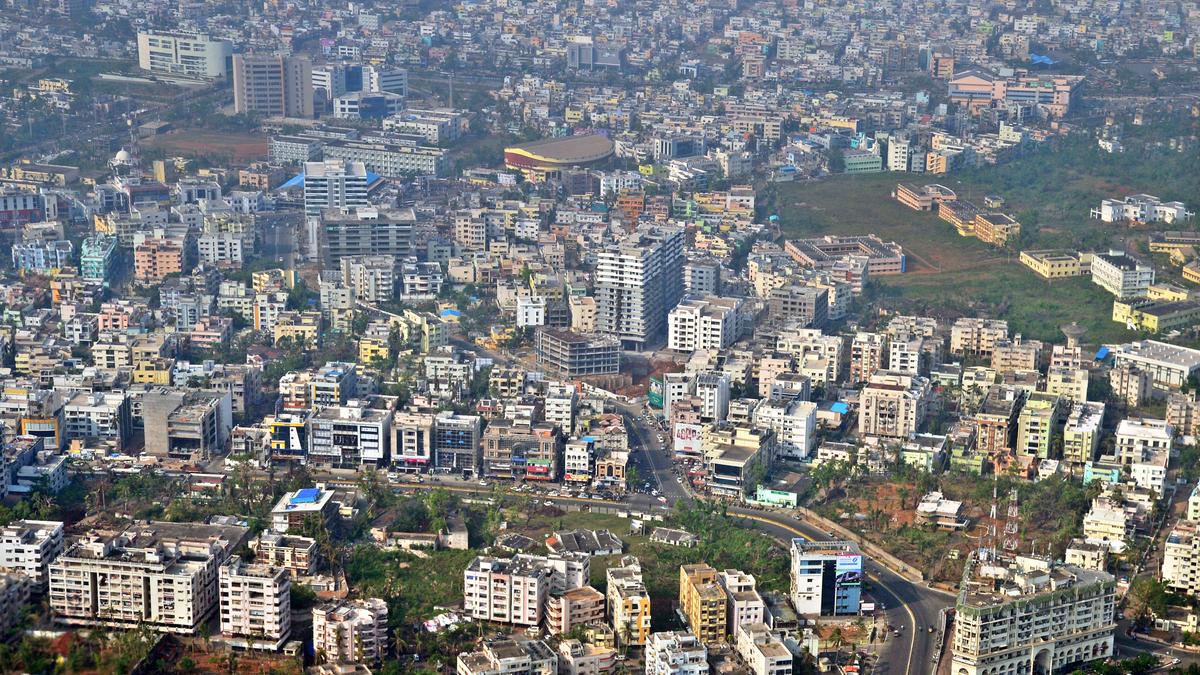
- 28 Nov 2024
Introduction
India’s urban population is projected to double from 400 million to 800 million by 2050. This demographic shift presents both challenges and opportunities for transforming the country’s urban infrastructure. To meet the growing needs of urban areas, India will require an investment of approximately ?70 lakh crore by 2036, a figure significantly higher than current spending levels.
Financial Challenges in Urban Infrastructure
- Investment Gap
- The current annual investment in urban infrastructure stands at ?1.3 lakh crore, which is only 28% of the ?4.6 lakh crore needed annually.
- A large portion of the existing investment, around 50%, is directed towards basic urban services, with the remainder allocated to urban transport.
- Municipal Finances
- Municipal finances have remained stagnant at 1% of GDP since 2002.
- Despite increased transfers from the central and state governments, municipal bodies face financial strain.
- The contribution of municipal own-revenue has decreased from 51% to 43%, indicating a reduced financial independence.
- Revenue Collection Inefficiencies
- Urban local bodies (ULBs) are collecting only a small fraction of their potential revenues, with property tax collections representing just 0.15% of GDP.
- Cost recovery for essential services like water supply and waste management ranges between 20% and 50%, pointing to a significant funding gap.
- Underutilization of Resources
- Cities like Hyderabad and Chennai utilized only 50% of their capital expenditure budgets in 2018-19.
- Central schemes such as AMRUT and the Smart Cities Mission also showed suboptimal fund utilization, with utilization rates of 80% and 70%, respectively.
- Decline in Public-Private Partnerships (PPPs)
- Investments through PPPs in urban infrastructure have seen a sharp decline, from ?8,353 crore in 2012 to ?467 crore in 2018.
- This drop is attributed to limited project-specific revenues and inadequate funding mechanisms.
Structural and Administrative Challenges
- Weak Governance and Fragmented Management
- Fragmented governance and limited administrative autonomy hinder effective urban planning and resource allocation.
- Municipal bodies often lack the ability to undertake long-term planning and project execution due to these governance challenges.
- Climate Vulnerability and Sustainability: Urban areas are increasingly vulnerable to climate risks like floods and heatwaves. However, many urban infrastructure projects fail to incorporate climate resilience in their planning, exacerbating the long-term vulnerability of investments.
- Inadequate Land Management
- There is poor coordination between land use planning and infrastructure development, resulting in urban sprawl and inefficient transportation systems.
- Opportunities to capitalize on the land value generated by metro and rail projects remain underutilized.
Measures for Transforming Urban Infrastructure
- Streamline Revenue Collection: Leverage technology to improve property tax collection systems and enhance cost recovery in essential services.
- Enhance Fund Utilization: Strengthen municipal capacities for effective project planning and incentivize the timely use of allocated grants.
- Scale Public-Private Partnership (PPP) Investments: Develop a pipeline of bankable projects and create risk-sharing mechanisms to attract private sector investments.
- Decouple Project Preparation from Funding: Ensure that infrastructure projects are thoroughly prepared for financial, social, and environmental sustainability before seeking funding.
- Promote Urban Innovation: Establish urban innovation labs and encourage public-private-academic collaborations to foster the adoption of advanced technologies.
- Empower Municipalities: Grant municipalities greater financial autonomy, enabling them to raise capital through municipal bonds and other debt mechanisms.
- Integrated Urban Planning: Align infrastructure development with land use, transport, and housing requirements, while integrating climate resilience into planning.
- Capacity Building: Invest in the training of municipal staff to improve governance and financial management capabilities.
Conclusion
India’s expanding urban population presents a major opportunity for economic growth. However, addressing the financial and structural challenges in urban infrastructure is crucial for harnessing this potential. By adopting a combination of short-term actions, medium-term strategies, and long-term reforms, India can create sustainable, resilient urban infrastructure that meets the growing needs of its cities, fostering inclusive development and long-term prosperity.
The Fight for Accessibility and Dignity in Indian Prisons
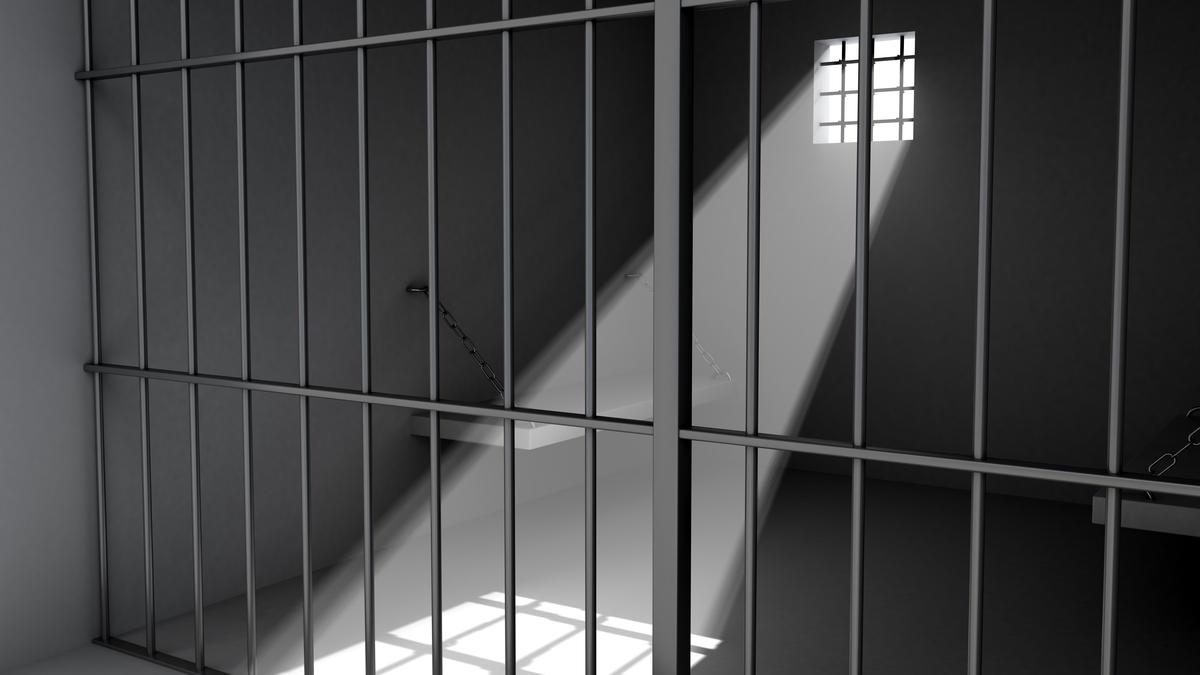
- 24 Nov 2024
Introduction
Prisons in India face numerous systemic issues, with overcrowding, abuse, and neglect being prevalent. For prisoners with disabilities, these challenges are magnified, as they struggle with basic needs and lack necessary accommodations. This issue is not only a human rights violation but also a failure in the implementation of legal protections.
Prison Conditions and Accessibility Issues for Disabled Inmates
- Challenges Faced by Disabled Prisoners: Disabled prisoners, such as Professor G.N. Saibaba, who spent a decade in prison before being exonerated, face severe challenges in performing everyday tasks like using toilets or taking baths. His experience of being physically lifted by fellow inmates due to the lack of wheelchair accessibility highlights the systemic neglect.
- Exclusion and Abuse: Prisoners with disabilities are particularly vulnerable to abuse, as their specific needs are ignored. The government does not track the number or conditions of disabled prisoners, which leads to neglect and mistreatment. Notably, Father Stan Swamy, who had Parkinson's disease, was denied essential items like a straw, affecting his ability to eat and drink.
Legal Framework and International Obligations
- Constitutional Protections: The Indian Constitution guarantees rights to prisoners, including protection from torture (Article 21) and the right to fair legal processes (Article 22). The Supreme Court has reinforced the need for humane treatment in prisons through various judgments.
- International Commitments: India has committed to international conventions such as the United Nations Convention on the Rights of Persons with Disabilities and the Nelson Mandela Rules, which require reasonable accommodations for disabled prisoners. Despite these commitments, the practical enforcement of such rights remains minimal.
- Domestic Legislation: The Rights of Persons with Disabilities Act, 2016, mandates the protection of disabled individuals from abuse and exploitation. However, violations like the denial of basic assistive devices to prisoners show a gap in enforcement. The Ministry of Home Affairs has issued guidelines for prison accessibility, but they have yet to be widely implemented.
Systemic Failures and Lack of Political Will
- Overcrowding and Inadequate Infrastructure: Indian prisons house over 5.73 lakh prisoners, far exceeding their capacity. This overcrowding exacerbates the challenges faced by disabled prisoners, as the infrastructure is inadequate to meet their needs. A 2018 audit of Delhi’s prisons revealed significant accessibility gaps, such as inaccessible cells and toilets, making daily life for disabled prisoners even more difficult.
- Political Apathy and Public Indifference: Many believe that prisoners deserve their suffering, fueling a lack of urgency in addressing prison reforms. However, the state is responsible for ensuring the rights and dignity of all prisoners, including those with disabilities. There is a need for a shift in societal attitudes to ensure that these rights are upheld.
Reforms and the Way Forward
- Infrastructure and Accessibility: Prisons must implement universal design principles, ensuring that infrastructures are accessible to all, especially prisoners with disabilities. This includes accessible cells, toilets, and common areas, as well as functional wheelchairs.
- Judicial and Legal Reforms: The judicial system must expedite trials, especially for undertrials, and ensure that all prisoners have access to legal representation. This would help alleviate the overcrowding crisis and improve the overall functioning of the prison system.
- Comprehensive Rehabilitation and Welfare Programs: Prison systems need to focus on rehabilitation rather than mere punishment. Programs for skill development, education, and mental health support should be integrated into prison routines, providing prisoners with opportunities for personal growth and reintegration into society.
- Strengthening Oversight Mechanisms: There must be greater transparency in prison management through independent oversight bodies and regular audits. A whistleblower mechanism can help report violations of prisoner rights, ensuring greater accountability.
India’s Agricultural Sector
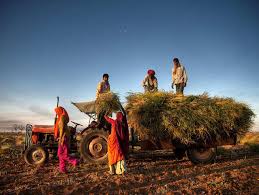
- 23 Nov 2024
In News:
India’s agricultural sector, which employs 42.3% of the population, is crucial to the nation’s economy. However, it faces a range of challenges that need to be addressed to ensure long-term stability, food security, and sustainable growth.
Current Performance of India’s Agricultural Sector
- Key Agricultural Metrics and Growth
- Foodgrain Production: India produced 330.5 million metric tonnes (MT) of foodgrains in 2022-23, maintaining its position as the world’s second-largest producer.
- Horticulture Production: A record high of 351.92 million tonnes in horticultural production was achieved, marking a 1.37% increase from the previous year.
- Market Outlook
- India’s agricultural market is projected to reach USD 24 billion by 2025.
- The food and grocery retail sector is ranked as the sixth-largest globally, with 70% of its sales generated from retail.
- Investment and Export Trends
- FDI in Agriculture: From April 2000 to March 2024, the agricultural services sector attracted USD 3.08 billion in foreign direct investment, while the food processing industry garnered USD 12.58 billion.
- Agricultural Exports: India’s agricultural and processed food exports reached USD 4.34 billion in 2024-25, including products like marine products, rice, and spices.
Key Challenges Confronting India’s Agriculture
- Climate Change and Environmental Impact:Extreme weather events, such as heatwaves and erratic rainfall, continue to impact agricultural productivity. In 2023, India experienced its second-warmest year on record, contributing to crop damage and rising food prices.
- Water Stress and Irrigation Inefficiency: Agriculture consumes the majority of India’s water resources, but irrigation efficiency is still low. The country relies heavily on flood irrigation, which leads to significant water wastage. Only 11% of agricultural land is under micro-irrigation, far below global standards.
- Land Fragmentation and Declining Farm Sizes: The average size of agricultural farms has decreased from 1.08 hectares in 2016-17 to 0.74 hectares in 2021-22, hindering the adoption of modern farming practices and mechanization.
- Market Access and Price Realization: Farmers continue to face challenges in accessing fair market prices due to the dominance of intermediaries and inadequate market infrastructure. Despite reforms like e-NAM, price gaps between farm-gate and retail prices persist, leaving farmers with a smaller share of the final price.
- Technology Adoption and Digital Divide: Although agritech is growing in India, only 30% of farmers use digital tools in agriculture, and rural digital literacy is just 25%, which limits the widespread adoption of modern farming solutions.
Addressing Structural Issues in Indian Agriculture
- Soil Health and Sustainability:The excessive use of chemical fertilizers and mono-cropping practices has led to soil degradation. Approximately 30% of agricultural land in India is experiencing degradation, impacting productivity and sustainability. Stubble burning further exacerbates this issue, worsening air quality and soil health.
- Crop Diversification Challenges:Many farmers are locked into the wheat-rice cycle due to Minimum Support Price (MSP) guarantees, limiting the cultivation of other crops like pulses and oilseeds. Although India is the largest producer of pulses, the domestic production is insufficient to meet the growing demand.
- Feminisation of Agriculture:Women make up 63% of agricultural workers but own only 11-13% of the operational land, limiting their access to resources and decision-making power. This gender disparity hampers their economic security and limits their participation in agricultural development.
Conclusion
India’s agricultural sector holds immense potential but is facing significant structural challenges that must be addressed to ensure its long-term growth and sustainability. Urgent reforms are needed to address issues like climate vulnerability, inefficient irrigation, land fragmentation, and limited market access. Additionally, fostering technology adoption, improving infrastructure, and addressing gender disparities will be crucial for improving the sector's performance and securing India’s food security needs.
Janaagraha’s Report on Urban Local Bodies
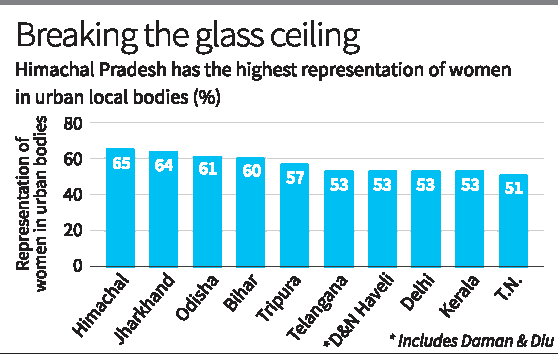
- 22 Nov 2024
In News:
46% of councillors in urban local bodies are women, says a report by Janaagraha, a not-for-profit organisation working to strengthen systems of governance in India’s cities.
Overview: Gender Representation in Urban Local Bodies
- Women Councillors in India: Around 46% of councillors in urban local bodies (ULBs) are women, according to a recent report by Janaagraha, a non-profit organization focused on strengthening urban governance systems.
- Capital Cities: In 19 out of 21 capital cities with active ULBs (such as Patna, Shimla, Ranchi, and Bhubaneswar), women councillors exceed 60% of the total councillor count.
Top States for Women Councillors
- Tamil Nadu stands out with the highest number of women councillors in the country, according to the "Roadmap for India’s City Systems Reforms" report by Janaagraha.
- Other States in the Top 10:
- Rajasthan, Madhya Pradesh, Maharashtra, Andhra Pradesh, Karnataka, Uttar Pradesh, Kerala, Bihar, and Chhattisgarh.
Women’s Reservation and Empowerment
- 50% Reservation: 17 states have legislated 50% women’s reservation in urban local bodies, surpassing the constitutional minimum of 33%.
Pathways for Urban Transformation
- Three Key Recommendations:
- Place-Based Governance: Advocates for governance focused on regional economies and local governments rather than sector-driven policies.
- Decentralised Participatory Governance: Emphasizes the need to strengthen urban local governments and increase citizen participation through the 74th constitutional amendment.
- Building State Capacities: Calls for a more effective role of the Ministry of Housing and Urban Affairs and state urban departments focused on local self-government.
Rural-Urban Transition and Policy Reforms
- Urbanization of Villages: The report highlights that about 1,000 villages have already transitioned into urban areas since the 2011 Census, urging the need for a rural-urban transition policy.
- Reimagine Urban Ministries: Recommends restructuring urban ministries to focus on regional economies and the strengthening of local governance institutions.
Key Challenges in Urban Governance
- Delays in Elections: 61% of ULGs in 15 states have delayed council elections.
- Disempowered Local Bodies: Mayors and ULGs often lack autonomy, with control over only four out of 18 functions.
- Citizen Participation Gaps: There is a lack of formal platforms for citizen involvement in governance.
Skilling and Capacity Building
- Certification-Based Training: Proposes skilling programs for ULG staff, with a focus on improving municipal efficiency and project implementation.
- Shared Service Centres: Recommends creating municipal service centres to benefit smaller cities and enhance urban management.
Conclusion: Need for Place-Based Governance
- Strategic Shift: Srikanth Viswanathan, CEO of Janaagraha, emphasized the need to shift away from a sector-based governance model to a place-based governance approach, better suited to the urban challenges of modern India.
Sustainable Path to Net-Zero for India
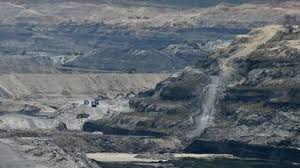
- 19 Nov 2024
In News:
India's commitment to achieving net-zero carbon emissions by 2070 presents a significant challenge, with only 45 years remaining to reach this ambitious target. The path to net-zero requires a balancing act between economic development, energy security, and climate adaptation. India’s efforts to meet its climate goals will be shaped by multiple factors, including resource constraints, land use, and financial limitations.
Why Net-Zero at All?
- Scientific Consensus on Climate Change
- Climate change is a growing concern, with the global temperature rise already reaching 1.1°C above pre-industrial levels.
- To avoid catastrophic impacts, the world needs to limit the temperature rise to 1.5°C. The remaining global carbon budget for this target is around 400-500 billion tonnes of CO?.
- Necessity of Sharp Emission Reductions
- Countries must drastically reduce emissions to stay within the carbon budget. Achieving net-zero emissions is essential for maintaining global climate stability.
Equity in Net-Zero Transitions
- Developed vs. Developing Countries
- Developed nations, historically responsible for a large share of emissions, are expected to lead the transition. However, they have not met the financial and technological support commitments for developing countries.
- Developing nations like India, with low per capita emissions, are under pressure to balance climate action with economic development.
- Climate Justice
- India’s per capita emissions are among the lowest globally, but the richest 10% of Indians contribute significantly to national emissions, exacerbating inequality.
- The impacts of climate change disproportionately affect the economically weaker sections, making the transition to net-zero not only an environmental challenge but a social justice issue as well.
The Challenge of Balancing Development and Sustainability
- Limits of India’s Resources
- India faces resource constraints, including land, water, and biodiversity, which limit the feasible expansion of renewable energy capacity.
- Meeting energy demands while ensuring food security, forest cover, and biodiversity preservation becomes increasingly challenging as energy requirements rise.
- Sustainable Consumption vs. Aspirational Lifestyles
- India’s aspiration to emulate the developed world’s lifestyle is unsustainable due to limited resources, which could lead to severe consequences like groundwater depletion, heat stress, and biodiversity loss.
- The focus should be on sufficiency consumption corridors, ensuring that consumption meets developmental goals without exceeding sustainable limits.
Projected Power Demand and Renewable Energy Targets
- Rising Power Demand
- India’s power demand could increase nine to ten-fold by 2070. Meeting this demand entirely via renewable energy requires significant expansion in energy generation capacity:
- 5,500 GW of solar energy
- 1,500 GW of wind energy
- India’s power demand could increase nine to ten-fold by 2070. Meeting this demand entirely via renewable energy requires significant expansion in energy generation capacity:
- Land Use Constraints
- To meet these targets, India must address land-use trade-offs. Expanding beyond 3,500 GW of solar and 900 GW of wind would require significant compromises in land availability for other uses, including agriculture and conservation.
Strategic Pathways to Net-Zero: Demand and Supply Measures
- Demand-Side Measures
- Energy-efficient construction: Use of better materials and passive designs to reduce cooling energy demand.
- Urban transport: Shift to public and non-motorized transport to reduce energy consumption in cities.
- Dietary choices: Promoting sustainable dietary practices to reduce the carbon footprint of food systems.
- Electrification: Focus on alternative fuels and energy-efficient appliances.
- Supply-Side Measures
- Decentralization of Energy Production: Expanding rooftop solar panels and solar pumps for agriculture.
- Nuclear Power Expansion: Increase nuclear energy to provide a low-carbon baseload and complement renewable sources like solar and wind, which are intermittent.
The Role of International Cooperation and Financial Support
- Global Cooperation
- Global climate action requires alignment between national interests, which may not always coincide, as seen in the context of the U.S. presidential election potentially influencing global climate policy.
- India’s path to net-zero depends heavily on international climate financing, technology transfer, and collaborative efforts to address climate justice.
- Equitable Financing for Developing Countries
- Developed countries are expected to provide financial support to developing nations like India to achieve climate goals. However, this support has been insufficient to date.
Conclusion: India’s Balancing Act
India faces a challenging balancing act as it seeks to provide quality of life for its growing population while achieving its climate adaptation and mitigation goals. The path to net-zero will require careful management of economic growth, energy production, and resource conservation. India must focus on demand-side strategies to reduce energy consumption and increase efficiency while expanding renewable energy infrastructure in a sustainable manner. Additionally, international cooperation and financial support will be crucial in ensuring that India’s transition to net-zero is equitable, efficient, and aligned with its developmental priorities.
Net Borrowing Ceiling
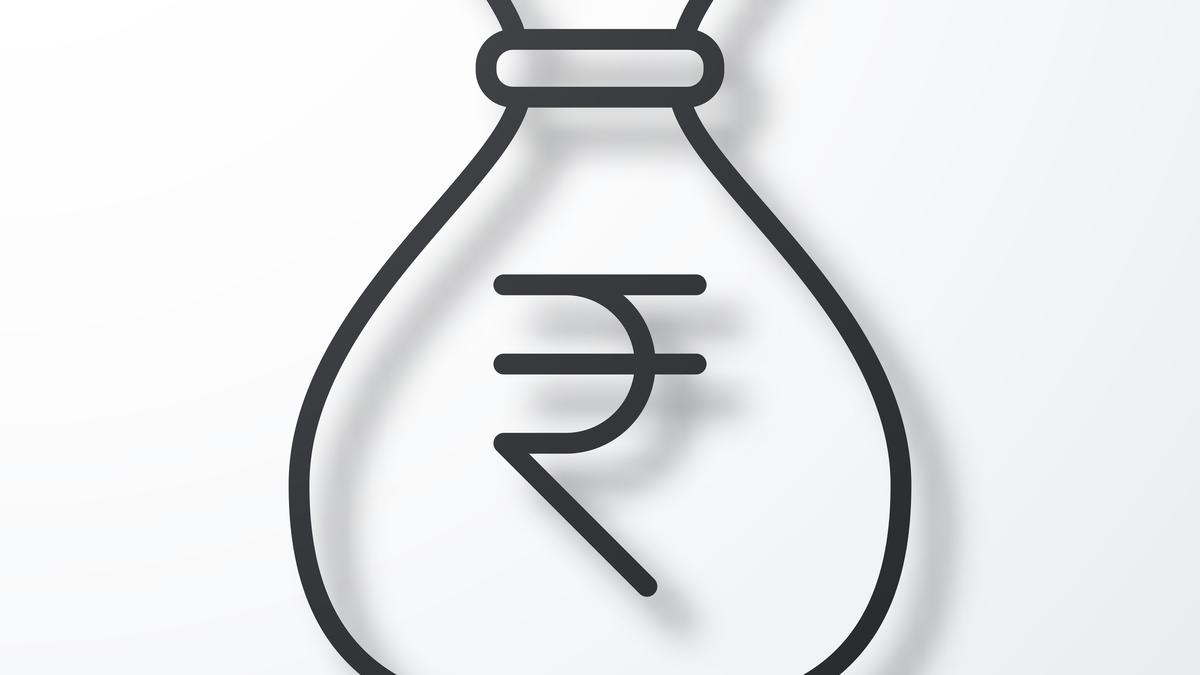
- 16 Nov 2024
In News:
- In 2023, the central government imposed a Net Borrowing Ceiling (NBC) on Kerala, limiting its borrowing capacity to 3% of the projected Gross State Domestic Product (GSDP) for the fiscal year 2023-24.
- Impact on Kerala’s Finances: This ceiling has significantly impacted Kerala’s ability to meet its expenditure needs and fund developmental activities, triggering political and legal disputes. Kerala has approached the Supreme Court of India, arguing that the imposition of NBC infringes upon its constitutional rights under Article 293 of the Indian Constitution.
Constitutional Provisions on Borrowing Powers
Article 292: Borrowing Powers of the Centre
- Central Government’s Borrowing: Article 292 grants the Central Government the authority to borrow money on the security of the Consolidated Fund of India.
- Limits on Borrowing: The extent of borrowing by the Centre is determined by laws enacted by Parliament.
Article 293: Borrowing Powers of the States
- State Borrowing: Article 293 allows State Governments to borrow within India against the Consolidated Fund of the State. However, it imposes certain conditions:
- If a State has outstanding loans or guarantees given by the Centre, the Centre’s consent is required to raise further loans.
- The Central government can impose conditions when granting such consent.
Centre’s Role in State Borrowing
- Article 293(3) allows the Centre to impose conditions on a state’s borrowing if it has existing liabilities or guarantees outstanding.
- The Centre has wide discretion in granting or denying consent, which has been a point of contention in Kerala’s case.
The Imposition of Net Borrowing Ceiling (NBC)
Scope of the NBC
- Comprehensive Coverage: The NBC encompasses all borrowing avenues, including open market loans, loans from financial institutions, and liabilities from State public accounts. To curb circumventing of the borrowing cap via State-owned enterprises, the NBC also covers borrowings by these entities.
Purpose of NBC
- Fiscal Discipline: The NBC is designed to regulate borrowing and prevent states from accumulating unsustainable levels of debt, thus ensuring financial stability.
- Transparency: By including all borrowing avenues, including off-budget borrowings by state-owned enterprises, the NBC aims to provide a clearer picture of a state’s financial health.
Arguments for the NBC
- Macroeconomic Stability: The NBC helps maintain macroeconomic stability by controlling the borrowing levels of states, thus protecting the national economy.
- Compliance with FRBM Act: The NBC aligns with the Fiscal Responsibility and Budget Management (FRBM) Act, aiming to keep the fiscal deficit within prescribed limits.
- Equitable Resource Distribution: The NBC ensures that wealthier states do not disproportionately borrow, thus promoting balanced regional development.
Arguments Against the NBC
- Erosion of Fiscal Autonomy: Critics argue that the NBC undermines the fiscal autonomy of states, as guaranteed by Article 293, by restricting their ability to make independent financial decisions.
- Impact on Developmental Activities: States, particularly Kerala, contend that the borrowing cap restricts their ability to fund key infrastructure projects and social welfare activities.
- Legal Concerns: The NBC’s impact on the interpretation of Article 293 raises legal questions regarding the extent of the Centre’s authority over state borrowing powers.
Fiscal Responsibility and Budget Management (FRBM) Act
Overview of the FRBM Act
- Objective: The FRBM Act, 2003 was enacted to promote fiscal discipline and ensure long-term financial stability in India.
- Key Features:
- Targets a 3% fiscal deficit of GDP for the Centre.
- Requires states to enact similar laws to control their fiscal deficit.
Amendments to FRBM Act
- 2018 Amendment: The FRBM Amendment Act required the central government to ensure that the fiscal deficit did not exceed 3% of GDP and total public debt remained under 60% of GDP.
- Fiscal Deficit Reduction: By 2025-26, the fiscal deficit is expected to be reduced to below 4.5% of GDP.
Way Forward: Strengthening Article 293
Guidelines for Borrowing Powers
- Transparency in Decision-Making: The Centre should ensure that the borrowing process is transparent, with clear standards and procedures for accepting or rejecting state borrowings.
- Consultative Process: The Centre should engage in consultations with states before imposing borrowing caps or conditions, fostering a cooperative federal structure.
- Equitable Treatment: Borrowing restrictions should apply uniformly to all states to avoid bias or favoritism.
Strengthening Fiscal Federalism
- Fiscal Autonomy: States should be given the flexibility to manage their finances in a way that reflects their unique economic needs and challenges.
- Periodic Reviews: The Net Borrowing Ceiling should be reviewed periodically to account for changing economic conditions and developmental priorities.
Chief Justice of India
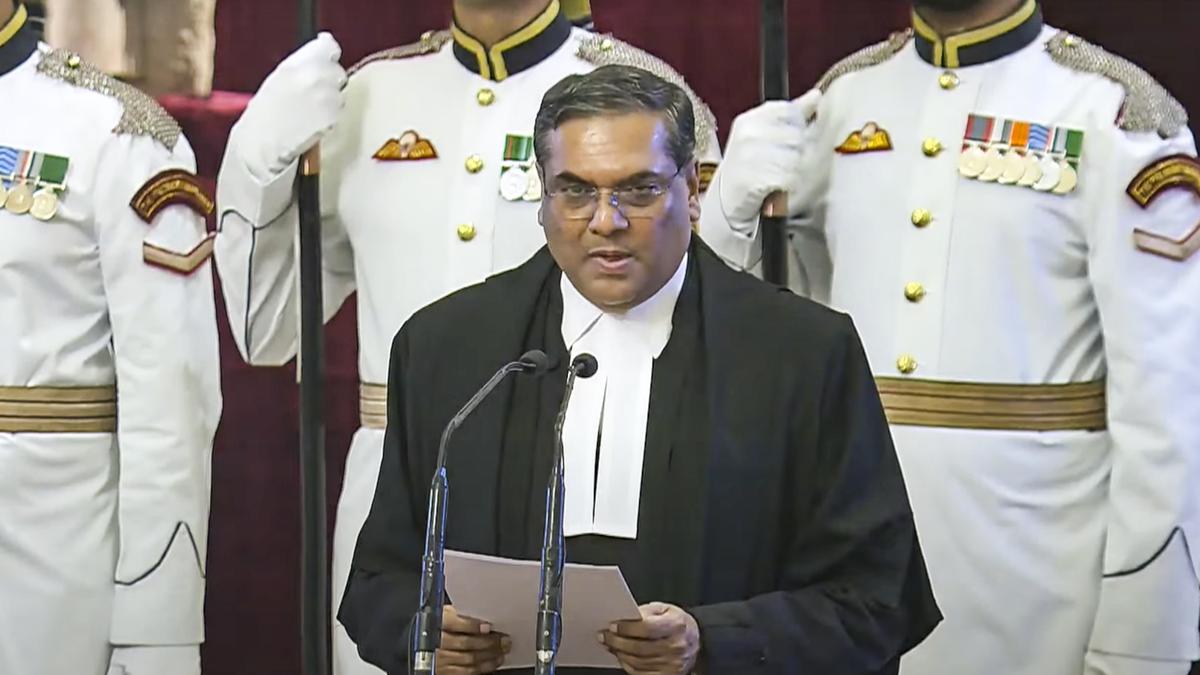
- 13 Nov 2024
In News:
On November 11, 2024, Justice Sanjiv Khanna was sworn in as the 51st Chief Justice of India (CJI) at the Rashtrapati Bhavan, New Delhi, marking a significant milestone in the Indian judiciary. He succeeds Justice D.Y. Chandrachud, who retired on November 10, 2024. Justice Khanna's term as CJI will last until May 13, 2025.
Background of Justice Sanjiv Khanna
Early Life and Legal Career
- Legal Practice: Justice Khanna began his legal career in 1983 after completing his law degree from Delhi University. He practiced in the District Courts of Delhi and handled cases in constitutional law, taxation, arbitration, and environmental law.
- Career in Delhi High Court: He was appointed as an Additional Judge to the Delhi High Court in 2005 and became a Permanent Judge in 2006.
- Appointment to the Supreme Court: Justice Khanna was appointed as a Supreme Court Judge in January 2019, without having served as a Chief Justice of a State High Court, and superseding 32 senior High Court judges.
Key Judicial Rulings of Justice Sanjiv Khanna
Major Constitutional Bench Decisions
- Abrogation of Article 370: Justice Khanna was part of the Bench that upheld the abrogation of Article 370 of the Constitution, which revoked Jammu and Kashmir’s special status.
- Electoral Bonds Scheme: He also contributed to the ruling that struck down the 2018 Electoral Bonds scheme, raising questions about the transparency of political funding.
Support for EVMs
- Justice Khanna defended the use of Electronic Voting Machines (EVMs) and rejected calls to revert to paper ballots, emphasizing the need for technological progress and institutional trust.
Personal Liberty and Bail Decisions
- Arvind Kejriwal’s Interim Bail: Justice Khanna granted interim bail to Delhi Chief Minister Arvind Kejriwal in the liquor policy case, underscoring personal liberty as a fundamental right.
- Judicial Review of Bail Conditions: He also initiated discussions on setting standards for bail conditions in cases involving significant political figures.
Role of the Chief Justice of India (CJI)
Appointment Process
- Article 124(2): A Supreme Court judge is appointed by the President of India, with the senior-most judge of the Supreme Court traditionally becoming the CJI.
- Qualifications: The CJI must be a citizen of India and have served as a judge in a High Court for at least five years or as an advocate in a High Court for ten years.
Powers and Responsibilities
- Master of the Roster: The CJI is the "Master of the Roster," responsible for assigning cases to specific benches and determining the court's schedule.
- Collegium System: The CJI, along with four senior judges, forms the Collegium that recommends judicial appointments for the Supreme Court and High Courts.
- Ad-Hoc Appointments: The CJI can also appoint ad-hoc judges to the Supreme Court under Article 127 of the Constitution.
Removal
- A CJI can only be removed through a process initiated in Parliament, requiring a special majority in both Houses of Parliament.
Appointment of CJI in Other Countries
United States
- The Chief Justice of the United States serves for life, with tenure continuing until impeachment or voluntary retirement.
United Kingdom
- The Lord Chief Justice in the UK is appointed by a special panel from the Appeal Court or the Supreme Court. The tenure is life, but mandatory retirement is set at 75 years of age.
Conclusion
Justice Sanjiv Khanna’s appointment as the 51st Chief Justice of India represents a significant moment in the country's judicial history. With his extensive experience and legal acumen, he faces numerous challenges, from dealing with case pendency to navigating sensitive constitutional issues. His tenure will likely shape the future trajectory of the Indian judiciary, with a focus on upholding justice and personal liberty while addressing the evolving needs of a democratic society.
What are the costs of population decline?
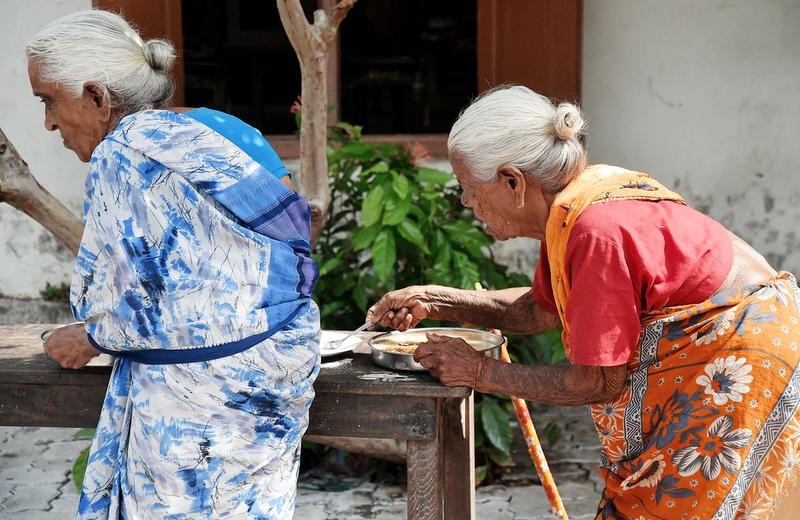
- 11 Nov 2024
In News:
India has been witnessing significant demographic changes due to decades of family planning policies. This has led to declining fertility rates in certain States, particularly in the southern and smaller northern regions.
Introduction: Demographic Shift in India
- Southern States’ Fertility Trends: States like Tamil Nadu, Kerala, Andhra Pradesh, and Telangana have fertility rates below the replacement level (around 1.4–1.5), while Bihar, Uttar Pradesh, and Madhya Pradesh have higher fertility rates (2.6–3).
- Ageing Population: Southern States face the challenge of an ageing population, with Kerala projected to have 22.8% of its population aged 60+ by 2036, while Bihar will have only 11%.
Economic and Health Impact of Population Decline
- Economic Consequences:
- Dependency Ratio: The old-age dependency ratio (the number of elderly for every 100 working-age individuals) has increased significantly in some States. Kerala, for example, had a ratio of 26.1 in 2021, signaling a crisis point.
- Loss of Demographic Dividend: States with declining fertility rates face the loss of a demographic dividend, i.e., the economic benefit from a large working-age population, which is increasingly burdened by elderly dependents.
- Health Expenditure: Rising healthcare costs, especially for cardiovascular diseases in southern States, will strain public health systems. The southern States, although comprising one-fifth of India's population, spent 32% of the country’s total out-of-pocket expenditure on cardiovascular diseases in 2017-18.
- Challenges of Low Fertility:
- Declining Labour Force Participation: Policies encouraging higher fertility may also reduce women’s labour force participation, undermining the economic growth of these States.
- Economic Pressures: Southern States, despite higher tax contributions, face a diminished share of central resources due to slower population growth. This is a point of concern in inter-State fiscal relations.
Political Implications of Uneven Population Growth
- Impact on Federal Structure:
- The uneven population growth across States will lead to significant changes in the delimitation of constituencies after the current freeze on seat allocation in Parliament expires in 2026.
- Redistribution of Lok Sabha Seats: Northern States like Uttar Pradesh and Bihar will likely gain more seats, while southern States like Tamil Nadu, Kerala, and Andhra Pradesh will lose seats due to their declining population shares.
- Challenges in Federal Relations:
- Southern States’ economic contributions through taxes are disproportionate to the resources they receive from the central pool, leading to growing tensions between high-growth and slow-growth regions.
- The shift in political power post-delimitation could increase regional disparities, potentially leading to political tensions between States.
Solutions and Policy Recommendations
- Pro-Natalist Policies:
- Southern States are considering pro-natalist policies to incentivize higher fertility rates. However, such measures have been largely unsuccessful internationally, especially when women’s economic independence and educational choices are restricted.
- International Experience: Attempts to incentivize childbearing, without addressing broader socio-economic factors like gender equality, have generally failed in other nations. Maternity benefits, gender-neutral parental leave, and childcare support are key to increasing fertility sustainably.
- Gender Equity and Work-Family Balance:
- Work-family policies that support paid maternity and paternity leaves, affordable childcare, and gender-neutral employment policies are essential to empower women to balance family and career.
- Studies indicate that countries with higher gender equity have better fertility rates because women are less likely to forgo childbearing for career reasons.
- Increasing Retirement Age:
- One way to reduce the old-age dependency ratio is to increase the retirement age, which would allow older workers to remain employed longer and support a sustainable economy.
- Social Security and pension reforms should also be considered to accommodate the ageing workforce and reduce the economic burden on younger generations.
- Managing Migration:
- Migration policies should be adjusted to manage the influx of economic migrants into southern States, who contribute to the economy but continue to be counted in their home States for fiscal and political purposes.
- Migration-based policy reforms could address the challenge of an ageing population in states with declining fertility while ensuring equitable resource distribution across States.
Indus Waters Treaty (IWT)
- 08 Nov 2024
In News:
Need for modification of the Indus Waters Treaty (IWT) amidst changing geopolitical, environmental, and demographic realities.
Background of the Indus Waters Treaty (IWT)
- About IWT:
- Signed in 1960 between India and Pakistan, brokered by the World Bank.
- Governs the sharing of the Indus River system waters.
- Historical Context:
- Origin in the Inter-Dominion Accord of 1948 post-partition.
- Finalized after negotiations facilitated by the World Bank in 1951.
- Key Provisions:
- Eastern Rivers (Ravi, Beas, Sutlej) allocated to India.
- Western Rivers (Indus, Jhelum, Chenab) allocated to Pakistan, with limited use allowed for India (e.g., hydropower, irrigation).
- Establishment of the Permanent Indus Commission (PIC) for cooperation and dispute resolution.
India’s Perspective
- Rationale for Modification:
- Increased demographic and agricultural demands.
- Need for sustainable water management.
- Acceleration of hydropower projects on western rivers permitted by the treaty.
- Security Concerns: Cross-border terrorism impacting trust in treaty operations.
Pakistan’s Concerns
- Dependence on Indus System: Critical for agriculture and drinking water as the lower riparian state.
- Potential Impacts of Modification:
- Fear of reduced water availability.
- Concerns over India’s hydropower projects altering water flow.
Current Challenges
- Hydropower Projects: Disputes over compliance with treaty provisions regarding hydropower construction.
- Technical Disputes: Divergent interpretations of treaty terms.
- Political Tensions: Strained bilateral relations with minimal diplomatic engagement.
- Climate Change Impacts: Altered precipitation patterns and glacial melt affecting water availability.
Arguments for Modifying the Treaty
- Addressing Contemporary Challenges: Climate change, technological advancements, and increased water demand.
- Securing National Interests:
- Clarifications on hydropower construction.
- Improved dispute resolution mechanisms.
Risks of Modifying the Treaty
- Escalation of Tensions: Perceived unilateral actions by Pakistan.
- Political Sensitivities: Domestic opposition in both countries.
Way Forward: A Balanced Approach
- Engagement and Dialogue: Bilateral discussions with potential third-party mediation (e.g., World Bank).
- Cooperation over Conflict: Recognizing mutual benefits of collaboration in water management.
- Adaptation Measures: Incorporate provisions addressing climate change and technological advances.
Zeroing in on Methane Diplomacy, at COP29
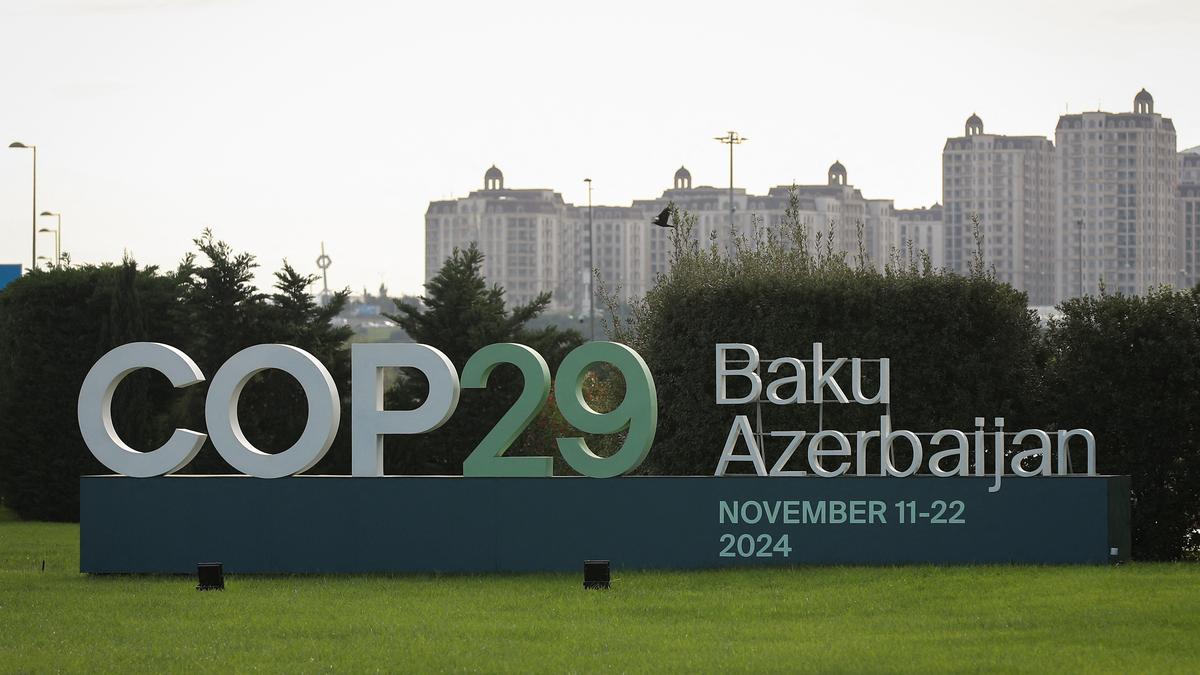
- 07 Nov 2024
In News:
From November 11 to 22, 2024, global leaders will gather in Baku, Azerbaijan, for the 29th Conference of Parties (COP29) under the United Nations Framework Convention on Climate Change (UNFCCC). This year’s summit, known as the Finance COP, will focus on setting a new global climate finance target—the New Collective Quantified Goal (NCQG).
A key focus of the summit is the reduction of methane emissions, as countries aim to curb near-term temperature increases, which buys critical time for long-term CO2 reductions necessary for stabilizing climate change.
U.S.-China Collaboration and Methane Reduction
US-China Collaboration Despite Geopolitical Tensions
Despite ongoing geopolitical tensions, the United States and China have found common ground on the issue of methane reduction. Both nations recognize the importance of addressing methane emissions, which are more potent in the short term than CO2. They, along with the United Arab Emirates, organized a summit at COP28 to discuss methane and other non-CO2 pollutants.
China’s National Plan for Methane Emissions
In November 2023, China launched its first national methane reduction plan, emphasizing capacity-building efforts over explicit reduction targets. This plan marked a significant step in China’s climate policy, underscoring its commitment to mitigating methane emissions alongside the U.S.
Given that China and the U.S. are the two largest contributors to methane emissions globally, their collaboration presents a significant opportunity for global climate mitigation efforts. India, the third-largest emitter of methane, could benefit from this partnership by seeking financial support and technical expertise to address its methane challenges.
India’s Methane Emissions Profile and Challenges
Emissions Breakdown
India’s Third Biennial Update Report to the UNFCCC indicates that in 2016, India emitted approximately 409 million tons of CO2-equivalent methane. The major sources of these emissions include:
- Agriculture: 74% (mainly from livestock and rice cultivation)
- Waste: 14% (unmanaged organic waste in landfills and dumpsites)
- Energy: 11%
- Industrial processes: 1%
Due to the dominant role of agriculture, India has been cautious about committing to stringent methane reduction targets. Initiatives like the Global Methane Pledge, which calls for a 30% reduction from 2020 levels by 2030, have not been fully embraced.
Environmental and Health Impact of Methane Emissions
Methane-related fires at waste dumpsites, such as the Bhalswa dump in Delhi (2022), have highlighted the broader environmental and health risks of methane emissions. These fires contribute significantly to air pollution, making it urgent for India to address methane in its waste management and agricultural sectors.
India’s Initiatives for Methane Reduction
Waste Management Programs
- Comprehensive Waste Management Framework India’s waste management sector is a significant source of methane, contributing 14% of the nation’s total emissions. Although a comprehensive regulatory framework for waste management has been developed, implementation remains slow due to local capacity constraints and financial limitations.
- Innovative Solutions Indore, a city in Madhya Pradesh, has pioneered waste sorting and biomethane production. The city's initiative includes:
- Sorting organic waste
- Converting it into biogas to fuel city buses
This model has gained national attention and is being considered for replication in other cities.
- GOBARdhan Scheme Launched as part of the Swachh Bharat Mission-Urban 2.0, the Galvanizing Organic Bio-Agro Resources Dhan (GOBARdhan) scheme encourages rural communities to convert cattle manure and other organic waste into biogas and compost, reducing methane emissions from livestock waste while providing additional income to rural households.
Agricultural and Livestock Emission Reduction
- National Mission for Sustainable Agriculture (NMSA) The NMSA promotes climate-resilient agricultural practices that reduce methane emissions. For example, Alternate Wetting and Drying (AWD) is a water-saving technique used in rice farming that reduces methane emissions by limiting anaerobic decomposition.
- National Livestock Mission Under the National Livestock Mission, practices such as improved fodder management, silage making, and Total Mixed Ration (TMR) feeding are being promoted. These practices reduce methane emissions from livestock by improving digestion and feed efficiency.
Opportunities for India at COP29
Leveraging U.S.-China Methane Partnership
COP29 offers India an opportunity to leverage the U.S.-China collaboration on methane reduction. By engaging with these two major emitters, India can seek:
- Financial support
- Technical assistance
- Capacity-building resources, particularly for its waste sector, which is a significant source of methane emissions.
Accurate data on methane emissions, such as satellite-based monitoring, can help India refine its emission inventories and enhance the effectiveness of its methane mitigation efforts.
Fast-Tracking India’s Methane Reduction Efforts
Although methane is not the primary focus at COP29, India has an opportunity to fast-track its efforts in methane reduction. The country's existing policies and initiatives, such as waste management programs and agricultural missions, provide a foundation upon which international collaboration can build.
Recent data from satellite monitoring in cities like Delhi and Mumbai shows that actual methane emissions from waste dumpsites may be 50%-100% higher than previously estimated, highlighting the urgency of addressing this issue.
Conclusion
Although methane may not dominate the COP29 agenda, it represents a critical pathway for India to accelerate its climate action. With the groundwork already laid through domestic policies and innovative solutions, India now requires enhanced financial and technical backing to scale up its methane reduction initiatives. By engaging proactively at COP29, India has a unique opportunity to secure the resources needed to tackle methane emissions, benefiting both its citizens and the global fight against climate change.
Supreme Court Ruling on Property and Redistribution
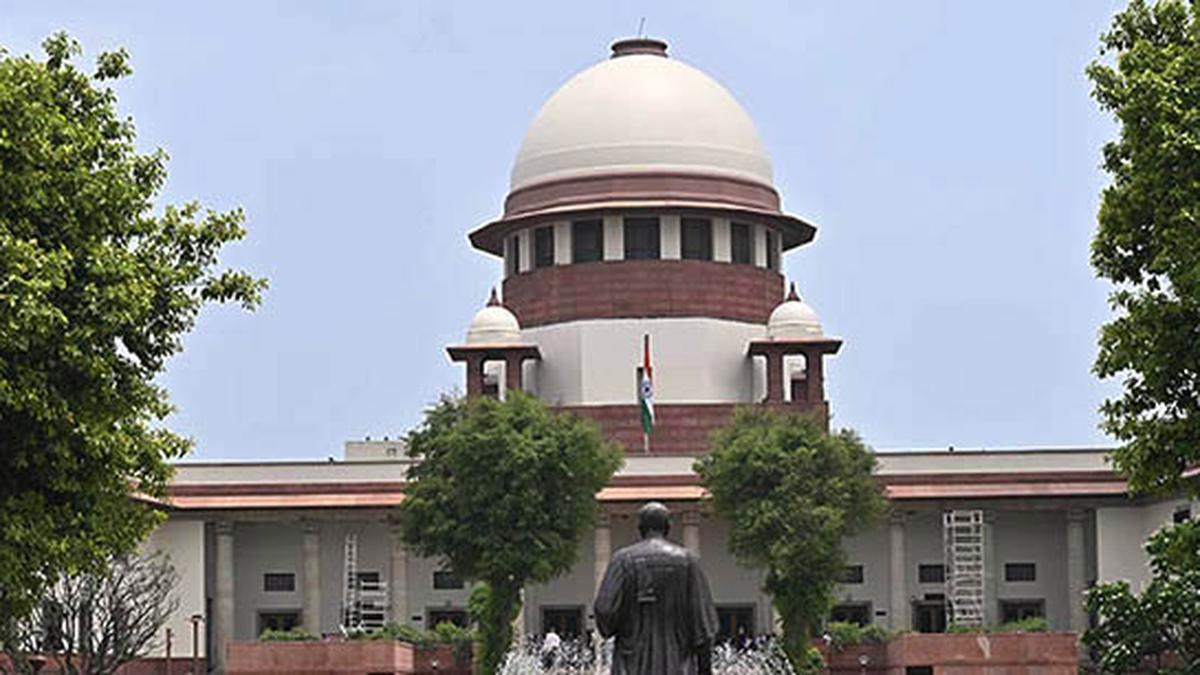
- 06 Nov 2024
In News:
A crucial 9-judge bench of the Supreme Court ruled on the scope of government powers over private property, with a focus on Articles 39(b) and 31C of the Constitution.
Key Issues Considered by the Court
- Article 31C: Whether it still protects laws giving effect to Articles 39(b) and 39(c), even after amendments and past rulings.
- Interpretation of Article 39(b): The meaning of “material resources of the community” and the limits on government acquisition.
Legal and Constitutional Background
- Article 31C and 39(b) Overview:
- Article 31C was introduced by the 25th Amendment (1971) to protect laws related to the distribution of resources for the common good.
- Article 39(b) (Directive Principle of State Policy) mandates that resources should be distributed to best serve the common good.
- Historical Context:
- Kesavananda Bharati Case (1973): The Supreme Court affirmed the Constitution’s "basic structure," impacting the interpretation of amendments to Article 31C.
- Minerva Mills Case (1980): The Court struck down further amendments to Article 31C.
The Supreme Court’s Ruling in 2024
- Restoration of the Post-Kesavananda Position: The Supreme Court clarified that the interpretation of Article 31C is restricted, and the protection under this article applies only to laws implementing Articles 39(b) and 39(c), not all directive principles.
- On Redistributing Private Property:
- The majority opinion held that not all privately owned properties can be considered “material resources of the community” for redistribution under Article 39(b).
- The Court dismissed the broad interpretation of "material resources" used in previous rulings (e.g., Justice Krishna Iyer’s dissent in the Ranganatha Reddy case, 1977).
Dissenting and Concurring Opinions
- Justice Nagarathna’s Concurring Opinion:
- Acknowledged that certain privately owned resources could be considered material resources (e.g., forests, wetlands), but emphasized a balanced approach.
- Distinguished between personal belongings and resources that could be considered part of the public domain.
- Justice Dhulia’s Dissent:
- Argued for a broader interpretation, in line with past rulings, that private resources could be considered material resources if they served the public good.
Interpretation of Article 39(b)
- Scope of the Article:
- Article 39(b) directs the State to ensure that the ownership of material resources is distributed to serve the common good.
- It imposes a positive obligation on the State to create policies for resource distribution, but does not authorize arbitrary expropriation of private property.
- Private Property as Material Resources:
- The Court clarified that private property cannot be deemed a material resource of the community unless specific conditions are met (e.g., scarcity, public welfare implications).
- The judgment emphasized a case-by-case analysis rather than a blanket approach.
Criteria for Assessing Material Resources
The Court provided criteria to evaluate whether a private property could be considered a “material resource of the community”:
- Nature of the Resource: What is the resource’s fundamental characteristic?
- Impact on Public Welfare: Does the resource impact the common good or public interest?
- Ownership Type: Is the resource privately owned or under state control?
- Scarcity: Is the resource scarce or in finite supply?
- Concentration of Ownership: Are the resources concentrated in the hands of a few private entities?
Implications of the Ruling
- Protection of Private Property Rights: The ruling strengthens protections against arbitrary State acquisition of private property, reinforcing the constitutional safeguards for property rights.
- Economic Implications: The Court noted that India’s economic trajectory has shifted from socialism to a market-based economy, and that resource redistribution policies should reflect this change.
- Policy Shifts: The ruling marks a shift away from a socialist economic ideology towards one that emphasizes private property rights, while still considering public welfare in resource distribution.
Conclusion
- Balancing Individual Rights with Public Welfare: The ruling underscores the importance of balancing private property rights with the need for equitable resource distribution to serve the common good.
- Implications for Constitutional Interpretation: This judgment marks a pivotal moment in the interpretation of property rights in India, affirming the evolving nature of the Constitution in response to dynamic economic and social policies.
Does Data Justify Subdivision of Quotas?
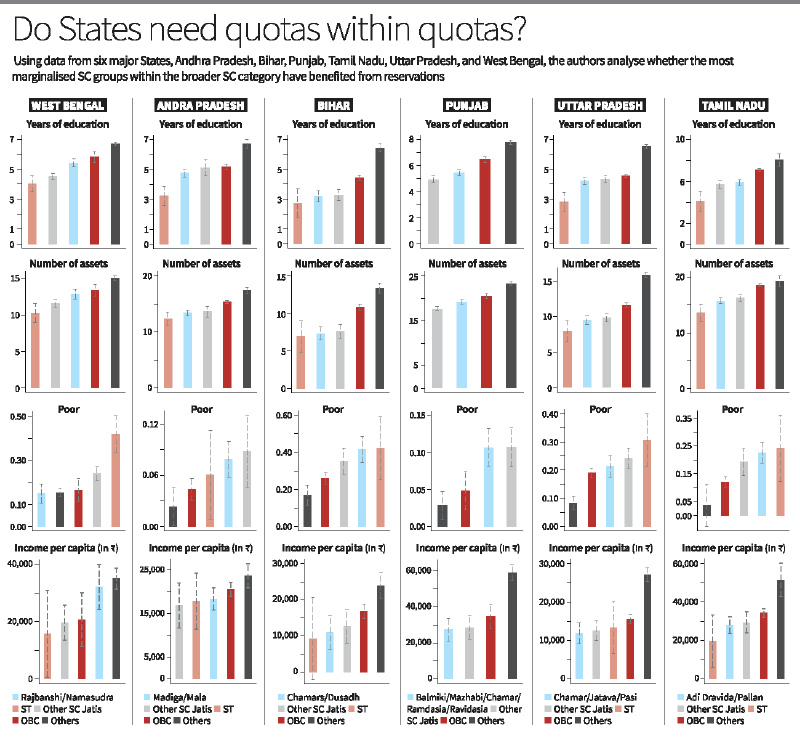
- 05 Nov 2024
Context
India's reservation system has long been a tool for uplifting historically marginalized communities, especially Scheduled Castes (SCs) and Scheduled Tribes (STs). However, recent debates have questioned whether the system serves its intended purpose, particularly in light of disparities within the SC groups. The need for a ‘quota-within-quota’ system has been raised to ensure more equitable outcomes across different SC subgroups.
The Reservation System: Origins and Objectives
Purpose of Reservations
- Historical Background: Established to correct centuries of social and economic exclusion faced by SCs and STs.
- Mechanism for Equality: Aimed to create opportunities in education, government employment, and public offices for historically marginalized groups.
- Dr. B.R. Ambedkar’s Vision: Reservations were designed to transition from formal legal equality to substantive equality.
Challenges of the Current System
- Despite progress, certain SC subgroups seem to have benefited more than others.
- A Supreme Court ruling has led to calls for a 'quota-within-quota' to address intra-SC disparities.
Exploring Intra-SC Disparities: The Data Analysis
States Examined
- Key States: Andhra Pradesh, Bihar, Punjab, Tamil Nadu, Uttar Pradesh, and West Bengal.
- Objective: To investigate whether some SC subgroups have disproportionately benefited from the reservation system.
Findings Across States
- Andhra Pradesh: Minor differences between SC groups (Malas vs. Madigas), with both groups showing similar socio-economic progress.
- Tamil Nadu: No significant disparity between Adi Dravida and Pallan groups, both benefiting equally from reservations.
- Punjab: Subdivision of quotas since 1975 has led to better outcomes for disadvantaged groups like Mazhabi Sikhs and Balmikis.
- Bihar: The Mahadalit category, introduced in 2007, failed due to political intervention, undermining the policy’s goals.
Key Insights
- In some states (e.g., Punjab), a subdivision of quotas has been effective in addressing intra-SC disparities.
- In other states, like Andhra Pradesh and Tamil Nadu, the benefits of reservations are already distributed fairly evenly among SC subgroups.
- The gap between SCs and upper-caste groups remains much larger than the gap within SCs.
The Issue of Access to Reservations
Caste Certificates as a Proxy for Access
- Data from IHDS: Less than 50% of SC households in Uttar Pradesh and Bihar report having caste certificates, limiting access to reserved positions.
- Better Access in Some States: Over 60-70% of SC households in Tamil Nadu and Andhra Pradesh have caste certificates.
Core Issue: Ensuring Access
- Access Challenges: Without proper access to caste certificates, many SCs are excluded from the benefits of the reservation system.
- Priority Area: Ensuring that all eligible SCs have access to reservations is a critical concern before considering subdivision.
The 'Quota-within-Quota' Proposal
Concept and Potential Benefits
- Targeted Assistance: A ‘quota-within-quota’ would provide more focused help to the most disadvantaged SC subgroups, as seen in Punjab.
- Political Considerations: However, the political motivations behind quota subdivision, as seen in Bihar, can undermine the policy’s effectiveness.
Criticism and Limitations
- Uneven Need for Subdivision: In many states, the need for further subdivision is minimal, as the benefits of reservations are already fairly distributed.
- Political Exploitation: The policy risks becoming a political tool rather than a genuine means of achieving social justice, as political influence often determines who is categorized as the most disadvantaged.
Addressing Inequality Beyond Reservations
Income-Based Criteria and Monetary Benefits
- Current Approach: Monetary benefits (e.g., scholarships, lower fees) are a part of the affirmative action system.
- Income Criterion: Should be used to determine eligibility for monetary benefits to focus assistance on those most in need.
The "Creamy Layer" Debate
- Supreme Court’s Suggestion: The introduction of a "creamy layer" exclusion for SCs, akin to the Other Backward Classes (OBCs) model, remains contentious and requires stronger evidence.
Challenges of Economic Mobility
- Stigma and Discrimination: Economic progress does not necessarily eliminate social stigma or discrimination, especially for historically marginalized groups.
- Long-Term Goal: While reservations have contributed to creating a Dalit middle class, addressing stigma will require a gradual process.
The Need for Updated Data and Evidence-Based Policy
Data Deficiency
- Lack of Comprehensive Data: The absence of updated, reliable data on caste-based disparities limits the effectiveness of any policy reform.
- National Census Delay: India’s national Census, the only source of comprehensive data on caste, has been delayed, exacerbating the problem.
Evidence-Driven Reform
- Importance of Data: Robust and up-to-date data is essential to assess the true impact of reservations and to make informed policy decisions.
Conclusion: Reforming the Reservation System
- Reservations’ Success: The reservation system has played a significant role in improving the socio-economic status of SCs and STs.
- Intra-SC Disparities: While some subgroups benefit more than others, the broader gap between SCs and upper-caste groups remains far more pronounced.
- Focus on Access: The primary focus should be on improving access to reservations, ensuring that all eligible SCs benefit fully from affirmative action.
Key Takeaways from COP-16: Convention on Biological Diversity
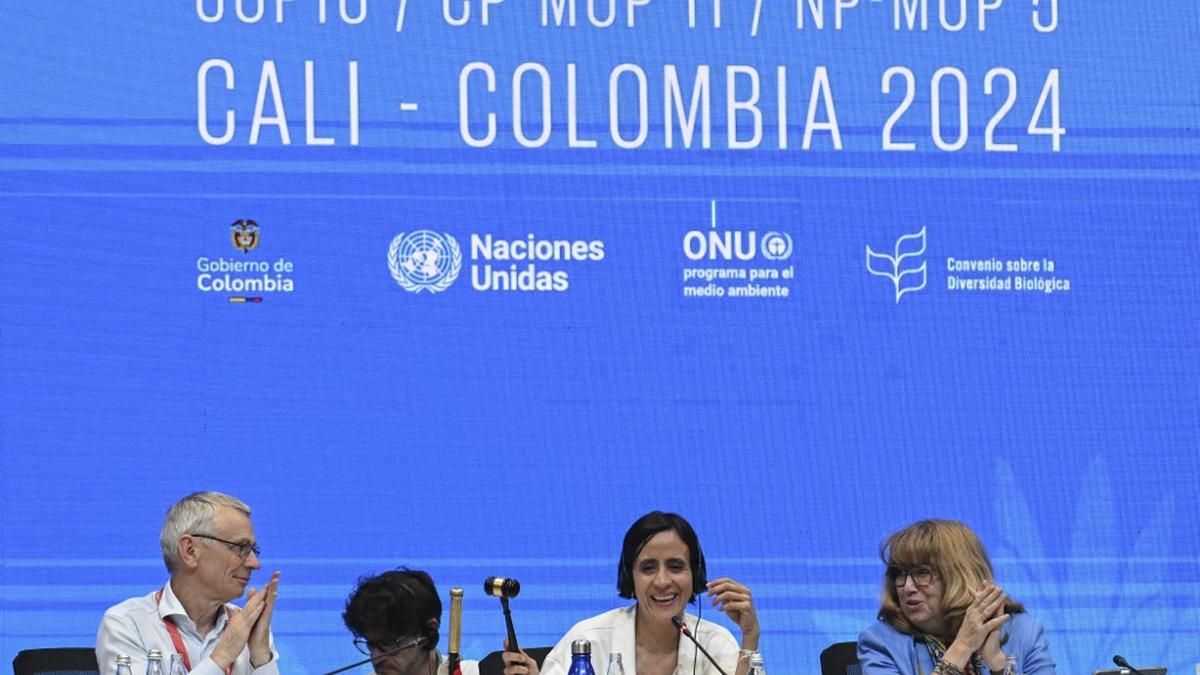
- 03 Nov 2024
In News:
The 16th edition of the Convention of Biological Diversity (CBD) in Cali, Colombia was concluded.
Key Agreements at COP-16
- Establishment of the Cali Fund
- Purpose: To ensure equitable benefit-sharing from the use of Digital Sequence Information (DSI) on genetic resources.
- Focus on Indigenous Communities: At least 50% of the Cali Fund will support Indigenous peoples and local communities, with special emphasis on women and youth.
- Creation of a Permanent Subsidiary Body
- Inclusion of Indigenous Peoples: A new body will ensure the active participation of Indigenous groups in biodiversity conservation and policy discussions.
- Resource Mobilisation Strategy
- Target Funding: The conference agreed on a strategy to secure USD 200 billion annually by 2030 to support global biodiversity initiatives.
- Kunming Biodiversity Fund: A contribution of USD 200 million from China to support biodiversity funding.
- Management of Invasive Alien Species
- New Guidelines: Proposals for databases, cross-border trade regulations, and enhanced coordination with e-commerce platforms to manage invasive species.
- Identification of Ecologically or Biologically Significant Marine Areas (EBSAs)
- Enhanced Process: COP-16 agreed on an evolved process for identifying EBSAs, a critical aspect of marine conservation.
- Global Action Plan on Biodiversity and Health
- One Health Approach: Approval of a global action plan to curb zoonotic diseases, promote health, and safeguard ecosystems.
India’s Contribution at COP-16
Updated National Biodiversity Strategy and Action Plan (NBSAP)
- Financial Commitment: India plans to invest ?81,664 crore (USD 9.8 billion) from 2025-30 on biodiversity conservation.
- Focus Areas: India highlighted efforts such as the establishment of the International Big Cat Alliance, expansion of Ramsar sites, and increased spending on biodiversity from 2018-2022.
International Finance Support
- Global Partnerships: India emphasized the need for international finance to meet biodiversity targets, particularly under the Kunming-Montreal Global Biodiversity Framework (KMGBF).
Key Outcomes from COP-16
- New Mechanisms for Biodiversity Conservation
- Cali Fund: Ensures equitable benefit-sharing from genetic resources.
- Permanent Subsidiary Body: Facilitates the inclusion of Indigenous peoples in policy-making.
- Funding and Resource Mobilization
- USD 200 Billion Annually: Strategy to secure funding for biodiversity initiatives.
- Redirecting Harmful Subsidies: Agreement to redirect USD 500 billion in harmful subsidies by 2030.
- Biodiversity and Human Health
- Global Action Plan on Biodiversity and Health: Aimed at preventing zoonotic diseases and promoting human, animal, and environmental health.
Challenges in Biodiversity Protection
Key Threats to Biodiversity
- Population Growth and Resource Demand: Increasing population and demand for biological resources lead to over-exploitation.
- Habitat Degradation and Climate Change: Destruction of ecosystems and climate change threaten species globally.
- Invasive Species: Introduction of non-native species harms local biodiversity.
- Government Policies: Policies that prioritize development without environmental safeguards contribute to biodiversity loss.
Gaps in Global Biodiversity Framework
- Weak Legal Language: Concerns about insufficient legal protection for critical ecosystems.
- Lack of Implementation Mechanisms: Absence of mandatory review mechanisms for biodiversity targets.
Kunming-Montreal Global Biodiversity Framework (KMGBF)
Framework Overview
- Adoption: Adopted at COP-15 in 2022, the KMGBF sets 23 action-oriented targets for biodiversity by 2030.
- Key Goals: Includes restoring 30% of degraded ecosystems and reducing the risk of invasive species by 50%.
- Living in Harmony with Nature: The framework envisions achieving biodiversity targets and living sustainably with nature by 2050.
Way Forward: Moving from Agreements to Action
- Participation of Stakeholders - Inclusive Approach: Ensuring the involvement of all relevant stakeholders, including governments, businesses, and local communities, in biodiversity conservation.
- Integrated Resource Management - Ecosystem Approach: Promoting a holistic approach to managing biodiversity and natural resources.
- Strengthening Governance - Good Governance Practices: Encouraging better governance to prevent unregulated exploitation of natural resources.
- International Financial Support - Alignment with Financial Institutions: Aligning global financial institutions and multilateral development banks with biodiversity conservation goals.
Tackling Judicial Pendency and Adjournments in India

- 01 Nov 2024
In News:
The issue of judicial delays and adjournments has become a significant concern in India’s judicial system. President Droupadi Murmu, while addressing the National Conference of District Judiciary in September 2024, emphasized the need to eliminate the culture of adjournments. These delays particularly affect the poor and rural populations, who often suffer in silence, avoiding court due to the fear of protracted justice.
Background of the Indian Judicial System
India’s judicial system has evolved under various legal frameworks, including the Code of Civil Procedure (CPC) and the Criminal Procedure Code (CrPC). Initially, civil courts dealt with a wide range of cases, while criminal courts focused on criminal offenses. The establishment of the Supreme Court and High Courts further strengthened India’s judicial architecture to handle constitutional and appellate cases.
To address the growing caseload, the Indian government introduced the tribunal system through the 42nd Constitutional Amendment Act, 1976, aiming to manage specialized disputes. However, despite these reforms, case pendency continues to rise.
Key Issues Contributing to Judicial Delay and Pendency
- Judge-to-Population Ratio - India currently has 21 judges per million people, far below the recommended 50 judges per million as per the 120th Law Commission Report. The shortage of judges directly contributes to the growing backlog of cases.
- Vacant Judicial Positions - As of late 2024, 30% of High Court positions remain vacant, exacerbating the case pendency crisis. The delay in filling these vacancies has resulted in overburdened judges, further delaying case resolution.
- Legislative Overload - The enactment of laws without conducting prior judicial impact assessments leads to an increase in the number of cases, often without considering the capacity of the judiciary to handle them. This lack of foresight results in excessive pressure on courts.
- Overworked Judiciary - Judges often face a heavy workload, with some handling multiple responsibilities across different courts. This overburdening leads to mental fatigue, increased errors, and prolonged decision-making.
- Witness Delays - The absence of witnesses and delays in their appearance in court can significantly prolong the judicial process, contributing to case pendency.
Government Initiatives and Challenges
-
- National Judicial Infrastructure Plan (NJIP): The NJIP aims to modernize judicial infrastructure, improving court functioning and case processing. However, its full implementation across the country remains a work in progress.
- E-Courts Project: The E-Courts project aims to digitize the judicial process, including e-filing and virtual hearings. This initiative has shown promise in reducing procedural delays but still requires wider application.
- Tribunal System: While tribunals were introduced to reduce the burden on regular courts, their success has been limited, and the abolition of six tribunals in 2021 has added additional pressure on High Courts.
- Case Timeline Legislation: Laws prescribing time-bound adjudication for sensitive cases have been enacted, but due to inefficiencies in the system, deadlines are rarely met.
Recommendations for Reform
-
- Enhance Judicial Strength
-
- Increase the Judge-to-Population Ratio: The government should prioritize the appointment of judges to meet the 50 judges per milliontargets.
- Fill Vacant Positions: High Courts should fill vacant positions six months in advance to ensure a steady supply of judges.
-
- Judicial Impact Assessment
- Implement Judicial Impact Assessments: The Justice M. Jagannadha Rao Committee’s recommendation for judicial impact assessments should be made mandatory. Every new Bill should assess the likely increase in judicial workload, the required number of judges, and the necessary infrastructure.
- Promote Alternative Dispute Resolution (ADR)
-
- Encourage ADR Mechanisms: Mediation and arbitration should be promoted as cost-effective alternatives to court proceedings. Public awareness campaigns and legal reforms can encourage the use of ADR.
-
- Strengthen Infrastructure and Technology
- Modernize Court Infrastructure: The judiciary should invest in technology such as e-filing and virtual hearings to reduce administrative burdens and expedite case resolutions.
- Streamline Administrative Processes: Technology can also help automate administrative tasks, thereby reducing the workload on judges and speeding up case processing.
- Limit Adjournments
- Stricter Norms for Adjournments: Judicial bodies should enforce stricter norms for granting adjournments, ensuring that they are not used excessively.
- Oversight Mechanism: An independent body can monitor the frequency of adjournments and take corrective action if needed.
Conclusion
Addressing the issue of judicial adjournments and case pendency requires a comprehensive approach involving structural reforms, better resource allocation, and the adoption of technology. Strengthening the judiciary’s infrastructure, increasing judicial appointments, and promoting alternative dispute resolution are vital steps toward ensuring quicker, fairer justice. The collaborative efforts of the judiciary, government, and society at large are essential to ensuring that India’s judicial system can meet the demands of justice in a timely and efficient manner.
Analysis of Election Expenditure in India
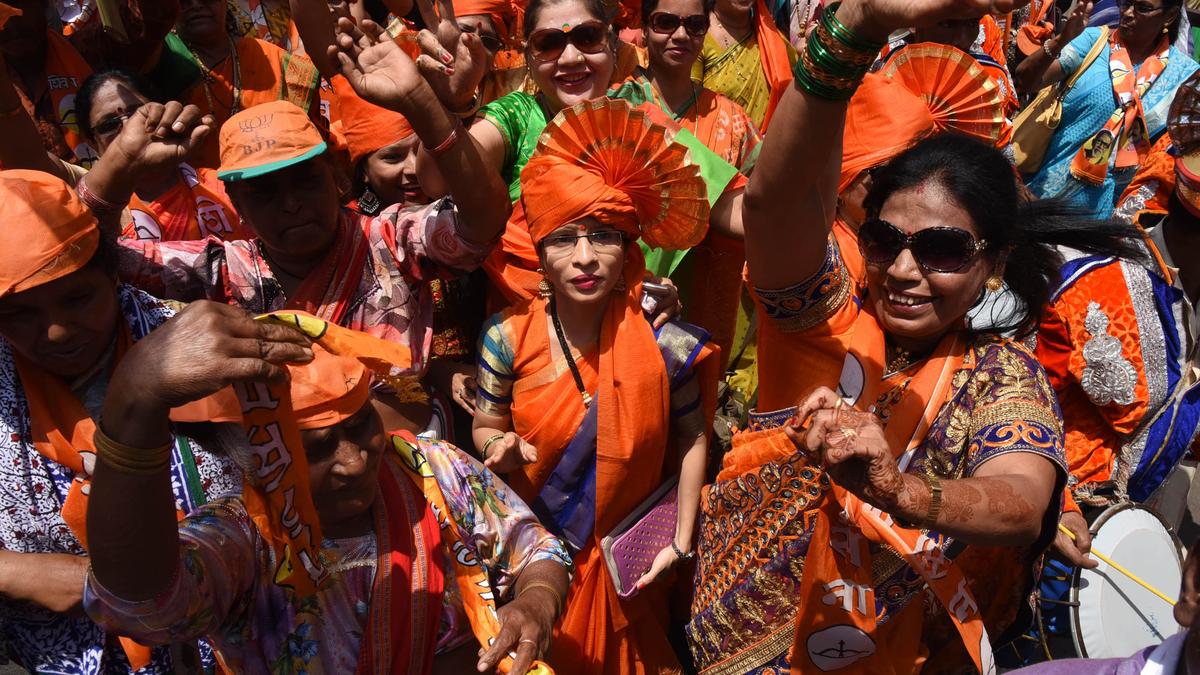
- 30 Oct 2024
Overview
Election expenditure has become a pressing issue in modern democracies, with growing concerns about its implications for political integrity and fair competition. In India, the skyrocketing costs of elections—both in terms of candidate spending and political party expenditure—pose significant challenges to electoral transparency, governance, and equity.
Current State of Election Expenditure in India
The total expenditure on elections in India has risen dramatically in recent years. For the 2024 Lok Sabha elections, the total expenditure by various political parties is estimated to reach around ?1,00,000 crores. This is a significant jump from the ?9,000 crores spent in the 1998 general elections. The expenditure per vote has also risen substantially, from ?25,000 in 1951 to ?1,400 in 2024.
The election expenditure limits for individual candidates are capped by the Election Commission of India (ECI):
- ?95 lakh for larger states (Lok Sabha constituencies)
- ?75 lakh for smaller states
- ?40 lakh for legislative assembly elections in larger states
- ?28 lakh for smaller states
However, these caps apply only to individual candidates. Political parties are not subject to any expenditure limits, allowing them to spend unlimited amounts during campaigns. This discrepancy leads to considerable financial disparities between well-funded national parties and regional or smaller parties, undermining the principle of equitable competition.
Global Comparisons: Election Financing and Spending Limits
Election financing varies widely across democracies, with countries like the United States and the United Kingdom adopting specific limits and regulations to curb excessive spending.
- United States: U.S. elections are financed largely through contributions from individuals, corporations, and Political Action Committees (PACs). Notably, Super PACs—which can raise and spend unlimited funds—have exacerbated concerns over money's influence on political outcomes. The 2024 U.S. presidential election is expected to cost around $16 billion (approximately ?1,36,000 crores).
- United Kingdom: Political parties are subject to strict expenditure limits. Each political party is allowed to spend £54,010 for each constituency, with an overall cap of £35 million for contests across all constituencies. This is aimed at ensuring that elections are not swayed by wealth alone and that smaller parties have a fighting chance.
Despite these measures, the United States still faces issues with unlimited corporate donations and the growing influence of wealthy donors, highlighting the complexities in curbing money in politics.
Challenges Posed by Rising Election Expenditure
The rising costs of elections present multiple challenges in India, exacerbating corruption, unfair competition, and political inequality.
a) Political Corruption and Influence
Large election expenditures are often funded by corporate donations and other private entities, creating a nexus between politicians and donors. This can lead to a quid-pro-quo relationship, where politicians may prioritize the interests of their donors over public welfare. This undermines public trust in the political system.
b) Unaccounted Money and Illegal Practices
A significant portion of the election expenditure is unaccounted for. The Centre for Media Studies (CMS) reports that in the 2019 general elections, around 25% of the total expenditure was spent on illegally distributing cash to voters. This practice, coupled with the absence of strict regulations on third-party campaigners, enables the use of black money in elections, further skewing the electoral process.
c) Uneven Playing Field
The absence of limits on party spending creates a situation where well-funded national parties have an inherent advantage over smaller regional parties and independent candidates. This financial inequality reduces the ability of under-funded candidates to compete based on ideas and merit rather than financial muscle. Furthermore, the growing influence of digital advertising and media campaigns has further widened this gap, with larger parties investing heavily in digital platforms like Google and Facebook, marginalizing those without the resources to do so.
Proposed Reforms to Address Election Expenditure Issues
To address these challenges, several reforms have been suggested by experts, committees, and the Election Commission. These reforms aim to curb excessive spending, ensure fairness, and increase accountability in the electoral process.
a) Capping Expenditure by Political Parties
There is a pressing need to introduce expenditure ceilings for political parties, in addition to those imposed on individual candidates. According to the 2016 Electoral Reforms Report by the Election Commission, political party spending should be capped at a level not exceeding the total expenditure limit for all candidates fielded by the party. This would level the playing field, ensuring that the influence of money is curtailed during elections.
b) State Funding of Elections
Recommendations for state funding of elections have been made by the Indrajit Gupta Committee (1998) and the Law Commission Report (1999). The state could partially finance the campaigns of recognized political parties, ensuring that candidates are not solely reliant on private donations. However, this reform faces challenges in terms of feasibility and implementation, especially regarding the mechanism for allocation of funds.
c) Regulation of Third-Party Campaigners
India should follow the example of countries like Australia, where third-party campaigners are formally registered and required to disclose their funding sources. This would help in tracking illegal contributions and ensure that election spending is transparent.
d) Ban on Government Advertisements During Election Periods
The use of government advertisements by the ruling party during the run-up to elections often leads to an uneven playing field. A ban on government-funded ads during the six months before elections would ensure that the ruling party does not gain an unfair advantage through public resources.
e) Strengthening Electoral Oversight
An independent electoral oversight body could be established to oversee campaign financing and ensure that all parties comply with spending limits. This would include measures to audit party finances, track donations, and verify spending claims, making it more difficult for parties to evade rules or use black money.
Conclusion: The Need for Comprehensive Electoral Reforms
The rising costs of elections in India present significant challenges to the democratic process. While expenditure limits for candidates exist, the lack of restrictions on party spending creates financial inequalities that undermine fair competition. The increasing role of corporate donations, illegal cash distribution, and unregulated third-party spending further complicates the situation.
To ensure fair elections, it is crucial that India adopts reforms such as capping political party expenditures, state funding of elections, and stronger oversight mechanisms. These steps, coupled with bipartisan political will, could help create a more equitable, transparent, and accountable electoral system, fostering greater public trust in the democratic process.
By addressing these challenges head-on, India can work toward an election system that encourages political participation based on ideas and policies rather than financial clout, ultimately strengthening the foundations of democracy.
Analysis of Growing Economic Divide in India

- 29 Oct 2024
Overview
The Economic Advisory Council to the Prime Minister (EAC-PM)'s report titled "Relative Economic Performance of Indian States: 1960-61 to 2023-24" highlights an alarming trend of widening economic disparities across India's states, which is increasingly threatening the principles of federalism and national unity. The findings reveal significant regional imbalances in terms of contributions to the national income, per capita income, and overall economic development. This analysis delves into the key insights from the report and explores the broader implications for India's federal structure, governance, and policy approaches.
Key Insights from the Report
- Regional Economic Disparities:
- Western and Southern States' Dominance: States such as Maharashtra, Gujarat, Tamil Nadu, and Karnataka have consistently outperformed others. These states have benefited from higher private investments, better infrastructure, and a more business-friendly environment. They also enjoy proximity to international markets, especially coastal regions like Gujarat and Tamil Nadu, which have access to ports and export markets.
- Underperformance of Northern and Eastern States: On the other hand, northern states (with exceptions like Delhi and Haryana) and eastern states like Bihar, Odisha, and West Bengal lag behind in economic performance. These regions face challenges such as poor infrastructure, low levels of investment, and weak governance structures, which hinder their growth potential.
- Impact of Liberalization (1991):
- The 1991 economic reforms marked a shift toward market-oriented growth, benefiting states that were already more industrialized or had better urban infrastructure. Southern states, in particular, adapted well to the liberalized environment, attracting higher levels of private investment and expanding their economies.
- The liberalization process disproportionately favored urban centers like Delhi, Mumbai, Chennai, and Bengaluru, where investments were channelized into growing service sectors, technology, and industries, creating a feedback loop of wealth accumulation in these hubs. Meanwhile, the hinterland remained underdeveloped due to insufficient public investment and the lack of private sector interest in these regions.
- Investment Disparities:
- Private Investment: Wealthier states attract a disproportionate share of private investment, which is driven by profitability and market opportunities. These states have better infrastructure, which reduces transaction costs and increases returns on investment. In contrast, underdeveloped states struggle to attract investment due to poor governance, inadequate infrastructure, and perceived higher risks.
- Public Investment: While the public sector still plays a role in investment, the New Economic Policies (NEP) since 1991 have shifted the focus towards private sector-driven growth. This has further widened the investment gap, as the poorer states receive less public investment relative to their needs.
- Role of Infrastructure and Governance:
- The availability and quality of infrastructure are significant determinants of economic performance. States with better roads, energy supply, ports, and communication networks tend to attract more investments. Additionally, good governance, characterized by reduced corruption, better policy implementation, and transparency, also plays a critical role in fostering economic development.
- In contrast, states with weaker governance structures and poor infrastructure struggle to create an enabling environment for businesses, further compounding regional disparities.
- Impact on Federalism:
- The growing economic divide is leading to tensions between the Centre and state governments, particularly in wealthier states that contribute significantly to national income but feel short-changed in resource allocation. These states argue that they are not receiving a fair share of national resources in return for their contributions, leading to growing dissatisfaction with the federal system.
- The tension is exacerbated by political factors, such as accusations from opposition-led states that the Centre uses public investment to favor states aligned with the ruling party. The growing perception of politicization of resource allocation has the potential to undermine the spirit of cooperative federalism.
Structural Causes of Regional Inequality
- Economic and Investment Magnetism:
- Wealthier states attract more private investments, as they offer better returns due to established markets, skilled labor, and urbanization. Cities like Mumbai, Delhi, and Bengaluru serve as economic magnets, drawing talent, technology, and capital, which further consolidates their economic dominance.
- In contrast, states without such economic hubs or access to global markets struggle to attract investment. The absence of urban agglomerations and the concentration of wealth and resources in a few states perpetuate regional disparities.
- Policy and Investment Bias:
- Post-liberalization policies have disproportionately benefited the organized sector, often at the expense of the unorganized sector, which is more prevalent in poorer states. The emphasis on industrial growth and infrastructure development has largely bypassed the rural and informal sectors, which are critical in underdeveloped states.
- The organized sector has also benefited from government support, such as tax concessions and subsidized infrastructure, which have enabled these industries to thrive in already developed regions. This has widened the gap between the haves and the have-nots.
- Cronyism and the Black Economy:
- Crony capitalism and the prevalence of the black economy in poorer states further exacerbate regional imbalances. In some cases, political patronage and corruption divert resources and investments from areas that need them most. This weakens the investment climate, especially in states with higher levels of informal and illegal economic activity.
Implications for Federalism
The growing economic disparity poses a serious threat to India's federal structure. The increasing dissatisfaction of wealthier states with the current fiscal arrangements and the growing demand for fairer resource allocation challenge the spirit of cooperative federalism. A well-functioning federal system relies on equitable distribution of resources and opportunities for all regions to develop.
Policy Recommendations
To address these disparities and strengthen India's federal framework, several policy measures need to be implemented:
- Enhancing Governance and Infrastructure in Lagging States:
- Improved governance and reducing corruption are essential in attracting both private and public investments. Additionally, there must be a focus on developing critical infrastructure, such as roads, energy, and health facilities, which are essential for economic growth.
- States need to increase public investment in sectors like education, healthcare, and social security to improve human capital and productivity.
- Focus on the Unorganized Sector:
- A significant portion of the labor force in poorer states is employed in the unorganized sector. Policies should aim to formalize this sector by providing social security benefits, improving labor rights, and increasing productivity through skill development. This could help raise incomes and stimulate local demand, attracting more private investment.
- Balancing the Organized and Unorganized Sectors:
- While the organized sector has benefited from liberalization, more attention should be given to the unorganized sector, which forms the backbone of the economy in many poorer states. A balanced approach to economic growth, which includes both organized and unorganized sectors, can help reduce disparities.
- Shifting Focus from Urban Centers to Hinterlands:
- Private sector investment must be incentivized in underdeveloped regions through tax breaks, subsidies, and targeted infrastructure projects. This will encourage businesses to expand beyond the major urban centers, thus promoting a more balanced distribution of economic activities.
Conclusion
The widening economic divide in India, as revealed by the EAC-PM report, poses a significant challenge to the country's federalism and unity. To ensure inclusive and balanced development, policy reforms must focus on reducing regional disparities by improving governance, infrastructure, and investment in lagging states. A shift towards equitable growth, addressing the needs of both the organized and unorganized sectors, is essential to promoting national cohesion and ensuring sustainable economic progress across all regions.
Strengthening the Anti-Defection Law to Uphold India's Democratic Integrity

- 28 Oct 2024
In News:
The Anti-Defection Law, introduced in 1985 through the 52nd Constitutional Amendment, aims to curb political instability caused by legislators switching parties for personal or financial reasons. While the law has helped maintain political stability, it faces several challenges, including delays in decision-making, potential bias in adjudication, and lack of transparency in party directives. These issues undermine its effectiveness in safeguarding democratic integrity.
Historical Context and Genesis
The issue of political defections, exemplified by the term "Aaya Ram, Gaya Ram," traces its origins to the 1960s when frequent party-switching destabilized governments. To address this, the Anti-Defection Law was enacted in 1985, disqualifying members who voluntarily gave up their party membership or defied party whips on critical votes. Initially effective in reducing defections, the law has faced challenges due to emerging loopholes, particularly regarding party "splits" and "mergers."
Gaps and Loopholes in the Current Law
One major loophole was the provision allowing a party split if one-third of its members defected, exploited until the 91st Amendment in 2003, which increased the threshold for mergers to two-thirds. Despite this change, defections continue, particularly through "mergers." Another issue is the role of the Speaker in deciding disqualification petitions. Given that the Speaker is often affiliated with the ruling party, their decisions are sometimes seen as biased, leading to delays in resolving defection cases. Additionally, the lack of transparency in issuing party whips has caused disputes regarding their legitimacy.
Proposed Reforms
To address these challenges, two key amendments are proposed:
- Fixed Time Frame for Decision-Making: A clear time frame—such as four weeks—should be established for the Speaker or an adjudicatory body to resolve defection cases. If no decision is made within this period, defecting members should automatically be disqualified.
- Transparency in Whips: Political parties should be required to make the issuance of whips public, either through newspaper publications or electronic communication, to ensure that members are fully informed of party positions on critical votes.
Ethical Concerns and Impact on Democracy
While the Anti-Defection Law was introduced to promote political stability, it has inadvertently stifled internal dissent within parties. Legislators are often forced to follow party lines, even when their personal convictions or constituents' interests conflict. This limits their freedom of expression and undermines the representative nature of democracy. Furthermore, the law has not fully curbed unethical practices such as "poaching" of members or defectors seeking personal gain, which continue to destabilize governments and erode public trust in the system.
The Way Forward: Political Will and Comprehensive Reforms
To strengthen the Anti-Defection Law, reforms must balance party discipline with individual freedoms. Key steps include:
- Independent Adjudication: Establishing an independent tribunal to handle defection cases can reduce political bias and expedite the decision-making process.
- Clear Timeframes: Setting a fixed timeline for resolving defection cases will prevent delays and ensure accountability.
- Transparency in Whip Issuance: Ensuring public notice of party whips will reduce ambiguity and disputes.
- Promoting Ethical Conduct: Strengthening ethical guidelines to discourage "poaching" and protect the integrity of the electoral process.
16th BRICS Summit
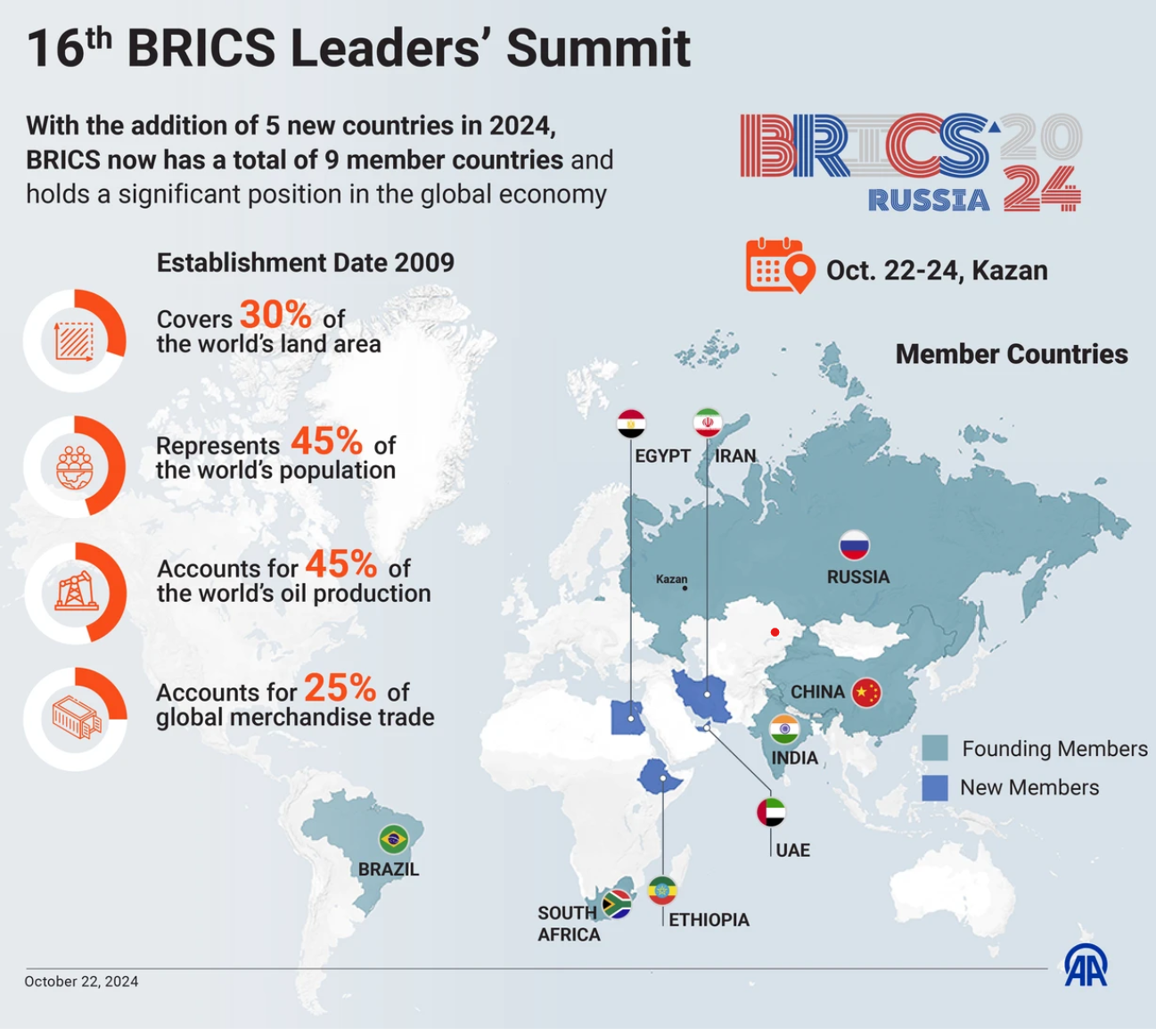
- 25 Oct 2024
In News:
Recently, the 16th BRICS Summit was held in Kazan, Russia.
Key Highlights:
Overview of the Bilateral Meeting between PM Modi and President Xi
- Location & Context: The meeting took place on the sidelines of the 16th BRICS Summit in Kazan, Russia (October 23, 2024), marking the first bilateral interaction between PM Modi and President Xi Jinping in nearly five years.
- Significance: The meeting focused on India-China relations, specifically the border dispute that arose following the 2020 standoff in Ladakh.
- Agreement on Border Disengagement: Both leaders welcomed an agreement for "complete disengagement" along the Line of Actual Control (LAC), which could pave the way for the resolution of issues that emerged after the Galwan Valley clashes in June 2020.
Key Points of the India-China Border Pact
- Resolution of Border Issues: The agreement addresses longstanding disputes, including in Depsang Plains and Demchok, where Chinese forces had encroached on Indian territory.
- Restoration of Patrolling: Both nations agreed to restore patrols to old patrolling points (PPs) along the LAC in these disputed areas.
- Next Steps: The Special Representatives (SRs) on the India-China boundary will meet soon to oversee the management of peace and tranquility in the border areas and explore mutually acceptable solutions.
- Diplomatic Mechanisms: Dialogue mechanisms at the foreign ministers and other official levels will be utilized to stabilize and rebuild bilateral relations, contributing to regional and global stability.
Strategic Importance of the Bilateral Meeting
- Maintaining Peace and Stability: PM Modi emphasized that differences between India and China should be managed carefully to ensure that broader peace and tranquility are maintained.
- Global Impact: Both leaders affirmed that stable India-China relations would have a positive impact on regional and global peace and contribute to a multipolar world.
- Long-Term Strategic Perspective: The leaders discussed progressing bilateral relations from a strategic perspective, enhancing communication, and exploring cooperation to address developmental challenges.
Key Takeaways from the 16th BRICS Summit
- Expansion and New Membership: The summit saw the inclusion of five new members—Egypt, Ethiopia, Iran, the UAE, and Saudi Arabia (pending formalization). This expansion reflects BRICS’s growing influence as a forum representing the Global South.
- Focus on Multilateralism: Leaders emphasized multilateral cooperation to address challenges such as global security, economic growth, and sustainable development.
- Kazan Declaration: The declaration touched upon key issues:
- Geopolitical Conflicts: It called for dialogue and diplomacy to resolve disputes like the Ukraine crisis and the West Asia conflict.
- Sanctions and Trade: Criticized unilateral sanctions and their disruptive effects on global trade and development goals.
- Grain Exchange: A proposal was made to establish a BRICS Grain Exchange, aimed at improving agricultural trade among member states.
- Financial Integration: There was a push for greater financial integration through the use of local currencies for trade, exemplified by India’s UPI system as a successful model.
Importance of BRICS in the Global Context
- Global Influence: BRICS continues to be a key player in global geopolitics, representing 40% of the world’s population and 26% of global GDP (as of 2023).
- Strategic Goals: BRICS has consistently called for reform of international institutions like the UNSC, IMF, and World Bank, advocating for a more equitable global governance structure.
- Economic Collaboration: The New Development Bank (NDB), established in 2015, continues to play a vital role in funding development projects across BRICS countries, though the group’s influence in global finance remains limited compared to the World Bank.
Challenges Facing BRICS Expansion
- Geopolitical Contradictions: The inclusion of diverse new members (e.g., UAE, Egypt, Iran) could complicate decision-making due to geopolitical rivalries.
- Decision-Making Hurdles: Achieving consensus among an expanding membership will become more challenging. The expansion may dilute the cohesiveness of the group, as seen in other multilateral forums like the Non-Aligned Movement (NAM) and G77.
- De-Dollarisation Efforts: While BRICS aims to de-dollarize trade and reduce reliance on the SWIFT system, efforts to develop alternatives like a BRICS payment system and BRICS currency are still in nascent stages.
- Economic Disparities: Economic gaps among members—China’s GDP is significantly larger than the combined GDP of other members—could also create imbalances in decision-making.
India’s Role and Strategic Positioning in BRICS
- Geopolitical Balancing: India's participation in BRICS is a strategic maneuver to balance its global position and strengthen ties with emerging economies, particularly in the Global South.
- Diplomatic Relations with Russia: India continues to prioritize its relationship with Russia, which remains crucial for regional security and energy cooperation.
- India-China Ties: The agreement on the India-China border represents a significant shift in relations, with potential for a reset in Sino-Indian ties.
Key Themes in the Kazan Declaration
- Global Governance: Calls for reforming global institutions to give developing nations more representation.
- Energy and Sustainability: Proposals for strengthening energy cooperation, including the creation of energy corridors and the promotion of sustainable energy practices.
- Security: Emphasized the need for universal security by addressing the security concerns of all nations and promoting dialogue over confrontation.
Conclusion: Future of India-China and BRICS Relations
- India-China Relations: The border disengagement pact is a critical step towards stabilizing the India-China relationship, with potential positive impacts on regional security and global geopolitics.
- BRICS’s Growing Influence: As BRICS expands, it faces internal challenges but remains a potent voice for the Global South, aiming to reshape global governance and financial systems.
- India’s Strategic Positioning: India is likely to play a pivotal role in BRICS, especially as the group’s focus shifts towards regional stability, economic cooperation, and de-dollarization in the coming years.
Stubble Burning and the Supreme Court's Ruling: Protecting the Right to a Pollution-Free Environment
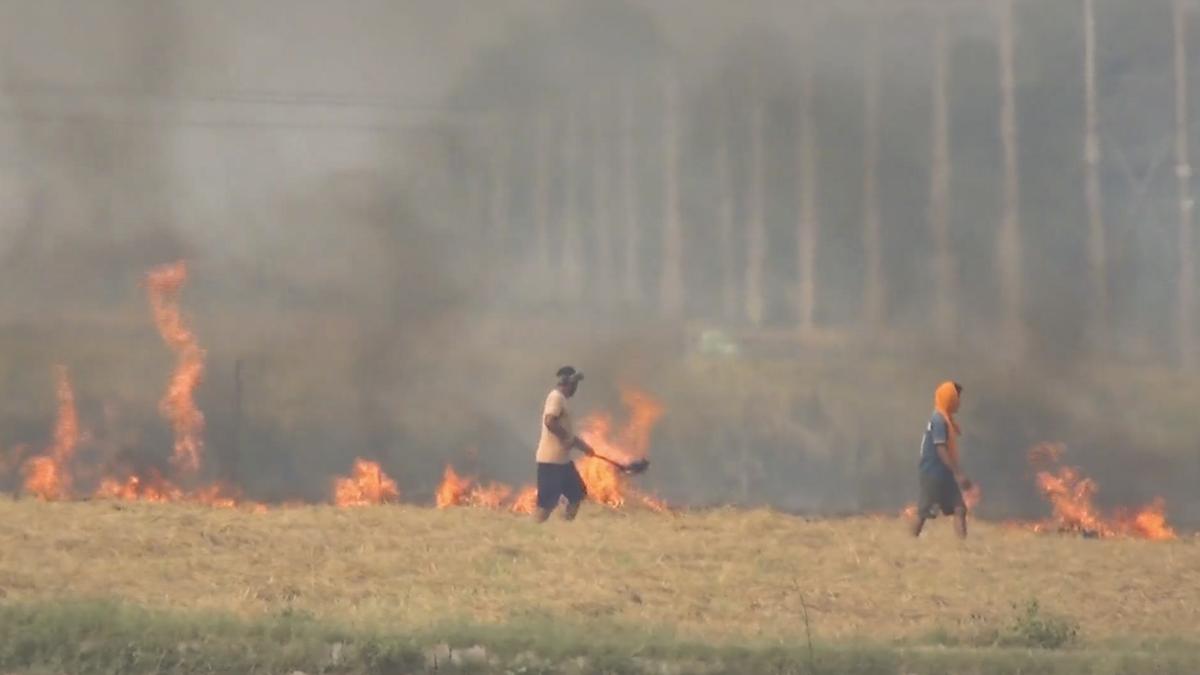
- 24 Oct 2024
Introduction
Recently, the Supreme Court of India expressed serious concerns about the ongoing issue of stubble burning in the states of Punjab and Haryana. The Court criticized the selective enforcement of penalties for stubble burning and emphasized that such practices violate citizens' fundamental right under Article 21 of the Indian Constitution, which guarantees the right to live in a pollution-free environment.
Court’s Observations on Stubble Burning
- The Supreme Court highlighted the failure of state governments in effectively implementing laws against stubble burning.
- Selective Enforcement: The Punjab and Haryana governments were accused of prosecuting only a few violators while allowing many others to escape punishment by paying a nominal fine.
- The Court observed that this approach is a blatant violation of the right to live in a pollution-free environment, which is guaranteed under Article 21 of the Constitution.
Right to a Pollution-Free Environment
- The Court emphasized that every citizen has the fundamental right to live in an environment free from pollution, as mandated by Article 21 of the Constitution.
- The Court questioned the effectiveness of current environmental regulations, specifically pointing out the lack of proper machinery to collect fines under Section 15 of the Environment (Protection) Act, 1986.
Impact of Stubble Burning
Stubble burning, primarily in the northern states of India, exacerbates air pollution, especially in Delhi and surrounding regions. The seasonal spike in air pollution during the months of October and November is largely attributed to farm fires. This not only worsens the air quality but also has severe implications for public health.
Environmental and Health Consequences
- Air Pollution: The burning of crop residues significantly contributes to the rise in PM2.5 and PM10 levels, leading to hazardous air quality.
- Soil Health: Burning crop residues depletes essential nutrients from the soil, reducing organic carbon content and harming soil fertility.
Health Risks
- Exposure to pollutants like particulate matter (PM) can lead to respiratory problems, heart diseases, and other health complications for the population, especially in densely populated areas like Delhi.
Legal and Institutional Shortcomings
- Inadequate Implementation: Despite laws and penalties being in place, the lack of an effective enforcement mechanism has resulted in the persistence of stubble burning.
- Toothless Penalties: The Supreme Court criticized the amended Section 15 of the Environment Protection Act, 1986, which replaced criminal penalties with financial fines for environmental violations. However, the lack of rules and appointed adjudicating officers has rendered this provision ineffective.
- No Serious Enforcement: The failure of the Central government and state authorities to implement effective penalties has led to widespread non-compliance with environmental laws.
Government Actions and Responses
Centre’s Efforts:
- The Central Government has introduced a Central Sector Scheme to promote agricultural mechanization for in-situ management of crop residue in Punjab, Haryana, Uttar Pradesh, and Delhi.
- The government provides financial assistance of up to 50% for the purchase of machinery, such as the Happy Seeder, to manage paddy stubble without burning.
- A total of ?3,062 crore has been released from 2018 to 2023 to tackle stubble burning.
State-Level Actions:
- The Punjab government has introduced cash incentives for farmers who refrain from burning stubble. Additionally, the state is offering non-fiscal incentives, such as access to panchayat land for storing paddy straw.
- The Pusa Decomposer, developed by the Indian Agricultural Research Institute (IARI), is a bio-enzyme used to decompose crop residue. It helps in turning the stubble into manure within 20-25 days, enhancing soil health.
Challenges for Farmers:
- Many farmers still prefer burning stubble due to high costs associated with alternative methods of residue management.
- The Happy Seeder and other machinery remain expensive and are not affordable for most small-scale farmers, leading them to resort to burning as the most cost-effective option.
Court’s Directive and the Way Forward
- The Supreme Court directed the Centre and state governments to ensure better enforcement of laws related to air pollution, vehicular emissions, and industrial pollution.
- The Court also urged the Union Government to consider Punjab’s request for additional funds to tackle the stubble burning issue and to strengthen the enforcement mechanism.
- Urgency for Action: The Court’s observations suggest that the existing framework needs urgent reforms to protect citizens’ right to a pollution-free environment.
Constitutional Provisions Related to Environmental Protection
India’s Constitution provides several provisions to ensure the protection of the environment:
Article 21: Right to Life and Environment
- In the landmark case Subhash Kumar v. State of Bihar (1991), the Supreme Court held that the right to life under Article 21 includes the right to a wholesome environment.
- This view was reiterated in Virender Gaur v. State of Haryana (1994), further strengthening the legal framework for environmental protection.
Directive Principles of State Policy
- Article 48A: The State is mandated to protect and improve the environment and safeguard forests and wildlife.
- Article 39(e) and 47: These Articles place a duty on the State to promote public health and ensure environmental protection.
Fundamental Duties
- Article 51A(g) places a duty on citizens to preserve and protect the environment.
Conclusion
The Supreme Court’s ruling highlights the urgent need for better implementation of environmental laws and the protection of citizens’ fundamental rights under Article 21. While government schemes are in place, a more robust and consistent approach is required to address the issue of stubble burning and air pollution. Immediate reforms in the enforcement mechanisms and incentives for farmers are crucial to achieve a sustainable, pollution-free environment in India.
Biodiversity COP16
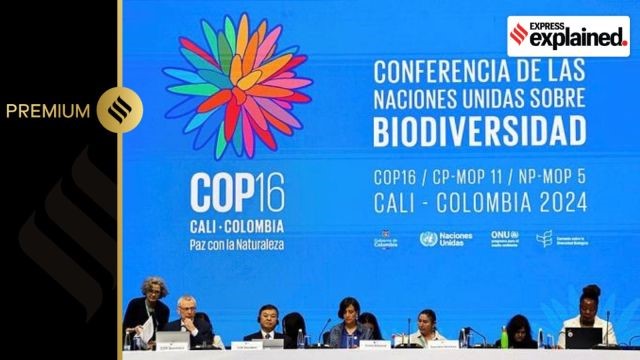
- 23 Oct 2024
In News:
The Convention on Biological Diversity (CBD), while historically overshadowed by climate change discussions, is now gaining increasing attention due to the growing recognition of the global biodiversity crisis. This evolving prominence highlights the need for urgent action to preserve ecosystems and halt biodiversity loss, which is intimately linked with the climate crisis.
Overview of the Convention on Biological Diversity (CBD)
- Origins and Objectives:
- The CBD emerged from the 1992 Rio Earth Summit, alongside the UN Framework Convention on Climate Change (UNFCCC).
- Main Goals:
- Protect global biodiversity.
- Restore ecosystems.
- Ensure equitable distribution of the benefits derived from biological resources.
- COP16 and the Kunming-Montreal Framework:
- The 16th Conference of Parties (COP16) marks the first meeting following the Kunming-Montreal Global Biodiversity Framework adopted at COP15 in 2022.
- The framework sets out four key goals and 23 targets to be achieved by 2030, including:
- Protect 30% of global lands and oceans by 2030.
- Restore 30% of degraded ecosystems by 2030.
The Growing Convergence Between Climate Change and Biodiversity
- Interlinkages Between Climate Change and Biodiversity:
- Mutual Impact:
- Climate change accelerates biodiversity loss by altering habitats and threatening species.
- In turn, ecosystem degradation contributes to climate change by releasing greenhouse gases (GHGs) from deforestation and soil degradation.
- Shared Drivers:
- Both crises are driven by unsustainable human activities, including over-exploitation of natural resources, deforestation, over-consumption, and pollution.
- Increasing Synergy:
- There is a growing realization of the need for integrated solutions that address both climate change and biodiversity loss simultaneously.
- Momentum for 30 x 30 Targets
- The 30 x 30 Commitment:
- The 30 x 30 targets are central to the Kunming-Montreal Framework, which includes:
- Conservation of 30% of the world's lands and oceans.
- Restoration of 30% of degraded ecosystems.
- These targets aim to ensure the preservation of biodiversity-rich areas and the restoration of degraded ecosystems globally by 2030.
- National Biodiversity Strategies and Action Plans (NBSAPs):
- Countries are required to develop and submit their NBSAPs (akin to Nationally Determined Contributions (NDCs) for climate change).
- As of now, only 32 countries have submitted their NBSAPs, with more expected during COP16.
- High Seas Treaty:
- A crucial agreement for achieving 30 x 30 targets is the High Seas Treaty (also called Biodiversity Beyond National Jurisdictions (BBNJ)), which focuses on:
- Establishing protected marine areas in biodiversity-rich regions beyond national jurisdictions.
- Ensuring regulation of human activities in these areas.
Access and Benefit Sharing: The Case of Genetic Resources
- Genetic Resources and Their Exploitation:
- The oceans, along with terrestrial ecosystems, harbor a wide variety of genetic resources that can be exploited for medical, commercial, and scientific purposes.
- Advances in biotechnology and digital sequencing of genetic material have raised issues about the equitable sharing of benefits from these resources.
- Nagoya Protocol and Benefit Sharing:
- The Nagoya Protocol (2010) set out guidelines for the access and fair sharing of benefits derived from genetic resources.
- At COP16, discussions will center on how genetic sequences (used in products such as medicines, crops, etc.) can be used fairly, ensuring that indigenous communities, who may be the original custodians of these resources, benefit equitably.
Finance Mechanisms for Biodiversity Conservation
- Financial Targets:
- One of the key goals of the Kunming-Montreal Framework is to mobilize $200 billion per year by 2030 for biodiversity conservation globally.
- Developed countries are expected to contribute $20 billion annually to developing nations, increasing to $30 billion by 2030.
- Phasing Out Harmful Subsidies:
- Countries are urged to eliminate perverse incentives that harm biodiversity, such as subsidies for:
- Over-fishing.
- Deforestation.
- Fossil fuel consumption.
- The goal is to repurpose such incentives to support sustainable practices and conservation efforts.
- New Financial Mechanisms:
- COP16 discussions will also focus on creating innovative financial mechanisms, such as:
- A biodiversity fund.
- Biodiversity credits, similar to carbon credits, which would allow countries or organizations to offset their biodiversity loss by investing in conservation projects elsewhere.
Challenges and the Way Forward
- Implementation of 30 x 30 Targets:
- The main challenge lies in translating ambitious goals into actionable plans at the national and local levels. Countries must not only submit action plans but also implement and monitor them effectively.
- Increased Global Cooperation:
- Addressing biodiversity loss requires collaboration between countries, industries, and local communities to ensure that efforts are comprehensive and inclusive.
- Public Awareness and Engagement:
- It is crucial to raise awareness about the importance of biodiversity conservation and the urgent need for collective action to mitigate the combined threats of biodiversity loss and climate change.
Conclusion: The Need for Urgent Action
The discussions at COP16 signal an important shift in how the world addresses biodiversity and its links to climate change. As countries continue to recognize the interconnectedness of these two crises, the outcome of the CBD negotiations could play a pivotal role in shaping global environmental policy. However, meeting the ambitious goals set forth by the Kunming-Montreal Framework requires strong political will, adequate financing, and effective global cooperation.
What are the stress factors for Indian Railways?
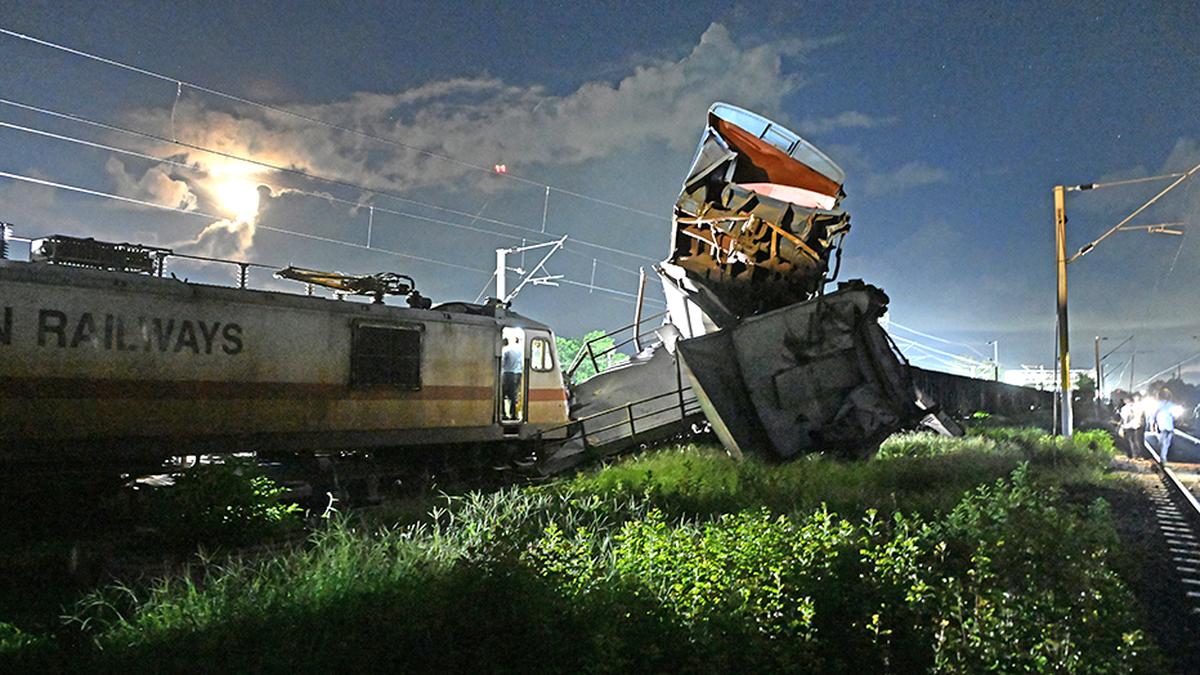
- 22 Oct 2024
In News:
On October 17, eight coaches of the Agartala-Lokmanya Tilak Express derailed in Assam with no casualties. On October 11, a passenger train rear-ended a stationary goods train near Chennai, also with no casualties. Indian trains have been involved in multiple accidents of late. The Balasore accident on June 2, 2023, had the greatest death toll, more than 275, yet pressure on the Railways to improve safety competes with pressures straining its subsistence.
Railway Accident Trends
- Decline in Accidents Over Time:
- From 1,390 accidents per year in the 1960s, railway accidents have reduced to about 80 accidents per year in the last decade.
- Recent Consequential Accidents:
- 34 accidents in 2021-2022
- 48 accidents in 2022-2023
- 40 accidents in 2023-2024
- Primary Causes of Accidents:
- 55.8% due to staff errors (railway personnel).
- 28.4% due to non-staff errors.
- 6.2% due to equipment failure.
- Role of Signalling Failures:
- Major accidents, such as Balasore and Kavaraipettai, were attributed to signalling system failures.
Key Safety Technologies and Measures
- Kavach System:
- Kavach is an automatic train protection system designed to prevent collisions by monitoring train positions and activating alarms or braking.
- As of February 2024, Kavach was implemented on only 2% (1,465 route km) of the railway network, limiting its effectiveness.
- Signalling System Overhaul:
- Outdated and faulty signalling systems contribute significantly to accidents. Both Balasore and Kavaraipettai incidents were linked to failures in signalling infrastructure.
Financial Strain on Indian Railways
- Operating Ratio (OR):
- The Operating Ratio (OR) in 2024-2025 is estimated to be ?98.2, indicating that the Railways spends ?98.2 for every ?100 earned.
- A higher OR reduces available funds for safety improvements and infrastructure upgrades.
- Budgetary Constraints:
- The 2023-24 budget showed a 7.2% reduction in capital outlay for track renewal and a 96% decrease in the Depreciation Reserve Fund, which is used to replace aging assets.
- Revenue Imbalance:
- Freight services account for 65% of Railways’ revenue but face capacity constraints, with 30% of the network operating at over 100% capacity.
- Passenger services, however, continue to incur significant losses, with ?68,269 crore loss in 2021-22.
Challenges in Rail Infrastructure
- Slow Infrastructure Development:
- The government's Dedicated Freight Corridors (DFCs), intended to alleviate congestion, are severely delayed:
- The Eastern DFC is the only fully operational corridor.
- Other corridors, including the Western DFC and additional planned routes, remain incomplete.
- Track and Equipment Maintenance:
- Ongoing delays in upgrading and maintaining essential infrastructure (tracks, wagons, signalling) contribute to the rising number of accidents.
Loco Pilot Working Conditions
- Extended Working Hours:
- Loco pilots often work 12-hour shifts due to manpower shortages, leading to fatigue and increased risk of human error.
- Stress and exhaustion are significant contributors to accidents caused by human error, including Signal Passed at Danger (SPAD).
Recommendations for Improving Railway Safety
- Loco Pilot Vacancies:Immediate recruitment to fill the 18,799 vacant loco pilot positions to prevent overworking and reduce fatigue-related errors.
- Expand Kavach Deployment:Accelerate the nationwide installation of the Kavach system, particularly on high-risk and high-traffic routes, to enhance safety.
- Complete Dedicated Freight Corridors (DFCs):Expedite the completion of DFCs to ease congestion and increase freight movement efficiency.
- Independent Railway Safety Authority:Establish an independent Railway Safety Authority with statutory powers, as recommended by the Kakodkar Committee (2012), to enforce safety standards and monitor implementation.
- Improve Signal Infrastructure:Invest in advanced and reliable signalling systems to prevent errors stemming from outdated or malfunctioning infrastructure.
- Regulate Working Hours:Enforce strict work hour limits to reduce fatigue among railway staff and ensure proper rest between shifts.
- Strengthen Trackside Infrastructure:Install fencing along tracks in high-risk areas to prevent cattle run-overs, a common cause of derailments in rural and semi-urban areas.
Conclusion
- Indian Railways faces a complex set of challenges, balancing safety requirements with financial constraints. Despite technological advancements like Kavach, its limited deployment and outdated infrastructure continue to present significant risks.
- A holistic approach to reform is needed, including addressing manpower shortages, upgrading safety technologies, and investing in infrastructure development. This will be essential for reducing accidents, improving safety, and ensuring the long-term sustainability of India’s vast railway network.
Fortified Rice: A Strategic Initiative to Combat Micronutrient Deficiencies in India
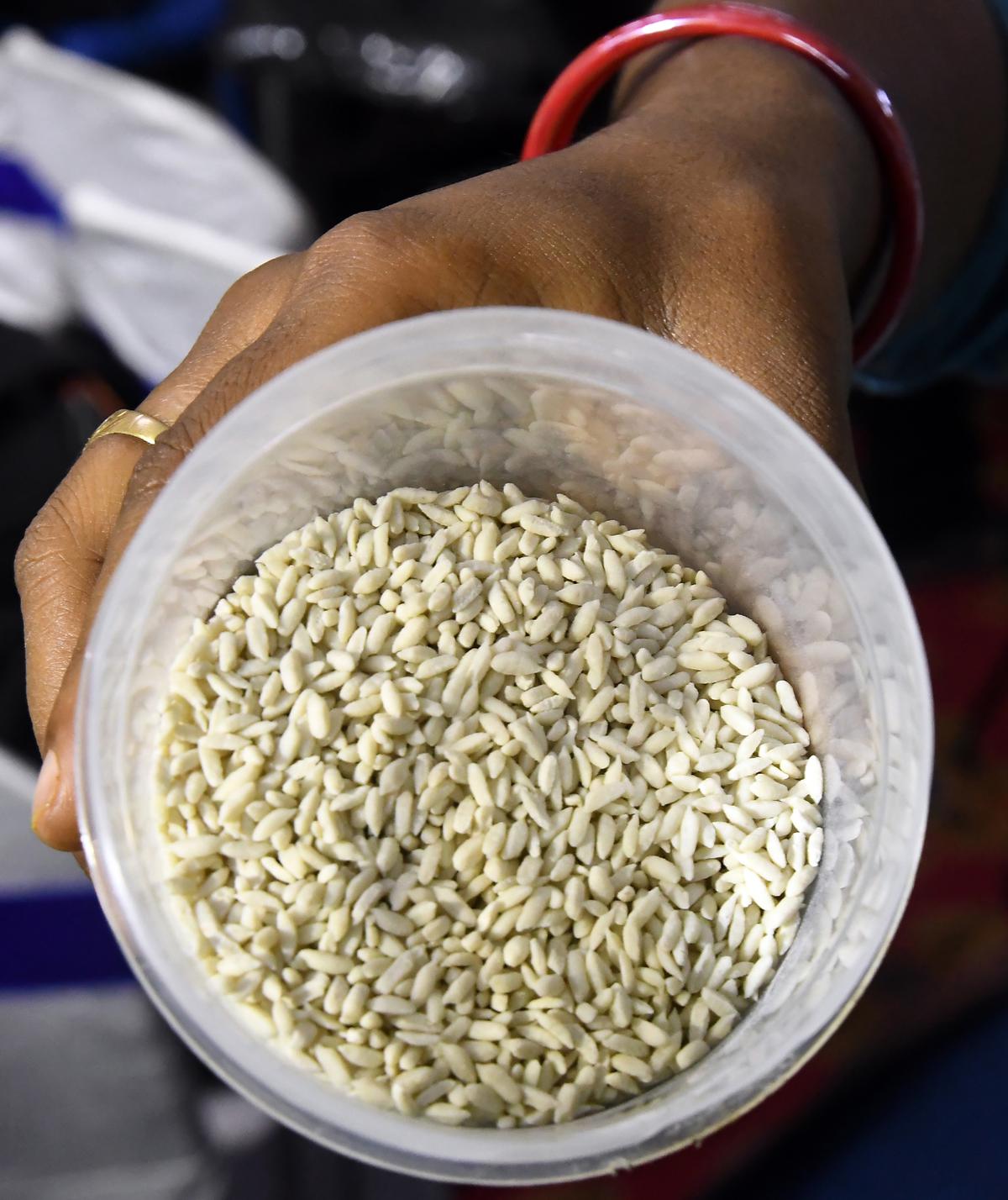
- 21 Oct 2024
Introduction to Rice Fortification
Fortification refers to the process of adding micronutrients, such as vitamins and minerals, to food products that are not naturally present in sufficient amounts. In India, rice fortification has been identified as a cost-effective strategy to address widespread micronutrient deficiencies, particularly iron, folic acid, and vitamin B12. These deficiencies contribute to various health problems such as anemia, stunted growth, and cognitive impairments, particularly among women and children.
Background: India’s Fortified Rice Program
India has one of the highest rates of malnutrition globally, with anemia affecting every second woman and every third child in the country. Rice is a staple food for approximately 65% of India’s population, making it an ideal vehicle for micronutrient fortification. In 2019, the Indian government launched the rice fortification initiative as part of its broader strategy to improve public health and nutrition outcomes.
In July 2024, the Union Cabinet approved the continuation of the fortified rice program under key welfare schemes, including the Pradhan Mantri Garib Kalyan Anna Yojana (PMGKAY). This initiative will run until December 2028, and aims to make fortified rice a common feature of the Public Distribution System (PDS), mid-day meals, and anganwadis, reaching millions of beneficiaries across the country.
Fortification Process and Standards
The fortification of rice involves adding essential micronutrients—iron, folic acid, and vitamin B12—to rice grains. This can be done by either coating the rice with a premix or producing extruded rice kernels that are enriched with nutrients before blending them with regular rice. According to the Food Safety and Standards Authority of India (FSSAI), every kilogram of fortified rice should contain:
- Iron: 28 mg - 42.5 mg
- Folic Acid: 75 - 125 micrograms
- Vitamin B12: 0.75 - 1.25 micrograms
Scientific Safety and Efficacy of Iron Fortified Rice
The safety and effectiveness of iron-fortified rice have been under close scrutiny. Concerns were raised about whether individuals with hemoglobinopathies (such as Thalassemia and Sickle Cell Anemia) might be adversely affected by the added iron. Initially, the packaging of fortified rice carried health advisories for these individuals, but a 2023 scientific review and committee assessment concluded that there were no health risks from iron fortification for such individuals. The iron levels in fortified rice are minimal compared to the levels of iron patients with Thalassemia receive through blood transfusions, and Sickle Cell patients have naturally elevated levels of hepcidin, which limits iron absorption.
Following the review, the advisory was removed in July 2024, aligning with global practices where similar advisories are not required in countries that fortify rice.
Expansion of Fortified Rice Infrastructure
India’s rice fortification program has scaled up rapidly. As of 2024, over 21,000 rice mills have installed blending equipment to produce fortified rice, with a monthly capacity of 223 lakh metric tons (LMT). Additionally, 232 premix suppliers have the capacity to produce 75 LMT annually, significantly surpassing the requirements of the PMGKAY, which mandates the procurement of 5.2 LMT of fortified rice annually.
To ensure quality, NABL-accredited labs conduct rigorous testing on fortified rice products across the country. This infrastructure expansion supports the goal of fortifying rice distributed through welfare schemes and public safety nets.
Global Context: Rice Fortification Worldwide
Fortification of staple foods, including rice, is a globally recognized practice aimed at addressing micronutrient deficiencies in populations with limited access to diverse diets. As of 2024, 18 countries globally are actively involved in rice fortification. The World Health Organization (WHO) has endorsed rice fortification as an effective means to combat iron deficiency anemia, especially in countries like India where rice is a primary dietary staple.
Countries such as the U.S. have been fortifying rice since the late 1950s, and WHO recommends iron fortification where rice constitutes a major part of the diet.
Benefits of Iron Fortification of Rice
- Improved Cognitive Development: Iron is crucial for brain development and cognitive function. Adequate iron intake during early childhood is linked to better cognitive performance, which can improve educational outcomes.
- Enhanced Maternal and Infant Health: Iron deficiency during pregnancy is associated with risks such as maternal anemia and poor fetal development. Fortified rice helps reduce these risks by improving iron intake among pregnant women.
- Reduction in Prevalence of Anemia: Regular consumption of fortified rice has been shown to improve hemoglobin levels in populations suffering from iron deficiency anemia. This has been particularly evident in pilot districts in India, where iron fortification has led to improved health outcomes among both adults and children.
Potential Risks and Challenges
- Bioavailability of Iron: Iron bioavailability refers to the body's ability to absorb and utilize the iron from fortified foods. While iron from rice is absorbed to a lesser extent compared to meat, its fortification still contributes significantly to overall iron intake, especially in populations that consume rice regularly.
- Overload of Iron: Excessive iron intake can lead to iron toxicity, causing oxidative stress, liver damage, and increased risk of infections. Special care must be taken to ensure that individuals with conditions like hemochromatosis or those receiving other forms of iron supplementation do not experience iron overload.
- Technical and Social Barriers: While India has made substantial progress in infrastructure for rice fortification, challenges remain in ensuring the quality, stability, and safety of fortified rice. Moreover, ensuring affordability, accessibility, and acceptance of fortified rice among diverse population groups remains a critical concern.
Future Directions for Rice Fortification
- Nanotechnology for Enhanced Iron Absorption: To improve the bioavailability of iron, exploring the use of nanotechnology could help encapsulate iron particles, enhancing their absorption and effectiveness in the body.
- Biofortification Integration: Combining iron fortification with biofortification—the process of breeding rice varieties with naturally higher iron content—could provide a sustainable solution for long-term micronutrient deficiency.
- Public-Private Partnerships: To scale up rice fortification, there is a need for collaborations between the government, private sector, and non-governmental organizations (NGOs). These partnerships can help improve distribution networks, technology development, and financial sustainability.
- Continuous Monitoring and Evaluation: Rigorous evaluation studies, such as those being conducted by the Indian Council of Medical Research (ICMR) and NITI Aayog, will help assess the effectiveness of the rice fortification program and ensure its continuous improvement.
Conclusion: A Path to Nutritional Security
The fortification of rice in India represents a powerful tool to address the growing problem of micronutrient deficiencies, particularly iron deficiency anemia, which affects millions of people, especially women and children. By ensuring that fortified rice is integrated into government welfare schemes, India can take a significant step toward improving public health and achieving its nutritional goals.
While challenges related to bioavailability, iron overload, and implementation remain, ongoing research, technological innovation, and collaborative efforts can help mitigate these risks. As India continues to expand its rice fortification program, it offers a model for other countries facing similar nutritional challenges, reinforcing the role of fortified foods in achieving global sustainable development goals (SDGs) related to health and nutrition.
Mission Mausam

- 20 Oct 2024
Introduction: The Need for Advanced Weather Forecasting
India is increasingly facing extreme weather events such as flooding and droughts, which have become more frequent and intense in recent years. According to a 2021 study by the Council on Energy, Environment, and Water (CEEW), 40% of districts in India face alternating climatic hazards, where flood-prone areas also experience droughts, and vice versa. Moreover, a 64% increase in heavy rainfall days during the monsoon season has been recorded over the last decade.
Despite these challenges, India’s weather forecasting systems remain underdeveloped, particularly in flood-prone regions. While cyclone-prone areas benefit from comprehensive early warning systems, flood-prone regions are largely under-covered. To address these gaps and to prepare for more frequent climate risks, the Mission Mausam, launched in September 2024, aims to transform India's weather forecasting capabilities.
Key Objectives of Mission Mausam
Mission Mausam focuses on three main pillars:
- Increasing Weather Observation Networks
- Improving Weather Forecasting Models
- Investigating Weather Modification Techniques
This initiative is led by three institutions under the Ministry of Earth Sciences:
- India Meteorological Department (IMD)
- National Centre for Medium Range Weather Forecasting (NCMRWF)
- Indian Institute of Tropical Meteorology (IITM)
The mission is backed by an investment of ?2,000 crore and aims to address the growing complexity of India’s climate challenges.
1. Gaps in India's Current Weather Observation Network
Despite significant advances, India’s existing weather observation system has several gaps, particularly in terms of coverage and data accessibility.
Weather Radar Coverage
India currently operates 39 Doppler Weather Radars (DWRs), but their distribution is not optimal. Key regions that are highly vulnerable to extreme weather events are under-monitored:
- Western Coast: Only 5 radars monitor the entire western coastline, where cyclones are becoming more frequent and intense.
- Urban Centres: Cities like Ahmedabad, Bengaluru, and Jodhpur — which have experienced repeated flooding — lack adequate radar coverage.
Action Required:
- Expand Radar Coverage: Prioritise the installation of weather radars along the western coast and in urban centres with high climate risks.
- Improve Observation Platforms: In addition to radars, install other weather observation platforms such as wind profilers and radiometers to provide more comprehensive data.
Limited Data Access
At present, the data from India’s weather observation network is not fully accessible to researchers and innovators. This limits the ability to develop localised early warning systems and innovative solutions for climate resilience.
Action Required:
- Open Data Access: Make weather data available to researchers, academic institutions, and private sector innovators. This will encourage the development of analytical tools and localized solutions for extreme weather events.
- Global Best Practices: Following the examples of countries like the United States, United Kingdom, and France, which openly share weather data, India can foster innovation and improve its forecasting capabilities.
2. Strengthening Weather Forecasting Models
Improved weather forecasting models are essential for accurately predicting extreme weather events, including heavy rainfall, floods, and cyclones.
Machine Learning and Atmospheric Physics
Mission Mausam will enhance weather forecasting models through:
- Integration of Machine Learning: By incorporating machine learning techniques, India can improve prediction accuracy and lead times.
- Better Understanding of Atmospheric Physics: Improved scientific understanding of the atmosphere can lead to more accurate and reliable weather forecasts.
Action Required:
- Enhance Forecasting Capabilities: Focus on improving long-term and short-term weather predictions, especially for regions prone to extreme weather.
- Incorporate Technology: Leverage advanced technologies, including AI and machine learning, to predict weather patterns more accurately.
3. Improving Communication and Dissemination of Weather Information
Effective communication of weather warnings is essential for timely action by governments, businesses, and citizens.
Enhancing Warning Systems
Currently, the India Meteorological Department (IMD) disseminates weather warnings through various channels, including mobile applications and web portals. However, the effectiveness of these warnings can be improved.
Action Required:
- User-Friendly Warnings: Improve the interface of weather apps and websites, providing users with guidance on how to interpret warnings and take necessary precautions.
- Capacity Building: Create informational videos, media campaigns, and easy-to-understand guides to help citizens act upon warnings effectively.
Wider Use of Localised Decision Tools
Localized decision tools can be used to help communities in specific regions take proactive steps before, during, and after extreme weather events.
Action Required:
- Localized Early Warning Systems: Develop region-specific warning tools that integrate local knowledge with scientific forecasts, making them more effective for local populations.
4. Integrating Mission Mausam with Sectoral Planning
The success of Mission Mausam will depend on its integration with various sectoral policies, particularly in areas such as agriculture, water management, and energy.
Use Cases for Climate-Resilient Sectors
Data from the enhanced weather observation system can be used to:
- Support Agriculture: Weather forecasts can inform crop planning and irrigation management, helping farmers mitigate the impacts of extreme weather events.
- Water Resource Management: Improved forecasting can assist in flood management, water storage, and distribution planning.
- Energy Sector Planning: Accurate weather predictions can help the energy sector plan for weather-related disruptions, such as extreme temperatures or storms that affect power grids.
Action Required:
- Sectoral Integration: Ensure that the weather data generated by Mission Mausam is shared with relevant ministries (e.g., Agriculture, Water Resources, Energy) to develop climate-resilient policies and strategies.
Conclusion: Moving Towards a Climate-Smart India
Mission Mausam is a critical initiative to make India more weather-ready and climate-smart. By improving weather observation networks, enhancing forecasting models, and promoting data-sharing, India can mitigate the impacts of extreme weather events that have become increasingly unpredictable and severe. The success of Mission Mausam will depend on:
- Investing in technology
- Expanding weather coverage
- Engaging local communities and sectors
As India continues to face the challenges posed by climate change, Mission Mausam holds the potential to revolutionize how the country prepares for and responds to extreme weather events, ultimately reducing the toll on lives and livelihoods.
Navigating the Middle-Income Trap: Challenges and Solutions for India

- 14 Oct 2024
Introduction
The World Development Report 2024 addresses the phenomenon of the middle-income trap, where countries struggle to maintain growth as they transition from low to middle-income status. This report advocates for a "3i" approach—Investment, global Technology infusion, and domestic Innovation—to overcome this challenge. India faces specific hurdles, including stagnant exports, rising protectionism, and premature deindustrialization.
Understanding the Middle-Income Trap
Definition and Characteristics
- A middle-income trap occurs when a country, after achieving middle-income status, fails to progress to high-income status.
- This phenomenon typically arises when a country's per capita income reaches about 11% of US levels, leading to:
- High wage levels that diminish competitiveness against low-wage economies.
- Insufficient technological advancement to compete with high-income nations.
Economic Implications
- Traditional growth drivers become ineffective.
- Rising wages in labor-intensive sectors decrease competitiveness, while innovation and productivity remain stagnant.
Historical Context: India’s Income Evolution
1. Post-Independence Era (1950s-1970s)
- Per Capita Income: ?265 in 1950-51.
- Growth Rate: 3.5%, dominated by agriculture.
- Economic Structure: Heavy state intervention and public sector focus.
2. Liberalization Phase (1980s-1990s)
- Per Capita Income Growth: Accelerated to 5.6%.
- Major Shift: 1991 liberalization led to a rise in the services sector and an expanding middle class.
3. High Growth Phase (2000-2010)
- GDP Growth: 8-9% annually.
- Per Capita Income: Increased from ?16,173 in 2000-01 to ?24,295 in 2007-08.
- Sectoral Dominance: Surge in software and services exports.
4. Mixed Growth Phase (2010-2020)
- Growth Volatility: Average of 6-7%.
- Wealth Inequality: Top 1% owned 40.5% of national wealth by 2021.
5. Post-Covid Recovery (2020-Present)
- GDP: Reached $3.75 trillion.
- Current Issues: Unemployment at 8.1%, while digital payment systems expanded.
Challenges in Overcoming the Middle-Income Trap
1. Premature Deindustrialization
- The manufacturing sector's GDP share has stagnated at 15-17%, far below the target of 25%.
- Limits potential productivity gains and innovation.
2. Limitations of Services-Led Growth
- Over-reliance on the services sector hampers mass employment and inclusive growth.
3. Declining Total Factor Productivity (TFP)
- TFP growth has been declining, indicating a shift toward input-driven growth rather than efficiency-driven growth.
4. Informal Sector Dominance
- The informal economy comprises about 90% of the workforce, leading to low productivity and limited access to technology.
5. Risk of a Demographic Burden
- Youth unemployment is rising, with only 2.3% of the workforce receiving formal skill training.
6. Global Economic Headwinds
- Slowing global growth affects India’s export-led strategies, with a recent contraction in merchandise exports.
7. Infrastructure and Logistics Bottlenecks
- India ranks 38th in the World Bank’s Logistics Performance Index, highlighting significant infrastructure gaps.
Strategic Measures for India
1. Enhance Manufacturing Competitiveness
- Targeted Industrial Policies: Refine the Production-Linked Incentive scheme and extend it to emerging sectors like green hydrogen.
2. Accelerate Digital Infrastructure and Skills Development
- Leverage India's digital platforms to create a skills ecosystem and modernize vocational training.
3. Boost R&D Expenditure
- Increase public R&D spending to 2% of GDP by 2030, focusing on key sectors like renewable energy.
4. Foster an Innovation-Driven Manufacturing Policy
- Shift focus to high-value specialized manufacturing rather than competing in mass production.
5. Integrate Skills and Education
- Align educational curricula with industry needs and establish centers of excellence in tier-2 and tier-3 cities.
6. Lead in Green Technology
- Scale initiatives like the International Solar Alliance and create a national carbon market.
7. Reform Market Regulations
- Liberalize product and factor markets to enhance competition and efficiency.
Conclusion
India's path out of the middle-income trap necessitates a concerted effort to boost manufacturing, foster innovation, and address productivity challenges. By leveraging digital infrastructure and enhancing skills, alongside adopting green technologies, India can create a sustainable framework for growth. Effective execution of targeted policies will be crucial for transitioning to a high-income economy.
ASEAN SUMMIT
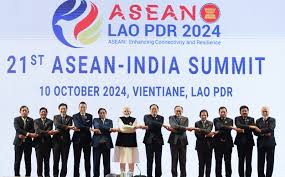
- 11 Oct 2024
In News:
The 21st ASEAN-India Summit took place in Vientiane, Lao PDR, on 10 October 2024. This summit coincided with the 10th anniversary of India’s Act East Policy. Prime Minister Narendra Modi joined ASEAN leaders to assess the progress of the ASEAN-India Comprehensive Strategic Partnership and set the course for future collaboration.
In his address, Prime Minister Modi reaffirmed India's strong support for ASEAN Unity, ASEAN Centrality, and the ASEAN Outlook on the Indo-Pacific. Referring to the 21st century as the “Asian century,” he emphasized the pivotal role of India-ASEAN relations in shaping Asia’s future. He highlighted the success of India’s Act East Policy, noting that in the last decade, trade between India and ASEAN had doubled to over USD 130 billion, with ASEAN becoming one of India’s top trade and investment partners. He also pointed out direct flight connections with seven ASEAN countries, advancements in Fin-tech collaborations, and efforts to restore shared cultural heritage in five ASEAN nations. PM Modi also stressed the importance of completing the review of the ASEAN-India Free Trade Agreement (AITIGA) promptly to unlock greater economic potential. He spoke about the progress made in the India-ASEAN knowledge partnership, particularly through scholarships for ASEAN students at Nalanda University.
In line with the summit’s theme of ‘Enhancing Connectivity and Resilience", PM Modi announced a 10-point plan, which includes:
- Celebrating 2025 as the ASEAN-India Year of Tourism, with USD 5 million allocated for joint initiatives.
- Marking a decade of the Act East Policy through people-centric activities like a Youth Summit, Start-up Festival, Hackathon, Music Festival, ASEAN-India Network of Think Tanks, and Delhi Dialogue.
- Organizing an ASEAN-India Women Scientists Conclave under the ASEAN-India Science and Technology Development Fund.
- Doubling scholarships at Nalanda University and offering new scholarships for ASEAN students at Indian agricultural universities.
- Reviewing the ASEAN-India Trade in Goods Agreement by 2025.
- Enhancing disaster resilience, with India contributing USD 5 million.
- Initiating a new Health Ministers’ track for building health resilience.
- Establishing a regular ASEAN-India Cyber Policy Dialogue to strengthen digital and cyber resilience.
- Hosting a workshop on Green Hydrogen.
- Inviting ASEAN leaders to join the ‘Plant a Tree for Mother’ campaign to promote climate resilience.
During the summit, leaders agreed to develop a new ASEAN-India Plan of Action (2026-2030) to guide future cooperation and adopted two joint statements:
- Joint Statement on Strengthening ASEAN-India Comprehensive Strategic Partnership for Peace, Stability, and Prosperity in the Indo-Pacific, highlighting the role of India’s Act East Policy in advancing the ASEAN-India relationship.
- ASEAN-India Joint Statement on Advancing Digital Transformation, recognizing India’s leadership in digital transformation and embracing a partnership in digital public infrastructure.
Prime Minister Modi expressed his gratitude to the Prime Minister of Laos for successfully hosting the summit and to Singapore for its role as Country Coordinator over the past three years. He looked forward to working with the Philippines, the new Country Coordinator for India.
ABOUT Association of Southeast Asian Nations (ASEAN)
- ASEAN is a political and economic organization focused on fostering economic growth and regional stability among its member countries.
- The member states include Brunei, Cambodia, Indonesia, Laos, Malaysia, Myanmar, the Philippines, Singapore, Thailand, and Vietnam.
- ASEAN was founded in 1967 in Bangkok, Thailand, with the signing of the ASEAN Declaration (Bangkok Declaration) by its original members: Indonesia, Malaysia, the Philippines, Singapore, and Thailand. Brunei Darussalam joined in 1984, followed by Vietnam in 1995, Lao PDR and Myanmar in 1997, and Cambodia in 1999.
ASEAN Summit:
- This is ASEAN’s highest decision-making body, consisting of the heads of state or government of member nations. The summit is held twice a year.
- The first ASEAN Summit took place in 1976 in Bali, Indonesia.
The Mental Health Crisis in India
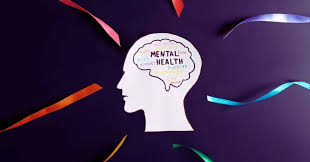
- 10 Oct 2024
In News:
India faces a significant mental health crisis, driven by various factors including economic disparities, social isolation, and changing family dynamics. The pandemic further worsened these issues, leading to detrimental effects on mental well-being.
Causes of Mental Illness
- Socioeconomic Factors: Poverty, violence, inequality, and environmental deprivation contribute to rising mental health issues.
- Pandemic Impact: Lockdowns and uncertainties have heightened stress levels and anxiety.
- Adverse Life Experiences: Trauma, abuse, and dysfunctional family relationships can severely impact mental health.
- Cultural Pressures: The urban focus on consumerism and status can lead to feelings of inadequacy and dissatisfaction.
The Shortage of Mental Health Professionals
India's mental health services are severely lacking, with only 0.75 psychiatrists per 100,000 population—far below the World Health Organization's recommendation of three. This shortage underscores the need for policy interventions and incentives to increase the supply of mental health professionals.
Government Initiatives for Mental Health
The Indian government has implemented several initiatives to improve mental health care:
- National Mental Health Programme (NMHP): Launched in 1982 to enhance community-based mental health services.
- Mental Healthcare Act, 2017: Decriminalized suicide attempts and introduced advanced directives for treatment choices.
- Rights of Persons with Disabilities Act, 2017: Recognizes mental illness as a disability, enhancing rights for affected individuals.
- Manodarpan Initiative: Provides psycho-social support to students.
- Kiran Helpline: A suicide prevention helpline for crisis management.
- National Tele-Mental Health Programme: Launched in 2022 to expand access to mental health services, particularly in underserved areas.
Economic Survey 2023-24
For the first time, the Economic Survey emphasized the importance of mental health in policy recommendations, calling for effective implementation of mental health initiatives to address existing gaps.
Understanding Healthy Workplaces
Defining a Healthy Workplace
A healthy workplace fosters collaboration between employers and employees to promote physical and psychological safety. It encompasses open communication, respect, and a supportive environment, crucial for addressing workplace stress, anxiety, and burnout.
Current Crisis: Overwork and Mental Health
The phenomenon of ‘Karoshi’ (death from overwork) highlights the severe consequences of workplace stress. In India, 40% of employees report high stress levels due to excessive work demands.
Ethical Perspectives on Healthy Workplaces
Creating a healthy workplace involves:
- Fairness and Equity: Ensuring all employees have equal access to resources and opportunities.
- Respect for Individual Dignity: Acknowledging contributions and fostering psychological safety.
- Moral Responsibility of Employers: Providing a safe working environment and promoting mental health initiatives.
- Transparency and Accountability: Building trust through open communication about policies and practices.
- Promoting Work-Life Balance: Encouraging a balance between professional and personal life to prevent burnout.
Global Precedents for Work-Life Balance
Countries like Australia and France have introduced regulations, such as the ‘right to disconnect,’ allowing employees to disengage from work communications after hours.
Conclusion and Way Forward
Establishing healthy workplaces is not merely a regulatory compliance issue but an ethical commitment to employee well-being. Both employers and employees must collaborate to create an environment of psychological safety, open communication, and mutual respect. By prioritizing these principles, organizations can foster workplaces that enhance productivity and support mental health, ultimately driving innovation and improving overall well-being.
Fairwork India Report
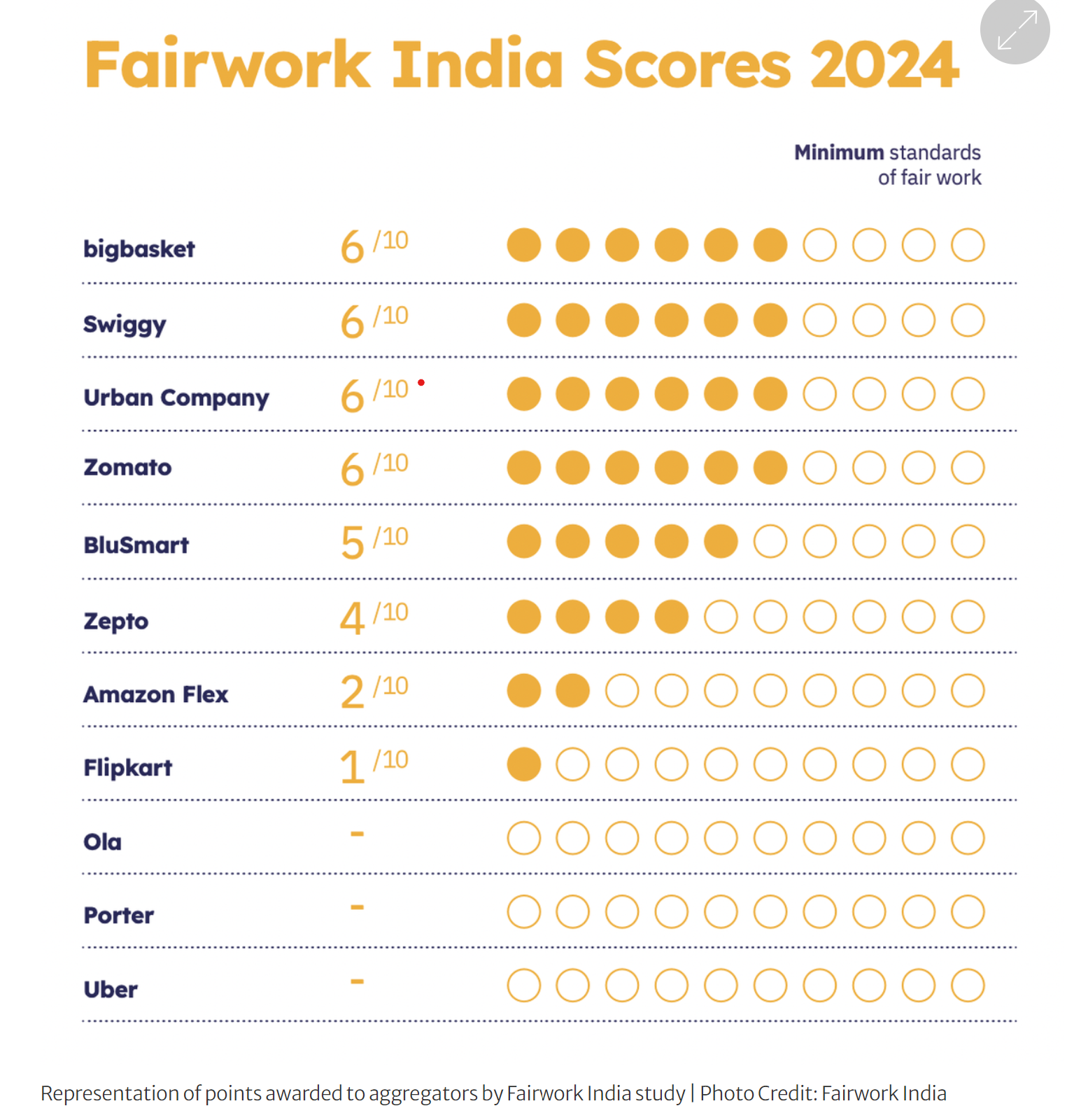
- 06 Oct 2024
In News:
The Fairwork India Ratings 2024 report, which analyses the work conditions of platform workers on digital labour platforms in India, draws a picture of aggregators who are non-committal to ensuring that workers earn the local living wage and unwilling to recognise collectivisation of workers.
Key Findings:
- Overall Performance: No platform scored above six out of ten, and none achieved top points across the five assessed principles: Fair Pay, Fair Conditions, Fair Contracts, Fair Management, and Fair Representation.
- Study Background: This report is the sixth annual analysis conducted by the Fairwork India Team, in collaboration with the Centre for IT and Public Policy (CITAPP), IIIT-Bangalore, and Oxford University.
Analysis of Welfare Legislation
- The report discusses the evolving nature of platform work and its implications for proposed legislation affecting gig workers in Karnataka and Jharkhand.
- Political interest in gig workers' welfare has increased, but the effectiveness of these initiatives remains uncertain.
- Professors Balaji Parthasarathy and Janaki Srinivasan highlight the importance of ongoing research and advocacy for improving gig worker conditions.
Methodology
- Principles of Assessment: Platforms were evaluated based on five principles, each consisting of two points—one that could only be awarded if the first point was fulfilled.
- Data Collection: Worker interviews were conducted across multiple cities, including Bengaluru, Chennai, Delhi, Kochi, and Thiruvananthapuram.
- Platforms Analyzed: The study included 11 platforms from various sectors, such as logistics, food delivery, and personal care.
Detailed Findings by Principle
Fair Pay
- First Point: Bigbasket and Urban Company were recognized for implementing a minimum wage policy ensuring workers earn at least the local minimum wage.
- Second Point: No platform met the criteria for committing to a local living wage after work-related costs.
Fair Conditions
- First Point: Platforms such as Amazon Flex, BigBasket, and Swiggy provided adequate safety equipment and training.
- Second Point: BigBasket, Swiggy, Urban Company, Zepto, and Zomato offered additional protections, including accident insurance and compensation for medical-related work absences.
Fair Contracts
- First Point: BigBasket, BluSmart, and others ensured contract accessibility and data protection protocols.
Fair Management
- First Point: Amazon Flex, BigBasket, and several others provided due process in disciplinary decisions.
- Second Point: BluSmart, Swiggy, Urban Company, and Zomato were noted for regular external audits and anti-discrimination policies.
Fair Representation
- Despite increased collectivization efforts among platform workers, no platform showed a willingness to recognize collective bodies, underscoring a critical gap in worker representation.
Conclusion
The Fairwork India Ratings 2024 report highlights significant challenges in ensuring fair work conditions for platform workers in India, stressing the need for continuous advocacy and reform in the gig economy.
National Urban Livelihood Mission (NULM)
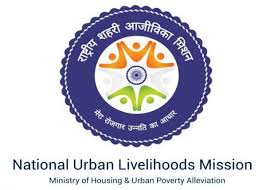
- 05 Oct 2024
In News:
The Government is set to launch NULM 2.0, the latest iteration of the National Urban Livelihood Mission (NULM), aimed at enhancing the livelihoods of urban poor and vulnerable populations. This version will specifically target six key groups: construction workers, gig workers, waste management workers, care workers, domestic workers, and transportation workers.
Overview of DAY-NULM
The Deendayal Antyodaya Yojana-National Urban Livelihoods Mission (DAY-NULM) was initiated in 2014 by the Ministry of Housing and Urban Affairs to replace the Swarna Jayanti Shahari Rozgar Yojana. It aims to uplift urban poor through organized self-help groups (SHGs), skill development, and access to credit.
Key Features:
- Funding Structure: DAY-NULM operates as a Centrally Sponsored Scheme, with a funding ratio of 75:25 between the central and state governments, adjusted to 90:10 for North Eastern and Special Category states.
- Mobilization of Women: The mission has successfully formed over 831,000 SHGs, mobilizing more than 8.4 million urban poor women by 2023.
- Objectives: It focuses on sustainable livelihoods through skill development, financial access, and entrepreneurship, particularly for women.
Components and Achievements
DAY-NULM includes various initiatives such as:
- Skill training programs.
- Support for self-employment.
- Rehabilitation for street vendors.
Performance Highlights:
- Over 89.33 lakh women have joined SHGs, with 6.12 lakh receiving initial funds.
- Approximately 15 lakh individuals have undergone skill training, leading to employment for 8.20 lakh.
- Surveys have identified 53.76 lakh street vendors, resulting in significant documentation and support.
Introduction of NULM 2.0
NULM 2.0 is a revamped initiative designed to further support urban livelihoods through financial aid and infrastructure enhancements.
Key Features:
- Microcredit Access: Eligible individuals can obtain microcredit of up to ?4 lakh, while groups can access up to ?20 lakh, with a subsidized interest rate of 5%.
- Support for Enterprises: The funding aims to assist beneficiaries in starting small businesses, creating social infrastructure, and providing grants for innovative projects, such as sanitation machinery.
Pilot Initiative
To effectively implement NULM 2.0, the government will conduct a pilot program in 25 cities. This will focus on:
- Identifying urban poor populations.
- Ensuring targeted assistance to improve beneficiaries’ earnings and living conditions.
Conclusion
The rollout of NULM 2.0 represents a significant step in addressing the needs of the urban poor, with a comprehensive framework designed to provide financial support and improve livelihoods. By focusing on critical worker groups and leveraging microcredit, the initiative aims to foster sustainable development and enhance the quality of life for urban vulnerable communities.
Women Entrepreneurship Platform
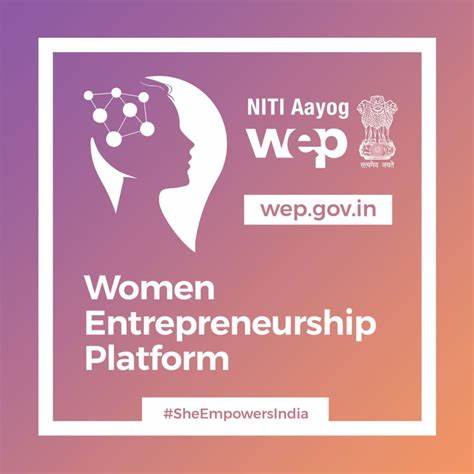
- 01 Oct 2024
In News:
Telangana has become the first state in India to establish a chapter of NITI Aayog’s Women Entrepreneurship Platform (WEP), aimed at promoting and supporting women entrepreneurs across various sectors.
Overview of WEP
- Objective: To provide women entrepreneurs access to resources, tools, and networks for business growth.
- Previous Operation: WEP was primarily a Central Government initiative before this chapter's establishment.
Launch Details
- Event: The WEP Telangana Chapter was launched in Hyderabad.
- Key Figures:
- NITI Aayog CEO BVR Subrahmanyam
- State IT and Industries Secretary Jayesh Ranjan
- Co-chair of WEP Sangeetha Reddy
Customised Support for Women Entrepreneurs
- Services Offered:
- Digital skilling
- Access to financial services
- Mentorship
- Market linkages
- Implementation Body: WE Hub will serve as the nodal body for the scheme in the state, leveraging its expertise to empower women entrepreneurs.
Importance of Women Entrepreneurship
- Economic Impact: Emphasis the crucial role of women entrepreneurship in India's economic future.
- Challenges Addressed: The initiative aims to overcome barriers faced by women entrepreneurs in finances, mentoring, and marketing.
Future Expansion Plans
- Vision for Growth:
- Principal Economic Advisor Anna Roy outlined plans to expand WEP to tier 2 and 3 cities.
- The initiative aims to build an inclusive entrepreneurial ecosystem through a hub-and-spoke model.
WE Bridge Initiative
- Leadership: WE Hub CEO Sita Pallacholla appointed as mission director for the WEP Telangana Chapter.
- State’s Advantages: Telangana was chosen for its supportive environment for entrepreneurship in Self-Help Groups (SHGs) and its robust innovation ecosystem.
- WE Bridge: Introduced as a single-window platform for women entrepreneurs in the state.
Benefits of the Partnership
- Access to Resources: The collaboration with NITI Aayog will enhance opportunities for women, providing access to funding, technology, and networks.
- Mentoring Emphasis: Sangeetha Reddy highlighted the critical role of mentoring in business success.
Objectives of WEP Telangana
- Skill Empowerment: Enhance digital technology and financial literacy among women entrepreneurs.
- Mentorship Connections: Link women entrepreneurs with industry leaders for guidance in business development, marketing, and scaling.
- Market Access: Facilitate connections with potential investors and industry partners through WE Hub’s extensive network.
What is the Unified Lending Interface by the RBI?
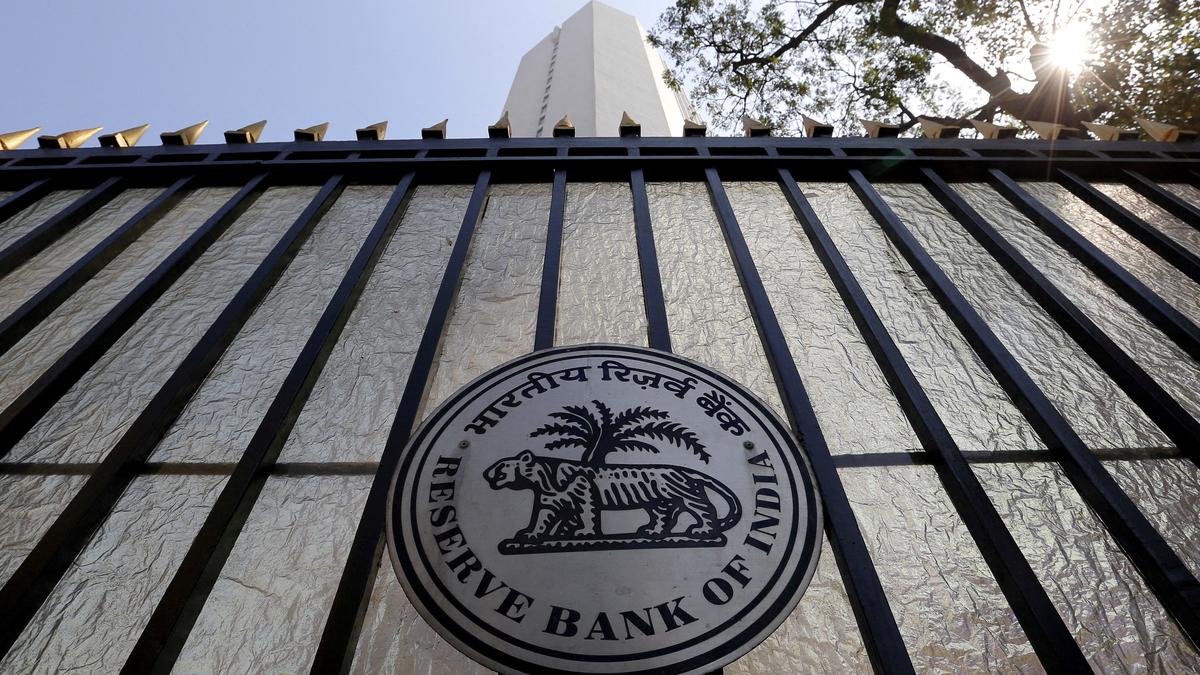
- 03 Sep 2024
In News:
The Reserve Bank of India (RBI), as part of its strategy to create digital public infrastructure in the country, has announced that a new technology platform called the Unified Lending Interface (ULI) would be introduced by the Reserve Bank Innovation Hub, Bengaluru which will enable friction-less credit to farmers and MSME borrowers to begin with.
What is ULI?
The ULI platform, aims to revolutionize the credit underwriting process by enabling a streamlined and consent-based transfer of both financial and non-financial data from various sources to lenders.
- Seamless Data Flow: ULI facilitates an efficient flow of digitized data, including crucial records like land titles, directly to lenders, enhancing the credit appraisal process.
- Faster Credit Appraisal: The platform is particularly beneficial for smaller and rural borrowers who may lack extensive credit histories, significantly reducing the time required for credit assessments.
- Standardized APIs: ULI employs common, standardized Application Programming Interfaces (APIs) that allow for a plug-and-play integration, simplifying the technical requirements for lenders and ensuring easy access to diverse data sources.
- Access to Diverse Data: Lenders can access a wealth of information from various databases, including government records and satellite imagery, which can provide deeper insights into potential borrowers.
- Opportunities for FinTechs: The platform also opens up opportunities for FinTech companies by connecting them with multiple lenders, thereby enhancing their ability to deliver tailored financial solutions.
ULI aims to create a more inclusive and efficient lending ecosystem, ultimately improving access to credit for a wider range of borrowers.
How will it work?
The ULI platform transforms the loan application process, especially for first-time borrowers and those without traditional credit histories. Here’s how it works:
- Centralized Data Access: ULI acts as a single point of access for lenders to retrieve crucial economic data about loan applicants. This reduces the need for applicants to gather extensive documentation themselves.
- Plug-and-Play Integration: Financial institutions can easily connect to the ULI platform through standardized APIs, allowing them to quickly access various data sources relevant to the borrower’s financial history and status.
- Automated Data Retrieval: Instead of borrowers spending weeks collecting documents, lenders can automatically fetch necessary information from the platform. For instance, data for a dairy farmer may include:
- Cash Flow Information: Sourced from local milk cooperatives.
- Land Ownership: Verified through state land records.
- Financial Insights: Derived from the farmer’s historical farming patterns.
- Enhanced Visibility: This comprehensive data access turns what were previously blind spots for lenders into clear insights, allowing them to assess applicants more accurately.
- Rapid Decision-Making: With immediate access to essential data, lenders can quickly determine the borrower’s income and creditworthiness. This streamlines decision-making, enabling loans to be sanctioned and disbursed within minutes.
- Supporting Tenant Farmers: Tenant farmers, who typically struggle to obtain loans due to lack of land titles, can also benefit. ULI can facilitate loans by allowing banks to verify identity and eligibility based on the intended use of funds for agricultural inputs rather than land ownership.
In summary, ULI simplifies the loan process, making it faster and more inclusive for diverse borrowers by leveraging digital data access and automation.
How did it start?
The ULI platform, officially launched by the RBI on August 10, 2023, emerged from the need for a streamlined approach to credit appraisal in an increasingly digital landscape. Here’s how it all began:
- Identification of Need: The RBI recognized that with rapid digitalization, there was a pressing need for a centralized platform to provide access to the data necessary for credit assessments. This was essential for facilitating frictionless digital credit delivery.
- Pilot Project: To test the concept, the RBI initiated a pilot project focused on the digitalization of Kisan Credit Card (KCC) loans under ?1.6 lakh in September 2022. This pilot was launched in select districts across Madhya Pradesh, Tamil Nadu, Karnataka, Uttar Pradesh, and Maharashtra.
- Encouraging Results: The initial outcomes of the KCC pilot were promising, showcasing the potential for seamless loan disbursement. The pilot demonstrated that loans could be disbursed at the doorstep, either through assisted or self-service modes, all without the need for extensive paperwork.
- Development of ULI: Building on the success of the KCC pilot, the RBI moved forward with the establishment of the ULI platform to broaden the scope of digital credit accessibility for a wider range of borrowers.
What does spaceflight do to the human body?
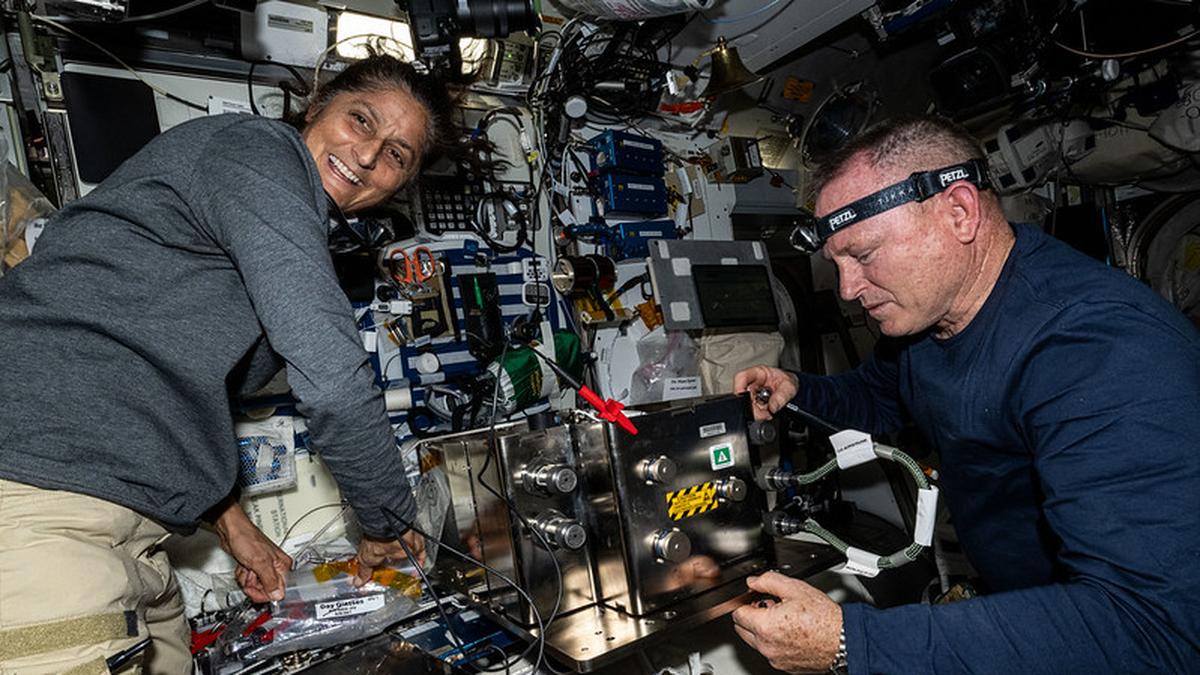
- 01 Sep 2024
In News:
- On August 24, 2023, NASA announced that Boeing’s Starliner crew capsule was deemed unsafe for the return of astronauts Sunita Williams and Barry Wilmore from the International Space Station (ISS).
- Williams and Wilmore’s stay onboard the ISS has been extended until February 2025, with their return planned via a SpaceX crew capsule in September 2024.
- Starliner will undock and return uncrewed.
Understanding Space
Definition and Characteristics
- What is Space?
- Space is defined as the area above the Karman line (100 km above sea level), transitioning from ‘earth-like’ to ‘space-like’ conditions.
- Microgravity Explained
- Astronauts experience microgravity due to the diminishing force of gravity, not complete absence, leading to various physiological effects.
Environmental Challenges
- Radiation in Space
- The Van Allen radiation belts, located above the Karman line, pose a significant challenge, exposing astronauts to charged particles.
- Historical research during the Apollo program determined that exposure levels in these belts are not harmful.
Effects of Space on the Human Body
Physiological Changes
- Bone Health: Microgravity leads to bone weakening, potentially causing renal stones due to excess mineral deposition.
- Digestive Issues: Food movement slows, contributing to potential weight gain.
- Eye Health: Spaceflight-associated neuro-ocular syndrome (SANS) affects about 20% of astronauts, with 70% of long-duration astronauts affected, causing vision impairment.
- Cardiovascular Effects: Reduced workload on the heart can result in muscle shrinkage.
- Muscle and Blood Changes: Muscle mass and strength decline; increased loss of red blood cells necessitates dietary adjustments.
Cognitive and Psychological Factors
- Balance and Orientation: Altered signals in microgravity challenge the brain's ability to maintain balance.
- Psychological Impacts: Isolation, fatigue, and stress from family separation contribute to mental health challenges.
Mitigating the Effects of Space
Strategies and Research
- Exercise and Routines: Strict exercise regimens and predictable routines are critical for maintaining astronaut health during missions.
- Nutritional Adjustments: Research is ongoing into how nutrients and drugs are metabolized in space.
- Monitoring and Countermeasures: Development of portable optical coherence tomography machines for SANS detection is underway, alongside potential countermeasures like lower body negative pressure and artificial gravity exposure.
Ongoing Research Initiatives
- Understanding Spaceflight Effects: The "space omics" studies aim to identify how space environments affect human biology, exemplified by NASA’s Twins Study.
- International Collaboration: Programs like Japan’s KAKENHI and Europe’s Space Omics Topical Team, along with U.S. research protocols, are exploring biological responses to space conditions.
Duration of Human Space Missions
Historical Context and Current Trends
- Increased Duration: The average time spent in space has risen from one month in the 1960s to six months in the 2020s.
- Current Missions
- Williams and Wilmore will potentially spend 256 days in orbit.
- Record holders: Valeri Polyakov (437 days), Frank Rubio (370 days), and Oleg Kononenko (over 1,000 days across missions).
Future Aspirations
- Long-Duration Missions: The shift from lunar missions to potential permanent moon bases and human missions to Mars presents new challenges in safety and health for astronauts.
SOUTH CHINA SEA
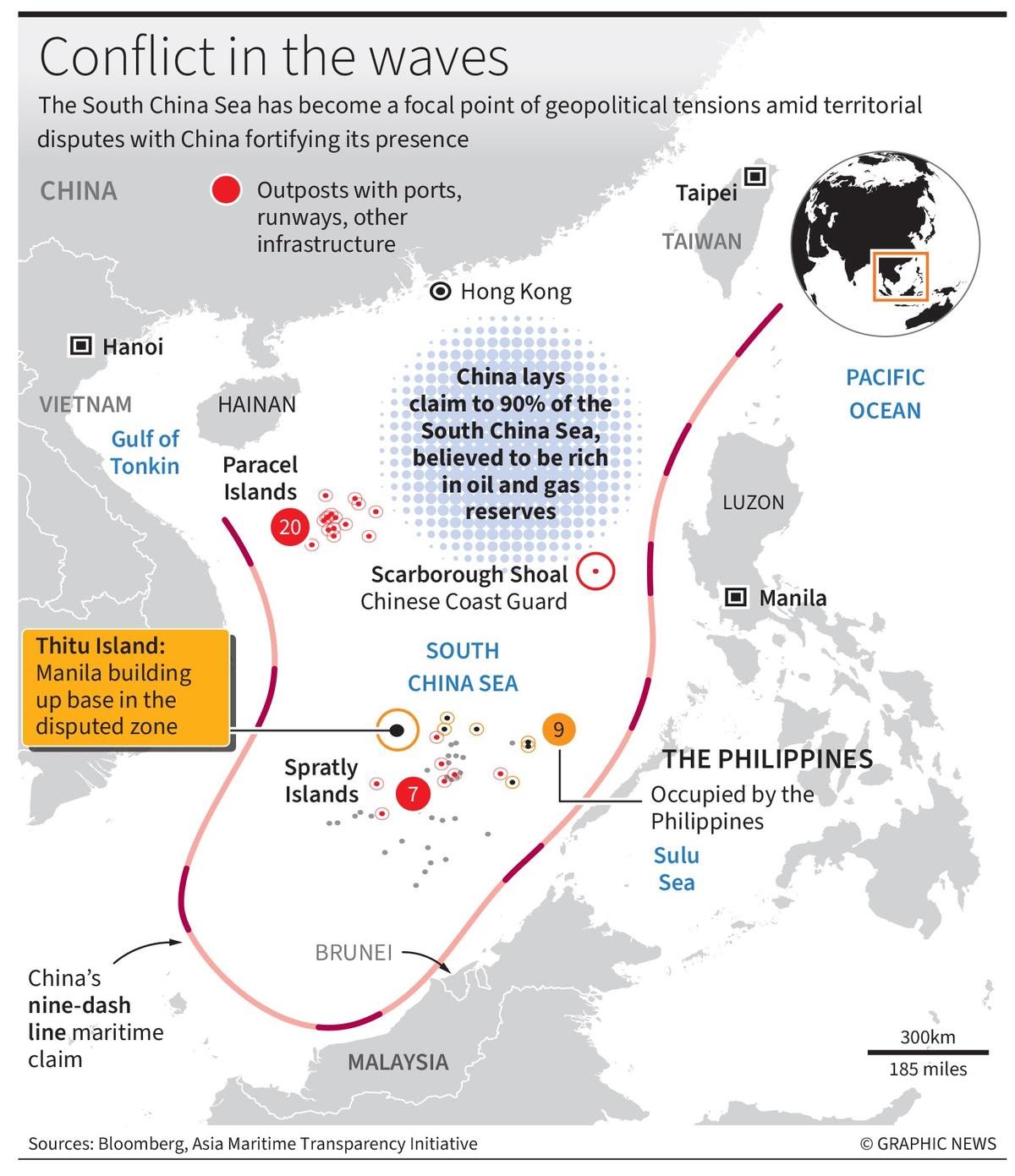
- 28 Sep 2024
In News:
In recent years, maritime East Asia has emerged as a battleground for intensified power politics, particularly in the East China Sea and the South China Sea. These regions involve complex territorial disputes and geopolitical tensions, particularly concerning China, Japan, Taiwan, and several Southeast Asian nations.
Geographic and Strategic Significance
East China Sea
- Territorial Claims: The East China Sea borders China, Taiwan, Japan, and South Korea, with the Senkaku/Diaoyu islands being a focal point of contention.
- Crises: Multiple crises have erupted over these islands, reflecting deep-seated national interests.
South China Sea
- Key Players: Located between China, Taiwan, and five Southeast Asian countries—Vietnam, Malaysia, Brunei, the Philippines, and Indonesia.
- Flashpoint: This area has become a critical flashpoint in the Indo-Pacific, with China aggressively asserting its claims.
China's Motivations
Naval Exercises and Claims
- Naval Collaboration: China has conducted naval exercises with Russia in the South China Sea, showcasing military capabilities and reinforcing territorial claims.
- Legal Standing: Despite a 2016 ruling by a permanent court of arbitration declaring China's claims to lack legal basis, Beijing has rejected this decision.
Regional Responses to China's Actions
1. Enhancing Defence Capabilities
- Increased Defence Spending: Countries like Japan and the Philippines are significantly boosting their defence budgets, with Japan aiming to double its spending by 2027.
- Acquisition of Technology: The Philippines has acquired anti-ship BrahMos missiles from India as part of its defence enhancement efforts.
2. Addressing Maritime Activities
- Shift in Policy: The Philippines has pivoted from a conciliatory approach to actively publicizing confrontations with Chinese vessels.
- Public Diplomacy: The Philippines employs social media to document and share encounters with Chinese ships, shaping public perceptions.
3. Strengthening Alliances
- U.S. Cooperation: The Philippines, Japan, and South Korea are reinforcing their defence relationships with the U.S., expanding cooperation in various domains including joint exercises.
- Trilateral Meetings: The U.S., Japan, and South Korea have deepened their trilateral cooperation, addressing concerns about unilateral changes to the status quo in the Indo-Pacific.
U.S. Credibility and Strategic Implications
Despite efforts to bolster alliances, concerns remain regarding U.S. credibility and the impact of domestic politics on its international commitments. There is ongoing debate over whether U.S. engagement balances Chinese power or exacerbates tensions.
China’s Sovereignty Perspective
National Security Framework
- Defence White Paper: China's 2019 Defence White Paper emphasizes that the South China Sea islands and Diaoyu Islands are integral parts of its territory.
- Infrastructure Development: China claims its actions are defensive, building infrastructure and conducting patrols, while regional nations view these actions as provocative.
Economic Importance of the Seas
- Maritime Trade Routes: Key maritime trade routes in East Asia traverse these waters, with the Taiwan Strait being a critical choke point.
- Resource Richness: The region contains vast reserves of untapped oil and natural gas, making it economically significant.
China's Aggressive Tactics
Infrastructure and Militarization
- Building Facilities: China is constructing military installations and artificial islands in both the East and South China Seas.
- Conflict with Japan: China has frequently contested Japanese claims, resulting in significant diplomatic and military tensions.
South China Sea Belligerence
- Power Asymmetry: China's navy is the largest in the world, enabling it to project power effectively in the South China Sea.
- Aggressive Maneuvers: Tactics include harassment of resupply missions, ramming vessels, and the use of military-grade lasers.
Recent Escalations in the South China Sea
- Increased Incidents: Since 2022, clashes between China and the Philippines have intensified, especially around Second Thomas Shoal and Sabina Shoal.
- Dangerous Encounters: China's larger Coast Guard vessels pose significant risks during confrontations, raising concerns about potential miscalculations.
Conclusion
The evolving power dynamics in maritime East Asia highlight the interplay of national interests, regional security, and international cooperation. The situation remains fluid, with significant implications for global trade, security, and diplomatic relations. Understanding these complexities is essential for addressing the challenges posed by an assertive China and fostering stability in the region.
ARMED FORCES (SPECIAL POWERS) ACT (AFSPA)
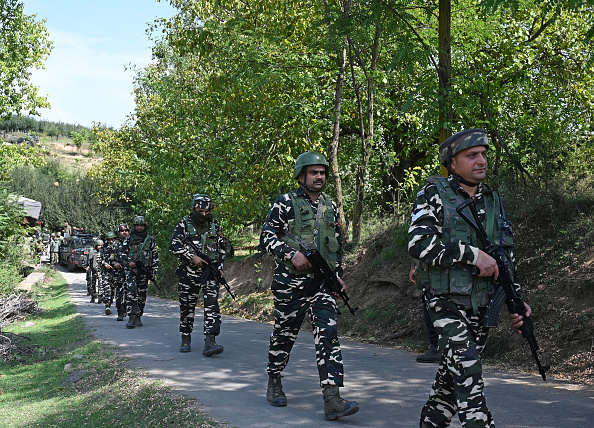
- 27 Sep 2024
In News:
The Armed Forces (Special Powers) Act (AFSPA) is a controversial law that grants extraordinary powers to the armed forces in designated "disturbed areas." Recently, the Ministry of Home Affairs extended AFSPA for six months in parts of Nagaland and Arunachal Pradesh, highlighting ongoing security concerns in these regions.
Current Status of AFSPA
Extended Areas
- Nagaland: AFSPA has been extended to eight districts—Dimapur, Niuland, Chumoukedima, Mon, Kiphire, Noklak, Phek, and Peren—along with 21 police stations in additional districts.
- Arunachal Pradesh: The Act continues in Tirap, Changlang, and Longding districts, as well as in certain areas of Namsai district.
Duration of Extension
The current extension is effective from October 1, 2024, lasting for six months unless revoked earlier. These areas were initially declared "disturbed" on April 1, 2024.
About AFSPA
Objective
AFSPA aims to maintain law and order in regions affected by insurgency or unrest, providing armed forces with necessary powers to perform their duties.
Key Provisions
- Section 3: Empowers the Governor or the Central Government to declare areas as "disturbed."
- Section 4: Grants special powers for arrests and searches without warrants.
- Section 6: Mandates that arrested individuals and seized property be handed over to the police.
- Section 7: Prosecution of armed forces personnel requires prior approval from the Central Government.
Rationale for Implementation
- To enable effective counter-insurgency operations.
- To ensure the protection of armed forces members.
- To uphold national security and sovereignty.
Criticisms and Issues
AFSPA has faced significant backlash for:
- Violating Fundamental Rights: Critics argue it undermines Articles 14, 19, and 21 of the Constitution.
- International Law Conflicts: It is perceived as contrary to the Universal Declaration of Human Rights and the International Covenant on Civil and Political Rights.
- Erosion of State Autonomy: The Act is viewed as an infringement on state powers, even in peaceful contexts.
Ineffectiveness and Atrocities
Reports of human rights abuses and the ineffectiveness of AFSPA in genuinely countering insurgency raise questions about its continued application.
Government's Position
Union Home Minister Amit Shah has noted that AFSPA has been lifted from 70% of the northeastern states, but it remains in force in certain areas, including Jammu and Kashmir, where revocation is also being considered.
Jeevan Reddy Committee
On November 19, 2004, the Central Government established a five-member committee led by Justice B.P. Jeevan Reddy to assess the Armed Forces (Special Powers) Act (AFSPA) in northeastern states. The committee was tasked with reviewing the law's implications and effectiveness.
Key Findings
In its 2005 report, the Jeevan Reddy Committee made several critical observations and recommendations:
- Complete Repeal: The committee advocated for the complete repeal of AFSPA, labeling it a "symbol of hate and oppression" and describing it as an "instrument of high-handedness."
- Incorporation into Other Legislation: It suggested that relevant provisions of AFSPA be integrated into the Unlawful Activities (Prevention) Act, 1967, with necessary modifications to delineate the powers of armed and paramilitary forces.
- Establishment of Grievance Cells: The committee recommended the creation of grievance cells in each district where armed forces are deployed, aimed at addressing public complaints and concerns regarding military actions.
Additional Recommendations
- The 5th report of the Second Administrative Reforms Commission also echoed the call for repealing AFSPA, reinforcing the need for legislative reform in addressing security issues.
- In 2016, the Supreme Court ruled that the armed forces cannot evade investigation for alleged excesses committed during their duties, even in "disturbed areas." This ruling clarified that the legal protections offered by AFSPA are not absolute, emphasizing accountability.
Conclusion
AFSPA remains a contentious issue with significant implications for civil rights, regional stability, and national security. A careful review and possible reform of the Act are essential to balance security needs with the protection of fundamental rights.
INDIA'S STRATEGIC PUSH FOR A DOMESTIC SEMICONDUCTOR ECOSYSTEM
- 24 Sep 2024
Introduction
India is actively pursuing the establishment of a domestic semiconductor ecosystem to lessen dependence on imports and tackle global supply chain vulnerabilities. This initiative, launched under the Semiconductor Mission in 2021 with a USD 10 billion investment, is vital for national security, particularly in defense and telecommunications.
Current Status of the Semiconductor Industry in India
Market Overview
- 2022 Market Size: USD 26.3 billion
- Projected Growth: Expected to reach USD 271.9 billion by 2032, with a CAGR of 26.3%.
Import-Export Dynamics
- Imports: USD 5.36 billion in 2021; efforts are underway to reduce this reliance.
- Exports: USD 0.52 billion in 2022, marking the highest level to date.
Government Initiatives
- India Semiconductor Mission (ISM): Part of the Digital India Corporation, focused on developing a strong semiconductor ecosystem.
- Financial Support: Covers 50% of project costs for semiconductor and display manufacturing facilities.
- Semicon India Programme: Launched in December 2021 with ?76,000 crore (around USD 9.2 billion) dedicated to semiconductor manufacturing.
- FY24 Budget Increase: Allocated ?6,903 crore (approximately USD 833.7 million) for further development.
International Collaborations
- MoU with the European Commission: Aims to enhance semiconductor ecosystems.
- MoC with Japan: Focused on improving supply chain resilience in the semiconductor sector.
Importance of Semiconductors for India
Economic Growth and Industrial Development
- Semiconductors are crucial for enhancing India's electronics manufacturing, targeting a notable share of the projected USD 1 trillion global semiconductor market by 2030.
- The Semiconductor Mission is projected to generate 35,000 direct jobs and 100,000 indirect jobs, potentially raising electronics manufacturing to USD 300 billion by 2026.
National Security and Strategic Autonomy
- Essential for defense and telecommunications, semiconductors ensure reliable supplies for critical defense systems and secure communication networks.
Technological Self-Reliance and Innovation
- With around 65-70% of electronic components currently imported, primarily from China, initiatives aim to foster domestic innovation and reduce this reliance.
Global Supply Chain Integration
- The objective is to position India as a key player in the global electronics supply chain, increasing its current 3% share of the global electronics manufacturing value.
Job Creation and Skill Development
- The semiconductor industry is anticipated to drive job creation and skill development, enhancing STEM education and research in advanced technologies.
Challenges Facing India's Semiconductor Aspirations
Infrastructure Issues
- India faces significant infrastructure challenges, including unreliable power supply and water shortages that impact semiconductor production.
Talent Shortage
- There is a projected need for 250,000 to 300,000 skilled professionals in semiconductor fields by 2027.
High Manufacturing Costs
- Semiconductor manufacturing is capital-intensive, and operational costs in India are generally higher compared to established hubs like Taiwan and South Korea.
Global Supply Chain Vulnerabilities
- Global supply chain disruptions, exacerbated by events such as the Russia-Ukraine conflict, present risks to India's semiconductor goals.
Environmental Challenges
- The energy-intensive nature of semiconductor manufacturing raises concerns about its environmental impact, particularly regarding greenhouse gas emissions.
Competition from Other Emerging Markets
- India faces competition from countries like Vietnam and Malaysia, which are successfully attracting semiconductor investments with favorable conditions and incentives.
Strategies for Advancing India's Semiconductor Vision
Enhance Education and Training
- Expand semiconductor engineering programs and collaborate with global companies to develop relevant curricula and hands-on training.
Develop Domestic Chip Design Capabilities
- Invest in chip design by establishing dedicated centers in technology hubs to encourage innovation.
Build a Comprehensive Supply Chain
- Create a robust domestic supply chain by attracting investments across all segments, from raw materials to advanced packaging.
Establish a Sovereign Semiconductor Fund
- Launch a dedicated fund for semiconductor projects to provide long-term investment and reduce reliance on foreign funding.
Implement a "Chip Diplomacy" Approach
- Use India's geopolitical position to negotiate technology transfers and partnerships with leading semiconductor nations.
Launch a "Green Semiconductor" Initiative
- Aim to become a leader in sustainable semiconductor manufacturing by minimizing environmental impacts.
Create a National Semiconductor Commons
- Establish shared infrastructure for research and prototyping to lower barriers for startups and promote innovation.
Conclusion
To fulfill its semiconductor aspirations, India must enhance education and training, develop a strong supply chain, and foster strategic collaborations. By addressing infrastructure challenges and skill gaps while promoting sustainable practices, India can secure its position as a significant player in the global semiconductor industry and strive for technological self-reliance.
INDUS WATERS: INDIA FREEZES TALKS WITH PAKISTAN
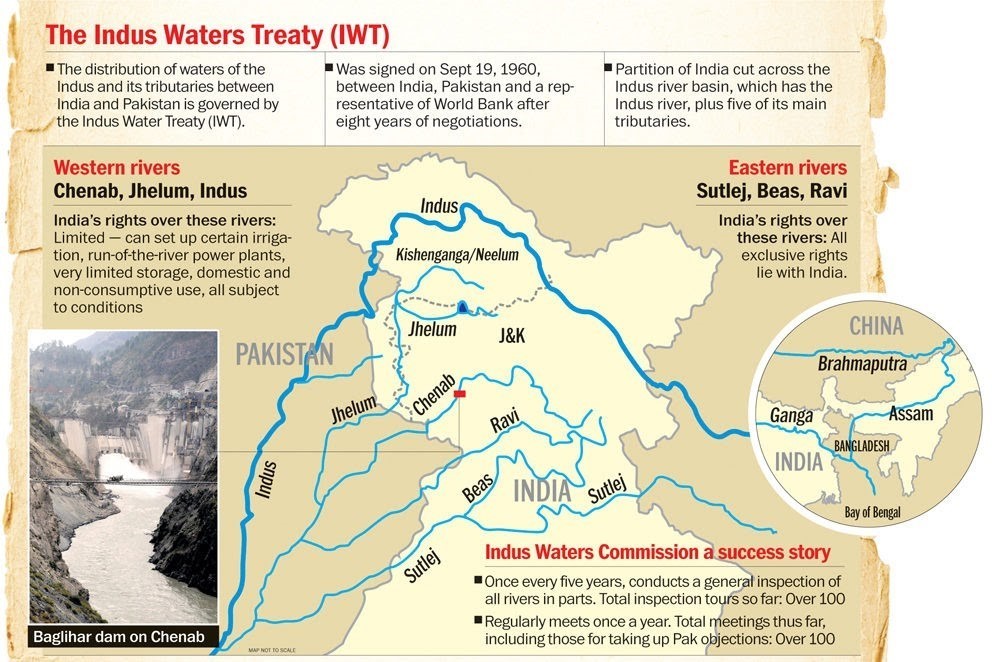
- 20 Sep 2024
In News:
India has decided to halt all meetings of the Permanent Indus Commission (PIC) until both governments engage in discussions to renegotiate the Indus Waters Treaty (IWT), a decision communicated by a senior official. The last PIC meeting occurred in May 2022, and since January 2023, India has made four attempts to initiate talks with Pakistan, but these efforts have not received satisfactory responses.
The IWT, established in 1960 with the mediation of the World Bank, governs the sharing of six rivers between India and Pakistan. Under this treaty, India controls the waters of the Ravi, Sutlej, and Beas rivers, while Pakistan has rights to the Sindh, Jhelum, and Chenab rivers. The treaty mandates annual meetings of the PIC, which have continued despite ongoing conflicts between the two nations. However, India’s recent push for renegotiation threatens the stability of this long-standing arrangement.
India's Notice for Review of the Indus Waters Treaty
India formally issued a notice to Pakistan on August 30, 2023, seeking modifications to the IWT, citing "fundamental and unforeseen changes" that necessitate a reassessment of the agreement. This is not an isolated instance; India had previously requested a review in January 2023, attributing the need for change to Pakistan’s persistent intransigence regarding its obligations under the treaty.
Key reasons for India’s demand include:
- Changes in population demographics and environmental challenges.
- The necessity for clean energy development to meet emissions targets.
- The impact of ongoing cross-border terrorism, which India argues affects water management and security.
The notification highlights issues related to two contentious hydroelectric projects in Jammu & Kashmir—the Kishanganga and Ratle projects—over which Pakistan has raised objections, claiming they violate the IWT. India asserts that these projects are "run-of-the-river" schemes that do not significantly impede river flow.
Dispute Resolution Mechanisms Under the Treaty
The IWT outlines a structured dispute resolution mechanism, as detailed in Article IX. This mechanism involves three levels:
- First Level: Initial discussions occur at the PIC, where either party must inform the other of planned projects.
- Second Level: If differences remain unresolved, a Neutral Expert, appointed by the World Bank, is engaged to mediate.
- Third Level: Should the Neutral Expert fail to resolve the issue, the dispute escalates to the Court of Arbitration.
Historically, both countries have used these mechanisms, although recent years have seen significant contention. After a Pakistan-backed terror attack in Uri in 2016, India’s Prime Minister expressed the sentiment that “blood and water cannot flow together,” leading to the suspension of routine talks.
The World Bank has navigated a complex situation, receiving requests from both nations for adjudication on overlapping disputes. In December 2016, it paused these processes to encourage direct negotiations. Despite attempts to resume dialogue between 2017 and 2022, Pakistan’s reluctance to engage has further complicated matters.
Current Status and Future Implications
India’s formal notification and its call for renegotiation may set a precedent that challenges the existing framework of the IWT. The continuation of the PIC's activities hinges on a willingness from both governments to address these evolving concerns collaboratively. As tensions persist and environmental needs grow, the future of water-sharing arrangements in the region remains uncertain. The overarching goal for both nations will be to find a sustainable resolution that addresses emerging challenges while honoring the historical framework established by the IWT.
Can Sheikh Hasina be Extradited?
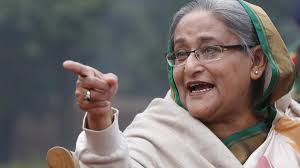
- 19 Sep 2024
In News:
The chief prosecutor of Bangladesh’s International Crimes Tribunal (ICT), Mohammad Tajul Islam, announced plans to seek the extradition of former Prime Minister Sheikh Hasina from India. The ICT was established in 2010 to investigate crimes committed during the 1971 independence war from Pakistan.
Background on Sheikh Hasina's Exile
Ms. Hasina sought refuge in India in early August after a mass uprising forced her to resign. Following her departure, numerous criminal cases have been filed against her and her aides, with charges including murder, torture, abduction, crimes against humanity, and genocide. The interim government in Dhaka has revoked her diplomatic passport, and the existing bilateral extradition treaty between India and Bangladesh may allow for her return to face trial.
Extradition Treaty Overview
Key Provisions
- Under the International Crimes (Tribunals) Act of 1973, Bangladeshi courts can proceed with trials in Ms. Hasina’s absence, raising concerns about the fairness and adherence to due process. Thus, her extradition is deemed crucial.
- The extradition treaty between India and Bangladesh was executed in 2013 and amended in 2016 to facilitate the exchange of fugitives. The treaty has allowed the transfer of several political prisoners, including two involved in the 1975 assassination of Sheikh Mujibur Rahman, Ms. Hasina’s father, and Anup Chetia, the former general secretary of the banned United Liberation Front of Assam (ULFA).
Extradition Conditions
- The treaty mandates the extradition of individuals charged with crimes punishable by at least one year’s imprisonment. It follows the principle of dual criminality, meaning the offense must be punishable in both countries. Since the charges against Ms. Hasina are prosecutable in India, she qualifies for extradition. The treaty also covers attempts to commit crimes and complicity in such offenses.
- The 2016 amendment significantly lowered the evidentiary threshold for extradition, requiring only an arrest warrant from a competent court in the requesting country to initiate proceedings.
Grounds for Refusal of Extradition
Political Nature of Offenses
Article 6 of the treaty allows for extradition to be refused if the offense is deemed of a “political nature.” However, many offenses, including murder and terrorism-related crimes, are explicitly excluded from this classification. Given that several charges against Ms. Hasina fall outside this exemption, it is unlikely India could justify denying extradition on these grounds.
Good Faith Clause
Article 8 permits denial of extradition requests if the accusations are not made in good faith or involve military offenses not recognized under general criminal law. India could argue that the charges against Ms. Hasina are politically motivated and may lead to her facing unfair trials or persecution upon her return. Recent reports indicate that some of Ms. Hasina’s former ministers faced violent arrests, raising further concerns about the political climate in Bangladesh.
Potential Implications of Extradition Request
Dr. Sreeradha Datta, a professor of international relations at O.P. Jindal Global University, commented that the treaty does not guarantee Ms. Hasina’s extradition, emphasizing that the final decision will depend on diplomatic negotiations and political factors. Even if India declines the request, it may only serve as a minor political irritant rather than significantly damaging bilateral relations.
Economic Considerations
Bangladesh is India’s largest trade partner in South Asia, with bilateral trade estimated at $15.9 billion for the fiscal year 2022-23. Before Ms. Hasina’s ouster, both countries were set to discuss a comprehensive economic partnership agreement (CEPA) to strengthen economic ties. Following the regime change in Dhaka, Indian Prime Minister Narendra Modi has engaged with Chief Adviser Muhammad Yunus of the interim government, pledging continued support for ongoing development projects.
How do emergency provisions impact Centre-State relations?
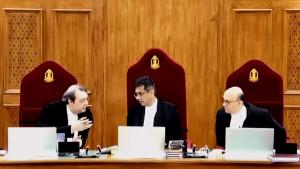
- 17 Sep 2024
In News:
The recent spate of renewed violence in Manipur has once again triggered the discussion around Centre-State relations and the use of emergency provisions by the Centre.
What is our federal set-up?
India is a federation with governments at the Centre and the States. The Seventh Schedule to the Indian Constitution distributes the power between the Union and States. Under this scheme, it is the domain of the State governments to maintain law and order in their respective States.
What are emergency provisions?
The emergency provisions are provided in Part XVIII of the Constitution. Articles 355 and 356 deal primarily with the affairs of government in a State under this part.
Article 355 imposes a duty on the Centre to protect every State from external aggression and internal disturbance. It also specifies that the Centre should ensure that every State government operate according to the Constitution.
Article 356 allows for the imposition of the President’s rule if a State’s government cannot function in accordance with constitutional provisions. While in the U.S. and Australia, federal government functions also involve protecting States, their constitutions do not contain provisions for removing State governments.
B.R. Ambedkar explained the purpose of Article 355, keeping in mind the federal character of our polity, that if the Centre is to interfere in the State’s administration under Article 356, it must be by or under some obligation which the Constitution imposes on the Centre. Hence, Article 355 was incorporated to check any arbitrary or unauthorised use of Article 356.
What have the courts ruled?
Dr. Ambedkar again in the constituent Assembly wished that Articles 355 and 356 would never be called into operation and would remain a dead letter. However, it was a travesty of the Constitutional principles and federalism that Article 356 was misused on several occasions removing elected governments that enjoyed majority in the States. Reasons varied from loss in Lok Sabha elections to deterioration of law and order in the States. It was only after the Supreme Court’s categorical judgement in the S R Bommai case (1994) that such misuse was restricted. The court held that Article 356 should be imposed only in the event of a breakdown of constitutional machinery, as distinguished from an ordinary breakdown of law and order. It also held that the imposition of the President’s rule is subject to judicial review and should not be misused for political reasons.
On the other hand, the scope of Article 355 has been widened by various Supreme Court rulings. In State of Rajasthan Vs Union of India (1977), the court had a narrow interpretation of Article 355 as justifying the employment of Article 356. However, in subsequent cases such as Naga People’s Movement of Human Rights Vs Union of India (1998), Sarbananda Sonowal Vs Union of India (2005), and H.S.Jain Vs Union of India (1997), the legal position with respect to Article 355 has shifted. The scope of actions under this article has been widened to permit all statutorily and constitutionally available actions by the Union to discharge its duties of protecting the State and ensuring that its governance is in accordance with the Constitution.
What are the suggestions?
The Sarkaria Commission on Centre-State Relations (1987), the National Commission to Review the Working of the Constitution (2002), and the Punchhi Commission on Centre-State Relations (2010) have all opined that Article 355 not only imposes a duty on the Union but also grants it the power to take necessary actions for the effective performance of that duty. Imposition of the President’s rule under Article 356 must be used as a last resort in situations of utmost gravity and urgency.
The situation in Manipur is grave. Large-scale violence against innocent civilians, women and children; looting of ammunition from police armoury; drone and missile attacks targeting civilians cannot be viewed as just an ordinary breakdown of law and order. Constitutional as well as political expediency, considering that the same party is in power at the Centre and the State, has resulted in Article 356 not being invoked. However, under Article 355, all possible instructions and actions should continue to be pursued to restore normalcy at the earliest.
The Shock of Crumbling Infrastructure and the Path Forward
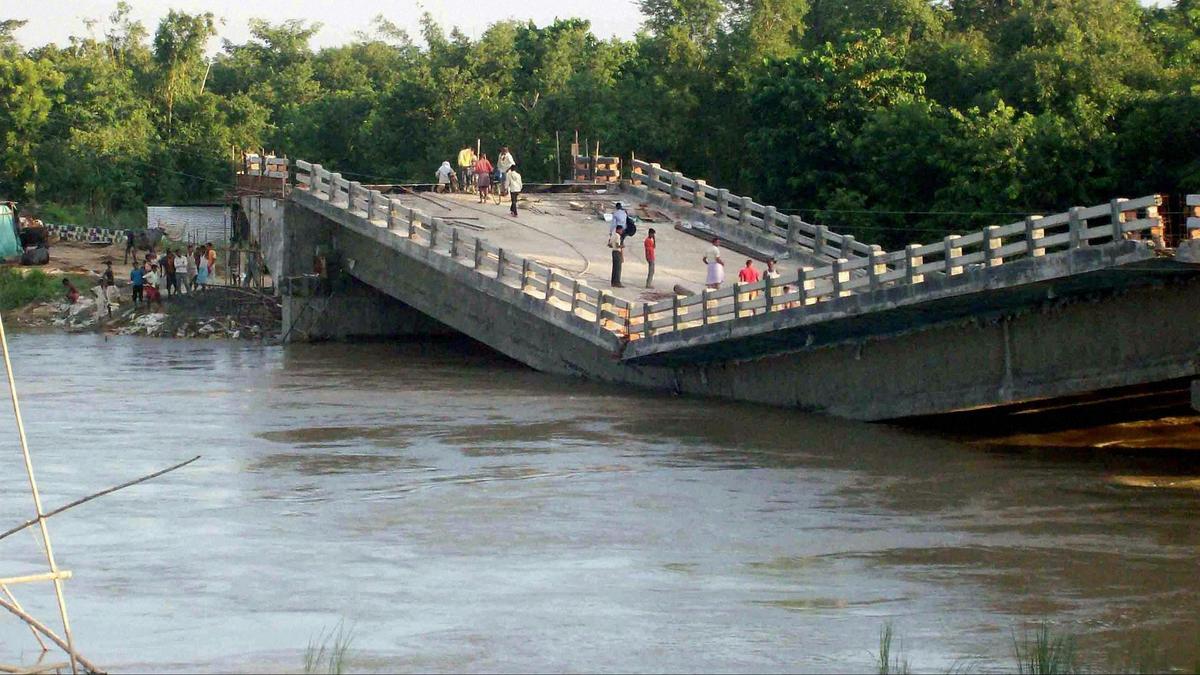
- 15 Sep 2024
Infrastructure is a cornerstone of economic development, and in a rapidly growing economy like India’s, its robustness is vital. Recent incidents, particularly the collapse of several under-construction bridges in Bihar, have cast a spotlight on significant issues within the Indian infrastructure sector, particularly in terms of quality control and project management. With the country's aim to become a developed nation by 2047, addressing these challenges is crucial for sustaining economic growth and ensuring safety.
Current Challenges
- Cost Overruns and Delays: One of the most pressing issues is the frequent occurrence of cost overruns and delays. According to a report by the Ministry of Statistics and Programme Implementation, 431 infrastructure projects with investments exceeding ?150 crore each have faced cost overruns totaling ?4.82 lakh crore as of December 2023. Additionally, a significant percentage of projects are delayed, with 36% running behind schedule by 25 to 60 months and 15% delayed for over 60 months.
- Bureaucratic Hurdles: Infrastructure projects often face delays due to the complex maze of clearances required. The implementation status of many projects indicates a lack of comprehensive planning and coordination, especially in urban infrastructure projects managed by local bodies that may lack sufficient capacity and expertise.
- Project Management Deficiencies: Traditional project management practices in India are often outdated. There is a need for an overhaul to incorporate modern tools and techniques for real-time data management and analysis. Insufficient attention during the planning stages of projects exacerbates these issues, leading to increased costs and project failures.
Path Forward
1. Integrating Modern Practices: Adopting modern project management practices is essential. This includes real-time data management, use of advanced analytics, and adopting global best standards. For example, in the United Kingdom, the Infrastructure and Projects Authority focuses on refining project processes, while countries like China and Saudi Arabia have established agencies dedicated to end-to-end project delivery.
2. PM Gati Shakti National Master Plan: India has initiated the PM Gati Shakti National Master Plan, aimed at integrating various government departments and stakeholders into a unified platform. This GIS-based ERP portal is designed to monitor real-time progress and enhance coordination among departments. While this initiative is promising, the effectiveness will depend on the quality of implementation and oversight.
3. Holistic Program Management Approach: The “Program Management Approach” used in industrial corridor development projects, like the Shendra-Bidkin in Aurangabad, exemplifies effective management of multiple projects simultaneously. This disciplined approach, involving systematic coordination of resources and information, can be applied more broadly across infrastructure projects.
4. Professional Training and Certification: To build a capable workforce, there is a need to establish agencies for professional training in project management. Similar to the Institute of Chartered Accountants of India, such agencies can focus on developing professional ethics and responsibilities in project execution and oversight.
Conclusion
With substantial taxpayer money allocated for infrastructure development, it is imperative to prevent the pitfalls of cost overruns and project failures. A robust program management system, incorporating modern practices and professional training, will enhance the efficiency and effectiveness of infrastructure projects. This approach will not only support India’s high-growth trajectory but also contribute to creating a safer, more affluent future for its citizens.
The Path to Universal Health Coverage: Embracing Data and Digital Technology
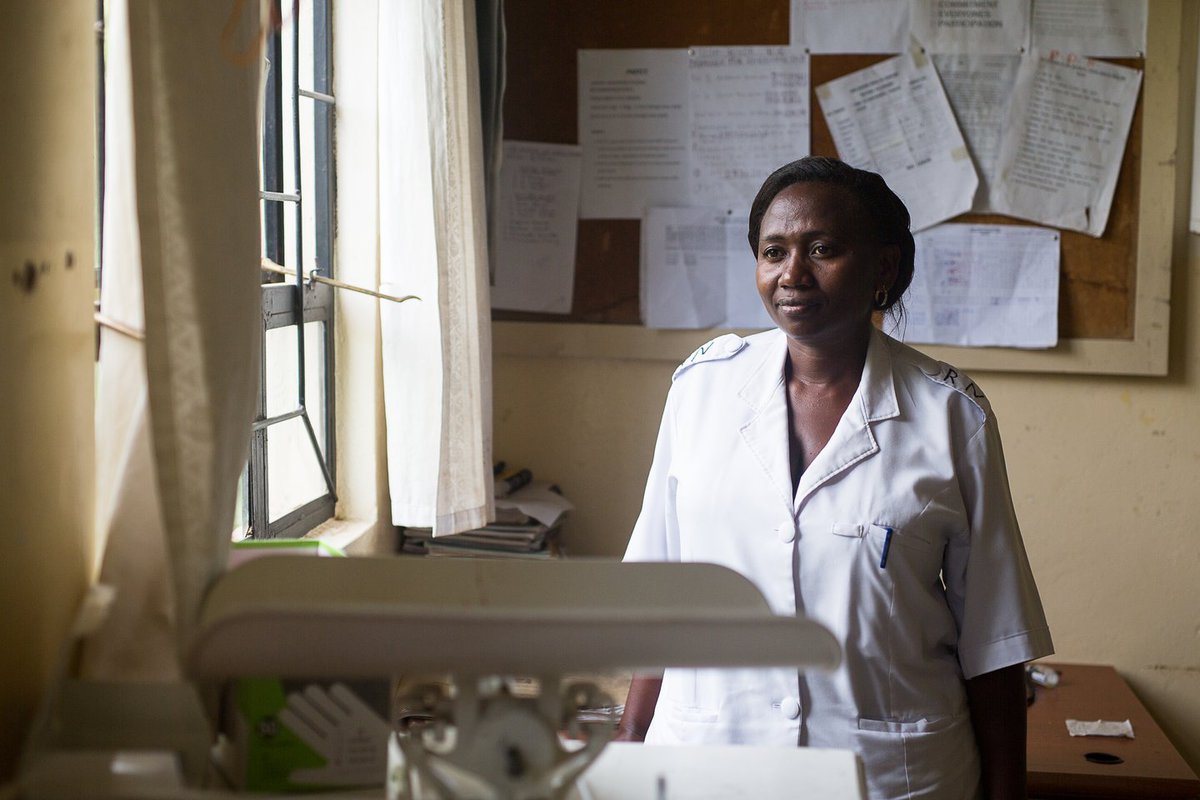
- 13 Sep 2024
The expansion of Universal Health Coverage (UHC) represents a complex but crucial endeavor. The integration of data and digital technology stands out as a pivotal factor in smoothing the way towards achieving this goal.
Understanding Universal Health Coverage
Universal Health Coverage means ensuring that every individual has access to the full spectrum of quality health services when and where they need them, without facing financial hardship. This concept encompasses a broad range of essential health services, including health promotion, prevention, treatment, rehabilitation, and palliative care throughout an individual's life.
UHC as a Sustainable Development Goal
Achieving UHC is a key target of the Sustainable Development Goals (SDGs) established by the global community in 2015. However, despite this commitment, progress towards this goal remains off-track. Since 2015, improvements in health services coverage have stalled, and the proportion of people facing catastrophic out-of-pocket health expenses has been rising steadily since 2000.
Challenges to Universal Health Coverage
Several challenges hinder the advancement of UHC:
- Global Stagnation: Progress in health coverage has stagnated globally, affecting regions and countries alike.
- Manpower Shortages: Many Western and Central Asian countries face severe healthcare manpower shortages.
- Pandemic Disruptions: The COVID-19 pandemic has further disrupted essential health services, with 92% of countries experiencing interruptions at the pandemic's peak in 2021, and 84% still reporting disruptions in 2022.
- Inequality in Healthcare Spending: The disparity between poor and non-poor households has widened, with lower-income families often forced to deplete their resources or sell assets to cover healthcare costs. According to the WHO, 55 million people fall into poverty annually due to catastrophic health expenditures.
- Insufficient Spending: India’s healthcare spending, currently at 3.2% of its GDP, is lower than the average spending of 5.2% observed in lower and middle-income countries (LMICs). The government’s health expenditure is also lower compared to other countries like China, Thailand, Vietnam, and Sri Lanka.
Opportunities Through Digital Health
To address these challenges, leveraging digital health solutions is critical. India's leadership in digital health is exemplified by the Global Initiative on Digital Health, launched under India’s G20 presidency. This initiative aims to drive investments into digital health and facilitate regional and international collaboration.
India’s Ayushman Bharat Digital Mission, which precedes this global initiative, highlights the country's commitment to using digital technology to manage the complexities of UHC expansion. Digital health tools can play a transformative role in managing contracts, implementing value-based provider reimbursements, and streamlining healthcare delivery.
The Role of Artificial Intelligence
Artificial Intelligence (AI) holds significant promise for revolutionizing healthcare. AI-powered diagnostic tools can improve the accuracy and speed of medical diagnoses, leading to better patient outcomes. AI can also predict disease outbreaks, analyze healthcare data, optimize treatment plans, and enhance drug discovery, making healthcare more personalized and effective.
Building Digital Infrastructure
India’s experience in expanding digital health infrastructure can serve as a model for other low- and middle-income countries. Many of these nations are seeking to build and enhance their healthcare systems, and India’s approach may offer valuable policy insights.
The Need for Private Sector Participation
Achieving UHC in India cannot rely solely on the public sector. Integrating the private sector into the public healthcare framework is essential. Addressing modern health challenges requires a collaborative effort that includes both public and private sectors, creating a multifaceted and synergistic approach to healthcare.
WHO’s Recommendations
To strengthen health systems, the WHO recommends reorienting them with a primary health care (PHC) approach. Implementing PHC can deliver up to 90% of essential UHC interventions, potentially saving 60 million lives and increasing global life expectancy by 3.7 years by 2030.
Looking Ahead
It is crucial to balance national interests with international ambitions and leverage digital technologies to create inclusive solutions. Countries should build on their existing systems, gradually implementing reforms and best practices. With dedicated effort and a commitment to excellence, it is possible to build a healthier and more prosperous future for generations to come.
Port Blair renamed as Sri Vijaya Puram
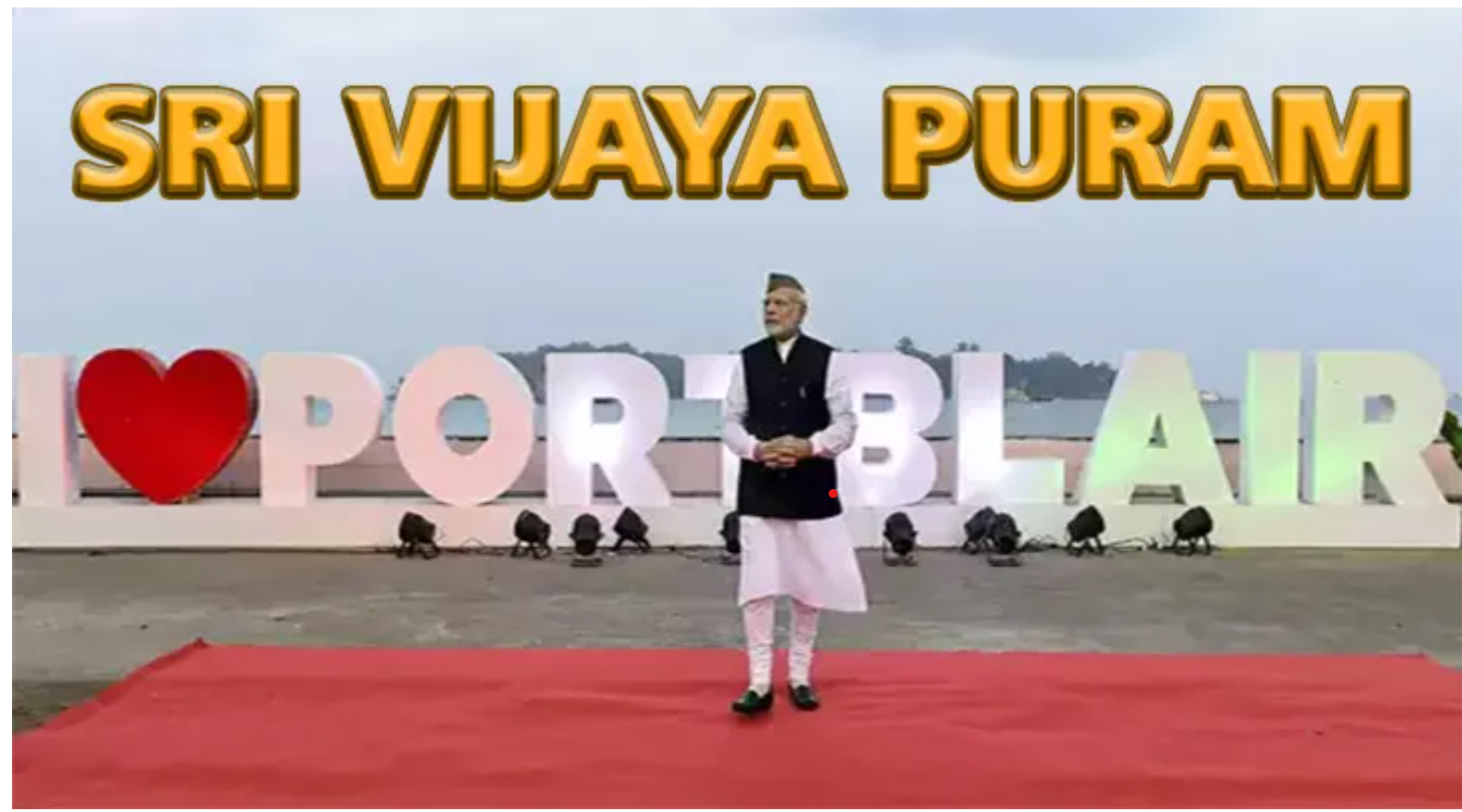
- 14 Sep 2024
Port Blair to be Renamed Sri Vijaya Puram: A Move to Erase Colonial Echoes
Union Home Minister Amit Shah announced on Friday that Port Blair, the capital city of the Andaman and Nicobar Islands, will be renamed Sri Vijaya Puram. This decision is part of a broader effort to “free the nation from colonial imprints,” Shah explained. In a post on X, he emphasized that while the current name carries colonial connotations, the new name, Sri Vijaya Puram, represents the triumph of India's freedom struggle and acknowledges the Andaman & Nicobar Islands’ pivotal role in that struggle.
Shah further highlighted the strategic importance of the islands, which historically served as a naval base for the Chola Empire and are now envisioned as a key element in India’s strategic and developmental plans. Port Blair, named after British naval surveyor Archibald Blair, will henceforth be known as Sri Vijaya Puram, aligning with Prime Minister Narendra Modi’s vision to remove colonial legacies.
The Origin of Port Blair’s Name
Port Blair, the gateway to the Andaman and Nicobar Islands, was named after Archibald Blair, a lieutenant in the Bombay Marine. Blair conducted a thorough survey of the islands after joining the Bombay Marine in 1771. His expedition, which began in December 1778, was crucial in mapping the Andaman Islands. Initially, Blair named the natural harbor Port Cornwallis, in honor of Commodore William Cornwallis. Later, the harbor was renamed Port Blair.
Blair’s survey was highly valued by the East India Company (EIC), leading to the islands’ colonization. The primary motivation was to create a secure harbor to monitor Malay pirates and provide refuge for shipwrecked individuals. Over time, the islands were established as a penal colony, receiving numerous convicts who performed forced labor.
In 1792, the EIC relocated the colony to Port Cornwallis, but it was soon abandoned due to disease and high mortality rates. The Revolt of 1857 brought an influx of prisoners, leading to the reestablishment of Port Blair as a penal colony. The harsh conditions led to numerous deaths, and the area became notorious for its brutal treatment of prisoners, including freedom fighters like Veer Damodar Savarkar. The infamous Cellular Jail, or Kaala Paani, was built by 1906 to house political prisoners.
Historical Significance of the Andaman Islands
Historical records indicate that the Andaman Islands were strategically significant during the 11th century, particularly for the Chola Empire under Emperor Rajendra I. The islands were used as a naval base in the Chola campaign against Srivijaya, a kingdom in present-day Indonesia. An inscription from Thanjavur dating to 1050 CE refers to the islands as Ma-Nakkavaram land, which may have influenced the modern name Nicobar.
Historian Herman Kulke, in his book "Nagapattinam to Suvarnadwipa," describes the Chola invasion of Srivijaya as a notable event, reflecting the complex interactions between India and Southeast Asia. Various scholars offer differing interpretations of the invasion, ranging from a response to trade disruptions to an extension of Chola expansionism.
In summary, the renaming of Port Blair to Sri Vijaya Puram represents a significant shift in recognizing the historical and strategic importance of the Andaman and Nicobar Islands, aligning with India's broader goals of addressing colonial legacies and honoring its rich history.
India’s Approach to the Russia-Ukraine Conflict and Economic Ties
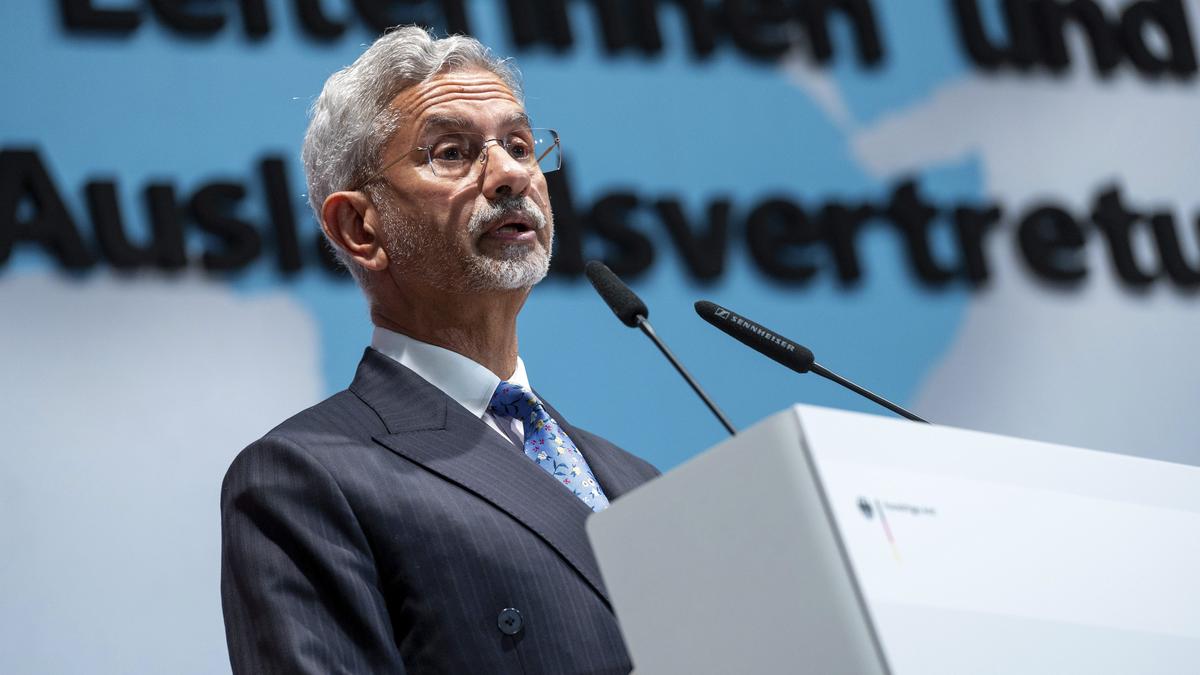
- 11 Sep 2024
India’s Four-Point Principle on the Russia-Ukraine Conflict
- Principles for Resolution: External Affairs Minister S. Jaishankar outlined India's four key principles regarding the Russia-Ukraine conflict:
- Peace as a Priority: Emphasis on the need for peace and the belief that the conflict cannot be resolved through continued warfare.
- Negotiation Requirement: Asserted that any resolution must involve Russia in the dialogue process.
- No Battlefield Solutions: Stressed that solutions cannot be achieved on the battlefield.
- Active Engagement: India is actively engaged and concerned about finding a resolution, with ongoing discussions with both Russia and Ukraine.
- Hosting Peace Conference: Jaishankar noted that while suggestions for India to host a peace conference have been made, there is no commitment from India to propose or host such a conference.
- Recent Diplomacy: Referenced Prime Minister Narendra Modi’s visits to Moscow and Kyiv and highlighted National Security Adviser Ajit Doval's current visit to Russia.
Diplomatic Discussions with Germany
- Bilateral Meeting: Jaishankar met with German Foreign Minister Annalena Baerbock in Berlin to prepare for German Chancellor Olaf Scholz’s visit to New Delhi on October 24-25.
- Topics of Discussion:
- Global Issues: Discussed the Russia-Ukraine conflict, the Gaza conflict, and coordination for the UN Summit of the Future.
- UN Security Council Expansion: India and Germany are jointly advocating for the expansion of the UN Security Council.
- Ongoing Engagement: Both ministers will reconvene later this month at the UN General Assembly.
India-Germany Relations
- Germany’s Role: Baerbock acknowledged ongoing discussions with India and other countries about their roles in peace efforts, despite differing positions on the Russia-Ukraine conflict.
- Economic and Trade Relations:
- Migration and Mobility: Plans to enhance the India-Germany migration and mobility partnership, aiming to increase the number of skilled Indian workers in Germany. Currently, 125,000 Indian nationals work and 50,000 students study in Germany.
- Military Cooperation: Discussed expanding military partnerships, including joint air force exercises and upcoming naval exercises in Goa.
- Trade and Investment: Efforts to boost annual bilateral trade to $30 billion and attract about $25 billion in investment from Germany. New Delhi will host the Asia Pacific Conference of German Business next month.
Economic Ties with China
- Business Relations: Jaishankar addressed concerns about economic ties with China amidst a four-year military stand-off and related restrictions.
- Business Sectors: India is open to Chinese business but emphasizes the need for clarity on sectors and business terms.
Summary
India’s approach to the Russia-Ukraine conflict emphasizes peace, negotiation, and active engagement. Diplomatic efforts with Germany focus on global issues, military cooperation, and economic growth. Jaishankar also highlighted a nuanced stance on economic ties with China amid ongoing tensions.
The role of district agro-met offices in supporting farmers
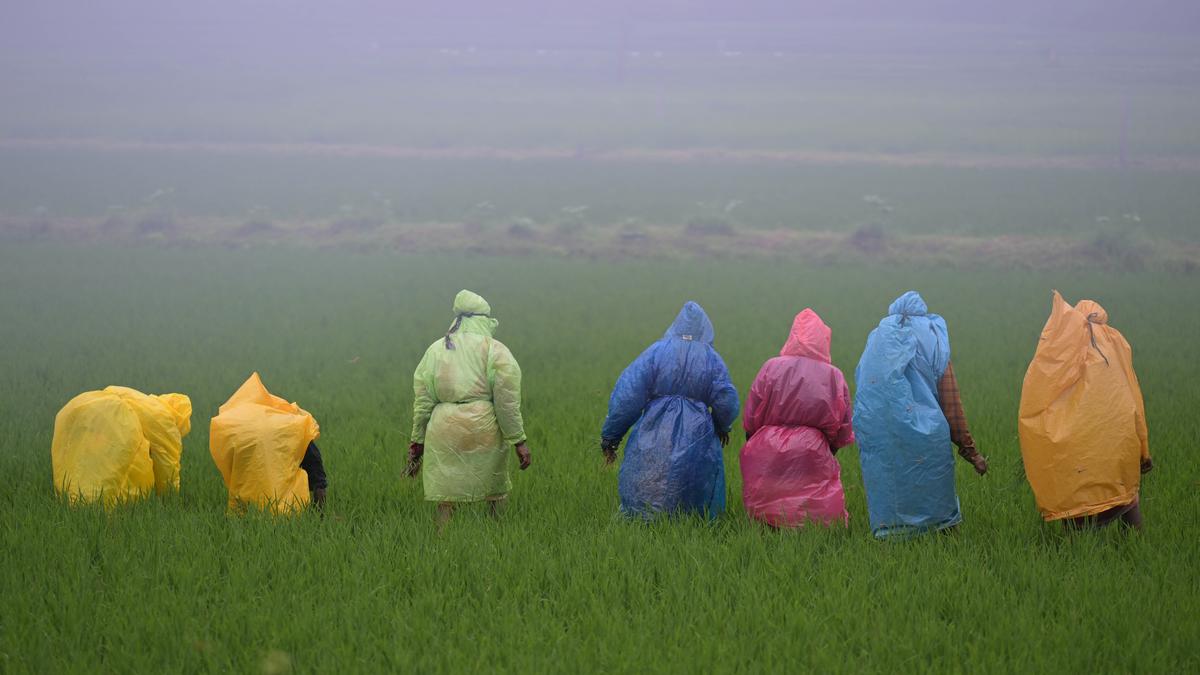
- 10 Sep 2024
In News:
- Last week, PTI reported that the India Meteorological Department (IMD) is planning to revive District Agro-Meteorology Units (DAMUs) under the Gramin Krishi Mausam Sewa (GKMS) scheme.
Background:
- The IMD established 199 DAMUs in 2018 in collaboration with the Indian Council of Agricultural Research.
- The aim was to use weather data to prepare and disseminate sub-district level agricultural advisories. In March, DAMUs were shut down following an order issued by the IMD.
Why are agro-met units important?
- Around 80% of farmers in India are small and marginal. They largely practise rain-fed agriculture in the backdrop of a decades-long farm crisis that is now overlaid with climate change-related weather variability.
- The DAMUs were located within Krishi Vigyan Kendras (KVKs). Scientists and researchers trained in meteorology and agriculture were recruited as DAMU staff. They used weather data provided by the IMD like rainfall, temperature and wind speeds to prepare agricultural advisories related to sowing and harvesting, usage of fertilizers and pesticides, irrigation etc.
- These advisories were sent to millions of farmers across the country free-of-cost in local languages twice a week. They were shared via text messages, WhatsApp groups, newspapers and also through in-person communication from DAMU staff and KVK officers.
- Since these advisories provided weather information in advance, they helped farmers plan activities like irrigation. They also served as early warnings for extreme events like droughts and heavy rainfall. Many studies conducted over the years have stressed the benefits of agro-met advisories.
Why were DAMUs shut down?
- According to an Article-14 report, the NITI Aayog misrepresented the role of District Agricultural Management Units (DAMUs) and advocated for their privatization. The report claims that NITI Aayog inaccurately stated that agro-met data was automated, thereby diminishing the role of DAMU staff. In reality, DAMU staff were crucial in creating agricultural advisories based on IMD weather data, which were disseminated to farmers in local languages. NITI Aayog also proposed monetizing these services, contrasting with the current free provision of agro-met information to all farmers.
- A policy brief from the National Institute of Advanced Studies (NIAS), Bangalore, released in August, highlights that localized and accessible advisories from District Agricultural Management Units (DAMUs) have significantly improved farmers' responses to climatic variations in the Kalyana-Karnataka region. This has led to increased yields and incomes. The brief recommends reconsidering the decision to discontinue DAMUs and suggests exploring ways to enhance their effectiveness and presence.
What about private players?
Currently, a few private companies offer weather advisories, but their services are often too costly for small and marginal farmers. Dr. M. N. Thimmegowda, a professor at the University of Agricultural Sciences noted that annual subscriptions can cost ?10,000 per crop, leading to expenses of ?20,000-40,000 for vegetable and cereal growers, and up to ?60,000-80,000 for specialized advisories. Additionally, there is concern that these companies may provide biased recommendations for fertilizers and pesticides, favoring certain brands.
Dispelling Population Myths Triggered by a Working Paper

- 30 May 2024
Why is it in the News?
The working paper released by the Economic Advisory Council (EAC) to the Prime Minister makes an erroneous assertion regarding the growth of the Muslim population.
Context:
- The discussion on India's religious demographics is frequently marred by sensationalism and misinterpretation, often driven by media and political narratives.
- A recent working paper by the Economic Advisory Council to the Prime Minister (EAC-PM), titled "Share of Religious Minorities: A Cross-Country Analysis (1950-2015)," has been a particular target of such distortions.
- Hence, it is crucial to critically examine the findings and interpretations of the EAC-PM's working paper, placing them within the broader socio-economic dynamics and demographic trends.
Composition of the Population of various communities highlighted by EAC:
- The population composition of various communities in the region has changed between 1950 and 2015, as highlighted by the data:
- In terms of absolute numbers, the Hindu population saw a substantial increase of 701 million individuals, while the Muslim population grew by 146 million.
- However, when looking at proportional changes, the Hindu population experienced a decrease of 6.64 percentage points, from 84.7% in 1950 to 78.06% in 2015.
- Conversely, the Muslim population's proportion increased by 4.25, rising from 9.84% in 1950 to 14.09% in 2015.
- Despite these shifts in proportions, the Hindu population remains numerically larger than the Muslim population as of 2015.
What does the 2011 census say?
According to the 2011 census, the following changes in the proportions of various religious communities were observed in comparison to the 2001 census:
- The Hindu population's proportion relative to the total population decreased by 0.7 percentage points.
- The Sikh population's proportion saw a decline of 0.2 percentage points.
- The Buddhist population's proportion decreased by 0.1 percentage points.
- On the other hand, the Muslim population's proportion relative to the total population increased by 0.8 percentage points.
- The proportions of the Christian and Jain communities underwent no significant change during the 2001-2011 period.
A Study on Socio-Economic Aspects and Population Growth in the Muslim Communities:
The Impact of Education:
- Education significantly influences fertility rates and overall population growth. Communities with higher educational attainment, particularly among women, generally exhibit lower fertility rates.
- Education equips individuals with knowledge about family planning, reproductive health, and the economic implications of large families.
- In India, disparities in educational attainment among different religious communities contribute to variations in population growth rates.
- Historically, the Muslim community has encountered barriers to accessing quality education, leading to higher fertility rates compared to the Hindu community.
- This indicates that the higher population growth rate among Muslims is due to limited educational opportunities rather than religious doctrine.
Economic Conditions:
- Economic stability plays a crucial role in determining family size and population growth.
- Economically stable families tend to have fewer children, enabling them to invest more resources in each child's health, education, and overall well-being.
- In contrast, economically disadvantaged communities often exhibit higher fertility rates as a response to economic insecurity, viewing children as contributors to household income.
- The higher growth rate of the Muslim population in India can be attributed to lower average income levels and limited access to economic opportunities within the community.
- Addressing economic disparities is essential for moderating population growth and enhancing overall human development.
Access to Healthcare:
- Healthcare access, especially reproductive health services, is a key determinant of fertility rates.
- Communities with better access to healthcare services, including contraception and maternal healthcare, typically have lower fertility rates.
- The Muslim community in India has historically faced challenges in accessing healthcare services, contributing to higher fertility rates.
- Improving healthcare access for all communities is vital for achieving balanced population growth and improving quality of life.
Cultural Factors and Gender Norms:
- Cultural factors and gender norms also influence fertility rates. Traditional norms valuing large families and early marriage can lead to higher fertility rates in some communities.
- Promoting gender equality and empowering women to make informed reproductive choices are crucial for moderating population growth.
- Programs aimed at changing cultural attitudes towards family size and encouraging later marriages can significantly impact reducing fertility rates.
Urbanization and Migration:
- Urbanization and migration patterns affect population growth, with urban areas generally exhibiting lower fertility rates than rural areas due to better access to education, healthcare, and economic opportunities.
- Migration from rural to urban areas can lead to a decline in fertility rates as individuals adapt to urban socio-economic conditions.
- In India, the Muslim population is more concentrated in rural areas, which tend to have higher fertility rates.
- Promoting urbanization and integrating rural communities into urban settings can contribute to balanced population growth.
Human Development Indicators:
- Human development indicators, such as life expectancy, child mortality rates, and literacy rates, are closely linked to population growth.
- Communities with higher human development indicators tend to have lower fertility rates.
- The lag in human development indicators among the Muslim community compared to the Hindu community underscores the need for targeted interventions to improve education, healthcare, and economic opportunities for all.
Religious Demography in a Broader Context:
Historical Stability in Religious Composition:
- Historical data indicates that India's religious composition has remained relatively stable over the decades.
- The 2021 Pew Research Centre report, which analyzed Census data from 1951 to 2011, reveals that the proportions of India's major religious groups have shown remarkable stability since Partition.
- This stability counters claims of dramatic demographic shifts. The Hindu population has consistently constituted a large majority, while the proportions of other religious groups, including Muslims, have grown at a predictable rate.
- This historical perspective underscores that changes in religious demography are gradual and not indicative of sudden or alarming shifts.
Projections and Future Trends:
- Projections by leading demographers offer a nuanced understanding of future demographic trends.
- In a 2005 study, P. N. Mari Bhat and Francis Zavier projected that the proportion of Muslims in India’s total population would peak at around 18.8% by 2101.
- This projection is based on historical trends and factors such as declining fertility rates and improvements in socio-economic conditions.
- Recent data from the National Family Health Survey (NFHS) shows a significant decline in Muslim fertility rates, suggesting that the peak proportion might be even smaller if similar studies were conducted today.
- These projections highlight that fears of Muslims overtaking Hindus in population numbers are unfounded and not supported by empirical evidence.
Socio-Economic Development and Demographic Trends:
- Socio-economic development plays a critical role in shaping demographic trends. Improved education, healthcare, and economic opportunities lead to lower fertility rates across all communities.
- The decline in Muslim fertility rates, as observed in the NFHS data, is a direct result of better access to education and healthcare.
- This trend is expected to continue as development efforts reach more communities.
- Therefore, socio-economic development is essential for achieving balanced population growth and should be the focus of policy interventions.
Conclusion
The sensationalism and misinterpretation of the EAC-PM working paper's findings can obstruct informed public discourse. Achieving an accurate understanding of population dynamics demands a nuanced examination of socio-economic conditions and demographic data. As India awaits updated Census data, it's imperative to promote a discourse on religious demography that is informed and balanced, free from divisive political narratives.
Still No Sign of the Language of Equity and Inclusion

- 29 May 2024
Why is it in the News?
Equity in education, health care, and rights in India cannot succeed unless the ableist barriers that exclude Deaf and hard-of-hearing citizens are removed.
Context:
- As the 2024 general election in India concludes, the absence of sign language interpreters during the Election Commission of India's announcement in March highlights the ongoing exclusion of Deaf and Hard of Hearing (DHH) citizens.
- This incident reflects the broader societal neglect and ableism that marginalize the DHH community in daily life.
- It is crucial to examine the everyday challenges faced by DHH individuals, the limited opportunities available to them, and the necessary steps to address these issues.
Promoting Equity and Recognizing Exclusive Practices:
- India's goals for equitable education, healthcare, and rights are fundamentally compromised by persistent ableist barriers that exclude Deaf and Hard of Hearing (DHH) individuals.
- The National Programme for Prevention and Control of Deafness exemplifies this issue.
- Although it addresses hearing impairment prevention and treatment, it fails to improve the quality of life for DHH individuals.
- The program emphasizes theoretical aspects like screening and hearing aids but neglects Indian Sign Language (ISL), essential for deaf communication.
- Despite the Social Justice Ministry establishing the ISL Research and Training Centre in 2015 and the National Education Policy 2020 recommending ISL standardization in schools, ISL remains unrecognized as an official language and is rarely used in educational systems, even in schools for the deaf.
The Debate Over Oralism and Educational Exclusion:
Historical Context and Pedagogical Approaches:
- The debate between oralism and the use of sign language in educating deaf individuals has deep historical roots, reflecting broader societal attitudes toward disability and communication.
- Emerging in the late 19th century, oralism emphasizes teaching deaf individuals to use their voices and read lips rather than relying on sign language.
- Proponents believed that integrating deaf individuals into the hearing world was best achieved by encouraging them to mimic spoken language as closely as possible, assuming this would enable them to function more effectively in a predominantly hearing society.
Criticisms of Oralism:
- Despite its intentions, oralism has faced widespread criticism for its limitations and negative impacts on deaf individuals.
- One major criticism is that oralism often leads to linguistic deprivation, especially in children.
- Learning to speak and read lips can be extremely challenging and time-consuming, resulting in delays in language acquisition and cognitive development.
- Without early and consistent exposure to a natural language like sign language, deaf children risk not developing the foundational language skills necessary for effective communication and learning.
- Additionally, oralism can create significant social isolation, as the pressure to conform to oral communication can undermine the development of a strong, positive deaf identity and sense of belonging within the deaf community.
The Case for Sign Language:
- In contrast, using sign language as the primary mode of instruction for deaf students has numerous benefits.
- Sign language is a natural and fully developed language that enables deaf individuals to communicate effectively from an early age.
- Research shows that early exposure to sign language supports cognitive development and academic achievement, allowing deaf children to develop language skills on par with their hearing peers.
- Furthermore, sign language fosters a sense of community and cultural identity among deaf individuals, providing a strong sense of belonging and self-worth.
The Indian Context:
- In India, the education system has largely adhered to the oralist approach, significantly impacting deaf students.
- Most educators in schools for the deaf are not trained in Indian Sign Language (ISL), perpetuating exclusion and limited accessibility.
- The current educational framework focuses on "rehabilitation," expecting deaf individuals to adapt to their surroundings rather than addressing the societal barriers impeding their inclusion.
- This approach fails to recognize the value of sign language and the importance of providing deaf students with a language-rich environment that supports their linguistic and cognitive development.
Everyday Challenges and Opportunities for the Invisible Deaf Population:
The Invisible Population:
- India's hearing-impaired population is substantial, with the 2011 Census reporting five million people, the National Association of the Deaf estimating 18 million, and the World Health Organization suggesting nearly 63 million Indians have significant hearing impairment.
- Despite these numbers, Deaf and Hard of Hearing (DHH) individuals remain largely invisible in society.
- Only 5% of deaf children attend school, often facing prolonged educational timelines due to an oralist curriculum.
- Employment opportunities for the deaf are limited, with government recruitment sometimes favouring those with lesser impairments, leading to protests.
- Despite petitions for Indian Sign Language (ISL) recognition, the government resists, citing the adequacy of the Rights of Persons with Disabilities Act (RPDA) 2016, which falls short in practical implementation.
Lack of Accessibility in Public Transport:
- DHH individuals face numerous every day challenges due to a lack of accessibility in public transport, media, public structures, and emergency services.
- Basic activities, such as following public announcements or accessing customer service, become insurmountable tasks.
- While some progress has been made with accessible options in films and sports, much remains to be done.
- Employment opportunities for the deaf are often restricted to low-skill jobs, and the government sector lags in accessibility and inclusion initiatives.
- Protests by the deaf community demanding better education and employment opportunities have often been met with force or empty promises.
Healthcare and Mental Health Accessibility:
- Access to healthcare poses additional challenges for the deaf community, as most hospitals lack interpreters, complicating communication.
- This is especially problematic in mental healthcare, where a lack of ISL-trained professionals further marginalizes DHH individuals.
- Although the Mental Healthcare Act of 2017 promises universal mental healthcare, its implementation is ineffective, with only 250 certified sign language interpreters available and no clear data on ISL-trained mental health professionals.
Way Forward:
- To address these issues, recognizing Indian Sign Language (ISL) as an official language and integrating it into schools and colleges for both hearing and Deaf and Hard of Hearing (DHH) students is crucial.
- This approach would also create employment opportunities for DHH individuals as educators.
- Additionally, healthcare systems need to be updated to ensure easy and accessible communication for DHH patients, including employing language-concordant physicians.
- Regulatory commissions in medical fields must reduce barriers for DHH individuals aspiring to healthcare professions, fostering a more inclusive workforce.
- Media channels should consistently offer deaf programming, and government event announcements should include live ISL interpreters, as seen in many other countries.
- Timely interventions in these areas could lead to significant improvements, potentially ensuring real-time ISL interpretations in future elections.
Conclusion
The challenges faced by the Deaf and Hard of Hearing (DHH) community in India are complex and deeply rooted in societal ableism. While some progress has been made, much more needs to be done. It is crucial for authorities to actively engage with the DHH community and address their specific needs. By recognizing and implementing necessary changes, India can move towards a more inclusive society where the rights and needs of DHH individuals are fully acknowledged and met.
Geopolitical Significance of Chabahar Port: Opportunities and Challenges for India
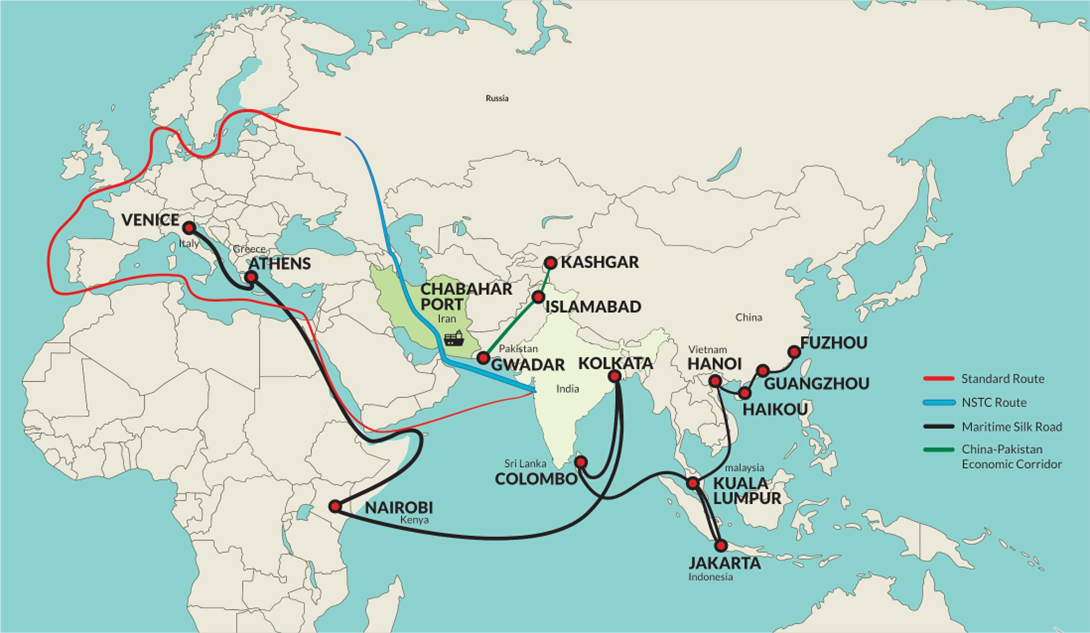
- 28 May 2024
Why is it in the News?
Recently, India secured rights to invest in and operate the Shahid-Behesti terminal at Chabahar Port for another 10 years.
Context:
- The recent extension of the contract between India and Iran, granting New Delhi continued investment and operational rights at the Shahid-Beheshti terminal within Chabahar Port for another ten years, underscores the project's strategic and economic significance.
- This development occurs amid a turbulent period in West Asia, characterized by ongoing conflict in Gaza, escalating tensions between Israel and Iran, and a destabilizing helicopter crash resulting in the loss of Iran’s President and Foreign Minister.
- Nevertheless, the Chabahar project retains its pivotal role in cementing economic ties between India and Iran despite these formidable challenges.
Significance of the Chabahar Project for India:
- Economic Connectivity and Trade Advancement: Chabahar Port serves as a vital node in the International North-South Transport Corridor (INSTC), streamlining India's trade routes with Central Asia, Russia, and beyond.
- By offering a direct sea-land route that circumvents Pakistan, Chabahar substantially cuts transportation time and costs for Indian exports bound for these regions.
- This heightened connectivity fosters increased trade, economic convergence, and access to fresh markets, augmenting India's export potential and economic prosperity.
- Geopolitical Influence and Strategic Independence: Chabahar represents a strategic asset for India to assert its influence in the region and diminish reliance on Pakistani transit routes, often fraught with geopolitical tensions.
- Through investment in Chabahar, India solidifies a strategic foothold in Iran, a nation wielding significant sway in West and Central Asia.
- The port empowers India to project strength and maintain a strategic presence in a landscape where China, through its Belt and Road Initiative (BRI), and Pakistan, vie for dominance.
- This strategic autonomy is pivotal for India's foreign policy, enabling adept navigation of intricate regional dynamics.
- Regional Security and Harmony: Chabahar Port assumes a crucial role in India's efforts towards regional security and stability, particularly concerning Afghanistan.
- Endorsed by the Taliban and with their financial commitment, Chabahar emerges as a key conduit for humanitarian aid and economic provisions to Afghanistan, thereby fostering stability in a strife-ridden region.
- By promoting economic growth and offering alternatives to Pakistani ports, Chabahar helps mitigate the peril of economic isolation for Afghanistan, fostering regional tranquillity.
- Countervailing Chinese Influence: Strategically positioned to counterbalance Chinese presence, Chabahar offers a distinct avenue to offset Chinese influence, notably vis-à-vis the China-Pakistan Economic Corridor (CPEC) and Gwadar Port.
- While Gwadar, under China's dominion, lies proximate to Chabahar, the latter furnishes an alternative route pivotal for diversifying regional supply chains.
- By fortifying Chabahar, India not only mitigates the strategic risks of Chinese infrastructure dominance but also offers a viable alternative for international trade routes evading Chinese control.
- Diplomatic Collaboration and Multilateralism: Chabahar Port epitomises India's dedication to diplomatic collaboration and multilateral engagement.
- Through this venture, India showcases its adeptness in partnering with diverse international stakeholders, including Iran, Afghanistan, and Central Asian nations, nurturing a collaborative regional milieu.
- The port aligns with broader international endeavours to bolster connectivity and economic amalgamation across Eurasia, positioning India as a pivotal player in regional developmental endeavours.
- Energy Security: Given Iran's substantial energy reserves, Chabahar Port holds promise in bolstering India's energy security.
- By serving as a strategic ingress point for Iranian oil and gas, the port facilitates energy imports, diversifies India's energy sources, and diminishes dependence on any single nation or route.
- This diversification is instrumental in securing a stable and resilient energy supply, indispensable for India's burgeoning economy.
Challenges in India-Iran Relations Amidst Chabahar Port Dynamics:
- Sanctions and Global Pressures: The imposition of international sanctions, particularly by the United States, has significantly disrupted economic ties between India and Iran.
- Projects like the Farzad-B gas field and the Irano Hind Shipping Company bore the brunt of these sanctions directly.
- The Chabahar Port project itself has faced intricacies due to U.S. sanctions, necessitating periodic exemptions for India to sustain its development efforts.
- Geopolitical Dynamics: India's strategic partnership with the United States sometimes clashes with its engagements with Iran, creating geopolitical complexities.
- During the Obama administration, India curtailed its oil imports from Iran in line with U.S. policies on Tehran’s nuclear program, impacting bilateral trade and diminishing Iran's standing as a major oil supplier to India.
- Competing Regional Agendas: India and Iran harbour divergent regional interests that occasionally conflict.
- While Iran aims to bolster its influence in West Asia and deepen ties with nations like China and Russia, India’s regional focus includes countering China’s Belt and Road Initiative and safeguarding its interests in Afghanistan.
- These disparate priorities can lead to friction and curtail the extent of bilateral cooperation.
Recommendations for Future Engagement:
Diversification of Economic Cooperation: While the Chabahar Port remains crucial, India and Iran should broaden their economic collaboration beyond it.
-
- Exploring sectors like energy, agriculture, pharmaceuticals, and technology through revived projects like the Farzad-B gas field or new joint ventures can enhance economic ties.
- Establishing a comprehensive trade framework involving tariff reduction, streamlined customs procedures, and investment incentives can stimulate bilateral commerce.
Enhancement of Diplomatic Engagement: Regular high-level visits and dialogues are essential to address misunderstandings and align strategic interests.
-
- Institutionalizing such engagements ensures continuous and structured communication between the two nations.
- Leveraging participation in multilateral forums like the United Nations and regional organizations can facilitate joint initiatives, amplifying diplomatic influence and fostering closer ties.
- Balancing Geopolitical Alignments: India should navigate its strategic partnership with the United States while engaging with Iran, emphasizing the significance of projects like Chabahar.
- Diplomatic efforts should prioritize securing exemptions from sanctions hindering critical projects, necessitating transparent communication with the U.S.
- Strengthening ties with other regional actors such as Afghanistan, Central Asian countries, and Russia can reinforce India-Iran relations and regional stability.
- By implementing these recommendations, India and Iran can foster a more robust and diversified partnership, enhancing mutual prosperity and geopolitical stability in the region.
Conclusion
The Chabahar port project symbolizes the intricate fabric of India-Iran relations, intertwining economic ambitions with strategic considerations. Amidst the shifting tides of geopolitics, Chabahar emerges as a symbol of the enduring collaboration between the two nations.
Maintaining this foundational project while expanding economic collaboration and diplomatic finesse will be pivotal in fortifying and advancing the India-Iran relationship in the years ahead.
A Door to a Housing Scheme, Tribals Find Hard to Open
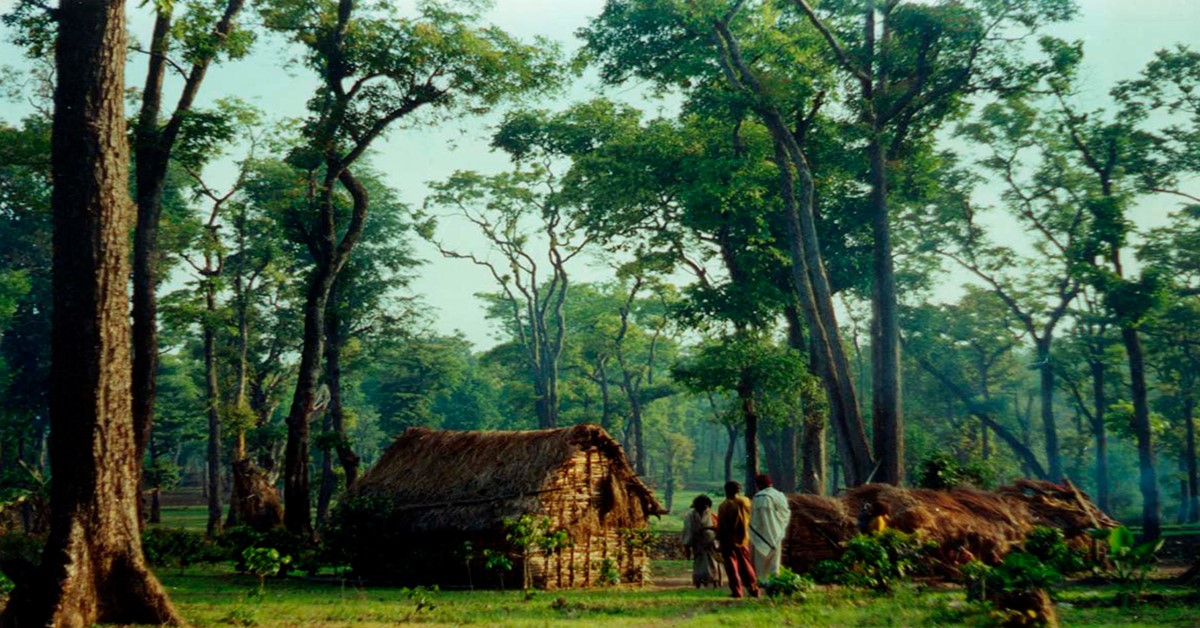
- 27 May 2024
Why is it in the News?
According to a recent report, the Pradhan Mantri Janjati Adivasi Nyaya Maha Abhiyan (PM JANMAN) is facing challenges in implementation.
Context:
- India is home to numerous tribal groups, including 75 identified as Particularly Vulnerable Tribal Groups (PVTGs) across various states.
- To address their socio-economic backwardness, the Government of India launched the Pradhan Mantri PVTG Development Mission in 2023-24.
- Despite this initiative, both PVTGs and frontline officials encounter significant challenges when using a mobile application to register for the housing scheme.
What is the Pradhan Mantri Janjati Adivasi Nyaya MahaAbhiyan (PM JANMAN)?
- The Pradhan Mantri Janjati Adivasi Nyaya MahaAbhiyan (PM JANMAN) is an initiative launched by the Government of India to uplift and empower the Particularly Vulnerable Tribal Groups (PVTGs).
Its key objectives and implementation aspects:
- The PM JANMAN initiative aims to ensure that PVTGs have access to essential services and improved living standards by addressing their critical needs through a comprehensive set of interventions.
- One of the flagship programs under this initiative is the Housing scheme, a Direct Benefit Transfer (DBT) scheme designed to provide secure and habitable housing to PVTG households.
- The Housing scheme targets to reach 4.90 lakh PVTG households by the year 2026, with each household entitled to receive ?2.39 lakh in three instalments.
- This financial assistance is intended to enable these vulnerable communities to construct safe and durable houses, protecting them from environmental challenges and providing a sense of security and dignity.
- By addressing the critical need for safe housing, along with other interventions focused on clean drinking water, sanitation, and other essential services, the PM JANMAN initiative aims to uplift the living conditions of PVTGs and empower them to overcome the challenges they face.
- This comprehensive approach seeks to create a supportive environment for the overall development and well-being of these marginalized communities. CopyRetry
What are the Challenges Associated with PM JANMAN Housing Scheme Implementation?
Data Mismatch and Ineligibility Issues:
- A significant challenge in the registration process is the widespread deletion of job cards, essential for registering for the PM JANMAN Housing scheme.
- Over the past two years, more than eight crore MGNREGA workers' job cards, including those of PVTG members, have been deleted. This massive data purge has prevented many eligible households from registering for the scheme, thereby excluding them from receiving benefits.
- Additionally, incorrect registrations have been reported, where individuals register using others' job cards.
- This not only deprives rightful owners of their entitlements but also creates administrative burdens in correcting these errors.
Discrepancies in Data Collection Systems:
- The 'Awaas+' registration app, used by block/panchayat-level officials, is critical for data collection but has significant discrepancies with other official records.
- For instance, in Vanjari Panchayat, Alluri Sitharama Raju district, Andhra Pradesh, the app lists only 22 villages, while the MGNREGA Management Information System (MIS) lists 31 villages.
- These discrepancies confuse beneficiaries and officials and may lead to the exclusion of eligible households.
App Usability and Confusion:
- The 'Awaas+' app's user interface and functionality present several challenges. The app collects beneficiaries' data in three main areas: geographical location, household profiles, and bank account details.
- However, its design and operational issues make the process cumbersome.
- The app includes pre-populated village lists that often do not match official records, leading to incorrect registrations or an inability to register certain households.
Geo-tagging and Network Issues:
- The app’s geo-tagging feature, meant to accurately record household locations and planned construction sites, faces issues due to network problems in remote areas.
- These network issues hinder the geo-tagging process, resulting in incomplete or incorrect data entries, which affects registration and service delivery planning.
Financial Inclusion Barriers:
- The app's bank selection functionality is another significant hurdle. Beneficiaries must choose from three categories of banks (Cooperative Bank, Commercial Bank, or Regional Rural Bank), each presenting numerous options.
- For instance, selecting 'Commercial Bank' can display over 300 options, and choosing 'State Bank of India' can show over 500 branch options.
- This complexity is overwhelming for beneficiaries and officials, especially those with limited digital literacy.
- Despite the Government of India’s push for India Post Payments Bank (IPPB) to enhance financial inclusion in remote areas, the app does not list IPPB, limiting access to convenient banking services for many PVTG households.
Inclusivity and Accessibility Issues:
- The app also fails to capture specific information about PVTGs, defaulting to a general 'ST' (Scheduled Tribe) category.
- This oversight results in non-PVTG registrations, complicating the process further. Local officials sometimes require PVTG members to obtain certification from village leaders, problematic in areas where PVTGs and non-PVTGs coexist.
- Additionally, network issues exacerbate the geo-tagging feature's challenges, adding to the difficulties faced by officials and beneficiaries alike.
Recommendations for Policymakers to Improve the PM JANMAN Scheme:
User-Friendly Application Interface:
- Redesign the ‘Awaas+’ mobile app to simplify navigation with intuitive menus and clear instructions.
- This will assist both beneficiaries and frontline officials who may not be tech-savvy. Include detailed guidelines on entering names and other details, especially when Aadhaar information is unavailable or differs from official records.
Accurate and Comprehensive Data Lists:
- Ensure the app’s pre-populated lists of villages and other data fields are regularly updated and synchronized with other government databases, such as the MGNREGA Management Information System (MIS), to eliminate discrepancies.
- Additionally, include explicit fields for PVTGs within the app to prevent incorrect registration of non-PVTG households.
Include IPPB in Banking Options:
- Add the India Post Payments Bank (IPPB) to the list of available banks in the registration app.
- Given IPPB’s extensive reach in rural and remote areas, this inclusion would significantly enhance financial access for PVTG households.
- Simplify the bank selection process by implementing a search function or categorizing banks more effectively to facilitate easier selection by users.
Improve Technical Infrastructure:
- Invest in improving network connectivity in remote areas to support geo-tagging and other app functionalities.
- Partner with telecom companies to extend coverage to underserved regions and develop offline capabilities for the registration app, allowing data collection without immediate internet access and subsequent synchronization when connectivity is available.
Provide Comprehensive Training and Support:
- Implement comprehensive training programs for frontline officials and community volunteers on using the app and managing the registration process efficiently.
- Establish dedicated technical helplines or support centres to assist with real-time troubleshooting and provide guidance for users facing difficulties.
Conclusion
While various initiatives have targeted the vulnerabilities of PVTGs, accessing government benefits remains a substantial challenge for these marginalized communities. The PM JANMAN initiative stands as a potential avenue to enhance the well-being of PVTGs. However, it is imperative to address the existing obstacles in the registration process and prioritize inclusivity and accessibility. The PM JANMAN scheme presents an opportunity to shift the paradigm for PVTGs, but its success hinges on effectively tackling implementation challenges and fulfilling the commitments made.
Critical Times Call for Strong Judicial Adjudication
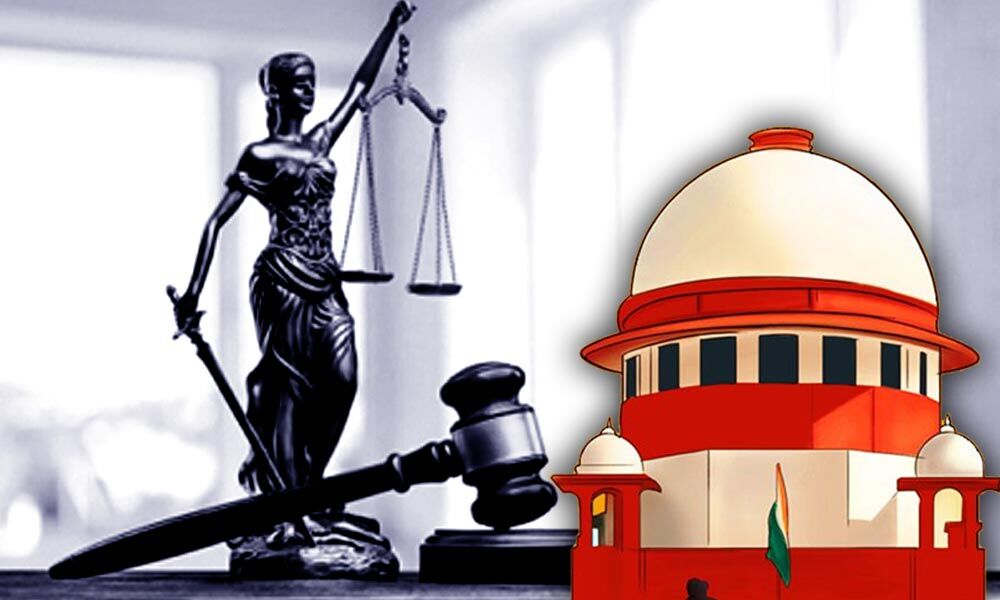
- 21 May 2024
Why is it in the News?
The process of judicial review should be strong, immediate, and unambiguous in the case of statutes that are obviously unconstitutional or divisive.
Context:
- The role of judicial review has become increasingly significant in contemporary times.
- The Supreme Court of India is currently examining a crucial case regarding the constitutionality of the Citizenship (Amendment) Act (CAA) and its associated rules.
- The ambiguity in these rules has raised concerns, especially for applicants whose citizenship requests have been denied, highlighting the urgent need for redress.
- Additionally, the issue of dual citizenship for foreign applicants, without renouncing their original citizenship, has created a conflict with the law.
- This ambiguity goes against the Parent Act's spirit, as some petitioners pointed out.
Legislative Malice, Judicial Review, and the Challenge of Populist Regimes:
- Constitutional courts do not routinely interdict statutes or statutory rules, as laws passed by Parliament are generally presumed valid unless proven to contravene constitutional provisions.
- Moreover, the legal doctrine maintains that malice cannot typically be attributed to the legislative process, as established in Manish Kumar vs Union of India (2021).
- In Gurudevdatta Vikoos Maryadit vs State Of Maharashtra (2001), the Supreme Court further emphasized that "legislative malice is beyond the pale of jurisdiction of the law courts."
- However, this conventional wisdom may be insufficient when addressing the unique challenges posed by populist regimes employing motivated legislation.
- As populist governments worldwide increasingly weaponize legislation to further their political agendas, the question arises as to whether constitutional courts should reconsider their stance on legislative malice.
- Given the potential for populist regimes to undermine democratic principles and erode the rule of law, the need for robust judicial review has never been greater.
- In light of these challenges, a careful reevaluation of the limits of judicial intervention may be necessary to ensure that the rights and freedoms enshrined in constitutional democracies are protected from malicious legislative actions.
Judicial Challenges and Lessons from the Recent Cases:
- Recent cases have highlighted the pressing need for a more proactive judiciary in safeguarding democratic principles and the rule of law.
- In Vivek Narayan Sharma vs Union of India (2023), the irreversible consequences of the absence of judicial intervention regarding Kashmir's special status were brought to the forefront.
- The Anoop Baranwal vs Union of India (2023) case underscored the necessity for an independent body to select the Election Commission of India (ECI).
- However, the Chief Election Commissioner and other Election Commissioners (Appointment, Conditions of Service and Term of Office) Act, 2023, reintroduced the "Prime Minister's Committee" system for ECI appointments, raising concerns about the impartiality of the selection process.
- When this Act was challenged in Jaya Thakur vs Union of India (2024), the Court declined to halt its implementation, citing the presumption of validity.
- This decision exemplifies how an overly deferential approach to legislative actions can potentially jeopardize democratic institutions and processes.
Case Studies and Implications of Targeted Legislation:
- The Citizenship (Amendment) Act (CAA): CAA exemplifies targeted legislation, as it explicitly excludes Muslims from the citizenship application process, demonstrating a clear case of legislative malice through religious categorization.
- Tripple Talaq case: Another instance of targeted legislation is the Muslim Women (Protection of Rights on Marriage) Act (2019), which criminalized instant triple talaq.
- Despite the Supreme Court declaring instant triple talaq void in Shayara Bano (2017), the Act's criminalization of an already legally invalid practice appears excessive and unnecessary.
- Unintended effects: Unintended consequences have arisen from the triple talaq legislation, as some individuals now resort to alternative divorce methods or desertion to avoid potential legal repercussions.
- Although the law aimed to protect Muslim women, it has paradoxically worsened their situation.
- Furthermore, such divisive measures have inspired similar legislation in other states, such as anti-conversion laws, perpetuating social divisions.
- These cases reveal the need for a vigilant judiciary to scrutinize targeted legislation and ensure that laws do not perpetuate discrimination or undermine fundamental rights.
- Addressing legislative malice is essential for preserving the integrity of democratic institutions and upholding constitutional principles.
Judicial Scrutiny in Contemporary Politics: International Perspectives and Indian Precedents
- The Evolution of Judicial Scrutiny in Modern Politics: Traditionally, the United States has been cautious about judicial nullification of statutes based on malicious intent.
- John Hart Ely argued that using the Constitution to penalize perceived ill intentions of political leaders is inappropriate.
- Susannah W. Pollvogt's Viewpoint on Discriminatory Law: However, in today's political climate, where legislative actions driven by malice are increasingly common, a growing need for more rigorous judicial scrutiny has emerged.
- Scholar Susannah W. Pollvogt contends that animus, or hostility, can never justify discriminatory state actions under equal protection analysis.
- She cites the United States Dept. of Agriculture vs Moreno (1973) to illustrate how legislation targeting specific groups reflects discriminatory intent and a desire to cause harm.
- Indian Legal Precedents for Judicial Intervention: In India, there are instances where the Supreme Court has intervened to halt the implementation of parliamentary legislation.
- In Ashoka Kumar Thakur vs Union of India (2007), the Court issued a judicial injunction regarding the allocation of a 27% quota for Other Backward Community (OBC) candidates in professional colleges.
- More recently, in Rakesh Vaishnav vs Union of India (2021), the Supreme Court's stay order on three controversial farm laws effectively prevented their enforcement.
- This intervention eventually led to the government's withdrawal of the laws amidst widespread farmer protests.
- These cases demonstrate the vital role of the judiciary in safeguarding fundamental rights and democratic principles.
- As legislative malice becomes more prevalent, judicial scrutiny must evolve to ensure that laws do not perpetuate discrimination or undermine constitutional values.
Conclusion
To protect constitutional principles and democratic values, judicial review must be prompt, vigorous, and unambiguous when confronted with divisive or unconstitutional statutes. The Supreme Court should learn from its past decisions and recognize the political impact of its actions, particularly during critical moments. Delayed adjudication can render constitutional review ineffective, making time-sensitive intervention essential in addressing malicious and unconstitutional legislation.
Hyperpoliticisation of Indian Higher Education
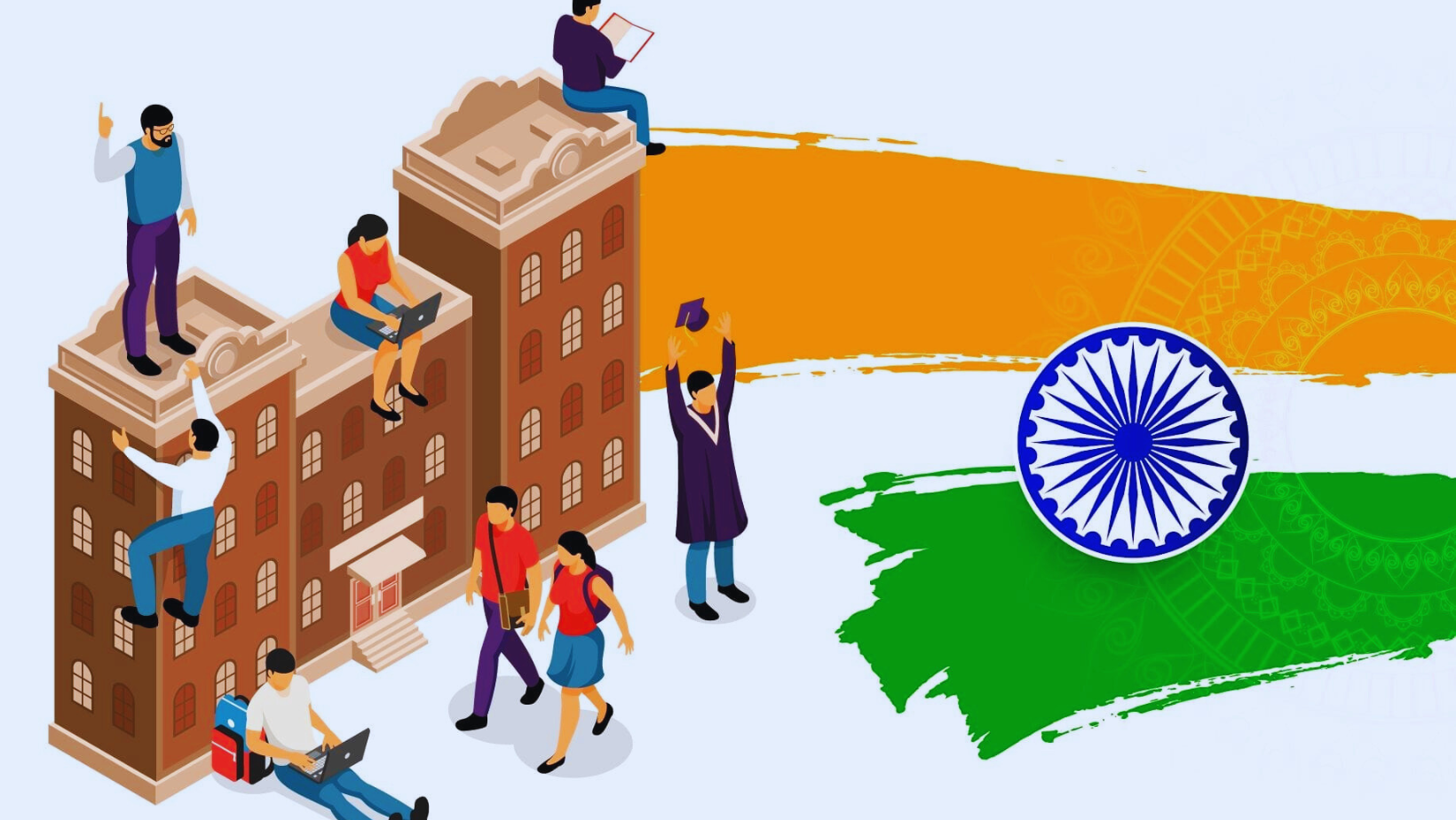
- 20 May 2024
Why is it in the News?
The hyperpoliticisation of Indian higher education is a grave threat to academic institutions, the academic profession, and intellectual life in general.
Context:
- The higher education system in India is one of the largest globally, showcasing its rich historical legacy and future ambitions.
- The country is home to an impressive range of institutions, including the globally renowned Indian Institutes of Technology (IITs) and Indian Institutes of Management (IIMs), as well as a vast network of universities and colleges.
- Notably, the QS World University Rankings for Asia 2024 highlight India as having the most represented higher education system.
- However, this expansive framework faces numerous challenges and opportunities that shape the current higher education landscape in India.
- While access has significantly expanded, concerns about quality, relevance, and the ability to prepare youth for the 21st century remain.
- Additionally, recent reports have pointed to a troubling trend of increasing politicization within Indian higher education institutions, which threatens academic freedom, intellectual discourse, and overall educational quality.
Current Status of Higher Education in India:
As per the All India Survey of Higher Education (AISHE) 2021-22, released in January 2024:
- Student Enrolment: Higher education institutes have seen a significant rise in student enrolment, reaching 4.33 crore in 2021-22 from 4.14 crore in 2020-21 and 3.42 crore in 2014-15.
- Notably, women's enrolment has surged by 32% to 2.07 crore in 2021-22 from 1.5 crore in 2014-15, with the highest proportion enrolled at the postgraduate level (55.4%).
- Gross Enrolment Ratio (GER) and Gender Parity Index (GPI): India's estimated GER for the age group 18-23 years stands at 28.4%.
- The GPI, reflecting the female GER to male GER ratio, is 1.01 at the national level, indicating gender parity.
- Discipline-wise Enrolment: At the undergraduate level, the Bachelor of Arts (BA) programme leads with 34.2% enrolment, followed by science (14.8%), commerce (13.3%), and engineering and technology (11.8%).
- Social science dominates postgraduate enrolment, with around 10.8 lakh students.
- Primacy of Government Institutions: Government universities attract 73.7% of all students, despite comprising only 58.6% of all universities.
- State public universities hold the largest share of enrolment, accounting for approximately 31% of government-owned universities.
Current Challenges in India's Higher Education System:
- Politicization and Lack of Autonomy: Concerns arise regarding the growing politicization of higher education institutions, including allegations of political interference in appointments and curriculum decisions.
- Many institutions lack autonomy in crucial areas like faculty recruitment and curriculum design, hindering innovation and adaptability.
- Inequitable Access and Low GER: Access to higher education remains unequal, with disparities based on socio-economic status, gender, and geography.
- Although India's Gross Enrolment Ratio (GER) has improved (currently 28.4%), it still falls below the global average of 36.7%.
- Limited Funding: Budget cuts in the education sector, including a 7% reduction in the Interim Budget 2024-25 and a 61% decrease in the allocation for the University Grants Commission, pose significant challenges.
- Despite rising Gross Expenditure on Research and Development (GERD), India's R&D investment as a percentage of GDP lags behind other countries.
- Shortage of Faculty and Brain Drain: There is a severe shortage of qualified faculty members in Indian higher education institutions, with over 30% of teaching positions vacant in 45 Central Universities as of 2023.
- The brain drain of talented academics to other countries or the private sector exacerbates this issue.
- Inadequate Industry-Academia Collaboration: Insufficient collaboration between higher education institutions and industries leads to a skill gap among graduates, with a significant demand-supply gap in key roles such as ML engineer and data scientist.
- Uneven Regional Development: Higher education institutions' development varies across regions and states, with states like Delhi, Tamil Nadu, and Maharashtra hosting more reputed institutions compared to northeastern and central regions, which face challenges in terms of quality and access.
How Can the Higher Education System in India Be Revamped?
- Redefine Universities' Role: Shift focus from rote learning to practical skill development through project-based learning, internships, and industry collaborations.
- Encourage universities to engage with local communities on social development projects, promoting social responsibility among students.
- Transform institutes from "Degree Issuers" to "Skill Generators."
- Open Educational Resources (OER): Enhance the National Digital Library of India and promote the development and adoption of open educational resources, like MIT OpenCourseWare, providing free access to quality educational materials.
- This approach could reduce costs, enhance access, and foster a culture of knowledge sharing.
- Entrepreneurship and Innovation Centers: Establish dedicated centres within universities, inspired by Stanford University's StartX program, offering mentorship, funding opportunities, and a supportive ecosystem for students and faculty to transform innovative ideas into successful ventures.
- Dual Study Programs: Implement phase-wise dual study programs, inspired by Germany's apprenticeship model, where students combine theoretical learning at universities with practical training in companies.
- This approach ensures industry-relevant skill development and enhances employability.
- Competency-based Credentialing and Blockchain Certificates: Implement a competency-based credentialing system that recognizes skills and competencies acquired through various learning pathways.
- Leverage blockchain technology to issue tamper-proof, verifiable digital certificates and credentials, promoting lifelong learning, skill-based education, and recognition of diverse learning experiences.
- Transnational Education Partnerships: Promote collaborations with reputed international universities for joint degrees, twinning programs, or branch campuses.
- This approach could enhance global exposure, facilitate knowledge transfer, and improve the international competitiveness of Indian higher education.
Key Government Initiatives in Higher Education:
- National Education Policy (NEP) 2020: Aims to transform the education system, focusing on multidisciplinary learning, skill development, and promoting research and innovation.
- It proposes increasing the Gross Enrollment Ratio in higher education to 50% by 2035.
- Institutions of Eminence (IoE) Scheme: Launched in 2018, this scheme selects 20 institutions to enjoy complete autonomy, aiming to improve their global rankings and enhance higher education quality.
- National Credit Framework: Designed to integrate training and skill development into the education system.
- Credits earned by students will be stored digitally in the Academic Bank of Credits, accessible via a linked Digilocker account.
- Revamped Accreditation and Ranking Systems: The National Institutional Ranking Framework (NIRF) ranks higher education institutions across categories, while the revamped National Assessment and Accreditation Council (NAAC) ensures quality standards among institutions.
- Digital Initiatives: SWAYAM, an online learning platform, offers courses from school to postgraduate levels.
- The National Digital Library of India provides access to educational resources.
- SHE under INSPIRE: The Scholarship for Higher Education (SHE) program, part of the Innovation in Science Pursuit for Inspired Research (INSPIRE) by the Department of Science and Technology (DST), supports deserving students in basic and natural sciences at undergraduate, postgraduate levels and encourages research careers through scholarships.
- Study in India Program: Launched in 2018, this program attracts international students by offering scholarships and streamlining admission processes.
- Foreign Institutions in India: The University Grants Commission's 2023 regulations allow foreign universities ranked among the world's top 500 to establish branch campuses in India.
Conclusion
India's higher education sector is undergoing significant reforms and initiatives aimed at enhancing quality, accessibility, and global competitiveness. Through policies like the National Education Policy 2020 and programs such as Institutions of Eminence, the government is prioritizing multidisciplinary learning, skill development, and research promotion. Digital initiatives like SWAYAM and the Study in India Program further contribute to modernizing and internationalizing higher education, while efforts to attract foreign institutions and scholarships underscore India's commitment to fostering innovation and excellence in education.
Freshwater Quest: The Emergence of the New Gold Rush

- 11 May 2024
Why is it in the News?
India can take the lead in shaping non-controversial legislative text that addresses the gaps in the laws of the sea, especially in exploratory activities that concern freshwater extraction.
Context:
- Recent statistics reveal that the vast majority of Earth's water is saline, leaving only a small portion as freshwater. Surprisingly, just 0.3% of this freshwater exists in liquid form on the surface, highlighting the significance of subterranean freshwater reserves, including those beneath the ocean floor.
- This emphasizes the growing importance of underground freshwater resources amid the escalating scarcity of surface water.
What are Undersea Freshwater Reserves?
- Undersea freshwater reserves are large volumes of fresh water found beneath the ocean floor.
- In the 1960s, the U.S. Geological Survey made an unexpected discovery of freshwater reserves beneath the ocean floor while drilling off the coast of New Jersey.
- This finding has since been followed by international scientific teams uncovering additional sources of underwater freshwater across the globe, notably including a deep river at the bottom of the Black Sea.
- This particular underwater river is over 100 feet deep, flows at a rate of about four miles per hour, and boasts a volume comparable to some of the world's largest land-based rivers.
- As freshwater resources on land become increasingly scarce, countries are turning their attention towards exploring and potentially exploiting both surface and subsurface freshwater reserves within their maritime zones.
- It is anticipated that these efforts may eventually extend beyond national Exclusive Economic Zones into regions governed by the United Nations Law of the Sea Convention, highlighting the significance of this valuable resource and the increasing need for its sustainable management.
Legal and Policy Framework of Ocean Governance:
- United Nations Convention on the Law of the Sea (UNCLOS): The United Nations Convention on the Law of the Sea (UNCLOS) serves as the primary legal framework governing the management and constitution of the world's oceans.
- It incorporates most internationally recognized maritime laws while also acknowledging the importance of customary international law in sea governance.
- UNCLOS designates the "Area" beyond national jurisdiction as the seabed, ocean floor, and subsoil, defining it as the common heritage of mankind.
- This classification underscores the notion that these regions should be available for the benefit of current and future generations.
- 1958 Geneva Conventions: The 1958 Geneva Conventions on the Law of the Sea also play a vital role in maritime legal doctrine.
- These include the Convention on the Territorial Sea and the Contiguous Zone, the Convention on the High Seas, the Convention on Fishing and Conservation of the Living Resources of the High Seas, and the Convention on the Continental Shelf.
- These Geneva Conventions address many issues similar to those covered by UNCLOS and draw their principles from customary international law, reinforcing the essential foundations of maritime legal norms.
- Exclusive Economic Zones and the "Area" under UNCLOS: UNCLOS delineates Exclusive Economic Zones (EEZs) extending up to 200 nautical miles from coastal boundaries, granting states exclusive rights to marine resources within this zone.
- Beyond the EEZ lies the "Area," designated as the common heritage of mankind, managed collectively for sustainable utilization.
Navigating Complexities in UNCLOS and Geneva Conventions:
- The United Nations Convention on the Law of the Sea (UNCLOS) and the 1958 Geneva Conventions on the Law of the Sea present complex legal interplays due to varying degrees of ratification and overlapping jurisdictions.
- For instance, UNCLOS supersedes the Geneva Conventions for its signatories but does not apply to non-signatory states.
- This divergence in international agreements is exemplified by the United States, which is a signatory to the Geneva Conventions but not UNCLOS.
- The term "resources" under UNCLOS is limited to solid, liquid, or gaseous mineral resources found in the Area.
- However, it remains unclear whether this definition extends to freshwater. Given the increasing scarcity of freshwater resources, potential conflicts may arise over its exploration and extraction in the "Area," particularly in the absence of specific legislation governing resources beyond national jurisdiction.
- The complex legal landscape is further exacerbated by the presence of multiple pieces of maritime legislation that fail to address emerging challenges effectively.
- Additionally, the regulatory authority of the International Seabed Authority (ISA) under UNCLOS adds another layer of complexity, as it remains unclear who regulates state parties to the Geneva Conventions regarding mining and exploratory activities in the "Area.
Significance of Freshwater Exploration for the Future:
- Addressing Scarcity: Given that merely 0.3% of Earth's freshwater is readily available on the surface, the exploration of underground and underwater sources emerges as imperative to satisfy future water demands.
- Conflict Prevention: As freshwater scarcity intensifies, the exploration and protection of underwater sources serve as proactive measures to mitigate potential conflicts over water resources.
- Promoting Sustainability: Engaging in responsible freshwater exploration aligns with Sustainable Development Goals, fostering the sustainable utilization of natural resources to ensure their availability for future generations.
Way Forward:
- Legislative Clarity: It is crucial to create a thorough legal framework that addresses the difficulties of discovering freshwater reserves outside of national borders.
- This framework should harmonize UNCLOS provisions with customary international law, ensuring clarity and consistency in governing maritime activities.
- International Collaboration: Engaging in constructive dialogue and negotiation forums, nations can strive to reconcile divergent legal interpretations and foster mutual understanding.
- Establishing multilateral agreements and protocols can enhance cooperation and coordination in managing underwater freshwater resources.
- Research and Technological Advancement: Investment in research and technological innovation is crucial for unlocking the full potential of underwater freshwater reserves.
- Advanced exploration techniques and sustainable extraction methods can optimize resource utilization while minimizing environmental impact.
- India's Leadership Role: As a pivotal stakeholder in maritime affairs, India can spearhead international discourse on freshwater exploration.
- By advocating for inclusive and equitable approaches, India can contribute to the development of global norms and standards governing underwater resource management.
Conclusion
The increasing scarcity of freshwater underscores the urgent need for an internationally recognized legislative framework to govern the exploration and exploitation of underground freshwater resources. The establishment of such a framework would not only help prevent potential conflicts but also ensure the sustainable utilization of this vital resource for the benefit of both present and future generations on a global scale. By proactively addressing these challenges, nations can work together to secure the long-term availability and equitable distribution of freshwater, fostering stability and prosperity in an increasingly water-scarce world.
An AI-infused World Needs Matching Cybersecurity
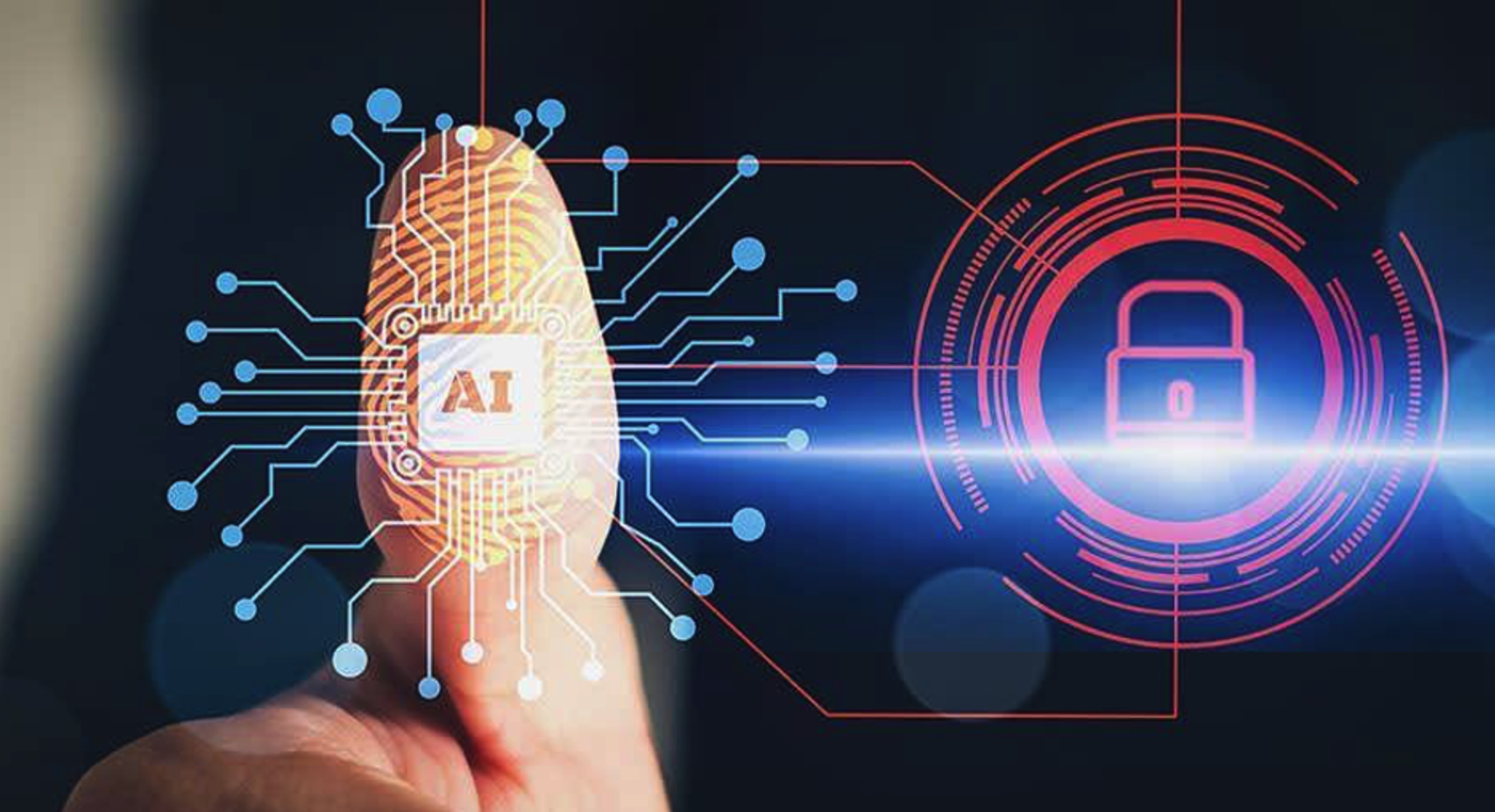
- 10 May 2024
Why is it in the News?
As generative AI technology becomes more prevalent, safeguarding consumers' ability to navigate digital environments securely has become increasingly imperative.
Context:
- In recent times, the integration of generative artificial intelligence (AI) across industries has significantly transformed operational processes.
- However, this rapid advancement has also led to the emergence of new cyber threats and safety concerns.
- With incidents such as hackers exploiting generative AI for malicious purposes, including impersonating kidnappers, it is evident that a comprehensive analysis and proactive approach are required to address and mitigate the potential risks associated with this technology.
- A study by Deep Instinct revealed that 75% of professionals observed a surge in cyberattacks over the past year, with 85% attributing this escalation to generative AI.
- Among surveyed organizations, 37% identified undetectable phishing attacks as a major challenge, while 33% reported an increase in the volume of cyberattacks.
- Additionally, 39% of organizations expressed growing concerns over privacy issues stemming from the widespread use of generative AI.
Significant Impact of Generative AI & Growing Cybersecurity Challenges:
- Transformative Impact: Generative AI has revolutionized various sectors like education, banking, healthcare, and manufacturing, reshaping our approach to operations.
- However, this integration has also redefined the landscape of cyber risks and safety concerns.
- Economic Implications: The generative AI industry's projected contribution to the global GDP, estimated between $7 to $10 trillion, underscores its significant economic potential.
- Yet, the development of generative AI solutions, such as ChatGPT introduced in November 2022, has introduced a cycle of benefits and drawbacks.
- Rising Phishing and Credential Theft: An alarming surge of 1,265% in phishing incidents/emails and a 967% increase in credential phishing since late 2022 indicates a concerning trend.
- Cybercriminals exploit generative AI to craft convincing emails, messages, and websites, mimicking trusted sources to deceive unsuspecting individuals into divulging sensitive information or clicking on malicious links.
- Emergence of Novel Cyber Threats: The proliferation of generative AI has expanded the cyber threat landscape, enabling sophisticated attacks.
- Malicious actors leverage AI-powered tools to automate various stages of cyber-attacks, accelerating their pace and amplifying their impact.
- This automation poses challenges for detection and mitigation, making attacks more challenging to thwart.
- Challenges for Organizations: Organizations across sectors face escalating cyber threats, including ransomware attacks, data breaches, and supply chain compromises.
- The interconnected nature of digital ecosystems exacerbates the risk, as vulnerabilities in one system can propagate to others, leading to widespread disruption and financial losses.
- Additionally, cybercriminals' global reach and anonymity pose challenges for law enforcement and regulatory agencies.
The Bletchley Declaration: Addressing AI Challenges
- Global Significance: The Bletchley Declaration represents a pivotal global initiative aimed at tackling the ethical and security dilemmas associated with artificial intelligence, particularly generative AI.
- Named after Bletchley Park, renowned for its British code-breaking endeavours during World War II, the declaration embodies a collective resolve among world leaders to shield consumers and society from potential AI-related harms.
- Acknowledgement of AI Risks: The signing of the Bletchley Declaration at the AI Safety Summit underscores the mounting awareness among global leaders regarding AI's inherent risks, notably in the cybersecurity and privacy realms.
- By endorsing coordinated efforts, participating nations affirm their dedication to prioritizing AI safety and security on the international agenda.
- Inclusive Engagement: The Bletchley Declaration's inclusive nature is evident in the involvement of diverse stakeholders, including major world powers like China, the European Union, India, and the United States.
- By fostering collaboration among governments, international bodies, academia, and industry, the declaration facilitates cross-border and cross-sectoral knowledge exchange, essential for effectively addressing AI challenges and ensuring equitable regulatory frameworks.
- Consumer Protection Focus: At its heart, the Bletchley Declaration underscores the imperative of safeguarding consumers against AI-related risks.
- Participating countries commit to formulating policies and regulations that mitigate these risks, emphasizing transparency, accountability, and oversight in AI development and deployment.
- Additionally, mechanisms for redress in cases of harm or abuse are prioritized.
- Ethical AI Promotion: A core tenet of the Bletchley Declaration is the promotion of ethical AI practices.
- Participating nations pledge to uphold principles of fairness, accountability, and transparency in AI development and usage, striving to prevent discriminatory or harmful outcomes.
- This commitment aligns with broader endeavours to ensure responsible AI deployment for the betterment of society.
Alternative Measures for AI Risk Mitigation:
- Institutional-Level Strategies: Governments and regulatory bodies can enact robust ethical and legislative frameworks to oversee the development, deployment, and utilization of generative AI technologies.
- These frameworks should prioritize consumer safeguarding, transparency, and accountability, all while fostering innovation and economic prosperity.
- Furthermore, the integration of watermarking technology can aid in the identification of AI-generated content, empowering users to discern between authentic and manipulated information.
- This proactive approach can substantially mitigate the prevalence of misinformation and cyber threats stemming from AI-generated content.
- Continuous Innovation and Adaptation: Sustained investment in research and development is imperative to proactively address emerging cyber threats and devise innovative solutions to counter them.
- By bolstering support for cutting-edge research in AI security, cryptography, and cybersecurity, governments, academia, and industry can drive technological progress that fortifies cybersecurity resilience and mitigates the inherent risks associated with generative AI.
Conclusion
Effectively tackling the challenges presented by generative AI demands a comprehensive strategy encompassing regulatory, collaborative, and educational efforts across institutional, corporate, and grassroots domains. Through the enactment of robust regulatory frameworks, stakeholders can collaboratively mitigate the risks posed by AI-driven cyber threats, fostering a safer and more secure digital environment for all.
Balancing Fundamental Rights (FR) and the Directive Principles of State Policy (DPSP)
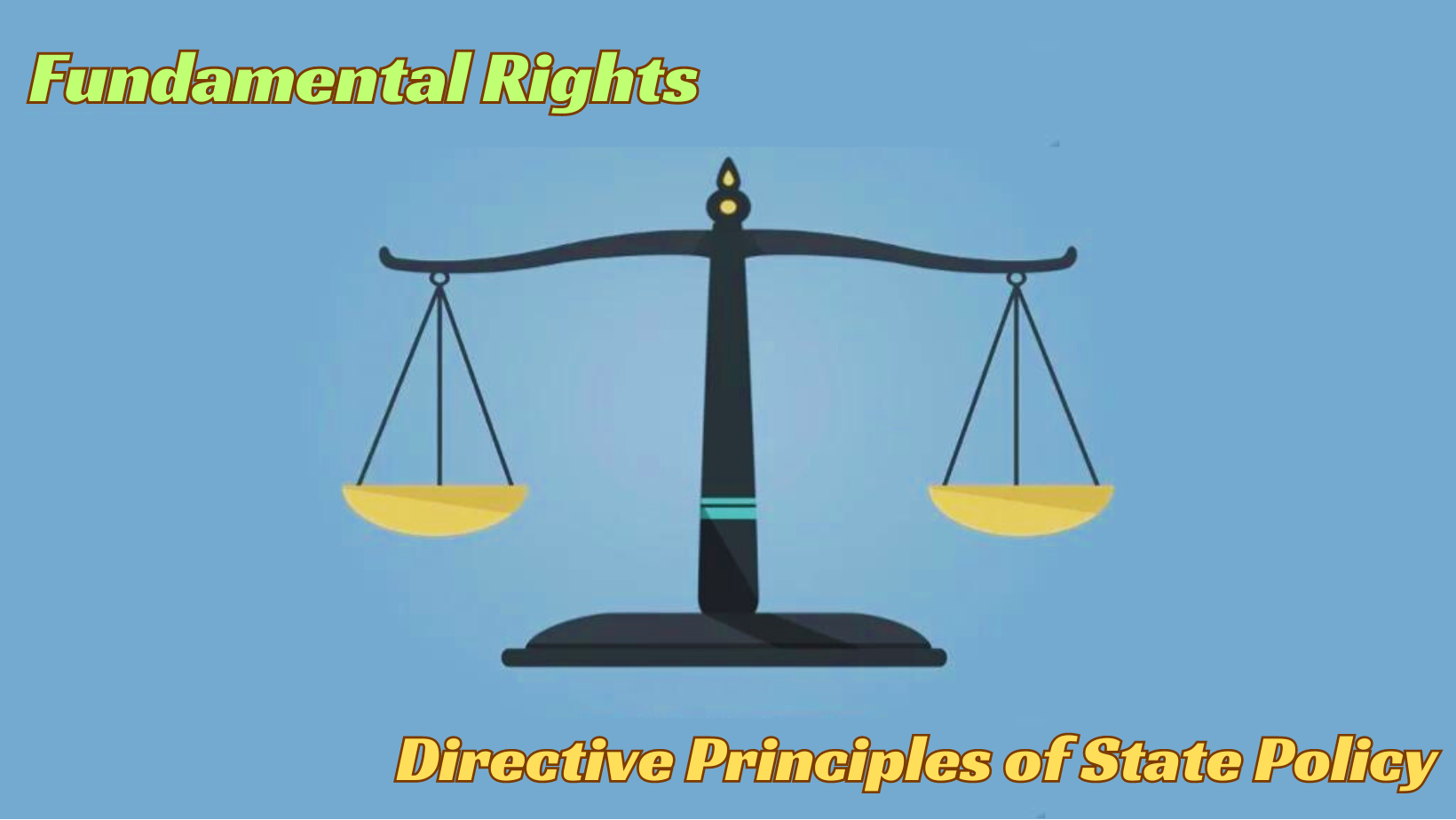
- 09 May 2024
Why is it in the News?
The top court has a chance, in Property Owners Association vs State of Maharashtra, to resolve the clash between fundamental rights and Directive Principles of State Policy.
Context:
- In a recent hearing before a nine-judge Bench of the Supreme Court of India in Property Owners Association vs State of Maharashtra, two crucial questions have surfaced concerning the interpretation and implementation of constitutional provisions.
- The initial query revolves around elucidating the concept of "material resources of the community" as articulated in Article 39(b) of the Indian Constitution.
- The subsequent issue delves into the potential discord between legislation crafted to fulfil the objectives delineated in Article 39(b) and the fundamental rights to equality and liberty enshrined in Part III of the Constitution.
The Conflict Between Fundamental Rights (FR) and Directive Principles of State Policy (DPSP):
- Inherent Dilemma: At the core of India's constitutional framework lies a significant tension between fundamental rights and directive principles of state policy (DPSP).
- Part III guarantees citizens' fundamental rights, while Part IV outlines DPSPs as guiding principles for state action.
- This tension stems from the divergent nature of these provisions:
- fundamental rights are legally enforceable
- whereas DPSPs serve as moral and political directives without judicial enforceability.
- Clash of Objectives: The conflict between fundamental rights and DPSPs arises from conflicting priorities: individual liberties versus collective welfare.
- While fundamental rights focus on safeguarding individual autonomy and limiting state interference, DPSPs underscore the state's responsibility to foster social and economic justice for citizens' well-being.
- This tension is compounded by India's diverse societal fabric, marked by varying social, economic, and cultural landscapes.
- Historical Discourse: The conflict between fundamental rights and DPSPs has sparked considerable debate and legal scrutiny throughout India's constitutional history.
- Courts have grappled with striking a balance between state intervention for societal welfare and safeguarding individual freedoms, especially when legislative measures aimed at fulfilling DPSPs impinge on fundamental rights.
- The Supreme Court's pivotal role in adjudicating these conflicts has significantly shaped India's constitutional democracy.
- Intensified Debate: During the 1970s, the conflict between fundamental rights and DPSPs reached a zenith, prompting amendments to shield certain laws from judicial review.
- The landmark Kesavananda Bharati vs State of Kerala (1973) case sought to address this conflict, yet it persisted, reflecting the ongoing struggle to reconcile competing constitutional imperatives.
What is the Article 31C of the Indian Constitution?
- The 25th Amendment (Birth of Article 31C): Enacted through the 25th amendment to the Indian Constitution, Article 31C was introduced to shield laws aimed at actualizing Article 39(b) and (c) from judicial scrutiny concerning potential violations of fundamental rights.
- This constitutional provision sought to safeguard legislative measures crafted to secure the material resources of the community, shielding them from challenges under Articles 14 and 19, which safeguard equality and various freedoms, respectively.
- Kesavananda Bharati Case (Challenging Article 31C): The landmark Kesavananda Bharati vs State of Kerala (1973) case questioned the validity and breadth of Article 31C.
- The Supreme Court deliberated on whether Article 31C, by immunizing certain laws from fundamental rights challenges, infringed upon the basic structure of the Constitution.
- While affirming the principle of judicial review and the supremacy of the Constitution's basic structure, the ruling left uncertainties about the extent to which Article 31C could restrict fundamental rights.
- Expansion via the 42nd Amendment: Despite judicial scrutiny in Kesavananda, Parliament expanded Article 31C's reach through the 42nd Amendment in 1976.
- This amendment aimed to widen the immunity granted to laws furthering directive principles, extending beyond Article 39(b) and (c) to encompass any directive principle.
- The 42nd Amendment marked a significant shift in the equilibrium between fundamental rights and directive principles, sparking concerns over potential encroachments on individual liberties.
- Minerva Mills Case (Judicial Intervention): The constitutionality of the expanded Article 31C faced judicial scrutiny in Minerva Mills vs Union of India (1980).
- In a seminal verdict, the Supreme Court struck down the 42nd Amendment, emphasizing the symbiotic relationship between fundamental rights and directive principles within the constitutional framework.
- Chief Justice Y.V. Chandrachud's assertion regarding fundamental rights serving as a check against unchecked state authority underscored the significance of this ruling.
- Ambiguities and Pending Matters: Following the Minerva Mills case, ambiguities persisted regarding the status of Article 31C and its alignment with the Constitution's basic structure.
- Justice Y.V. Chandrachud's divergent opinions in Minerva Mills and Waman Rao vs Union of India added complexity to the issue.
- The absence of a definitive Supreme Court ruling on the validity of Article 31C has perpetuated the tension between fundamental rights and directive principles.
Property Owners Association Vs State of Maharashtra: Resolving a Constitutional Conundrum
- Comprehensive Legal Examination by the Supreme Court: At the heart of this case lies a critical examination of a law granting a state government board full control over dilapidated buildings, contingent upon the consent of at least 70% of residents.
- The legality of this law is under scrutiny, particularly regarding its potential infringement on fundamental rights enshrined in Articles 14 and 19, which ensure equality and various freedoms, respectively.
- Rebalancing Fundamental Rights and Directive Principles: The verdict in the Property Owners case holds profound significance for recalibrating the equilibrium between fundamental rights and directive principles in India's constitutional fabric.
- It will delineate whether laws designed to uphold directive principles, such as acquiring dilapidated buildings for the common good, can withstand challenges based on fundamental rights.
- This raises fundamental questions regarding the hierarchy of rights and duties within the constitutional framework and the extent to which the state can limit individual liberties for the collective welfare.
- Addressing Ambiguities and Pending Issues: The Property Owners case offers an opportunity for the judiciary to clarify ambiguities surrounding the interpretation and implementation of Article 31C, considering previous judicial precedents.
- Prior conflicting rulings in cases like Kesavananda Bharati and Minerva Mills have left unresolved queries regarding the validity and scope of Article 31C, particularly concerning its alignment with the Constitution's basic structure.
- Despite subsequent judgments like Waman Rao and Sanjeev Coke vs Bharat Coking Coal (1982), which followed, the Supreme Court has yet to provide a definitive analysis of Article 31C introduced by the 25th amendment and its compatibility with the Constitution's foundational principles.
- By offering clarity on these matters, the Supreme Court can foster a more coherent and uniform approach to reconciling the divergent demands of fundamental rights and directive principles.
Conclusion
The verdict in the Property Owners case stands as an opportunity to reinforce the core tenets of equality, liberty, and social justice embedded within the Indian Constitution. By delicately reconciling the safeguarding of individual rights with the advancement of societal well-being, the judiciary holds the key to preserving the integrity of India's constitutional democracy. Such a decision would ensure that principles of justice and fairness remain paramount in the governance of the nation, fostering a more inclusive and equitable society.
Elevating India's Online Gaming Industry

- 08 May 2024
Why is it in the News?
The Prime Minister’s vision to establish India as a prominent global gaming hub has received renewed attention as he engaged with seven of the top gamers in the country.
Context:
- The Prime Minister of India has envisioned the nation as a leading global gaming hub, recognising the potential of the online gaming industry to drive economic growth and innovation.
- In a recent engagement with top gamers, key areas of focus were identified, including regulatory clarity, cultural integration, and diversity in the gaming landscape.
- As India's gaming industry experiences rapid growth, it is essential to address existing challenges and devise effective strategies to propel the nation to the forefront of the global gaming arena.
- By establishing clear regulatory guidelines, fostering partnerships, promoting skill development, encouraging original Indian content, and leveraging the country's digital infrastructure, India can unlock its full potential and emerge as a global gaming powerhouse.
Factors Driving the Growth of India's Gaming Industry:
- Enhanced Internet Infrastructure and Connectivity: The expansion of broadband services in Tier-II and Tier-III cities via initiatives like BharatNet and the National Broadband Mission has widened the accessibility of online gaming beyond urban areas.
- The proliferation of 4G and forthcoming 5G networks has further bolstered internet speeds and reduced latency, crucial for seamless gaming experiences.
- Affordable Data and Smartphone Access: Decreasing costs of mobile data plans, spurred by intense competition among telecom providers, have made data more affordable and accessible for gaming enthusiasts across socio-economic segments.
- With India's smartphone base exceeding 680 million, predominantly comprising 4G devices, mobile phones have emerged as the primary gaming platform, capturing a significant share of the market.
- Emergence of E-sports: The inclusion of e-sports in prestigious events like the Commonwealth Games and Asian Games has elevated its status as a legitimate sporting activity.
- The success of Indian teams on global platforms has further propelled industry growth, enhancing its profile and inspiring aspiring gamers.
- Government Support and Regulatory Clarity: Regulations like the IT Rules 2021 have established a regulatory framework for online gaming, addressing concerns regarding content and addiction.
- The formation of self-regulatory bodies and initiatives like the AVGC Promotion Task Force have fostered industry growth.
- Additionally, liberalized FDI norms and government recognition of gamers have attracted international investments.
- Robust Start-up Ecosystem: India's thriving start-up ecosystem has fostered the growth of numerous gaming companies, driving innovation and catering to diverse consumer preferences.
- The emergence of gaming unicorns like Game 24X7, Dream11, and Mobile Premier League underscores the sector's potential and attractiveness to investors.
- Cultural Shift and Pandemic Impact: The Covid-19 lockdown accelerated the adoption of online gaming as a virtual entertainment and socializing avenue.
- With Indians spending an average of 4.5 hours per week on gaming post-lockdown, perceptions have evolved, recognizing gaming not just as a leisure activity but also as a viable career option.
- Integration of Advanced Technologies: Adoption of technologies such as Augmented Reality (AR), Virtual Reality (VR), cloud gaming, and blockchain has enriched gaming experiences and spurred innovation.
- AR and VR offer immersive gameplay, while cloud gaming ensures device-agnostic access.
- Blockchain integration facilitates asset ownership and tokenized economies, enhancing engagement.
Key Challenges Facing India's Gaming Sector:
The Indian gaming industry faces several obstacles that must be addressed to foster sustainable growth and innovation:
- Regulatory Ambiguity and Fragmented Policies: The absence of a cohesive regulatory framework creates uncertainty for industry players.
- Varying state laws and regulations leads to a fragmented policy landscape, with some states banning certain online games while others adopt a more liberal approach.
- Taxation Concerns and Sustainability Challenges: The recent imposition of a 28% Goods and Services Tax (GST) on the total face value of bets raises concerns about the long-term sustainability of the industry, particularly for smaller startups.
- High tax rates may force smaller companies out of business, stifling innovation and hampering industry growth.
- Infrastructure and Connectivity Challenges: Despite progress, reliable and high-speed internet connectivity remains a challenge in rural and remote areas.
- Only 31% of the rural population uses the internet compared to 67% of urban dwellers (India Inequality Report 2022).
- Content Localization and Cultural Relevance: Developing games and content that resonate with India's diverse cultural and linguistic landscapes presents a challenge for game developers.
- While some games like Ludo King have successfully adapted to local tastes, many international games struggle to find similar cultural resonance.
- Responsible Gaming and Addiction Concerns: As the gaming industry expands, concerns about gaming addiction, particularly among younger populations, must be addressed.
- The prevalence of internet gaming disorder in Indian students ranges from 1.3% to 19.9% for the adolescent group (source).
- The "Beware of Smartphone Zombies" signboards in Bengaluru serve as a reminder of the growing issue of digital distraction and the need for responsible gaming practices.
Strategies to Boost India's Gaming Industry:
Several measures can be adopted to enhance the gaming industry in India:
- Regulatory Clarity: Improving regulatory clarity is crucial, particularly regarding the implementation of self-regulatory bodies mandated by the IT Rules of 2021.
- Prompt action is needed to establish a clear and supportive framework for industry growth.
- Dedicated Gaming Hubs and Incubators: Establishing specialized gaming hubs and incubators in major cities can foster innovation, collaboration, and talent development.
- These hubs can provide cutting-edge infrastructure, mentorship, and resources for game developers, startups, and professionals.
- Promote Game Development based on Indian Culture and Mythology: Encouraging and incentivizing game developers to create games inspired by India's rich cultural heritage, mythology, and folklore can help build a unique identity for Indian games, catering to both domestic and international audiences.
- Games like "Raji: An Ancient Epic" have successfully blended Indian cultural elements with engaging gameplay.
- Innovative Funding and Investment Models: Supporting alternative funding models like crowdfunding, venture capital investments, and public-private partnerships can assist game development and startups.
- Global gaming companies like Ubisoft have experimented with blockchain-based assets and in-game economies, presenting opportunities for Indian companies to explore innovative funding models.
- Empowering Women in Gaming: With women constituting 40% of India's gaming populace, they are well-positioned to lead the country's gaming revolution.
- Supporting and empowering women in the gaming industry can unlock diverse talent, fresh perspectives, and innovative ideas to drive sector growth.
- Cross-Industry Collaborations: Fostering collaborations between the gaming industry and other sectors, such as tourism, education, and hospitality, can help explore the potential of gamification and serious games.
- These partnerships can lead to innovative applications of gaming technology across various domains.
- By implementing these strategies, India can create a thriving and globally competitive gaming industry, unlocking significant economic, creative, and technological potential.
Conclusion
India's gaming industry holds immense potential for growth and innovation. To capitalize on this opportunity, it is crucial to address key challenges such as regulatory ambiguity and infrastructure limitations while promoting cultural integration and diversity in the gaming landscape. By fostering cross-industry collaborations, leveraging cutting-edge technologies, and empowering underrepresented groups, India can become a global gaming powerhouse, driving economic development and shaping the future of the gaming industry.
Get the Sustainable Development Goals Back on Track
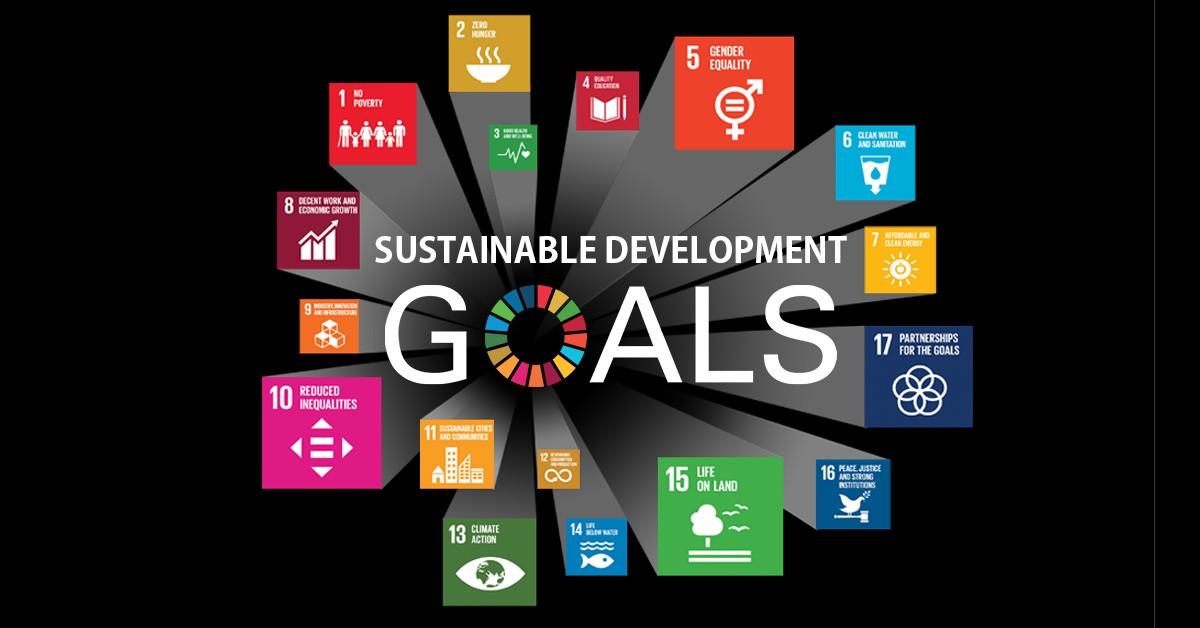
- 04 May 2024
Why is it in the News?
2024 is an election year across the world and newly elected governments need to focus on the all-important sustainability issue.
Context:
- The United Nations Summit on Sustainable Development Goals (SDGs) held in September in New York presented a chance to assess progress toward the lofty Agenda 2030 goal.
- The COVID-19 pandemic and other worldwide crises have made progress towards these goals difficult, despite the fact that they are part of a framework that has been widely agreed upon.
- It is critical to evaluate the state of SDG implementation, investigate critical areas that call for immediate attention, talk about the results of academic studies on the SDGs' political influence, and suggest ways to advance sustainable development.
What is Sustainable Development?
- Sustainable development entails fostering development that fulfils present needs while safeguarding the capacity of future generations to meet their own needs.
- Coined by the Brundtland Commission in its 1987 report, "Our Common Future," this definition remains widely embraced.
- Embracing sustainable development involves collaborative endeavours aimed at constructing an inclusive, sustainable, and resilient future for both humanity and the environment.
What is the Progress and Emerging Challenges in SDG Implementation?
- Slow Progress and Growing Concerns: The path toward achieving the Sustainable Development Goals (SDGs) has been marred by sluggish progress and mounting concerns, casting doubt on the world's ability to attain the 2030 targets.
- Despite initial optimism following the adoption of Agenda 2030 by the UN General Assembly in 2015, reports indicate inadequate progress and deviation from the intended trajectory.
- While there were modest improvements noted between 2015 and 2019, particularly in areas like poverty reduction and access to essential services, they fell significantly short of the necessary benchmarks outlined in the agenda.
- Challenges Amplified by Global Crises: The onset of the COVID-19 pandemic and other global crises has compounded the hurdles in SDG achievement.
- The pandemic, in particular, has triggered profound socioeconomic repercussions, disrupting economies, widening inequalities, and propelling millions into poverty.
- The diversion of resources and attention toward addressing immediate health and economic exigencies has further impeded advancements toward long-term sustainable development objectives.
- Concerns Over Environmental Sustainability: A notable concern arises from the insufficient emphasis on goals related to environmental sustainability and biodiversity conservation.
- Critical objectives such as sustainable consumption and production, climate action, and marine and terrestrial biodiversity preservation have been overlooked, jeopardising the welfare of present and future generations.
- Neglecting these environmental imperatives not only undermines progress toward specific SDGs but also poses existential threats to humanity and the planet.
- Fragmented Approach to SDG Pursuit: Furthermore, the prevailing approach to SDG pursuit often disregards the interconnected and indivisible nature of the goals.
- The SDGs are interlinked, with progress in one goal intricately linked to advancements in others.
- Yet, the disjointed strategies adopted by many nations and stakeholders fail to acknowledge these interconnections, leading to isolated efforts unlikely to yield substantive outcomes.
- Without a holistic and cohesive approach to sustainable development, achieving the overarching objective of harmonising human well-being with environmental health remains elusive.
International Promises and Real-World Execution:
Renewed Pledges from International Leaders:
- Amidst these developments, the UN SDG Report 2023 underscored five critical areas necessitating immediate attention:
- The government's commitment to seven years of accelerated, sustained, and transformative actions to fulfil SDG promises;
- Concrete, comprehensive, and targeted governmental policies to eradicate poverty, mitigate inequality, and combat environmental degradation, prioritising the empowerment of women, girls, and marginalised communities;
- Enhancement of national and subnational capacities, institutional accountability, and governance mechanisms to expedite progress;
- Reaffirmation of the international community's commitment to provide assistance and mobilise resources for developing nations, alongside fortifying the UN development system.
- Acknowledging the gravity of the situation, world leaders reiterated their commitments and pledged intensified efforts to achieve the SDGs, envisioned as the global pathway out of crises by 2030.
- However, the extent to which these global declarations translate into action at the grassroots level remains uncertain.
Challenges in National Implementation:
- Despite governments' global vows, significant disparities often exist between rhetoric and practical implementation on the national stage.
- Political considerations, competing agendas, and resource limitations can impede the effective execution of SDG-related policies.
- Furthermore, inadequate coordination and coherence among various government departments and administrative tiers may lead to fragmented initiatives, diminishing the overall efficacy of SDG implementation efforts.
Academic Perspectives and Suggestions:
- Limited Political Influence: The research highlights that while the SDGs have sparked discussions and prompted some normative and institutional adjustments, their direct political impact at national and local levels remains constrained.
- Despite international endorsement, the SDGs have yet to yield significant political outcomes in many nations, underscoring the necessity for a nuanced understanding of the factors shaping SDG implementation and the pathways for driving political transformation.
- Systemic Strategies for SDG Achievement: The study underscores the significance of embracing a systemic approach to unlock the transformative potential of the SDGs.
- This entails identifying and managing trade-offs while maximising synergies across diverse goals.
- By addressing interconnected challenges comprehensively, policymakers can capitalise on synergistic effects and enhance the efficacy of their interventions.
- For instance, initiatives promoting renewable energy can simultaneously advance climate action (SDG 13), foster economic growth (SDG 8), and improve access to clean water and sanitation (SDG 6).
- Customised Implementation Approaches: Moreover, the study stresses the importance of tailored strategies for SDG implementation tailored to regional and national contexts.
- Cookie-cutter solutions are unlikely to succeed given the varied socio-economic, political, and environmental landscapes in which the SDGs are being pursued.
- Instead, policymakers should identify context-specific entry points and leverage existing resources and capacities to drive progress.
- This may involve targeting specific sectors or geographic areas requiring interventions and engaging marginalized communities to ensure their voices and needs are addressed.
- Pragmatic Steps to Enhance Implementation: Additionally, the study provides pragmatic recommendations for bolstering SDG implementation.
- These encompass strengthening governance frameworks and accountability mechanisms, mobilising financial resources, fostering innovation and technology dissemination, and nurturing partnerships among governments, civil society, the private sector, and other stakeholders.
- By adopting a multi-faceted approach addressing political, economic, social, and environmental dimensions, policymakers can foster an enabling environment for transformative change.
Conclusion
The evaluation of SDG advancement highlights the imperative for swift and collaborative measures to overcome prevailing hurdles and hasten advancement. As 2024 heralds elections in numerous nations, incoming administrations have a chance to elevate sustainability as a focal point and harmonise domestic policies with the SDGs. By infusing sustainability tenets into governance structures and policy formulations, governments can play a pivotal role in expediting SDG attainment.
The Judiciary’s Shadow Over Standard-essential Patents
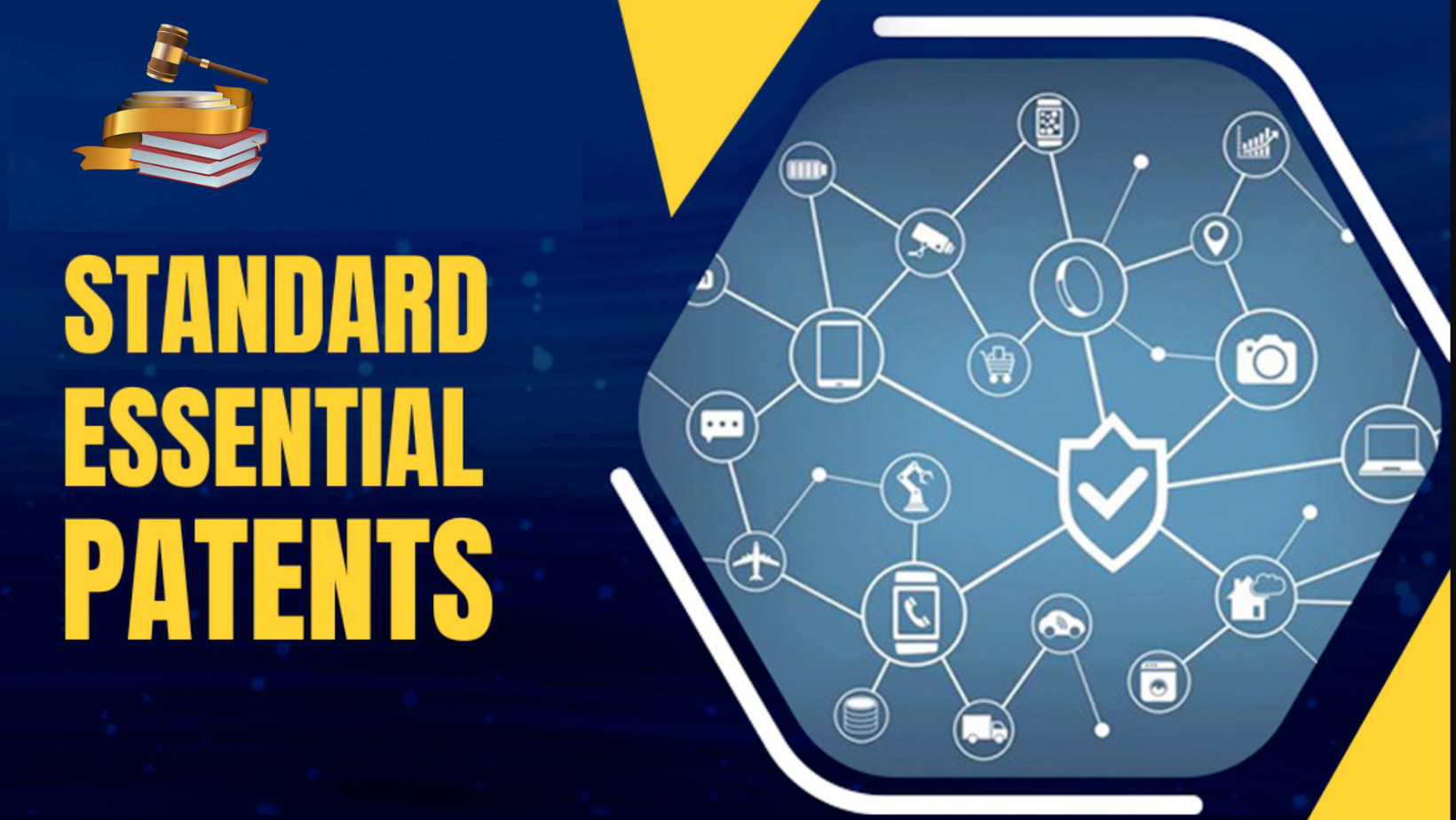
- 03 May 2024
Why is it in the News?
The government must put in place measures to regulate standard essential patents before the judiciary causes further damage to India’s manufacturing dreams.
Context:
- The emergence of Standard Essential Patents (SEPs) and their implications for India's telecom manufacturing industry has become a significant policy issue.
- However, the utilization of SEPs by technology firms presents hurdles, potentially jeopardizing India's domestic manufacturing sector.
- Thus, it is crucial to delve into the intricacies of this matter, scrutinizing the role of SEPs, the regulatory challenges they present, and the necessity for regulatory action.
What are Standard Essential Patents (SEPs)?
- EPS are patents indispensable for implementing a technical standard, particularly prominent in industries like telecommunications reliant on standards such as 3G, 4G, and 5G for seamless device and network communication.
- Typically owned by entities or individuals, these patents are vital for guaranteeing the interoperability and compatibility of products and technologies adhering to specific standards.
- Critical for fostering interoperability and competitiveness in the cellular phone market, EPS covers technologies adopted as industry standards.
- Despite their significance, conflicts over EPS licensing and infringement are common, often resulting in legal disputes and negotiations between companies and patent holders to establish equitable licensing terms.
Significance of Essential Patents and Regulatory Hurdles:
- Essential Patents (EPs) such as CDMA, GSM, and LTE serve as the linchpin of technological standards in the telecom industry, ensuring seamless compatibility among various cellular phone brands.
- However, the standard-setting process, predominantly governed by private Standard Setting Organizations (SSOs), limits India's influence in shaping these standards.
- Consequently, owners of EPs may demand excessive royalties, resulting in the "patent holdup" dilemma.
- Although SSOs strive for fair, reasonable, and non-discriminatory (FRAND) licensing, opacity and anti-competitive behaviours persist, as illustrated by substantial fines levied on companies like Qualcomm by multiple jurisdictions.
Judicial Response to Standard Essential Patents (SEPs) Issues:
- Competition Law Enforcement Inertia: The Competition Commission of India (CCI) commenced an inquiry in 2013 upon a complaint by Micromax against Ericsson, alleging SEP licensing abuse.
- However, Ericsson contested the CCI's jurisdiction, resulting in protracted legal wrangling.
- Despite a favourable ruling for the CCI in 2016, Ericsson's appeals prolonged the case until a final judgment in 2023.
- India, due to this prolonged litigation, remains the sole major economy yet to examine potential anti-competitive SEP licensing practices.
- Patent Infringement Cases and Judicial Engagement: While competition law matters linger, the Delhi High Court actively hears lawsuits by SEP owners against cellular phone manufacturers accused of patent infringement.
- These lawsuits entail intricate trials to ascertain patent validity, infringement, and damages.
- Rather than pausing proceedings pending competition law resolution, the court issues interim measures favouring SEP owners.
- Such measures often mandate manufacturers, many of them Indian, to deposit substantial sums with the court for ongoing production during trials.
- Unprecedented "Deposit" Orders: Issuing "deposit" orders, compelling manufacturers to deposit significant funds before trial, is unprecedented in commercial law.
- These orders, lasting throughout lengthy trials, impose heavy financial burdens on defendants, depriving them of vital working capital.
- While lacking legal foundation and fairness, the Delhi High Court justifies them using its "inherent powers to ensure justice."
- This judicial activism, while aimed at expediting legal proceedings, raises concerns about procedural fairness and equitable treatment of litigants.
Impact of Judicial Interventions and Legal Battles on India's Manufacturing Goals:
- Undermining Investor Confidence and Market Stability: Extended legal battles and judicial interventions sow uncertainty, denting investor trust in India's manufacturing sector.
- Foreign investors may perceive the unpredictable legal environment as a barrier to entering or expanding operations in the nation.
- Uncertainty regarding SEP licensing practices and potential adverse court rulings disrupts market stability, impeding long-term investment planning for both domestic and international enterprises.
- Stifling Growth and Innovation: SEP-related disputes divert attention and resources away from fostering innovation and technological progress in the telecom manufacturing domain.
- Rather than directing efforts towards research and development (R&D) or embracing new technologies, companies become entangled in legal disputes, hindering productive pursuits.
- This diversion of resources curtails innovation, obstructs product development, and undermines India's global competitiveness.
- Impact on Employment and Economy: The manufacturing sector is a vital source of employment and economic advancement, especially in emerging economies like India.
- However, uncertainties surrounding SEP-related litigation pose a threat to job stability and employment opportunities, particularly in the telecom manufacturing sector.
- Protracted legal proceedings and financial burdens may compel companies to downsize operations, leading to workforce reductions and inhibiting future investments.
- Policy Inconsistencies: Contradictions arise between judicial rulings favouring SEP owners and government initiatives to incentivize domestic manufacturing.
- While the government aims to attract investment and bolster indigenous production, SEP-related disputes undermine these objectives.
- The disconnect between supporting manufacturers and overlooking financial burdens imposed by SEP owners questions the coherence of policies promoting industrial growth.
- Long-term Industrial Landscape Implications: Unresolved tensions surrounding SEP licensing practices and judicial handling of disputes cast shadows over India's industrial future.
- Failure to address these issues may deter investors, jeopardize job creation, and impede India's transition to a knowledge-based economy.
- With regulatory intervention to streamline legal processes and ensure fairness, India can catch up to global peers in manufacturing prowess.
Way Forward:
- The European Parliament's proactive stance on regulating SEPs offers valuable lessons for global intervention in this arena.
- Given India's constrained influence in standard-setting and obligations to uphold patents of foreign tech firms, it presents a strong rationale for similar regulatory action.
- Enhancing regulatory frameworks to foster transparency, equity, and non-discriminatory practices in SEP licensing is essential to protect India's economic welfare and foster indigenous manufacturing.
Conclusion
The Indian government must prioritize resolving regulatory uncertainties regarding SEPs to protect domestic manufacturers' interests and drive industrial advancement. Regulatory actions should strive for a harmonious balance between technology firms' interests and overarching goals of economic progress, innovation, and consumer protection. Through decisive intervention, India can assert its autonomy, cultivate fair competition, and cultivate an environment conducive to investment and innovation.
Analysing Labour on a Warming Planet
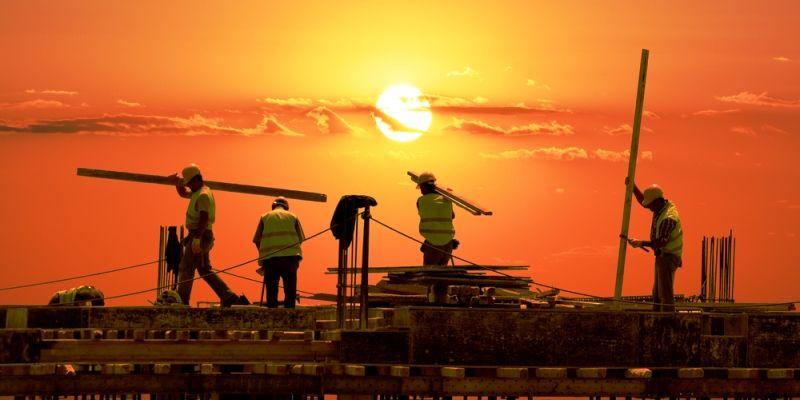
- 02 May 2024
Why is it in the News?
The latest report from the International Labour Organization (ILO), titled 'Safeguarding Workers in a Changing Climate', underscores the pressing necessity to ensure the resilience of labour in the face of climate change.
Context:
- The International Labour Organisation (ILO) recently released a report titled "Ensuring Safety and Health at Work in a Changing Climate," highlighting the urgency of climate-proofing labour practices to protect workers' well-being.
- As the planet experiences warming, workplace environments evolve, and the ILO emphasizes the need to update occupational safety and health (OSH) regulations to address emerging risks.
- According to the report, over one-third of the global population is exposed to extreme heat each year, resulting in nearly 23 million work-related injuries.
- The ILO urges an overhaul of existing OSH laws and protections, as they have not kept pace with climate change-related hazards, leading to increased worker mortality and morbidity.
What Are the Emerging Climate-Related Risks?
- The International Labour Organization (ILO) has identified six primary impacts of climate change:
- Excessive heat
- Ultraviolet (UV) radiation
- Extreme weather events
- Workplace air pollution
- Vector-borne diseases
- Agrochemicals
- These hazards can result in various health issues such as stress, stroke, and exhaustion. Particularly vulnerable to these risks are workers in sectors like agriculture, construction, urban conservation, transportation, and tourism.
- Of significant concern is the rising prevalence of gig employment globally, which is particularly susceptible to heat-related conditions.
- In India, gig workers, including ride-hailing app drivers, food and grocery delivery personnel, home repair technicians (electricians, plumbers, AC mechanics), and courier service employees, constitute approximately 1.5% of the total workforce, a figure projected to reach 4.5% by 2030 according to a Nasscom study.
- In the Indian context, the collective impact of these segments suggests that approximately 80% of the country's workforce, projected to be 600 million by 2023, is vulnerable to heat-related hazards.
- This staggering figure exceeds the entire current population of South America by 180 million.
Which Sectors Bear the Brunt of Climate Impact?
Agriculture Sector:
- Globally, agriculture stands out as the most heat-vulnerable sector, particularly in developing nations where informal farm labourers toil without adequate weather protection.
- In India, where agriculture and allied activities employed about 45.76% of the workforce in 2022-23 according to Union Agriculture Minister Arjun Munda, there's a concerning trend of decline from levels three decades ago.
- NSSO data from July 2018 to June 2019 reveals that nearly 90% of Indian farmers own less than two hectares of land, with incomes hovering around ?10,000 monthly on average.
- The situation is even direr in states like Jharkhand, Odisha, and West Bengal, where farmers' earnings can be as low as ?4,895, ?5,112, and ?6,762 respectively.
- Additionally, half of India's farmers are burdened with debt and lack access to modern agricultural technology, impeding their ability to adapt to a warming climate.
- Many communities have already adjusted work schedules to avoid peak heat hours, while the ILO recommends increased hydration facilities, breaks, and shaded rest areas in plantations.
Micro, Small and Medium Enterprises (MSME) Sector:
- Following agriculture, India's MSME sector employs over 123 million workers, accounting for about 21% of the workforce.
- Despite its significant contribution to exports and manufacturing output, the sector's pervasive informality has led to minimal oversight of worker conditions by state Occupational Safety and Health (OSH) departments, rendering workers highly susceptible to heat-related risks.
Building & Construction Sector:
- The building and construction industry, with around 70 million workers constituting almost 12% of India's workforce, faces unique challenges exacerbated by urbanization.
- Workers in this sector contend with the urban heat island effect, heightened by rapid urban growth.
- Moreover, they are disproportionately exposed to physical injuries and air pollution-related health hazards, such as asthma, given the alarming pollution levels in many Indian cities.
Legislation Safeguarding Worker Rights in India:
- Central Laws: Integral to ensuring workplace safety in India are the Factories Act, the Workmen Compensation Act, and the Building and Other Construction Workers Act.
- These laws encompass various facets of labour rights and welfare, addressing conditions within factories and providing compensation for work-related injuries.
- Occupational Safety, Health, and Working Conditions Code, 2020 (OSH Code, 2020): Introduced in 2020, the OSH Code represents a comprehensive effort to consolidate and revise existing legislation pertaining to workplace safety.
- Its primary objective is to streamline and strengthen the legal framework governing occupational safety and health nationwide.
- By amalgamating disparate regulations into a unified code, it aims to establish a more cohesive and effective system for ensuring workplace safety across diverse sectors and industries.
State Laws in Tamil Nadu and Maharashtra:
- Tamil Nadu: Tamil Nadu formulated its regulations under the Factories Act as early as 1950.
- These regulations stipulate a maximum wet bulb temperature of 30°C on shop floors and outline requirements for adequate air circulation.
- However, they lack specific provisions for thermal comfort tailored to varying activity levels or modern cooling solutions, indicating a need for updated standards.
- Maharashtra: Similarly, Maharashtra devised its rules under the Factories Act in 1963. Like Tamil Nadu, these regulations address maximum wet bulb temperatures and air circulation standards.
- Nevertheless, they also lack detailed provisions for contemporary cooling methods or adjustments for thermal comfort aligned with evolving production processes, underscoring the necessity for modernization.
Challenges in Addressing Heat Hazards:
- Regulatory Ambiguity: Existing regulations lack specificity regarding thermal comfort standards and the integration of air conditioning in workplaces.
- There's a pressing need to update regulations to accommodate modern cooling technologies and ensure the well-being and safety of workers.
- Impact of the Gig Economy: The burgeoning gig economy in India exacerbates workers' vulnerability to heat-related risks.
- Many gig workers, comprising a substantial portion of the workforce, often operate without adequate protections or support systems to mitigate extreme heat conditions.
- Pressures on Labor Unions: Labour unions face mounting pressures from management and bureaucratic entities, often prioritizing industry interests over worker welfare.
- This dynamic can result in the neglect of worker safety concerns pertaining to heat hazards and other climate-related risks.
- Effluent and Byproduct Management: The disposal of effluents and byproducts poses significant health risks, particularly with fluctuating temperatures, necessitating robust management strategies to safeguard worker health.
- Silicosis in Mining and Quarries: The escalating prevalence of silicosis, stemming from silica exposure in mines and quarries, presents a profound occupational health challenge that demands urgent attention and intervention.
- Shortcomings in Labor Inspection Departments: Vacancies and a lack of expertise within labour inspection departments undermine effective oversight of workplace safety measures, hindering the enforcement of regulations and exacerbating risks for workers.
Way Forward:
- Modernize Regulatory Frameworks: Revamp existing regulations to include clear guidelines on thermal comfort and air conditioning standards in workplaces.
- Integrate innovative cooling technologies to ensure the safety and well-being of workers.
- Empower Labor Unions: Strengthen labour unions and equip them with the resources needed to advocate for worker welfare and safety.
- Foster collaboration among unions, management, and governmental bodies to effectively tackle heat hazards.
- Enhance Labor Inspection Mechanisms: Boost staffing and training within labour inspection departments to enhance oversight of workplace safety.
- Conduct regular inspections and rigorously enforce safety regulations to shield workers from climate-related risks.
- Invest in Research and Development: Allocate funding for research initiatives focused on developing climate adaptation strategies tailored to various industries.
- Support studies assessing the efficacy of interventions and technologies in mitigating heat hazards and other climate-related risks.
- Raise Awareness and Education: Launch awareness campaigns to educate workers, employers, and the public about the health implications of climate change.
- Provide training programs on heat stress management and preventive measures to bolster resilience in vulnerable sectors.
Conclusion
Amidst the challenges posed by climate change, safeguarding workplace safety and health emerges as a critical imperative. The ILO report highlights a pressing call for a globally accepted regulatory framework to fortify workplaces against climate-related risks and safeguard workers. Achieving this necessitates concerted action from governments, industries, and workers alike to address evolving hazards and uphold the well-being of workers amidst the changing climate landscape.
Constitution and the Redistribution of Wealth
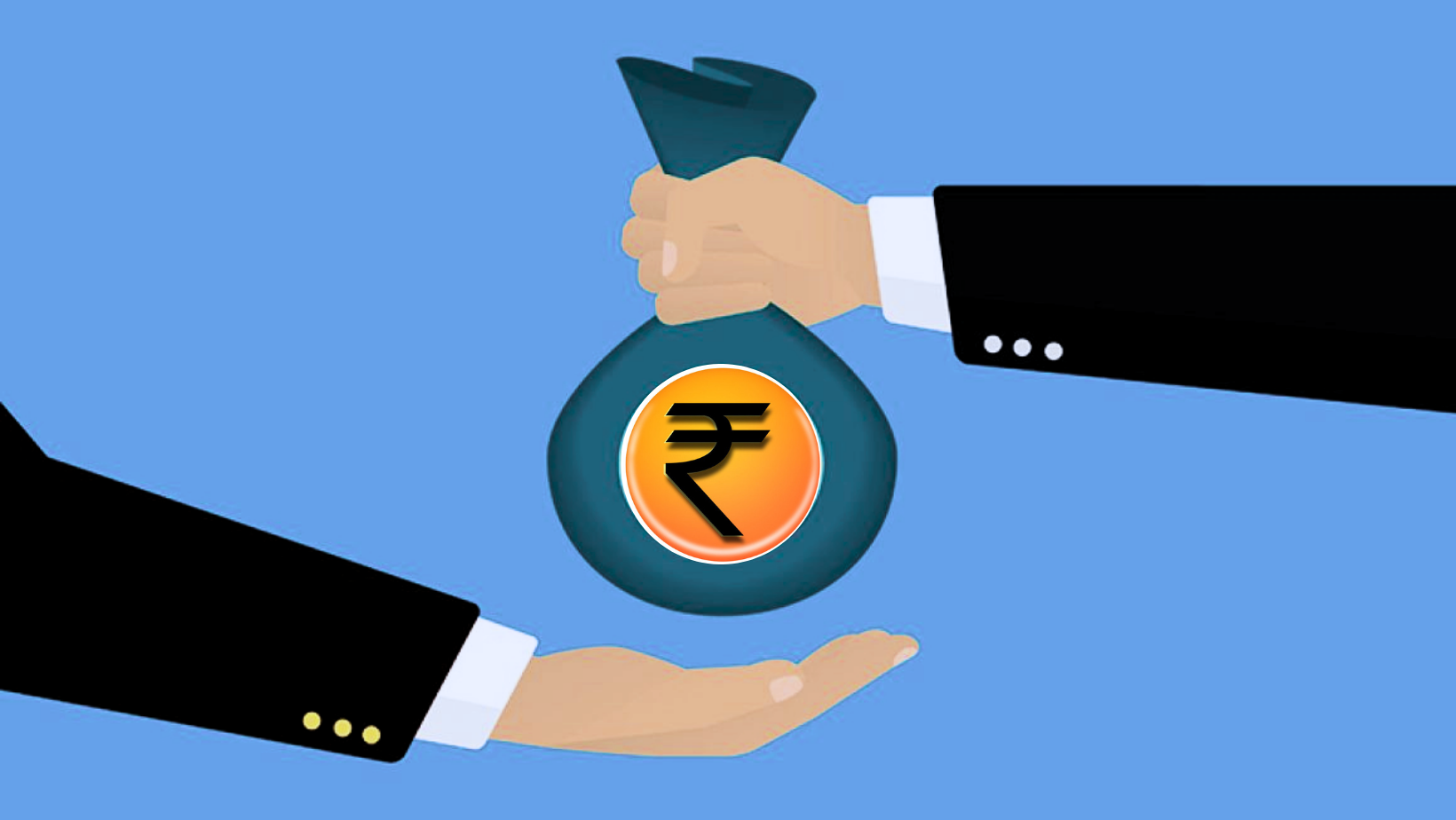
- 01 May 2024
Why is it in the News?
During the ongoing election campaign, there have been intense debates between the ruling government and the Opposition regarding wealth redistribution, while the SC has formed a nine-judge Bench to interpret the DPSP concerning ownership and control of material resources.
Context:
- Congress leader Rahul Gandhi during the Lok Sabha campaign said that there will be a financial survey to determine the distribution of wealth in the country for addressing the issue of inequality.
- The ruling BJP targeted Gandhi and alleged that Congress if elected, would bring back the "socialistic model" of economics and hinder India's growth as an economy.
What is Wealth Redistribution?
- The meaning of wealth redistribution is the transfer of wealth from one individual to another through a social mechanism such as taxation, charity, or public services.
- One biggest example of wealth redistribution would be income tax wherein higher earnings pay a higher percentage of tax compared to lower-income earners.
- Proponents of this exercise note that wealth redistribution is necessary to bridge the inequality gap between members of society.
- And in India, the gap between the rich and the poor is only growing further.
- As per a recent study, the country’s richest one per cent of the population now owns 40 per cent of the country’s wealth.
- According to the report titled Income and Wealth Inequality in India: The Rise of The Billionaire Raj, and published by The World Inequality Lab, “the inequality gap widened after the economy’s opening up in the early 1990s, but “between 2014-15 and 2022-23, the rise of top-end inequality has been particularly pronounced in terms of wealth concentration”.
- Based on figures from the World Inequality Database, India’s income inequality is among the very highest in the world, behind only Peru, Yemen and a few other small countries.
What Does India’s Constitution Say on Wealth Distribution?
- The Preamble to the Constitution aims to secure for all citizens social and economic justice, liberty and equality.
- Part III of the Constitution lists down the fundamental rights that guarantee liberty and equality while Part IV contains the DPSP.
- These are principles that the central and State governments should follow to achieve social and economic justice in our country.
- Unlike the fundamental rights in Part III, the DPSP is not enforceable in court.
- They are nevertheless fundamental in the governance of the country.
- Article 39(b) and (c) in Part IV contain principles that are aimed at securing economic justice.
- They provide that ownership and control of material resources of the society should be distributed to serve the common good and that the operation of the economic system does not result in the concentration of wealth to the common detriment.
- India’s Constitution-makers haven’t explicitly spoken of wealth redistribution.
- It’s noteworthy that when Article 39 (Draft Article 31) was being added to the Constitution, it was heavily debated.
- The economist KT Shah wanted the Constitution to outrightly prevent the creation of monopolies in industries.
- In agreement with him was Shibban Lal Saxena, who wanted it to be explicitly put down that the State shall control a few key industries.
- However, there were others Naziruddin Ahmad, who were not comfortable with the Constitution endorsing contested political and economic ideologies.
What is the Historical Context of the Redistribution of Wealth?
- The Constitution originally guaranteed the right to property as a fundamental right under Article 19(1)(f).
- It is provided under Article 31 that the state shall pay compensation in case of the acquisition of private property.
- It is pertinent to note that at the time of independence, the main property rights related to agricultural and other land.
- The government had to acquire the rights in such estates for carrying out land reforms and the construction of public assets.
- Considering the inadequate resources of the government and in order to provide greater flexibility in acquiring land for public welfare, various amendments were carried out curtailing the right to property.
- The Supreme Court in various cases has interpreted the relationship between fundamental rights and the DPSP.
- Most of these cases were against constitutional amendments made by the state that curtailed the right to property which was then a fundamental right.
- In the Golak Nath case (1967), the Supreme Court held that fundamental rights cannot be abridged or diluted to implement DPSP.
- Finally, in the Kesavananda Bharati case (1973), a thirteen-judge Bench of the Supreme Court upheld the validity of Article 31C but made it subject to judicial review.
- In the Minerva Mills case (1980), the Supreme Court ruled that the Constitution exists on a harmonious balance between fundamental rights and DPSP.
- In 1978, in order to avoid excessive litigation directly in the Supreme Court by the propertied class, the 44th Amendment Act omitted the right to property as a fundamental right and made it a constitutional right under Article 300A.
- The right to private property continues to be an important constitutional cum legal right.
- Any law to acquire private property by the state should be only for a public purpose and provide adequate compensation.
What is the Current Debate on the Redistribution of Wealth?
- The government of India in the first four decades after independence followed a “socialistic model” of economy.
- The economic policies resulted in the nationalisation of banking and insurance, extremely high rates of direct taxes (even up to 97%), estate duty on inheritance, tax on wealth etc.
- The rationale behind these measures during those times was to reduce inequality and redistribute wealth among the poorer sections that constituted the majority of the population.
- However, such measures stifled growth and also resulted in the concealment of income/wealth.
- Taxes like estate duty and wealth tax generated revenue that was much less than the cost incurred in administering them.
- The nineties saw the country move from a closed economy towards liberalisation, globalisation and privatisation.
- A new industrial policy was unveiled in 1991 with the objective of empowering market forces, improving efficiency and rectifying deficiencies in the country’s industrial structure.
- Estate duty was abolished in 1985 and wealth tax in 2016.
- The market-driven economy has resulted in additional resources for the government that has helped in bringing people out of abject poverty.
- Nonetheless, this economic system has also resulted in growing inequality.
- A report by the World Inequality Lab states that the top 10% of the country’s population have a share of 65% and 57% of the wealth and income respectively as of 2022-23.
- The bottom 50% on the other hand have a meagre share of 6.5% and 15% of the wealth and income respectively.
- The manifesto for the current Lok Sabha elections of the Congress promises that there will be a financial survey to ascertain the distribution of wealth among the people in the country and address the issue of inequality.
- The ruling party campaigners led by the PM have targeted the Opposition on this matter.
- The SC meanwhile has constituted a nine-judge Bench to interpret whether material resources under Article 39(b) include private resources as well.
Way Forward:
- Growing inequality is a worldwide problem of a liberalised open-market economic system.
- It is the responsibility of the government to protect the interest of the poorer classes who are most dependent on the state machinery for their livelihood.
- At the same time past policies of extremely high tax rates, estate duty, wealth tax etc., did not achieve their desired goals. Instead, they only led to the concealment of income and wealth.
- Innovation and growth should not be curtailed but the benefits of growth should reach all sections especially the marginalised.
- It's essential to design inclusive policies through informed debates, aligning with current economic models, to ensure that the benefits of growth reach marginalized sections, in line with the constitutional principle of economic justice for all.
Conclusion
The debate on wealth redistribution in India underscores the complex challenge of balancing economic growth with equitable resource allocation. While past policies have had mixed results, it remains essential for the government to protect vulnerable populations and promote inclusive growth. To achieve this, policymakers must foster innovation while ensuring the benefits reach marginalized communities. By designing policies aligned with current economic models and adhering to the constitutional principle of economic justice, India can work towards a future where growth and social equity coexist harmoniously.
Analysis of Curative Jurisdiction of the Supreme Court in Legal Dispute
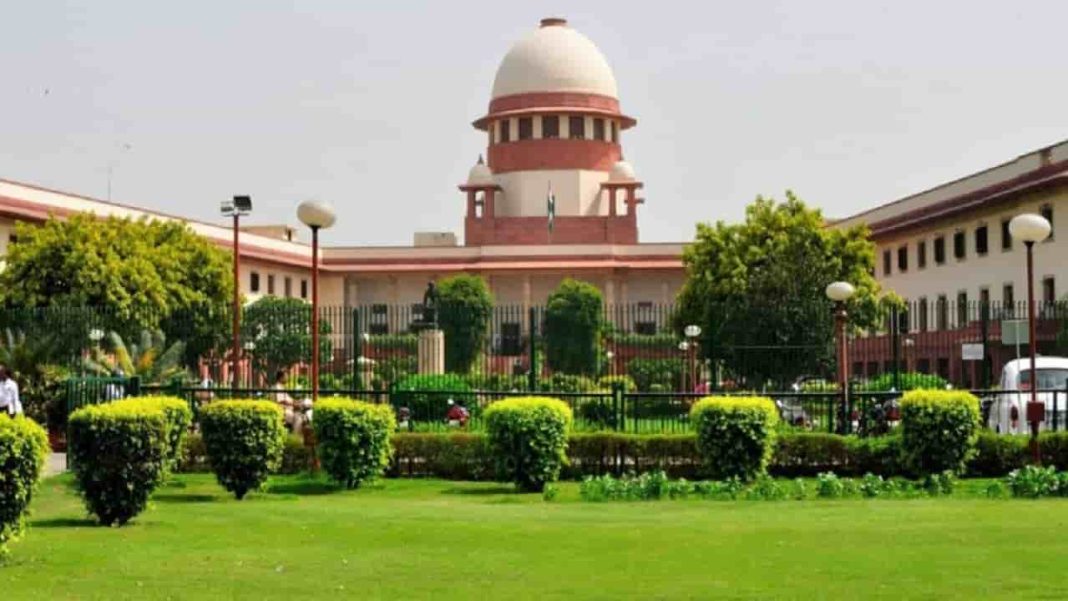
- 27 Apr 2024
Why is it in the News?
Recently, the Supreme Court (SC), in the judgment of Delhi Metro Rail Corporation Ltd (DMRC) vs Delhi Airport Metro Express Pvt Ltd (DAMEPL), set aside the arbitral award by exercising its curative jurisdiction.
Context:
- The Supreme Court of India holds a multifaceted role, serving as the apex court of appeal, a federal court, and an advisory body.
- One of its significant powers is the Curative Jurisdiction, established in 2002, which empowers the Court to rectify its judgments even after they have become final.
- However, the utilization of this jurisdiction has triggered discussions concerning its implications for judicial stability and the Supreme Court's role in shaping legal precedents.
What is the DMRC vs DAMEPL Case?
- The case dates back to 2008 when the DMRC entered into a PPP with the Delhi Airport Metro Express Private Limited (DAMEPL), a consortium led by Reliance Infrastructure Ltd, for the Delhi Airport Metro Express project.
- However, disputes arose between the two parties, leading to the termination of the agreement by DAMEPL in 2013.
- In 2017, an arbitration tribunal ruled in favor of DAMEPL and ordered DMRC to pay nearly Rs 8,000 crore.
- DMRC challenged this ruling in the Delhi High Court, which overturned the arbitral award in 2019.
- DAMEPL then appealed to the Supreme Court, which in September 2021 reversed the High Court's decision and upheld the arbitral award.
- However, in a recent judgment, the Supreme Court has now ruled in favor of DMRC, stating that there was a "fundamental error" in its previous judgment.
Significance of the Supreme Court’s Decision:
- Firstly, it underscores the importance of curative petitions in correcting grave injustices in legal judgments.
- Curative petitions are sparingly used and are only permitted on narrow, procedural grounds.
- The Supreme Court's decision to grant relief to DMRC highlights the court's commitment to rendering justice in its true sense.
- Secondly, the decision has implications for PPPs in infrastructure projects.
- PPPs play a crucial role in infrastructure development, but disputes between public and private entities can arise, leading to legal battles.
- The Supreme Court's decision provides clarity on the legal framework governing PPPs and sets a precedent for future disputes in similar projects.
- Lastly, the decision has implications for investor confidence.
- The Supreme Court's exercise of curative jurisdiction in this case, almost two and a half years after its final verdict, demonstrates the court's willingness to correct errors and ensure justice.
- This is likely to boost investor confidence in India's legal system and encourage investment in infrastructure projects.
Difference Between a Curative Petition and Curative Jurisdiction:
Curative Petition:
- A curative petition is a specific legal remedy available within the framework of curative jurisdiction.
- It is a petition filed by a party to the case that has exhausted all other legal remedies and seeks the correction of a judgment that may have resulted from a violation of principles of natural justice or a gross miscarriage of justice.
- The grounds for filing a curative petition typically include the discovery of new evidence or legal errors that were not apparent earlier.
- Curative petitions are relatively rare and are considered as a last resort to correct errors in judgment.
Curative Jurisdiction:
- Curative jurisdiction refers to the broader authority of the Supreme Court to review and rectify its judgments to prevent gross miscarriages of justice.
- It is a power vested in the Supreme Court to ensure that fundamental principles of justice and fairness are upheld, even after a judgment has become final.
- Curative jurisdiction allows the Supreme Court to revisit its decisions if it perceives a need to prevent manifest injustice or correct egregious errors that may have escaped earlier notice.
- While curative petitions are one mechanism through which curative jurisdiction is exercised, the Supreme Court may also suo motu invoke curative jurisdiction in exceptional cases without a formal petition being filed.
Impact and Implications of Curative Jurisdiction:
- Impact on Arbitral Awards' Integrity: A central apprehension surrounding curative jurisdiction is its potential to affect the integrity of arbitral awards.
- Arbitration relies on the conclusiveness and enforceability of awards for its efficacy.
- When the Court intervenes in arbitral decisions, particularly amid concerns of judicial overreach, it risks undermining arbitration's core principles, such as party autonomy and swift dispute resolution.
- Balancing Judicial Consistency and Flexibility: The dichotomy between judicial consistency and flexibility emerges concerning curative jurisdiction.
- While consistent legal interpretation fosters stability and predictability, it may stifle innovation. Conversely, excessive flexibility can breed uncertainty, eroding public trust in the judiciary.
- Examining the Scope of Judicial Review: Curative jurisdiction prompts queries about the extent of judicial review and its boundaries.
- While the Court's role as the ultimate legal interpreter is clear, intervening in its judgments without impinging on legislative or executive domains requires meticulous consideration.
- Implications for Legal Precedents: The significance of Supreme Court judgments in maintaining legal coherence is undeniable.
- However, curative jurisdiction may disrupt established precedents, casting doubt on the binding nature of judicial decisions.
- The Court must exercise judiciousness to rectify errors without compromising the legal framework's integrity.
- Public Perception and Judicial Trust: The Court's credibility hinges on its impartiality and integrity in dispensing justice.
- Excessive or arbitrary curative interventions may undermine public confidence in the judiciary, diminishing its authority as a legal arbiter.
- The Court must exercise curative powers prudently to maintain public trust in the judiciary.
Critical Analysis of Judicial Instability:
- Challenging Legal Certainty: Legal certainty, a cornerstone of the rule of law, demands consistency and predictability in legal outcomes.
- The use of curative jurisdiction, particularly in overturning final judgments, jeopardizes this certainty by casting doubt on the conclusiveness and enforceability of judicial decisions.
- Such uncertainty undermines parties' confidence in the stability of the legal framework, fostering confusion and mistrust in the judicial process.
- Diminishing Judicial Authority: Judicial stability is intrinsic to the authority and credibility of the judiciary.
- When the Supreme Court reverses its own judgments through curative measures, it risks appearing indecisive and inconsistent, eroding its status as the ultimate arbiter of the law.
- This erosion of authority undermines public trust in the judiciary, fostering skepticism about the fairness and impartiality of judicial proceedings.
- Disrupting Legal Precedent: The stability of legal precedent is vital for maintaining coherence and consistency in the legal system.
- However, the exercise of curative jurisdiction introduces the potential for disrupting established precedents and fostering inconsistency in judicial rulings.
- This undermines the reliability of legal principles, creating confusion among legal practitioners, litigants, and lower courts.
- Moreover, frequent reversals of judgments hinder the development of clear and consistent legal doctrines, impeding the evolution of the law.
- Risk of Judicial Overreach: Judicial stability acts as a safeguard against judicial overreach, ensuring that the judiciary respects its constitutional limits and upholds the separation of powers.
- However, the use of curative jurisdiction raises concerns about the Court's propensity to exceed its authority and intrude into the domains of the legislative and executive branches.
- By revisiting and overturning its own judgments, the Court risks overstepping its role and undermining the principles of checks and balances inherent in a democratic system.
Ways Forward for Balancing Judicial Oversight Stability:
- Fostering Judicial Accountability: Upholding judicial oversight, including the use of curative jurisdiction, is vital for ensuring judges are accountable and adhere to legal standards.
- It offers a mechanism to rectify errors and address any judicial misconduct.
- However, excessive oversight risks compromising judicial independence and impartiality, undercutting the judiciary's ability to fairly adjudicate disputes.
- Preserving Legal Stability: Legal stability is crucial for fostering predictability and confidence in the legal system.
- By upholding established precedents and minimizing disruptions to settled legal principles, the judiciary promotes legal stability.
- Nevertheless, the exercise of curative jurisdiction introduces uncertainty by allowing the Court to revisit and potentially reverse its judgments, challenging the stability of legal doctrine and the reliability of judicial decisions.
- Respecting the Separation of Powers: Striking a balance between judicial oversight and stability requires respecting the separation of powers and acknowledging the distinct roles of the judiciary, legislature, and executive.
- While the judiciary plays a critical role in interpreting and applying the law, it must exercise restraint to avoid intruding into the domains of other branches of government.
- The use of curative jurisdiction should be guided by principles of judicial deference and deference to legislative intent, particularly in matters where judicial intervention could undermine democratic processes or policy decisions.
Conclusion
The Supreme Court's Curative Jurisdiction is a potent mechanism for rectifying judicial mistakes, yet it presents hurdles to judicial stability and coherence. The DMRC vs DAMEPL case highlights the necessity for a balanced approach in reconciling judicial oversight with legal predictability. Ultimately, as the ultimate arbiter of the law, the Court must carefully wield its curative authority to uphold public trust in the legal system's integrity.
The Reality of the Swachh Bharat Mission
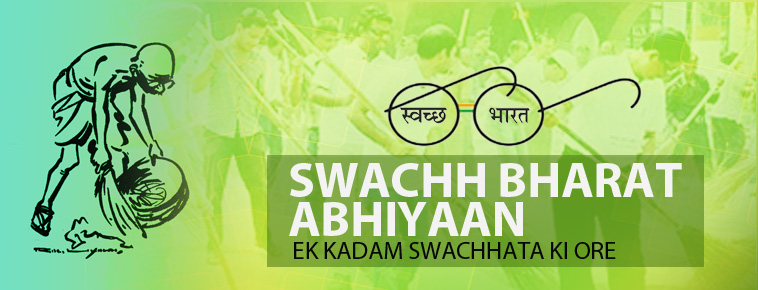
- 25 Apr 2024
Why is it in the News?
A scheme fully owned by the state has become a toolkit for privatisation of public health services and continues caste discrimination.
Context:
- India was ranked right at the bottom of 180 countries in the Environment Performance Index (EPI) in 2022.
- This index evaluates countries based on their performance in addressing climate change, maintaining environmental health, and preserving ecosystem vitality.
- It assesses 40 performance indicators across 11 issue categories, encompassing areas like air quality, access to drinking water, and sanitation.
- In response to this ranking, the government expressed reservations, citing flaws in the methodology that, according to them, fail to accurately capture the Indian scenario.
- Over the past decade, the Modi government has launched several development campaigns, including the Swachh Bharat Mission, the Atal Mission for Rejuvenation and Urban Transformation, the Pradhan Mantri Awas Yojana, and the National Clean Air Programme.
- These endeavors are geared towards enhancing living standards and addressing various socio-economic challenges.
- However, despite these efforts, there remains a noticeable rise in the population's vulnerability due to environmental issues like air and water pollution.
About Swachh Bharat Mission:
- Swachh Bharat Mission, the world’s largest sanitation initiative was launched by the Prime Minister of India in 2014 to achieve an Open Defecation Free India by October 2, 2019, as a tribute to Mahatma Gandhi.
- The programme led to the construction of over 10 crore individual household toilets, taking sanitation coverage from 39% in 2014 to 100% in 2019 when around 6 lakh villages declared themselves Open Defecation Free (ODF).
- The second phase of the mission aims to sustain the open defecation-free status and improve the management of solid and liquid waste, while also working to improve the lives of sanitation workers.
- The mission aimed at progressing toward target 6.2 of the Sustainable Development Goal Number 6 established by the United Nations in 2015.
- By achieving the lowest open defecation-free status in 2019, India achieved its Sustainable Development Goal (SDG) 6.2 health target in record time, eleven years ahead of the UN SDG target of 31 December 2030.
- The mission was split into two: rural and urban.
- In rural areas "SBM - Gramin" was financed and monitored through the Ministry of Drinking Water and Sanitation (since converted to the Department of Drinking Water and Sanitation under the Ministry of Jal Shakti) whereas "SBM - urban" was overseen by the Ministry of Housing and Urban Affairs.
- The rural division has a five-tier mechanism: central, state, district, block panchayat, and gram panchayat.
- As part of the campaign, volunteers, known as Swachhagrahis, or "Ambassadors of cleanliness", promoted the construction of toilets using a popular method called Community-Led Total Sanitation at the village level.
Critique of the Swachh Bharat Mission (SBM):
Discrepancy between Goals and Outcomes:
- The Swachh Bharat Mission (SBM) and its successor, SBM 2.0, set out ambitious objectives to achieve garbage-free cities, garnering political support across party lines.
- However, the reality on the ground paints a different picture.
- Despite government assertions of India achieving open defecation-free status, reports from the Comptroller and Auditor General in 2020 raised doubts about the program's effectiveness, highlighting issues such as substandard toilet construction and inadequate waste treatment.
- In urban areas, certain communities, particularly those residing in slums, continue to lack access to essential sanitation facilities, exacerbating existing inequalities.
- In rural and peri-urban regions, the lack of integration between toilet construction and waste management has led to environmental contamination and health hazards.
Perpetuation of Power Dynamics and Inequalities:
- Sanitation and waste management in India are deeply entrenched in caste dynamics, historically burdening marginalized communities with sanitation tasks.
- Despite attempts by SBM to promote the idea of shared responsibility, the underlying power dynamics persist.
- The introduction of capital-intensive technologies aimed at mechanizing waste management processes has not yielded the desired outcomes, resulting in health crises due to improper waste disposal practices.
- The outsourcing of sanitation work to private contractors, often employing members of marginalized communities, has further entrenched caste-based discrimination.
- Government emphasis on procuring expensive machinery for waste management, funded through public resources, has inadvertently facilitated the privatization of public health services, exacerbating existing inequalities.
Technological Solutions and Implementation Challenges:
- While the government has invested in technological solutions such as waste-to-energy plants and biological methanation, their effectiveness remains limited, with few success stories to showcase.
- Challenges persist in the implementation of these solutions, leading to a lack of tangible improvements in solid waste management across many towns and cities.
Gap in Sanitation Inspection Infrastructure:
- A significant gap in the sanitation inspection infrastructure exists within Himachal Pradesh, as revealed during a recent case in the State's High Court.
- On March 30, 2024, it was disclosed that the Shimla Municipal Corporation, consisting of 34 wards, has only five sanitation inspectors.
- Moreover, the decision to declare this cadre dead after retirement raises concerns about the State's commitment to addressing sanitation issues effectively.
- With more than 50 municipal bodies in Himachal Pradesh and only 20 sanitation inspectors available, it is clear that several municipalities lack essential sanitation inspection personnel.
The interconnectedness of Environmental Performance Index (EPI) and Development Campaigns:
- The EPI offers a comprehensive assessment of a country's environmental health and sustainability efforts.
- One critical aspect of the EPI is mapping, which exposes the shortcomings and unsustainability of current development processes.
- In light of a recent Supreme Court judgment acknowledging the links between climate change and basic human rights, it is evident that development models must be reevaluated and adjusted.
- The interconnectedness of the EPI and various development campaigns cannot be ignored, as the consequences of climate change directly impact human well-being and rights.
- With climate scientists attributing current environmental problems to anthropogenic and systemic factors, it is essential to consider the broader implications of the EPI when planning and implementing development initiatives.
Conclusion
To tackle India's environmental challenges, a comprehensive strategy prioritizing sustainability, equity, and social justice is essential. This involves reassessing development strategies, strengthening enforcement, and encouraging community participation in environmental governance. Addressing implementation issues and linking policies to human rights can improve India's EPI performance and foster a sustainable future.
Reversing the Global Democratic Recession
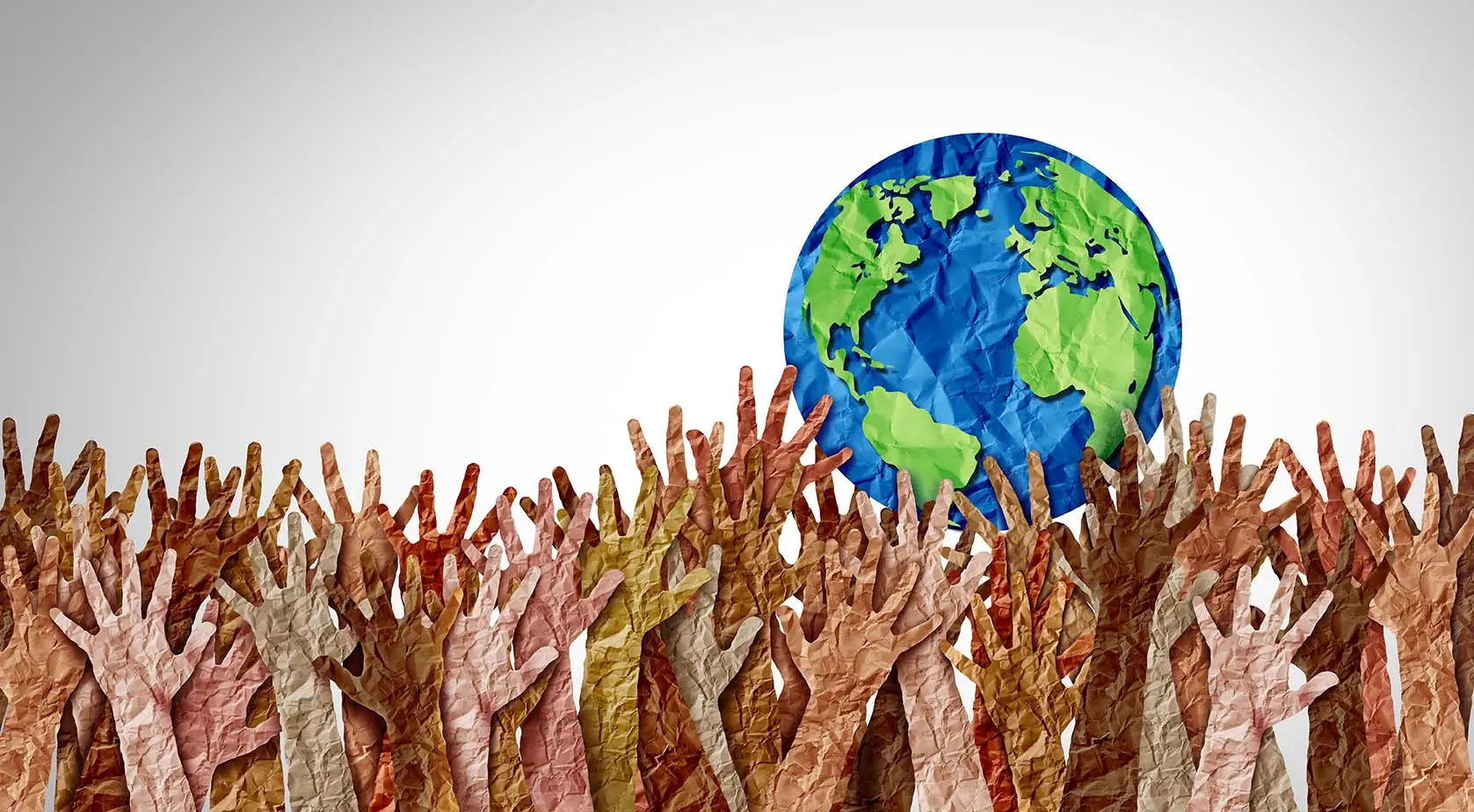
- 24 Apr 2024
Why is it in the News?
Despite the disillusionment, for a variety of reasons, the need to fortify democratic foundations has to be ongoing and collaborative.
Context:
- India is in the midst of its most significant electoral exercise and it might be worthwhile to scrutinize people’s changing perceptions about their political ecosystems in both the largest democracy and other smaller democratic spaces elsewhere.
- Such an exercise may help us understand the prevailing global situation and work on the future course of action.
- Drawing insights from an extensive Pew Research Centre survey spanning 24 nations, examining the evolving attitudes toward democratic governance becomes imperative to grasp the broader global context and chart potential pathways forward.
Why Worldwide Decline in Confidence in Democratic Systems?
- According to the Pew Research Centre's extensive 2023 global survey, which included 30,861 participants, there is a notable decline in faith in democratic institutions across the globe.
- Although 77% of respondents still hold optimism for representative democracy, there is growing openness to alternative governance structures.
- Of concern is the diminishing support for representative democracy since 2017, juxtaposed with increased approval for direct democracy, rule by experts, and authoritarian regimes.
Regional Dynamics and Emerging Trends in Perceptions of Governance:
- Shifting Preferences Towards Expert Rule and Authoritarianism: A noticeable inclination towards endorsing rule by experts and authoritarian forms of governance is observed across different regions.
- This trend is particularly conspicuous in nations grappling with economic instability, political turbulence, or perceived inefficiencies within democratic structures.
- In such contexts, citizens often perceive democratic systems as sluggish and inadequate in addressing urgent challenges, fostering a growing appeal towards centralized authority and decisive leadership.
- Influence of Socioeconomic Factors: Socioeconomic circumstances significantly shape preferences in governance.
- Individuals from lower-income countries with limited educational access tend to show support for authoritative leadership and military rule.
- This inclination may stem from a desire for stability and economic advancement, as authoritarian regimes are perceived as more effective in delivering immediate solutions to complex issues.
- Cultural and Historical Context: Variations in democratic perceptions are also influenced by cultural and historical backgrounds.
- Nations with past experiences of authoritarian rule or centralized governance structures may exhibit greater openness to authoritarian models.
- Additionally, cultural norms regarding leadership, hierarchy, and decision-making processes impact attitudes toward democracy and alternative governance models.
- Resistance to Authoritarian Trends in Certain Regions: Despite the rise in authoritarian sentiments in some areas, resistance to such ideologies persists in others.
- Regions with strong traditions of liberal democracy, including Canada, Europe, Scandinavia, and the United States, continue to prioritize democratic values and institutions.
- Here, a steadfast commitment to democratic principles, civil liberties, and the rule of law acts as a barrier against the erosion of democratic norms.
Evolution of Democratic Perceptions in India:
- Transition towards Strong Leadership: Recent years have witnessed a discernible transformation in Indian views on democracy, characterized by a diminishing preference for representative democracy and a growing inclination towards authoritative leadership.
- In 2017, 44% of Indians favored representative democracy, a figure that declined to 36% by 2023.
- Conversely, support for a commanding leader with substantial authority surged from 55% in 2017 to 67% in 2023.
- Rising Endorsement of Expert Governance: Mirroring global trends, Indian perspectives on governance have witnessed a notable uptick in backing for rule by experts and authoritarian models.
- Support for rule by experts skyrocketed from 65% to an impressive 82% during the same period.
- Of significant note is the remarkable preference for military rule or governance under an authoritarian figure, with a striking 85% of Indians expressing support for such models by 2023.
- Diverse Regional Outlooks: It's crucial to acknowledge the diversity in democratic perceptions across various regions and demographic cohorts within India.
- While certain segments may lean towards authoritarian leadership, others remain steadfast in their commitment to democratic principles and institutions.
- Factors such as education, socioeconomic status, and cultural heritage exert considerable influence on individuals' governance preferences.
Way Forward to Reinforce Democratic Foundations:
- Engaging Citizens in Governance: Central to a robust democracy is the active participation of citizens in decision-making processes.
- Governments should establish channels and platforms facilitating meaningful engagement in policymaking and public affairs.
- Initiatives like town hall meetings, participatory budgeting, citizen assemblies, and digital feedback platforms can foster citizen involvement.
- Ensuring Information Accessibility: Transparency and access to accurate information are cornerstone principles of democratic governance.
- Governments must ensure unhindered access to information about government actions and policies.
- Strengthening freedom of information laws, enhancing transparency mechanisms, and supporting investigative journalism can uphold government accountability.
- Upholding Accountability and Justice: Democratic institutions must remain accountable to the populace and uphold the rule of law.
- Governments should institute checks and balances, foster an independent judiciary, and implement effective oversight mechanisms to prevent power abuse.
- Additionally, efforts to promote equality before the law and safeguard the rights of marginalized groups are essential.
- Fostering Civic Engagement: Civil society organizations play a pivotal role in advocating for citizen rights and government accountability.
- Governments should create an enabling environment for civil society to operate freely, safeguarding freedoms of association, expression, and assembly.
- Collaboration between government and civil society can enhance democratic governance through dialogue and cooperation.
- Promoting Ethical Leadership: Ethical leadership and public service are vital for democratic integrity.
- Governments should cultivate a culture of ethical conduct among officials and public servants, implementing measures to combat corruption and promote transparency.
- Holding individuals accountable for misconduct reinforces democratic legitimacy.
- Embracing Responsive and Inclusive Policies: Democratic governments must prioritize policies addressing the needs of all citizens, especially marginalized groups.
- Proactive efforts to promote social justice, economic equality, and inclusivity in decision-making processes are crucial.
- Engaging diverse stakeholders and tailoring policies to ensure inclusivity is imperative for leaving no one behind.
Conclusion
The shifting democratic perceptions highlighted in both the Pew Research Centre survey and India's democratic context emphasize the importance of reevaluating global democratic systems. By acknowledging regional nuances, comprehending evolving attitudes, and emphasizing foundational reinforcement endeavors, nations can effectively address the complexities and potentials of democratic governance in the contemporary era.
Restoring Earth’s Right to ‘Good Health’

- 23 Apr 2024
Why is it in the News?
The European Court of Human Rights found Switzerland guilty of violating the rights of women from KlimaSeniorinnen, stating that the government's emission control efforts were insufficient, failing to protect women from climate change impacts.
Context:
- Courts worldwide are increasingly tasked with addressing the nexus between climate change and human rights, as evidenced by significant rulings such as those from the European Court of Human Rights in Switzerland and the Supreme Court of India.
- These landmark decisions highlight the imperative of acknowledging climate change as a human rights issue and establishing crucial benchmarks for legal and policy responses to mitigate its detrimental effects on people and societies.
Legal Acknowledgment of Climate Change's Human Rights Impacts:
- Recent rulings by the European Court of Human Rights against the Government of Switzerland and the Supreme Court of India have underscored the failure to safeguard vulnerable populations from the effects of climate change.
- The European Court's decision highlighted the government's neglect in protecting elderly women from climate-related harm, while the Indian Supreme Court affirmed citizens' entitlement to freedom from adverse climate effects under constitutional guarantees.
- Citing Articles 14 (equality before the law) and 21 (right to life and personal liberty) of the Indian Constitution, the Supreme Court emphasized individuals' right 'to be free from the adverse impacts of climate change.'
- These legal judgments signify a significant step towards acknowledging climate change as a pivotal human rights concern.
The Escalating Human Rights Risks of the Global Climate Crisis:
- The global climate crisis presents an imminent threat to human rights, imperiling individuals and communities worldwide.
- The latest State of the Global Climate Report from the World Meteorological Organization presents compelling evidence of the intensifying impacts of climate change.
- In 2023, numerous climate indicators soared to unprecedented levels, marking it as the hottest year on record.
- This unparalleled warmth coincided with concerning trends such as heightened ocean heat accumulation, rising sea levels, diminishing Antarctic sea ice, and accelerated glacier retreat.
- These indicators underscore the severe strain on our planet, with profound implications for human welfare.
India's Climate Action and Vulnerability:
- Progress Amid Persistent Vulnerability: Despite notable advancements in climate action, India, among the world's fastest-growing economies, continues to confront significant vulnerability to climate change.
- Having met two of its Nationally Determined Contribution (NDC) targets—reducing emissions intensity by 33% to 35% and achieving 40% cumulative non-fossil fuel electricity capacity—well ahead of schedule, India demonstrates proactive measures.
- Nevertheless, the nation remains highly susceptible to climate-related adversities.
- Population Concentration in Disaster-Prone Areas: A primary concern is India's demographic distribution, with over 80% of its populace residing in regions prone to climate-induced calamities like floods, cyclones, droughts, and heatwaves.
- These events not only disrupt lives but also exacerbate existing socio-economic disparities, disproportionately impacting vulnerable groups such as small-scale farmers, rural communities, and marginalized populations.
- Intersecting Challenges of Climate Change: Climate change intersects with broader socio-economic and environmental issues, compounding their repercussions.
- Rapid urbanization and haphazard development intensify urban vulnerability to climate-driven disasters like flooding and landslides.
Frameworks to Strengthen India's Climate Action:
- Embracing Comprehensive Legislation: India's climate governance could benefit from the adoption of a comprehensive regulatory framework dedicated to climate change.
- This legislation would offer a unified structure for addressing diverse climate-related aspects, spanning mitigation, adaptation, finance, and capacity-building.
- By enshrining climate objectives, targets, and strategies in law, such a framework can furnish legal clarity and consistency, guiding sustained planning and investment.
- Insights from Global Climate Laws: Research from the London School of Economics and Political Science examined climate framework laws in 60 nations, spotlighting their pivotal role in shaping national climate agendas.
- Countries like Germany, Ireland, New Zealand, Finland, South Korea, South Africa, and the Philippines have instituted robust climate legislation surpassing mere compliance with international obligations.
- These laws have facilitated public resource mobilization, bolstered climate action capabilities, and fostered inter-sectoral cooperation.
Additional Measures for Enhanced Climate Governance in India:
- Integrated Climate Policies: India's climate strategies should embrace an integrated approach, embedding climate considerations into broader development frameworks and decision-making processes.
- This entails weaving climate adaptation and mitigation efforts throughout key sectors like agriculture, water management, energy, transportation, and urban development to foster a cohesive response to climate challenges.
- Localized Solutions and Cross-Sector Collaboration: Tailored, localized climate actions, coupled with collaborative efforts across sectors, are vital for addressing the diverse and context-specific impacts of climate change.
- Governments can craft targeted strategies to bolster resilience, mitigate risks, and advance sustainable development goals by engaging local stakeholders and fostering partnerships across sectors.
- Harmonizing Climate and Sustainable Development Goals: Localized climate initiatives often align with broader Sustainable Development Goals (SDGs), such as poverty eradication, food security, access to clean water, and gender equity.
- Integrating climate considerations into local SDG agendas enables governments to leverage synergies, optimize resource use, and fortify community resilience and sustainability.
- Empowerment of Civil Society: Civil society organizations (CSOs) play a pivotal role in advocating for climate action, environmental equity, and governmental accountability.
- Empowering CSOs and fostering rights-based discourse on climate change are vital for fostering inclusive decision-making, transparency, and environmental justice.
- Fostering Inclusivity and Representation: Promoting diversity and inclusivity within civil society is imperative to ensure the voices and perspectives of marginalized communities are heard and heeded in climate policymaking.
- CSOs should aim to represent the interests of various stakeholders, including women, indigenous populations, youth, persons with disabilities, and other marginalized groups, in climate governance.
- Advancing Rights-Centric Discourse: A rights-based approach to climate action acknowledges that climate change disproportionately impacts vulnerable communities, infringing upon their basic human rights to life, health, food, water, and livelihoods.
- By framing climate change as a human rights issue, CSOs can advocate for policies that prioritize the needs of affected communities and champion environmental justice.
Conclusion
The alignment of legal rulings, scientific findings, and policy mandates emphasizes the pressing imperative to confront climate change as a human rights emergency.
By acknowledging the inseparable link between environmental health and human welfare, nations can pave the way toward climate resilience and equity.
Empowering communities, fortifying legal structures, and promoting cross-sectoral cooperation stand as pivotal measures in realizing a future liberated from the detrimental effects of climate change.
India’s Nuanced Approach in the South China Sea
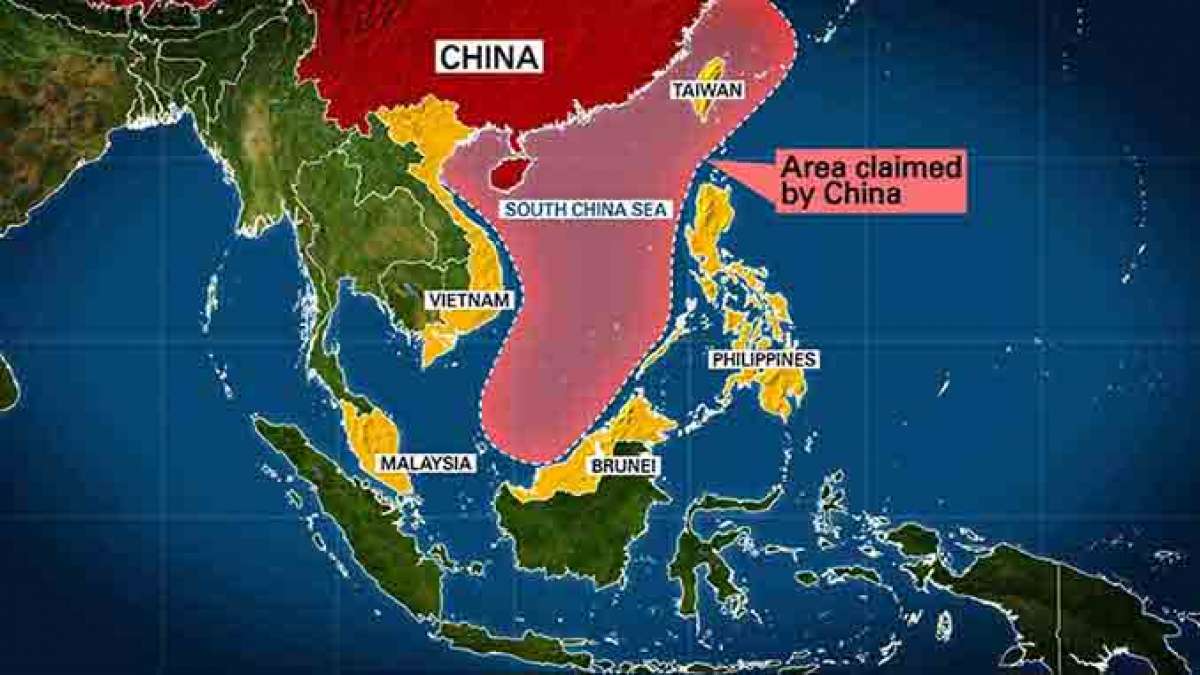
- 19 Apr 2024
Why is it in the News?
In March 2024, India’s External Affairs Minister, S. Jaishankar, articulated, in a joint statement during his visit to Manila, India’s full support for the Philippines in upholding its national sovereignty concerning the South China Sea.
Context:
- During his visit to Manila in March 2024, India's External Affairs Minister reiterated India's steadfast support for the Philippines in safeguarding its national sovereignty amidst the ongoing South China Sea dispute.
- This statement came against the backdrop of heightened tensions and frequent maritime incidents in the region throughout 2023.
- Furthermore, a joint statement issued in 2023 by India and the Philippines emphasized the importance of China adhering to the rules-based maritime order and recognizing the 2016 ruling by the International Court of Justice (ICJ) in favor of the Philippines.
- These statements reflect a notable shift in India's approach towards the South China Sea issue, departing from its previous stance of caution and neutrality.
- India's evolving position on the South China Sea underscores its broader strategic and economic interests on the global stage, with a renewed emphasis on upholding international maritime law, sovereignty, and sovereign rights in the region.
About the South China Sea (SCS):
- The South China Sea (SCS) is a pivotal body of water located in Southeast Asia, bordered by China to the north, Vietnam to the east and south, the Philippines to the west, and Borneo to the south.
- It encompasses a myriad of shoals, reefs, atolls, and islands, with notable features including the Paracel Islands, the Spratly Islands, and the Scarborough Shoal.
- Strategically situated, the SCS serves as a crucial maritime passage connecting the Indian Ocean and the Pacific Ocean via the Strait of Malacca.
- It plays a vital role in global trade, with approximately one-third of all shipping traversing its waters annually, facilitating trillions of dollars in trade and serving as a linchpin for geopolitical dynamics.
- Rich in marine biodiversity, the SCS harbors a third of the world's marine species, providing essential fisheries that contribute to the food security of Southeast Asian nations.
- Additionally, the region is believed to possess vast reserves of oil and gas beneath its seabed, further heightening its economic significance.
- With an estimated $3.4 trillion worth of ship-borne commerce passing through its lanes each year, including crucial energy supplies to nations like the United States, Japan, and South Korea, the South China Sea stands as one of the busiest and most consequential waterways on the planet.
Various Ongoing Disputes in the South China Sea (SCS):
There are multiple ongoing disputes in the South China Sea (SCS) involving several countries. These disputes revolve around territorial and maritime claims over islands, reefs, banks, and other features in the region.
- Spratly Islands Dispute: The Spratly Islands are claimed by China, Taiwan, Vietnam, the Philippines, Malaysia, and Brunei.
- These islands are strategically important due to their location in the middle of the South China Sea, as well as potential oil and gas reserves.
- Paracel Islands Dispute: The Paracel Islands are claimed by China, Taiwan, and Vietnam.
- China currently controls the islands, but Vietnam also asserts its sovereignty over them.
- Scarborough Shoal Dispute: The Scarborough Shoal is a disputed territory between China, Taiwan, and the Philippines.
- The shoal is rich in fishing resources and is strategically located near important shipping lanes.
- Gulf of Tonkin Dispute: This dispute involves China, Taiwan, and Vietnam, who have overlapping claims over the boundaries in the Gulf of Tonkin.
- Natuna Islands Dispute: Although geographically a part of the South China Sea, Indonesia claims sovereignty over the Natuna Islands, while China's "Nine-Dash Line" claim overlaps with Indonesia's exclusive economic zone (EEZ) near the Natuna Islands.
- Senkaku Islands Dispute: In the East China Sea, the Senkaku Islands are disputed between China, Taiwan, and Japan, with Japan currently administering them.
- These disputes stem from historical claims, economic interests, and strategic considerations, leading to tensions between the involved parties.
India’s Policy Shift:
- Initially, India's engagement in the region was primarily motivated by economic considerations, in line with its Look East Policy.
- This policy sought to strengthen economic linkages with Southeast Asia and secure vital energy resources essential for India's growing economy.
- Demonstrating this economic focus, Indian state-owned enterprises like ONGC Videsh participating in oil and gas ventures in Vietnam's exclusive economic zones highlighted India's economic imperatives and its adherence to the principles of maritime resource exploration and exploitation within the framework of international law, particularly UNCLOS.
- India's policy trajectory has since evolved from Look East to Act East, indicating a shift towards a more proactive and strategic stance in the Indo-Pacific region.
- This shift reflects India's acknowledgment of the changing geopolitical landscape and the imperative for a comprehensive foreign policy approach.
- The Act East Policy places greater emphasis on economic integration and underscores the importance of forging strategic partnerships and enhancing security cooperation with countries in the Indo-Pacific, including Vietnam, Malaysia, Singapore, and the Philippines.
- Concurrently, India has augmented its capabilities through various measures such as forward deployment, mission-based operations, heightened maritime domain awareness, and the establishment of deep-water maritime infrastructure.
India's intricate dynamic with China:
- The assertive behavior exhibited by China in the South China Sea (SCS) and its gradual encroachment strategy across various maritime domains, including the Indian Ocean, have sparked apprehension within India.
- Chinese intelligence-gathering activities in the Eastern Indian Ocean have heightened India's vigilance, prompting a more proactive stance to address perceived threats to its maritime security.
- Against the backdrop of escalating geopolitical tensions in the SCS, largely driven by China's assertive territorial assertions and militarization efforts, India's approach has undergone a nuanced yet less cautious evolution.
- This transformation in India's stance toward the SCS is closely interlinked with its complex relationship with China.
- Both nations have a history of longstanding border disputes, which escalated following the Galwan Valley clash in 2020.
- China's periodic incursions into Indian territory and recent actions such as renaming Indian villages in Arunachal Pradesh further exacerbate these tensions.
- The Galwan Valley incident prompted India to deploy a frontline warship to the SCS, showcasing India's asymmetric deterrence capabilities.
- China's assertive stance and territorial claims in both the SCS and along India's land border pose significant challenges to regional stability.
- India's strategic engagements, including regular naval exercises and enhanced military cooperation with Southeast Asian nations, serve dual purposes: reaffirming India's commitment to regional security and acting as a counterbalance to China's contentious assertions.
The ASEAN Perspective:
- New Delhi's strategic recalibration stems from recognizing the critical importance of the South China Sea (SCS) for regional security and the global maritime order.
- The disputes involving China and various ASEAN nations in the SCS directly impact the principles of freedom of navigation and overflight, which are essential not only for India's trade and energy transport but also for countries worldwide.
- As an active participant in the Indo-Pacific region, India cannot afford to remain indifferent to such significant issues.
- Its central role in the Indo-Pacific extends beyond the Indian Ocean to the broader maritime domain, where China's rise challenges the established order in unforeseen ways.
- India's Indo-Pacific strategy prioritizes ASEAN centrality, despite internal differences within the regional grouping presenting challenges.
- India's advocacy for a rule-based international maritime order, particularly its steadfast support for UNCLOS, stands in opposition to unilateral actions that undermine regional stability.
- This principled stance, deeply rooted in India's foreign policy framework, indirectly counters China's expansive territorial claims and activities in the SCS, underscoring India's dedication to regional stability and security as a responsible stakeholder.
Navigating Challenges and Choices for India:
- India encounters complexities in managing the South China Sea (SCS) disputes, especially given the divergent interests within ASEAN.
- While ASEAN nations adopt varying approaches to disputes, India aims to strike a delicate balance between supporting regional partners and steering clear of direct entanglement in confrontational situations.
- India is exploring a spectrum of options, including initiatives to bolster capacity, cooperation in defense matters, infrastructure development, and advocating for the preservation of international law in the SCS.
Conclusion:
India's recalibrated approach to the South China Sea disputes arises from strategic necessities, evolving geopolitical landscapes, and regional intricacies. The nuanced stance adopted by India towards the South China Sea is emblematic of its broader strategy, aimed at safeguarding its interests while actively participating in collective endeavors to uphold peace, stability, and the rule of international law across the Indo-Pacific region.
New Data Law, a Barrier to Journalistic Free Speech
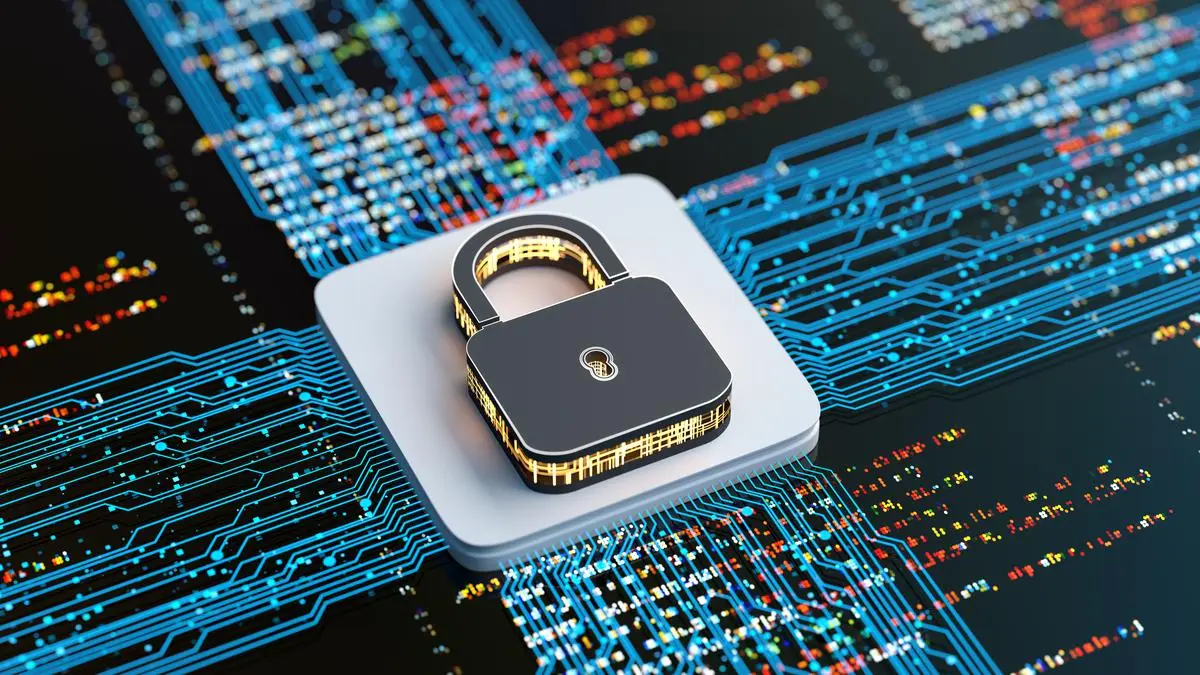
- 16 Apr 2024
Why is it in the News?
In August 2023, India enacted its first comprehensive data protection law, the Digital Personal Data Protection (DPDP) Act, 2023, with the government currently in the process of formulating rules and regulations for its implementation, anticipated to conclude post the general election.
Context:
- In August 2023, India introduced its first comprehensive data protection law, the Digital Personal Data Protection (DPDP) Act, 2023.
- While aimed at safeguarding personal data, its impact on journalistic freedom warrants examination, as the absence of exemptions for journalistic activities may threaten the foundational principles of a free press.
Provisions of Digital Personal Data Protection (DPDP) Act:
- The Digital Personal Data Protection (DPDP) Act, 2023 is a landmark legislation aimed at regulating the collection, processing, storage, and use of personal data in India.
- The Act establishes a comprehensive framework for lawful and transparent handling of personal data, seeking to safeguard individuals' privacy and data rights.
Key provisions of the DPDP Act, 2023 include:
- Definition of personal data: Any information capable of identifying an individual, directly or indirectly.
- Principles of data protection: Lawfulness, fairness, transparency, purpose limitation, data minimisation, accuracy, storage limitation, integrity, confidentiality, and accountability.
- Data handlers: Distinction between data fiduciaries (determining processing purpose and means) and data processors (processing data on behalf of fiduciaries).
- Consent: Requirement for explicit consent before processing personal data, with provisions for withdrawal.
- Individual rights: Access, correction, erasure, and transfer of personal data.
- Data localisation: Potentially mandating the storage and processing of certain sensitive data within India.
- Oversight: Establishment of a Data Protection Board to monitor compliance and resolve grievances.
- Non-compliance: Penalties and sanctions, including fines and legal consequences for violations.
- Cross-border data transfers: Ensuring data protection standards comparable to India's when transferring data across borders.
- Obligations for data fiduciaries and processors: Security measures, data breach notifications, and data impact assessments.
- The DPDP Act, 2023 represents a significant step towards upholding individual privacy rights in India and ensuring responsible data management by government entities, organisations, and individuals alike.
Journalistic Exemptions in Data Protection Laws:
- Traditionally, data protection laws include exemptions for journalistic activities, allowing journalists to access and report on personal data without consent for investigative purposes.
- These exemptions ensure freedom of the press and facilitate accountability in society.
- However, the Digital Personal Data Protection (DPDP) Act, 2023 does not provide such exemptions.
- Previous drafts of the Act, including versions released by an expert committee on data protection (2018), the government (2019), and a Joint Parliamentary Committee (2021), contained provisions for journalistic activities.
- The unexplained removal of these exemptions in the DPDP Act's final iterations (2022 and 2023) raises concerns over potential negative impacts on journalism and its role in maintaining transparency and accountability.
- Addressing this absence of journalistic exemptions will be crucial to upholding the freedom of the press and protecting the public's right to information.
Challenges for Journalists under the DPDP Act:
- Consent Requirements: Journalists are now obligated to secure consent from individuals before utilizing their personal data in news stories.
- This could impede investigative reporting, as subjects may refuse consent, thereby obstructing access to crucial information.
- Right to Erasure: The right to erasure permits individuals to demand the deletion of published stories containing their personal data.
- This provision may result in the removal of significant investigative work, undermining transparency.
- For instance, when reporting on a Member of Parliament (MP) and their activities, journalists often gather information such as meeting details, travel itineraries, and familial financial investments, all of which constitute personal data under the DPDP Act.
- This provision may result in the removal of significant investigative work, undermining transparency.
- Obtaining consent for such data usage poses challenges, and even after publication, MPs can invoke the right to erasure, compelling journalists to delete pertinent stories.
- Government Oversight: The Act grants the government authority to request information from data processors, potentially compromising the confidentiality of journalists' sources and research materials.
- This governmental oversight may curtail the press's capacity to hold the state accountable.
Addressing Concerns and Potential Solutions for Journalistic Freedoms under the DPDP Act:
- To ensure a balanced approach that protects personal data while preserving journalistic freedoms, addressing the concerns raised by the Digital Personal Data Protection (DPDP) Act is essential.
- The following solutions could help achieve this goal:
- Transparent Consultation: The removal of exemptions for journalistic activities highlights the need for open and transparent public consultations.
- Although drafts of the DPDP Act were released for public input, the comments received were not made publicly available.
- Greater transparency in the consultation process would enable better comprehension of stakeholder perspectives and inform more effective law-making.
- Exemptions for Journalists: The central government should consider using its rule-making powers under the DPDP Act to exempt journalistic entities, including citizen journalists, from specific obligations within the Act.
- This exemption would protect the freedom of the press and encourage a transparent and open environment for journalism.
- Public Consultation: Implementing an open, transparent, and robust public consultation process could facilitate better understanding and consideration of various viewpoints.
- This approach would lead to a more balanced and effective data protection law that upholds both personal data privacy and freedom of the press.
Conclusion
The Digital Personal Data Protection (DPDP) Act, 2023, is an essential step towards safeguarding personal data in India. However, its potential impact on journalistic free speech raises significant concerns that must be addressed.
To strike a balance between protecting individual privacy and upholding the fundamental principles of a free press, the government should consider implementing exemptions for journalists and fostering transparent consultation processes. These measures would enable a harmonious coexistence of personal data protection and journalistic freedoms, ensuring that both critical elements thrive in India's democratic landscape
Revealing Caste-based Inequalities in Indian Cities
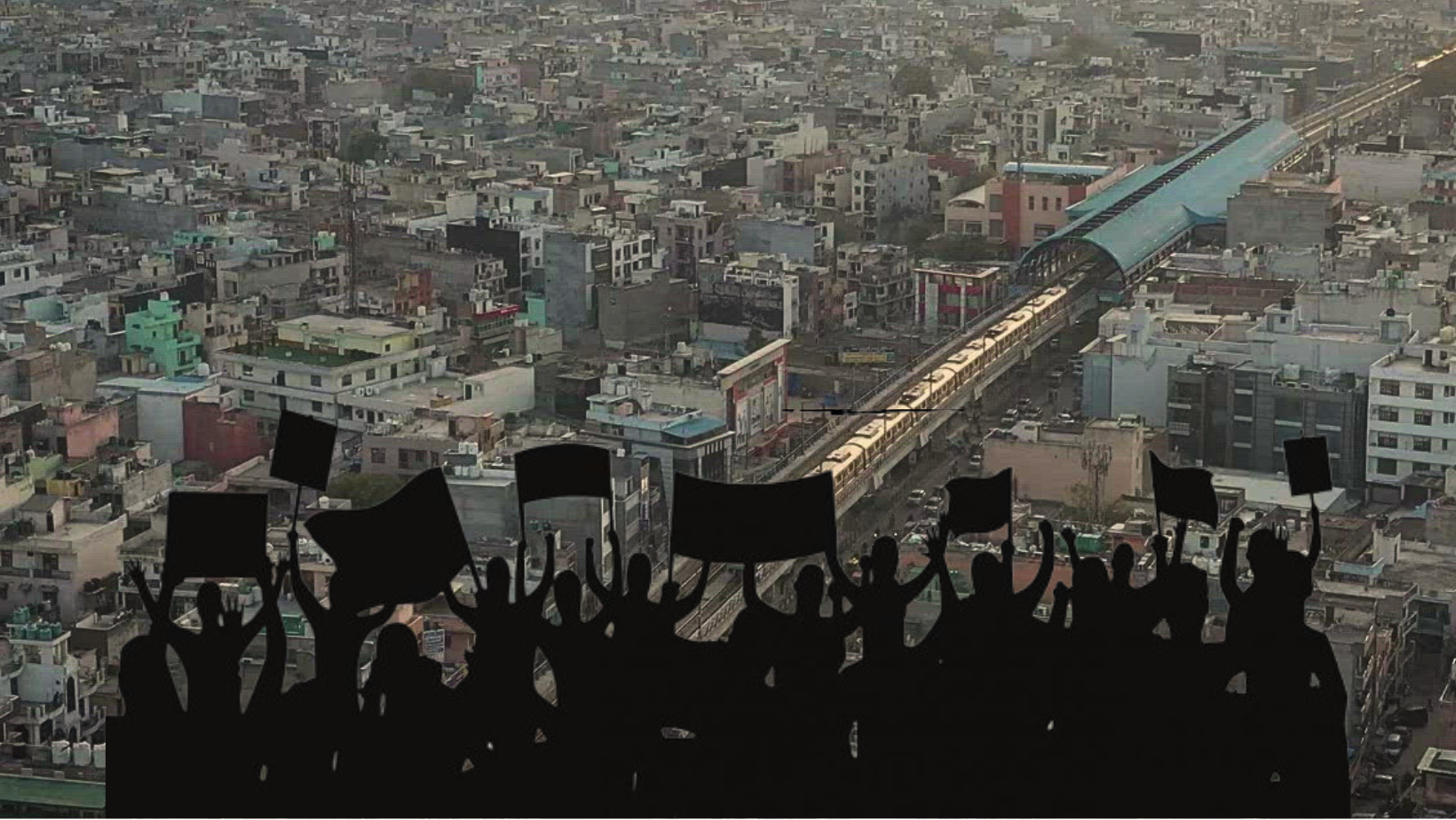
- 15 Apr 2024
Why is it in the News?
Despite Dr. B.R. Ambedkar's hopeful vision for India's cities, the urban fabric continues to be profoundly fractured by enduring caste-based divisions.
Context:
- Caste has historically played a significant role in shaping the social fabric and geographical layout of communities throughout India.
- This influence is palpable in the organization of Indian cities, where caste often dictates spatial arrangements and societal dynamics.
- Despite entrenched obstacles, influential figures such as R. Ambedkar and Jyotirao Phule viewed urbanization as a potential catalyst for the liberation of Dalits.
- Consequently, it becomes imperative to delve into Ambedkar's perspective on urbanization, the enduring prevalence of caste-based discrimination within urban environments, and the ongoing hurdles encountered by Dalits and Muslims concerning housing and access to public services in urban areas.
What was B. R. Ambedkar’s View on Urbanization?
- A Pathway to Empowerment: B. R. Ambedkar, an eminent social reformer and advocate for Dalit rights, envisioned urbanization as a pathway to empowerment for marginalized communities in India.
- He posited that the traditional social structures prevailing in Indian villages were inherently oppressive due to the rigid caste system, which predetermined individuals' social status and opportunities based solely on their birth.
- Ambedkar contended that Indian villages served as the "working plant of the Hindu social order," perpetuating caste-based hierarchies that marginalized and subjugated Dalits.
- Viewing urbanization as a means of dismantling this entrenched caste-based order, he saw cities as spaces where individuals could blend into anonymity amidst a diverse population, transitioning from a caste-oriented society to one structured more around class.
- Disrupting Caste-Based Hierarchies: Ambedkar believed that this transition from a genealogy-based social structure to one centered on resource accumulation would weaken the systems of caste oppression that were deeply entrenched in rural areas.
- Urban environments, he argued, would offer Dalits access to diverse economic opportunities and avenues for skilled labor, enabling them to enhance their social and economic status.
- In cities, Dalits could potentially break free from the occupational constraints dictated by caste in villages, thereby fostering social mobility and economic independence.
- Additionally, Ambedkar saw urban areas as hubs of greater political and social awareness, with educational institutions and opportunities for civic engagement that could empower marginalized groups to assert their rights and actively participate in democratic processes.
- Urbanization Challenges and Ambedkar's Hope: Despite advocating for urbanization as a means of empowerment for marginalized communities, Ambedkar was cognizant of its inherent challenges.
- He acknowledged the persistent presence of caste-based discrimination within urban settings, drawing from his encounters with adversity.
- Ambedkar's personal experiences, such as his difficulties in securing housing in Baroda and encountering caste-based restrictions in textile mills, underscored the reality of caste-based biases in urban areas.
- However, rather than succumbing to disillusionment, he maintained an optimistic outlook regarding the transformative potential of cities.
- Ambedkar perceived urban environments as arenas where individuals could assert greater agency and autonomy in shaping their lives.
- Despite the hurdles presented by caste-based discrimination, he remained hopeful that cities could provide avenues for marginalized groups to transcend social barriers and realize their full potential.
Endurance of Caste-Based Bias in Urban Environments:
- Language of Purity-Pollution: Urban caste discrimination primarily manifests through the concept of purity-pollution, deeply ingrained in Hindu social practices.
- This notion labels specific foods, behaviors, and individuals as pure or impure based on caste.
- For instance, a 2021 survey revealed that non-vegetarian diets hinder rental housing access, reflecting prejudice against meat-eating castes.
- This notion labels specific foods, behaviors, and individuals as pure or impure based on caste.
- Caste Segregation in Housing: The purity-pollution concept extends to housing practices, with Dalits and other lower castes facing discrimination in renting or purchasing urban homes.
- Landlords and housing societies may reject them based on perceived cleanliness or dietary habits, leading to segregation and ghettoization.
- State-Sanctioned Policies: Government policies have also perpetuated urban caste-based discrimination.
- In March 2017, Uttar Pradesh restricted meat sales near religious places and mandated meat shops to conceal products from pedestrians.
- Similar measures in Gujarat targeted street food vendors selling meat-based items, citing religious concerns.
- These policies reinforce caste divisions by labeling meat as impure and associating it with certain castes.
Ambedkar's Vision, Discrimination's Impact, and Urban Space Inequity:
- Enduring Significance of Ambedkar's Vision: Dr. B.R. Ambedkar's vision of urbanization as a means for Dalit liberation remains relevant today, emphasizing the continuing pursuit of social justice and equality in Indian cities.
- His work highlights the need to address both historical and present-day caste-based discrimination to create inclusive urban environments.
- Spatial Consequences of Discrimination: Caste-based discrimination significantly affects urban spaces by segregating Dalits and other marginalized groups into specific areas or neighborhoods.
- These segregated zones often lack access to essential services and infrastructure, amplifying existing socioeconomic disparities within these communities.
- Influence on Public Spaces: Discrimination based on caste extends to public spaces, with restrictions on food sales limiting lower castes' economic and social participation in city life.
- Such policies contribute to exclusion and marginalization, shaping an environment detrimental to inclusivity and equity within urban landscapes.
Conclusion
Despite Ambedkar's hopeful vision of urbanization as a means to Dalit liberation, Indian cities have yet to fully realize this potential. While the shift to urban life has altered some aspects of caste oppression, new forms of discrimination have emerged and persisted, perpetuated by language, state policies, and institutional biases. This enduring struggle highlights the imperative of ongoing initiatives to combat caste-based discrimination and foster a more inclusive and equitable urban landscape in India.
A Battle to Save Ladakh, and All of Humanity
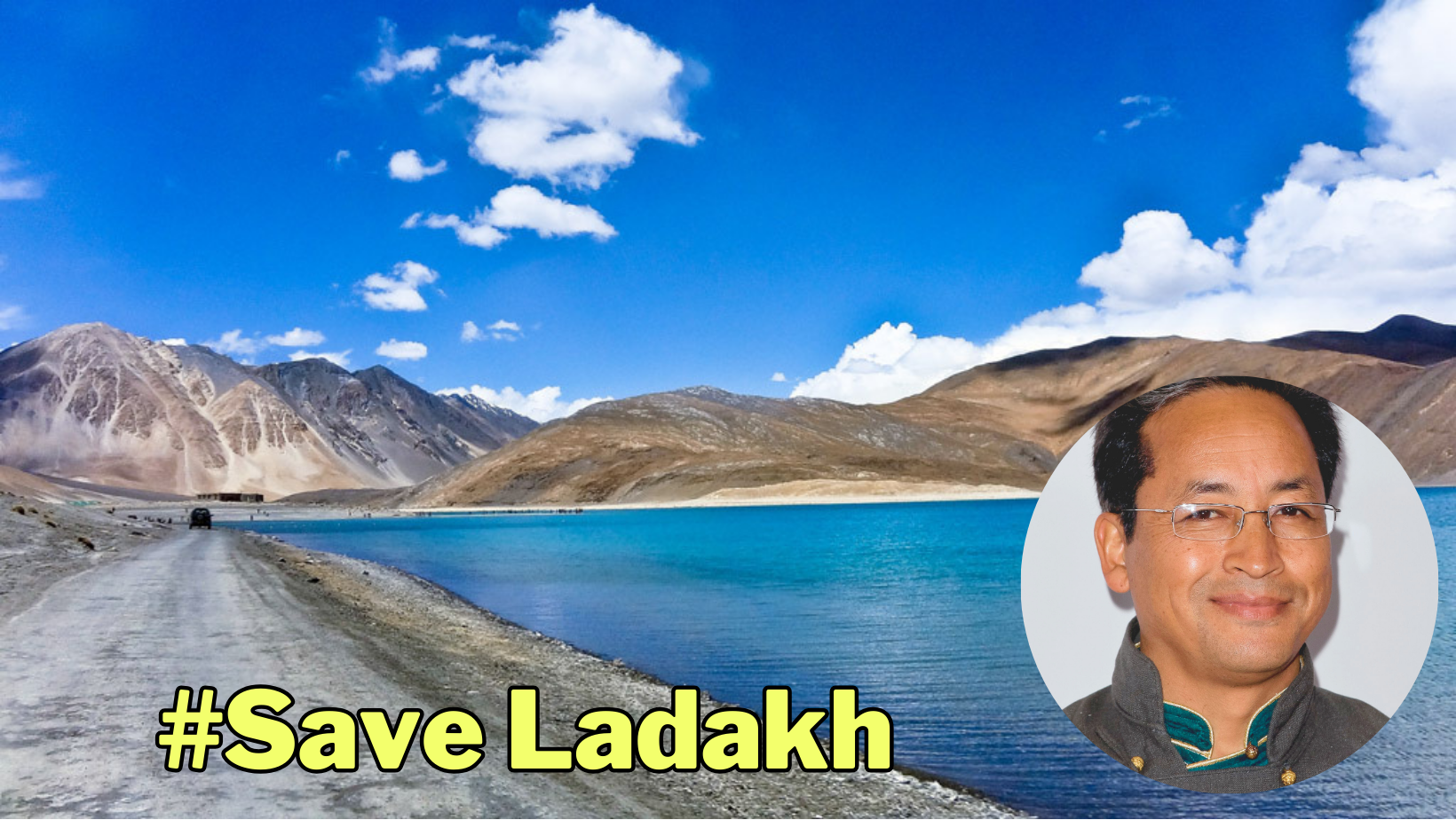
- 12 Apr 2024
Why is it in the News?
When climate activist Sonam Wangchuk took the stage in Leh, Ladakh recently, addressing a gathering of 30,000 individuals, his announcement of a 21-day climate fast resonated not only with the people of Ladakh but also with a global audience.
Context:
- The Himalayan region, situated between India's neighbors Pakistan and China, encompasses Ladakh, where 97% of the population comprises indigenous tribes whose livelihoods primarily depend on agriculture and animal husbandry.
- Despite its breathtaking beauty, this region grapples with various challenges, including the adverse effects of climate change, border tensions, and a surge in large-scale infrastructure projects.
- As climate activist Sonam Wangchuk leads protests and fasts, it becomes imperative to grasp the broader context of the Himalayan ecosystem's vulnerability.
The Climate Change Challenge in the Himalayan Region:
- Extreme Weather Events: Climate change manifests in more frequent and severe weather phenomena like heavy rainfall, cloudbursts, and flash floods.
- These events trigger landslides, wreaking havoc on mountain communities by damaging infrastructure, crops, and property, and endangering lives.
- Shifts in Monsoon Patterns: The region heavily relies on monsoon rains for agriculture and water supply.
- Climate change-induced alterations in monsoon patterns disrupt rainfall timing, intensity, and distribution, jeopardizing agricultural cycles and economic stability.
- Temperature Rise: Elevated temperatures impact both mountain and downstream ecosystems.
- Snowmelt patterns alter, local biodiversity faces disturbance, and traditional farming and animal husbandry practices suffer.
- Melting Glaciers: The Himalayas, often dubbed the Third Pole, harbor approximately 15,000 glaciers crucial to regional hydrology.
- These glaciers feed vital rivers like the Indus, Ganga, and Brahmaputra, serving as lifelines for millions downstream.
- However, accelerated glacier melt due to global warming poses threats such as rising river levels, heightened flood risks, and potential water scarcity.
- Loss of Biodiversity: The Himalayan region hosts diverse flora and fauna, including many endemic species.
- Climate change threatens this unique biodiversity through habitat loss, altered migration routes, and ecosystem stress.
- Livelihood Impacts: Indigenous tribes and rural communities depend on farming and animal husbandry.
- Climate change-induced disruptions, such as erratic weather and natural disasters, challenge their traditional livelihoods.
National Mission for Sustaining the Himalayan Ecosystem (NMSHE):
- The National Mission for Sustaining the Himalayan Ecosystem (NMSHE) is one of the eight missions under the National Action Plan on Climate Change (NAPCC).
- NMSHE is a multi-pronged, cross-cutting mission across various sectors.
- It contributes to the sustainable development of the country by enhancing the understanding of climate change, its likely impacts, and adaptation actions required for the Himalayas- a region on which a significant proportion of India’s population depends for sustenance.
- NMSHE seeks to facilitate the formulation of appropriate policy measures and time-bound action programs to sustain ecological resilience and ensure the continued provisions of key ecosystem services in the Himalayas.
- NMSHE intends to evolve suitable management and policy measures for sustaining and safeguarding the Himalayan ecosystem along with developing capacities at the national level to continuously assess its health status.
- Recognizing the importance of scientific and technological inputs required for sustaining the fragile Himalayan Ecosystem, the Ministry of Science and Technology has been given the nodal responsibility of coordinating this mission.
- However, the mission involves valuable cooperation of the Indian Himalayan States, the Planning Commission, and the Ministry of Environment, Forests and Climate Change to achieve its goals.
NMSHE's Role in Preserving the Himalayan Region:
- Accelerated Infrastructure Development: Since Ladakh transitioned to a Union Territory, numerous large-scale infrastructure projects have been rapidly implemented, including road expansions, bridge constructions, tunnel installations, railway lines, and solar energy initiatives.
- These endeavors, driven by entities such as the Border Roads Organisation (BRO) and the National Highways & Infrastructure Development Corporation Ltd. (NHIDCL), focus on promoting tourism and industrial growth.
- Oversight of Previous Disasters: Despite past calamities in the Himalayan region, such as the catastrophic 2013 Kedarnath floods, and more recent incidents like the 2023 Joshimath disaster and the Silkyara tunnel collapse, there appears to be minimal reflection on previous warnings.
- Expert committees have advocated for limitations on pilgrim numbers and constraints on hydroelectric projects in ecologically fragile areas, but these recommendations have often been disregarded.
- Insufficient Attention to Concerns: Climate change activists have raised concerns about the inadequate consideration given to their suggestions, with little to no scrutiny conducted before approving multi-crore infrastructure projects.
- Worries regarding risk assessment, safety protocols, and geological evaluations seem to be overlooked in the pursuit of rapid development.
How to preserve the Himalayan Ecosystem Safe?
- Sustainable Development Practices: Conduct comprehensive environmental impact assessments before embarking on development projects to gauge potential ecosystem repercussions.
- Design projects with a focus on minimizing environmental harm and adhering to sustainability standards.
- Implement infrastructure projects with measures to reduce environmental disruption, such as using sustainable materials and employing low-impact construction methods.
- Focused Policies on Biodiversity Conservation: Expand and fortify protected areas like national parks and wildlife sanctuaries to safeguard the region's diverse flora and fauna.
- Establish and maintain wildlife corridors to facilitate safe animal migration and preserve genetic diversity, thus mitigating the risk of species extinction.
- Community Involvement: Integrate traditional knowledge and practices of local communities into conservation initiatives to ensure cultural relevance and long-term sustainability.
- Empower local communities to actively participate in conservation efforts, fostering greater engagement and ownership over preservation endeavors.
- Climate Change Mitigation and Adaptation: Implement strategies to curb greenhouse gas emissions, such as promoting renewable energy sources and combating deforestation, to mitigate climate change impacts.
- Support adaptation measures for local communities, including crop diversification and enhanced water management, to help them cope with evolving climate conditions.
- Research and Monitoring: Continuously monitor the Himalayan ecosystem, including its flora, fauna, and physical processes, to detect early signs of ecological changes and inform conservation strategies.
- Encourage interdisciplinary research on the region's ecology, climate, and geology to deepen understanding of ecosystem challenges and identify effective solutions.
Conclusion
It's crucial to recognize that while development is vital for economic progress, it should not be pursued at the cost of environmental harm and human well-being. The Himalayan region, renowned for its unparalleled biodiversity and rich cultural heritage, warrants thoughtful preservation and conservation efforts. It is incumbent upon all stakeholders to collectively assume the responsibility of safeguarding the future of this ecologically and culturally significant area.
The Advent Of A Holistic Approach To 'One Health'
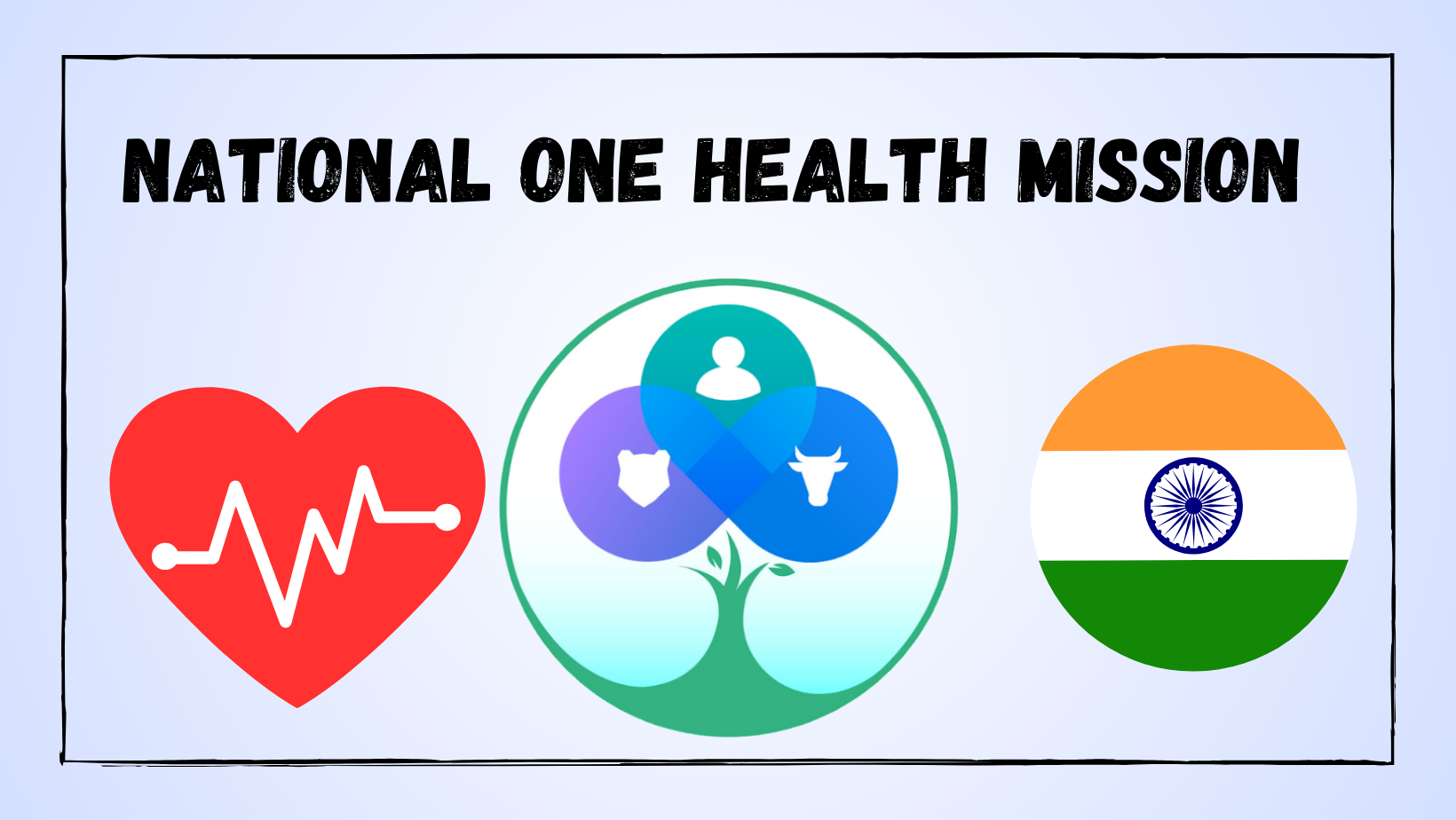
- 11 Apr 2024
Why is it in the News?
The ‘National One Health Mission’ is the result of the recognition that only a coordinated approach will ensure a better response to disease outbreaks.
Context:
- In recent times, the intricate relationship among humans, animals, and the environment has gained significant attention, especially in light of the emergence of pandemics like COVID-19.
- This interconnectedness is underscored by the impact of diseases such as lumpy skin disease, which affects both livestock productivity and trade, bridging the gap between domesticated and wild animal health.
- Addressing these complex challenges, the Indian government has launched the 'National One Health Mission,' aimed at comprehensively tackling the interlinked domains of human, animal, and environmental health.
What is One Health?
- One Health is an integrating idea that brings different sectors together to solve the health, productivity, and conservation challenges and has major implications for India.
- It is a global topic and was endorsed during India's presidency of the G-20.
- India with its diverse wildlife, one of the largest livestock populations, and high density of human population, carries heightened risks for inter-compartmental spread of diseases.
- The Covid pandemic, recent outbreaks of Lumpy Skin Disease in cattle, and the constant threat of Avian Influenza show that it is not just about addressing diseases from the human health point of view (zoonosis) but we need to address the livestock and wildlife aspects.
- This also opens opportunities for leveraging the complementarity and strengths that are inherent in each sector and devising integrated, robust, and agile response systems.
What is the National One Health Mission?
- Initiated in July 2022, the National One Health Mission represents a comprehensive endeavor endorsed by the Prime Minister's Science, Technology, and Innovation Advisory Council (PM-STIAC).
- With the participation of 13 ministries and departments, including the Department of Science and Technology, the Department of Biotechnology (DBT), and the Council of Scientific and Industrial Research (CSIR), among others, this mission adopts a holistic approach towards One Health and pandemic preparedness.
- A pivotal achievement within this mission is the establishment of the National Institute for One Health in Nagpur.
- Functioning as the central coordinating body for both national and international One Health endeavors, this institute marks a significant milestone in the mission's implementation.
- On December 11, 2022, the foundation stone of the institute was laid by the Prime Minister, symbolizing the commitment to advancing the principles of One Health and enhancing pandemic preparedness.
Objectives and Approaches of The National One Health Mission:
- Seamless Surveillance Integration: The mission endeavors to establish an integrated surveillance system that seamlessly monitors health indicators across human, animal, and environmental sectors.
- By amalgamating data from these domains, it can swiftly identify potential health hazards and respond proactively.
- Coordinated Outbreak Management: Recognizing the necessity of a unified approach in outbreak response, the mission aims to institute protocols and frameworks facilitating collaboration among various sectors.
- This coordinated effort enables effective resource and information sharing to mitigate the impact of diseases affecting multiple domains.
- Collaborative Research and Development: Through fostering collaboration among scientific research institutions and government bodies, the mission fosters the development of innovative solutions for emerging health threats.
- This includes the creation of vaccines, therapeutics, and diagnostics critical for pandemic preparedness and response.
- Seamless Information Exchange: Effective communication and data sharing are imperative for a unified One Health approach.
- The mission endeavors to facilitate seamless information exchange between sectors and stakeholders, ensuring timely and informed actions.
- Preparedness for Future Pandemics: Building on past pandemic experiences, the mission seeks to develop strategies and frameworks to enhance the country's readiness for future health crises.
- This involves proactive planning for potential pandemics and emerging diseases such as avian influenza or Nipah virus.
- Resource Optimization: By leveraging the resources and expertise of multiple sectors and stakeholders, the mission aims to optimize resource utilization, including laboratory infrastructure, healthcare facilities, and scientific research capabilities.
- This collaborative effort enhances efficiency and cost-effectiveness in addressing health threats.
- Public Health Education and Awareness: The mission includes public education initiatives to raise awareness about the interconnectedness of human, animal, and environmental health.
- Promoting an understanding of One Health principles encourages healthier behaviors and better preparedness for health emergencies.
Critical enabling activities of the One Health Mission:
- The outcomes of the One Health Mission will be supported by critical enabling initiatives.
- Many of these initiatives are ongoing and will be strengthened under the mission and several new activities that will facilitate the goals of the mission will be undertaken.?
Leveraging Laboratory Networks and Technological Integration in India's National One Health Mission:
- Establishment of High-Risk Pathogen Laboratories: The mission is dedicated to creating a nationwide network of laboratories equipped to handle high-risk pathogens classified under Biosafety Levels 3 and 4.
- These facilities provide a secure environment for studying infectious agents with pandemic potential.
- Departmental Collaboration: By consolidating laboratories managed by diverse departments, the mission aims to foster a cohesive network capable of coordinating resources and expertise across sectors.
- This integration enhances disease outbreak response, irrespective of its origin in human, animal, or environmental realms.
- Optimized Resource Allocation: Pooling laboratory resources within a unified network ensures efficient utilization of infrastructure and personnel.
- This collaborative approach enables swift responses to outbreaks and other health crises, maximizing available resources.
- Interdisciplinary Research and Analysis: Encouraging collaboration among experts from various disciplines—including medicine, veterinary science, environmental science, and public health—the mission promotes comprehensive research and analysis of health threats across multiple sectors.
- Integration of Artificial Intelligence (AI) and Machine Learning: Harnessing the power of AI and machine learning, the mission enhances epidemiological capabilities by analyzing vast datasets to detect patterns, trends, and potential health risks.
- This technology enables timely interventions and enhances overall preparedness.
- Utilization of Disease Modelling: Advanced modeling techniques are employed to forecast disease spread and potential outbreaks.
- These models facilitate targeted measures for disease control and prevention.
- Expansion of Genomic Surveillance: The mission broadens genomic surveillance efforts beyond COVID-19, encompassing other infectious diseases.
- By analyzing genetic material from diverse sources like wastewater and animal congregations, scientists can monitor disease prevalence and identify emerging threats.
- Capacity Building Initiatives: Emphasizing the importance of skill enhancement, the mission prioritizes capacity building across sectors in epidemiology, data analytics, and laboratory management.
- Training programs ensure that professionals possess the necessary skills to effectively utilize new technologies and methodologies.
Conclusion
The concept of One Health transcends mere disease management, encompassing broader realms such as antimicrobial resistance, food safety, plant diseases, and the consequential impacts of climate change. Addressing intersectoral issues like One Health necessitates active involvement not only from diverse governmental agencies but also from non-governmental organizations, academia, the private sector, and ordinary citizens. By adopting an actionable framework rooted in collaboration and comprehensive engagement, we can advance toward the overarching objectives of 'One Earth, One Health' and 'Health for All.
Climate Crisis is Not Gender Neutral
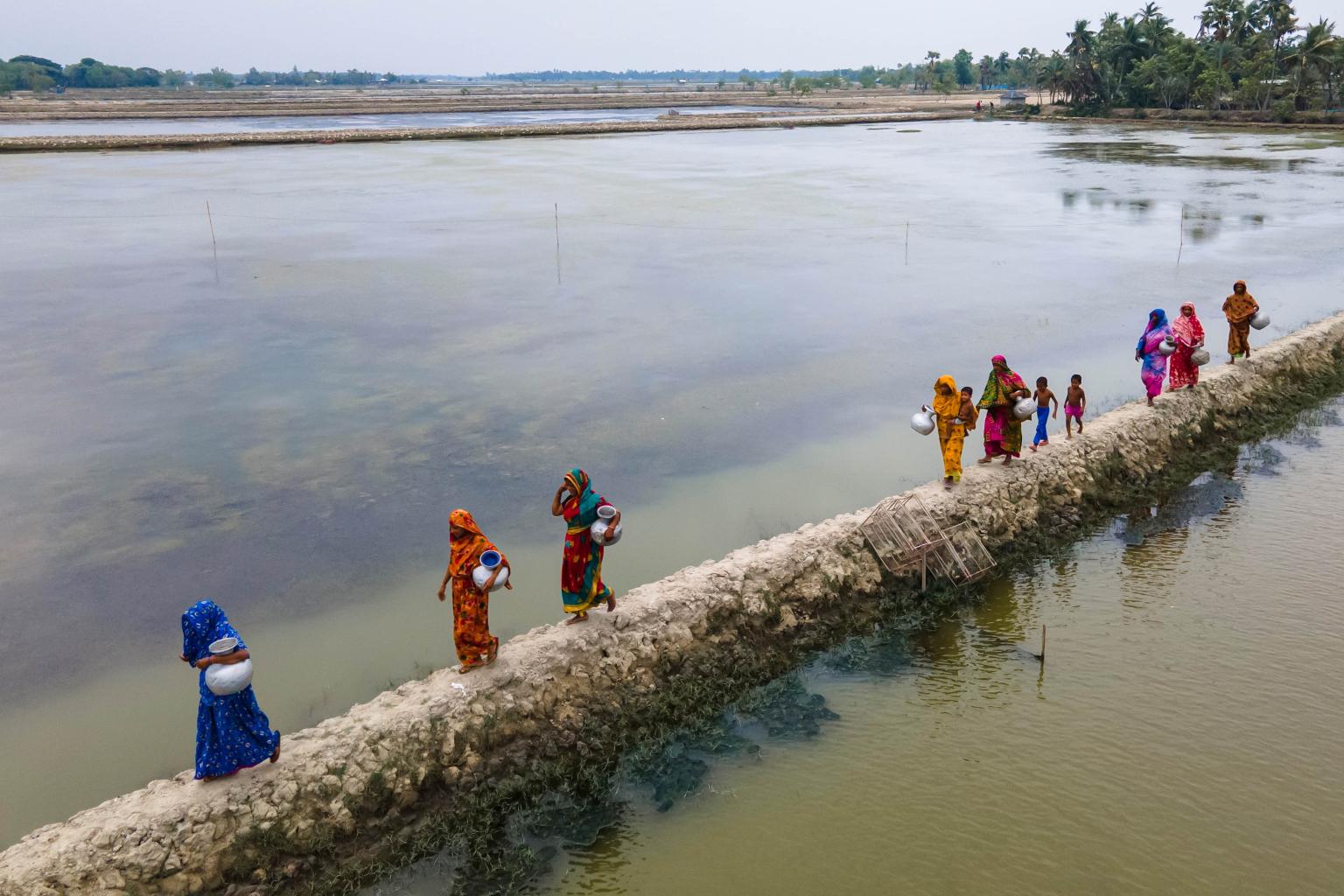
- 10 Apr 2024
Why is it in the News?
The climate crisis is far from “gender neutral” as women and men are affected differently by weather and climate and therefore need gender-sensitive information and services.
Context:
- As the climate crisis intensifies, its disproportionate impact on women and girls becomes more evident, particularly in poverty-stricken regions.
- This calls for a critical examination of the gender dimensions of climate change, recognizing women's increased vulnerabilities and the importance of incorporating gender perspectives in climate action strategies.
- By doing so, we can develop effective solutions that address the unique challenges faced by women, ensuring a more equitable and sustainable approach to climate change mitigation and adaptation.
How Does Climate Change Impact Women?
- Rural Livelihood Dependence on Agriculture: In many regions, particularly rural India, women play a central role in agricultural activities, forming the backbone of their communities' livelihoods.
- However, the effects of climate change, such as erratic rainfall, droughts, and floods, pose significant threats to crop yields, directly impacting food security and income for these women.
- Compounded by limited access to essential resources like land, credit, and technology, women face heightened vulnerabilities in navigating climate-related risks.
- Health Risks Amplified by Climate Hazards: Women's health is uniquely susceptible to the challenges posed by climate change.
- For instance, prolonged heatwaves increase the risk of complications during pregnancy, including preterm birth and eclampsia.
- Moreover, exposure to indoor and outdoor air pollution exacerbates respiratory and cardiovascular diseases among women and unborn children, compromising their well-being.
- Gender Dynamics in Extreme Weather Events: The rise in the frequency of extreme weather events, such as floods, droughts, and cyclones, has profound implications, particularly for vulnerable populations.
- Reports highlight that a significant portion of Indian districts are susceptible to such disasters, placing women and children at heightened risk.
- Emerging studies underscore a concerning correlation between these natural calamities and incidents of gender-based violence against women.
- Additionally, disruptions in water access due to climate-induced changes affect women's ability to engage in productive activities and access healthcare, intensifying their workload and compromising their overall welfare.
- Nutritional Challenges and Early Marriage: In regions prone to drought, women and girls face heightened risks of undernutrition due to food insecurity.
- Data indicates that women residing in these areas are more likely to experience underweight conditions and are at a higher risk of entering early marriages, perpetuating cycles of poverty and gender inequality.
How to Empower Women in Climate Action?
- Rich Tradition of Environmental Stewardship: Throughout history, women have been integral to environmental conservation efforts.
- Across various communities, they serve as primary custodians of natural resources, managing land, water, and forests with a deep-rooted understanding of sustainability.
- Their traditional knowledge and practices are invaluable assets for fostering biodiversity conservation and promoting climate-resilient agricultural techniques.
- Boosting Agricultural Productivity and Food Security: Providing women farmers with equitable access to resources such as land, credit, and agricultural inputs unleashes their potential to enhance agricultural productivity and adapt to climate change.
- Research indicates that closing the gender gap in agriculture could significantly increase crop yields and bolster food security.
- Women's innate connection to smallholder farming systems enables them to innovate with cost-effective, environmentally friendly farming methods, thereby fostering resilience in agricultural practices.
- Key Players in Local Adaptation Strategies: Women are pivotal to the success of community-based adaptation efforts, which prioritize building resilience to climate change at the grassroots level.
- Through women's groups and collectives like Self-Help Groups (SHGs) and Farmer Producer Organizations (FPOs), communities mobilize, share knowledge, and implement adaptation measures.
- These grassroots initiatives empower women to advocate for their rights in decision-making processes concerning natural resource management and climate resilience.
- Inspiring Role Models and Catalysts for Change: Women leaders in climate action serve as inspirations and role models, paving the way for future generations of environmentalists and activists.
- Their prominence in climate solutions not only challenges gender norms but also encourages greater participation of women and girls in STEM fields and environmental leadership roles.
- By highlighting women's contributions to climate action, these role models empower others to pursue careers and opportunities in climate science, policy, and advocacy, fostering a more inclusive and impactful approach to addressing climate change.
Action Needed to Address the Gender Implications of Climate Change:
- Immediate Protection Against Health Risks: Swift action is imperative to safeguard vulnerable populations, such as pregnant women, outdoor laborers, children, and the elderly, from health risks exacerbated by extreme weather events like heat waves.
- Local authorities must develop and implement comprehensive heatwave response plans, incorporating early warning systems, establishing cooling centers, and adapting work and school schedules to mitigate heat-related illnesses and fatalities.
- Improved Access to Safe Drinking Water: Climate-induced disruptions to water sources escalate water scarcity and endanger public health.
- Immediate interventions are essential to enhance access to safe drinking water, particularly for women and girls responsible for water collection in many communities.
- Investments in water infrastructure, rainwater harvesting systems, and water purification technologies are vital to alleviate the impacts of water scarcity on vulnerable populations.
- Climate-Resilient Urban Planning: Urban areas face escalating vulnerabilities to climate-related hazards, including heatwaves, flooding, and air pollution.
- Urban planning strategies emphasizing green infrastructure—such as parks, green roofs, and tree-lined streets—can mitigate the urban heat island effect and minimize exposure to extreme temperatures.
- Moreover, measures to enhance air quality, like reducing vehicular emissions and promoting clean energy technologies, are crucial for safeguarding public health, particularly for women and children susceptible to respiratory and cardiovascular diseases.
- Community-Centered Adaptation Efforts: Community-based adaptation initiatives, engaging local communities, including women's groups and grassroots organizations, are pivotal in bolstering resilience to climate change at the grassroots level.
- These initiatives should prioritize the needs and aspirations of women and marginalized groups, empowering them in decision-making processes regarding adaptation planning and implementation.
- Investments in building the capacity of local institutions and community leaders can amplify the efficacy and sustainability of adaptation endeavors.
- Gender-Inclusive Climate Policies: National and sub-national climate policies must integrate gender-responsive approaches tailored to the distinct needs and priorities of women and girls.
- Recognizing women as agents of change and empowering their participation in climate decision-making at all levels is essential.
- Gender mainstreaming in climate policies ensures inclusivity, equity, and effectiveness in tackling the underlying drivers of vulnerability and inequality.
Conclusion
The disparities and vulnerabilities experienced by women and girls underscore the urgent need for inclusive and gender-responsive strategies in climate adaptation and mitigation endeavors.
By empowering women, we not only bolster resilience but also unlock innovative solutions crucial for combating the climate crisis. Thus, the integration of gender perspectives into climate action plans is imperative for forging a sustainable and equitable future for all
Indian Aviation, A Case of Air Safety at a Discount
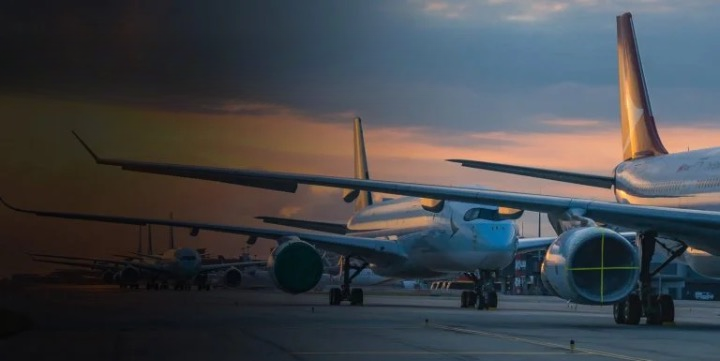
- 09 Apr 2024
Why is it in the News?
The government introduced revised Flight Duty Time Limitations (FDTL) Regulations, set to be implemented on June 1, 2024, but faced opposition from airline owners, prompting the DGCA to indefinitely defer the deadline.
Context:
- The aviation sector in India faces a pivotal moment, balancing rapid growth with pressing safety issues.
- The remarks from the Union Minister and the DGCA, highlighting safety as paramount, seem at odds with ongoing safety lapses.
- Given the significance of safety measures, it's imperative to examine safety protocols, parameters, challenges, and regulatory shortcomings.
Key Provisions in the Revised FDTL Regulations of January 2024:
- Extended Weekly Rest Periods for flight crew: The revised regulations mandate increased weekly rest periods from 36 hours to 48 hours for flight crew, thus ensuring sufficient time for recovery from cumulative fatigue.
- Night Duty: The definition of night has been amended, and it now covers the period of 0000-0600 hours in the revised regulations vis-à-vis the period of 0000-0500 hours under the previous regulations.
- This enhancement of one hour during the early morning will ensure adequate rest and also align the night duty period, which encompasses the Window of Circadian Low (WOCL) from 0200-0600 hours, i.e. the time during which the circadian body clock cycle is at its lowest in terms of alertness.
- Maximum Flight Time, Maximum Flight Duty Periods, and Number of Landings during Night: The revised regulations have taken into consideration different types of operations across time zones.
- The maximum flight time & maximum flight duty period for flight operations encroaching night have been restricted to 8 hours flight time & 10 hours flight duty period, respectively, and the number of landings has been limited to only two landings as compared to the maximum permissible 6 landings under previous regulations during night operations, thus enhancing flight safety.
- Quarterly fatigue reports: In addition, DGCA has mandated that all airline operators submit quarterly fatigue reports after analysis, including the Action Taken on such reports.
- Further, it has been stipulated that the fatigue reports shall follow a non-punitive and confidentiality policy.
What is the Fatigue Risk Management System (FRMS)?
- The Directorate General of Civil Aviation (DGCA) is preparing to introduce a novel approach, known as the Fatigue Risk Management System (FRMS), to handle fatigue among flight crew.
- The recent revision of Flight Duty Time Limitation (FDTL) regulations marks the initial phase of FRMS implementation in India.
- FRMS represents a data-driven strategy aimed at enhancing the monitoring and documentation of flight crew fatigue.
- The successful integration of FRMS hinges upon collaborative efforts from various stakeholders within the aviation sector, including regulators, airline operators, and flight crew, who must demonstrate readiness to embrace this new framework.
- This transition necessitates rigorous oversight, meticulous record-keeping, and comprehensive reporting to uphold compliance with the FRMS framework.
The Imperative for Implementing Fatigue Risk Management System (FRMS):
- The International Civil Aviation Organization (ICAO) has mandated the adoption of the Fatigue Risk Management System (FRMS) to address safety concerns.
- Extensive analysis of accidents and serious incidents attributed to fatigue has underscored the critical role of adequate rest and sleep deprivation in impairing pilots' reaction times.
- Countries like Japan, Singapore, and the United Kingdom prioritize flight crew fatigue management and emphasize regular rest periods to mitigate cumulative fatigue.
- These nations implement a system where pilots receive two days off each week to reset their circadian rhythm and recuperate from prolonged flying hours, with additional rest upon returning from long-haul flights.
- In contrast, existing Flight Duty Time Limitation (FDTL) regulations afford pilots only 30 days of annual leave and one day off per week, which pales in comparison to the leisure time granted to ground personnel.
- Airline schedules often overlook human performance limitations, neglecting the fact that pilots, like any other individuals, require time with their families.
- Thus, providing two days off per week is essential for maintaining a healthy work-life balance.
Other concerns in the aviation sector:
- Runway End Safety Area (RESA): The absence of RESA at Kozhikode's Karipur airport has sparked warnings from the Minister for Civil Aviation about compromised passenger safety.
- Recommended by the Aircraft Accident Investigation Bureau following a 2020 air crash, the Ministry has threatened to curtail runway length unless land is handed over to the Airports Authority of India (AAI).
- As of April 2024, no land has been provided, and flights remain unrestricted.
- Utilization of Pilots and Adherence to Safety Regulations: While the Directorate General of Civil Aviation (DGCA) sets minimum crew requirements, airlines can opt for lower flight time and duty hours.
- Large aircraft orders often adhere to DGCA Civil Aviation Requirements for scheduled transport, which only specifies the minimum crew requirement.
- The crew requirement would more than double under the Flight Duty Time Limitations (FDTL) CAR, but the DGCA does not monitor crew numbers based on these requirements.
- This is primarily due to the potential impact of positive media coverage and the reputation of India's aviation industry.
- Financial Stress on Pilots: Financial stress has been identified as a contributing factor to aircraft crashes, such as the Silkair crash in 1997 and the Egyptair crash in 1999.
- However, authorities in India often fail to adequately address the dangers of financial stress among pilots.
- A prime example is the recent merger of Vistara with Air India, where Vistara copilots faced a significant pay cut upon losing their command position, leading to increased financial strain.
Way Forward:
- Implementing ICAO Annex 1 Standards: A crucial step towards a more robust aviation sector involves adopting the International Civil Aviation Organization's (ICAO) Annex 1 standards, facilitating the recognition of foreign licenses and issuance of Indian licenses based on specific criteria.
- This streamlined process can attract experienced pilots, addressing shortages and elevating workforce competency.
- Harnessing Retired Pilots' Expertise: Utilizing retired pilots in training roles, particularly within simulator training centers, allows India to tap into their valuable experience and knowledge to mentor the next generation of aviators.
- By addressing training gaps and bolstering proficiency standards, this initiative enhances safety outcomes while supporting the professional growth of aspiring pilots.
- Strengthening Monitoring and Compliance: Regulatory bodies, such as the Directorate General of Civil Aviation (DGCA), should fortify their monitoring mechanisms to ensure adherence to Flight Duty Time Limitations (FDTL) regulations and crew staffing requirements.
- This vigilance aids in identifying instances of non-compliance, mitigating fatigue-related risks, and fostering collaboration with airlines to manage crew resources effectively.
- Cultivating a Safety-Oriented Culture: Promoting a safety culture within the aviation industry is vital for achieving sustainable safety outcomes.
- Stakeholders should prioritize safety initiatives, invest in training programs, and encourage open communication channels for reporting concerns.
- This collaborative approach nurtures a safety-focused environment that benefits all parties and strengthens the overall aviation landscape.
Conclusion
The postponement of fatigue management regulations underscores the complexities of balancing safety concerns with commercial interests within India's aviation industry. To safeguard both flight safety and crew welfare, regulatory authorities must prioritize the implementation of rigorous fatigue management protocols and withstand industry pressures that jeopardize safety standards. It is only through a unified commitment to rectifying regulatory deficiencies and cultivating a culture of safety that India's aviation sector can maintain the utmost standards of flight safety and operational proficiency.
Shaping India’s path to inclusive health care

- 08 Apr 2024
Why is it in the News?
World Health Day, which is observed every year on April 7, unites us around health equity, an essential topic at the heart of global health and justice.
Context:
- World Health Day, commemorated every April 7th, underscores the significance of health equity, acknowledged as a basic human entitlement by the World Health Organization (WHO).
- Hence, it is imperative to delve into the theme "My Health, My Right," delving into the hurdles and remedies in attaining health equity in India.
- As a country contending with multifaceted socioeconomic inequalities in healthcare access and results, this exploration becomes pivotal.
What is Health Equity?
- Health equity, as outlined by the WHO, embodies the principle that every person should have the opportunity to attain optimal health, irrespective of their social, economic, or environmental circumstances.
- It extends beyond mere healthcare access, addressing underlying factors such as poverty, discrimination, and resource imbalances.
- Considering Diverse Health Outcomes: A core tenet of health equity acknowledges that health results stem from a multifaceted interplay of elements, encompassing social, economic, and environmental determinants.
- Individuals from disadvantaged backgrounds often encounter obstacles like financial constraints, transportation limitations, and sparse healthcare facilities.
- The Vitality of Health Equity: Health equity holds paramount importance not only ethically but also from a public health standpoint.
- Research consistently indicates that societies fostering greater health equity typically enjoy superior health outcomes, marked by lower morbidity and mortality rates, reduced healthcare expenditures, and heightened life expectancy.
- Conversely, persistent health disparities may precipitate societal unrest, economic strains, and a squandered human potential.
Health Equity Challenges in India:
- Addressing Urban-Rural Disparities: India contends with pronounced healthcare inequalities between urban and rural regions, where urban areas typically boast superior healthcare infrastructure and services, while rural communities encounter obstacles like limited access to facilities, healthcare professionals, and infrastructure, resulting in inferior health outcomes compared to their urban counterparts.
- Navigating Overcrowded Urban Slums: Urban slums present profound challenges characterized by extreme poverty, overcrowding, unsanitary conditions, and inadequate access to clean water, fostering the spread of infectious diseases and escalating morbidity and mortality rates.
- Moreover, deficient healthcare infrastructure exacerbates health disparities as residents grapple with limited access to essential services.
- Tackling Socioeconomic and Caste Disparities: Marginalized groups, including Scheduled Castes, Scheduled Tribes, and economically disadvantaged populations, confront elevated rates of illness and death due to restricted healthcare access, diminished health literacy, and societal prejudice.
- These disparities intertwine with broader determinants like education, employment, and housing, perpetuating disparities in health outcomes.
- Confronting the Burden of Non-Communicable Diseases (NCDs): Non-communicable diseases (NCDs) such as cardiovascular ailments, diabetes, and cancer pose a mounting challenge to health equity in India, constituting a substantial portion of the disease burden.
- However, marginalized communities often face barriers to accessing preventive measures and NCD treatment, amplifying health inequalities and exacerbating existing socioeconomic gaps.
- Navigating Shortages in Healthcare Personnel: A severe shortage of healthcare professionals, with only 0.8 doctors per 1,000 individuals according to WHO data, exacerbates health challenges, particularly in rural areas where access to primary care is limited, resulting in delayed diagnoses, substandard treatment, and compromised health outcomes.
- Confronting Infrastructure and Resource Limitations: Inadequate healthcare infrastructure, insufficient funding, and resource limitations pose formidable obstacles to health equity in India, with many public facilities lacking essential equipment, medications, and skilled personnel.
- Furthermore, the unequal distribution of resources aggravates urban-rural healthcare disparities, exacerbating inequities in access to quality healthcare services.
Strategies and Measures to Advance Health Equity in India:
- Enhancing Primary Healthcare Services: A pivotal approach to fostering health equity in India involves bolstering primary healthcare provisions, especially in rural and marginalized regions.
- This entails augmenting the accessibility and availability of primary care facilities, fortifying the skills and capabilities of frontline healthcare personnel, and ensuring the delivery of essential health services encompassing preventive care, maternal and child healthcare, and management of chronic ailments.
- Initiatives such as the National Rural Health Mission (NRHM) and the National Urban Health Mission (NUHM) strive to extend primary healthcare access and mitigate healthcare disparities between urban and rural locales.
- Advocating for Universal Health Coverage: Universal health coverage (UHC) stands as a cornerstone in ensuring equitable access to indispensable healthcare services devoid of financial strains.
- Endeavors like Ayushman Bharat, India's flagship health insurance program, aspire to furnish financial safeguarding to vulnerable segments by offering comprehensive coverage for hospitalization expenses.
- By broadening the reach of quality healthcare services and alleviating out-of-pocket costs, UHC endeavors to redress discrepancies in healthcare accessibility and enhance health outcomes for all citizens.
- Targeting Social Determinants of Health: Attaining health equity mandates a multifaceted approach that transcends healthcare interventions to address the underlying social determinants of health, encompassing poverty, education, housing, and employment.
- Initiatives geared towards poverty mitigation, augmenting educational and sanitation access, and fostering livelihood opportunities can wield a transformative impact on health outcomes and help ameliorate health disparities.
- Programs like the Mahatma Gandhi National Rural Employment Guarantee Act (MGNREGA) furnish rural households with employment prospects, thereby fostering enhanced socioeconomic circumstances and superior health outcomes.
- Empowering through Health Literacy: Elevating health literacy assumes paramount significance in empowering individuals to make informed health decisions and pursue equitable healthcare access.
- Integration of health education within prevailing healthcare schemes can heighten public consciousness and advocate for preventive healthcare practices.
- Fostering Collaborative Endeavors: Efficacious collaboration among governmental bodies, civil society, healthcare providers, and international entities constitutes a linchpin in addressing health inequities.
- By harnessing their respective competencies and resources, these stakeholders can conceptualize culturally sensitive health initiatives tailored to the distinctive requisites of diverse communities.
Conclusion
Realizing health equity in India necessitates coordinated endeavors spanning various sectors and involving diverse stakeholders. Through targeted interventions addressing socioeconomic health determinants, bolstering healthcare infrastructure, and fostering collaborative alliances, India can progress towards a future where equitable access to superior healthcare becomes a universal norm. The pursuit of health equity transcends moral imperatives, emerging as a pivotal prerequisite for fostering sustainable development and societal advancement.
India’s HIV/AIDS Response

- 01 Apr 2024
Why is it in the News?
April 1, 2004, marked a significant moment in India's fight against HIV/AIDS as Free Antiretroviral Therapy (ART) was introduced for Persons Living with HIV (PLHIV).
Context:
- April 1, 2004, stands as a landmark moment in India's approach to addressing the HIV/AIDS epidemic, as Free Antiretroviral Therapy (ART) was introduced for Persons Living with HIV (PLHIV).
- This initiative, conceived in response to the pressing issues of access and affordability, has emerged as a crucial intervention in the fight against the disease.
- As we commemorate this day, it is imperative to delve into the progression and significance of India's free ART program, shedding light on its transformative impact on the nation's response to the HIV/AIDS crisis.
HIV/AIDS's Emergence and Initial Challenges:
- Inception of a Global Health Crisis: The emergence of HIV/AIDS in the early 1980s signaled the onset of a widespread health emergency with profound implications for populations worldwide.
- Originally detected among groups in the United States, the disease swiftly traversed borders, reaching nations like India and beyond.
- This era was characterized by uncertainty, anxiety, and a lack of comprehension regarding the novel virus, initially dubbed GRID (Gay-Related Immune Deficiency), later renamed HIV (Human Immunodeficiency Virus) and its associated illness AIDS (Acquired Immunodeficiency Syndrome).
- Absence of Effective Treatments Resulting in Dire Consequences: During the initial stages of the epidemic, HIV/AIDS was synonymous with a dire prognosis, largely due to the absence of viable treatment options.
- Marginalized communities, including men who have sex with men, intravenous drug users, and commercial sex workers, bore the brunt of the disease's impact.
- However, as time progressed, it became evident that HIV/AIDS transcended boundaries of gender, sexual orientation, and socioeconomic status, affecting individuals from diverse backgrounds.
- Pervasive Social Stigma: In addition to its grave health implications, HIV/AIDS precipitated significant social stigma and discrimination.
- Individuals living with HIV/AIDS encountered marginalization, employment loss, and social exclusion from both their communities and families.
- This pervasive stigma compounded the challenges associated with managing HIV/AIDS and impeded effective epidemic control efforts.
- Limited Treatment Accessibility and Exorbitant Costs of Available ART: Despite the escalating recognition of HIV/AIDS as a global health threat, access to treatment remained scant, particularly in low- and middle-income nations such as India.
- The approval of the first antiretroviral drug, AZT (zidovudine), by the US Food and Drug Administration (US FDA) in March 1987 marked a significant milestone.
- HAART (Highly Active Antiretroviral Therapy) represented a breakthrough in disease management, combining multiple antiretroviral drugs to suppress viral replication and bolster immune response.
- However, the exorbitant expenses associated with HAART, reaching up to $10,000 annually per patient, rendered it inaccessible to the majority of individuals living with HIV/AIDS, especially those residing in resource-constrained settings.
The Introduction of Free ART in India and its Impact:
- In response to the pressing issues of limited access and affordability of HIV/AIDS treatment, the Indian government embarked on a significant initiative.
- On April 1, 2004, the government initiated the provision of Free Antiretroviral Therapy (ART) for Persons Living with HIV (PLHIV).
- The introduction of Free ART aimed to dismantle barriers to treatment and extend life-saving medication to all PLHIV, irrespective of their financial means.
- By offering ART at no cost, the government endeavored to ensure that access to treatment would not be hindered by financial constraints, thereby addressing a crucial gap in healthcare accessibility.
Its Role in Curbing the Epidemic
- Enhanced Treatment Accessibility: Over the past two decades, the initiative has undergone substantial expansion, witnessing a surge in the number of ART centers from less than 10 to approximately 700, catering to around 1.8 million PLHIV.
- This proliferation has facilitated heightened treatment access for individuals living with HIV/AIDS nationwide, including those residing in remote and underserved regions.
- A notable outcome of the Free ART endeavor has been the remarkable enhancement in health outcomes observed among PLHIV.
- Significant Reduction in Mortality Risk and Transmission Rates: Timely and effective treatment accessibility has transfigured HIV/AIDS from a dire prognosis to a manageable chronic ailment for many.
- By suppressing viral load and bolstering immune response, ART has not only extended the lifespan of PLHIV but also augmented their quality of life.
- Moreover, the Free ART initiative has played a pivotal role in curbing HIV transmission rates by ensuring treatment access for PLHIV, thereby thwarting virus dissemination within communities.
- Research indicates that efficacious ART can substantially mitigate HIV transmission risk, contributing to the overall decline in HIV prevalence.
- Broader Societal Benefits: Beyond its direct impact on individuals grappling with HIV/AIDS, the Free ART initiative has yielded wider societal advantages.
- By mitigating the disease burden and forestalling fresh infections, the initiative has alleviated the societal and economic repercussions of HIV/AIDS on families, communities, and healthcare systems.
- Supplementary Measures and Patient-Centric Approach: The success of India's ART program extends beyond free medication provision.
- Complementary initiatives, such as complimentary diagnostic services, prevention of parent-to-child transmission programs, and management of opportunistic infections, have played pivotal roles in curbing the HIV epidemic.
- Furthermore, the program has adopted a patient-centric strategy, furnishing stable PLHIV with two to three months' worth of medicines to minimize clinic visits and enhance treatment adherence.
Challenges and Future Prospects:
- Delayed Initiation and Attrition in Care: A notable portion of patients presents with advanced HIV illness, evidenced by low CD4 counts, impacting treatment efficacy.
- Furthermore, attrition in care remains a concern, as some patients discontinue treatment upon feeling well, leading to interruptions and potential drug resistance development.
- Logistical Hurdles and Infrastructure Deficiencies: Remote and underserved regions, including those with rugged terrain, encounter hurdles in accessing vital medications and healthcare provisions.
- Fortifying the logistical network and infrastructure for dispensing ART drugs is imperative to sustain uninterrupted treatment access for all PLHIV.
- Involvement of the Private Sector: While the public sector assumes a pivotal role in HIV/AIDS treatment provision, fostering collaboration with the private sector is crucial.
- Leveraging the resources and infrastructure of private healthcare entities can expand ART accessibility and reach marginalized populations, including urban dwellers.
- Interconnected Health Program Integration: Augmenting integration with other health initiatives, encompassing hepatitis, non-communicable ailments, and mental health, holds paramount importance.
- Given PLHIV's propensity for concurrent ailments, comprehensive and integrated healthcare services necessitate intersectoral collaboration within the healthcare spectrum.
- Realization of Ambitious NACP Phase 5 Objectives: The ongoing fifth phase of the National AIDS Control Programme (NACP) sets forth ambitious targets, envisaging an 80% reduction in annual new HIV infections and AIDS-related mortalities by 2025.
- Achieving these milestones demands concerted endeavors to escalate testing, enhance treatment coverage, and secure viral suppression among PLHIV.
Conclusion
India's free ART initiative has successfully combated HIV/AIDS, demonstrating the power of accessible healthcare. Its achievements emphasize the importance of political will, funding, community engagement, and patient-centered care in tackling infectious diseases. Lessons from this program will guide future public health endeavors, improving outcomes for all
Understanding India’s Coal Imports
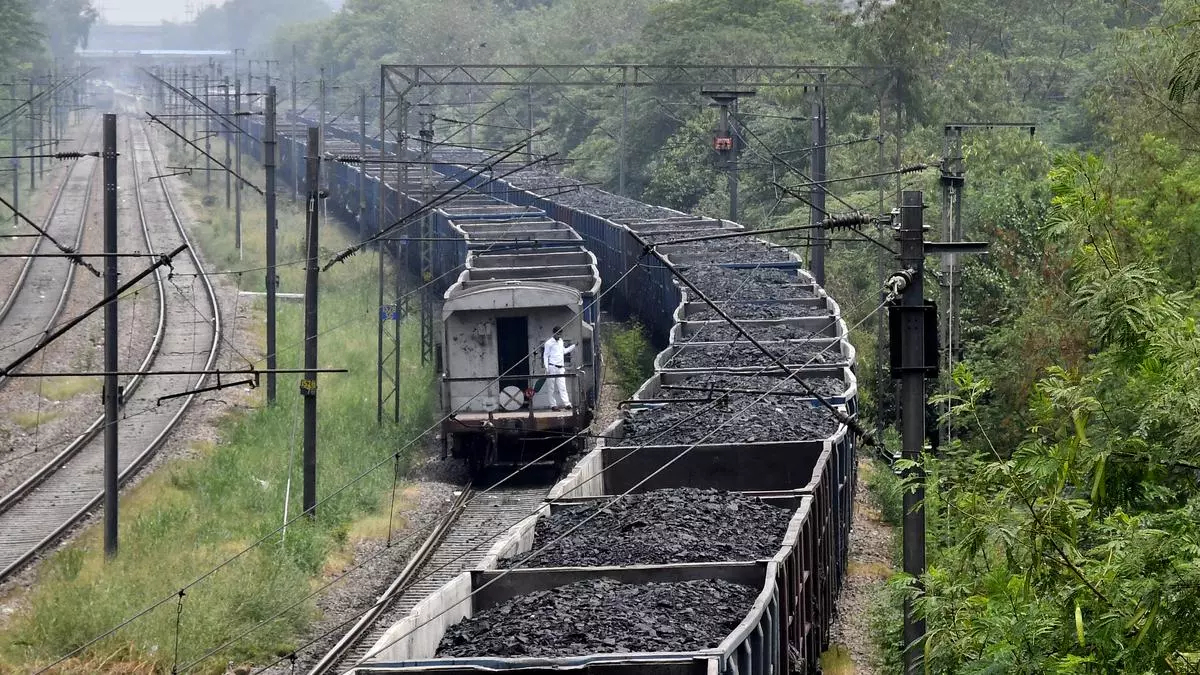
- 29 Mar 2024
Why is it in the News?
In recent years, the combination of unpredictable weather patterns and rapid economic growth has resulted in significant spikes in electricity demand, posing a challenge to reliably meet the escalating requirements.
Background:
- India has grappled with the looming threat of electricity shortages in recent years, particularly exacerbated by rising temperatures amplifying the power demand.
- While discussions on this matter typically revolve around the deficit in domestic thermal coal and the need for imports, a more thorough investigation uncovers intricate challenges concerning logistics and regulatory interpretation.
- Therefore, it is imperative to delve into these dimensions, shedding light on the complexities of the situation and seeking solutions to tackle the root causes.
What are the Primary Causes of Domestic Thermal Coal Shortages?
- Transportation Infrastructure Deficiencies: A critical challenge lies in the inadequacy of transportation infrastructure, notably the railway network, which predominantly facilitates coal transportation across India.
- Despite substantial coal production, the limited capacity of railways often hampers timely delivery to power plants, contributing to delays and inefficiencies in the coal supply chain.
- Geographical Disparities: Complicating matters, the distribution of coal mines and power plants across diverse regions adds another layer of complexity to logistics.
- Power plants situated far from coal mines encounter heightened logistical hurdles, facing difficulties in securing a consistent coal supply due to increased transportation time and costs.
- Storage and Handling Limitations: Insufficient storage and handling infrastructure at both mines and power plants exacerbate challenges in managing demand and supply fluctuations.
- Inadequate storage capacity can lead to stockpiling issues, exacerbating delays and hindering efficient coal delivery.
Balancing Alternative Domestic Sources and Imports:
- Exploration of Alternative Domestic Sources: While alternative coal sources, like auctions organized by Coal India Ltd., present a viable domestic option, they often receive less attention compared to imports.
- These auctions enable power plants to procure coal domestically, albeit potentially at higher prices, yet remain overlooked in favor of imported coal.
- However, auctions offer a feasible alternative, particularly for plants not hindered by logistical constraints in accessing coal from auction sites.
- Narrow Focus on Imports: The discourse tends to prioritize imports as the default solution for coal shortages, neglecting the potential of domestic alternatives and failing to consider the broader implications of heavy reliance on imported coal.
- Cost Implications: Importing coal entails additional costs, including transportation, handling, and import duties, resulting in higher variable costs for coal-based electricity.
- These expenses are often transferred to consumers through elevated electricity tariffs, burdening both households and industries.
- Regulatory Interpretation: Misinterpretation of Ministry of Power advisories recommending coal imports as mandates further blur the distinction between alternative sources and imports.
- While these advisories may propose importing a certain percentage of coal, they should not be perceived as obligatory requirements but rather as guidelines to be tailored to each power plant's unique circumstances.
- Less Emphasis on Domestic Procurement Enhancement: The emphasis on imports sidelines opportunities to improve domestic coal procurement and distribution processes.
- Addressing logistical hurdles and streamlining administrative procedures could enhance the efficiency and reliability of India's domestic coal supply chain, potentially reducing the reliance on costly imports.
Regulatory Frameworks Influencing Responses to Electricity Shortages and Coal Procurement Strategies:
- Clarifying Advisory Interpretations: An ongoing challenge in regulatory considerations involves clarifying interpretations of advisories from government entities like the Ministry of Power.
- While these advisories may offer recommendations for addressing coal shortages, particularly through import suggestions, they should not be misconstrued as mandates.
- Misinterpretation can lead to unnecessary costs and burdens on consumers, as power plants may feel compelled to comply with import recommendations, disregarding potentially viable domestic alternatives.
- Forward-Thinking Regulatory Decision-Making: Regulatory bodies overseeing electricity generation and distribution must adopt a forward-thinking approach to decision-making.
- This entails comprehensive assessments of regulatory measures' implications on stakeholders, including consumers, power producers, and distribution utilities.
- Analysis should weigh the costs and benefits of various coal procurement strategies, encompassing factors like transportation costs, import duties, and environmental impacts.
- Customized Approaches for Diverse Plant Settings: Recognizing the varied challenges among power plants regarding coal shortages, regulatory bodies should tailor measures to each plant's specific circumstances.
- Pit-head plants, closer to coal mines, may have easier access to domestic coal and encounter fewer logistical constraints compared to plants situated farther away, necessitating heavier reliance on imports.
- Regulatory interventions should thus be nuanced and adaptable rather than uniformly applied.
- Balancing Cost-Efficiency and Reliability: Regulators face the critical task of balancing cost and reliability in electricity supply.
- While imports may offer prompt solutions to coal shortages, they incur substantial costs affecting consumers.
- Therefore, regulators must meticulously evaluate the potential cost savings of domestic procurement against the reliability and security of imported coal supply, ensuring transparency and equity in decision-making.
- Long-Term Planning and Sustainability Integration: Regulatory considerations should encompass long-term planning and sustainability objectives alongside immediate coal shortage mitigation.
- While addressing immediate needs is crucial, regulators must also contemplate the broader ramifications of coal procurement strategies on energy security, environmental sustainability, and renewable energy transition.
- This necessitates a forward-looking approach aligning short-term actions with long-term sustainability objectives, facilitating India's transition to a resilient and sustainable energy framework.
Conclusion
Addressing electricity shortages in India necessitates a nuanced approach that considers both logistical hurdles and regulatory complexities. While importing coal may offer a temporary solution, it does not tackle the fundamental logistics inefficiencies. India can better navigate the challenges of power generation by addressing root causes and implementing tailored solutions, ensuring a more effective response to evolving weather patterns and increasing demand for electricity
WTO’s Investment Facilitation Negotiations Are Not Illegal
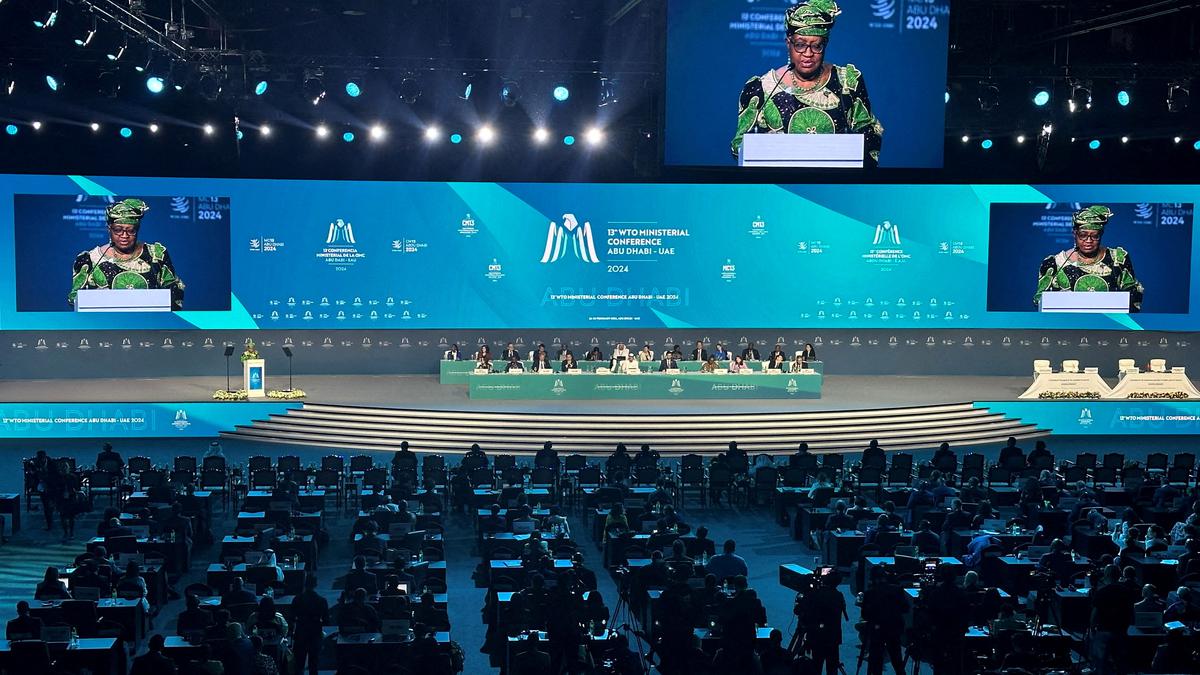
- 28 Mar 2024
Why is it in the News?
One significant event during the 13th Ministerial Conference (MC13) of the World Trade Organization (WTO) in Abu Dhabi was the inability to ratify the agreement concerning investment facilitation for development (IFD). Despite garnering backing from over 70% of the membership, approximately 120 member countries, the agreement remained unadopted.
Context:
- The recent 13th Ministerial Conference (MC13) of the World Trade Organisation (WTO) in Abu Dhabi unfolded a notable occurrence as the agreement on investment facilitation for development (IFD) failed to gain adoption.
- Despite substantial backing from approximately 120 member countries, the IFD Agreement encountered resistance, particularly from India and South Africa.
- In light of these events, it becomes imperative to delve into India's opposition to the IFD Agreement and its apprehensions regarding its alignment with WTO principles, especially concerning the intertwining of investment with trade and the procedural aspects of negotiation surrounding the agreement.
What is the IFD agreement?
- The Investment Facilitation for Development (IFD) Agreement is a legally binding framework that aims to enhance investment flows and promote transparency in regulatory processes.
- Finalized in November 2023, the agreement is the result of plurilateral negotiations initiated by 70 countries under the Joint Statement Initiative at the WTO in 2017.
- Despite initial opposition from some countries, including India, the IFD Agreement gained significant support, with 120 nations pushing for its inclusion as a plurilateral agreement within Annex 4 of the WTO Agreement.
- Although the WTO is primarily a multilateral trade organization, the allowance for plurilateral agreements under Article II.3 of the WTO Agreement sets the stage for binding commitments among participating WTO member countries.
Key objectives of the IFD Agreement include:
- Regulatory Transparency: Increasing openness in investment policies and procedures to instill confidence and predictability in the investment landscape.
- Streamlined Administrative Procedures: Simplifying investment-related processes and reducing red tape to attract and facilitate foreign investment inflows.
- By creating a stable and transparent environment for international investments, the IFD Agreement aims to contribute to economic growth and development, catalyzing cooperation among participating WTO members without imposing obligations on non-signatory countries.
What are India’s Concerns?
- India's resistance to the Investment Facilitation for Development (IFD) Agreement stems from concerns regarding its alignment with the WTO framework and the process undertaken to integrate it into the WTO rulebook.
- Given the WTO's dispute settlement mechanism, which solely permits state-to-state legal claims, incorporating Investor-State Dispute Settlement (ISDS) appears infeasible.
- This challenge contributed to India and South Africa's significant efforts to prevent the IFD Agreement from becoming an official component of WTO regulations.
India's primary apprehensions surrounding the IFD Agreement:
- Integrating Investment into the WTO: India questions the compatibility and relevance of investment policies within the WTO's scope, particularly when considering existing platforms dedicated to investment negotiations.
- Process-related Concerns: India argues that the procedure for incorporating the IFD Agreement into the WTO rulebook must be carefully scrutinized, ensuring adherence to established protocols and consensus-building among all member nations.
- While the actual content of the IFD Agreement does not appear to be India's primary concern, the nation's stance underscores the importance of considering the broader implications of such agreements within the global trade and investment landscape.
- As the international community navigates the complexities of investment facilitation and regulatory reform, the debate surrounding the IFD Agreement will continue to shape the future of multilateral cooperation and the evolution of the WTO's mandate.
Is Investment a Suitable Component of the WTO Framework?
- India posits that investment's integration into the World Trade Organization (WTO) may not inherently translate to increased cross-border trade, contrasting with scholarly perspectives emphasizing the interconnectedness of trade and investment.
- Citing the Organisation for Economic Co-operation and Development (OECD), it is highlighted that a substantial portion—70%—of international trade occurs within global value chains, underscoring the symbiotic relationship between trade and investment.
- Contemporary free trade agreements like the Regional Comprehensive Economic Partnership (RCEP) and the Comprehensive and Progressive Agreement for Trans-Pacific Partnership exemplify this integration, featuring comprehensive investment provisions encompassing facilitation and protection measures.
- Intriguingly, India's recent trade pact with the European Free Trade Association, despite including investment provisions focused on facilitation and promotion, underscores a pragmatic approach to incorporating investment elements, albeit with limitations.
Negotiating Process of the IFD Agreement:
- India has emphasized the absence of a negotiating mandate regarding investment discussions.
- India contends that the WTO's General Council's decision in 2004 ruled out talks on the nexus between trade and investment, a facet categorized under the 'Singapore issues' introduced during the 1996 WTO Singapore ministerial conference.
- These discussions were explicitly excluded from the Doha round of negotiations initiated in 2001.
- Additionally, India has pointed to the 2015 WTO Nairobi ministerial decision, which stipulates that launching negotiations on new issues multilaterally necessitates unanimous agreement among all member states.
- India argues that since consensus wasn't reached among all nations to commence negotiations on an IFD Agreement, the ensuing negotiations and the resultant text presented for adoption are deemed illegitimate.
Key Questions Surrounding the IFD Agreement:
- India's assertion of a negative mandate against initiating negotiations on the trade and investment relationship raises two critical queries warranting clarification.
- Firstly, does this negative mandate extend to all facets of investment, including facilitation?
- Notably, the shelved investment agreement proposed during the 1996 Singapore ministerial primarily addressed market access and investment protection, leaving ambiguity regarding whether the negative mandate encompasses all investment-related aspects within the WTO.
- Secondly, does the negative mandate solely pertain to launching negotiations on new issues in a multilateral context?
- The inquiry arises as to whether this prohibition extends to negotiations commenced on a plurilateral basis.
- The negotiations for an IFD agreement were instigated on a plurilateral, not multilateral, basis.
- Although Article X.9 of the WTO Agreement stipulates that adding an agreement to the existing set of Plurilateral Agreements listed in Annex 4 necessitates consensus exclusively, the agreement lacks provisions mandating consensus for initiating negotiations for a Plurilateral Agreement.
Way forward:
- As the primary regulatory body for international trade, the World Trade Organization (WTO) is responsible for updating existing rules and establishing new ones.
- However, reaching a consensus on decision-making within the WTO remains a significant challenge, often leading to legislative deadlock.
- In this context, Preferential Agreements (PAs), such as the proposed Investment Facilitation for Development (IFD) Agreement, can serve as catalysts for reinvigorating the WTO's legislative function.
- By fostering cooperation among subsets of WTO members, Preferential Agreements (PAs) can help circumvent the challenges of consensus-building within the broader organization.
- As India continues its ascent to become the world's third-largest economy, it is increasingly critical for the nation to reassess its defensive posture toward PAs.
- By recognizing the potential benefits of agreements like the IFD, India has the opportunity to demonstrate leadership on the global stage, support the revitalization of the WTO's legislative function, and contribute to a more collaborative and effective approach to international trade regulation.
Conclusion
The failure to ratify the IFD agreement at MC13 underscores the formidable challenges encountered by the WTO in navigating intricate matters such as investment facilitation. It underscores the divergent perspectives among member nations regarding the scope and nature of the WTO's role in governing global economic interactions. Closing these divergences becomes imperative for the WTO to adeptly address the evolving landscape of international trade and investment
TB-Mukt Bharat India's Fight Against Tuberculosis
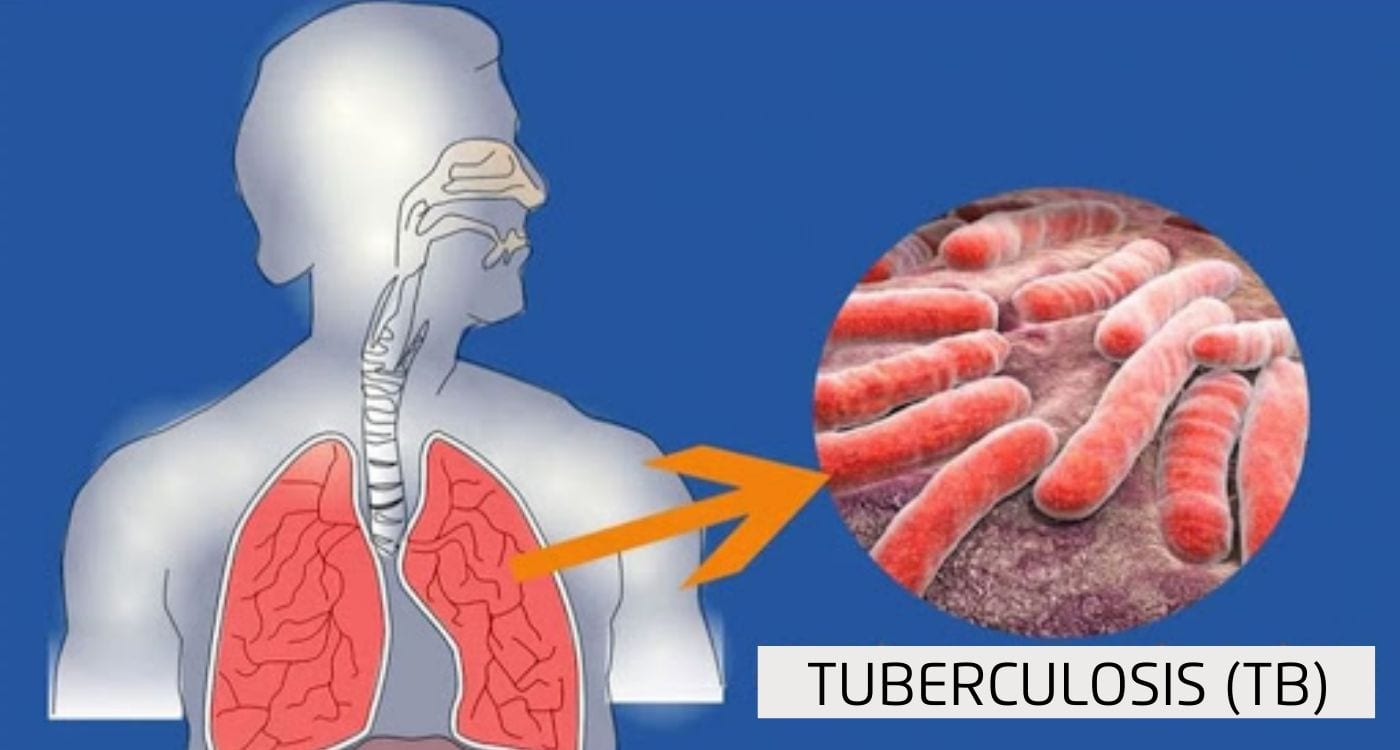
- 26 Mar 2024
Why is it in the News?
Even though World TB Day (March 24) has passed, recognizing the needs and interests of patients and communities must form the basis of disease elimination.
What is Tuberculosis?
- Tuberculosis (TB) is an airborne bacterial infection caused by a type of bacteria called mycobacterium tuberculosis.
- The infection primarily attacks our lungs and if not treated early, permanent lung damage can result.
- Tuberculosis can also spread to other parts of the body such as the intestines, bones and joints, brain, skin, and other tissues of the body.
- It can be classified into two categories:
- Active tuberculosis (TB) and
- Latent tuberculosis (TB).
Causes of Tuberculosis (TB):
- Mycobacterium tuberculosis usually spreads from person to person through airborne droplets, which are produced when the infected person coughs, sneezes, speaks, or sings.
Signs & symptoms of Tuberculosis (TB):
- A person with latent Tuberculosis (TB) cannot spread the infection to others as it is not contagious and may not show symptoms because their immune system is protecting them from getting sick.
- However, latent TB can develop into active TB if that individual’s immune system cannot stop the bacteria from growing and starts showing symptoms such as:
- Bad cough that lasts for 3 weeks or longer
- Pain in chest
- Coughing blood or sputum
- Fever or night sweats
- Weight loss or no appetite
- Chills
- Weakness
Diagnosis of Tuberculosis (TB):
- Tuberculosis (TB) can be tested in two ways, namely skin test and blood test.
- These two tests only tell if a person has TB or not; if the test is positive then other tests are needed to check if it is latent TB or active TB, such as chest X-ray or CT, or acid-fast bacillus tests (sputum tests).
Treatment of Tuberculosis (TB)
- Both latent TB and active TB can be effectively treated with antibiotics, albeit requiring different durations of treatment.
- Complete adherence to medication is imperative for curing TB; failure to complete the prescribed course may lead to the recurrence of illness and increased difficulty in recovery.
- For latent TB, treatment typically involves a course lasting 3-9 months, comprising 1-2 antibiotics.
- While active TB necessitates a more extensive regimen, with doctors prescribing 2 to 4 or more antibiotics for 6-9 months or longer.
- Ensuring proper medication adherence is crucial for individuals with latent TB to prevent its progression to active TB.
- In many cases, significant improvement is observed within weeks of initiating treatment, with the infection becoming non-contagious.
- Therefore, completing the full course of medication is essential to safeguard oneself and others from tuberculosis.
What is drug-resistant Tuberculosis (TB)?
- Drug-resistant TB is when the bacteria that causes TB becomes resistant to some or all the medications.
- Once drug-resistant TB is developed, it is very difficult to treat it.
- It may require more and different medications with a longer period of treatment.
- Some injectable drugs can cause loss of hearing and balance problems.
Status of TB in India:
- India bears approximately 27% of the global burden of tuberculosis (TB), making it the country with the highest TB burden worldwide.
- Government of India aims to eliminate tuberculosis (TB) by 2025.
- The theme for World Tuberculosis Day (March 24) in 2024 was the same as in 2023 “Yes, we can end TB”, which reflects the United Nations Sustainable Development Goals (SDGs) to eliminate TB by 2030.
Challenges Confronting India in TB Elimination:
- Drug-resistant TB Cases: India grapples with a substantial burden of drug-resistant TB, including multidrug-resistant TB (MDR-TB), necessitating more expensive, specialized drugs and prolonged treatment durations.
- Diagnostics and Case Detection: Accurate and timely TB diagnosis remains a challenge, particularly in areas lacking access to modern diagnostic tools, leading to reliance on older, less reliable methods.
- Poor Primary Healthcare and Infrastructure: Limited access to healthcare facilities, especially in rural and remote regions, results in delayed diagnosis and treatment, facilitating TB transmission within communities.
- Stigma and Awareness: Stigma surrounding TB may deter individuals from seeking timely healthcare, while inadequate awareness about the disease perpetuates its prevalence.
- Private Sector Engagement: With a significant portion of healthcare services provided by the private sector, effective TB control necessitates coordinated efforts and standardized treatment protocols between the public and private sectors.
- Treatment Adherence: Ensuring patient adherence to the full course of TB treatment, which involves prolonged antibiotic courses, poses a significant challenge.
- Vulnerable Populations: Certain demographics, such as migrant workers, urban slum dwellers, and individuals residing in overcrowded conditions, face heightened TB risks, requiring targeted interventions.
Initiatives by the Government of India to Eradicate TB:
- National Tuberculosis Elimination Program (NTEP): A National Strategic Plan (2017-25) aims to eliminate TB from India by 2025.
- Pradhan Mantri TB Mukt Bharat Abhiyan (PMTBMBA): Introduced in 2022, this initiative provides community support to TB patients, offering nutritional, diagnostic, and vocational assistance.
- Revised National Tuberculosis Control Program (RNTCP): Launched in 1997, RNTCP has been continuously revised and strengthened to combat TB effectively.
- Universal Drug Susceptibility Testing (DST): Efforts have been intensified to ensure universal access to drug susceptibility testing, enabling early detection of drug-resistant TB strains for tailored treatment.
- Ni-kshay Portal: An online platform established to monitor notified TB cases effectively.
- Introduction of New Drugs: Drugs like Bedaquiline and Delamanid for treating drug-resistant TB are provided free of cost to TB patients.
- Research and Development (R&D) for Treatment: Studies are ongoing to explore shorter anti-tubercular drug courses, aiming to reduce treatment duration.
- Vaccine Development: Trials are being conducted to evaluate the effectiveness of vaccines such as Immuvac and VPM1002 in preventing TB, offering promising avenues for future TB prevention strategies.
Global Efforts to Eradicate TB:
- End TB Strategy: spearheaded by the World Health Organization (WHO), it provides a roadmap for countries to reduce TB incidence by 80%, and TB deaths by 90%, and eliminate catastrophic costs for TB-affected households by 2030.
- World Development Report (1993): Published by WHO, it highlighted TB treatment for adults as the most cost-effective among all developmental interventions.
- The Global Fund: a global initiative aimed at defeating HIV, TB, and malaria, striving for a healthier, safer, and more equitable future worldwide.
- The Stop TB Partnership: a collaborative effort involving expertise from diverse country, regional, and global partners, dedicated to transforming the TB landscape and achieving the goal of ending TB by 2030.
- Sustainable Development Goal 3: part of the United Nations' Sustainable Development Goals, it targets to end the TB epidemic by 2030, reflecting a commitment to global health and well-being.
Way Forward:
- Development and Widespread Adoption of an Adult TB Vaccine: Prioritizing the research and development of an effective vaccine against TB for adults.
- Ensuring widespread distribution and utilization of the vaccine to bolster TB prevention efforts globally.
- Cost Reduction of Anti-TB Drugs: Implementing strategies to lower the production costs of essential anti-TB medications.
- Making these drugs more accessible and affordable to all individuals in need, regardless of economic status.
- Innovation in TB Treatment: Investing in research and development to create injection-free and orally-administered TB medications.
- Expanding treatment options to enhance patient compliance and improve treatment outcomes.
- Integration of AI-Assisted Radiology: Leveraging artificial intelligence (AI) technology to facilitate rapid and accurate TB diagnosis.
- Promoting the use of handheld radiology devices equipped with AI algorithms, allowing for quick TB detection with high accuracy rates, thereby streamlining diagnostic processes and improving patient care.
Many elections, AI’s dark dimension
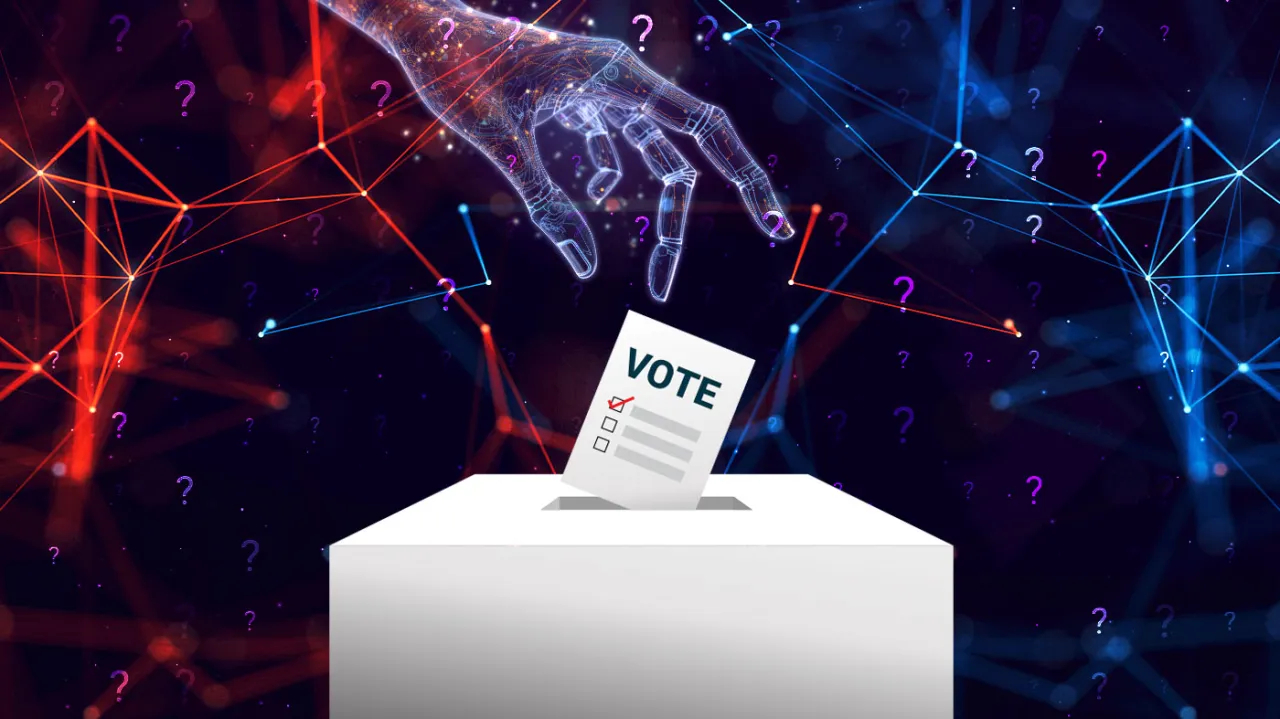
- 18 Mar 2024
Why is it in the News?
With a series of elections to be held across the world in 2024, the potential of AI to disrupt democracies cannot be dismissed.
Context:
- The rapid advancement of Artificial Intelligence (AI) marks a significant turning point in human history.
- With the rise of Generative AI (GAI), the possibility of achieving Artificial General Intelligence (AGI) becomes increasingly feasible, raising questions about its potential to mimic human abilities.
- Thus, exploring AI's profound influence on human life, particularly within electoral contexts and broader societal realms, is imperative.
What is Generative AI (GAI)?
- Generative AI, short for Generative Artificial Intelligence, represents a branch of artificial intelligence focused on creating new content rather than simply processing or analyzing existing data.
- Unlike traditional AI systems, which are designed to recognize patterns or make predictions based on historical data, generative AI models have the capability to generate new data that resembles real-world examples.
- These models work by learning patterns and structures from large datasets and then using that knowledge to create new content.
- They can produce various types of content, including images, text, audio, and even video.
- For example, a generative AI model trained on a dataset of human faces can generate realistic-looking images of faces that have never existed before.
- They can produce various types of content, including images, text, audio, and even video.
- One of the key technologies behind generative AI is deep learning, particularly a type of neural network called a generative adversarial network (GAN).
- In a GAN, two neural networks are pitted against each other: a generator and a discriminator.
- The generator creates new data samples, while the discriminator tries to distinguish between real and fake data.
- Through this adversarial process, the generator learns to produce increasingly realistic content.
- Generative AI has a wide range of applications across various industries.
- In the field of art and design, it can be used to generate new artwork, music, or even fashion designs.
- In entertainment, it can create realistic characters and environments for video games and movies.
- In healthcare, it can generate synthetic medical images for training diagnostic algorithms.
- However, the technology also raises ethical concerns, such as the potential for misuse, copyright issues, and the creation of fake content.
The Role of Artificial Intelligence (AI) in Shaping Electoral Landscapes:
- A Transformative Influence- AI's Ascendancy in Politics: The integration of artificial intelligence (AI) into electoral processes represents a profound transformation in global political dynamics.
- As nations gear up for elections, the incorporation of AI technologies introduces new variables that require a reassessment of conventional campaign methodologies and voter outreach strategies.
- In the context of upcoming elections, including India's extensive seven-phase general election, AI emerges as a decisive factor influencing electoral trajectories.
- The deployment of Generative AI, with its ability to conduct dynamic simulations and replicate real-world interactions, presents unprecedented opportunities and challenges for political stakeholders and the electorate.
- Harnessing AI for Campaign Innovation and Voter Engagement: Political entities and candidates are leveraging AI-driven tools to analyze vast datasets, craft targeted messaging, and optimize campaign blueprints.
- AI-powered predictive analytics empower parties to pinpoint swing voters, tailor messages to specific demographics, and deploy resources more precisely.
- Additionally, AI-enabled sentiment analysis of social media platforms furnishes real-time insights into voter attitudes and emerging concerns, informing campaign narratives and responsiveness strategies.
- Moreover, AI's impact extends beyond campaign frameworks to encompass voter engagement and mobilization endeavors.
- Through AI-driven chatbots, personalized interactions with voters are facilitated, addressing inquiries, disseminating information, and fostering voter participation.
What are the Concerns Regarding AI's Impact on Electoral Integrity?
- Challenges Posed by Deep Fakes: The expanding presence of AI within electoral arenas prompts apprehensions regarding its implications for democratic processes and the integrity of elections.
- The emergence of 'Deep Fake' technology, capable of generating convincingly realistic yet fabricated audio, video, and textual materials, presents a formidable obstacle in identifying and combatting misinformation and disinformation campaigns.
- Deep fakes produced by AI possess the capacity to deceive voters, manipulate public opinion, and erode trust in democratic institutions, thus distorting the integrity of electoral outcomes.
- Impact on Public Discourse and Decision-making: Moreover, the utilization of AI-powered algorithms in social media platforms for content curation and recommendation purposes raises concerns regarding filter bubbles, echo chambers, and algorithmic bias.
- These algorithms, driven by AI, may inadvertently amplify divisive content, perpetuate existing biases, and contribute to the segmentation of public discourse, consequently influencing voter perceptions and decision-making processes.
What are AI Influences its challenges, and Mitigation Strategies?
- As artificial intelligence (AI) permeates various spheres of society, including electoral contexts, addressing the concept of AI influence becomes increasingly critical.
- AI influence refers to the ability of AI-driven tactics to shape human behavior and decision-making processes, often without individuals' explicit awareness or consent.
- Challenges in Addressing AI Influence: A primary challenge in addressing AI influence is mitigating its impact on electoral dynamics.
- AI-powered algorithms can analyze extensive data sets to predict and influence voter behavior, potentially affecting electoral outcomes in ways that may not align with democratic principles or voter preferences.
- To counter this, safeguards must be implemented to prevent undue AI-driven influence on electoral processes and outcomes.
- Promoting Transparency and Accountability: Transparency and accountability are crucial in addressing AI influence.
- Electoral authorities and policymakers should establish clear guidelines and regulations governing the use of AI in political campaigns and voter engagement efforts.
- This includes mandates for disclosing the use of AI-driven algorithms, data sources, and methodologies in campaign strategies, enhancing public awareness and understanding of AI's role in elections.
- Protecting Democratic Values: Efforts to combat AI influence should prioritize safeguarding democratic values and electoral integrity.
- Measures must be implemented to detect and mitigate AI-driven manipulation, such as disinformation campaigns, deep fakes, and algorithmic bias.
- Collaborative approaches involving electoral authorities, technology firms, civil society organizations, and academia are essential to develop effective tools and techniques for detecting and countering AI-driven threats to electoral integrity.
- Empowering Voter Literacy: Promoting media literacy and digital literacy among voters is crucial for combating AI influence.
- By equipping voters with the skills to critically evaluate information sources, distinguish fact from fiction, and identify manipulation tactics, individuals can resist the influence of AI-driven propaganda and make informed voting decisions.
- Educational initiatives, public awareness campaigns, and media literacy programs are vital for enhancing voter resilience against AI-driven misinformation and manipulation.
Additional Measures for Ensuring Electoral Integrity:
- Incorporating Ethical Guidelines into AI Governance: Furthermore, the ethical dimensions of AI governance should inform the development and application of AI technologies within electoral contexts.
- Ethical AI governance frameworks should prioritize principles such as fairness, transparency, accountability, and adherence to democratic values.
- This entails conducting comprehensive risk assessments, ensuring transparency and explainability in algorithms, and establishing mechanisms for independent oversight and accountability.
- Adopting Proactive Strategies: Policymakers, electoral authorities, and civil society actors should embrace proactive strategies to uphold electoral integrity and democratic principles in the age of AI.
- Implementing robust regulatory frameworks, transparency mandates, and oversight mechanisms is crucial for mitigating the risks associated with AI-driven manipulation and disinformation campaigns.
- Furthermore, investments in digital literacy initiatives and media literacy programs can empower voters to critically assess information sources, distinguish between fact and fiction, and resist manipulation efforts.
Way Forward:
- The risks associated with AI pose a substantial threat, surpassing concerns regarding biases in its design and development.
- AI systems inherently tend to manifest adversarial traits, for which effective mitigation strategies have yet to be fully realized.
- Beyond electoral implications, India's position as a digital frontrunner necessitates a cautious approach towards AI adoption, recognizing both its potential advantages and disruptive capabilities.
- While AI offers numerous benefits, it is imperative for the nation and its leaders to acknowledge its potential for malevolence.
- India's prominence in digital innovation presents both opportunities and challenges, as the advancement of AI, including AGI, brings both advantages and risks.
- Addressing the complexities of AI policy requires amplifying democratic voices and resisting the tendency to cede policymaking authority to a select few tech conglomerates.
Conclusion
The emergence of AI marks a significant milestone in human evolution, impacting electoral dynamics and social harmony in profound ways. While AI offers remarkable progress, it demands careful oversight to minimize its disruptive effects and uphold democratic values. As we venture into the realm of AI, wise decision-making and forward-thinking are essential to steer toward a future characterized by ethical AI governance and conscientious innovation.
India’s R&D Funding, Breaking Down the Numbers
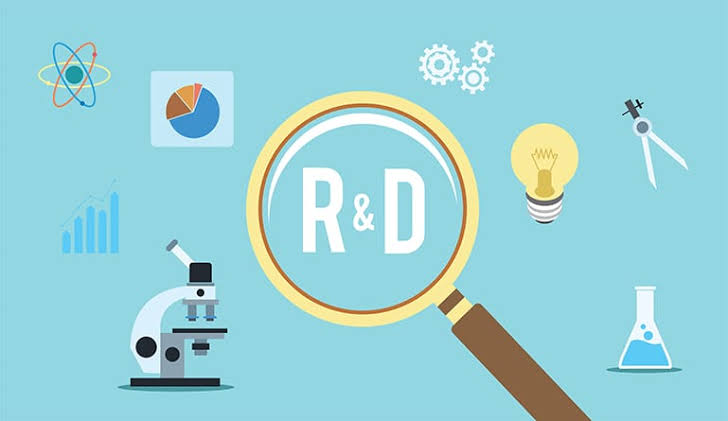
- 14 Mar 2024
Why is it in the News?
The announcement in the interim Budget for 2024-25, of a corpus of ?1 lakh crore to bolster the research and innovation ecosystem within the country, has sparked enthusiasm within the scientific and research communities.
Context:
- In the current scenario, the recent allocation of a substantial ?1 lakh crore in India's Interim Budget for 2024-25 to enhance the research and innovation ecosystem underscores the nation's dedication to advancing scientific pursuits.
- Additionally, the decision to expand the iconic slogan 'Jai Jawan Jai Kisan' to 'Jai Jawan, Jai Kisan, Jai Vigyan, Jai Anusandhan' signifies a renewed focus on research and innovation as essential elements of development.
- Evaluating the present state of India's research and development (R&D) landscape, including its funding, output, and the potential impact of recent initiatives on nurturing a conducive environment for research and innovation, is imperative.
Current Outlook of India's R&D Landscape:
- Gross Expenditure on Research and Development: India's R&D sector has witnessed substantial growth, with Gross Expenditure on Research and Development (GERD) increasing from ?6,01,968 million in 2010-11 to ?12,73,810 million in 2020-21.
- Despite this growth, India's research investment as a percentage of GDP remains at 0.64%, lagging behind major developed and emerging economies like China (2.4%), Germany (3.1%), South Korea (4.8%), and the United States (3.5%).
- Academic Talent: Despite the relatively lower GDP allocation for R&D, India has emerged as a key producer of academic talent, annually producing an impressive 40,813 PhDs, ranking third globally after the United States and China.
- Research Output: India's research output remains substantial, ranking third globally with over 3,00,000 publications in 2022, showcasing the nation's robust research ecosystem and its dedication to advancing knowledge across various fields.
- Innovation: India demonstrates commendable performance in patent grants, securing the sixth position globally with 30,490 patents granted in 2022.
- While this number is lower compared to the U.S. and China, it reflects India's evolving innovation landscape and its potential for further growth in intellectual property creation.
- Major Sponsors: In India, GERD is primarily driven by the government sector, including the central government (43.7%), State governments (6.7%), Higher Education Institutions (HEIs) (8.8%), and the public sector industry (4.4%), with the private sector industry contributing only 36.4% during 2020–21.
- Investment in R&D: According to R&D statistics (2022-23) from the Department of Science and Technology, India's total investment in R&D reached $17.2 billion in 2020-21.
- Within this sum, 54% ($9.4 billion) is allocated to the government sector, predominantly utilized by four key scientific agencies — the DRDO (30.7%), the Department of Space (18.4%), ICAR (12.4%), and the Department of Atomic Energy (11.4%).
Major Challenges Facing R&D:
- Private Sector Inertia: Despite India's significant Gross Expenditure on Research and Development (GERD), private industries contribute only 37% of the country's R&D funding, reflecting a discrepancy compared to the global trend where business enterprises typically contribute over 65%.
- Low Participation by Higher Education Institutions (HEIs): HEIs play a minor role in R&D investment, contributing only 8.8% ($1.5 billion), limiting their potential contribution to research and innovation.
- Brain Drain: Talented researchers often migrate to countries with better research infrastructure and funding opportunities, leading to a loss of skilled manpower and hindering R&D progress.
- Inadequate Education and Training: The education system may fail to adequately equip students with the requisite skills and knowledge needed to excel in R&D, posing a challenge to innovation and scientific advancement.
- Bureaucratic Hurdles: Complex procedures and bureaucratic red tape can impede research initiatives, delaying progress and discouraging potential investors from engaging in R&D activities.
- Limited Collaboration with Academia: A gap exists between academic research and industry needs, hampering the effective transfer of knowledge and technology, and inhibiting the development of innovative solutions to real-world problems.
Proposed Measures:
- Embrace a Collaborative Approach: Fostering collaboration among the government, business enterprises, and Higher Education Institutions (HEIs) is imperative to harness the full potential of science, technology, and innovation for driving economic growth and technological progress.
- Promote Public-Private Partnerships: Encouraging collaboration between academia and industry can facilitate the translation of research findings into commercial applications, bridging the gap between theoretical knowledge and practical implementation.
- Optimize Resource Allocation: Directing resources towards safeguarding intellectual property rights and addressing technical challenges can unlock new markets and spur innovation.
- Provide Government Subsidies to Stimulate Private Sector Investment: Implementing government initiatives such as tax incentives and grants can incentivize increased private sector investment in Research and Development (R&D), bolstering India's R&D ecosystem and fostering stronger industry-academia partnerships for knowledge exchange and innovation.
- Prioritize Skill Development: Reforms in education that prioritize the development of critical thinking, problem-solving, and research skills are essential to nurture a workforce capable of driving innovation and scientific advancement.
- Streamline Bureaucratic Processes: Simplifying regulatory procedures and regulations can expedite research projects, attract investments, and create a conducive environment for R&D activities.
- Incentivize Innovation: Introducing government schemes and awards to recognize and reward innovative research endeavors can incentivize scientists, researchers, and businesses to pursue groundbreaking innovations that contribute to societal progress and economic development.
Government Initiatives:
- National Deep Tech Startup Policy (NDTSP): Recent initiatives, such as the National Deep Tech Startup Policy (NDTSP) and the Anusandhan National Research Foundation (ANRF) Act, signal a strong commitment to fostering research and innovation.
- The NDTSP aims to incentivize private sector engagement in R&D, while the ANRF Act seeks to bridge the R&D investment gap and nurture a robust research culture within HEIs.
- Anusandhan National Research Foundation (ANRF) Act: Enacted to address India's persistent R&D investment gap, this legislation aims to cultivate a thriving research culture within Higher Education Institutions (HEIs) and drive innovation across various sectors.
- UchhatarAvishkarYojana (UAY): Geared towards promoting innovation that addresses industry needs and enhances India's manufacturing competitiveness, UAY fosters collaboration between academia and industry, both domestically and internationally, to drive advancements in research and technology.
- Impacting Research Innovation & Technology (IMPRINT): This initiative endeavors to tackle pressing engineering challenges by facilitating interdisciplinary research collaborations and translating knowledge into practical solutions across ten designated technology domains.
- Establishment of Research Parks: Research parks established at premier institutes such as IIT Delhi, IIT Guwahati, and IIT Kharagpur serve as platforms for fostering collaboration between academia, industry, and entrepreneurial ventures, facilitating the establishment of R&D units, and promoting innovation.
- Impact of Recent Initiatives: These initiatives, coupled with the allocation in the interim Budget, are poised to drive India's research and innovation agenda forward, particularly in burgeoning industries.
Way Forward:
- India's technological and manufacturing ambitions rely on a pivotal transformation within its R&D domain, necessitating a dual-pronged strategy:
- Encouraging active participation from the private sector, alongside
- Strengthening the research infrastructure within academia.
- Embracing a multifaceted approach that engages a spectrum of stakeholders is imperative to confront the challenges and unlock the full potential of R&D, fostering India's economic expansion and global competitiveness.
- Drawing insights from the R&D frameworks of developed nations while leveraging India's inherent strengths in agile decision-making and strategic alignment could catalyze a formidable evolution within its R&D landscape.
Conclusion
While significant strides have been made, there is a need for increased funding, stronger industry-academia collaboration, and policy measures to incentivize private sector involvement. Recent initiatives such as the NDTSP and the ANRF Act represent positive steps towards realizing India's potential as a powerhouse of research and innovation. By creating a conducive environment for research and innovation, India can pave the way for sustainable development and prosperity in the years to come.
Gender equality as the plank of sustainable development

- 09 Mar 2024
Why is it in the News?
Though women have a crucial role in energy access, production, and consumption, they face barriers that limit their participation and impact in the energy sector.
Context:
- Gender equality and women's empowerment discussions have surged in recent times.
- Yet, the interconnectedness of gender equality and sustainable energy development is frequently neglected.
- Hence, there's a crucial need to delve into the intricate relationship between these areas, recognizing their pivotal contribution to attaining Sustainable Development Goals (SDGs).
The Crucial Role of Gender Equality in Sustainable Energy:
Gender equality is not just a matter of social justice; it is also a prerequisite for sustainable development. Women play a crucial role in energy access, production, and consumption. Yet, they often face significant barriers that limit their participation and impact in the energy sector. This gender disparity not only hampers individual opportunities but also hinders overall economic growth and environmental sustainability.
- Foundational Role in SDGs: Gender equality is intricately linked with SDGs like SDG5 (gender equality), SDG7 (clean energy), and SDG12 (climate action), serving as a cross-cutting enabler for overall SDG success.
- Impact on Clean Energy Access: Studies consistently demonstrate that gender equality and women's empowerment are essential for achieving universal access to sustainable energy.
- Recognizing women's active participation in the energy sector is crucial for devising inclusive policies and strategies for clean energy access.
- Strategic Alignment with Climate Action: Gender equality is integral to climate action, as reflected in its inclusion in SDG12.
- Empowering women in the energy sector fosters sustainable and climate-resilient practices, supporting efforts to combat environmental degradation.
- Social Justice and Economic Development: Gender equality in sustainable energy transcends SDGs, embodying principles of social justice.
- Addressing gender disparities in energy access not only aligns with moral imperatives but also drives broader economic growth and prosperity.
Gender Equality in Energy Access:
- Household Responsibilities: Women predominantly manage household energy tasks like cooking, heating, and lighting.
- However, energy infrastructure tends to reach women last, leading to a lack of access to modern energy sources, forcing reliance on harmful alternatives like biomass and kerosene.
- Disproportionate Impact: The absence of clean and reliable energy sources exposes women and children to household air pollution, contributing to 3.2 million premature deaths annually, with 60% affecting women and children, according to the World Health Organization (WHO).
- Energy Poverty: Limited access to modern energy perpetuates energy poverty, exacerbating health risks associated with household air pollution and hindering socio-economic development.
- Gender Disparity in the Energy Sector: Despite representing 48% of the global labor force, women constitute only 32% of full-time employees in the renewable energy sector and a mere 22% in the overall energy sector.
- Educational Barriers: Gender disparities in educational access hinder women from acquiring technical skills and training necessary for employment in the energy sector, further perpetuating gender inequality.
- Limited Opportunities: Women face restricted opportunities to pursue technical roles within the energy sector, contributing to the underrepresentation of women in positions of leadership and decision-making.
- Inequitable Policies: Company policies within the energy sector often fail to promote gender diversity and equality, perpetuating systemic barriers to women's advancement and participation in the industry.
What are the Economic Benefits of Empowering Women in the Energy Sector?
- Increased Productivity and Efficiency: Empowering women in the energy sector can lead to increased productivity and efficiency.
- Diverse teams that include women bring different perspectives, problem-solving approaches, and innovative ideas, enhancing overall productivity in the workplace.
- Enhanced Decision-Making and Problem-Solving: Women's inclusion in decision-making processes within the energy sector can lead to more effective problem-solving and decision-making.
- Research indicates that diverse teams, including gender-diverse ones, tend to make better decisions by considering a wider range of perspectives and factors.
- Talent Retention and Recruitment: Promoting gender diversity and inclusion in the energy sector can help attract and retain top talent.
- Organizations that prioritize gender equality are often perceived as more desirable workplaces, leading to improved recruitment and retention rates.
- Access to Untapped Talent Pool: Empowering women in the energy sector provides access to an untapped talent pool, thereby addressing skills shortages and labor market gaps.
- By tapping into the skills and expertise of women, energy companies can enhance their competitiveness and adaptability in a rapidly evolving industry.
- Economic Growth and Sustainable Development: Gender equality in the energy sector contributes to broader economic growth and sustainable development.
- Women's participation in the workforce, particularly in high-growth sectors like energy, stimulates economic activity, drives innovation, and fosters inclusive growth.
- Increased Financial Performance: Companies with greater gender diversity at all levels, including leadership positions, tend to outperform their less diverse counterparts financially.
- Research suggests that organizations with diverse leadership teams achieve higher financial returns, indicating a positive correlation between gender diversity and financial performance.
- Reduction in Gender Pay Gap: Empowering women in the energy sector can help reduce the gender pay gap and promote equitable compensation practices.
- By ensuring equal pay for equal work and addressing barriers to women's advancement, energy companies can create fairer and more inclusive workplaces.
Way Forward:
- Address Gender Disparity in the Energy Sector: Transform perceptions regarding women's roles in the energy sector and integrate gender considerations into energy policies at all levels.
- Stakeholders including governments, non-state actors, international institutions, and philanthropic organizations must collaborate to create an enabling environment and implement innovative solutions.
- This approach not only enhances access to clean energy but also fosters women's meaningful participation in the sustainable energy transition.
- Promote Entrepreneurship and Collective Initiatives: Support initiatives like the Energy Transitions Innovation Challenge (ENTICE) that empower individuals, particularly women, to initiate entrepreneurial ventures and drive collective action for sustainable energy.
- Explore opportunities in Distributed Renewable Energy (DRE) initiatives, which are being implemented by various state governments in India in partnership with philanthropic organizations.
- DRE initiatives can rapidly deliver affordable energy access, alleviate women's daily burdens, and enhance their productivity.
- Leverage Inspirational Initiatives: Draw inspiration from initiatives such as Solar Mamas launched by Barefoot College in India, which empowers illiterate women to become solar engineers.
- These initiatives not only bring clean energy solutions to communities but also promote women's economic empowerment and leadership in the energy sector.
Conclusion
It is important to recognise that the dialogue on gender and energy has clearly shifted from women being identified as part of vulnerable groups to acknowledging them as key agents of change and decision makers across the energy sector. Gender-responsive and women-led initiatives have been successful in the clean energy space. That is why, this is the right time to harness the power of women and energy to create a more inclusive, prosperous, and sustainable world for present and future generations.
Green jobs and the problem of gender disparity
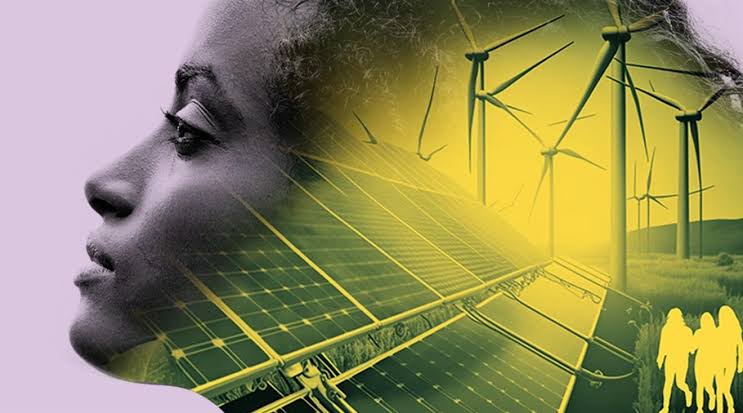
- 06 Mar 2024
Why is it in the News?
Increasing women’s representation in green jobs will lead to benefits such as boosting a low-carbon and environmentally sustainable economy
Context:
- The worldwide movement towards low-carbon development presents India with a distinctive opportunity for progress.
- Nevertheless, this transition brings forth a gender disparity challenge, as men tend to transition to green jobs more rapidly than women.
- Hence, it's crucial to delve into the gender aspects of India's green transition, highlighting the imperative for women's empowerment and gender equality in climate initiatives.
What are Green Jobs?
- Green jobs represent a category of employment directly benefiting the planet and contributing to overall environmental well-being.
- These roles are geared towards mitigating the negative environmental impact of various economic sectors and advancing the creation of a low-carbon economy.
- Occupations involving renewable energy, resource conservation, and the promotion of energy-efficient practices fall under this umbrella.
- The International Labour Organization characterizes green jobs as 'decent jobs that contribute to the preservation or restoration of the environment.'
- They encompass diverse sectors such as manufacturing, construction, renewable energy, energy efficiency, and automobiles, historically characterized by lower female representation.
Gender Disparity in Green Jobs:
- Globally, men tend to transition to green jobs at a faster pace than women.
- Despite India's significant increase in renewable energy capacity by 250% between 2015 and 2021, women constitute only 11% of workers in the solar rooftop sector.
- The Annual Survey of Industries 2019-20 reveals that women workers are predominantly concentrated in industries like apparel, textile, leather, food, and tobacco.
- According to a Confederation of Indian Industry (CII) 2019 report, men make up 85% of the workforce in sectors such as infrastructure, transport, construction, and manufacturing.
- A 2023 study by the Skill Council for Green Jobs indicated that 85% of green skills training was provided to men, with over 90% of women expressing belief that social norms hinder their participation in such training.
- Restrictive social norms contributing to this disparity include perceptions that women are unsuitable for certain technical roles, safety concerns, lower representation in science, technology, engineering, and mathematics (STEM) subjects, and familial constraints.
Advantages of Women's Engagement in Green Jobs:
- Addressing Gender Bias in the Labour Market: Increased representation of women in green jobs acts as a potent remedy to entrenched gender biases in the labor market.
- By entering traditionally male-dominated sectors like manufacturing, construction, and renewable energy, women challenge stereotypes and reshape societal perceptions of gender roles.
- Expanded Economic Opportunities: Women's greater involvement in green jobs opens up expanded economic avenues for them.
- Participation in sectors such as renewable energy and energy efficiency enables women to access high-growth industries, fostering both economic growth and personal financial stability.
- Beyond economic benefits, engagement in green jobs offers opportunities for women's advancement in technical and social spheres, exposing them to innovative technologies, sustainable practices, and networking opportunities.
- Empowerment of Women's Agency: The transition to green jobs empowers women by granting them agency over their economic destinies.
- In roles contributing to environmental preservation or restoration, women find alignment with a broader sense of purpose, fostering a deeper connection to their work and its societal impact.
- Contribution to Long-Term Gender Empowerment: Participation in green jobs extends beyond immediate economic gains, contributing to the enduring empowerment of women.
- By breaking into historically imbalanced sectors, women pave the way for future generations, inspiring young girls to pursue careers in STEM fields.
- Promotion of Environmental Stewardship: Women's involvement in green jobs resonates with their recognized role as custodians of the environment.
- With a nuanced understanding of the interconnectedness of social and ecological systems, women offer unique perspectives to the development and implementation of sustainable practices within green industries.
Way Forward:
- Addressing Data Gaps: Rectifying the lack of data is imperative to understand the landscape of women's participation in green jobs in India.
- Initiatives should focus on mapping emerging areas for green growth and collecting sex-disaggregated data on green jobs to enhance women's engagement.
- Conducting gender analysis, gathering gender statistics through periodic labor force surveys, and mobilizing additional resources can shed light on the present and future impact of low-carbon transitions on women workers and entrepreneurs.
- Supporting Women Entrepreneurs: Gender-targeted financial policies and products tailored to the needs of women entrepreneurs can catalyze their entry into the green transition market.
- Measures such as collateral-free lending, financial literacy training, and establishing supportive networks are crucial to unlock their potential.
- Developing appropriate tools to assess creditworthiness, facilitate loan disbursement, and reduce operational costs for women-owned businesses is essential.
- Promoting a Gender-Just Transition: A comprehensive strategy for a gender-just transition encompasses employment, social protection, reduction of care work burden, and skill development.
- Collaboration among government, private sectors, and stakeholders is essential to harness innovation, technology, and finance for women entrepreneurs and workers.
- Businesses must prioritize gender justice to mitigate barriers and promote equitable job opportunities for a fair transition.
Conclusion
As India navigates its green transition, prioritizing women's empowerment and gender equity in climate actions is essential for unlocking the co-benefits of a low-carbon and environmentally sustainable economy. Bridging the gender gap in green jobs requires concerted efforts to address social norms, collect gender-disaggregated data, and implement inclusive policies. This is not only an economic imperative but a crucial step towards building a socially equitable and inclusive future for all.
Are States getting funds they are entitled from the Centre?
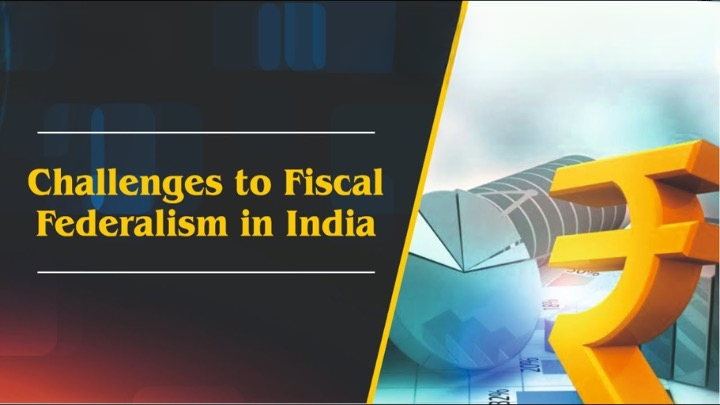
- 29 Feb 2024
Why is it in the News?
The recent agitations by the governments of Kerala and Karnataka, and the support extended by several State governments, have highlighted many disquieting issues in the practice of fiscal federalism in India.
Context:
- The recent protests by the governments of Kerala and Karnataka, supported by several other state governments, have brought to light several concerning issues regarding fiscal federalism in India.
- These protests underscore the pressing need for the newly constituted 16th Finance Commission (FC) to approach the matter with seriousness and innovation to address grievances related to growing vertical and horizontal inequalities in resource allocation.
What is Fiscal Federalism?
- Fiscal federalism refers to the distribution of financial authority and obligations among various tiers of government within a nation.
- It encompasses considerations like determining the roles and responsibilities of the central and state governments in delivering services, devising mechanisms for revenue generation and allocation among these entities, and establishing fair and efficient systems for transfers or grants distribution to promote equity and effectiveness.
Fiscal Federalism in India:
- The framers of the Constitution stipulated that the Central government would share its tax revenues with the states and provide grants from the Consolidated Fund based on a formula determined by the Finance Commission every five years.
- India operates under a three-tier federal tax system, delineating the powers of the Central government, state governments, and local bodies to levy taxes.
- The Central government possesses the authority to impose taxes on individual and corporate incomes, along with indirect taxes like central goods and services tax (CGST), integrated goods and services tax (IGST), and customs duties. Additionally, it collects surcharges and cesses on various taxes.
- State governments are responsible for levying state goods and services tax (SGST), stamp duties, land revenue, state excise duties, and professional taxes.
- Local bodies exercise jurisdiction over taxes such as property or house taxes, tolls, and utility taxes on services like electricity and water.
What are the Constitutional Provisions?
- The Constitution of India outlines the taxation authority of both the Union and States, categorizing them into the Union List and the State List respectively (as outlined in the Seventh Schedule under Article 246).
- Initially, there was no taxation provision in the Concurrent List.
- However, with the introduction of GST, the need for a concurrent taxation framework arose, leading to the insertion of Article 246A (as the 101st Amendment in August 2016).
- This amendment empowered the Union to legislate for CGST (Central GST) and IGST (Integrated GST), while the States were granted the authority to enact SGST laws.
- Article 270 of the Constitution outlines the mechanism for distributing net tax proceeds collected by the Union government among the Centre and the States.
What are the Concerns with the States?
- Growing Vertical and Horizontal Inequalities: States have raised concerns about increasing disparities both vertically, pertaining to the sharing of resources between the Union and States, and horizontally.
- The Union government's inclination to retain a larger share of its proceeds outside the divisible pool has exacerbated these inequalities.
- Retention of Proceeds: The Union government's practice of withholding a greater portion of its proceeds from the divisible pool has diminished the share allocated to States, contravening mandates from successive Finance Commissions.
- Proliferation of Cesses and Surcharges: Various cesses and surcharges, such as the Agriculture Infrastructure and Development Cess, have been introduced by the Union government, leading to an expansion of these revenue streams.
- This expansion has resulted in a larger portion of the gross tax revenue being excluded from net proceeds, thereby depriving States of their rightful share.
- Financial Exclusion of States: Over the period from 2009-10 to 2023-24, the Union government collected a substantial cumulative amount of ?36.6 lakh crore through cesses and surcharges, all of which remained unshared with the States.
- The imposition of cesses and surcharges has faced criticism from the Comptroller and Auditor General (CAG), further highlighting concerns about their impact on state finances.
Way Forward
- Rectifying disparities in resource sharing and addressing the proliferation of cesses and surcharges are critical imperatives for the 16th Finance Commission (FC).
- The FC should proactively address historical imbalances in vertical devolution by compensating States appropriately and ensuring accurate estimates of "net proceeds" in budgetary documents.
- Moreover, it should consider providing lump sum untied grants to States to offset shortfalls in devolution over the past decade.
- Simultaneously, legislative measures must be enacted by the Union government to impose strict limits on the collection of cesses and surcharges, ensuring their automatic expiration after a defined period and preventing their rebranding under different names.
- Furthermore, States must adhere to the principles of fiscal federalism by allocating sufficient resources to local bodies and promoting dynamic and transparent development initiatives at the grassroots level.
What is the Finance Commission?
- The Finance Commission is constituted by the President under Article 280 of the Constitution, mainly to give its recommendations on the distribution of tax revenues between the Union and the States and amongst the States themselves.
- Two distinctive features of the Commission’s work involve redressing the vertical imbalances between the taxation powers and expenditure responsibilities of the center and the States respectively and equalization of all public services across the States.
Functions of the Finance Commission:
- It is the duty of the Commission to make recommendations to the President as to the distribution between the Union and the States of the net proceeds of taxes which are to be:
- Divided between them and the allocation between the States of the respective shares of such proceeds;
- The principles which should govern the grants-in-aid of the revenues of the States out of the Consolidated Fund of India;
- The measures needed to augment the Consolidated Fund of a State to supplement the resources of the Panchayats in the State based on the recommendations made by the Finance Commission of the State;
- The measures needed to augment the Consolidated Fund of a State to supplement the resources of the Municipalities in the State based on the recommendations made by the Finance Commission of the State;
- Any other matter referred to the Commission by the President in the interests of sound finance.
- The Commission determines its procedure and has such powers in the performance of its functions as Parliament may by law confer on them.
Appointment of the Finance Commission and Qualifications for Members:
- The Finance Commission is appointed by the President under Article 280 of the Constitution.
- As per the provisions contained in the Finance Commission Act, 1951 and The Finance Commission (Salaries & Allowances) Rules, 1951, the Chairman of the Commission is selected from among persons who have had experience in public affairs, and the four other members are selected from among persons who:
- (a) are, or have been, or are qualified to be appointed as Judges of a High Court; or
- (b) have special knowledge of the finances and accounts of the Government; or
- (c) have had wide experience in financial matters and administration; or
- (d) have special knowledge of economics
How are the recommendations of the Finance Commission implemented?
- The recommendations of the Finance Commission are implemented as under:
- Those to be implemented by an order of the President:
- The recommendations relating to the distribution of Union Taxes and Duties and Grants-in-aid fall in this category.
- Those to be implemented by executive orders:
- Other recommendations to be made by the Finance Commission, as per its Terms of Reference
When was the first Commission Constituted and how many Commissions have been Constituted so far?
- The First Finance Commission was constituted under the chairmanship of Shri K.C. Neogy on 6th April 1952.
- 15th Finance Commissions have been Constituted so far at intervals of every five years.
- The 16th Finance Commission was constituted on 31 Dec 2023 with Shri Arvind Panagariya, former Vice-Chairman, NITI Aayog as its Chairman.
- The 16th Finance Commission is required to submit its recommendations by October 31st, 2025.
- However, the recommendations of the 15th FC cover the six years up to 31st March 2026.
Sustainable Practices and Urging for Eco-Friendly Elections in India
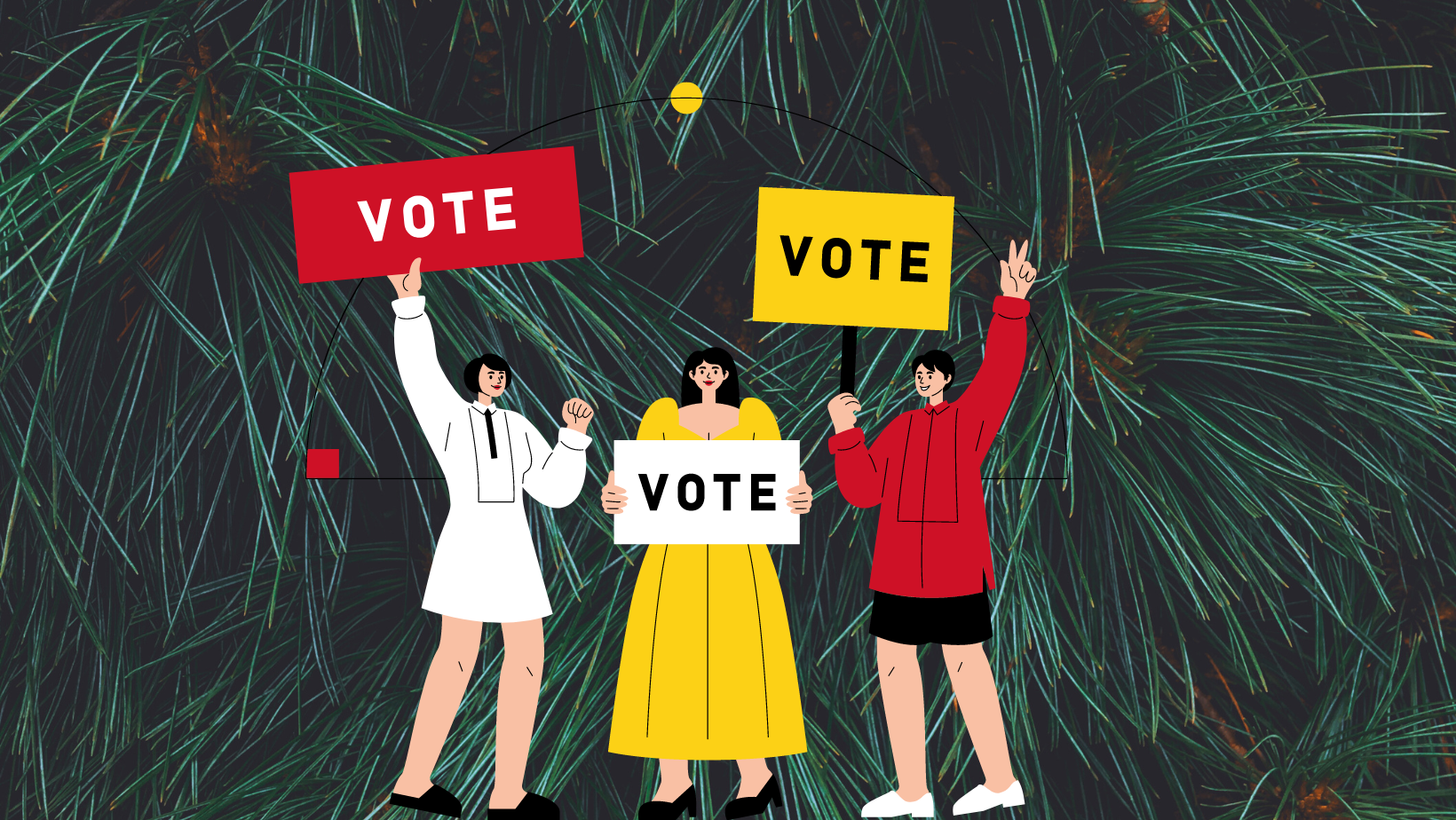
- 28 Feb 2024
Why is it in the News?
In August 2023, ahead of the Assembly elections in five States, the Election Commission of India (ECI) voiced its concern over the environmental risks associated with the use of non-biodegradable materials in elections.
Context:
- The Election Commission of India (ECI) has emphasized the environmental impact of traditional election materials, urging a shift towards eco-friendly practices, particularly given India's status as the world's largest democracy.
- India must prioritize environmental sustainability in its electoral procedures, recognizing successful eco-friendly initiatives in Kerala, Sri Lanka, and Estonia, and strategizing a comprehensive green transition involving diverse stakeholders.
Why Conducting Elections Require a Paradigm Shift?
- Unrecognized Environmental Impact of Elections: The emissions generated by campaign flights in the 2016 US presidential elections underscore the substantial carbon footprint linked to conventional election methodologies.
- Conventional election practices, marked by paper-based materials, energy-intensive rallies, and disposable items, contribute to environmental harm and affect public health.
- Given the colossal scale of India's elections, these concerns become more pressing, calling for a shift towards eco-friendly election processes.
- Startling Research Findings: Recent research from Estonia (2023) pinpoints transportation to and from polling booths as the primary contributor to carbon emissions in elections, closely followed by the operational footprint of polling booths.
- Adopting digital voting systems has the potential to slash the overall carbon footprint by as much as 40%.
What are Some Successful Models of Eco-Friendly Elections?
- Pioneering Initiatives in Kerala and Goa: During the 2019 general election, the Kerala State Election Commission spearheaded efforts to eliminate single-use plastic materials from campaign activities.
- Subsequently, the Kerala High Court enforced a ban on non-biodegradable materials, leading to the adoption of eco-friendly alternatives like paper posters and wall graffiti.
- Collaborative endeavors between government bodies and district administrations in Thiruvananthapuram ensured the implementation of green election practices, including training sessions for election workers in rural areas.
- In 2022, the Goa State Biodiversity Board showcased eco-friendly election booths crafted from biodegradable materials by local artisans during the Assembly elections.
- Innovative Strategies from Sri Lanka: In 2019, the Sri Lanka Podujana Peramuna (SLPP) party initiated the world's first carbon-sensitive, environmentally friendly election campaign.
- This groundbreaking campaign measured carbon emissions from campaign vehicles and electricity usage, offsetting them by planting trees across districts with public participation.
- By addressing the immediate carbon footprint of the campaign and raising awareness about the importance of forest cover, Sri Lanka set a notable example for sustainable election practices.
- Estonia's Digital Voting Model: Estonia pioneered digital voting as an online alternative, significantly enhancing voter participation while reducing environmental impact.
- The success of Estonia's approach underscores the feasibility of digital voting, complemented by stringent security measures, as an eco-friendly and voter-centric solution.
A Roadmap for Sustainable Green Elections:
- Political Leadership and Digital Campaigning: Political parties should enact legislation mandating eco-friendly election practices, integrating them into the Model Code of Conduct governing campaign activities.
- Encouraging the adoption of digital platforms for campaigning and door-to-door outreach can substantially reduce the carbon footprint associated with traditional public rallies.
- Incentivizing Sustainable Practices and Infrastructure Development: Offering incentives for political parties to use sustainable materials like natural fabrics and recycled paper in place of plastic and paper-based campaign materials, alongside supporting waste management and local artisans.
- Government investment in digital voting infrastructure, particularly in rural areas, ensures reliable internet access and accessible digital devices for all voters.
- Role of the Election Commission of India (ECI) with Government Backing: The ECI can advocate for digital voting systems, highlighting their environmental benefits and addressing security concerns through comprehensive measures.
- Public Awareness and Civil Society Engagement: Civil society organizations can lead public awareness campaigns, educating citizens about the environmental impact of traditional election methods and advocating for eco-friendly alternatives.
- Monitoring the implementation of green initiatives and advocating for transparency and accountability in the electoral process.
- Media's Advocacy Role: Media outlets can spotlight the environmental consequences of conventional election methods through investigative reporting and by showcasing successful eco-friendly initiatives.
- Global Collaboration for Sustainable Elections: Collaborating with countries like Sri Lanka and Estonia, which have successfully implemented eco-friendly election practices, to share insights and support international platforms for exchanging best practices in sustainable electoral initiatives.
Hurdles and Potential Solutions for Conducting Eco-Friendly Elections:
- Technology Barriers: Ensuring a seamless transition to digital voting demands robust technological infrastructure, particularly in remote regions where connectivity may be sparse.
- Upholding the integrity and security of digital systems is paramount, requiring comprehensive safeguards against cyber threats and manipulation to uphold public trust.
- Financial Impediments: Embracing eco-friendly materials and technologies entails significant initial investments, posing challenges for governments constrained by budgetary limitations.
- Competing priorities may hinder the allocation of funds toward sustainable electoral practices, despite their long-term environmental advantages.
- Cultural Shifts and Public Doubts: Cultural norms often associate physical polling booth presence with democratic participation, necessitating efforts to shift perceptions towards digital methods.
- Addressing public skepticism regarding new technologies, particularly concerns about security and reliability, requires proactive measures to build trust and confidence.
- Promoting Transparency and Accountability: The adoption of eco-friendly and digital strategies must be accompanied by transparent processes and robust auditing mechanisms.
- Establishing clear protocols for auditing new practices fosters accountability and addresses concerns about fairness and impartiality, enhancing public trust.
- Tackling Logistical Complexities: Executing large-scale electoral reforms demands meticulous planning and coordination across various stages.
- From sourcing eco-friendly materials to training personnel, addressing logistical challenges systematically is essential for smooth implementation.
Conclusion
Adopting environmentally conscious electoral practices represents not only an imperative for India but also a chance to lead by example on the global stage. Harmonizing high-level policies with ground-level efforts and engaging various stakeholders—political entities, Election Commissions, governments, citizens, media, and civil society—can position India as a trailblazer in conducting sustainable elections. This transformative approach not only integrates environmental responsibility but also reinforces the connection between ecological stewardship and the core tenets of democracy.
Paradigm Shift: Unleashing Local Wisdom for Sustainable Economic Growth
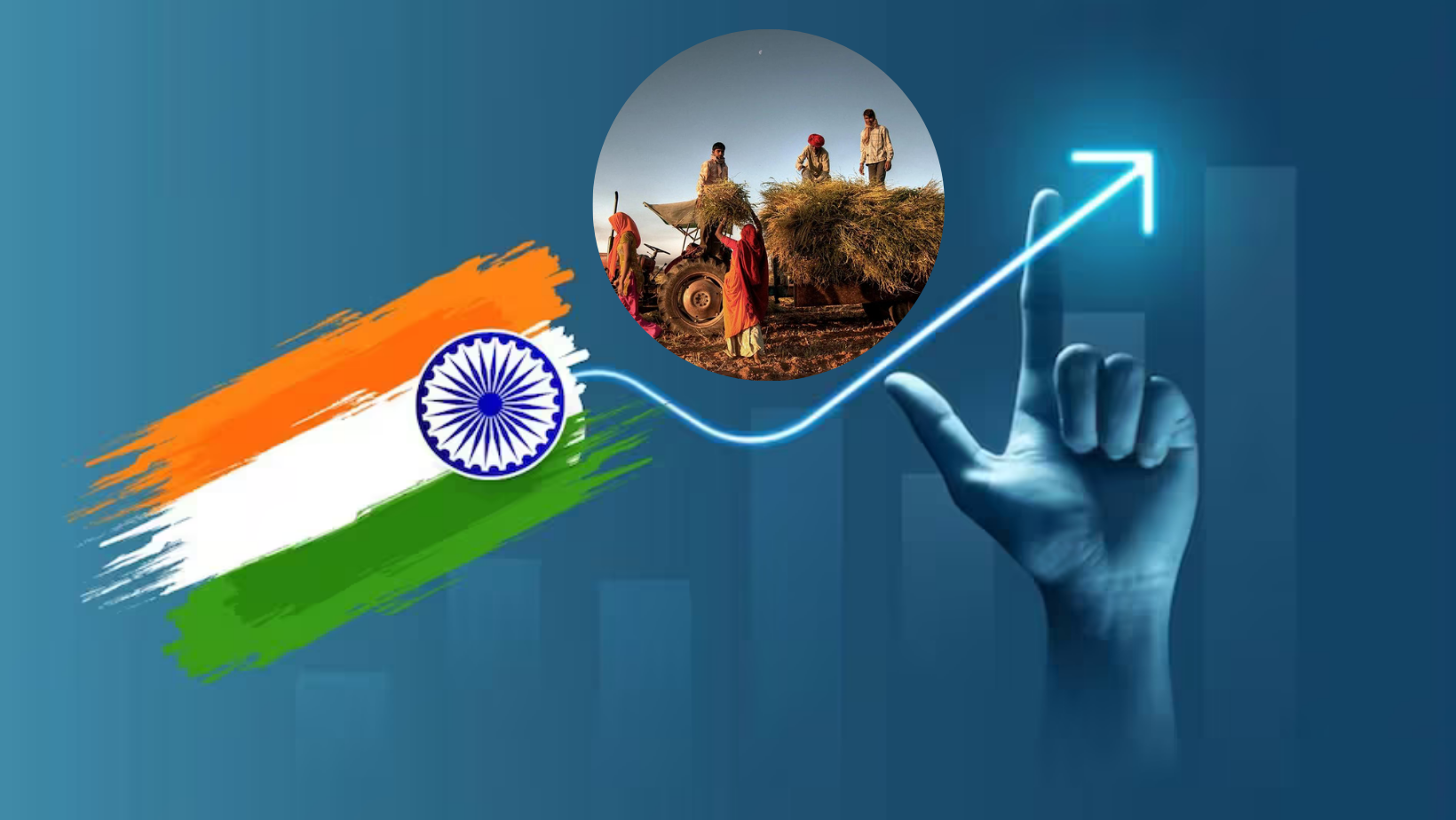
- 24 Feb 2024
Why is it in the News?
India’s policymakers must free themselves from Western-dominated theories of economics and in this, local solutions are the way to solve global systemic problems.
What is Economic Growth?
- Economic growth denotes the expansion of a nation's economy over a defined duration.
- This expansion is commonly quantified by the aggregate output of goods and services within the economy, known as gross domestic product (GDP).
Key Points:
- GDP Measurement: Gross domestic product serves as the primary metric for assessing economic growth, reflecting the overall economic activity within a nation.
- GDP represents the total monetary value of all finalized goods and services generated within a country's borders during a specified timeframe.
- Definition of Economic Growth: Economic growth signifies the sustained increase in a country's real national income and per capita income over an extended period.
- This progression indicates an expansion in the nation's economic output and its citizens' earning potential.
- Long-term Perspective: Economic growth is characterized by its longitudinal nature, emphasizing continuous advancement in a nation's economic prosperity over time.
- It underscores the importance of sustained increases in productivity, income levels, and overall economic well-being.
Current Economic Analysis:
- GDP as a Benchmark: Gross Domestic Product (GDP) growth has emerged as the predominant yardstick for evaluating the overall well-being of economies worldwide.
- It serves as a comprehensive measure of a nation's economic output, encompassing the total value of goods and services produced within its borders over a specific period.
- Paradigm Shift: There has been a notable shift in economic ideology, prioritizing the expansion of the economic "pie" before addressing issues of income distribution.
- This paradigmatic change has supplanted previous socialist models that emphasized addressing socio-economic disparities at the grassroots level.
- Historical Economic Focus: Since the liberalization of India's economy in 1991, successive governments have placed considerable emphasis on fostering GDP growth as a primary driver of economic development.
- This policy orientation has underscored the significance of achieving robust GDP expansion as a cornerstone of national economic policy.
- Projected Growth Trajectory: The First Advance Estimates of National Income for the fiscal year 2023-24 indicate a projected Real GDP growth rate of 7.3 percent for India.
- This forecast, as outlined in the Macro-Economic Framework Statement 2024-25, reflects the anticipated trajectory of India's economic growth in the near term.
- Global Economic Projections: According to the International Monetary Fund (IMF), India is poised to ascend to the rank of the third-largest economy globally by 2027, measured in terms of market exchange rate.
- Additionally, the IMF anticipates a substantial increase of 200 basis points in India's contribution to global economic growth over the next five years.
Addressing Challenges and Considerations:
- Beyond GDP: Limitations in Assessing Well-being: Gross Domestic Product (GDP) fails to comprehensively measure a nation's overall standard of living or well-being.
- It overlooks critical aspects that contribute to general welfare, such as environmental sustainability and quality of life indicators.
- External Costs and Trade-offs: While GDP growth may signify increased economic output, it can also entail adverse consequences, including environmental degradation and societal trade-offs.
- For instance, heightened industrial activity may lead to environmental harm or infringe upon individuals' leisure time.
- Socioeconomic Inequality: The distribution of GDP among a country's populace significantly impacts its citizens' quality of life.
- India's economic progress, marred by increasing inequality, underscores the importance of addressing disparities in wealth distribution to foster inclusive growth.
- Unemployment Challenges: Despite remarkable GDP growth, India grapples with persistent challenges in providing adequate employment opportunities.
- The discrepancy between economic expansion and job creation highlights the need for targeted interventions to address unemployment concerns.
- Reimagining Economic Progress: Rethinking traditional metrics of economic success is imperative to address the multifaceted challenges facing nations today.
- Embracing alternative indicators that prioritize sustainability, social equity, and inclusive growth can pave the way for a more holistic approach to economic development.
Inclusive and Sustainable Development:
- Traditional economic models advocate for linear development paths, prioritizing urbanization and industrialization.
- However, India's slow progress in these areas raises concerns, especially amidst global climate challenges.
- The reliance on fossil fuels for growth further complicates matters, requiring a reevaluation of development paradigms.
- India must pioneer inclusive and environmentally sustainable growth models to address these challenges effectively.
- This necessitates a shift towards alternative pathways that prioritize both economic advancement and environmental stewardship.
- By fostering innovation and collaboration, India can lead the way towards a more sustainable future for itself and the world.
Fossil Fuels and the Modern Economy:
- ??Fossil fuels play a crucial role in the global economy, serving as vital resources for various sectors.
- These include coal, oil, and natural gas, which contribute significantly to the production and distribution of essential materials for modern society, including steel, concrete, plastics, and food.
- While fossil fuels have fueled industrialization and economic growth, their adverse effects on both human health and the environment raise significant concerns.
- Balancing their economic importance with the need for sustainable alternatives poses a challenge for modern society.
Way Forward:
- Addressing the Global Climate Crisis: India must confront the pressing challenge of the global climate crisis while simultaneously advancing its own economic growth to bridge the gap with developed nations.
- Embracing a New Paradigm: India should strive to forge a new paradigm of progress that prioritizes inclusive and environmentally sustainable growth, benefiting both its citizens and the global community.
- Diversifying Economic Perspectives: Policymakers in India ought to liberate themselves from the dominance of Western economic theories, fostering a more diverse and contextually relevant approach to economic development.
- Harnessing Rural Potential: Rural India has the potential to serve as a hub of innovation, generating novel solutions in institutions and policies conducive to inclusive and sustainable growth, with relevance beyond national borders.
- Local Solutions for Global Challenges: Systems science underscores the efficacy of locally crafted solutions, collaboratively developed by communities in their own locales, as effective remedies for global systemic issues such as climate change and inequitable economic growth.
- Prioritizing Economic Development: A concerted focus on economic development is essential, encompassing efforts by policymakers and communities to enhance the standard of living and economic conditions across the country.
- Holistic Approach to Development: Economic development encompasses not only material prosperity but also the overall quality of life of the population, encompassing factors such as education, healthcare, and nutrition.
- Enhancing Living Standards: The advancement of a nation's economic development correlates with improvements in the living standards of its people, reflecting better access to education, healthcare, and other essential amenities.
Having panchayats as self-governing institutions
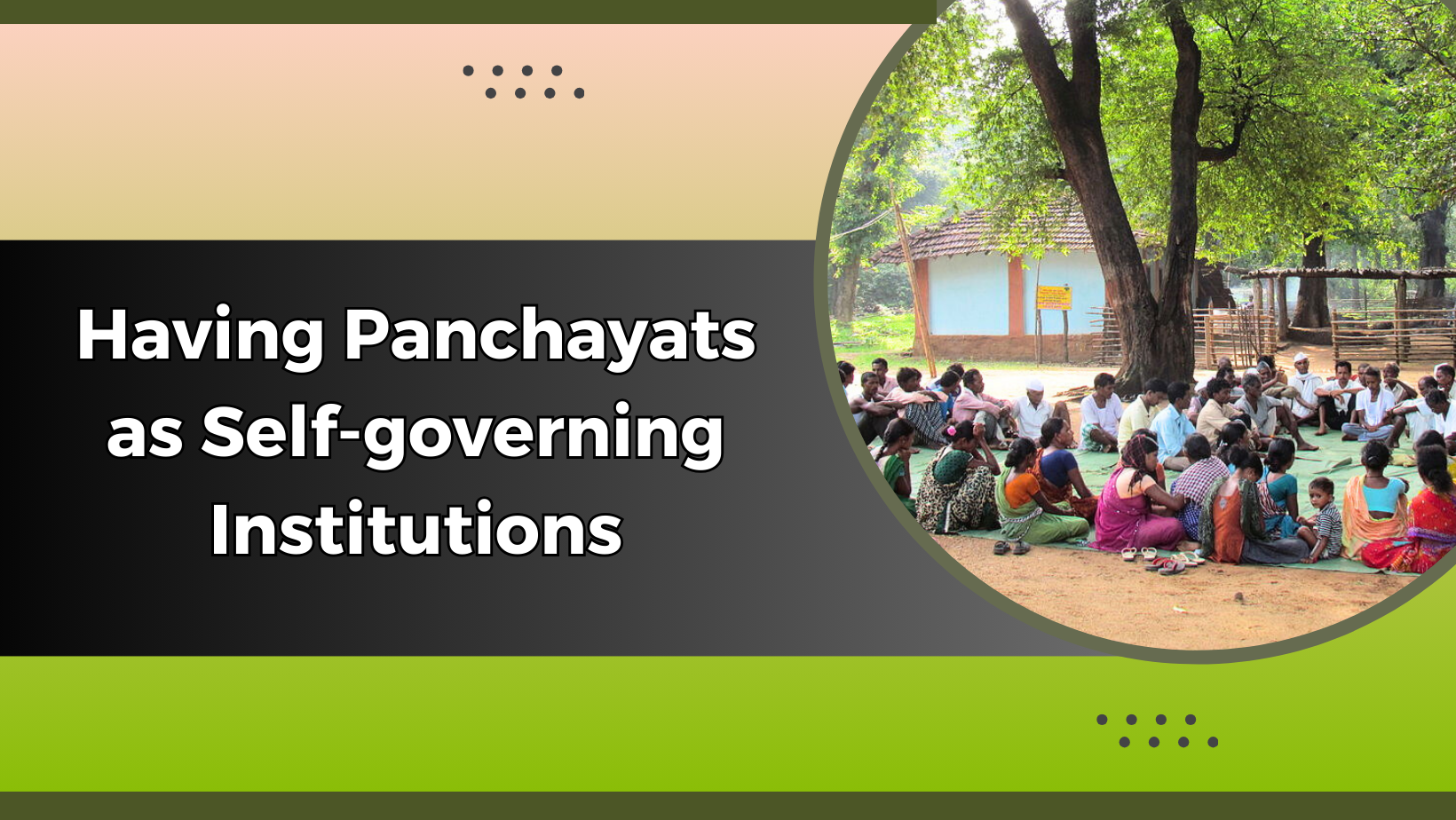
- 21 Feb 2024
Why is it in the News?
There is a need to educate elected representatives and the public on the significance and the need for panchayats to be able to survive on its own resources
Context:
- Three decades have passed since the enactment of the 73rd and 74th Constitutional Amendment Acts, designed to institutionalize local bodies as entities of local self-government.
- Presently, the degree of devolution in India's Panchayati Raj institutions exhibits variations among states, with some making substantial strides and others trailing behind.
- Therefore, there is a pressing need to scrutinize the fiscal devolution dimension, underscoring the pivotal role of state government commitment in enhancing the effectiveness of Panchayati Raj institutions at the grassroots level.
What is the Local Self Government?
- The system of local self-government, more commonly known as ‘panchayats’, had been established to empower the grassroots of democracy in India.
- Panchayats or local-self rule is a three-tier system in each state which has elected bodies at the village, taluk and district levels.
- The concept of panchayats has been present in Indian society since ancient times.
- Over the centuries the concept has undergone various changes and modifications and in the recent past has taken the form of panchayati raj institutions after decentralization reforms in the early 1990s.
- These institutions for grassroots-level democracy were formally included in the Constitution through the 73rd and 74th Amendments Act in 1993.
- The constitutional amendments also ensured the reservation of one-third of all elected positions for women in both rural and urban areas.
- Derived from the Central Act, various State Panchayati Raj Acts have incorporated provisions for taxation and revenue collection.
- The main idea of setting up local-self government institutions was to enable and empower the local people to manage their affairs by being a part of the decision-making process and participating in the implementation of policies in a more effective manner.
The Present State of Fiscal Devolution of Panchayats:
- Reliance on External Funds: The 73rd and 74th Constitutional Amendments Acts underscored the importance of fiscal devolution, urging Panchayati Raj institutions and urban local bodies to achieve financial self-sufficiency.
- These amendments explicitly stated the necessity for local bodies to generate their own revenues to reduce reliance on grants from higher levels of government.
- However, the current scenario indicates that Panchayati Raj institutions still heavily depend on external funding, with only 1% of their revenue originating from taxes.
- Panchayats' Struggle to Generate Revenue Through Taxation: The data highlights the challenge that, despite constitutional provisions, Panchayats are not effectively utilizing taxation as a primary revenue source.
- Merely 1% of revenue is generated through taxes, while a significant 80% is sourced from the Central government and 15% from the States.
- This disparity raises concerns about the commitment of state governments to decentralization and the overall efficacy of devolution initiatives implemented over the past three decades.
- Centralization of Financial Resources Despite Constitutional Emphasis on Fiscal Devolution: Despite the constitutional emphasis on fiscal devolution, the centralization of financial resources remains a persistent issue.
- Panchayats are envisioned as self-governing entities with the authority to raise their own revenue, yet the reality paints a different picture.
- The disproportionate distribution of revenue indicates a lack of fiscal empowerment at the grassroots level, undermining the fundamental principles of local self-government.
What are the Challenges Faced by Panchayati Raj Institutions in Revenue Generation?
- Dependency on Grants: The reliance on grants is exacerbated by the heightened allocations from Central Finance Commissions (CFC).
- A comparative analysis reveals a significant increase in grants disbursed through the 14th and 15th CFCs, amounting to ?2,00,202 crore and ?2,80,733 crore, respectively.
- This substantial influx of grants has inadvertently diminished incentives for generating own-source revenue.
- Panchayats, buoyed by augmented financial assistance, have gradually shifted focus away from revenue generation, fostering a culture of dependence on external funds.
- The Culture of Entitlement: A prevalent cultural mindset fosters resistance to taxation, with individuals expecting a range of services and benefits without contributing financially to the sustenance of Panchayats.
- This aversion to taxation arises from the belief that public services should be provided without imposing a direct financial burden on the local populace.
- Dilemma of Elected Representatives: Elected representatives, crucial to the functioning of Panchayati Raj institutions, grapple with their own set of challenges.
- There exists a tangible apprehension among these representatives that levying taxes might adversely affect their popularity and electoral prospects.
- This fear often results in hesitancy to take decisive steps towards revenue generation.
- Addressing this challenge necessitates targeted efforts to educate elected representatives about the enduring benefits of financial self-sufficiency and its positive impact on local development endeavours.
- Decline in Tax Collection: Tax collection, which stood at ?3,12,075 lakh in 2018-19, dwindled to ?2,71,386 lakh by 2021-2022.
- This downward trend raises concerns, signalling a waning commitment to financial autonomy at the local level.
- Similarly, non-tax revenue also experienced a decline from ?2,33,863 lakh to ?2,09,864 lakh during the same period.
- These patterns underscore the imperative for revitalized efforts in revenue generation and a departure from grant dependency.
Government's Efforts to Implement Constitutionally Mandated Fiscal Devolution:
- Establishment of an Expert Committee: To address this challenge, the Ministry of Panchayati Raj constituted an expert committee tasked with examining the own source of revenue (OSR) of rural local bodies.
- The committee's findings delineate various revenue-generating avenues accessible to Panchayati Raj institutions through State Acts.
- These mechanisms include property tax, land revenue cess, stamp duty surcharge, tolls, professional tax, advertisement tax, and user charges for essential services like water, sanitation, and lighting.
- While these avenues exist, their effective implementation is imperative for Panchayats to attain financial autonomy.
- Focus on Effective Taxation Mechanisms: The report underscores the significance of establishing an enabling environment for taxation, encompassing decisions on tax and non-tax bases, enactment of robust tax management and enforcement laws, etc.
- This strategic approach aims to empower Panchayats to fully leverage their revenue generation potential.
- While taxation constitutes a vital aspect of fiscal devolution, the report also acknowledges the potential of non-tax revenue streams, including Fees, rent, income from investment sales and hire charges,
- Along with revenue from innovative initiatives such as rural business hubs, commercial ventures, renewable energy projects, carbon credits, CSR funds, and donations.
- Diversification of revenue sources can bolster the financial resilience of Panchayati Raj institutions, reducing their reliance on grants.
The Role of Gram Sabhas:
- Gram sabhas have a significant role in fostering self-sufficiency and sustainable development at the grass-roots level by leveraging local resources for revenue generation.
- They can be engaged in planning, decision-making, and implementation of revenue-generating initiatives that range from agriculture and tourism to small-scale industries.
- They have the authority to impose taxes, fees, and levies, directing the funds towards local development projects, public services, and social welfare programmes.
- Through transparent financial management and inclusive participation, gram sabhas ensure accountability and foster community trust, ultimately empowering villages to become economically independent and resilient.
- Thus, gram sabhas need to promote entrepreneurship, and foster partnerships with external stakeholders to enhance the effectiveness of revenue generation efforts.
Way Forward:
- Education and Awareness: There is a pressing need to raise awareness among elected representatives and the public about the importance of revenue generation for developing Panchayats as self-sustaining institutions.
- Ultimately, the dependency syndrome for grants has to be minimised and in due course, panchayats will be able to survive on their own resources.
- Achieving this goal requires concerted efforts at all levels of governance, including the state and central levels.
- Promotion of Entrepreneurship: Gram Sabhas plays a crucial role in promoting entrepreneurship and fostering partnerships with external stakeholders to bolster revenue generation efforts.
- Encouraging entrepreneurial ventures within local communities can stimulate economic growth and reduce dependency on external funding.
- Collaboration and Support: Panchayats need to collaborate closely with higher tiers of governance and external stakeholders to enhance their revenue generation capabilities.
- This collaborative approach can facilitate the implementation of innovative initiatives and the efficient utilization of resources, thereby fostering financial self-reliance among Panchayats.
Greece’s gateway to Asia, India’s gateway to Europe
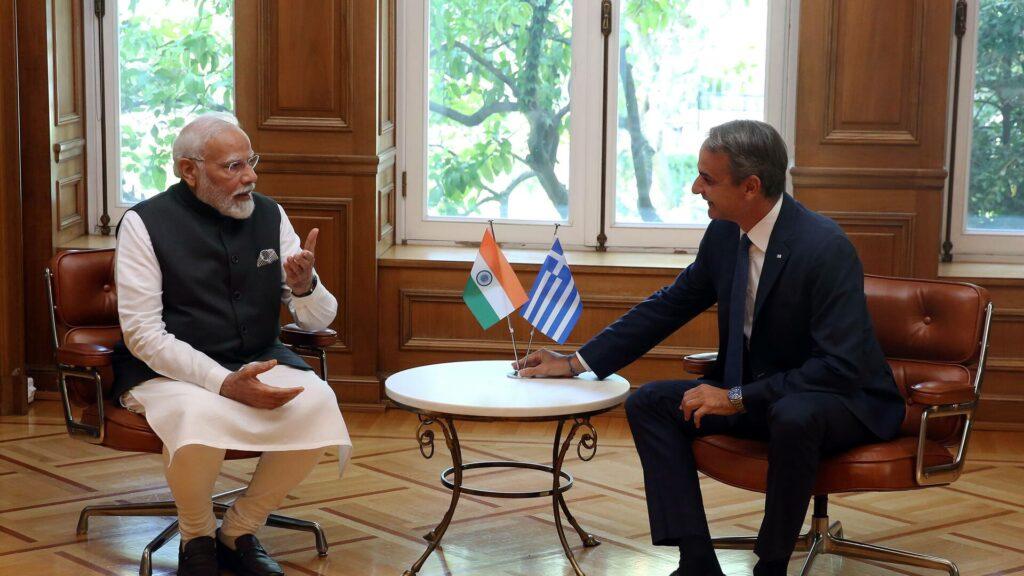
- 20 Feb 2024
Why is it in the News?
The state visit by Greek Prime Minister Kyriakos Mitsotakis to India will be another important step in building a strategic relationship between India and Greece — a process which began with the historic visit of the Indian Prime Minister, Narendra Modi, to Greece in August 2023.
Context:
- The upcoming state visit of Greek Prime Minister Kyriakos Mitsotakis to New Delhi signifies a pivotal milestone in the ongoing initiatives to forge a strategic partnership between Greece and India.
- This diplomatic initiative follows the landmark visit of the Indian Prime Minister to Greece in August 2023, which generated enthusiasm among Greek political and business circles.
- The anticipation surrounding the visit of the Greek Prime Minister underscores the mutual dedication to enhancing bilateral relations and collaboration across diverse sectors.
Historical Connections:
- India and Greece share a rich historical bond spanning more than 2500 years, characterized by cultural exchanges and a mutual embrace of democratic values.
- Presently, their bilateral relations are multifaceted, covering political, economic, and military cooperation.
- Trade Routes: Ancient maritime trade routes linked the Indus Valley Civilization with the Aegean region, facilitating the exchange of commodities such as spices, textiles, and intellectual ideas.
- Archaeological evidence, including the discovery of Indus seals in Mesopotamia, suggests the existence of trade connections between the two civilizations.
- Alexander the Great (326 BCE): Alexander's conquest of parts of northwest India fostered cultural and diplomatic exchanges between Greece and India.
- Greek philosophies and ideologies potentially influenced various aspects of Indian art, mathematics, and astronomy during this period.
- Indo-Greek Kingdoms (2nd century BCE – 1st century CE): Hellenistic kingdoms established in northwest India witnessed a fusion of Greek and Indian cultures.
- This blending is evident in Gandhara art, which exhibits Greco-Buddhist influences and serves as a testament to the cultural interplay between the two civilizations.
The Current Status of Bilateral Relations between India and Greece:
- Steady Progress in Bilateral Relations: While India and Greece share a historical connection and mutual enthusiasm, the pace of their bilateral cooperation has been characterized by gradual progress.
- In this context, it is essential to delve into the various facets of collaboration, recognizing both the positive developments and the need for enhanced momentum.
- Military Cooperation: Over time, military collaboration between the two nations has witnessed notable advancements.
- Joint exercises involving the Indian Navy, Indian Air Force, and the Greek armed forces have been conducted, underscoring a shared commitment to fostering mutual understanding and coordination.
- Reciprocal exercises are in the pipeline, illustrating an ongoing endeavour to deepen military bonds.
- These joint military endeavours not only bolster regional security but also signify an increasing level of confidence and collaboration between the armed forces of Greece and India.
- Economic Engagement: On the economic front, there have been significant instances of collaboration signalling a burgeoning partnership.
- For instance, an Indian construction company has joined forces with a prominent Greek construction firm to undertake a significant project: the construction of a new airport on the island of Crete.
- Such initiatives highlight the potential for cross-border investments and partnerships that can contribute to economic development and diversification.
Advancing Economic Reforms And Greece's Role:
- Greece's proactive stance in promoting deeper EU-India relations adds another layer of importance to ongoing economic reforms.
- As Greece endeavours to swiftly finalize the EU-India bilateral trade and investment agreement (BTIA), it underscores its dedication to establishing a conducive environment for heightened economic cooperation.
- The BTIA is poised to act as a catalyst, providing a structured framework for trade and investment, thereby nurturing closer economic bonds between the EU and India.
A Path to Closer Ties: Economic Reforms in Greece
- The economic facet of the Greece-India relationship assumes greater prominence as Greece, under the leadership of Prime Minister Kyriakos Mitsotakis, embarks on substantial economic reforms.
- Over the past half-decade, the Mitsotakis administration has implemented measures aimed at steering the Greek economy towards a more sustainable growth trajectory.
- This transformation positions Greece not only as a dependable eastern frontier of the European Union (EU) but also as a potential linchpin in broader geopolitical and economic strategies.
IMEEC Corridor: A Vision of Significance
- As Greece solidifies its role in the Eastern Mediterranean, the concept of establishing the India-Middle East-Europe Economic Corridor (IMEEC) emerges as a compelling vision.
- The IMEEC embodies a comprehensive economic initiative aimed at seamlessly connecting India, the Middle East, and Europe, thereby stimulating trade, investment, and economic collaboration.
- This ambitious proposition aligns with the shared vision of both nations to deepen their economic bonds and explore novel avenues for cooperation.
The Geopolitical Significance of the Indo-Greek Relationship:
- A Robust Foundation Rooted in Historical Bonds: The historical backdrop of the evolving ties between Greece and India (with diplomatic relations established in 1950) enriches their contemporary diplomatic endeavours.
- Furthermore, these diplomatic exchanges acquire significance amidst India's ascent as a global power, being perceived not only as an enduring ally but also as a dynamic and influential player on the world stage.
- Contemporary Diplomacy: The momentous visit of the Indian Prime Minister to Greece in August 2023 served as a watershed, laying the groundwork for enhanced collaboration.
- The enthusiasm witnessed in Greece, particularly among political and business circles, underscores the perceived opportunities in forging a strategic partnership with India.
- Strategic Importance of Both Nations' Locations: The geopolitical relevance of this burgeoning relationship is amplified by the strategic locations of Greece and India.
- Situated in regions pivotal to the global system, both nations grapple with geopolitical complexities and volatility.
- Recent events in the Red Sea highlight the interconnectedness of the East Mediterranean, where Greece is positioned, and the Indian Ocean region, accentuating the imperative for collaboration to promote security, stability, and prosperity.
- A Strategic Vision: Gateway to Europe and Asia: The Greek Prime Minister's assertion that "India will find no better gateway to Europe than my country, and for Greece, there is no better gateway to Asia than a close strategic relationship with India" encapsulates the acknowledgement of each nation's unique role in bridging the other's region.
- This pragmatic understanding not only acknowledges geographical realities but also reflects a strategic vision to leverage mutual strengths for collective advancement.
Way Forward to Enhance Indo-Greek Relations:
- Promoting Cross-Cultural Understanding: By expanding university student exchange programs, deliberate steps will be taken to familiarize the younger generation with the cultures, traditions, and educational systems of both nations.
- This fosters not only cross-cultural appreciation but also establishes a groundwork for future collaborations and friendships.
- Fostering Cultural Exchanges: Cultural exchanges serve as a cornerstone in fortifying the bonds between Greece and India.
- Through the promotion of cultural events, exhibitions, and festivals, both countries create platforms for their citizens to immerse themselves in and celebrate the richness of each other's cultural heritage.
- These initiatives act as bridges, connecting hearts and minds, and nurturing a sense of shared identity and mutual respect for cultural diversity.
- Media Collaboration: Bridging Information Gaps: Media collaboration emerges as a pivotal avenue to bridge geographical distances and keep the citizens of both nations abreast of developments, cultural nuances, and societal trends.
- Joint efforts in media, including co-productions, cultural documentaries, and news coverage, facilitate a nuanced understanding of each other's realities.
Conclusion
The swift exchange of visits between the political leadership of Greece and India underscores their commitment and the urgency in advancing their strategic partnership. As the world navigates through a pivotal year in 2024, the onus lies on policymakers and businesses to capitalize on this momentum and fortify the strategic partnership between Greece and India.
A Privileged Strategic Partnership, Without a Gulf (The Hindu)
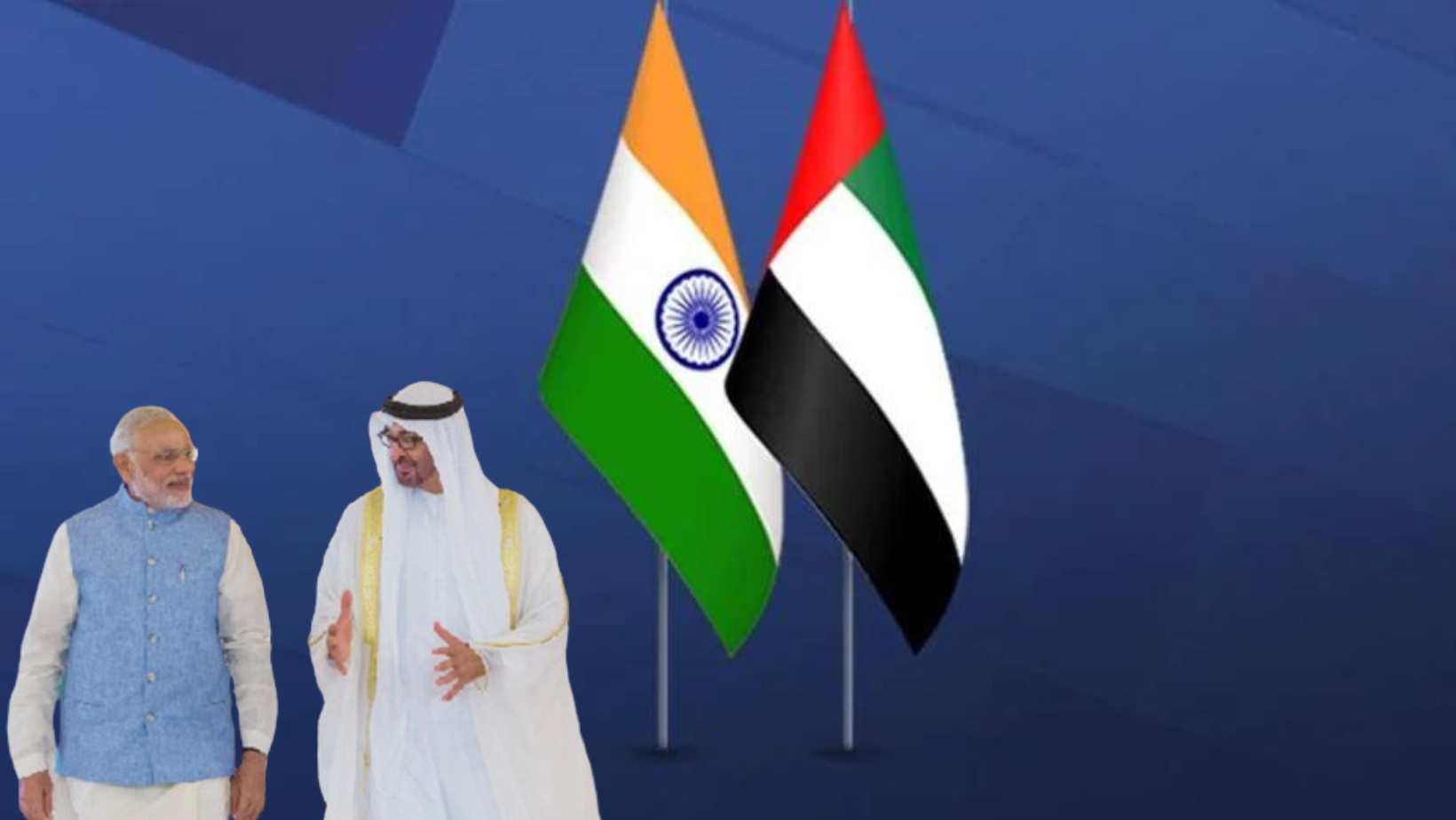
- 12 Feb 2024
Why is it in the News?
PM Modi is scheduled to pay an official visit to the United Arab Emirates (UAE) from February 13-14, 2024 which will include inaugurating a temple built by the Bochasanwasi Shri Akshar Purushottam Swaminarayan Sanstha in Abu Dhabi.
Background:
- The upcoming official visit of the Indian Prime Minister to the United Arab Emirates (UAE) scheduled for February 13-14, 2024, signifies a pivotal moment in the evolving rapport between the two countries.
- This visit offers an opportunity to examine the diverse dimensions of the strategic partnership between India and the UAE, encompassing diplomatic, economic, cultural, and geopolitical connections that have matured over time.
- The Prime Minister will address the World Government Summit in Dubai as the ‘Guest of Honour’.
The Nature of India-UAE Special Diplomatic Relations:
- Elevated Diplomatic Engagements and Mutual Gestures: The essence of the India-UAE strategic partnership in diplomacy is marked by a sequence of notable visits, reciprocal actions, and joint endeavours, underscoring the depth of their association.
- The forthcoming seventh visit of the Indian Prime Minister to the UAE, scheduled for February 13-14, 2024, reinforces the diplomatic bonds between the two countries.
- Personal Connection: The close and amicable bond between Prime Minister Modi and UAE President Sheikh Mohamed bin Zayed Al Nahyan serves as a cornerstone in diplomatic interactions.
- This personal connection has evolved through frequent encounters, discussions, and collaborative initiatives across various domains.
- Their shared vision acts as a catalyst for expanding cooperation across diverse sectors.
- Special Collaborative Ventures: The diplomatic cooperation extends beyond regular interactions to encompass special events and joint initiatives that highlight the importance of their partnership.
- For instance, the felicitation of the UAE President in Gandhinagar during the Vibrant Gujarat Summit is a notable instance.
- This reciprocal gesture underscores the mutual respect and camaraderie between the leaders.
- Global Environmental Endeavours: Both nations actively contribute to global endeavours addressing climate change.
- Their joint involvement in the Global Green Credit Initiative underscores their dedication to environmental sustainability.
- This shared commitment to global issues demonstrates a diplomatic convergence that transcends bilateral interests, positioning India and the UAE as responsible global participants.
- Strategic Partnerships: The strategic alignment between India and the UAE is evident in their engagement in various international forums and alliances.
- Their participation in the West Asian Quad (I2U2) and the India-Middle East-Europe Economic Corridor highlights a shared commitment to regional stability and economic progress.
- These partnerships further solidify their diplomatic collaboration in shaping geopolitical dynamics.
- Crisis Management: The diplomatic ties between India and the UAE are tested during critical junctures, such as the ongoing conflict in Gaza.
- The scheduled visit presents an opportunity for both leaders to discuss pressing regional issues, showcasing their dedication to addressing challenges and preserving regional stability.
- People-Centric Diplomacy: Cultural exchanges and people-to-people connections significantly contribute to diplomatic relations.
- Instances like the UAE conferring the Order of Zayed on Prime Minister Modi and India's role as the 'Guest of Honour' at the Abu Dhabi Festival underscore the cultural aspects of the partnership.
- Such gestures foster mutual understanding and goodwill among the citizens of both nations.
Additional Highlights of the UAE-India Strategic Partnership:
- Energy Security: The UAE's role as a vital partner in India's energy security is underscored by agreements on strategic oil reserves stored in India and collaborations on crude oil storage facilities.
- The partnership between Indian Strategic Petroleum Reserves Ltd and the Abu Dhabi National Oil Company reflects a shared commitment to securing energy resources.
- Defence and Security Collaboration: Both nations actively engage in defence and security cooperation, demonstrating mutual trust and a dedication to regional stability.
- Instances such as India's special invitation to the OIC Foreign Ministers’ Meeting and the UAE's participation in the G-20 summit under India’s presidency exemplify a unique level of diplomatic understanding.
- Cultural and People-to-People Connections: Cultural exchanges, exemplified by India's role as the 'Guest of Honour' at the Abu Dhabi Festival and the conferral of the Order of Zayed on PM Modi, strengthen people-to-people bonds.
- Initiatives like the establishment of the IIT Delhi Abu Dhabi campus and the opening of a UAE consulate in Hyderabad further enrich the cultural and educational facets of the partnership.
- The BAPS temple: Constructed on a generous donation of a 27-acre land parcel by the UAE President
- It stands as the UAE's second prominent Hindu temple, following the inauguration of the Hindu Temple in Dubai in 2022.
- Geopolitical Alignment: Both countries' participation in significant groupings like I2U2 and the India-Middle East-Europe Economic Corridor underscores their shared geopolitical interests.
- The UAE's involvement in the corridor, aimed at linking India to Europe, presents a potential alternative to China’s Belt and Road Initiative.
- Fintech: The RuPay card, an integral part of India’s Digital Public Infrastructure (DPI), has been operational in the UAE since 2019. Starting from July 2023, transactions using the Indian rupee have been facilitated at Dubai’s airports.
- Regional Dynamics: The ongoing conflict in Gaza introduces an additional layer of complexity to regional dynamics, offering an opportunity for leaders to address pressing issues.
Way Forward:
- Both nations maintain close coordination within the region and participate in several significant groupings, including the I2U2.
- The UAE's involvement in the India-Middle East-Europe Economic Corridor (IMEEC) infrastructure project, established during the G-20 summit in Delhi, aims to link India to Europe via the Arabian peninsula.
- This corridor presents a potential alternative to China’s Belt and Road Initiative.
- India boasts numerous strategic partnership agreements globally, yet none exhibit the depth of convergence and mutual respect as the one with the UAE.
- While India acknowledges and appreciates the UAE’s regional role, the UAE also acknowledges India's forthcoming 'global leadership' role.
- Both nations anticipate the continued strengthening of this privileged strategic partnership in the years to come.
Conclusion
The India-UAE strategic partnership exemplifies the extensive and varied connections that have developed over time. Spanning diplomatic, economic, and cultural spheres, as well as shared geopolitical goals, this relationship serves as a paradigm of harmony and mutual regard.
With a shared vision for continued advancement, the privileged strategic partnership is positioned for further enhancement in the future.
Major Takeaways From Interim Budget (2024-25) (The Hindu)
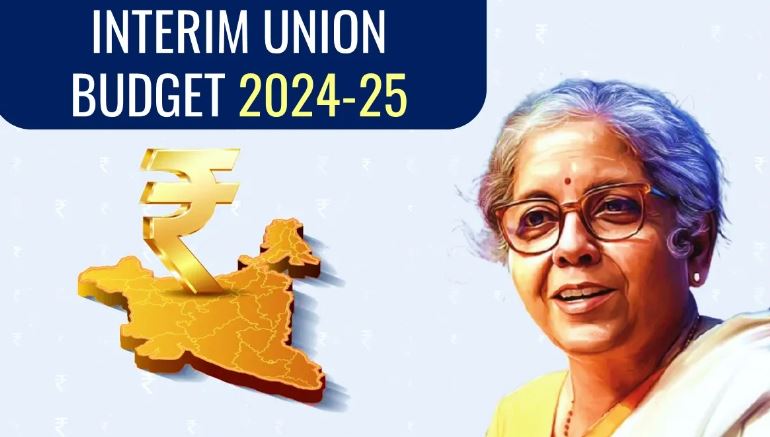
- 02 Feb 2024
Why is it in the News?
Finance Minister Nirmala Sitharaman presented her sixth Union Budget for the next financial year (2024-25), which differed from previous budgets as it was an interim budget.
What is the Interim Budget?
- The Interim Budget serves as a transitional financial plan presented by the incumbent government in an election year, bridging the period between the dissolution of the Parliament and the formation of a new government.
- This budgetary measure is necessitated by constitutional requirements outlined in Article 112 of the Indian Constitution, which mandates the submission of an annual financial statement to both Houses of Parliament.
- This statement outlines the anticipated receipts and expenditures of the Government of India for the upcoming fiscal year and requires approval from both Houses.
- However, in an election year, the prospect of a change in government following the polls prevents the presentation of a full-fledged budget by the incumbent administration.
- Consequently, the need arises for an interim budget to address the financial requirements during the transitional period.
- While there is no specific constitutional provision for an interim budget, the government seeks approval from the Lower House for the funds necessary for the transition period (April - July) through the votes on account provision.
Features and Components of Interim Budget:
- During the presentation of an interim budget, the Finance Minister provides an overview of the current state of the Indian economy, including its fiscal status and revised estimated growth for the upcoming year.
- This presentation encompasses details of both planned and non-planned government expenditures and revenues.
- While the government refrains from introducing major schemes that could sway voters or presenting an Economic Survey, it retains the authority to revise tax rates within the framework of the interim budget.
- Similar to the Union budget, the interim budget is presented to both Houses of Parliament on February 1 by the Finance Minister, subjected to debate and voting in the Lok Sabha, and subsequently forwarded for Presidential approval.
- Despite its interim nature, the interim budget remains valid for the entire fiscal year, serving as a crucial transitional arrangement until the presentation of a full-fledged budget by the new government.
What is Vote on Account?
- Article 116 of the Constitution empowers the Lower House to authorize advance grants for estimated expenditures during a portion of a financial year through legislative approval.
- This mechanism, known as a vote on account, facilitates the continuity of government operations during transitional periods.
- A typical vote on account encompasses the allocation of funds for essential expenses such as salaries, ongoing projects, and other necessary expenditures of the Central government.
- Notably, it does not entail modifications to tax rates.
- Additionally, a standard vote on account remains effective for a period of two months, with the possibility of extension for up to four months as required.
Major Takeaways from the Interim Budget (2024-25) - Part I:
- No Change in Taxation: The Interim Budget maintains existing tax rates without proposing any changes to direct or indirect taxes, including import duties.
- Withdrawal of Outstanding Direct Tax Demands: A significant initiative in the Interim Budget is the proposal to withdraw outstanding direct tax demands, benefiting taxpayers with demands up to Rs. 25,000 for the period up to the financial year 2009-10, and up to Rs. 10,000 for financial years 2010-11 to 2014-15.
- This measure is expected to benefit approximately one crore taxpayers.
- Tripled Direct Tax Collections: Over the past decade, direct tax collections have more than tripled, accompanied by a substantial increase in the number of return filers.
- The new tax regime ensures no tax liability for taxpayers with income up to Rs. 7 lakh.
- Additionally, corporate tax rates for existing domestic companies have been reduced from 30% to 22%, and for certain new manufacturing companies to 15%.
- Improvements in Taxpayer Services: The government's focus on enhancing taxpayer services has led to a transformation in the assessment system and simplified tax return filing processes.
- The average processing time for returns has been significantly reduced from 93 days to just 10 days.
- GST Compliance Relief: The implementation of GST has streamlined compliance for trade and industry, resulting in a reduction in logistics costs and taxes, and ultimately lowering prices for consumers.
- The GST base has doubled, with monthly gross GST collections nearly doubling to Rs. 1.66 lakh crore.
- Customs Facilitation Measures: Several steps have been taken in customs to facilitate international trade, including a substantial decrease in import release times at Inland Container Depots, air cargo complexes, and seaports over the last four years.
- White Paper Announcement: The government will release a white paper to provide insights into the period until 2014, aiming to draw lessons from past challenges and policy decisions.
Interim Budget (2024-25)- Part II:
- Increased Capital Expenditure: The Interim Budget allocates an 11.1% increase in capital expenditure for the upcoming year, amounting to Rs. 11,11,111 crore, representing 3.4% of the GDP.
- This investment aims to build on previous capital expenditure growth and stimulate economic growth and employment.
- Projected Real GDP Growth: India's Real GDP is projected to grow at 7.3% in FY 2023-24, reflecting the economy's resilience and healthy macroeconomic fundamentals despite global challenges.
- International agencies forecast India's continued growth between 6.1% and 6.7% in 2024-25.
- Robust GST Collection and Revenue Outlook: Strong economic activity has bolstered revenue collections, with gross GST revenues surpassing the Rs. 1.6 lakh crore mark for the seventh time.
- Total receipts, excluding borrowings, are estimated at Rs. 30.80 lakh crore, reflecting strong growth momentum and formalization in the economy.
- Support for State Governments: The Interim Budget extends support to state governments through schemes such as interest-free loans for capital expenditure and provisions for milestone-linked reforms.
- Fiscal Consolidation and FDI Inflow: Efforts towards fiscal consolidation aim to reduce the fiscal deficit to below 4.5% by 2025-26, with market borrowings estimated to be lower than the previous fiscal year.
Additionally, the government highlights a significant increase in FDI inflows over the past decade.
- Developmental Achievements: The Interim Budget underscores various developmental initiatives, including poverty alleviation programs, support for entrepreneurs through schemes like PM Mudra Yojana, housing initiatives, and promotion of startups through financial assistance.
- Infrastructure Development in Railways and Aviation: The budget outlines plans for major economic railway corridor programs and enhancements in aviation infrastructure, reflecting the government's commitment to improving transportation and connectivity.
- Committee on Population Growth Challenges: A high-powered committee will be formed to address challenges arising from rapid population growth and demographic changes, aligning with the goal of 'Viksit Bharat' (Developed India).
What are Other Announcements and Strategies in the Budget?
- During the presentation of the Interim Budget, Union Finance Minister Smt. Nirmala Sitharaman unveiled plans to increase the capital expenditure outlay for the next year by 11.1 percent to approximately Rs. 11 lakh crore, constituting 3.4 percent of the GDP.
- The Interim Budget introduces a range of announcements and strategies, signaling the trajectory and developmental approach aimed at realizing the vision of a 'Viksit Bharat' (Developed India) by 2047.
- In a series of announcements, Smt. Nirmala Sitharaman underscored the government's commitment to empowering the eastern region and its populace, positioning it as a significant catalyst for India's overall economic growth which includes:
- Boost in the Technology Sector: A corpus of Rs 1 lakh crore will be established through a fifty-year interest-free loan to facilitate long-term financing or refinancing for research and innovation in emerging technology domains.
- This initiative aims to incentivize the private sector to significantly enhance research and innovation efforts.
- Railway Infrastructure Development: The budget outlines plans for three major economic railway corridor programs focusing on energy, mineral, and cement corridors, port connectivity corridors, and high-traffic density corridors.
- Additionally, the conversion of forty thousand normal rail bogies to Vande Bharat standards will enhance safety, convenience, and passenger comfort.
- Aviation Sector Expansion: With the number of airports doubling to 149, and five hundred and seventeen new routes serving 1.3 crore passengers, the aviation sector demonstrates significant growth.
- Indian carriers have proactively placed orders for over 1000 new aircraft, indicating a robust expansion in the aviation industry.
- MGNREGA Allocation: A substantial increase in allocation for the Mahatma Gandhi National Rural Employment Guarantee Act (MGNREGA) scheme is proposed in the Interim Budget for 2024-25, with Rs. 86,000 crore allocated compared to Rs. 60,000 crore in the previous fiscal year.
- Subsidy Rationalization: The interim budget aims to reduce the subsidy bill on essential commodities like food, fertilizer, and fuel, with the projected subsidy falling to a five-year low of approximately Rs. 3.8 lakh crore in 2024-25.
- Notably, the fertilizer subsidy is being reduced with expectations of improvements in the global situation and increased domestic production.
- Demographic Challenges Addressed: Recognizing the challenges posed by rapid population growth and demographic changes, the government announces the formation of a high-powered committee.
- Tasked with comprehensive consideration and recommendations, this committee aligns with the goal of 'Viksit Bharat' (Developed India) by addressing demographic challenges effectively.
Conclusion
The Interim Budget serves as a transitional financial plan presented by the government during an election year, addressing various sectors such as railways, tourism, healthcare, technology, aviation, green energy, aquaculture, and housing. However, it is important to note that the incoming government will present its comprehensive budget after the newly elected Lok Sabha, delineating the government's financial strategy for the entire fiscal year.
Navigating the Risks and Benefits Associated with Internationalisation of Government Bonds (The Hindu)
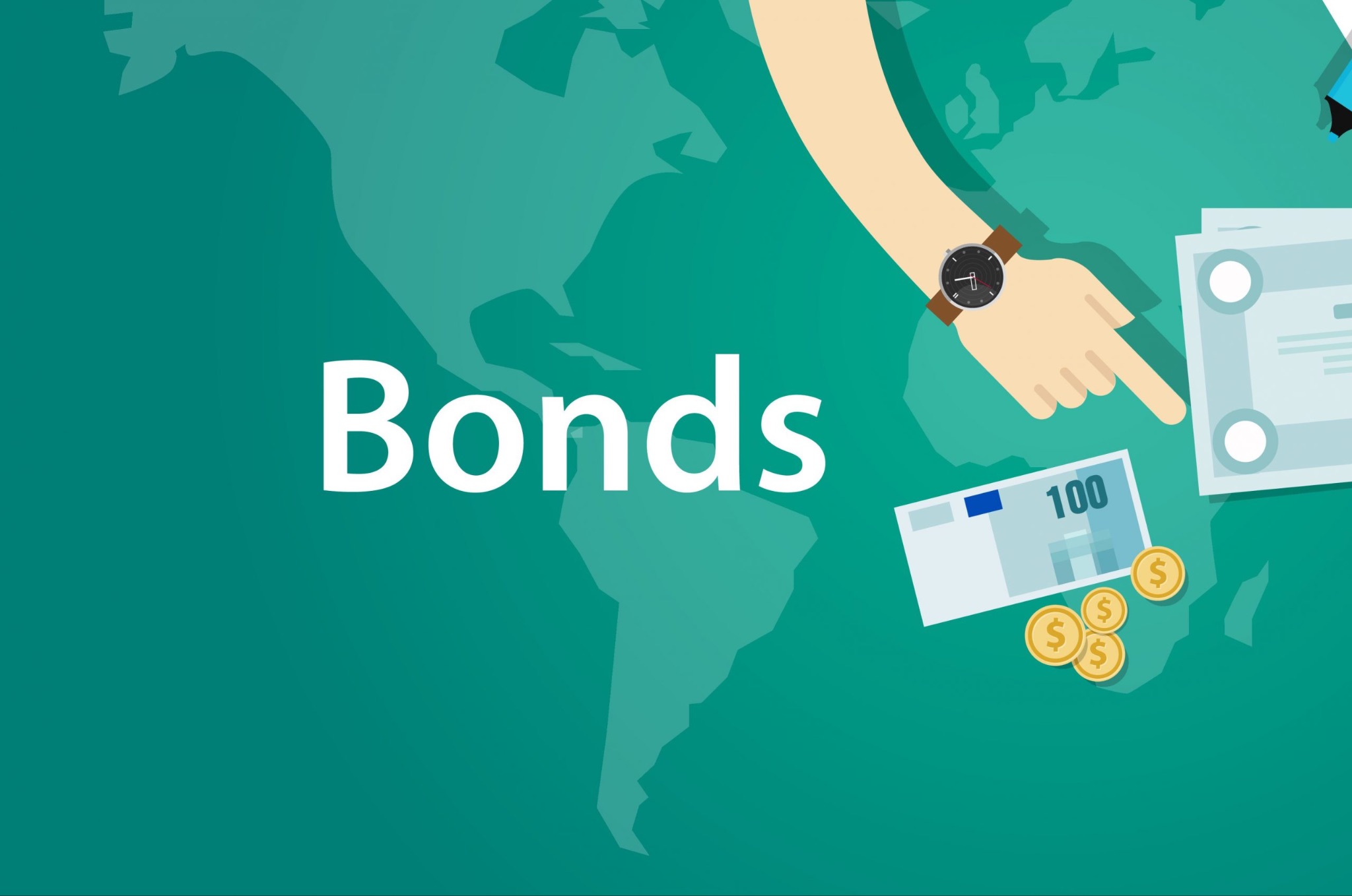
- 03 Feb 2024
Why is it in the News?
There is a serious underestimation of the risks involved in the internationalisation of bond markets and currencies of emerging economies.
Context:
- In recent times, there have been noticeable changes in the global financial landscape, specifically regarding the inclusion of government bonds from emerging economies in global indices.
- It is crucial to evaluate the actions taken by J.P. Morgan, Bloomberg, and FTSE Russell in incorporating Indian local currency government bonds (LCGBs) into global indices amidst these developments.
- Exploring the reasons behind these moves and understanding the potential advantages and risks associated with such initiatives is essential.
J.P. Morgan's Influence on India's Financial Landscape:
- The inclusion of Indian local currency government bonds (LCGBs) in J.P. Morgan's Government Bond Index-Emerging Markets (GBI-EM) Global index suite in September 2023 marked a significant milestone.
- This step not only underscored India's financial stature but also raised expectations within the Indian financial sector.
- It spurred interest from other major index providers such as Bloomberg-Barclays and FTSE Russell.
- Subsequently, Bloomberg Index Services announced in January 2024 that India's fully accessible route (FAR) bonds would be incorporated into the Bloomberg Emerging Market Local Currency Index, further bolstering this trend.
- All eyes are now on FTSE Russell, highlighting the increasing influence and anticipation of reforms in India's government bond market.
What is the Process of Opening Local Bond Markets?
- Opening local bond markets to foreign investors is a strategic move by emerging economies to bolster their global financial integration.
- In India, this journey began in 2019 and gained momentum by 2020 with the introduction of the fully accessible route (FAR).
- Despite facing challenges like delays due to government policies on capital gains taxes and local settlement, the core policy remained unchanged, showcasing a dedication to promoting global financial inclusivity.
Advantages of Internationalising Bond Markets:
- Reduced Reliance on Domestic Institutions: By integrating local currency government bonds into global indices, emerging economies like India aim to lessen their dependence on domestic financial institutions.
- This diversified funding base can contribute to financial stability.
- Stability in Funds Tracking Indices: Inclusion in global indices can result in a more stable inflow of funds, as funds tracking indices typically have a longer investment horizon compared to short-term speculative flows.
- This stability can help mitigate volatility in local financial markets, providing a secure environment for both domestic and foreign investors.
- Lower Cost of Public Borrowing: Increased demand for local currency government bonds from global investors may lead to a decrease in domestic interest rates.
- As a result, the cost of public borrowing for the government can decline.
- Relief for Local Financial Institutions: Higher participation by foreign investors in local bond markets can alleviate the balance sheets of local financial institutions holding these bonds.
- This increased liquidity may encourage more lending and private investment.
- Mitigation of "Original Sin": Bond market internationalization helps mitigate the "original sin" problem faced by emerging economies, where they are unable to borrow internationally in their currencies.
- By issuing bonds in their currencies, these countries shift the exchange rate risk onto international lenders, potentially avoiding widespread private insolvencies during sharp currency declines.
Risks Involved with Internationalising Bond Markets:
- Loss of Control and Heightened Interest Rate Risks: Internationalizing bond markets poses the risk of losing control over long-term interest rates, leaving emerging economies more vulnerable to global interest rate fluctuations.
- This can negatively impact domestic bond markets and overall economic stability.
- Exchange Rate Volatility and Spillover Effects: Increased participation by foreign investors exposes local currency bond markets to exchange rate volatility.
- During periods of global risk aversion or liquidity challenges, adverse spillover effects can occur, as seen in events like the Lehman collapse in 2008 and recent shifts in U.S. monetary policy.
- Volatility in Inflows of Local Currency Bonds: Instances such as the rapid exit of investors from local currency assets in Malaysia during 2014-15 and the total withdrawal of foreigners from the bond market in Türkiye since Spring 2018 underscore the unpredictability of capital flows.
- These sudden stops and exits can lead to large reserve losses and currency declines, highlighting the potential for rapid market fluctuations.
Efforts by the Inter-Departmental Group (IDG) and RBI to Integrate Government Bonds into Global Indices:
- Indian LCGBs Integration into Global Indices: The RBI's journey towards internationalization commenced in October 2022 with an Inter-Departmental Group (IDG) report outlining efforts to integrate Indian local currency government bonds (LCGBs) into global indices.
- Diversification of Funding Channels: The inclusion of Indian LCGBs in global indices aims not only to attract foreign capital but also to diversify funding sources, reducing reliance on domestic institutions and tapping into large international resources.
- Stability Enhancement and Investment Allocation: The IDG report highlights the potential benefits of LCGB inclusion in global indices, such as enhancing the stability of funds tracking these indices.
- This stability can foster a more predictable investment environment, attracting long-term investors and improving investment allocation within the Indian financial market.
- Rupee Internationalization Beyond Bonds: Integrating LCGBs into global indices is just one aspect of a broader effort to internationalize the Indian rupee, as outlined in the IDG report.
- Another crucial component involves allowing banking services in the rupee (INR) outside the country.
Moving Forward:
- Striking a Delicate Balance: While the opening of local bond markets presents abundant opportunities, it necessitates careful balancing.
- Countries must balance the attraction of foreign capital with the management of potential risks.
- Drawing from Past Experiences: The experiences of Malaysia and Türkiye offer valuable lessons, emphasizing proactive management of offshore markets to prevent excessive speculation and maintain currency stability.
- These lessons underscore the importance of regulatory vigilance, timely interventions, and a balanced approach to fostering internationalization while preserving macroeconomic stability.
Conclusion
The process of opening local bond markets marks a crucial stride for emerging economies aiming for deeper integration into the global financial realm.
Recent developments involving J.P. Morgan, Bloomberg, and FTSE Russell underscore the growing recognition of India's financial market potential.
As India embarks on this journey, it must adeptly navigate complexities, carefully weigh risks and benefits, and adapt to the evolving global financial landscape for enduring success and stability.
Populism and Health Inequality in India (The Hindu)

- 30 Jan 2024
Why is it in the News?
A fair and effective health system requires freedom from political influence, focusing on policymaking and implementation driven by scientific evidence and long-term objectives.
Background:
- Within India's diverse landscape, where bustling cities coexist with serene villages, there's a subtle yet crucial struggle unfolding in the realm of public health.
- Despite its significance, this battle often takes a backseat to the allure of curing illnesses. While disease prevention holds paramount importance, political attention tends to gravitate towards visible and immediate achievements such as constructing new medical facilities, offering affordable treatments, and managing crises.
- Hence, there arises a pressing need to examine the challenges and deficiencies within the existing democratic approach to public health, emphasizing the necessity for evidence-based strategies geared towards long-term objectives.
What is the Present Condition of Public Health and Nutrition in India?
- According to the 5th National Family Health Survey 2019-21:
- 35.5% of children under 5 exhibited stunted growth.
- 32.1% were underweight.
- The prevalence of anaemia among children aged 6-59 months rose from 58.6% to 67.1%.
- Among women aged 15-19 years, the prevalence of anaemia increased from 54.1% to 59.1%.
- These statistics underscore a notable disparity in public health endeavours.
The Incongruity of the Democratic Process in India's Public Health:
- Emphasis on Infrastructure and Immediate Relief: The inclination towards constructing new hospitals and providing subsidized treatments reflects democratic governance in India.
- While these initiatives address immediate healthcare needs, their impact on sustained population health still needs to be improved.
- During health crises, political leaders often prioritize emergency response strategies, swiftly mobilizing state resources.
- However, many of these measures yield minimal impact due to insufficient follow-through beyond public announcements.
- Preferring Emergency Response over Vital Preventive Measures: Budget constraints often limit the effective implementation of announced initiatives, raising concerns about their long-term sustainability and impact.
- This emphasis on visible achievements can overshadow critical areas like sanitation, disease surveillance, and public health education.
- Yet, these aspects are vital for maintaining population health and averting disease outbreaks.
- The significance of quieter victories achieved through preventive measures, such as eradicating diseases like smallpox and controlling polio, often goes unnoticed despite their substantial contributions to public well-being.
A Case Study of Dengue Illustrating This Dilemma
- Immediate Response Emphasis: During dengue outbreaks, political leaders often prioritize swift relief actions, such as establishing relief camps and offering symptomatic treatments.
- This reactive stance arises from the urgency of the situation and the imperative to alleviate the immediate suffering of affected communities.
- However, the lack of emphasis on preventive measures can perpetuate a cycle of recurrent outbreaks, straining healthcare resources further.
- Overlooking Underlying Causes and Prevention: The focus on emergency relief efforts may overshadow the significance of long-term strategies, including studying vector bionomics, developing vaccines, and enhancing public health infrastructure.
- Consequently, the current approach falls short of averting future outbreaks and burdens the healthcare system.
- Research and development in these realms are imperative. For instance, despite limitations, the existing dengue vaccine underscores the necessity for further exploration.
- Additionally, climate change impacts mosquito breeding and movement patterns, necessitating adaptations in public health strategies.
What are the challenges in Public Health in India:
- Prioritizing Short-Term Gains: Political leaders often prioritize initiatives promising immediate results, like constructing new hospitals and offering subsidized treatments, over long-term public health strategies.
- Budgetary Limitations: Despite announcements, the impact of these short-term measures is limited due to constraints in budget allocation and implementation beyond public announcements.
- Neglect of Vital Areas: Critical aspects such as sanitation, disease surveillance, and public health education are often overlooked, despite their significance in maintaining population health and preventing disease outbreaks.
- For example, in the case of Dengue, relief efforts overshadow long-term strategies like vector control and vaccine development.
- Profit-Driven Pharmaceutical Sector: The profit-oriented nature of the pharmaceutical industry sidelines public health priorities, leading to disparities in medicine availability, particularly concerning diseases like tuberculosis, which disproportionately affect socio-economically disadvantaged populations.
- Lack of Holistic Approach: Addressing public health challenges necessitates interdisciplinary expertise from fields like environmental science, sociology, urban planning, and economics.
- However, India's current approach remains predominantly physician-centric, overlooking broader societal and environmental factors.
What Steps Can Be Taken?
- Prioritize Research and Development: Emphasize research, particularly in vaccine development and understanding the influence of climate change on disease vectors, to inform proactive public health strategies.
- Depoliticize Health Decision-Making: Ensure that public health policies are driven by scientific evidence and long-term objectives rather than short-term political considerations.
- Enhance Nutrition Support: Increase investments in nutrition programs, recognising their significant long-term benefits for health and productivity.
- Adopt a Holistic Approach: Implement a comprehensive public health management strategy that encompasses preventive measures, policy development, community health initiatives, and environmental health considerations.
- Grant Autonomy to Health Ministries: Consider granting health ministries greater autonomy, potentially placing them directly under the leadership of elected officials such as Chief Ministers or Prime Ministers, similar to India’s space and atomic energy departments, to facilitate more effective decision-making and implementation processes.
Conclusion
Although democracy itself is not detrimental to public health, the existing approach within democratic frameworks frequently lacks effectiveness. There is a pressing requirement to rethink public health governance, prioritizing evidence-based, comprehensive, and forward-looking strategies that cater to both present and future health requirements.
Tax contribution by States needs to be revisited (The Hindu)
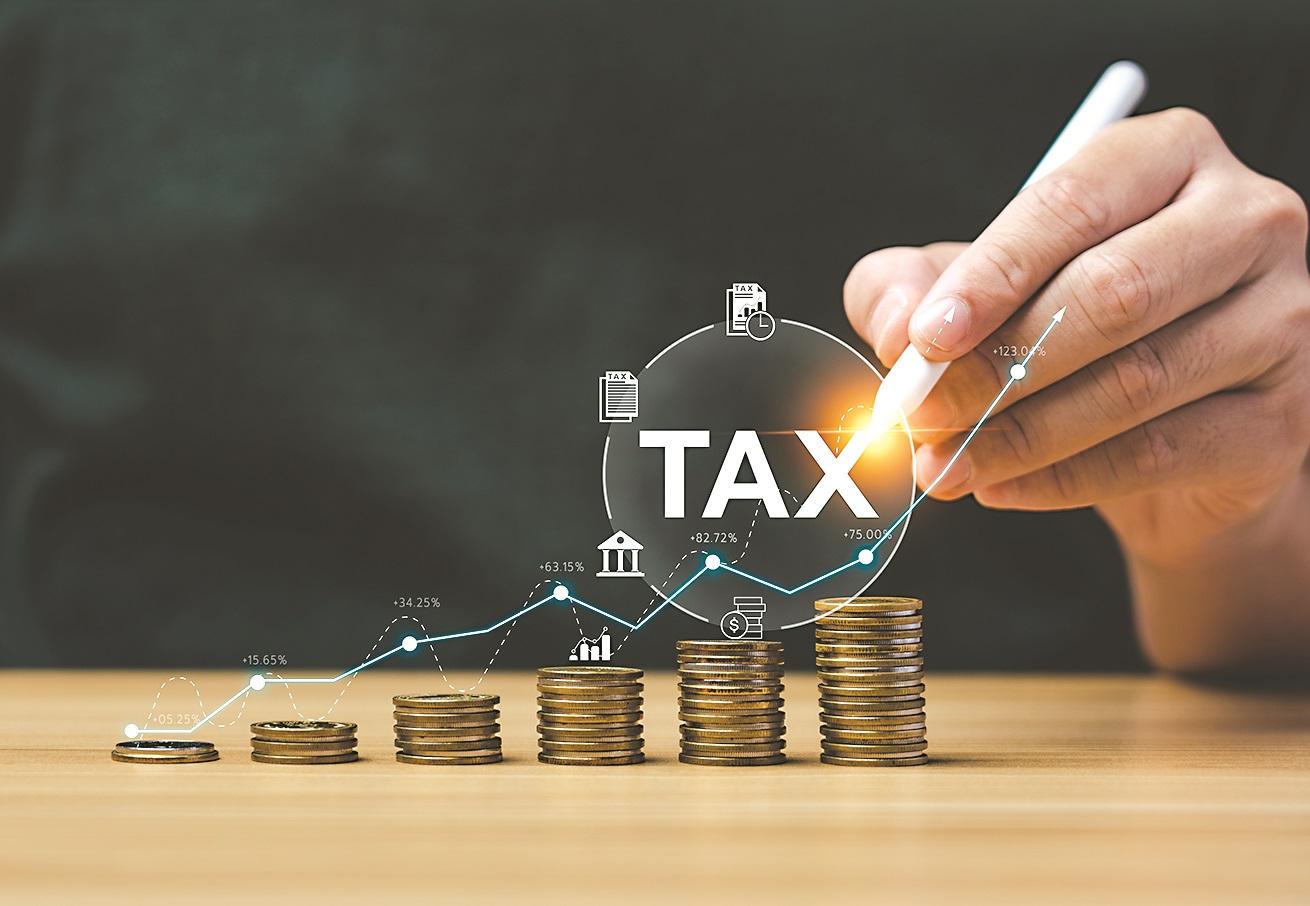
- 23 Jan 2024
Why is it in the News?`
During a NITI Aayog meeting chaired by the Prime Minister, Chief Ministers voiced their apprehensions regarding the declining revenues of the states.
Context:
- The Finance Commission holds a crucial role in suggesting the distribution formula for States' allotment of Union tax revenue.
- The formulation has witnessed changes over time in terms of the inclusion and significance of different factors, with tax contribution emerging as a central point of debate.
- It is essential to underscore the historical context, principles of equity and efficiency, and the repercussions of integrating the Goods and Services Tax (GST) regime into the distribution formula
What is the Finance Commission?
- The Finance Commission is a constitutional body responsible for providing recommendations on the distribution of tax revenues among the Union and the States, as well as among the States themselves.
- The President constitutes the Finance Commission under Article 280 of the Constitution.
- It is established at the end of every fifth year, or earlier if deemed necessary.
- Qualifications and Selection: Parliament, through legislation, determines the qualifications for Commission members and the selection process.
- The Finance Commission (Miscellaneous Provisions) Act, 1951, addresses these aspects.
- Mandate: The Commission's duties include making recommendations to the President on the distribution of tax proceeds between the Union and States, principles guiding grants-in-aid, measures to enhance State Consolidated Funds, and any other financial matters referred by the President in the interest of sound finance.
- Composition: The Commission comprises a Chairman and four members appointed by the President.
- Member Qualifications: The Chairman is selected from individuals with experience in public affairs, while the four other members are chosen from those with qualifications such as being former or eligible High Court Judges, and possessing expertise in government finances, administration, or economics.
- Tenure: Each member serves a specified term, as determined by the President, and is eligible for reappointment.
- Non-Binding Recommendations: The recommendations of the Finance Commission are advisory and not binding on the government.
The History and Evolution of the Distribution Formula:
- The historical development of the Finance Commission's distribution formula has played a pivotal role in shaping India's fiscal federalism.
- Initially focusing on personal income tax and Union excise duties, the formula underwent substantial changes with the introduction of the 10th Finance Commission, reflecting a more nuanced understanding of fiscal relations between the Union and States.
- Expansion of Revenue Streams with the 10th Finance Commission: The introduction of the 10th Finance Commission marked a significant transformation as all Central tax revenues were consolidated, expanding the range of revenue streams in the distribution formula.
- This departure from the earlier approach acknowledged the necessity for a comprehensive framework to address the intricate fiscal dynamics among the States.
- Equity and Efficiency as Guiding Principles: The distribution formula shifted its focus to prioritise equity and efficiency.
- Equity considerations aimed to rectify imbalances by allocating larger shares to revenue-scarce and high-expenditure States, while the efficiency principle rewarded states demonstrating proficiency in revenue collection and spending practices.
- This departure from the earlier needs-based criteria recognized the importance of incentivizing states to enhance fiscal capacities for the country's overall economic well-being.
- Dynamic Interplay of Equity and Efficiency: The ongoing normative debate within the Indian fiscal framework is exemplified by the dynamic interplay between equity and efficiency in successive Finance Commissions' recommendations.
- Striking the right balance between these principles remains a complex task, and the formula has evolved to reflect the changing priorities of fiscal federalism.
- Inclusion of Various Indicators: While early Finance Commissions incorporated indicators such as population, per capita income, and area in the distribution formula, a notable shift towards a more comprehensive and consolidated approach has occurred since the 10th Finance Commission.
- The convergence of income tax and Union excise duties into a single formula from the 10th Finance Commission onward aimed to streamline the approach and ensure consistency across different revenue sources.
Evaluating Efficiency Indicators in the Distribution Formula:
- Tax contribution serves as an efficiency indicator, offering insights into a state's developmental level and economic structure.
- Historically, it has been assigned a relatively modest weight, ranging from 10% to 20% within the distribution formula.
- In the early commissions, population, a key indicator of expenditure needs, played a dominant role, commanding weights between 80% and 90%.
- From the year 2000 onward, the distribution formula incorporated tax effort and fiscal discipline as efficiency indicators, each carrying approximately 15% weight.
- However, these indicators encountered challenges stemming from their instability, influenced by discretionary tax policies and unexpected shifts in tax bases.
The Reasons to Consider Petrol Consumption and GST in the Distribution Formula as Efficiency Measures:
- Petroleum Consumption as a Supplementary Indicator: In addition to GST, considering petroleum consumption as an efficiency indicator adds depth to the formula.
- Union excise duty and sales tax on petroleum products, excluded from GST, significantly contribute to the national exchequer.
- The stable and consistent nature of relative shares of petroleum consumption across states makes it an attractive supplementary indicator for assessing a state's contribution to specific tax categories.
- Stability and Uniformity in GST Contributions: In contrast to previous indicators, GST provides a unified tax system that minimizes variations in tax efforts among states.
- While the absolute amount of GST revenue generated may vary based on the size and economic structure of each state, the relative contributions remain stable over time.
- This stability is crucial for establishing a fair and consistent measure of a state's efficiency, particularly in revenue collection.
- Accurate Reflection of State's Tax Base through GST Revenue: The implementation of the Goods and Services Tax (GST) has transformed India's taxation landscape, introducing a consumption-based destination tax system that is equally divided between State and Central governments.
- This structure offers a unique opportunity for a precise estimation of a state's tax contribution.
- The inherent symmetry in GST ensures that the State GST accrual mirrors the Central GST accrual to the Union government from that state, making GST a stable and reliable measure of a state's tax base.
- Exclusion of Discretionary Policies in GST: One significant advantage of incorporating GST into the distribution formula is its insulation from discretionary tax policies.
- Unlike tax effort, which can be influenced by state-specific policy decisions, GST reflects the accurate tax base of a state, unaffected by varying policy choices.
- This characteristic makes GST a more objective and reliable indicator of a state's contribution to the national exchequer.
- Linkage to Income Levels: A compelling rationale for including both GST and petroleum consumption lies in their indirect reflection of the relative differences in the incomes accrued to the residents of a state.
- Consumption patterns are inherently tied to income levels, making the shares of CGST and Union excise duty accurate proxies for assessing both personal and corporate income tax contributions.
- Proposal for Weightage Increase: Given the fair and accurate nature of GST and petroleum consumption as efficiency metrics, there is a strong proposal for the 16th Finance Commission to assign a more substantial weightage to these indicators.
- A weightage of at least 33% has been suggested, considering the significant role these indicators play in reflecting a state's contribution to the national exchequer.
Conclusion
The transformation of the Finance Commission's distribution formula has moved from a reliance on population-centric indicators to embracing efficiency measures. The introduction of the GST regime, coupled with stable indicators such as petroleum consumption, offers an opportune moment to reassess the distribution formula. As the 16th Finance Commission contemplates the next formula, assigning appropriate weight to tax contribution as an efficiency indicator can guarantee a fair and accurate portrayal of states' contributions to the national exchequer.
The problem with India’s science management (The Hindu)
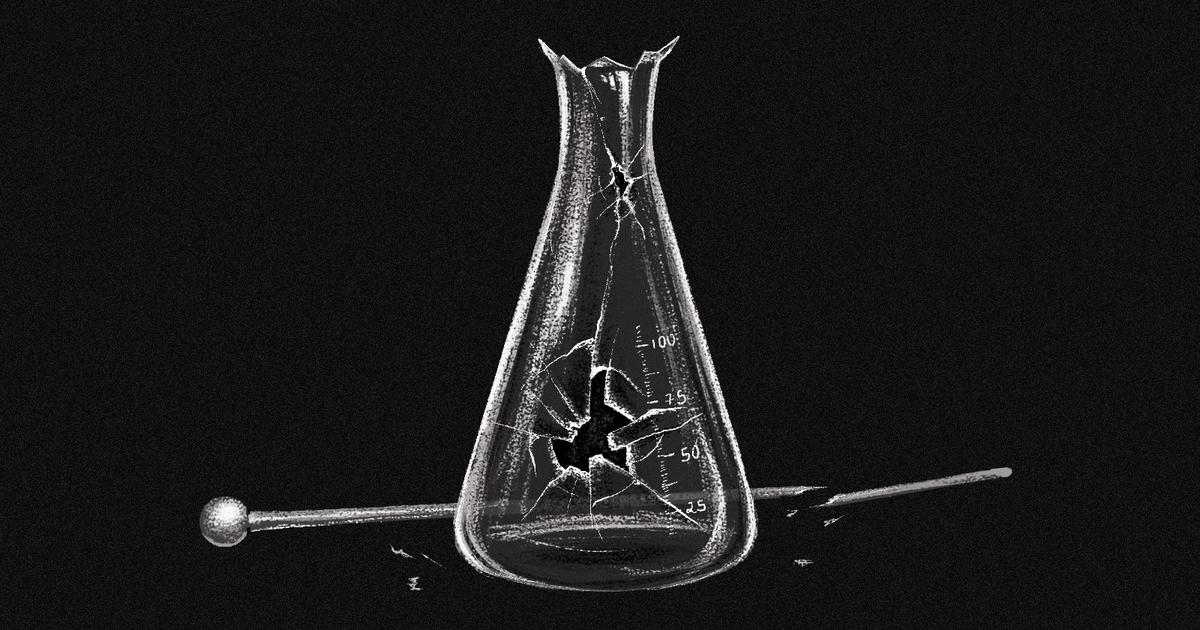
- 20 Jan 2024
Why is it in the News?
As India remoulds its scientific establishment, the utility of scientists being given administrative tasks needs to be questioned.
Context:
- Sustained economic progress which can satisfy national ambition is invariably fuelled by scientific advances translated into deployable technologies.
- This has been the inevitable global experience since the onset of the Industrial Revolution.
- The government is overhauling India’s science establishment, which includes setting up the new National Research Foundation (NRF) and restructuring the Defence Research and Development Organisation (DRDO).
- In this scenario, a frank assessment of the current administrative ability to simultaneously optimise Indian science’s efficiency and resilience is necessary.
What are the Problems with India’s Scientific Advancement?
India has a long and rich history of scientific innovation. However, in recent years, the country's science management has come under increasing scrutiny. There are several problems with India's science management including:
- Lack of Funding in Research and Development (R&D): One of the most pressing issues is a lack of funding.
- India spends a relatively small percentage of its GDP on research and development, compared to other developed countries.
- For instance, India allocates only about 0.7% of its GDP to R&D, a considerably lower figure compared to global leaders like the United States (3.5%) and China (2.4%).
- This lack of funding has led to a brain drain of talented scientists, who are leaving India in search of better opportunities.
- India spends a relatively small percentage of its GDP on research and development, compared to other developed countries.
- Budgetary Challenges: The modest commitment to R&D stems from broader budget constraints, competing priorities, and a historical emphasis on immediate socio-economic needs.
- This presents a challenge in fostering a robust scientific ecosystem on a limited budget.
- Lack of Coordination: Another problem with India's science management is a lack of coordination.
- There are many different government agencies and departments that are involved in science and technology, but there is often a lack of communication and cooperation between them.
- This can lead to duplication of effort and a waste of resources.
- Inadequacies in Budget Allocation by Scientific Administration: The current scientific administration struggles to identify and invest in high-impact projects.
- For instance, in 2022, the Indian Space Research Organisation ranked eighth in space launches, lagging in key technologies.
- Similar setbacks are evident in nuclear energy, genomics, robotics, and artificial intelligence.
- Lack of Strategic Planning and Execution: Beyond expenditure, the challenge extends to strategic planning and execution of scientific projects.
- Failure to adapt swiftly to emerging technologies and allocate resources judiciously has resulted in India falling behind in crucial fields.
- Inconsistent Long-Term Funding: A major concern is the absence of consistent long-term funding for vital projects, especially when faced with occasional setbacks.
- Steady funding, despite occasional failures, is crucial for a resilient and effective scientific management system.
- Finally, India's science management is often criticized for being too bureaucratic. The process of getting funding for research projects can be long and complex, and it can be difficult for scientists to get the support they need to succeed.
The Role of Senior Scientists in India’s Science Administration:
- Diverse Responsibilities Impacting Focus: Senior scientists in India often juggle multiple responsibilities, including academic pursuits, administrative duties, and leadership positions.
- This dispersion of focus can lead to inefficiencies and a lack of dedicated attention to critical administrative tasks.
- Lack of Administrative Skills: The assumption that successful scientists can seamlessly transition into effective administrators overlooks the distinct skills required for scientific work versus administration.
- Managing institutions, allocating resources, and making organizational decisions demand specific skills not necessarily possessed by accomplished scientists.
- Insufficient Training for Administrative Roles: Inadequate training makes it challenging for scientists to excel in administrative roles.
- Tasks like metric selection, conflict resolution, and setting priorities require skills not inherently developed through scientific training.
- Administration involves translating policy into outcomes, a skill not typically prioritized in scientific training.
- Conflicts of Interest and Quality Control Issues: The dual roles of scientists as academics and administrators can result in conflicts of interest within institutions.
- Academic rivalries, bureaucratic challenges, and compromised quality control may emerge, leading to issues like plagiarism, unethical publication practices, and compromised scientific outcomes.
- Nationwide Transfer System Absence: The absence of a nationwide transfer system for scientists and science administrators exacerbates issues such as competition and egotism.
- The lack of mobility within the system can contribute to internal divisions and hinder the progress of scientific careers and projects.
- Internal Control Challenges: Allowing individuals within the system to regulate it can lead to clear drawbacks, impacting the impartiality and effectiveness of science administration in India.
Challenges in India's Science Administration: A Historical Perspective
- Concentration of High-End Equipment: Economic constraints post-independence led India to concentrate on high-end scientific equipment, notably in institutions like the IITs.
- This concentration birthed gatekeepers, controlling access to critical resources and establishing a hierarchical structure where a few institutions wielded disproportionate influence.
- Gatekeepers and Institutional Captures Concept: Over time, these gatekeepers solidified their positions, accumulating power, government support, and institutional control.
- This system created an environment where young scientists navigated a complex web of influence, paying tributes to those controlling vital resources.
- Impact on Scientific Careers: The gatekeeping system not only influenced resource access but also shaped career trajectories.
- The nexus between institutional power and individual careers became pivotal, with appointments, awards, and international recognition often tied to maintaining favourable relations with gatekeepers.
- Normalization of Unethical Practices: The gatekeeping system has normalized unethical practices within Indian science.
- High plagiarism rates, paid publications in questionable journals, and undisclosed dealings for government funding have become ingrained, compromising the ethical standards of scientific research.
- Stifling Genuine Scientific Outcomes: This erosion of ethical standards doesn't just compromise research quality but stifles genuine scientific outcomes.
- Scientists in conflict with this system face hurdles, hindering promising careers and perpetuating a culture where personal connections often outweigh merit.
A Comparative Analysis of the U.S. Model and Indian Science Administration:
- U.S. Model: In the U.S., scientists chosen for administrative roles are identified early in their careers and undergo targeted training for managerial tasks.
- The emphasis is on maintaining a distinct separation between scientific pursuits and administrative responsibilities.
- Indian Scenario: In contrast, India's science administration traditionally involves senior scientists taking up administrative roles without a clear separation between scientific and administrative functions.
- This integrated approach poses challenges, as the skill sets needed for effective scientific research often differ significantly from those crucial for efficient administration.
Conclusion
As India pursues economic and strategic progress, challenges in science management hinder its research and development, causing a lag in innovation compared to other developed nations. To remedy this, increasing funding for research and development is crucial, along with enhancing coordination among government agencies and streamlining the funding process for research projects. By addressing these issues, India has the potential to emerge as a global leader in science and technology, bringing substantial benefits to its economy and society.
Supreme Court to hear Thackeray group's plea against speaker’s decision refusing to disqualify MLAs (The Hindu)
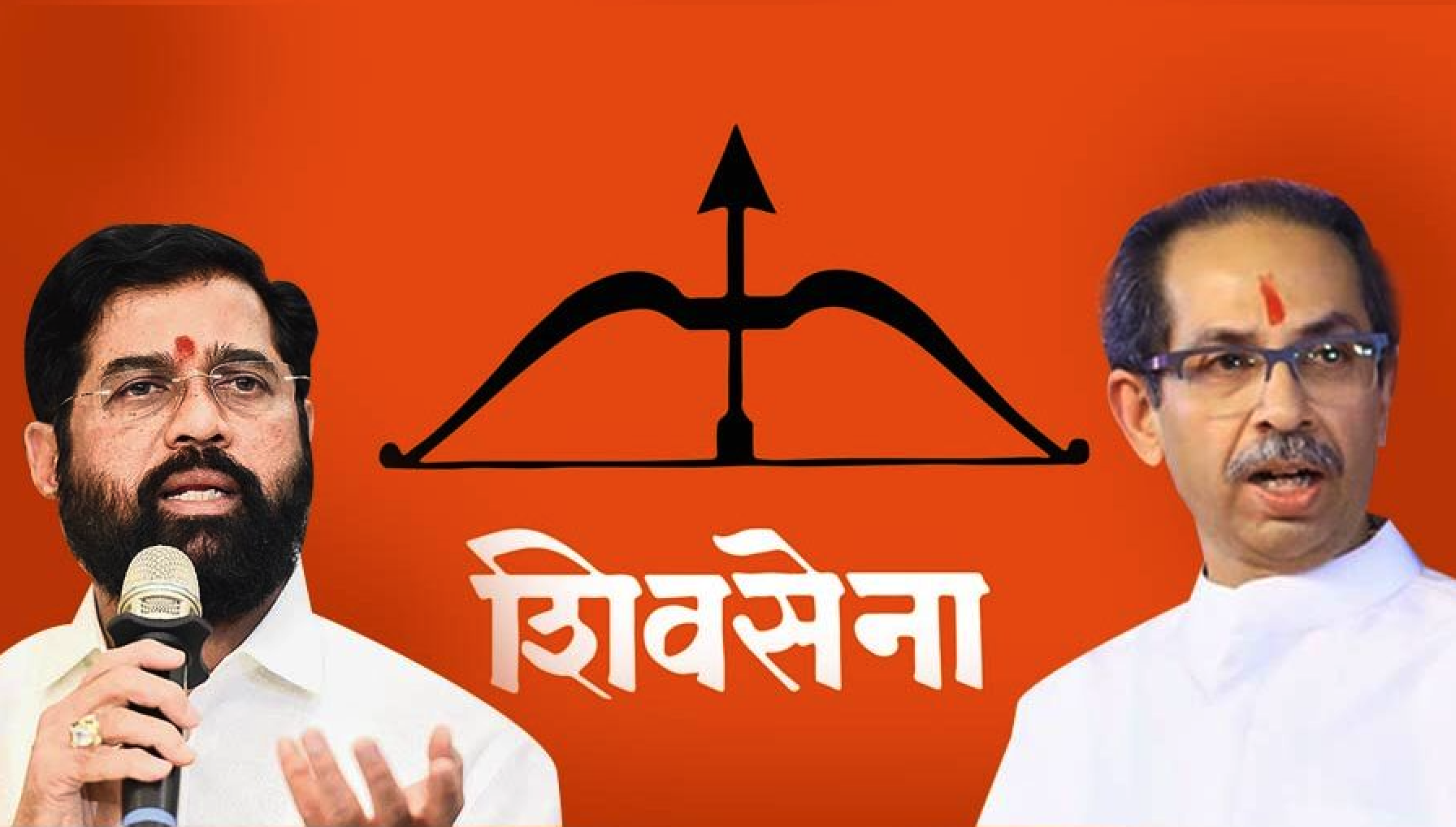
- 17 Jan 2024
Why is it in the News?
The Maharashtra Assembly Speaker has refused to disqualify 40 MLAs of the Eknath Shinde faction after recognising it as the real Shiv Sena.
What happened in Maharashtra?
- In June 2022, a faction of the Shiv Sena headed by Eknath Shinde moved with 37 of the 55 MLAs and claimed to be the real Shiv Sena. It appointed Bharat Gogawale as its whip.
- However, the UBT faction claimed that they were the original political party and that Sunil Prabhu of its faction would continue to be the whip.
- The Speaker has now recognised the Eknath Shinde faction as the real Shiv Sena and held the appointment of whip by this group as valid.
- This was based on the strength of members of the Shinde faction and the party’s 1999 constitution.
- The Speaker based on this ruling refused to disqualify 40 MLAs of the Shinde faction.
- He also refused to disqualify 14 MLAs of the UBT group as the whip instructions from Bharat Gogawale could not be physically served on them.
What is Defection?
- Defection refers to the act of a legislator shifting allegiance from one political party to another, embodying elements of revolt, dissent, and rebellion by an individual or a party.
- In the political context, it manifests as a scenario wherein a member of a political party relinquishes their allegiance and aligns with a different political entity.
- Historically termed as 'floor crossing,' this phenomenon finds its roots in the British House of Commons, symbolised by a legislator physically changing sides from the Government to the Opposition or vice versa.
- In India, the defections of legislators during the 1960s and 70s from their parent parties created political instability in many States, bringing down elected governments.
- Therefore, to ensure the stability of elected governments, the 52nd constitutional amendment introduced the ‘anti-defection’ law through the Tenth Schedule in 1985.
About the Anti-Defection Law:
- The Tenth Schedule of the Constitution, also known as the anti-defection law, was added to prevent political defections.
- The rationale for curbing such defections was that they undermined the foundations and principles of Indian democracy.
- The law disqualifies legislators for violating the will of their political party.
- In the 37 years, the law has been in place, while individual defections may have reduced, en masse defections continue.
- However, the presence of the Anti-Defection Law has also undermined democracy by inhibiting legislators from exercising their choice and ability to function independently, and restricted decision-making in legislatures to a few who control political parties.
Features of the Anti-Defection Law:
- Disqualification on grounds of defection: A legislator belonging to a political party will be disqualified if he:
- (i) voluntarily give up his party membership, or
- (ii) votes/abstains to vote in the House contrary to the direction issued by his political party.
- A member is not disqualified if he has taken prior permission of his party, or if the voting or abstention is condoned by the party within 15 days.
- Independent members will be disqualified if they join a political party after getting elected to the House.
- Nominated members will be disqualified if they join any political party six months after getting nominated.
- Exemptions in cases of merger: Members are exempted from such disqualification when at least two-thirds of the original political party merges with another political party. Further:
- (i) The members must have become members of the party they have merged with/into, or
- (ii) they should have not accepted the merger and chose to function as a separate group.
- Decision-making authority: The decision to disqualify a member from the House rests with the Chairman/Speaker of the House.
- In the Kihoto Hollohan case (1993), the Supreme Court held that the presiding officer, while deciding a question under the Tenth Schedule, functions as a tribunal.
- Hence, his decision like that of any other tribunal, is subject to judicial review on the grounds of mala fides, perversity, etc.
Advantages of Anti-Defection Law:
- Enhances political stability by curbing legislators' inclination to switch parties.
- Facilitates democratic realignment through party mergers within the legislature.
- Mitigates corruption and reduces non-developmental expenditures associated with irregular elections.
- Offers constitutional recognition to the existence of political parties, marking a significant milestone.
Criticism of the Anti-Defection Law:
- Limited Independence: The ADL restricts legislators from acting independently, contradicting the essence of parliamentary democracy by penalizing independent actions.
- Party Alignment Constraints: Legislators are bound by the official stance of their party on any issue, limiting their flexibility and autonomy.
- Reduced Constituency Accountability: By preventing parliamentarians from switching parties, the ADL diminishes accountability to both the Parliament and the constituents.
- Defence Through Splitting: The law allows a defence against disqualification through party splits, where one-third of legislators moving with a breakaway group avoids disqualification.
- Misinterpretation Challenges: The ADL is prone to misinterpretation, as seen in instances like Maharashtra, highlighting the absence of authoritative legal interpretations.
- Ambiguity in Splits: Recent occurrences show opposition members breaking away in small groups to join the ruling party, raising questions about disqualification when more than 2/3rd of the opposition defects.
- Attraction of Office: Critics argue that ideological defection is rare in India, with legislators often defecting due to the lure of office rather than ideological shifts.
Recommendations from Various Committees on ADL:
- Dinesh Goswami Committee on Electoral Reforms (1990): Disqualification should be confined to cases where a member voluntarily relinquishes party membership.
- Abstention from voting or voting against the party whip in a confidence or no-confidence motion should warrant disqualification.
- The President/Governor, advised by the Election Commission, should decide disqualification matters.
- Law Commission (170th Report, 1999): Eliminate provisions exempting splits and mergers from disqualification.
- Treat pre-poll electoral fronts as political parties under the anti-defection law.
- Political parties should issue whips only in situations jeopardizing the government.
- Constitution Review Commission (2002): Bar defectors from holding public office or any remunerative political post for the remaining term.
- Consider the vote cast by a defector to topple a government as invalid.
- Election Commission: Decisions under the Tenth Schedule should be made by the President/Governor, guided by the binding advice of the Election Commission.
Important Judgment Regarding Anti-Defection Law:
- Kihoto Hollohan Case: In the Kihoto Hollohan case, the Supreme Court affirmed the overall validity of the Anti-Defection Law, except for the aspect related to judicial review, which was deemed unconstitutional.
- Shri Rajesh Verma v. Shri Mohammad Shahid Akhlaque Case: The court, in the Shri Rajesh Verma v. Shri Mohammad Shahid Akhlaque case, established that publicly opposing one's original party and supporting another party constitutes a de facto resignation from the original party.
- Mannadi Satyanarayan Reddy v Andhra Pradesh Legislative Assembly Case: In the Mannadi Satyanarayan Reddy v Andhra Pradesh Legislative Assembly case, the court addressed the jurisdiction of the Speaker or Presiding Officers in deciding questions related to defection.
- The court clarified that there is no provision in the Tenth Schedule limiting the Speaker's exercise of jurisdiction to decide such questions.
What are the reforms needed?
- The Supreme Court in Sadiq Ali versus Election Commission of India (1971), laid down the three-test formula for determining which faction is to be recognised as the original political party by the Election Commission.
- These are the aims and objects of the party;
- Its affairs as per the party’s constitution reflect inner party democracy; and
- The majority in the legislative and organisation wings.
- The first test is subject to competing claims by rival groups.
- But it is the lack of inner party democracy that results in most of these defections.
The Election Commission in February 2023, recognised the Eknath Shinde faction as the real Shiv Sena, solely based on votes polled by legislators supporting Eknath Shinde in the Maharashtra Assembly elections of 2019. An authoritative Supreme Court judgment in these matters and the setting up of an independent tribunal to decide on the disqualification of members will reduce the ambiguities surrounding the Tenth Schedule. The real reform required is institutionalising internal democracy through regular inner-party elections in our political parties with strict monitoring by the Election Commission.
The UGC has issued revised guidelines on Mulya Pravah 2.0 – Inculcation of Human Values and Professional Ethics in Higher Education institutions (The Hindu)
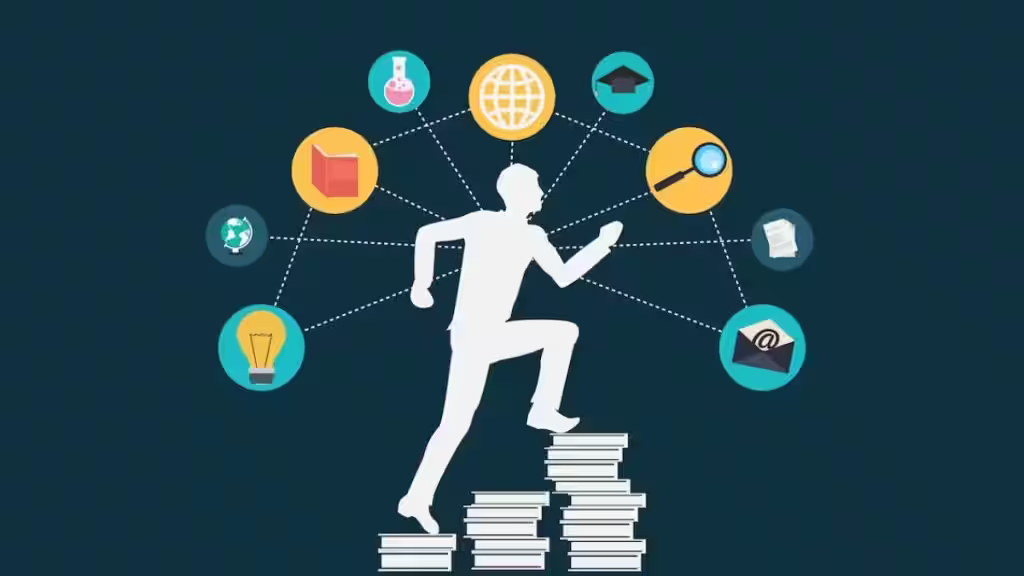
- 09 Jan 2024
Why is it in the News?
The University Grants Commission (UGC) has been issuing regulations, guidelines and directives at breakneck speed that some of the important ones miss drawing the attention of the higher education community.
Context:
- The University Grants Commission (UGC) has introduced Mulya Pravah 2.0 to enhance the ethical landscape of higher education institutions.
- This evolved guideline, succeeding its 2019 predecessor, aims to instil human values and professional ethics, actively combating unethical practices that have permeated various institutions.
- The primary focus involves constructing value-based institutions that resonate with fundamental duties and constitutional values, urging a commitment to integrity and ethical conduct.
What is Mulya Pravah?
- Officially notified in 2019, Mulya Pravah aims to instil human values and professional ethics within higher education institutions.
- Its explicit objective is to cultivate value-based institutions by guiding individuals and institutions toward fostering profound respect for fundamental duties, constitutional values, and a strong connection with the country.
What is Mulya Pravah 2.0?
- Mulya Pravah 2.0, a revised guideline by the University Grants Commission (UGC), is designed to foster ethical practices and human values within higher education institutions.
- Its inception was prompted by revelations from a survey among human resource managers, uncovering unethical practices like favouritism, sexual harassment, and gender discrimination in various organisational processes.
- The primary objective of this guideline is to construct value-based institutions by nurturing a sense of respect for fundamental duties, and constitutional values, and fostering a connection to the nation.
Key Features of Mulya Pravah 2.0:
- Addressing Unethical Practices: Mulya Pravah 2.0 confronts the prevalent unethical practices identified in higher education institutions, as uncovered by a survey involving human resource managers.
- These malpractices encompass favouritism, sexual harassment, gender discrimination, inconsistent discipline, lack of confidentiality, and unscrupulous dealings with vendors for personal gain.
- While acknowledging that such issues may extend beyond higher education, this guideline serves as a commendable initiative toward fostering ethical conduct.
- Emphasis on Transparency: A pivotal aspect of Mulya Pravah 2.0 is its advocacy for absolute transparency in administration. Decision-making within higher education institutions is expected to be guided solely by institutional and public interest, free from biases.
- The guideline stresses the elimination of discriminatory privileges and underscores the importance of penalizing corruption.
- It urges the establishment of a conducive culture and work environment, aligning actions with the best interests of the institution.
- Guidelines Emphasize Upholding Values: Mulya Pravah 2.0 mandates that higher education institutions uphold values such as integrity, trusteeship, harmony, accountability, inclusiveness, commitment, respectfulness, belongingness, sustainability, constitutional values, and global citizenship.
- This intervention is timely, considering the diminishing prevalence of these values. Officers in universities are entrusted with ensuring strict adherence to these values both in letter and spirit.
- Guidelines Remind Institutions to Act in the Best Interest: Mulya Pravah 2.0 serves as a reminder for stakeholders to act in the best interest of their institution, fostering a conducive culture and work environment for teaching, learning, and research while developing the potential of the institution.
- It explicitly states that officers and staff must refrain from misappropriating financial and other resources.
- Additionally, it calls for a refusal to accept gifts, favours, services, or other items from any entity that may compromise the impartial performance of duties.
What are the Challenges in the Effective Implementation of Mulya Pravah 2.0?
- Sincerity and Commitment of Higher Education Regulators: The mere issuance of guidelines may prove insufficient if higher education regulators lack sincere commitment to enforce the provisions of Mulya Pravah 2.0.
- The UGC must demonstrate unwavering determination, setting a precedent by exhibiting zero tolerance for any form of corruption or ethical violations within the academic sphere.
- Institutional Resistance to Change: Established norms and practices within higher education institutions may resist the infusion of Mulya Pravah 2.0's principles, as institutional cultures can be deeply ingrained.
- Overcoming institutional inertia requires proactive efforts by university administrators, faculty, and other stakeholders to embrace and implement the ethical guidelines.
- Lack of Monitoring Mechanisms: Effective implementation requires robust monitoring mechanisms to track and evaluate adherence to the guidelines at various levels.
- The absence of a comprehensive monitoring framework may lead to laxity, allowing unethical practices to persist unchecked.
- Resistance from Internal Stakeholders: Faculty, staff, and student unions might resist the guidelines, perceiving them as an imposition on their autonomy or a threat to established practices.
- Overcoming resistance necessitates effective communication, collaboration, and building consensus among all internal stakeholders.
- Balancing Transparency and Confidentiality: The guideline's emphasis on maintaining confidentiality might clash with the broader societal demand for transparency in higher education institutions.
- Striking a delicate balance between the two is crucial to avoid potential conflicts and ensure the right to information is not compromised.
- Undefined Parameters and Ambiguities: Some aspects of Mulya Pravah 2.0, such as what constitutes a dignified manner for raising issues, lack clear definitions.
- Ambiguities in the guideline could lead to misinterpretations, allowing room for manipulation and misuse.
- Legal and Regulatory Compliance: Ensuring that institutions adhere to the legal and regulatory framework while implementing Mulya Pravah 2.0 is essential.
- Non-compliance or overlooking legal aspects may render the guideline ineffective or subject to legal challenges.
- Cultural and Regional Variations: Higher education institutions exhibit diverse cultural and regional variations, influencing the reception and interpretation of ethical guidelines.
- Tailoring the implementation strategy to accommodate these variations is vital for the guidelines to resonate across different contexts.
- Inadequate Training and Awareness Programs: The success of Mulya Pravah 2.0 depends on the understanding and active participation of all stakeholders.
- Insufficient training and awareness programs may result in a lack of clarity regarding the guidelines, reducing their impact.
What Steps Can Be Taken to Improve Governance in Higher Education Institutions (HEIs)?
- Addressing the Issue of Confidentiality: The guideline should advocate for institutions to promptly publish agendas, proceedings, and minutes of meetings held by their decision-making bodies, sub-committees, and standing committees.
- Furthermore, institutions are encouraged to make their annual reports and audited accounts accessible to the public.
- This proactive disclosure can act as a deterrent against malpractices and contribute significantly to rebuilding public trust in institutional operations.
- Addressing Teachers’ Associations: Recognizing the significant impact teachers have on students' character, personality, and careers, Mulya Pravah 2.0 emphasizes that teachers should serve as role models.
- This involves exhibiting good conduct and maintaining high standards of dress, speech, and behavior for students to emulate.
- While the guideline underscores the expectation for teachers to adhere to university rules and policies, it does not explicitly address the role or function of teachers' associations, which warrants attention for a comprehensive approach.
- Clarity on the Definition of 'Dignified Manner' for Unions and Support: Mulya Pravah 2.0 anticipates the support of staff and student unions in development activities while urging them to raise concerns in a dignified manner.
- However, the guideline lacks a clear definition or explanation of what constitutes a 'dignified manner.'
- This absence leaves room for potential misuse, allowing the provision to be wielded in ways that may threaten, silence, or undermine the collective voices of stakeholders.
- A clear definition is crucial to avoid such misinterpretations and promote a healthy collaborative environment.
Conclusion
Mulya Pravah 2.0, introduced by the University Grants Commission, represents a commendable stride in instilling ethical values within higher education. Nonetheless, addressing its challenges necessitates inclusive discussions with all stakeholders. Effective implementation is imperative for realizing its potential to enhance the quality and sustainability of decisions within the educational sphere.
Why is child marriage still high in West Bengal? (The Hindu)

- 08 Jan 2024
Why is it in the News
A recent study on child marriage in India published in the Lancet noted the overall decrease in child marriage across the country but pointed out that four States, mainly Bihar (16.7%), West Bengal (15.2%), Uttar Pradesh (12.5%), and Maharashtra (8.2%) accounted for more than half of the total headcount burden of child marriages in girls.
Key Findings of the Report:
- In a recent study published in the Lancet Global Health, findings reveal that one in five girls and one in six boys in India are still marrying below the legal age.
- Utilizing data from five National Family Health Surveys spanning 1993 to 2021, researchers underscore the urgent need for strengthened national and state-level policies to eradicate child marriage by 2030.
- Notable disparities in the prevalence of girl and boy child marriages across states and Union Territories were observed during the study period.
- While all states, except Manipur, showed a decline in girl child marriage between 1993 and 2021, specific states like Bihar, West Bengal, Uttar Pradesh, and Maharashtra accounted for over half of the total burden.
- For boys, Gujarat, Bihar, West Bengal, and Uttar Pradesh accounted for more than 60% of the burden.
- Jharkhand exhibited the largest percentage increase in child marriage headcount (53.1%) between 1993 and 2021.
- Despite most states and Union Territories witnessing a decrease in the headcount of girl child marriage, Uttar Pradesh demonstrated the most substantial absolute decrease, contributing to about one-third of the nationwide decrease from 1993 to 2021
- Conversely, West Bengal saw the largest absolute increase, with over 500,000 more girls married as children during the same period.
What is Child Marriage?
- Child marriage is a social phenomenon prevalent in some Indian societies, where adults marry young children, usually girls under the age of fifteen.
- Another form involves parents arranging future marriages for children who only meet when reaching marriageable age, at which point the wedding ceremony occurs.
Child Marriages in India have undergone significant change:
- From 47.4% in 2005-06, child marriage decreased to 26.8% in 2015-16.
- In the last five years, it further declined by 3.5% points, reaching 23.3% in 2020-21, as per the latest National Family Health Survey-5 data.
- Despite an overall trend of decline, the current rate of 23.3% remains distressingly high in a country with a population of 141.2 crore.
- Eight states surpass the national average in child marriage prevalence, with West Bengal, Bihar, and Tripura having over 40% of women aged 20-24 married below 18, according to NFHS data.
- Some states, like Madhya Pradesh (23.1% in 2020-21 from 32.4% in 2015-16), Rajasthan (25.4% from 35.4%), and Haryana, have demonstrated a reduction in child marriages.
What is the Global Scenario?
- UNICEF data reveals that annually, 12 million girls enter childhood marriages.
- The 2030 UN Sustainable Development Goals target the eradication of harmful practices, including child, early, and forced marriages, along with female genital mutilations, under goal 5.
- Despite notable progress in South Asia over the past decade, where the risk of a girl marrying before 18 has decreased by over a third, dropping from nearly 50% to below 30%, the advancements are insufficient, and progress remains uneven.
Impact of Child Marriage:
- Beyond being a human rights violation and a recognized form of sexual and gender-based violence, child marriage significantly affects maternal and child health.
- A recent tragedy at Murshidabad Medical College and Hospital saw 10 infants die within 24 hours, with the majority born with extremely low birth weight.
- Murshidabad, an economically challenged district, grapples with a high prevalence of child marriages in West Bengal.
- NFHS-5 highlights that 55.4% of women aged 20-24 years in the district are married before the age of 18, marking an increase from NFHS-4, which reported a figure of 53.5%.
Legal Measures in India:
- Various laws, such as the Prohibition of Child Marriage Act, 2006, and the Protection of Children from Sexual Offences Act, 2012, work toward safeguarding children from human rights violations.
- The Prohibition of Child Marriage (Amendment) Bill, 2021 aims to raise the minimum marriage age for women from the current 18 years to 21 years.
Reasons to Raise the Minimum Age of Marriage for Females:
- Addressing Education and Employment Disparities: Women often face inequalities in accessing education and employment due to early marriages.
- Early marriage can restrict women from pursuing education and economic opportunities.
- Raising the minimum age for marriage can encourage more women to pursue higher education and seek employment.
- Impact of Early Marriage on Women's and Children's Health: Early marriages and subsequent early pregnancies have significant implications for the nutritional levels, overall health, and mental wellbeing of both mothers and children.
- Underage mothers are more vulnerable to reproductive health challenges, malnutrition, postpartum hemorrhage, and susceptibility to sexually transmitted diseases.
Govt. Initiatives for Preventing Girl Child Marriage:
- Beti Bachao Beti Padhao: Among various girl child welfare schemes, Beti Bachao Beti Padhao is widely recognized.
- Translating to "Save the Girl Child, Educate the Girl Child," it focuses on women empowerment and creating an inclusive ecosystem.
- The scheme aims to promote the safety of girl children before and after birth.
- Sukanya Samriddhi Yojana (SSY): Launched in 2015, SSY promotes the welfare of girl children.
- It encourages parents to invest in funds for the girl's future studies and marriage expenses.
- Balika Samriddhi Yojana: This central government scheme supports girls in financially vulnerable sections.
- Ensures the enrollment and retention of girl children in primary and secondary schools, emphasizing quality education.
To avoid worst-case scenarios, the need for fiscal correction is all the more vital this election year (The Hindu)
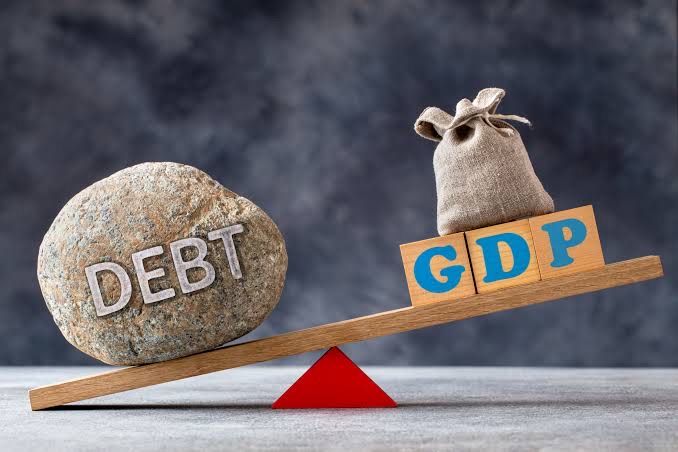
- 05 Jan 2024
Why is it in the News
The recent observations by the International Monetary Fund (IMF) sparked reactions from the Indian Government in which it states that India’s general government debt, including the Centre and States, could be 100% of GDP under adverse circumstances by fiscal 2028.
Context:
- India’s economic landscape has undergone scrutiny as the International Monetary Fund (IMF) made two noteworthy observations.
- The IMF report not only acknowledged India’s effective inflation management but also presented a balanced outlook for the country’s economic growth.
- To analyze the IMF’s insights on India’s economic situation, one must understand the broader global context in which these observations were made.
Insights from the IMF on India's Economic Landscape:
Exchange Rate Reclassification:
- A pivotal observation by the IMF is the reclassification of India's exchange rate regime from floating to a stabilised arrangement.
- This reclassification raises questions about the flexibility of the currency and its alignment with market forces, indicating a perception of a more controlled and stabilised environment, potentially influenced by central bank (RBI) interventions.
Debt Sustainability Concerns:
- The IMF expresses significant concerns about the long-term sustainability of India's debts.
- The report projects that, under adverse circumstances, India's general government debt could reach 100% of GDP by fiscal 2028.
- This highlights the imperative for careful debt management strategies, particularly as India confronts substantial investment requirements to meet climate change mitigation targets and enhance resilience to climate stresses and natural disasters.
- It's crucial to note that these IMF insights are framed within the global context of increasing public debts, recognizing that India's economic challenges are interconnected within a complex web of global economic phenomena.
The Global Debt Scenario in a Broader Context:
Dual Nature of Debt: Accelerator vs. Drag on Development:
- Globally, government borrowings have been instrumental in fostering development, supporting infrastructure projects, social programs, and economic growth.
- However, the IMF's concerns emphasize the potential drawbacks of this strategy, as limitations in accessing financing, rising borrowing costs, currency devaluations, and sluggish growth can transform debt from a catalyst into a hindrance.
- The United Nations' assertion that countries face a challenging dilemma between servicing their debt or serving their people encapsulates the inherent difficulty in managing debt for sustainable development.
Surging Global Public Debt Trends:
- According to the UN, global public debt has surged more than fourfold since 2000, surpassing the tripling of global GDP over the same period.
- In 2022, global public debt reached USD 92 trillion, with developing countries contributing nearly 30% to the total, and China, India, and Brazil accounting for a significant portion (70%).
- The acceleration of debt in developing nations over the past decade is attributed to heightened development financing needs exacerbated by the COVID-19 pandemic, the cost-of-living crisis, and the impact of climate change.
Asymmetric Burden on Developing Countries:
- The burden of debt is unevenly distributed between developed and developing nations, with developing countries often facing higher interest rates even without considering exchange rate fluctuations.
- This well-documented disparity reveals that countries in Africa, for instance, borrow at rates four times higher than the United States and eight times higher than Germany, undermining the debt sustainability of developing economies.
Increasing Debt Levels and the IMF's Perspective:
- The number of countries grappling with high levels of debt has surged from 22 in 2011 to 59 in 2022, highlighting persistent debt challenges in developing nations.
- The IMF's projections for India should be understood in the broader context of a global debt conundrum.
Challenges Facing India's Economic Landscape:
Increasing Public Debt:
- The central government's debt, amounting to ?155.6 trillion, constitutes 57.1% of GDP as of March 2023, with state government debts accounting for about 28% of GDP.
- Despite claims by the Finance Ministry that India's public debt-to-GDP ratio has marginally increased from 81% in 2005-06 to 84% in 2021-22, the 2022-23 figures indicate a return to 81%, surpassing targets set by the Fiscal Responsibility and Budget Management Act (FRBMA).
Balancing Public Debt for Sustainability:
- A significant challenge for India lies in achieving a delicate balance to ensure that public debt remains within sustainable levels.
- IMF projections indicate that India's general government debt, inclusive of both central and state governments, could reach 100% of GDP by fiscal 2028 under adverse circumstances, underscoring the need for meticulous debt management strategies.
Stagnant Credit Ratings:
- Despite being acknowledged as the fastest-growing major economy globally, India's sovereign investment ratings have remained stagnant since August 2006.
- Both Fitch Ratings and S&P Global Ratings have maintained India's credit rating at 'BBB-' with a stable outlook, the lowest investment-grade level, attributed to factors like weak fiscal performance and a burdensome debt stock.
Emerging Fiscal Challenges:
- Disruptions caused by the COVID-19 pandemic contribute to the current high debt-GDP ratio, with potential fiscal slippage in FY24 according to India Ratings and Research.
- Increased expenditure on employment guarantee schemes and subsidies, such as a higher fertiliser subsidy and overspending on the MGNREGA, pose challenges to fiscal stability.
Managing Short-Term Challenges and Election Dynamics:
- As India approaches general elections, increased subsidies are expected, but questions arise about the impact on employment growth and livelihoods in rural areas.
- Navigating these short-term challenges in an election year becomes a critical test for maintaining fiscal discipline and avoiding worst-case scenarios.
Way Forward:
- While the exchange rate reclassification raises potential concerns about excessive management, the focus on debt sustainability underscores the broader call for prudence in managing fiscal policies.
- The IMF's observations highlight the delicate balancing act India must perform—maintaining a stable exchange rate while ensuring long-term debt sustainability.
- There is a pressing need for new and preferably concessional sources of financing, increased private sector investment, and the implementation of carbon pricing or equivalent mechanisms to address long-term risks.
Conclusion:
Navigating the multifaceted challenges outlined by the IMF, India finds itself at a crucial juncture, necessitating a strategic approach to economic management. The IMF's observations, addressing concerns about debt sustainability and the reclassification of the exchange rate regime, underscore the importance of nuanced decision-making and long-term planning.
Raj Bhavan Needs Radical Reforms (The Hindu)
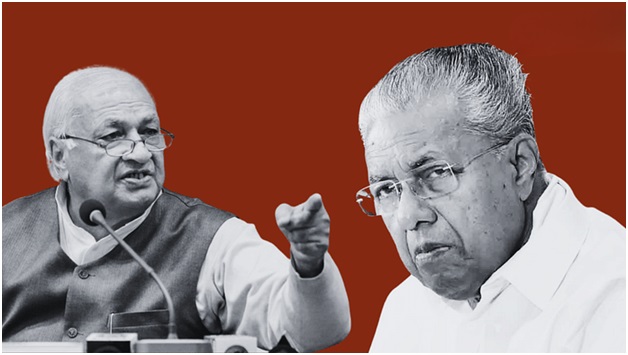
- 04 Jan 2024
Why is it in the News?
Recently, during a visit to the Calicut University campus, the Governor of Kerala referred to activists from the Students’ Federation of India as 'criminals.' This incident raises concerns about the conduct of Governors in states led by opposition parties and underscores the need to examine the legal implications of such statements.
Context:
- In Kerala, the State Assembly passed a Bill to abolish the Governor’s chancellorship.
- The Governor did not give assent to it and referred the Bill, along with others, to the President.
- This happened after he sat on the Bills for a long time and after the government moved the Supreme Court to pray for gubernatorial assent.
- It was in this context that he visited the University as Chancellor, against the will of the Assembly.
- This action lacked democratic legitimacy.
Role of Chancellor in State Public Universities:
- State public universities are established through state legislation, with the Governor typically designated as the Chancellor in most laws.
- As Chancellor, the Governor serves as the head of public universities and holds the authority to appoint the Vice-Chancellor.
- The Chancellor possesses the power to invalidate any university proceedings not in accordance with existing laws.
Governor's Discretion as Chancellor:
- In 1997, the Supreme Court clarified that the Governor, in the capacity of Chancellor, is not bound by the aid and advice of the Council of Ministers when performing duties related to a separate statutory office.
- Both the Sarkaria and Punchhi Commissions acknowledged the Governor's independence in discharging statutory functions, emphasizing that the Governor is not legally obligated to follow the advice of the Council of Ministers.
- However, consultation with the concerned Minister may be beneficial for the Governor
Limits to immunity:
- Article 361 of the Constitution provides only a limited and conditional immunity for the Governors.
- It says that Governors shall not be answerable to any court for the exercise and performance of the powers and duties of their office or for any act done or purported to be done by them in their official capacity.
- This does not mean that Governors are not liable for their misbehaviour unconnected with their official duty.
- In Rameshwar Prasad v. Union of India (2006), after finding that the Governor abused power in recommending Presidential rule in Bihar, the Supreme Court said that the motivated and whimsical conduct of the Governor is amenable to judicial review.
- Yet, the question of whether Governors can claim immunity for extra-constitutional gestures and utterances was not a matter of issue in Rameshwar Prasad.
- However, the Court said that “right persons” should be chosen as Governors to maintain “the sanctity of the post”.
Legal Implications of Derogatory Comments by Public Functionaries:
- Kaushal Kishor v. State of Uttar Pradesh (2023): The court emphasized that the freedom of expression for public functionaries should only be restricted by 'reasonable restrictions' outlined in Article 19(2) of the Constitution.
- Regarding ministers, Justice B.V. Nagarathna highlighted that if a public functionary's statement contradicts the government's stance, the minister is personally responsible and can face consequences for the remarks.
- While there was agreement on the personal liability of public functionaries for actions unrelated to their public duty, there were varying opinions on the enforcement of fundamental rights against non-state actors.
- This implies that public functionaries do not enjoy statutory or constitutional immunity if they commit a crime, including offences like defamation, especially when the act is unrelated to or conflicts with their official duties.
Commission reports:
- The Sarkaria Commission Report (1988) lamented that “some Governors have failed to display the qualities of impartiality and sagacity expected of them”.
- It added that “many Governors, looking forward to further office under the Union or [an] active role in politics after their tenure came to regard themselves as agents of the Union”. Since then, the situation has only worsened.
- The Commission’s recommendation that the “(Governor) should be a detached figure and not too intimately connected with the local politics of the State” remains wishful thinking.
- The Justice M.M. Punchhi Commission report (2010) said that “to be able to discharge the constitutional obligations fairly and impartially, the Governor should not be burdened with positions and powers which are not envisaged by the Constitution.”
- It said that conferring statutory power on Governors by posting them as chancellors of the universities will have the potential to expose Raj Bhavan to “controversies or public criticism”.
Way Forward:
- Legal Prohibition: The state legislative requires systemic changes regarding the office of the Governor, necessitating a legal prohibition against further appointments of Governors in any official capacity.
- Constitutional Amendment: The central government should consider amending Article 155 of the Constitution, involving consultation with the Chief Minister, as recommended by the Sarkaria Commission.
- Establishing an independent body for Governor selection, with a significant role for the Chief Justice of India, could enhance the quality of the selection process.
- Constitutional Morality: While the Constitution may not regulate individual behaviour, emphasizing the notion of constitutional morality is crucial.
- In the NCT of Delhi v. Union of India (2018) case, the Supreme Court highlighted the importance of identifying the "moral values of the Constitution" based on a notion of "constitutional culture."
- It stressed that "constitutional morality places responsibilities and duties on individuals who occupy constitutional institutions and offices."
Conclusion
While the office of the Governor is entrusted with defending the Constitution and advising elected regimes, it is essential to prevent the potential misuse of powers in the absence of a defined time frame for decision-making. Establishing a reasonable time frame for Governors to decide on Bills passed by the Assembly is imperative to safeguard the principles of federalism in the country.
Important Constitutional Provisions Related to the Governor:
- Article 153 stipulates that each state shall have a Governor, with one person who can be appointed as Governor for two or more states.
- The Governor of a State shall be appointed by the President by warrant under his hand and seal (Article 155).
- A person to be eligible for appointment as Governor should be a citizen of India and have completed an age of 35 years (Article 157).
- Article 156 of the Indian Constitution deals with the Term of office of Governor.
- It further states that the Governor shall hold office during the pleasure of the President.
- Article 161 grants the Governor the power to grant pardons, reprieves, etc.
- However, the Supreme Court clarified that the Governor exercises this power in consultation with the State government, being bound by its advice.
- Article 163 establishes a council of ministers headed by the Chief Minister to aid and advise the Governor in performing functions, with certain exceptions for discretion.
- Article 164: The Chief Minister shall be appointed by the Governor and the other Ministers shall be appointed by the Governor on the advice of the Chief Minister, and the Ministers shall hold office during the pleasure of the Governor.
- Article 174: The Governor can also summon, prorogue, and dissolve the Legislative Assembly.
- By convention, he does this on the advice of the Council of Ministers while they enjoy the confidence of the Assembly
Discretionary powers include:
- Appointment of a Chief Minister in the absence of a clear majority in the state legislative assembly
- Handling situations like no-confidence motions
- Addressing the failure of constitutional machinery in the state (Article 356)
- The Governor's authority concerning the passage of bills is delineated by Article 200 and Article 201. The Governor may:
- Give assent, turning the bill into law
- Withhold assent, rejecting the bill
- Return the bill (if not a money bill) to the state legislature for reconsideration, with or without specific recommendations
- If the bill is reconsidered and passed again, the Governor cannot withhold assent.
- The Governor may also reserve the bill for the President's consideration, who can assent, withhold assent, or direct the Governor to return the bill to the state legislature for further review.
Broadcast Regulation 3.0, Commissions and Omissions (The Hindu)

- 01 Dec 2023
Why is it in the News?
The Ministry of Information and Broadcasting (MIB) has taken a significant step in broadcasting regulation by releasing the Broadcasting Services (Regulation) Bill 2023. This bill is part of a series of efforts to regulate broadcasting in an integrated manner.
Context:
The Ministry of Information and Broadcasting, Government of India has proposed a draft Broadcasting Services (Regulation) Bill, 2023. The draft Bill provides for a consolidated framework to regulate the broadcasting services in the country and seeks to replace the existing Cable Television Networks (Regulation) Act, 1995, and other Policy Guidelines currently governing the broadcasting sector in the country.
The Bill streamlines regulatory processes, extends its purview to cover Over-the-Top(OTT) content and digital news, and introduces contemporary definitions and provisions for emerging technologies. It seeks to provide Content Evaluation Committees and a Broadcast Advisory Council for self-regulation, different program and advertisement codes for different Broadcasting Network Operators, Accessibility measures for persons with disabilities, and statutory penalties, etc.
Key Highlights of the draft Broadcasting Services (Regulation) Bill, 2023:
- Consolidation and Modernization: It addresses a long-standing need to consolidate and update the regulatory provisions for various broadcasting services under a single legislative framework.
- This move streamlines the regulatory process, making it more efficient and contemporary.
- It extends its regulatory purview to encompass broadcasting over-the-top (OTT) content and digital news and current affairs currently regulated through IT Act, 2000 and regulations made there under.
- Contemporary Definitions and Future-Ready Provisions: To keep pace with the evolving technologies and services, the bill introduces comprehensive definitions for contemporary broadcasting terms and incorporates provisions for emerging broadcasting technologies.
- Strengthens the Self-Regulation Regime: It enhances self-regulation with the introduction of ‘Content evaluation committees and evolves the existing Inter-Departmental Committee into a more participative and broader ‘Broadcast Advisory Council’.
- Differentiated Programme Code and Advertisement Code: It allows for a differentiated approach to Programme and Advertisement Codes across various services and requires self-classification by broadcasters and robust access control measures for restricted content.
- Accessibility for Persons with Disabilities: The bill addresses the specific needs of persons with disabilities by providing enabling provisions for the issue of comprehensive accessibility guidelines.
- Statutory Penalties and Fines: The draft Bill introduces statutory penalties such as advisory, warning, censure, or monetary penalties, for operators and broadcasters. Provision for imprisonment and/or fines remains, but only for very serious offenses, ensuring a balanced approach to regulation.
- Equitable Penalties: Monetary penalties and fines are linked to the financial capacity of the entity, taking into account their investment and turnover to ensure fairness and equity.
- Infrastructure Sharing, Platform Services, and Right of Way: The bill also includes provisions for infrastructure sharing among broadcasting network operators and carriage of platform services.
- Further, it streamlines the Right of Way section to address relocation and alterations more efficiently, and establishes a structured dispute resolution mechanism.
Arguments in Support of the Bill:
- Revamped Legal Framework: This legislation signifies a departure from the Cable Television Networks Regulation Act of 1995.
- The Information & Broadcasting Minister lauds it as a "crucial law" designed to modernize the regulatory framework, aligning with the dynamic landscape of OTT, digital media, DTH, IPTV, and emerging technologies.
- Additionally, it incorporates comprehensive accessibility guidelines for the Divyangjan community.
- Empowerment of Broadcasters: The bill introduces provisions aimed at empowering broadcasters through self-regulation mechanisms.
- Striving for a delicate balance between regulatory oversight and industry autonomy is a key objective.
- Tailored Approach to Codes: The draft Bill permits a "differentiated approach" to Programme and Advertisement Codes across diverse services.
- This approach enables the tailoring of regulations to accommodate the unique nature of linear and on-demand content, providing content creators with increased flexibility and relevance.
- Equitable Measures: Monetary penalties under this bill are intricately tied to the entity's investment and turnover, ensuring fairness.
- Penalties are proportionally determined based on the financial standing of the entity, meaning that larger corporations with higher investments and turnovers may face more substantial fines compared to smaller entities with limited financial capacity.
- Inclusive Stakeholder Participation: The bill emphasizes stakeholder involvement through public consultation, a move applauded by the industry.
- The government's initiative to establish a unified law is welcomed, with expectations that it will streamline compliance and enforcement processes.
Arguments Against the Bill:
- Concerns about Control and Regulation: There are concerns surrounding whether the bill's emphasis is truly on public service or if it leans more towards expanding government control and regulation.
- Some worry that the bill might amplify government control over digital infrastructure and influence citizens' viewing choices.
- Ambiguities in Draft Provisions: Specifically, point 36 in the draft raises concerns about its broad and ambiguous language, providing authorities with the power to restrict content.
- Questions arise regarding the role of "authorized officers" working under government direction.
- Potential Impact on Minority Communities: Apprehensions exist that the bill could lead to the erasure or selective representation of Indian minority communities.
- The draft's vague language may be susceptible to exploitation, promoting a universal majority identity for India.
- Challenges with Cable Regulation: The Cable Television Networks (Regulation) Act of 1995, initially targeting illegal cable operators, faced transparency issues due to a nexus involving operators, politicians, entrepreneurs, and broadcasters.
- The new bill fails to address loopholes and problems in implementing the existing Act, including conflicts of interest and opaque practices within the Indian media industry.
- Government's Trust Deficit: Critics point to the government's recent history with media regulation, highlighting a pattern of unfulfilled promises and questionable outcomes.
- The bill is compared to the controversial IT Rules of 2021 introduced for national welfare.
- Concerns about Oligopolistic Media Ownership: Amid debates on "cultural invasion" and "anti-national" programming, some argue that the connection between government officials and media houses may foster oligopolistic media ownership.
Notable Omissions from the Bill:
- Lack of Regulation on Ownership: The bill overlooks concerns related to ownership within the media landscape, mirroring the oversights in the TRAI paper.
- Despite placing emphasis on audience measurement methodologies, the absence of provisions regulating cross-media and vertical ownership is apparent.
- Cross-media ownership, previously identified as a threat to diversity by TRAI, consolidates media power, with interconnected interests of cable and DTH distributors, news broadcasters, and telecom companies potentially restricting the array of available news sources.
- Absence of an Independent Broadcast Regulator: The bill remains silent on the establishment of an independent broadcast regulator, a concept previously endorsed in the 'airwaves' judgment of 1995, the 1997 Broadcasting Bill, and reiterated in the 2007 iteration.
- Instead of proposing an independent regulator, the bill introduces a 'Broadcast Advisory Council' tasked with addressing viewer grievances and violations of the Programme Code and Advertisement Code.
- Concerns arise about the Council's ability to handle grievances from a broad audience and questions surface regarding its autonomy.
The Way Ahead: Urgent Requirement for Conflict of Interest Regulation
- The Indian government has not effectively managed conflicts of interest in the media industry, especially the connections between MSOs (Multi-Service Operators), politicians, and vertical integration.
- As this has led to a loss of trust, a regulation on conflicts of interest is the need of the hour.
Conclusion
The essence of Broadcasting Regulation goes beyond mere compliance; it revolves around fostering an environment conducive to growth, and innovation, and ensuring fair access to communication services. Striking the right balance between regulatory oversight and industry autonomy is crucial for India to strategically position itself for sustained success in the rapidly evolving telecommunications sector.
Large Ozone Hole Detected Over Antarctica (The Hindu)

- 13 Oct 2023
Why is it in the News?
As part of the EU’s environmental monitoring program, the European Space Agency Copernicus Sentinel-5P satellite detected a giant hole in the ozone layer over Antarctica recently.
What is an Ozone Hole?
- An ozone hole refers to a region in the stratosphere above Antarctica where the ozone layer experiences significant depletion.
- Contrary to the term "hole," it doesn't imply a complete absence of ozone; rather, scientists use the term metaphorically to indicate an area where ozone concentrations fall below the historical threshold of 220 Dobson Units.
- The dimensions of the ozone hole over Antarctica fluctuate annually, typically forming in August and dissipating by November or December, driven by distinct climatic conditions in the region.
Mechanism Behind Ozone Hole Formation:
- The emergence of the ozone hole is linked to the Earth's rotation, creating specific winds over the enclosed Antarctic landmass.
- The polar vortex, characterized by robust winds around the poles, is a key factor in the dynamics of the ozone hole.
- During winter, the polar vortex forms due to temperature variations, acting as a barrier that separates polar air from warmer air at lower latitudes.
- This isolation fosters the formation of polar stratospheric clouds (PSCs), triggering reactions leading to ozone depletion.
- Chemical processes occurring on the surface of PSCs activate chlorine and bromine compounds, particularly chlorine, acting as catalysts in ozone-depleting reactions.
- When exposed to sunlight, these compounds catalyze the breakdown of ozone molecules.
- The size and intensity of the polar vortex directly influence the extent of ozone depletion.
- As the vortex weakens in spring, the mixing of polar air with warmer air from lower latitudes gradually closes the ozone hole, contributing to the restoration of the ozone layer.
What Caused the Giant Ozone Hole in 2023?
- Scientists believe this year’s big ozone hole could be due to the volcanic eruptions at Hunga Tongain Tonga during December 2022 and January 2023.
- In contrast to typical volcanic eruptions that release gases primarily within the lower atmosphere, this specific event ejected a substantial quantity of water vapour into the stratosphere.
- The presence of water vapour, along with other ozone-depleting elements such as bromine and iodine, had repercussions on the ozone layer through chemical reactions, ultimately modifying its heating rate.
Human-caused Ozone Holes:
- While this year’s Antarctic ozone hole was likely due to a volcanic eruption, scientists became aware that human activities were creating huge ozone holes in the 1970s.
- Ground and satellite-based measurements detected the holes, which were caused by the widespread use of chemicals called chlorofluorocarbons.
- “The culprit behind ozone depletion was not aerosols in aerosol cans, but the propellants we use as gases to propel the solutions inside.
- These gaseous propellants contain chlorine, which is released high in the stratosphere and depletes the ozone.
- The world took action after scientists raised alarm over the ozone holes, and quickly.
- In 1987, The Montreal Protocol was created to protect the ozone layer by phasing out the production of these harmful substances.
- The protocol was effective as ozone holes got smaller in the decades after ozone-depleting gas emissions were controlled.
Is there any Relation Between Climate Change and Ozone Holes?
- Ozone depletion is not considered a primary catalyst for global climate change.
- Nevertheless, there are indications that the rising global temperatures associated with climate change may impact the dynamics of ozone holes.
- Recent instances of substantial ozone holes have been associated with climate change, particularly the escalation of wildfires.
- The heightened frequency and intensity of wildfires, often exacerbated by climate change, release more smoke into the stratosphere, potentially contributing to additional ozone depletion.
- While ozone holes may yield a cooling effect by diminishing the greenhouse gas impact (as the loss of ozone allows slightly more heat to escape into space from that region), they can also disrupt the normal progression of seasons, leading to prolonged wintertime conditions.
What is Ozone (O3)?
- Formation: Ozone molecules result from the interaction of ultraviolet (UV) radiation from the Sun with O2 molecules.
- During this process, an O2 molecule is split, and the two liberated oxygen atoms combine with other O2 molecules, forming O3 molecules.
- While oxygen (O2) constitutes 21% of Earth's atmosphere, ozone makes up less than 0.001%.
- Ozone Layer: The ozone layer, crucial for life on Earth, is primarily generated in the stratosphere where UV radiation is more intense due to thinner air at higher altitudes.
- This region, known as the 'ozone layer,' spans approximately 10 to 40 km in altitude, with a peak of around 25 km.
- Significance of Ozone Layer: The ozone layer plays a vital role in protecting life on Earth by absorbing the most harmful type of UV radiation, UV-B radiation, with wavelengths between 280 and 315 nanometres.
- Shielding against UV rays is significant in reducing skin cancer rates, as most skin cancers are linked to excessive UV radiation exposure.
- As UV radiation is absorbed by ozone in the stratosphere, it leads to the heating of the surrounding air, creating the stratospheric temperature inversion.
- Measurement of Stratospheric Ozone: Stratospheric ozone is quantified as the total amount present in an atmospheric column in Dobson units.
- One Dobson unit represents the amount of ozone that would form a layer 0.01 mm thick at average sea-level pressure and temperature.
- Ozone Production: Most stratospheric ozone is produced at tropical latitudes, and high-altitude winds disperse it globally.
- Ozone undergoes continual formation and breakdown, with its distribution across the planet being neither uniform nor constant.
- Natural processes historically balanced ozone formation and breakdown, but human activities in recent decades have accelerated ozone depletion.
- Ground-level ozone formation contributes to 'photochemical smog,' posing a health hazard when ozone levels become elevated due to its toxic nature.
Indian banks reports card: Asset quality improves to fresh 10-year high, balance sheet grows by highest in 9 years (The Hindu)
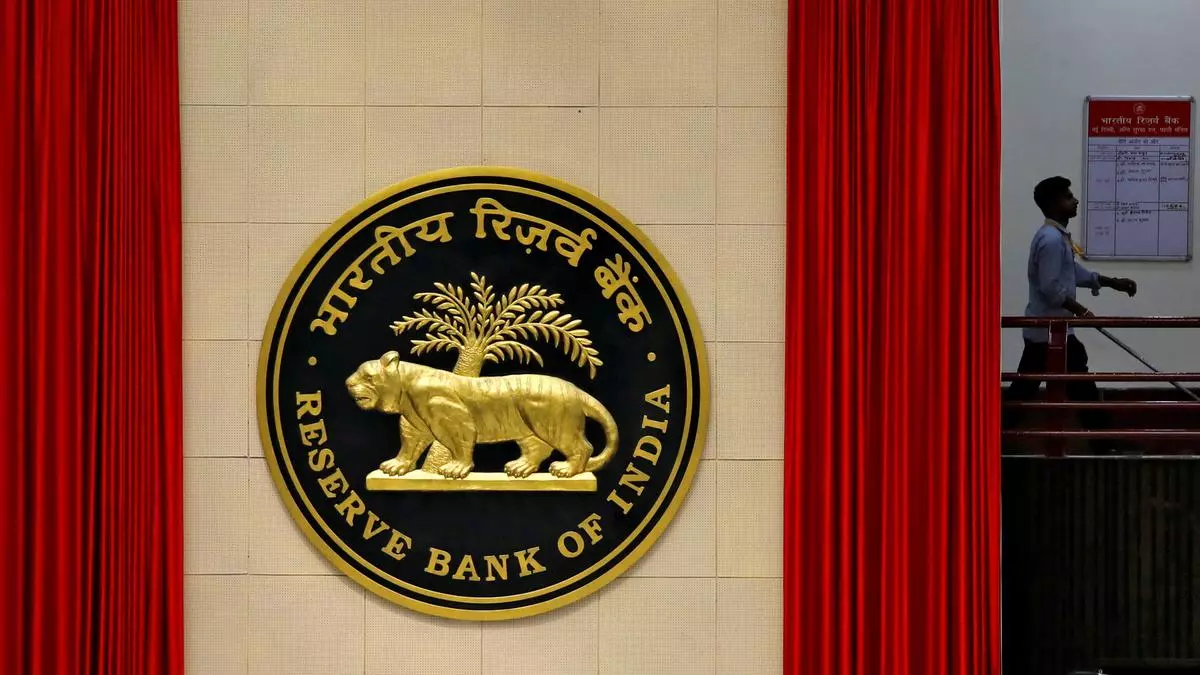
- 28 Dec 2023
Why is it in the News?
Indian banks continued to show improvement in their asset quality, with the gross non-performing asset (GNPA) ratio reaching a new decadal low as of September-end, according to a report by the Reserve Bank of India (RBI).
Key Points from the 'Trend and Progress of Banking in India' Report:
- The Gross Non-Performing Assets (GNPA) ratio of Scheduled Commercial Banks (SCBs) reached a decade-low of 3.9% by the end of March 2023, further declining to 3.2% by the end of September 2023.
- In the fiscal year 2022-23, approximately 45% of the reduction in Gross Non-Performing Assets (GNPAs) of SCBs was attributed to recoveries and upgrades.
- The consolidated balance sheet of banks witnessed a notable growth of 12.2% in 2022-23, marking the highest in 9 years.
- The share of Public Sector Banks (PSBs) in the consolidated balance sheet decreased from 58.6% in March 2022 to 57.6% in March 2023, while private banks saw an increase from 34% to 34.7%.
- As of March 2023, PSBs accounted for 61.4% of total deposits and 57.9% of total advances.
- With inflation persisting above the target, there is a possibility that monetary policy could remain in restrictive territory for an extended period.
- Acknowledging the growing interconnectedness between banks and Non-Banking Financial Companies (NBFCs), the report suggests that NBFCs diversify their funding sources and reduce reliance on bank funding.
- The central bank expresses concerns about banks lending to borrowers with influence, highlighting moral hazard issues that may compromise pricing and credit management.
- The Indian banking system is well-positioned for improvement, boasting better asset quality, high capital adequacy, and robust profitability.
- The financial indicators of NBFCs are anticipated to strengthen further, contributing to the overall resilience of the financial sector.
What are Non-Performing Assets (NPAs)?
- Non-performing assets (NPAs) refer to loans or advances in which the principal or interest payments have been overdue for a period exceeding 90 days.
- In the context of banks, loans are considered assets due to the significant income generated through interest payments.
- When borrowers, whether individuals or corporations, fail to meet their interest obligations, the asset turns 'non-performing' for the bank, as it ceases to contribute to the bank's earnings.
- As per the Reserve Bank of India (RBI) guidelines, banks must publicly disclose their NPAs and report them to the RBI regularly.
The classification of NPAs includes:
-
- Substandard assets: Loans that have been non-performing for up to 12 months.
- Doubtful assets: Assets that have remained in the substandard category for a period of 12 months.
- Loss assets: Assets deemed uncollectible, with little value, making their continuation as bankable assets unwarranted.
- NPA Provisioning involves setting aside a certain percentage of the loan amount as a provision.
- The standard rate of provisioning in Indian banks ranges from 5-20%, depending on the business sector and borrower's repayment capacity.
- In the case of NPAs, Basel-III norms require 100% provisioning.
Key metrics for understanding the NPA situation include Gross NPA (GNPA) and Net NPA (NNPA):
- GNPA: Represents the total value of gross NPAs for a bank in a specific quarter or financial year.
- NNPA: Obtained by subtracting the provisions made by the bank from the gross NPA, providing the precise value of NPAs after specific provisions.
- NPA Ratios express NPAs as a percentage of total advances, offering insights into the recoverability of total advances. For example:
- GNPA ratio: The ratio of total GNPA to total advances.
- NNPA ratio: Utilizes net NPA to determine the ratio to total advances, considering the specific provisions made by the bank.
Government and RBI Initiatives to Address NPAs:
To tackle the issue of Non-Performing Assets (NPAs), the Indian government has implemented a series of comprehensive measures in collaboration with the Reserve Bank of India (RBI).
- Establishment of a Bad Bank: National Asset Reconstruction Ltd (NARC), operates as an asset reconstruction company with the primary objective of purchasing distressed loans from banks, thereby alleviating them of the burden of NPAs.
- Once acquired, NARC endeavors to sell these problematic loans to distressed debt buyers.
- Additionally, the government has established the India Debt Resolution Company Ltd (IDRCL) to facilitate the sale of stressed assets in the market.
- Empowering Banks through the SARFAESI Act, 2002: The Securitization and Reconstruction of Financial Assets and Enforcement of Security Interest (SARFAESI) Act, enacted in 2002, empowers banks and financial institutions to take possession of collateral assets and execute their sale for the recovery of outstanding dues.
- Crucially, this process does not necessitate intervention from the court.
- The SARFAESI Act also provides provisions for enforcing security interests, allowing banks to issue demand notices to defaulting borrowers.
- Holistic Approach with the Insolvency and Bankruptcy Code (IBC), 2016: The Insolvency and Bankruptcy Code (IBC) establishes a comprehensive framework for the resolution of insolvency and bankruptcy in India.
- It is designed to expedite the resolution process for stressed assets, fostering a creditor-friendly environment.
- Under the IBC, both debtors and creditors have the authority to initiate insolvency proceedings against defaulting borrowers.
- The creation of the National Company Law Tribunal (NCLT) and the Insolvency and Bankruptcy Board of India (IBBI) ensures effective oversight of the resolution process.
Significance of NPA Recovery:
- The recovery of NPAs assumes paramount importance in safeguarding the interests of depositors and stakeholders.
- Emphasizing compromise settlements, the focus should be on achieving maximum dues recovery with minimal expenses and within an expedited timeframe.
- In the pursuit of compromise settlements, public sector banks are urged to prioritize the interests of the tax-paying public over the borrowers.
- This aligns with the broader goal of ensuring that resolutions serve the greater public good.
The Case for Caste Census in India (The Hindu)
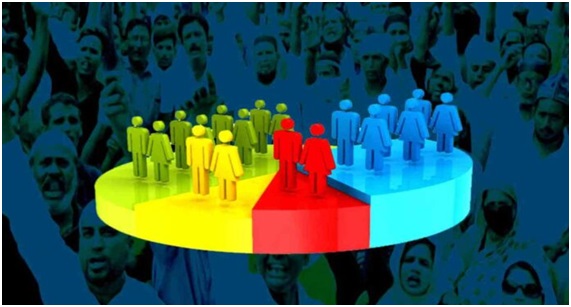
- 12 Oct 2023
Why is it in the News?
Recently, the Bihar government unveiled the outcomes of its caste survey within the state, revealing that the combined representation of Extremely Backward Classes (EBCs) and Other Backward Classes (OBCs) exceeds 63%.
Context:
- In a recent development, the Bihar government published the findings of its caste survey, indicating that the combined percentage of Extremely Backward Classes (EBCs) and Other Backward Classes (OBCs) surpasses 63%.
- This survey has sparked a nationwide discussion, emphasizing the need for a thorough examination of socio-economic data and a consideration of arguments both in support of and against a caste-based survey on a national scale.
What Does the Socio-Economic Data Reveal?
- Manifestation of Caste-Linked Deprivation in Indian Society: In rural areas during 2011-12, the average monthly per capita consumption expenditures (MPCE) for Scheduled Tribes (ST), Scheduled Castes (SC), and Other Backward Classes (OBC) households were 65%, 73%, and 84% respectively compared to the general category.
- Urban areas witnessed average MPCE for ST, SC, and OBC households at 68%, 63%, and 70% of the general category.
- Inequality Persists Across Caste Groups in Multidimensional Poverty Metrics:
- Multidimensional poverty estimates from the National Family Health Survey (NFHS-4/2015-16) highlight the enduring inequality across caste categories in India.
- Despite constituting around 73% of the population, STs, SCs, and OBCs collectively accounted for 84% of the country’s impoverished individuals.
- The OBC category alone comprised over 50% of India’s multidimensionally poor.
- According to the Oxford Poverty and Human Development Initiative (OPHI), the combined share of STs, SCs, and OBCs in the country's poor rose from 77.6% in 2005-06 to nearly 84% in 2015-16.
- The Sachar Committee report (2006) estimated that 31% of Muslims were categorized as 'Below the Poverty Line.'
- These findings underscore the evident causal relationship between caste-based discrimination and exclusion, particularly affecting STs, SCs, and OBCs, as well as religion (particularly Muslims), and the prevalence of poverty and deprivation.
Education and Employment Dynamics Across Caste Groups:
- Educational Disparities Based on Caste: Significant educational disparities exist, with the general category boasting a notably higher percentage of literate, secondary and high school graduates, as well as those with undergraduate and postgraduate degrees compared to OBCs, SCs, and STs.
- According to the NSS 75th round (2017-18), the proportion of graduates is 12% in the general category, while it stands at 3% for STs, 4% for SCs, and 6% for OBCs.
- Postgraduate representation is over 3% in the general category, approximately 1% among OBCs, and less than 1% for both SCs and STs.
- Employment Landscape: Analyzing employment status based on PLFS 2021-22 data reveals that over 30% of the general category workforce holds regular jobs, contrasting with around 20% for OBCs and SCs, and just over 12% for STs.
- Conversely, nearly 29% of STs, 38% of SCs, and 20% of OBCs work as casual labourers, compared to only 11.2% in the general category.
- The informal sector is predominantly occupied by STs, SCs, and OBCs, while the general category has a disproportionately large presence in formal employment.
- The Central government, a major formal sector employer with over 18.78 lakh employees as of January 2021, sees 52.7% belonging to the general category.
- Within the most qualified and highest-paid employee groups (Group A), the general category constitutes over 64%.
- These findings underscore that despite the Mandal Commission recommendations being officially implemented three decades ago, the persistent caste-based educational inequalities continue to replicate a similar pattern in skilled, formal employment.
Historical Overview of Caste-Based Surveys:
- During the Pre-Independence Era: The British colonial administration introduced caste-wise enumeration of the population in 1881, a practice that persisted until the 1931 census.
- Post-Independence Surveys: Following independence, successive Indian governments refrained from conducting comprehensive caste enumeration due to concerns that it might reinforce caste divisions and perpetuate the caste system.
- Despite the absence of a caste census, official surveys and statistics have revealed the persistent existence and growth of the caste system in independent India, along with its associated discriminatory and exclusionary consequences.
- The Mandal Commission Report: In 1980, the Backward Classes Commission, chaired by B.P. Mandal, submitted a pivotal report to the President of India.
- The report began with the dictum, "There is equality only among equals. To equate unequal is to perpetuate inequality."
- Drawing on caste/community-wise population figures from the 1931 census, the Mandal Commission estimated that the combined population of Hindu and non-Hindu Other Backward Classes (OBCs) constituted 52% of India's population.
- The commission crucially concluded that caste should be considered a class of citizens.
- If an entire caste is socially and educationally backwards, reservation can be implemented in its favour, justifying it as a socially and educationally backward class of citizens under Article 15(4) of the Constitution.
- This article empowers the state to make special provisions for the advancement of socially and educationally backward classes of citizens.
Reservation in Public Services and Indra Sawhney Judgment:
- In 1990, the V.P. Singh government introduced a 27% reservation for Other Backward Classes (OBCs) in public services.
- This decision faced legal scrutiny, leading to the landmark Indra Sawhney & others versus the Union of India judgment in 1992, where the Supreme Court validated the government's stance.
- The court made a noteworthy observation, stating that the identification of a group based on criteria other than caste, such as a combination of occupation, social status, education, and economic factors leading to caste, might not be deemed invalid.
- This crucial interpretation paved the way for the implementation of OBC reservations in both public employment and educational institutions across India.
Arguments Against a Nationwide Caste-Based Survey:
- Opposition to a comprehensive caste census has centred on the apprehension that unveiling the precise population proportions of Other Backward Classes (OBCs) at 52% or above could lead to calls for an expansion of the existing 27% reservation quota for OBCs.
- This concern gained traction with the initiation of demands following the enactment of the Constitutional (103rd Amendment) Act, 2019.
- This legislation introduced a 10% reservation for Economically Weaker Sections (EWS) within the general category, impacting admissions to both public and private educational institutions and civil posts and services.
- Despite facing legal challenges due to breaching the 50% reservation ceiling, the law was ultimately upheld by a majority judgment of the Supreme Court in 2022.
The Path Forward:
- Comprehensive Caste Enumeration: Given the significant variation in OBC population estimates from different official sample surveys—ranging from 41% to 46% between 2015-16 and 2021-22—only a thorough caste enumeration can provide an accurate assessment.
- More crucially, identifying the numbers and proportions of individual castes within the OBC category is essential for implementing effective reservations and other benefits.
- For instance, the Bihar caste survey revealed that 122 smaller caste groups within the Extremely Backward Classes (EBC) category constituted 36% of the state's population, marking the largest share among social categories.
- Build on Justice Rohini Commission Report: The Justice Rohini Commission, formed in 2017 to scrutinize the sub-categorization of OBCs in the Central list, presented its findings in 2023.
- A nationwide socio-economic caste census is imperative to formulate scientific criteria for such sub-categorization.
- This is equally crucial for all states with their individual State-level OBC lists due to the diverse caste compositions.
Conclusion
Caste remains a significant issue in Indian society, acknowledged by a broad spectrum of thinkers, ideologies, and political parties, all advocating for the eradication of the caste system and its inequalities. Given this apparent societal concern, a nationwide caste survey emerges as the initial step towards investigating and addressing the complexities associated with caste-related issues.
In a creative interpretation of Article 200, the Chief Justice of India’s recent judgment has also protected the entire constitutional system from the depredations of Governors (The Hindu)
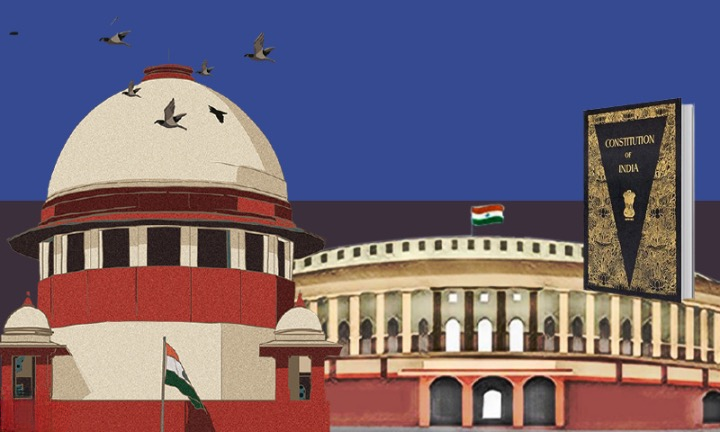
- 20 Dec 2023
Why is it in the News?
CJI Chandrachud creatively interprets Article 200 in a landmark ruling on the Governor's role in bill assent, State of Punjab vs Principal Secretary, November 10, 2023.
Context:
- On November 10, 2023, the Chief Justice of India (CJI) delivered a significant judgment in the case of State of Punjab vs Principal Secretary to the Governor of Punjab, offering an interpretation of Article 200 of the Indian Constitution.
- The focal point was the first provision of Article 200, addressing a Governor's choices when presented with a Bill for assent following its passage by the State Legislature.
Article 200 Of The Indian Constitution:
- Article 200 of the Indian Constitution delineates four possible actions for a Governor when a legislature-passed Bill is submitted for assent.
- These actions include:
- Give his assent
- Withhold his assent
- Return the bill for reconsideration
- Reserve the bill for the President’s consideration (In instances where the bill introduced in the state legislature endangers the position of the state High Court.)
- If the legislature reapproves the Bill with or wthout any amendment, the Governor must grant assent.
- Alternatively, the Governor may reserve the Bill for the President's consideration, and the President then decides whether to grant or withhold assent under Article 201.
- Notably, no specific timeframe is specified for the President's decision on the Bill.
Perspectives on the Discretionary and Absolute Nature of the Governor's Power:
- Most of the commentators of the Constitution, like D.D. Basu and others, have held the view that the Governor’s power to withhold assent under this Article has a finality about it, and once assent is withheld, the Bill dies a natural death.
- They were also of the view that the option of sending the Bill back to the Assembly for reconsideration under the first proviso is discretionary and not mandatory.
Interpretation of Article 200 Pronounced by the CJI:
- The recent interpretation of Article 200 by the Chief Justice of India (CJI) introduces a distinct viewpoint.
- Unlike the traditional understanding, the CJI associates the act of withholding assent with mandatory reconsideration.
- This interpretation challenges the presumption of the Governor's absolute authority to withhold assent.
- According to the CJI's judgment, the Governor's decision to withhold assent is coupled with the obligation to promptly return the Bill to the Assembly for an immediate reevaluation.
- In this context, the judgment asserts that, once the Governor chooses to withhold assent, the sole recourse is to send the Bill back to the Assembly for swift reconsideration, leaving the Governor with no alternative but to eventually grant assent.
- This nuanced interpretation aligns with the imperative of ensuring a deliberate and obligatory reconsideration process when the Governor opts to withhold assent to a legislative Bill.
The Importance of the CJI’s Interpretation:
- Preserving Legislative Rights: This ruling, coupled with the Chief Justice of India's approach, safeguards the legislature's authority in the law-making process, preventing potential misuse by appointed Governors and upholding the constitutional system.
- Evolution in Understanding Governor’s Powers: The CJI's interpretation signifies a progression in comprehending the Governor's powers, underlining the necessity for continual assessment and refinement of constitutional interpretations.
- Enhanced Clarity in Article 200: The Supreme Court of India has unequivocally stated that Governors cannot delay the decision on the Bills.
- Consequently, the top court's verdict has brought increased clarity to Article 200, compelling Governors to promptly decide on presented Bills.
Issues Still Regarding the Governor's Power:
- Reservation of Bills for President's Consideration: A potential area for exploitation by Governors remains in reserving Bills for the President's consideration, providing an absolute option.
- The critical query pertains to the types of Bills Governors can forward to the President, with the second provision of Article 200 specifying Bills that must mandatorily be reserved.
- These are Bills that deviate from the powers of the High Court, jeopardizing its constitutionally designated role.
- Lack of Categorization for Bills: The Constitution lacks a reference to specific categories of Bills for the President's consideration.
- Consequently, Governors may seemingly exercise discretion in sending any Bill to the President.
- Recent instances, such as in Kerala, where the Governor withheld action on eight Bills for over two years, or in Tamil Nadu, where Bills were sent to the President against the Constitution after reconsideration by the Assembly, highlight the absence of clear categorization.
- Ambiguities in Governor's Actions: The Constitution's ambiguity allows Governors to act in ways that may contradict its provisions, as seen in instances where Bills were sent to the President against the Constitution's mandate.
- Such actions place the fate of Bills in the hands of Union government officials, raising concerns about the potential misuse of gubernatorial discretion.
Evaluation of Constitutional Aspects Regarding Governor's Authority in Reserving Bills:
- Constitutional Framework: In the current political context, there arises a significant inquiry into a Governor's discretion in reserving Bills for the President's consideration, a matter not explicitly addressed in the Constitution.
- Implicit References: Two constitutional provisions indirectly touch upon this issue—Article 213 deals with ordinance-making powers and Article 254(2) concerning State laws in the Concurrent List.
- Article 213 empowers Governors to issue ordinances with presidential instructions when deeming it necessary to reserve a Bill's provisions.
- This implies a requirement for Governors to exercise judgment within the constitutional framework.
- The use of "deemed it necessary" suggests that Governors are expected to follow constitutional principles rather than acting arbitrarily in deciding to reserve Bills.
- Article 254(2) states that State laws on Concurrent List items prevail with presidential assent, even if conflict with existing central laws.
- It indicates that a Bill on a Concurrent subject requires presidential assent only if it contradicts central laws; it does not mandate sending every such Bill to the President.
- Presidential Jurisdiction and Governor's Duty on State Subjects: In the federal legislative structure, the President lacks authority to scrutinize and assent to Bills exclusively related to State subjects, underscoring the Governor's constitutional responsibility.
- Sending a Bill on State matters to the President might be viewed as an abdication of the Governor's constitutional duty, given that State List subjects are beyond the President's purview.
Conclusion
The absence of explicit provisions raises constitutional uncertainties concerning a Governor's discretionary authority in reserving Bills for the President. As constitutional interpretations evolve, there's a demand for clarity on the scope of a Governor's discretion in reserving Bills, aligning with federal principles and legislative autonomy. It's crucial to note that a Governor is not personally accountable for government actions, and the constitutional validity of a law falls within the court's jurisdiction, beyond the influence of the Governor or President.
Multidimensional Poverty Index reduction under the NDA is flawed (The Hindu)
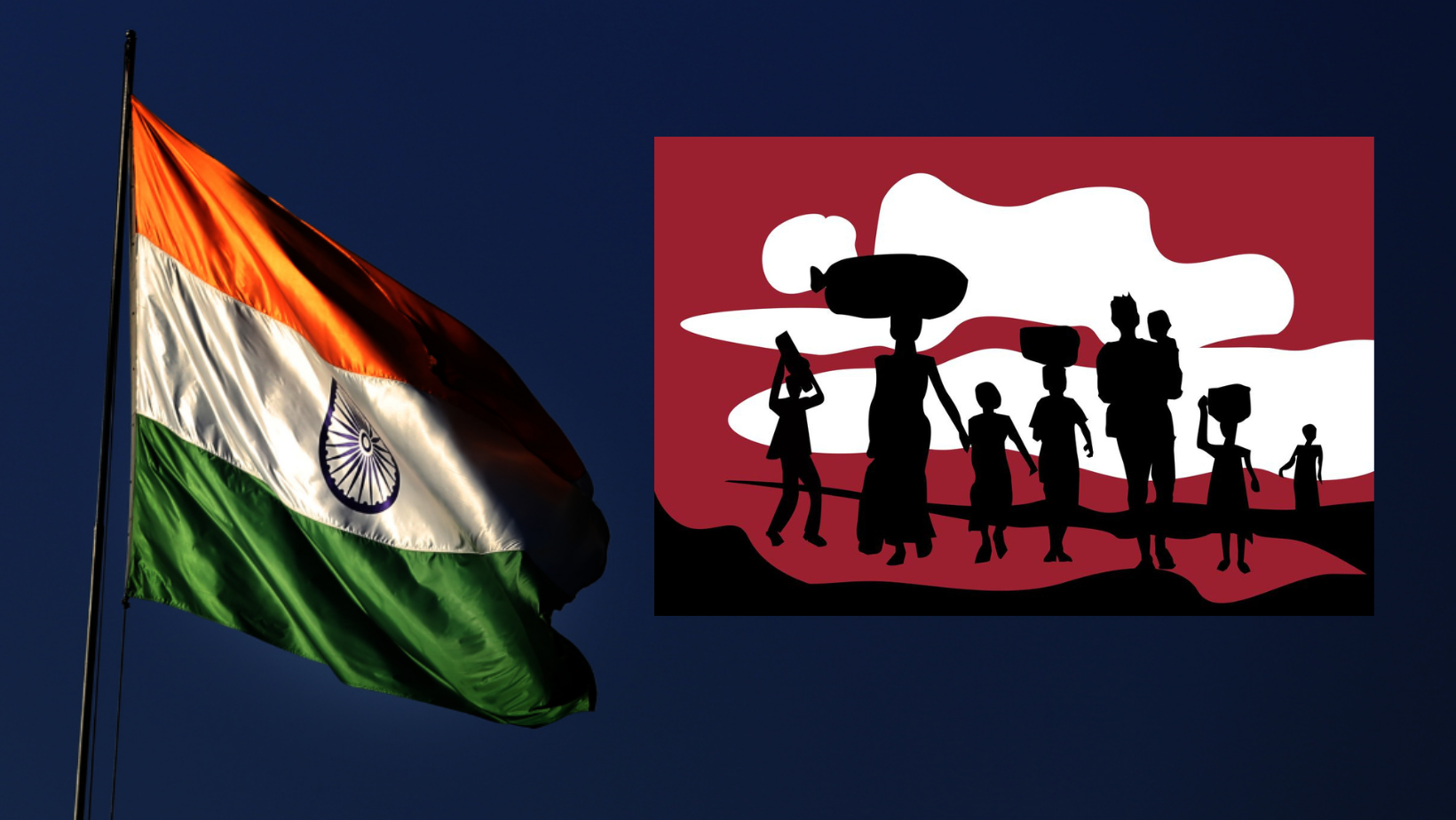
- 08 Dec 2023
Why is it in the News?
The Multidimensional Poverty Index exaggerates the National Democratic Alliance’s success in fighting deprivation.
Context:
- Some critics argue that the initiatives undertaken by the NDA Government might not have comprehensively tackled the various dimensions of poverty.
- Additionally, there are concerns that the reported successes may not be accurately reflected in the Multidimensional Poverty Index (MPI), raising questions about its alignment with the ground reality of deprivation.
- It is crucial to delve deeper into the methodologies and criteria employed for measuring multidimensional poverty to ascertain their resonance with the nuanced challenges confronted by the population.
- Nobel Laureate Amartya Sen introduced a comprehensive and innovative outlook on well-being, emphasizing capabilities and functionings, commonly referred to as the capability approach.
What is Amartya Sen's Capability Approach?
- Amartya Sen's Capability Approach serves as a normative framework for assessing individual well-being and societal arrangements.
- Rather than focusing on happiness, preferences, or resources, this approach directs attention to the genuine opportunities and freedoms available to individuals in realizing lives aligned with their values.
- Sen's Capability Approach comprises two central elements: functionings and capabilities.
- Functionings represent valuable states of being and doing that an individual can attain, such as good health, education, or social engagement.
- On the other hand, capabilities encompass the array of alternative functionings that individuals can choose from within their personal and social contexts.
- Illustratively, an individual's capability may extend to being either well-nourished or undernourished, contingent upon factors like access to food and dietary choices.
- Sen argues that the capability approach offers a superior means of evaluating human welfare compared to other approaches like utilitarianism and resourcism, which he deems either excessively narrow or insufficiently attuned to the diversity and intricacy of human experiences.
- Utilitarianism centres around choices leading to the greatest happiness or satisfaction of desires, while resourcism concerns the distribution of resources like income, wealth, or goods in society.
- According to Sen, the ultimate aim of development should be the expansion of people's capabilities, surpassing mere considerations of income or utilities.
- Amartya Sen's Capability Approach has notably influenced the development of the Human Development Index.
What is the Human Development Index (HDI)?
- HDI serves as a statistical tool employed to assess a country's overall achievements across its social and economic dimensions.
- It is published by the United Nations Development Programme (UNDP).
- It stands as the second most widely utilized indicator for gauging economic progress, following national income statistics (GDP).
- Components: HDI comprises three key components, namely:
- Health, quantified by life expectancy at birth;
- Education, determined by a combination of mean years of schooling and expected years of schooling; and
- Income, evaluated by gross national income per capita (at purchasing power parity).
- Calculation: The ultimate score is computed as a geometric mean of the aforementioned three categories.
What is the Multidimensional Poverty Index (MPI)?
- The Multidimensional Poverty Index (MPI) is an indicator of poverty that takes into account diverse aspects of well-being, extending beyond monetary considerations or income alone.
- Originating from collaborative efforts between the Oxford Poverty and Human Development Initiative (OPHI) and the United Nations Development Programme (UNDP), the MPI offers a holistic perspective on poverty by incorporating a range of factors contributing to deprivation.
- In assessing poverty, the MPI identifies individuals or households as multidimensionally poor when they experience deprivation across various indicators within different dimensions of well-being.
- These dimensions typically encompass health, education, and the standard of living. By considering a broad spectrum of factors, the MPI provides a nuanced and comprehensive understanding of poverty.
What is the Current Status of MPI?
- Regrettably, the United Nations Development Programme (UNDP) has chosen to adopt a capabilities-based approach to formulate a comprehensive measure of human development, applying uniform weights to the three primary components—health, education, and standard of living, along with their sub-indices.
- Under this methodology, both NITI Aayog and the UNDP recently released the National Multidimensional Poverty Index/MPI: A Progress Review 2023, mirrored in the UNDP Report titled "Making Our Future: New Directions for Human Development in Asia and the Pacific," unveiled on November 7, 2023.
- However, these reports share the same shortcomings as the UNDP human development index, primarily stemming from aggregation with uniform weighting.
- Notably, the narrative surrounding the MPI exacerbates these distortions.
- Surprisingly, the MPI 2023 estimates indicate a nearly halved value for India's national MPI and a decline from 24.85% to 14.96% between 2015-16 and 2019-21.
- This substantial reduction of 9.89 percentage points suggests that approximately 135.5 million people have transitioned out of poverty during this period.
- Furthermore, the intensity of poverty, gauging the average deprivation among individuals in multidimensional poverty, decreased from 47.14% to 44.39%.
Why the Reduction in MPI Numbers Under the Current Government is Flawed?
- Misleading and Inadequate Information: The MPI relies on data from the National Family Health Surveys (NFHS) 4 and 5, which are deemed insufficiently detailed for accurate estimation.
- NFHS 5 data is particularly questionable due to its suppression, driven by discrepancies in open defecation estimates conflicting with official claims of complete elimination.
- Ideally, combining NFHS 4 and 5 with the 75th Round of the National Sample Survey (NSS) on household consumption expenditure should have provided a more comprehensive perspective.
- However, this was abandoned as leaked poverty estimates indicated an increase.
- Compounding the skepticism is the profound impact of the COVID-19 pandemic in 2020-21.
- The widespread loss of livelihoods, reverse migration fatalities, and inadequate access to vaccines and medical care have created a substantial economic shock, hindering India's recovery.
- For instance, GDP growth has plummeted from 8% in 2015-16 to 3.78% in 2019-20, reaching -6.60% in 2020-21, along with a decline in per capita income.
- Greater Emphasis on Covariates: Comparing the elasticities of MPI with respect to various covariates reveals that the most significant reduction in MPI is attributed to higher State per capita income.
- However, due to a drastic income decrease, MPI has spiked.
- Urban location follows in importance, with a 1% increase resulting in a 0.90% MPI increase, reflecting the challenges associated with rural-urban migration and the growth of substandard living conditions.
- Both healthcare and education expenditure are associated with lower MPI, with education exhibiting a higher elasticity, implying that a 1% increase in education spending reduces MPI more than a comparable increase in healthcare spending.
- Reduction Between 2015 and 2019-21 is Considerably Lower than the Official Estimate:
- Some research suggests that the reduction between 2015 and 2019-21 is notably lower than the official estimate, standing at 4.7 percentage points compared to the reported 9.89 percentage points.
- A selective review of MPI estimates indicates a rise in poverty in Uttar Pradesh, India's most populous state, by over seven percentage points.
- Among states that went to elections in November (Chhattisgarh, Madhya Pradesh, Mizoram, Rajasthan, and Telangana), MPI fell in Chhattisgarh (by over six percentage points), in Rajasthan (by two percentage points), and significantly in Madhya Pradesh (by about eight percentage points).
What Steps Should Be Taken in order to Improve MPI?
- Adjustment for Income Variability: Given the substantial decrease in State per capita income causing a surge in MPI, consider implementing mechanisms to account for income fluctuations.
- This may involve incorporating smoothing techniques or introducing a lagged income variable to capture economic effects over time.
- Dynamic Impact of Urban-Rural Migration: Recognize the dynamic impact of factors on urban locations, particularly in light of the reverse migration during the COVID-19 pandemic.
- Develop models that reflect changing patterns of rural-urban migration and its influence on living conditions and MPI.
- Focus on Education Expenditure: Emphasize expenditure on education, as both healthcare and education spending are linked to lower MPI.
- Notably, the elasticity of education is higher, suggesting that a 1% increase in education reduces MPI more than a comparable increase in healthcare.
- Given the reported decline in state-level educational expenditure, a rise in MPI is likely.
- Mitigate the Impact of MPs with Criminal Cases: Recognize and address the correlation between the share of Members of Parliament with criminal cases and higher MPI.
- Explore strategies such as policy initiatives to curb corruption, enhance transparency, and address challenges posed by criminal elements within legislative bodies.
- Studies indicate that when the share of MPs with criminal cases exceeds 20%, the MPI tends to be higher.
- Sensitivity Analysis: Conduct sensitivity analyses to test the robustness of the MPI model.
- This involves varying key parameters to understand how changes in inputs impact results, providing insights into the stability and reliability of MPI calculations.
- Policy Recommendations: Utilize findings to inform policy recommendations targeting identified drivers of poverty.
- Advocate for policies promoting income stability, targeted investments in education and healthcare, and measures to combat corruption and criminality within legislative bodies.
Conclusion
Enhancing the Multidimensional Poverty Index (MPI) requires proactive measures. Addressing income variability, acknowledging dynamic urban-rural migration impacts, and prioritizing education expenditure is pivotal. Additionally, mitigating the influence of MPs with criminal cases and conducting sensitivity analyses for robustness are essential steps. Ultimately, informed policy recommendations should focus on promoting income stability, targeted investments in education and healthcare, and tackling corruption to advance holistic poverty reduction strategies.
That many of these unapproved or banned FDCs contain antibiotics is cause for concern given the growing antibacterial microbial resistance in India (The Hindu)

- 09 Dec 2023
Why is it in the News?
A group of academics from India, Qatar and the United Kingdom recently published a worrying new study in the Journal of Pharmaceutical Policy and Practice on the volume of unapproved and even banned fixed dose combinations (FDC) of antibiotics being sold in India.
News Summary:
- In the Journal of Pharmaceutical Policy and Practice, a group of academics from India, Qatar, and the United Kingdom recently released a concerning new study on the amount of antibiotics that are being sold in India that are not allowed or even prohibited as fixed dosage combinations (FDCs).
- The analysis, which makes use of pharmaceutical industry sales data, shows that in 2020, 60.5% of FDCs containing antibiotics (or 239 formulations) were unapproved, and another 9.9% containing 39 formulations were being distributed in the nation even though they were prohibited.
- The fact that antibiotics are present in so many of these illicit or prohibited FDCs is concerning given the rising incidence of antimicrobial microbial resistance (AMR) in India.
What are the Fixed Dose Combinations (FDCs) Drugs?
- FDCs are combinations of one or more known drugs and can be useful in treating some diseases since the combination can improve patient compliance.
- For instance, if a patient has to take three different medications for a particular treatment, she may forget to take one.
- But if all three medications are combined into one tablet or one syrup, the chance of her forgetting to take one or two of the drugs is reduced.
- For diseases such as AIDS, it is well documented that FDCs have proven to be very useful in improving patient compliance, which at the end of the day improves treatment outcomes.
Concerns with FDCs Drugs?
- Making FDCs is not an easy job, even though most consist of drugs with known safety and efficacy profiles.
- All drugs have side effects. When formulated together, there is a possibility that the active ingredient or excipients (inactive ingredients) may affect how each drug functions.
- For example, the drugs may interact in a way to reduce the therapeutic efficacy of each active ingredient, or, worse, the drugs may interact with each other to create a more toxic element, often called metabolites.
- This is why all FDCs must go through a scientifically designed approval process where such interactions can be evaluated.
Advantages of Fixed Dose Combinations:
- FDCs increase patient adherence, streamline treatment, and optimize the advantages of the combined therapeutic actions of the two medications.
- Treatment for infectious diseases: A significant portion of India's population is afflicted with infectious diseases.
- FDCs are very helpful in the treatment of infectious disorders when it is customary to administer numerous antimicrobial drugs, such as HIV, malaria, and tuberculosis.
- Additionally useful in chronic diseases, FDCs are especially beneficial when co-occurring disorders are common.
- Affordability and accessibility: FDCs have particular benefits over single entity preparations, including improved efficacy, a lower likelihood of side effects, potentially lower costs, and easier distribution logistics that are pertinent to resource-constrained scenarios like those in India.
Challenges Associated with Fixed-Dose Combinations (FDCs):
- Increased Risk of Side Effects: Combining multiple active ingredients in FDC drugs heightens the risk of adverse drug interactions and increases susceptibility to side effects.
- Patients may exhibit heightened sensitivity or allergic reactions to specific components, posing challenges in identification and management due to the fixed combination.
- For instance, a single FDC drug containing Paracetamol, Bromhexine, Phenylephrine, Chlorpheniramine, and Guaiphenesin may elevate the risk of side effects like drowsiness, dizziness, and increased blood pressure.
- Regulatory Challenges: Regulating FDC drugs prove challenging due to the complexities associated with evaluating the safety and efficacy of multiple active ingredients in a single formulation.
- Maintaining quality control and standardization for FDC drugs becomes more demanding compared to single-component medications.
- Overuse and Misuse: FDC drugs can contribute to the overuse and misuse of medications.
- Patients might unknowingly consume multiple active ingredients unnecessarily or in inappropriate combinations, leading to potential health risks.
- Lack of Evidence-based Clinical Data: Approval of some FDC drugs may be based on limited or insufficient clinical evidence supporting their efficacy and safety profiles.
- The absence of robust scientific data raises concerns about the appropriateness and reliability of FDC drugs for specific medical conditions.
Why are FDCs banned in India?
- Patients may not need that many drugs; thus, they are subjected to additional side effects.
- Some drug doses have to be individualized based on the patient's condition.
- This is not possible when using FDCs.
- Some companies have been selling FDCs in India under this pretext without consulting the central government, as seen with the cefixime-azithromycin combination, which has already been banned.
- These non-essential FDCs, therefore, do more harm than good by encouraging irrational and indiscriminate prescribing of multiple drugs than necessary.
Some Examples of (Banned Fixed-Dose Combination) Drugs in India:
- Fixed dose combination of Aceclofenac + Paracetamol + Rabeprazole
- Fixed dose combination of Nimesulide + Diclofenac
- Fixed dose combination of Nimesulide + Cetirizine + Caffeine
How is the Pharmaceutical Industry Exploiting Loopholes in India's Legal Framework?
- Pharmaceutical companies in India use these FDCs to escape liability under multiple laws without much concern for public health.
- One such law is the Drugs (Prices Control) Order (DPCO), under which the government fixes the prices of individual drugs.
- Since drug combinations were traditionally not covered under the DPCO, the pharmaceutical industry decided that making FDCs provided an easy way to escape the remit of the DPCO.
- Motivated solely by market-driven pragmatism rather than a commitment to public health, the Indian pharmaceutical industry introduced an extensive array of FDCs lacking any discernible medical rationale.
- For example, anti-inflammatory drugs were combined with vitamins, anti-histamines were combined with anti-diarrhoeal agents, penicillin was combined with sulphonamides, and vitamins were combined with analgesics.
- These were combinations not found in any other country.
The pharmaceutical industry benefited in two ways.
- Firstly, the wide range of FDCs in the market meant no standards were set by bodies like the Indian Pharmacopoeia Commission, shielding manufacturers from quality testing and potential legal consequences.
- Essentially, the pharmaceutical industry could dictate its testing standards when FDCs were sampled for government testing.
- Second, the FDC approach provides companies with a justification for higher drug prices. For instance, if multiple companies sell azithromycin individually, they must compete and lower prices.
- However, combining it with another drug in an FDC allows them to market it as a unique solution, justifying higher prices until competitors introduce similar products.
- This system rewards pseudo-innovation rather than true medical breakthroughs, allowing dubious FDCs to command elevated prices, supported by doctors who may presume regulatory oversight.
Is there any Regulatory Framework Addressing the Issue of FDCs?
- The FDC problem has been on the regulatory radar since 1978 when the first government committee studied the issue and admitted that we had a problem on our hands.
- At the time, there was no system under the colonial-era Drugs and Cosmetics Act, 1940 to vet drugs for safety and efficacy before their sale in India.
- This meant that each State drug controller could hand out manufacturing licences for any drug formulation and there was little that the central government could do to stop their sale.
- In 1982, Parliament changed the law to give the central government the power to “prohibit” the manufacture of specific drugs that lack therapeutic value or justification.
- Later in 1988, the central government amended the rules to introduce a new requirement for manufacturers of all “new drugs”, including FDCs, to submit proof of safety and efficacy to the Drugs Controller General of India (DCGI) who heads the Central Drugs Standard Control Organization (CDSCO).
- These amendments also made it clear that State drug controllers could not grant “manufacturing licences” for “new drugs” that are not approved for safety and efficacy by the DCGI.
Is Unabated Licensing Undermining FDC Regulation in India?
- Despite clear legal provisions, State drug controllers continue to overlook regulations, issuing manufacturing licenses for Fixed-Dose Combinations (FDCs) not approved by the DCGI with impunity.
- Manufacturers selling these unapproved FDCs technically expose themselves to prosecution by the Central government for violating the law.
- Rather than pursuing criminal prosecutions, the Ministry of Health is engaged in a reactive approach, frequently utilizing its powers under Section 26A to prohibit the manufacturing of specific FDCs.
- Since 1983, 444 orders have been issued under this provision, primarily targeting FDCs. Many of these orders have become entangled in intricate legal disputes, with inconsistent court decisions further complicating the regulatory landscape.
Conclusion
The fact that these academics have discovered 239 unapproved FDCs being sold in 2020 in just one category of FDCs more than 42 years after the problem was first flagged is an astonishing indictment of the incompetence of the drug regulatory framework in India. As they point out in their paper, unregulated FDCs may end up contributing to the AMR problem in India. The Ministry of Health needs to take immediate action.
Manipur's UNLF Signs Peace Pact with Govt. (The Hindu)
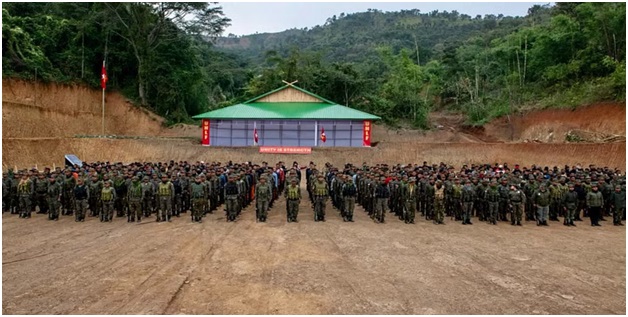
- 30 Nov 2023
Why is it in the News?
The Union and Manipur governments have signed a peace agreement with the United National Liberation Front (UNLF), a banned Meitei extremist organisation which is also the oldest armed group based in the Manipur valley, Union Home Minister Amit Shah said on Wednesday.
News Summary:
- Manipur's oldest valley-based armed group UNLF that has been fighting for a sovereign land following the post-independence merger of the erstwhile kingdom with India has now signed a tripartite peace deal with Centre and the Manipur Govt.
- It is a significant step towards lasting peace in Manipur, which shares a long border with junta-ruled Myanmar and serves as India's main surface transport gateway to Southeast Asia, thus playing a key role in national security.
- The Centre in the announcement of the peace agreement described the UNLF as a "valley-based" armed group to indicate its origins in the state capital Imphal Valley and other districts not classified as hill areas.
- Similarly, at least 25 hill-based insurgent groups are already under a tripartite peace deal called the suspension of operations (SoO) agreement.
Key Highlights of the Peace Deal:
- While the details of the deal haven't been disclosed publicly, experts indicate that the current agreement predominantly revolves around the suspension of operations (SoO).
- This means that both the UNLF and security forces will refrain from engaging in operations against each other.
- In the upcoming stages, specific areas will be designated to establish camps for UNLF within the valley.
- In these camps, UNLF members will reside alongside their arms and ammunition, all supervised by the Manipur government and armed forces.
- The discussions for a comprehensive peace accord between the government and UNLF will persist, with the focus on advancing after the successful implementation of the SoO arrangements.
What is the United National Liberation Front (UNLF)?
- Formation: The UNLF was formed in November 1964 by Khalanlang Kamei as president, Thangkhopao Singsit as vice president, and A Somarendro Singh as general secretary.
- It set up its armed wing the Manipur Peoples' Army (MPA) in February 1990.
- Objectives: The UNLF favoured a long-term program to secede from India under the leadership of Arembam Samarendra Singh, form an alliance mainly with China and gradually capture political power with the help of an indoctrinated young population and the intelligentsia.
- It aimed at reclaiming the Kabow Valley in Myanmar.
- Personnel And Weapons: The UNLF split into two factions due to internal differences.
- Jointly, the two factions are estimated to have 400-500 personnel with over 500 weapons of mixed types.
- Links With Other Valley-Based Armed Groups: The UNLF was a constituent of the Coordination Committee, known as CorCom, which is an umbrella body of earlier six and currently four groups - RPF/PLA, PREPAK, and PREPAK/PRO.
- The UNLF is an "unlawful association" under the Unlawful Activities (Prevention) Act.
- The UNLF had been carrying out its activities, including violence and propaganda jointly in consultation with the other constituents of CorCom.
- The close association of these constituents was one of the reasons for valley-based armed groups not responding to offers of coming overground and joining the mainstream.
- Areas Of Operation: All valley districts of Manipur - Imphal East, Imphal West, Thoubal, Bishnupur, Jiribam, and Kakching, and some Kuki and Vapiphei-dominated villages in the hill districts of Manipur.
- The UNLF's camps, training centers, hideouts, and safehouses are in the Sagaing region of Chin State and Rakhine State in Myanmar.
- The UNLF had been able to operate freely within Myanmar allegedly due to its close links with officials of the Myanmar military.
- Linkages and Front Organisations: The UNLF, being the oldest valley-based armed group, had wielded a significant influence on public issues.
- Most of the impact was through the front organisations that it used to mobilise public protests on key matters.
- Return To Mainstream: The senior leaders of the UNLF responded favourably to the Centre's offer to join the mainstream for the first time in 2020.
- More than 400 personnel with an equal number of weapons joined the peace process, which will have a significant impact on the security scenario of Manipur and the northeast region.
Insurgency in Manipur:
- Manipur is currently experiencing an armed conflict between India and various separatist rebel groups.
- This insurgency is a part of the broader Insurgency in Northeast India, encompassing aspects of both a national liberation war and an ethnic conflict.
- Historical Background of Manipur: Post the brief Anglo-Manipur War of 1891, the Kingdom of Manipur came under British rule and became a British protectorate.
- In October 1949, Manipur joined India and achieved separate statehood in 1972.
- Rise of Insurgency: Manipur's integration into India led to the emergence of several insurgent organizations advocating for an independent state within Manipur's borders, rejecting the merger with India as involuntary.
- The insurgency issue arose in the late 1960s and 1970s, contrasting with the peaceful merger period.
- The United National Liberation Front (UNLF), the first separatist faction, was established in November 1964.
- Currently, the region faces challenges from multiple insurgent groups.
What are the Factors Behind the Rise of Insurgency in Manipur?
- Forced Merger with India: The roots of separatist insurgency in Manipur can be traced to perceived discontent arising from the alleged "forced" merger of Manipur with the Union of India.
- The delay in granting full-fledged statehood further fueled dissatisfaction.
- Despite merging in 1949, Manipur attained statehood only in 1972.
- Rise of Militancy: Subsequent years witnessed the formation of various militant groups, including the People’s Liberation Army (PLA), People’s Revolutionary Party of Kangleipak (PREPAK), Kangleipak Communist Party (KCP), and Kanglei Yawol Kanna Lup (KYKL). These valley-based outfits advocate for an independent Manipur.
- Ethnic Conflict: Despite the hills comprising nine-tenths of Manipur's geographical area, they are sparsely populated.
- The majority of the state's population resides in the valley, with the Meitei community dominating.
- While the surrounding hill districts are inhabited by Nagas and Kukis.
- Ethnic clashes between Nagas and Kukis in the early 1990s led to the formation of several Kuki insurgent groups.
- Over time, their demand shifted from a separate Kuki state to a Territorial Council.
- This conflict's continuation gave rise to smaller outfits like the Zeliangrong United Front (ZUF), People’s United Liberation Front (PULF), and other splinter groups.
- Greater Nagalim Demand: The Nagalim or Greater Nagaland demand encompasses Naga-inhabited areas of Manipur, while the Meitis strive to preserve the historical integrity of a single geographic entity that has endured for centuries.
- Insufficient Socio-Economic Progress: Due to its challenging topography, the state has faced persistent challenges in achieving economic development and socio-economic transformation.
- Throughout the years, persistent corruption, fund mismanagement, and the neglect to empower the general populace have contributed to a growing sense of discontent.
What are the Steps Taken by the Government?
Military Measures:
- AFSPA Implementation: In 1980, the entire Manipur was declared a "disturbed area," prompting the imposition of the contentious Armed Forces Special Powers Act (AFSPA).
- This act, aimed at suppressing insurgency, remains in effect to date.
- Operation All Clear: The Assam Rifles and the army executed "Operation All Clear" in the hill areas, neutralizing many militant hideouts.
- However, some relocated to the valley.
Ceasefire Arrangements:
- In 1997, the National Socialist Council of Nagaland-IM (Isak-Muivah) initiated a ceasefire agreement with the Government of India, and ongoing peace talks persisted.
- Kuki Outfits: Under the Kuki National Organisation (KNO) and United People’s Front (UPF), Kuki outfits signed tripartite Suspension of Operation (SoO) pacts with the Governments of India and Manipur on August 22, 2008.
- Some smaller outfits have entered SoO agreements with the state government, leading to rehabilitation programs.
- Valley-Based Militant Outfits: Significant valley-based militant groups like UNLF, PLA, and KYKL, among others, have not yet participated in negotiations with the government.
What is the Current Situation?
- One faction of the UNLF, led by Koireng, remains resistant to engaging in talks.
- Withdrawal from Suspension of Operations (SoO): In 2008, a tripartite Suspension of Operations (SoO) agreement involving the Centre, Manipur state, and Kuki-Zomi insurgent groups was established.
- The primary goal was to facilitate political dialogue. However, in March 2023, the Manipur government withdrew from the agreement with the Zomi Revolutionary Army and the Kuki National Army.
- The decision was attributed to their alleged influence in fostering agitation among forest encroachers.
Way Forward
- Effective Border Management: Prior to implementing any counter-insurgency policies or operations, proper management of the Indo-Myanmar international border is imperative.
- Promoting Economic Development: Following good governance, economic development should be pursued through participation from government, semi-government, and private entrepreneurship.
- Establishing Good Governance: Instituting good governance in the state necessitates a transparent government, a fair judiciary system, adherence to the rule of law, and ensuring basic amenities like hospitals, schools, and police stations.
- Political sincerity and equitable fund distribution for both valley and hill development are crucial.
- Community Engagement: Enhancing connectivity and interaction among Manipur's diverse communities and mainland India is vital for fostering national integration.
- Utilizing Non-Governmental Organizations (NGOs), women's associations and cultural programs can play a significant role in rebuilding confidence among the valley and hill populations.
India and Japan Converge in Southeast Asia (The Hindu)
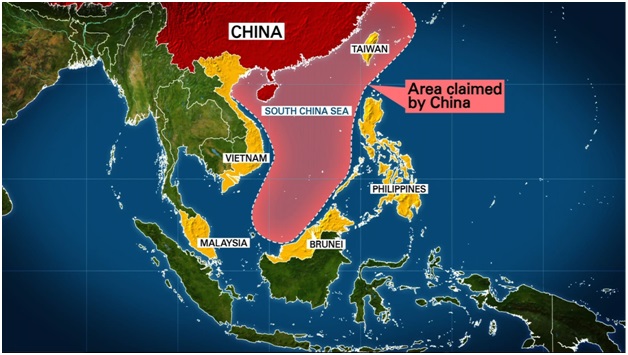
- 23 Nov 2023
Why is it in the News?
The Philippines is now exploring Japan and India as alternative partners for development and security cooperation.
Concerns between the China and Philippines:
- The relationship between the Philippines and China has been strained for decades due to long-standing territorial disputes in the South China Sea.
- The Philippines claims sovereignty over several islands and reefs in the South China Sea, while China maintains a sweeping claim over the entire area, known as the "nine-dash line."
- These competing claims have led to numerous incidents of Chinese vessels blocking or harassing Philippine fishing boats and military vessels.
- In 2012, the Philippines filed an arbitration case against China under the United Nations Convention on the Law of the Sea (UNCLOS) challenging the legality of China's nine-dash line claim.
- In 2016, the Permanent Court of Arbitration ruled in favor of the Philippines, finding that China's nine-dash line claim had no legal basis.
- However, China has refused to accept the ruling.
- The South China Sea is a strategically important waterway, with an estimated $3.3 trillion in trade passing through it annually.
- It is also believed to be rich in natural resources, including oil and gas.
- The ongoing territorial disputes have raised tensions in the region and have the potential to escalate into conflict.
- In addition to the territorial disputes, there have been other issues that have strained relations between the Philippines and China including China's militarization of the South China Sea, its fishing practices in Philippine waters, and its human rights record.
Bilateral Relations Between India and the Philippines:
India and the Philippines have enjoyed a warm and cordial relationship since establishing diplomatic ties in 1949, shortly after both countries gained independence. The relationship is rooted in shared values of democracy, pluralism, and the rule of law, as well as a growing economic partnership.
Political and Strategic Cooperation:
- India and the Philippines have maintained regular high-level visits and engagements, fostering a strong political and strategic partnership.
- The two countries have cooperated on a range of issues, including maritime security, counterterrorism, and defense.
- Intensification of relations with the Philippines resulted from India’s Look East Policy (1992) and further diversified with the Act East Policy (2014).
Economic Partnership:
- India and the Philippines have a growing economic partnership, with bilateral trade reaching over $3 billion in 2022.
- India is currently the Philippines' fifteenth-largest trading partner.
- The two countries have signed several agreements to enhance economic cooperation, including the Comprehensive Economic Partnership Agreement (CEPA), which is expected to further boost trade and investment.
Cultural and People-to-People Exchanges:
- Both countries have active diaspora communities that contribute to cultural exchange and people-to-people linkages.
- India and the Philippines have signed agreements on cultural cooperation and education exchange.
Recent Developments:
- In recent years, India and the Philippines have elevated their relationship to a "Strategic Partnership."
- This reflects the growing convergence of their interests in the Indo-Pacific region and their commitment to promote a rules-based international order.
Key Areas of Cooperation:
- Maritime Security: India and the Philippines have a shared interest in maintaining peace and stability in the maritime domain.
- The two countries have conducted joint naval exercises and collaborated on maritime surveillance and information sharing.
- Counterterrorism: India and the Philippines have pledged to cooperate in combating terrorism and preventing the spread of violent extremism.
- They have shared intelligence and expertise in counterterrorism operations and training.
- Defense Cooperation: Key developments include the BrahMos missile deal, the establishment of a resident Defense Attache office in Manila, and the consideration of India's proposal for a concessional Line of Credit to fulfill the defense needs of the Philippines.
- Additionally, collaboration extends to maritime domain awareness (MDA), joint patrols, and the exchange of information.
- The two countries have also conducted joint military exercises to enhance interoperability and strengthen defense ties.
Japan and India's Involvement in Southeast Asia:
- Free and Open Indo-Pacific: A joint effort to counter China's growing assertiveness in the Indo-Pacific region.
- Free and Open Indo-Pacific is an umbrella term that encompasses Indo-Pacific-specific strategies of countries with similar interests in the region.
- Japan's Free and Open Indo-Pacific aligns with India's Indo-Pacific Oceans Initiative.
- Partnership with ASEAN: Strengthening economic, political, and cultural ties with ASEAN member nations.
- Infrastructure Development: Japan's Partnership for Quality Infrastructure involvement in Southeast Asian projects (ports, roads, and energy facilities).
- India also expresses interest in regional infrastructure projects.
- Connectivity Projects: Both nations actively promote connectivity, with India contributing through projects like the Trilateral Highway (connecting India, Myanmar, and Thailand).
- Economic Assistance: Providing economic assistance and development aid to support socio-economic growth in Southeast Asia.
- Assistance includes financial support, capacity building, and technology transfer.
- Security Cooperation: Engaging in security dialogues and joint military exercises with Southeast Asian countries.
- Collaborating on common security challenges such as maritime security and counter-terrorism.
- Human Resource Development: Joint efforts in human resource development programs, including scholarships and training opportunities.
- Aimed at enhancing skills and knowledge across various sectors.
- Regional Forums: Active participation in regional forums like the East Asia Summit (EAS) and ASEAN Regional Forum (ARF).
- Addressing regional challenges and fostering dialogue on a variety of issues.
India-Japan Relations:
The roots of the relationship trace back to ancient times when Buddhism was introduced to Japan in the 6th century. A robust partnership emerged from India's Look East Policy, evolving into a 'Special Strategic and Global Partnership' in 2014.
- Economic Cooperation: Strong trade and investment ties with significant bilateral investments.
- Initiatives like Delhi Mumbai Industrial Corridor (DMIC) and Neemrana Industrial Park for Japanese firms.
- Collaboration in the automobile sector, exemplified by Maruti Suzuki.
- Infrastructure Investment: Japan International Cooperation Agency (JICA) plays a pivotal role in investing in India's infrastructure projects.
- Contributions range from the Delhi Metro to water and sanitation projects.
- Strategic Cooperation: Shared commitment to a free, open, and inclusive Indo-Pacific.
- Highlighted in Japan's National Security Strategy (NSS-2022) and 2021 Acquisition and Cross-Servicing Agreement (ACSA).
- Defence Collaboration: Steadily growing cooperation in response to regional security challenges.
- Initiatives like the 2015 Agreements on the transfer of defence Equipment and Technology..
- In terms of security, India and Japan constantly engage in varied platforms ranging from regular bilateral military exercises and two-plus-two meetings to multilateral frameworks such as the Quad and the G20.
- Technology Partnership: Collaboration on cutting-edge technologies like robotics, artificial intelligence, and renewable energy.
- Examples include the India-Japan Digital Partnership (I-JDP) and cooperation in nuclear technology.
- Regional and Global Cooperation: Active collaboration on climate change, counterterrorism, and United Nations reforms.
- Joint development of the Asia-Africa Growth Corridor for economic collaboration and capacity-building in African countries.
- Cultural and People-to-People Ties: Promotion of tourism, educational exchanges, and scholarships.
- Initiatives like the Japan Exchange and Teaching (JET) Programme and the India-Japan Global Partnership Summit foster personal bonds between citizens.
Accordingly, as India is significantly deepening and broadening its ties with Southeast Asian countries, such as the Philippines, India should consider taking its third-country developmental model with Japan into the sub-region of the greater Indo-Pacific at a time when resident countries are looking for alternative sources of development and security amidst the polarising dynamics of the U.S.-China power competition.
OECD Report About Climate Finance (The Hindu)
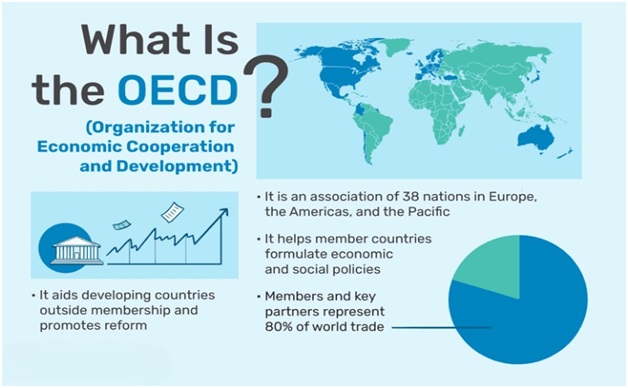
- 22 Nov 2023
Why is it in the News?
A new report, published by the Organisation for Economic Cooperation and Development (OECD), showed that economically developed countries fell short of their promise to jointly mobilise $100 billion a year, towards the climate mitigation and adaptation needs of developing countries, in 2021 – one year past the 2020 deadline.
What is the Organisation for Economic Cooperation and Development (OECD)?
- The Organization for Economic Cooperation and Development (OECD) is an association of 38 nations in Europe, the Americas, and the Pacific.
- Its members and key partners represent 80% of world trade and investment.
- The goal of the OECD is to promote the economic welfare of its members.
- It also coordinates its efforts to aid developing countries outside of its membership.
- As a result, its programs help promote reform in more than 100 countries worldwide.
- The OECD's main headquarters is located in Paris (France)
- The OECD collects, analyzes, and reports on economic growth data for its members.
- This gives them the knowledge to further their prosperity and fight poverty. It also balances the impact of economic growth on the environment.
- Committees within the OECD analyze the data and make policy recommendations.
- It's up to each member country to decide how to use OECD recommendations.
- The OECD publishes mainly two reports:
- International Migration Outlook
- Programme for International Student Assessment
Key Findings of the OECD Report Ahead of COP 28:
- The OECD has released a report titled 'Climate Finance Provided and Mobilised by Developed Countries in 2013-2021.'
- This comprehensive report highlights the collective patterns in annual climate finance contributed and mobilized by developed nations for developing countries during the period from 2013 to 2021.
- In-depth analyses are presented, offering insights into climate themes, sectors, financial instruments, and regional distributions specifically for the years 2016 to 2021.
- Additionally, the report offers essential recommendations for international providers to enhance financial support for adaptation efforts and to more efficiently engage private finance in climate action.
Major Takeaways from the Report Published by OECD:
- Failure to Meet Commitments: The report revealed that the economically developed countries had failed to meet their commitment to together raise $100 billion annually by 2021, one year after the 2020 deadline, to help developing nations with their climate adaptation and mitigation needs.
- According to the report, affluent nations raised $89.6 billion in 2021, however, the amount of money allocated for adaptation decreased by 14% from 2020 to 2021.
- The ability of developing nations to meet their needs for climate adaptation and mitigation is lowered when sufficient climate funding is not raised.
- It also weakens confidence in the industrialized world's sincerity in addressing the climate catastrophe among the world's poorer nations.
- Loan-Centric Climate Finance: According to the OECD study, $49.6 billion in loans were given out of the $73.1 billion that the public sector raised in 2021 through bilateral and multilateral channels.
- It illuminates the degree to which wealthy nations must rely on loans at market rates in order to meet their climate finance commitments.
- For instance, a research team's evaluation of the worldwide flows of climate finance from 2011 to 2020 revealed that 61% of the funding came from loans.
Issue With 'Additionality'
- Another issue in the OECD report pertains to additionality.
- The UNFCCC states that developed countries “shall provide new and additional financial resources to meet the agreed full costs incurred by developing country Parties in complying with their obligations under the convention”.
- This means developed countries can’t cut overseas development assistance (ODA) in order to finance climate needs because that would effectively rob Peter to pay Paul.
- In the real world, it could cut off support for healthcare in order to reallocate that money to, say, install solar panels.
- The “new and additional finance” also means developed countries can’t double-count.
- For example, a renewable energy project could contribute to both emission reductions and overall development in a region.
- As per the U.N. Convention, however, donor countries can’t categorise such funding as both ODA and climate finance because it wouldn’t fulfill the “new and additional” criterion.
- A few years ago, European Union officials admitted to double-counting development aid as climate finance.
What Counts as Climate Finance?
- At present, there is no commonly agreed definition of ‘climate finance’ because developed countries have endeavored repeatedly to keep it vague.
- For example, at the COP 27 in Egypt last year, Australia and the U.K. even sought to end discussions to define ‘climate finance’.
- In the run-up to the COP 26 in Glasgow, the U.S. led an effort to block debate on a common definition, alongside Switzerland, Sweden, and some other developed countries.
- The lack of definitional clarity has reportedly led to strange situations like funding for chocolate and gelato stores in Asia and a coastal hotel expansion in Haiti being tagged as climate finance.
- The ambiguity works in favour of richer countries because it leaves the door open to arbitrarily classify any funding, including ODA and high-cost loans, as climate finance and escape the scrutiny that a clearer definition might bring.
- So while developed countries can claim they have provided billions in climate finance, the actual flows need to be checked for whether they actually went into climate mitigation and adaptation in developing countries or something else.
How much do developing countries need?
- According to the OECD assessment, climate investments for developing nations are expected to reach approximately $1 trillion year by 2025 and $2.4 trillion annually between 2026 and 2030.
- In contrast, the $100 billion objective is insufficient and even more so given that it has not yet been reached.
What role can the private sector play?
- To meet the scale of the challenge, people like the U.S. climate envoy John Kerry and World Bank president Ajay Banga have routinely emphasised the role the private sector could play.
- But the OECD report shows that private financing for climate action has stagnated for a decade.
- The problem is particularly worse for climate adaptation because investment in this sector can’t generate the sort of high returns that private investors seek.
- There also haven’t yet been signs that the private sector is interested in massively scaling up its climate investments.
What is Climate Change?
- Climate change is the result of long-term shifts in temperatures and weather patterns.
- Natural variations, like those influenced by changes in the solar cycle, can contribute to these shifts.
- However, since the 1800s, human activities, particularly the burning of fossil fuels such as coal, oil, and gas, have emerged as the primary driver of climate change.
- The combustion of fossil fuels produces greenhouse gas emissions, creating a metaphorical blanket around the Earth.
- This 'blanket' traps the sun's heat, leading to an increase in temperatures.
- The rising temperatures, a consequence of climate change, accelerate the melting of ice.
- This, in turn, contributes to elevated sea levels, resulting in flooding and erosion.
Sub-categorisation Within Castes (The Hindu)
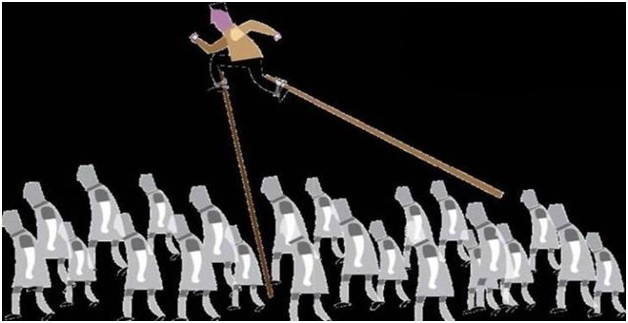
- 17 Nov 2023
Why is it in the News?
In an election rally in Telangana, Prime Minister Narendra Modi promised to look into the sub-categorisation of Scheduled Castes (SCs) to identify and help the most backward among them.
Context:
- During an election rally in Telangana, Prime Minister Narendra Modi pledged to examine the sub-categorization of Scheduled Castes (SCs) to identify and support the most backward among them.
- This move is perceived as the Bharatiya Janata Party (BJP) aiming to attract the Madiga community.
- The Madigas, the largest among all SC communities in the State, have asserted that another SC community, the Malas, is occupying their rightful share of representation.
Is Sub-categorisation within Castes legal?
- Historical Context: The issue arose in 1996 when the Andhra Pradesh government formed a one-man Commission under Justice Ramachandra Raju.
- The Commission recommended sub-categorization of SCs in the state based on evidence of varying backwardness and representation among communities.
- The attempt to implement this recommendation led to legal challenges, reaching the Supreme Court in 2004.
- The Supreme Court then ruled that states lack the power to unilaterally sub-categorize communities in the SCs or Scheduled Tribes (STs) list.
- Legality of Sub-categorization: Over the past two decades, states like Punjab, Bihar, and Tamil Nadu have attempted to enact reservation laws at the state level for sub-categorizing SCs.
- Legal proceedings have ensued, with the Supreme Court establishing a larger Constitution Bench to make a decision on the matter.
- Contradictory Judgments: In a 2020 judgment, a five-judge Bench, led by Justice Arun Mishra, stated that deciding on the benefits in the SCs/STs lists would not be considered "tinkering," and states could proceed.
- This contradicts the 2004 Supreme Court ruling and has led to the 2020 judgment being referred to a larger Bench for clarification.
What is the Union Government’s Stand?
- The Union government established a National Commission to investigate the sub-categorization of Scheduled Castes (SCs) in Andhra Pradesh.
- The Cabinet at that time proposed an amendment to Article 341 of the Constitution of India to facilitate sub-categorization.
- Both the National Commission for Scheduled Castes (NCSC) and the National Commission for Scheduled Tribes (NCST) expressed the view that a constitutional amendment was unnecessary.
- They pointed out that Article 16(4) of the Constitution already empowered states to formulate special laws for any backward classes they deemed under-represented.
Arguments in favour of Sub-Categorization within SCs:
- From the Justice Raju Commission to the National Commission, the principal argument for sub-categorisation of SCs has been the graded inequalities among SC communities.
- The Justice Raju Commission was formed by the Andhra Pradesh state government in 1996 to look into the matter.
- The thrust of it has been that even among the marginalised, there are communities that have lesser access to basic facilities.
- As a result, the relatively more forward communities among them have managed to avail benefits consistently while crowding the more backward ones out.
- The solution, therefore is to sub-categorise the communities and provide separate reservations to the more backward communities within the reservation meant for SCs.
Arguments Against Sub-Categorisation within SCs:
- Both the SC and ST Commissions have noted that allotting separate reservations within the categories would not really address the root cause of the problem.
- In an internal note prepared by the NCST, it explained that the most backward SCs are lagging so far behind forward SC communities that a separate quota would not help.
- It said that the idea was to ensure representation at all levels.
- But given the disparity, even if posts were reserved at higher levels, these most backward SCs would not have enough candidates to be considered for it in the first place.
- Both the NCSC and the NCST had thus recommended that existing schemes and government benefits should first reach these sections before any sub-categorisation.
Legal experts emphasize the crucial need for substantial data to substantiate the sub-categorization initiative. But what is primarily needed is concrete population numbers of each community and sub-community and their respective socio-economic data, which are the only thing that can provide a reasonable ground to decide how castes can be categorised, how much percentage should be given, etc.
National Commission for Scheduled Castes:
- The National Commission for Scheduled Castes is a constitutional body established with a view to providing safeguards against the exploitation of Scheduled Castes and Anglo-Indian communities to promote and protect their social, educational, economic, and cultural interests, special provisions were made in the Constitution.
- Article 338 of the Indian constitution deals with National Commission for Scheduled Castes.
- Historical Evolution:
- Initially, Article 338 of the Constitution provided for the appointment of a Special Officer, known as the Commissioner for Scheduled Castes and Scheduled Tribes.
- 65th Amendment Act, 1990 replaced the single-member system with the establishment of a multi-member National Commission for Scheduled Castes (SC) and Scheduled Tribes (ST).
- The 89th Amendment Act, 2003 resulted in the creation of two separate commissions in 2004:
- National Commission for Scheduled Castes (NCSC)
- National Commission for Scheduled Tribes (NCST)
Composition:
- The NCSC comprises a Chairperson, a Vice-Chairperson, and three additional Members, appointed by the President through a warrant under his hand and seal.
- The President of India also determines their conditions of service and tenure of office.
Functions:
- The NCSC is entrusted with several key responsibilities, including:
- Investigating and monitoring matters related to constitutional and legal safeguards for the SCs.
- Inquiring into specific complaints regarding the deprivation of rights and safeguards of the SCs.
- Participating in and advising on the planning process for the socioeconomic development of the SCs.
- Evaluating the progress of SC development under the Union or a state.
- Presenting annual reports to the President on the functioning of these safeguards.
- Making recommendations for effective implementation of safeguards and other measures for the protection, welfare, and socioeconomic development of the SCs.
- Evolution of Responsibilities:
- Until 2018, the NCSC also addressed similar functions concerning the Other Backward Classes (OBCs).
- However, the 102nd Amendment Act, 2018, relieved the commission of this responsibility.
National Commission for Scheduled Tribes:
- It was formed in 2004 by amending Article 338 and introducing Article 338A through the 89th Constitution Amendment Act, making it a constitutional body.
- Objective:
- Article 338A empowers the NCST to oversee the implementation of safeguards for Scheduled Tribes (STs) under the Constitution, prevailing laws, and government orders, and to assess the effectiveness of these safeguards.
- Composition:
- Comprises a Chairperson, a Vice-Chairperson, and three Members appointed by the President through warrant.
- Mandated that at least one Member must be a woman.
- Term of office for the Chairperson, Vice-Chairperson, and Members is three years.
- Chairperson holds the rank of Union Cabinet Minister, Vice-Chairperson as Minister of State, and other Members as Secretary to the Government of India.
- Members are ineligible for appointments beyond two terms.
- Duties and Functions:
- Investigation and Monitoring: Examine and monitor all matters concerning safeguards for STs under the Constitution, existing laws, and government orders.
- Complaint Inquiry: Investigate specific complaints regarding the denial of rights and safeguards for STs.
- Advisory Role: Participate and advise in the planning of socio-economic development for STs, evaluating their progress.
- Annual Reports: Submit annual reports on the operation of safeguards to the President, including necessary recommendations.
- Presidential Rule: The President, following parliamentary laws, may assign additional functions related to the protection, welfare, development, and advancement of STs.
Community Rights & Forest Conservation (The Hindu)
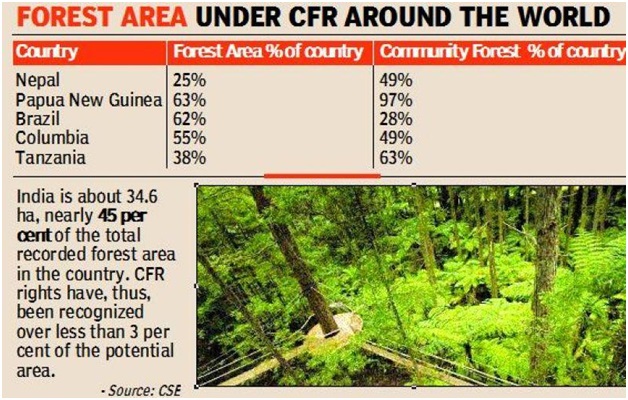
- 14 Nov 2023
Why is it in the News?
The Forest (Conservation) Amendment Act, 2023, marks a noteworthy evolution in the environmental legal landscape of India, amending the pivotal Forest (Conservation) Act of 1980. Despite its substantial implications for forest conservation, the recent amendment has garnered limited attention and scant discussion concerning its potential impact on both forests and their inhabitants.
What is a community forest resource?
- The community forest resource area is the common forest land that has been traditionally protected and conserved for sustainable use by a particular community.
- The community uses it to access resources available within the traditional and customary boundary of the village; and for seasonal use of landscape in case of pastoralist communities.
- Each CFR area has a customary boundary with identifiable landmarks recognised by the community and its neighboring villages.
- It may include a forest of any category – revenue forest, classified & unclassified forest, deemed forest, DLC land, reserve forest, protected forest, sanctuary and national parks, etc.
What are Community Forest Resource rights?
- The Community Forest Resource Rights are mentioned under Section 3(1)(i) of the Scheduled Tribes and Other Traditional Forest Dwellers (Recognition of Forest Rights) Act.
- It is commonly referred to as the Forest Rights Act or the FRA.
- It provides for recognition of the right to “protect, regenerate or conserve or manage” the community forest resource.
- These rights allow the community to formulate rules for forest use by itself and others and thereby discharge its responsibilities under Section 5 of the FRA.
- CFR rights, along with Community Rights (CRs) under Sections 3(1)(b) and 3(1)(c), which include nistar rights and rights over non-timber forest products, ensure sustainable livelihoods of the community.
- (Nistar means the concession granted to agriculturists and Villagers for removal from forest coupes on payment at stipulated rates for specified forest produce for bonafide domestic use, but not for barter sale.)
- These rights give the authority to the Gram Sabha to adopt local traditional practices of forest conservation and management within the community forest resource boundary.
Why is the recognition of CFR rights important?
- Aimed at undoing the “historic injustice” meted out to forest-dependent communities due to curtailment of their customary rights over forests, the Forest Rights Act or the FRA came into force in 2008.
- It is important as it recognises the community’s right to use, manage and conserve forest resources, and to legally hold forest land that these communities have used for cultivation and residence.
- It also underlines the integral role that forest dwellers play in the sustainability of forests and the conservation of biodiversity.
- It is of greater significance inside protected forests like national parks, sanctuaries and tiger reserves as traditional dwellers then become a part of the management of the protected forests using their traditional wisdom.
- But while CFR rights are an important empowerment tool, getting a consensus amongst various villages about their traditional boundaries often proves a challenge.
Key Provisions of the Forest (Conservation) Amendment Bill, 2023:
- Land under the Act: The amended law exclusively applies to areas classified under the Forest Act, 1927, and those designated as such on or after October 25, 1980.
- Notably, it excludes forests converted for non-forest use after December 12, 1996.
- The amendments streamline the Act's application to recorded forest lands, private forest lands, plantations, etc.
- Exempted Categories of Land: To encourage afforestation and plantation outside forests, the Bill proposes exemptions, such as providing 0.10 ha of forest land for connectivity along roads and railways, allocating up to 10 ha for security-related infrastructure, and allowing up to 5 ha in Left Wing Extremism Affected Districts for public utility projects.
- Exemptions also cover strategic projects related to national security within 100 km of international borders.
- Leasing of Forest Land: The Act mandates prior approval from the central government for the assignment of forest land to any entity, whether government-controlled or not.
- This condition now applies to all entities, with approval subject to terms and conditions specified by the central government.
- Permitted Activities in Forest Land: Restrictions on de-reservation or non-forest use of forest land may be lifted with prior approval from the central government.
- The Act outlines specific activities exempt from non-forest purposes, including those related to the conservation, management, and development of forests and wildlife.
- Expansion of Delegated Legislation Power: The amendment broadens the Central Government's power for delegated legislation.
- In addition to making Rules, it now includes the authority to issue "directions" to central government authorities, state governments, union territories, or any recognized organization, entity, or body, ensuring effective implementation of the Act's provisions.
Key Concerns with the Amendment:
- Redefining Forests: The amendment introduces a contradiction to the established definition of forests by the Supreme Court in 1996.
- This change, making any tree patches recorded as forest in government records deemed as forests, jeopardizes legal safeguards for approximately one-fifth to one-fourth of India's forests, as reported by the Public Action Committee (PAC) in Punjab.
- Infrastructure Encroachment: The exemption of land near border areas for national security projects raises concerns about adverse effects on forest cover and wildlife in northeastern states.
- Broad exemptions for projects like zoos, eco-tourism facilities, and reconnaissance surveys may also negatively impact forest land and wildlife.
- Neglect of Tribal Rights: The amendment removes the requirement for prior consent from tribal grama sabhas for alterations to forests for non-forest purposes.
- Allowing private companies to use forest land for ecotourism could prioritize corporate interests over tribal communities' livelihoods, potentially leading to the erosion of local cultures and traditions due to mass tourism.
- Top-Down Authority: Concerns have been raised about potential forest exploitation by profit-driven private companies and the consolidation of power in the central government, potentially neglecting the concerns of state governments.
- This shift in authority could lead to imbalances and adverse consequences for forest management.
- Human-Animal Conflicts: Allowing infrastructure development on forest land without addressing the growing issue of human-animal conflicts in tribal hamlets poses threats to both livelihoods and wildlife.
- The amendment lacks provisions to mitigate or prevent such conflicts, potentially exacerbating the situation.
The Path Ahead:
- Empowerment of Local Communities: Empower local communities, especially tribal groups, by involving them in decision-making processes, recognizing traditional knowledge, and ensuring equitable benefits from forest resources.
- Reinforce legal safeguards to protect indigenous communities' rights and heritage.
- Environmental Impact Assessment (EIA): Strengthen the Environmental Impact Assessment (EIA) process to comprehensively assess proposed projects' environmental impact.
- This ensures sustainable development while minimizing ecological damage and informs decision-makers.
- Stakeholder Consultation: Conduct extensive consultations with environmental experts, tribal communities, local stakeholders, and NGOs to address concerns and integrate diverse perspectives.
- Prioritize inclusiveness, local participation, and transparency in decision-making processes.
- Capacity Building: Invest in capacity building for relevant authorities to ensure effective implementation of the Act, adherence to guidelines, and competent decision-making.
- This enhances the capability of authorities to manage and regulate the Act efficiently.
- Transparency in Decision-Making: Ensure transparency in decision-making regarding forest land use, exemptions, and infrastructure projects to foster trust among stakeholders.
- Transparent processes enhance accountability and public trust.
- Periodic Review Mechanism: Establish a robust periodic review mechanism to evaluate the Act's impact on forests, biodiversity, and local communities.
- Adjustments should be made based on findings, considering feedback and evolving circumstances.
- Conflict Resolution Mechanisms: Establish efficient conflict resolution mechanisms to address disputes arising from the Act.
- Provide a fair platform for all stakeholders to voice concerns and seek resolution, promoting constructive dialogue.
- Scientific Research and Monitoring: Promote scientific research to monitor the Act's impact on forest ecosystems, biodiversity, and climate goals.
- Use data-driven insights for informed policy adjustments and develop adaptive management strategies for unforeseen challenges.
These comprehensive steps collectively form a holistic approach to navigating the complexities of forest management, ensuring sustainability, equity, and the preservation of environmental integrity.
Power of the Governor Over State Bills (The Hindu)
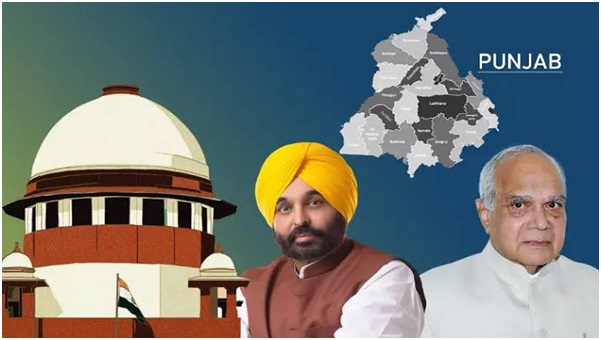
- 07 Nov 2023
Why is it in the News?
Recently, Tamil Nadu, Kerala, and Punjab have approached the Supreme Court to decide a time frame for which Governors have to either return or grant assent to Bills passed by Legislatures
News Summary:
- Punjab government led by Aam Aadmi Party had filed a petition in the Supreme Court, challenging the delay by Governor Banwarilal Purohit in giving assent to the bills passed by the State assemblies or proposed to be tabled by them.
- The recent feud between Purohit and Chief Minister Bhagwant Mann-led government pertains to three money bills that were proposed to be tabled by the State during a Special Session of the fourth Budget Session on October 20.
- The governor's approval is needed to table money bills in the House.
- Tamil Nadu has also accused Governor R.N. Ravi of toying with the citizens’ mandate by sitting on the Bills by neither assenting nor returning them.
- It said the Governor has positioned himself as a “political rival” who has caused a “constitutional deadlock” by simply sitting on the Bills for months together.
- Kerala, in its separate petition, said that eight proposed laws passed by its Legislative Assembly were pending with the Governor, not for months, but years.
- Of the eight, three Bills were waiting for the Governor’s word for over two years.
Observation by the Supreme Court:
- The Supreme Court on Monday expressed acute displeasure at Governors holding back key Bills, especially in Opposition-ruled States such as Punjab, Tamil Nadu, Kerala, and Telangana, until State governments approach the top court for judicial intervention.
- The court also questioned the Assembly’s action to reconvene three months after the Vidhan Sabha was adjourned sine die in March.
- “The Assembly was summoned on March 3 and adjourned sine die, without being prorogued, on March 22. The Speaker then reconvenes the Assembly three months later!
- The Supreme Court also said that Governors must remember that they are not the elected representatives of states and have limited power over the legislative actions of an elected government.
The process of granting assent:
- Article 200 of the Constitution covers the options before the Governor when a Bill passed by both Houses of the Legislature is presented to him.
- The first proviso to the Article says the Governor could either declare his assent to the Bill or withhold the assent if it is not a Money Bill or reserve the law for the consideration of the President if he thinks the Bill derogates from or endangers the power of judicial review of the High Court.
- In case the Governor chooses to withhold assent, he should return the Bill “as soon as possible” with a message requesting the Legislative Assembly to reconsider the proposed law or any specified provisions or suggest amendments.
- The Assembly would reconsider and pass the Bill, and this time, the Governor should not withhold his assent.
- In short, the constitutional head of the State would bow to the considered decision of the elected representatives of the people.
Do Governors have discretion?
- Governors did have the discretion to return Bills before the first proviso in the draft Article 175 (now Article 200).
- This was amended by the Constituent Assembly in 1949.
- Though it was thought that the Governor’s exercise of discretion would act as a “potential check on disruptive legislative tendencies” by States, Dr. B. R. Ambedkar, while introducing the amended proviso, said, “in a responsible government there can be no room for the Governor acting on discretion”.
- T. T. Krishnamachari, a Constituent Assembly member from Madras and later Finance Minister, approved of the amendment, saying “The Governor cannot act on his own, he can only act on the advice of the Ministry.
- When a Governor sends a Bill back for further consideration, he does so expressly on the advice of his Council of Ministers”.
- Mr. Krishnamachari explained that if the Bill passed by the Legislative Assembly needs modification or has garnered adverse public opinion, the government uses the Governor to return the Bill to the Lower House as quickly as possible for re-legislation.
- The first proviso to Article 200 is thus a “saving clause” and retains the discretion over the fate of the Bill solely in the hands of the State Cabinet.
- Article 163 of the Constitution makes it clear the Governor is not expected to act independently.
- The Supreme Court in the Shamsher Singh case verdict has held that as a formal head of the State, a “Governor exercises all his powers and functions conferred on him by or under the Constitution on the aid and advice of his Council of Ministers save in spheres where the Governor is required by or under the Constitution to exercise his functions in his discretion.”
- The assent or return of the Bill does not involve the discretion of individuals occupying the Governor’s post.
By when should Bills be returned?
- The first proviso of Article 200 says it should be “as soon as possible”.
- The Constitution is silent on what exactly this phrase means.
- The Supreme Court has interpreted “as soon as possible” in the proviso to mean “as early as practicable without avoidable delay” in its 1972 judgment in Durga Pada Ghosh versus the State of West Bengal.
- Justice (now retired) Rohinton F. Nariman, in his 2020 judgment in the Keisham Megha Chandra Singh case, said a ‘reasonable time’ would mean three months.
- The States have urged the court to interpret the phrase in the proviso and fix a time limit by which Governors should assent or return a Bill.
- The 1988 Sarkaria Commission report on Centre-State relations had suggested consultation with the Governor while drafting the Bill and fixing a deadline for its disposal.
What Efforts Have Been Made to Address Concerns Regarding Governors' Alleged Partisan Role?
- Proposal by Sarkaria Commission: The Sarkaria Commission, set up in 1983 to look into Centre-state relations, proposed that the Vice President of India and the Speaker of Lok Sabha should be consulted by the Prime Minister in the selection of Governors.
- National Commission to Review the Working of the Constitution (2000): The Commission recommended significant changes in the selection of Governors.
- The Commission suggested that the “Governor of a State should be appointed by the President, after consultation with the Chief Minister of that State”.
- Punchhi Committee Proposal: The Justice Madan Mohan Punchhi Committee, constituted in 2007 on Centre-state relations.
- The committee proposed in its report that a committee comprising the Prime Minister, Home Minister, Vice President, Speaker, and the concerned Chief Minister should choose the Governor.
- The Punchhi Committee recommended deleting the “Doctrine of Pleasure” from the Constitution but backed the right of the Governor to sanction the prosecution of ministers against the advice of the state government.
- It also argued for a provision for impeachment of the Governor by the state legislature.
The Way Forward
- While Governors may hold differing views on the content of a Bill and have constitutional options at their disposal, they should refrain from using their authority to obstruct legislation they personally disagree with.
- It's essential to put into practice the principle recommended by the Punchhi Commission, which assessed Centre-State relations and proposed that Governors should not be burdened with the role of Chancellors.
- Governors sometimes appear to have an overly elevated perception of their constitutional roles. Their primary duty is to uphold the Constitution and, if necessary, advise elected governments to align with its provisions. However, this responsibility does not grant them the authority to operate as an independent power center by exploiting the absence of a specific time frame for decision-making and their discretionary powers.
Delhi Air Pollution: Causes, Impact & Measures (The Hindu)
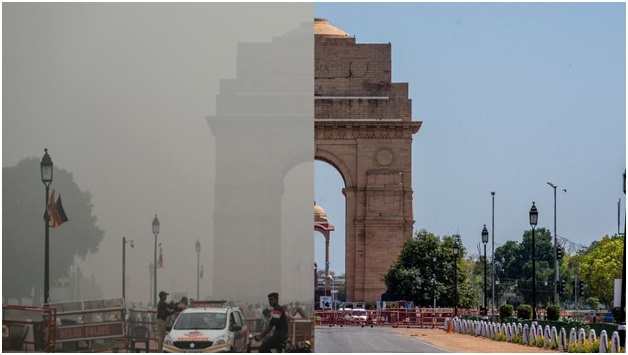
- 04 Nov 2023
Why is it in the News?
The air quality in Delhi-NCR declined over the past week due to a gradual drop in temperatures, calm winds that trap pollution, and a surge in post-harvest paddy straw burning across Punjab and Haryana.
Context:
- The air quality in Delhi has plummeted to hit the ‘severe’ category for the first time this season, with the AQI breaching the 450 mark according to the Central Pollution Control Board (CPCB).
- The State government implemented restrictions, including banning construction and demolition activities.
- Over the last few years, Delhi and its surrounding areas have been subject to hazardous smog, which conincides with the winter months rolling in.
- Smoke from farmers burning crop stubble, vehicle exhaust and factory emissions combine every winter to blanket the region in a toxic haze.
What is Pollution?
- Pollution refers to the contamination of the earth's environment with materials that interfere with human health, quality of life or the natural functioning of the ecosystems.
- The major forms of pollution include water pollution, air pollution, noise pollution and soil contamination.
- Other less-recognised forms include thermal pollution and radioactive hazards.
What are the Reasons behind Rising Air Pollution in Delhi?
- Delhi is one of the most polluted capital cities in the world for a variety of factors, including location (landlocked city), traffic patterns, dust, and farm fires.
- However, weather also has a significant impact.
- Typically, Delhi experiences deteriorating air quality from October to November, with improvements occurring from March to April.
- Unlike the winter season, the current weather conditions are not unfavorable.
- During winter, cool and calm weather tends to trap and intensify daily pollution, especially in northern India within the Indo-Gangetic Plain.
- In addition to local emissions, the decline in air quality is primarily attributed to an increase in fire incidents, largely resulting from the burning of wheat crop stubble in northern India especially Punjab and Haryana.
- Air Pollution in Delhi-NCR and the Indo-Gangetic Plains is a complex issue influenced by a variety of factors.
- Location: Delhi is a landlocked city compared to Mumbai and Kolkata so the level of pollution is more as the level of particulate matter and pollutants is not able to get discharged into the surrounding areas.
- Wind Direction: In October, the monsoons withdraw from Northwest India, bringing northwesterly winds.
- During summers, northwesterly winds transport dust from northern Pakistan and Afghanistan.
- Reduced Wind Speed: Winters see lower wind speeds compared to summers, making the region more susceptible to pollution.
- Delhi's landlocked position doesn't benefit from the sea breeze that disperses pollutants in other parts of the country.
- Stubble Burning: Burning crop stubble in states like Punjab, Rajasthan, and Haryana adds to the winter smog.
- This practice releases harmful gases like methane, carbon monoxide, volatile organic compounds, and carcinogenic polycyclic aromatic hydrocarbons.
- Vehicular Pollution: Vehicular emissions significantly contribute to declining air quality in Delhi during winter, accounting for about 20% of the problem.
- Dust Storms: Dust storms from Gulf countries worsen the existing pollution levels.
- Dry and cold weather results in dusty conditions from October to June, contributing to PM10 and PM2.5 pollutants.
- Temperature Drop: Lower temperatures reduce the inversion height, concentrating pollutants in the lower atmosphere.
- The inversion height is the layer beyond which pollutants cannot disperse upward.
- Firecrackers: Despite bans on firecracker sales, Diwali celebrations with fireworks contribute to air pollution.
- Construction Activities and Open Waste Burning: Large-scale construction projects in Delhi-NCR increase dust and pollution.
- Landfill sites and open waste burning also add to air pollution concerns.
Impact of Air Pollution on health:
- Respiratory Issues: Air pollution is a major cause of respiratory problems, including asthma, bronchitis, and lung infections.
- It can exacerbate existing conditions and increase the risk of developing them.
- Cardiovascular Diseases: Poor air quality is linked to heart problems, including heart attacks and stroke, as it can lead to the buildup of plaque in blood vessels and raise blood pressure.
- Cancer Risk: Long-term exposure to certain air pollutants is associated with an increased risk of lung and other types of cancer.
- Neurological Effects: Emerging research suggests that air pollution may have adverse effects on the central nervous system and could be linked to cognitive decline and mental health issues.
- Reduced Life Expectancy: Prolonged exposure to air pollution is associated with a shortened life expectancy, as it contributes to a range of health problems that can be life-threatening.
Impact of Air Pollution on Economic Growth:
- Healthcare Costs: Air pollution increases medical expenses due to illnesses, reducing economic growth.
- Lower Productivity: Poor air quality impairs worker productivity, hampering economic output.
- Tourism and Investment: Severe pollution deters tourists and investors, affecting local economies.
- Agricultural Losses: Air pollution harms crops, impacting food production and livelihoods.
- Environmental Cleanup Costs: Funds spent on pollution control divert resources from productive sectors, hindering economic growth.
What Steps Should Be Taken to Address Pollution in Delhi?
- Congestion Charge: Introducing a congestion charge for private vehicles during peak hours can alleviate traffic congestion and promote public transport or carpooling.
- Revenue generated from this charge can support green projects or subsidize electric vehicles, encouraging eco-friendly choices.
- Cap-and-Trade for Industrial Emissions: Implementing a cap-and-trade system sets emission limits for industries, fostering a market-driven approach to pollution reduction.
- This incentivizes industries to lower emissions and invest in cleaner technologies, ultimately reducing pollution.
- Drones for Pollution Control: Utilizing drones to detect and mitigate pollution hotspots is a proactive measure for managing air quality.
- Drones provide real-time air quality data with high resolution, allowing for public accessibility and targeted intervention.
- Vertical Gardens: Incorporating vertical gardens in urban areas enhances aesthetics and air quality.
- They absorb carbon dioxide, release oxygen, and create habitats for wildlife, contributing to urban biodiversity.
- Rewards for Low-Carbon Lifestyles: Promoting low-carbon living through a rewards system, such as points, vouchers, or tax benefits for eco-friendly choices like public transport or carpooling, encourages environmentally conscious behavior, reducing carbon footprints.
Government Measures to Combat Pollution in Delhi:
- National Clean Air Programme (NCAP): Aims to reduce PM10 and PM2.5 particles by at least 20% by 2024 compared to 2017 levels.
- Graded Response Action Plan (GRAP): As per a Supreme Court order, GRAP outlines actions based on different Air Quality Index categories, addressing air quality in Delhi and the National Capital Region.
- Stubble Burning Mitigation: Various short-term solutions, both in-situ and ex-situ, have been introduced to address crop stubble burning, such as Subsidy to farmers for Turbo happy seeders and bio-decomposers.
- Turbo Happy Seeder (THS) is a machine mounted on a tractor that cuts and uproots the stubble, in order to reduce stubble burning.
- Mobile Enforcement Teams: Enforce regulations against vehicular pollution, complemented by public awareness campaigns and investments in mass rapid transport systems. Phasing out old commercial vehicles is also underway.
- Cleaner Transport: The introduction of BS-VI vehicles, push for electric vehicles (EVs), Odd-Even as an emergency measure and construction of the Eastern and Western Peripheral Expressways to reduce vehicular pollution.
- Improved Farming Practices: Encouraging better disposal of crop residue and exploring cost-effective solutions, like chemical decomposition by the Indian Agricultural Research Institute, are essential for tackling stubble burning.
- "Green War Room": This initiative uses satellite data to identify sources of smog, particularly farm fires in Punjab and Haryana, and takes necessary action.
In response to a growing environmental and health crisis, antipollution measures are being strengthened. However, to ensure success, government bodies at various levels must need to gather the political will to boost investment, foster cross-boundary cooperation, and motivate both citizens and businesses to make their contributions.
Maratha Quota Protest (The Hindu)
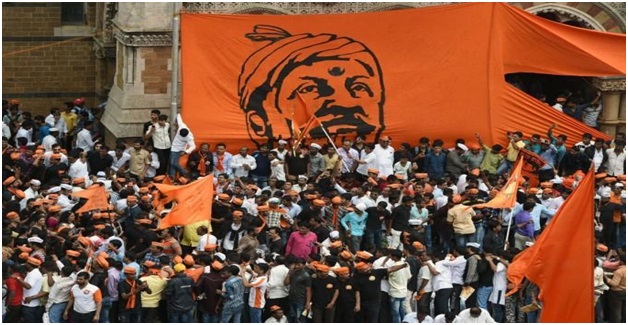
- 02 Nov 2023
Why is it in the News?
Residents in many villages of Maharashtra’s Dharashiv district on November 1 launched a ‘jail bharo’ (court arrest) protest in support of the Maratha quota agitation.
News Summary:
- The Maratha quota agitation intensified in Maharashtra after activist Manoj Jarange started an indefinite hunger strike to press the quota demand.
- The demand for OBC reservation emerged with the Supreme Court's May 2021 ruling that invalidated the Maratha quota established by the state's Socially and Educationally Backward Class (SEBC) Act, 2018.
- The Marathas want to be recognized as Kunbis, which would entitle them to benefits under the Other Backward Classes (OBC) quota.
- The State Govt. on asked officials to issue fresh Kunbi caste certificates to eligible Maratha community members from Marathwada, paving the way for them to avail reservation benefits under the Other Backward Classes (OBC) category.
- However, Mr. Jarange opposed the move saying the entire Maratha community should be given reservation.
Historical Background of the Maratha Community:
- The Marathas, historically identified as a “warrior” caste, comprise mainly peasant and landowning groups and makeup 33 per cent of the population in Maharashtra.
- The Maratha Kshatriyas have surnames like Deshmukh, Bhonsle, More, Shirke and Jadhav while most others belong to Kunbi, a predominantly agrarian sub-caste.
- The Kshatriya-Kunbi difference existed till the days of the Maratha empire.
- Now, most Marathas are engaged in farming activities.
Difference between Marathas and Marathis:
- While all Marathas are Marathis, not all Marathis are Marathas. Maratha signifies a group of castes, while Marathi is the language spoken by several communities in Maharashtra and some neighbouring areas of other states.
- A maximal circle of 96 clans is said to include all true Maratha, but the lists of these 96 clans are highly varied and disputed.
What is the issue of Maratha Reservation?
- The Marathas have been the politically dominant community in Maharashtra — since the formation of the state in 1960 as 12 of its 20 Chief Ministers have been Marathas.
- However, with a divide in holdings and problems in the farming sector, there has been a decline in the prosperity of middle and lower-middle-class Marathas.
- The demand for the Maratha reservation has been going on for decades now.
- The demand for quota for Marathas began in 1981 when Mathadi Labour Union leader Annasaheb Patil staged a morcha in Mumbai in support of the proposal.
- The Maratha Mahasangh and the Maratha Seva Sangh organized a strong movement for the Maratha reservation in government jobs and educational institutions in 1997.
- The issue was brought up again in 2000.
Timeline of Maratha Reservation Issue:
- June 2017: An 11-member commission led by retired Justice M. G. Gaikwad was formed.
- The commission recommended providing Maratha reservation rights under the category of Socially and Educationally Backward Class (SEBC).
- November 2018: Maharashtra legislature passed a bill proposing a 16% reservation in education and government jobs for the Maratha community, declared as a socially and educationally backward class by the government.
- June 2019: The Bombay High Court upholds the constitutional validity of the Maratha quota under the Socially and Educationally Backward Classes (SEBC) Act, 2018.
- It reduces the quota from 16% to 12% in education and 13% in government jobs, following the recommendations of the Maharashtra State Backward Class Commission.
- May 2021: The Supreme Court invalidated the Maratha reservation in 2021, citing the 1992 cap of 50% on all reservations. (Indira Sawhney judgment 1992)
- The total reservation ceiling was raised to 64% and 65%, respectively, by the Maratha reservations of 12% and 13% in employment and education, respectively.
Indira Sawhney judgment 1992
- In the Indira Sawhney judgment (1992), the Supreme Court made it clear that 50% reservations should generally be the rule, and the limit could only be relaxed in specific exceptional situations, typically in remote areas, to include them in mainstream opportunities.
- The Supreme Court stated that there were no such "exceptional circumstances" or "extraordinary situations" in Maharashtra to exceed the 50% reservation limit.
- Additionally, the court ruled that the state government couldn't grant socially and economically backward status to a community.
- Only the president has the authority to make changes to the central list of socially and backward classes; states can only provide suggestions.
- While the Bench unanimously upheld the constitutional validity of the 102nd Constitution Amendment, there was a difference of opinion on whether it affected the states' power to identify Socially and Economically Backward Classes (SEBCs).
- The Supreme Court emphasized that a separate reservation for the Maratha community goes against Articles 14 (right to equality) and 21 (due process of law).
- November 2022: After the SC struck down the Maratha reservation and upheld the 10 per cent quota for the Economically Weaker Sections, the Maharashtra government said that until the issue of the Maratha reservation is resolved, economically weaker members of the community can benefit from the EWS quota.
- April 2023: The state government declared that it will file a curative petition and establish a new panel to conduct a thorough assessment of the community's "backwardness" following the SC's denial of its review plea.
Maharashtra Government's Stance:
- The Maharashtra government has approved the issuance of Kunbi caste certificates to Marathas from Marathwada, based on historical documents from the Nizam era that recognize them as Kunbis.
- The main goal is to grant Marathas Kunbi caste certificates, which would classify them as Other Backward Classes (OBCs) and grant them access to the benefits reserved for OBCs.
- To ensure a standardized process, the government has formed a committee consisting of five members, led by former Justice Sandeep Shinde.
- This committee will create the Standard Operating Procedure (SOP) for issuing Kunbi caste certificates.
Who are Kunbis?
- Kunbis, a community traditionally involved in farming, are categorized as Other Backward Classes (OBC) in Maharashtra.
- During the period when Marathwada was part of the Hyderabad province, the community in that area was recognized as Kunbis, known for their farming activities.
- However, when Marathwada became part of Maharashtra, this community was categorized as Marathas.
- In 1967, Punjab Rao Deshmukh requested OBC status for Marathas in the Vidarbha region, and in 2004, the Maharashtra government issued a Government Resolution (GR) granting Kunbi status to Marathas from that area.
What is the reaction from OBC Organizations?
- Opposition to Maratha Demand: OBC organizations strongly disagree with the Maratha request for OBC reservations, fearing it might affect their existing quota.
- Reservation Concerns: OBC leaders argue that the Maratha reservation should not reduce or compromise the existing OBC reservation.
- They highlight that OBCs in Maharashtra already have a 19% reservation, which is higher than the national average of 27%.
Conclusion
In the current social and political situation, it is becoming increasingly clear that a potential conflict between the Other Backward Classes (OBCs) and the Marathas will emerge big if the problem is not addressed and managed amicably. To ensure social harmony and avoid potential conflicts, stakeholders and policymakers must engage in constructive dialogue and find fair solutions to the OBC and Maratha reservation issue.
Provisions Regarding Surrogacy in India (The Hindu)
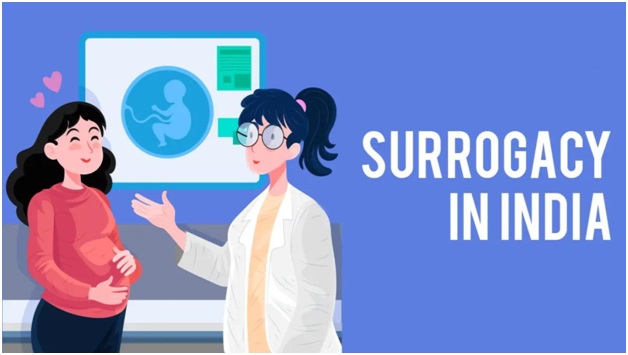
- 27 Oct 2023
Why is it in the News?
Two-judge Bench comes to the rescue of a woman suffering from the rare medical condition of Mayer Rokitansky Kuster Hauser syndrome by staying the operation of a law that threatened to wreck her hopes of becoming a mother.
What was the case, and why did the woman approach the Supreme Court?
- There was a woman who had the Mayer Rokitansky Kuster Hauser (MRKH) syndrome.
- Medical board records showed she has absent ovaries and an absent uterus, hence she cannot produce her eggs/oocytes.
- The couple had begun the process of gestational surrogacy, through a donor, last year.
- However, a government notification (on March 14 this year) amended the law, banning the use of donor gametes.
- It said “intending couples” must use their gametes for surrogacy.
- The petition was filed in the SC challenging the amendment as a violation of a woman’s right to parenthood.
What are Gametes?
- Gametes are reproductive cells that fuse during fertilization to form a new organism.
- They are haploid cells, meaning they contain only one copy of each chromosome. This ensures that the offspring has the correct number of chromosomes from both parents.
- In animals, the male gamete is called a sperm cell and the female gamete is called an egg cell.
- Sperm cells are small and motile, while egg cells are large and nonmotile.
- Gametes are produced through a process called meiosis, which reduces the number of chromosomes in a cell by half.
- This process is essential for sexual reproduction.
What were the petitioner’s arguments?
- The woman said that she started the surrogacy procedure months before the amendment took effect, so it cannot be implemented retrospectively.
- She and her spouse were unable to proceed with the surrogacy procedure in order to become parents because the Surrogacy (Regulation) Rules 2022 amendment prohibited the use of donor eggs.
- The Surrogacy Act 2021, which recognized situations where a couple would have to choose gestational surrogacy in order to become parents due to a medical condition, is in conflict with the amendment.
- The medical or congenital conditions listed in the Surrogacy Rules allowed a woman to choose to become a mother through gestational surrogacy.
- These included not having a uterus, having one that is missing, having an abnormal uterus, or having had surgery to remove the uterus because of a medical condition like gynecological cancer.
- It was explicitly stated in the Surrogacy Rules that the woman had the final say in the matter.
- Government's argument: According to the law, surrogacy cannot be used unless the intended couple and the child are "genetically related." This made using donor eggs exempt.
What was the Supreme Court’s (SC’s) Verdict?
- The Surrogacy Act's main provisions, both in form and content, imply that the amendment is prima facie contrary to their intended meaning.
- It was a "woman-centric" law that allowed gestational surrogacy.
- The woman's incapacity to become a mother due to her ailment or birth defect was the sole reason for choosing to have a surrogate child.
- Among these conditions were the lack of a uterus, multiple pregnancies, recurrent miscarriages, or an illness that would make the pregnancy dangerous or impossible for her to carry to term.
- The amendment cannot be in conflict with the Rules, which expressly identify the lack of a uterus or any related condition as a medical necessity for gestational surrogacy.
- The court emphasized that the surrogate child would be related to the husband in response to the government's argument that the child should be "genetically related" to the couple.
- It should be noted in this context that the phrase "genetically" related to the prospective couple must be interpreted as referring to the husband.
What is surrogacy?
- Surrogacy is the act of bearing and delivering a child on behalf of a different individual or couple (i.e., intended parents).
- A woman who bears a child on behalf of another woman is known as a surrogate mother. This can be done either naturally (traditional surrogacy) or by implanting a fertilized egg from another woman into her womb (gestational surrogates).
- The biological mother of the child serves as a traditional surrogate. Because it was their egg that was fertilized by the father's sperm.
- Eggs from the mother (or an egg donor) can now be collected, and fertilized with sperm from the father (or a sperm donor), and the embryo can be placed into the uterus of a gestational surrogate thanks to a process known as "in vitro fertilization" (IVF). Gestational surrogates are genetically unrelated to the child because their egg was not used in the process.
Provisions regarding the Surrogacy (Regulation) Act 2021:
- Prohibition of commercial surrogacy: The Act prohibits commercial surrogacy, meaning that no monetary or other material benefit can be given to the surrogate mother, except for medical expenses and insurance coverage.
- Permissibility of altruistic surrogacy: The Act only allows altruistic surrogacy, where the surrogate mother is a close relative of the intending couple or intending woman, and does not receive any financial or other material benefit, except for medical expenses and insurance coverage.
- Eligibility criteria for intending couples and surrogate mothers: Intending couples must be legally married and have a medical condition that necessitates surrogacy.
- Surrogate mothers must be between the ages of 25 and 35 years, have at least one child of their own, and be medically and psychologically fit for surrogacy.
- Registration of surrogacy clinics and assisted reproductive technology (ART) banks: All surrogacy clinics and ART banks must be registered with the National Assisted Reproductive Technology and Surrogacy Board.
- Establishment of National and State Boards: The Act establishes a National Assisted Reproductive Technology and Surrogacy Board and State Assisted Reproductive Technology and Surrogacy Boards to regulate the practice of surrogacy and to ensure the welfare of surrogate mothers and children born through surrogacy.
- Penalties for violations: The Act prescribes penalties for violations of its provisions, including imprisonment for up to 10 years and fines up to Rs. 10 lakhs.
Women, Marriage and Labour Market Participation (The Hindu)

- 26 Oct 2023
Why is it in the News?
- With the high percentage of married women in the working-age population, there is growing concern about the economic impact of their non-participation in India's workforce.
- Women who work have better economic opportunities and more household decision-making authority.
- The work of Nobel laureate Claudia Goldin draws attention to differences in women's employment outcomes.
What is the Labour Force Participation Rate (LFPR)?
- The Labour Force Participation Rate (LFPR) is an important indicator in labor market studies because it represents the proportion of a country's working-age population that is either employed or actively looking for work.
- The female labor force participation rate (FLFPR) is the percentage of working-age women who are currently employed or looking for work.
Data on Women’s Labour Participation:
- In 2022, the global LFPR for women was 47.3%.
- Women's LFPR decreased in developing nations;
- For example, in India it fell from 28% in 1990 to 24% in 2022.
- Based on data from India's NSSO Periodic Labour Force Survey (PLFS) for individuals aged 25 to 49, the following trends have been noted::
- Compared to the Usual Principal and Subsidiary Status (UPSS) status, married women exhibit a significantly lower employment proportion under the Usual Principal Status (UPS) status.
- Marriage has a significant impact on women's labor-force outcomes.
- The female labor force participation rate (FLFPR) among married women between the ages of 25 and 49 decreased by 5% in 2022–2023.
- The FLFPR for this group decreased to 45% in 2022–2023 from 50% in 2004–05.
- Most of the FLFPR decline is concentrated in the 25–29 age range.
What is the Periodic Labour Force Survey?
- The Periodic Labour Force Survey (PLFS) was introduced by the NSO in April 2017 in response to the growing need for labor force data to be available at more frequent intervals.
- PLFS aims to accomplish two main goals:
- to estimate, for the urban areas only in the CWS, the major employment and unemployment indicators (i.e., the worker population ratio, labor force participation rate, and unemployment rate) in a brief period of three months.
- to annually estimate the indicators of employment and unemployment in both CWS and usual Status in both rural and urban areas.
What is NSSO?
- The National Sample Survey Office (NSSO) is an organization within the Government of India's Ministry of Statistics and Programme Implementation.
- It is in charge of carrying out extensive nationwide sample surveys on a range of socioeconomic topics.
- The NSSO was established in 1950 to meet the data needs of post-independence India.
- The National Sample Survey (NSS) Commission, which is composed of state officials, academics, and subject-matter experts, provides overall direction for the organization's operations.
- Regular "rounds" of surveys are carried out by the NSSO, and they typically last for a year. These rounds are usually named after the year they begin, such as "68th round" or "75th round."
- In 2019, the NSSO merged with the Central Statistics Office (CSO) to form the National Statistical Office (NSO) in order to streamline and consolidate the country's statistical system.
What is the reason behind the decline/low participation rate of women in labor force?
- Movement of Production: According to economist Claudia Goldin (1994), adult women's LFPR shows a U-shaped pattern during periods of economic expansion.
- She also mentioned that the shift in production from the family farm, small business, and home to the larger market is the reason for the initial drop in the participation rate.
- Marriage Issues: When married women indicate a desire to enter the workforce, the problem gets worse.
- Women's LFPR tends to decline after marriage for a variety of reasons.
- When comparing the Usual Principal Status (UPS) to the Usual Principal and Subsidiary Status (UPSS), married women exhibit a significantly lower employment proportion, according to the PLFS data (25 to 49 years).
- The age range of 25 to 29 is where the majority of the decline in the female LFPR is found.
What are the Problems Faced by Married Women?
- Growing Family Obligations: Due to women's lower educational attainment and restricted mobility, there is a growing social disapproval of women working outside the home, which in turn leads to an increase in family obligations.
- Marriage Increases Domestic Responsibilities: In addition to increasing women's domestic responsibilities, the institution of marriage places numerous social and cultural constraints on them that limit their ability to engage in the workforce.
- Social Elements: Women's limited labor participation is also influenced by a number of other societal factors, including their location and affiliations with particular castes and religions.
- The level of wealth in their home and the social norms that are in place regarding women working outside the home also influence how many women enter the workforce.
Other challenges faced by married women:
- When women choose to return to the workforce after marriage, they typically show a preference for jobs that are located close to their homes and provide more flexibility.
- Due to a number of social restrictions, women also face gender-asymmetrical professional costs.
- It causes gender differences in decisions about fertility, age at marriage, income inequality, and premarital career choices.
- It has been noted that women in higher social classes typically fulfill home duties in order to conform to strict social norms.
- Women from lower socioeconomic classes are more likely to work, mainly due to financial limitations brought on by poverty.
- When compared to their more educated counterparts, women who are illiterate are more likely to enter the workforce following marriage.
- According to empirical research on the distribution of female labor across various industry sectors in India, the agricultural sector continues to be the most popular choice for women seeking employment.
What can be solutions to promote greater participation of married women in the labour market?
- Offering Child Care Services: By helping women handle their caregiving duties, this program will allow them to dedicate enough time to gainful employment.
- It is also crucial to invest in the establishment of childcare services in office buildings through cooperative models and in industrial corridors with industry associations.
- Public crèches can be run in worksite clusters like labor nakas, close to markets, industrial areas, and densely populated low-income residential areas.
- Additionally, the establishment of work environments that give precedence to the requirements and welfare of female employees, the supply of safe modes of transportation, and the growth of opportunities for part-time employment would function as inducers for increased female participation in the Indian labor market.
Government Initiatives to increase female labor participation rate:
The government has targeted the issue by taking various prominent steps to increase the female labour participation rate which includes:
- Enactment of the Maternity Benefit (Amendment) Act, 2017 which provides for enhancement in paid maternity leave from 12 weeks to 26 weeks.
- Provisions for mandatory crèche facility in establishments having 50 or more employees.
- Issue of an advisory to the States under the Factories Act, 1948 for permitting women workers in the night shifts with adequate safety measures.
Conclusion
- Married women's lower participation in the labor force and their propensity to leave the workforce after marriage are caused by a variety of factors.
- In light of this, it is critical to consider appropriate strategies for advancing women's empowerment during this period of rapid economic expansion.
- Empowering women in the workforce is not only economically necessary, but also a crucial first step toward achieving gender equality and inclusive economic growth.
Dam Safety Act (The Hindu)
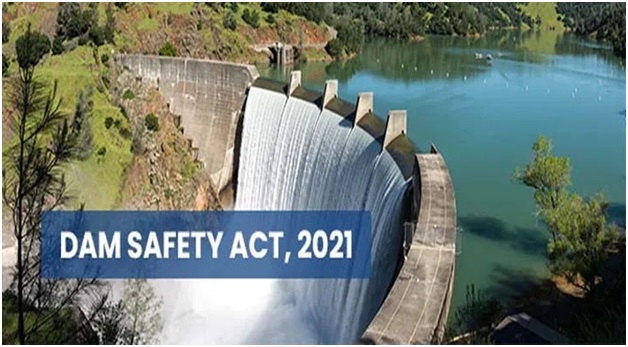
- 23 Oct 2023
Why is it in the News?
- India has nearly 6,000 large dams, 80% of which are over 25 years old and pose safety risks.
- A new Dam Safety Act (DSA) was enacted in late 2021.
- On October 4, 2023, the Teesta III dam at Chungthang, one of the largest hydropower projects in India, was destroyed by a glacial lake outburst flood (GLOF) in North Sikkim's South Lhonak Lake.
- Since then, reports have shown there were no early warning systems, risk assessments, or preventive measures implemented as required by the Act.
What are the provisions of the Dam Safety Act, 2021?
- The Dam Safety Act was introduced in the Rajya Sabha in December 2021 in response to inadequate surveillance and maintenance, which resulted in dam failure-related disasters.
- The Act outlined important duties and required the creation of bodies at the federal and state levels to carry them out.
- Key provisions:
- Dam safety policies and rules would be supervised by a National Committee on Dam Safety;
- State-level disputes would be handled by a National Dam Safety Authority, which would also be responsible for implementation;
- The Chairman of the Central Water Commission (CWC) would be in charge of dam safety protocols on a national scale.
- There would be a State Committee on Dam Safety (SCDS) and a State Dam Safety Organization (SDSO).
What do the States need to do?
- States are required by provisions to: categorize dams according to risk of hazards; carry out routine inspections; develop emergency action plans; implement emergency flood warning systems; and carry out safety reviews and period risk assessment studies.
- States were asked to report and document incidents of dam failures.
- Until now, no statutory provision required systemic reporting of failures, and no single agency was in charge of tracking this information.
- The CWC maintains a list, but it is not consistently updated.
Is there any action taken for failing to comply?
- Any provision of the Act that is broken is punishable by imprisonment and/or monetary penalties.
- The entity shall be punished with imprisonment for a term which may extend to two years if such obstruction or refusal to comply with directions results in the loss of lives or imminent danger.
- For failing to comply with the Dam Safety Act, the Sikkim High Court ordered the Gati Hydropower Project company to pay two widowed mothers 70 lakh in February 2023.
What are the challenges?
- Blind spots in the implementation of the law
- The Dam Safety Act (DSA) fails to encourage transparency and does not support risk-based decision-making.
- Such disasters occur frequently, and their size reveals a pattern of neglect.
- Access to Information
- A strong Dam Safety Act (DSA) should make it simple for various stakeholders to access information, but India's framework falls short.
- Safety at dams serves a public purpose.
- The general public should have immediate access to all information regarding dam safety, including the roles played by all institutions, committees, and authorities, as well as their reports, decisions, minutes, and agendas.
- Nothing is, however, in the public domain.
- Absence of a cyclical review
- Periodic reviews are frequently not carried out, or if they are, the results are not readily accessible to the public.
- Comprehensive dam safety evaluations are mandated by the Act for dam builders. The failure's analysis and reporting, however, are not standardized.
How is dam safety undertaken?
Dam safety is a function of many parts:
- Design and Construction: Building dams with safety margins is the initial step.
- Dams should be designed and constructed to withstand potential hazards.
- Maintenance and Operation: Dams need regular upkeep and should be operated following safety guidelines to ensure their long-term stability.
- Real-Time Data: Continuous monitoring and recording of dam data in an easily accessible format is crucial for prompt action in case of emergencies.
- Hazard Forecasting: Being prepared for hazardous events is key. This includes forecasting potential risks and having emergency plans in place.
- The incident in Sikkim revealed poor compliance with safety measures, ranging from dam design to the capacity of spillways that manage water release.
- Hazard Profiling: Regular assessment and profiling of potential hazards are mandated.
- Hazards can change due to factors like climate change, urbanization, and water usage patterns.
- Periodic Reviews: Periodic reviews are essential to update inundation maps and dam reservoir capacity rules.
- This contributes to downstream safety.
- Review Frequency: Spillway capacity and safety metrics should be reviewed approximately every five years.
- However, these reviews may not be conducted as required.
- Dam Safety Evaluations: The Act requires comprehensive dam safety evaluations by dam builders.
- Unfortunately, there's a lack of standardization in how failure analysis and reporting are carried out.
- Non-Compliance: In certain cases, such as the July-August floods in Himachal Pradesh, dam builders were found guilty of non-compliance with dam safety regulations, leading to government notices.
Manual Scavenging in India (The Hindu)
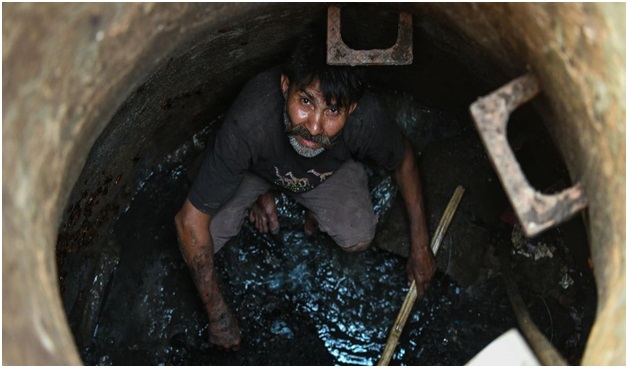
- 21 Oct 2023
Why is it in the News?
Recently, the Supreme Court, in a judgment, said claims of fraternity, equality, and dignity among citizens remain a mere illusion if a sizeable section of society is forced to enter sewers for a living and die trapped in them even a decade after the outlawing of the inhuman practice of manual scavenging.
What is Manual Scavenging?
- The practice of manually cleaning, handling, and disposing of human excreta and other waste materials from dry latrines, open drains, and sewers is known as manual scavenging.
- Although it has been formally prohibited since 1993, manual scavenging has long been a problem in India.
Manual Scavenging in India:
- According to the 2011 Census of India, there were over 740,000 households in India where manual scavenging was still practiced.
- The National Commission for Safai Karamcharis reports that between 2016 and 2019, 482 manual scavengers lost their lives while clearing septic tanks and sewers throughout India.
- An advocacy group fighting to end manual scavenging, the Safai Karamchari Andolan, calculates that there are still roughly 1.8 million manual scavengers in India.
- Many manual scavengers suffer from a variety of health issues, including skin diseases, respiratory problems, and even death, as a result of their exposure to toxic fumes in septic tanks and sewer lines.
- From 2019 to 2022, a total of 233 people died as a result of accidents while performing hazardous sewer and septic tank cleaning.
- Haryana had the most deaths (13), followed by Maharashtra (12) and Tamil Nadu (10).
Why does manual scavenging still occur frequently in India?
- Ineffective sewage management system: In India, the majority of municipalities lack the newest sewage cleaning equipment, necessitating the entry of sewage workers through manholes into the underground sewerage systems.
- However, because they are much less expensive to hire, contractors illegally hire unskilled laborers and pay them a daily wage.
- Social stratification based on caste: Manual scavenging has long been connected to India's caste system, where some castes have been marginalized and compelled to work in fields that are deemed "unclean" or "polluting."
- Manual scavenging as a source of income for these marginalized communities continues as a result of the persistence of caste-based discrimination and social stigma.
- Lack of Alternative Livelihood Opportunities: Manual scavenging is common in affected communities due to a lack of alternative employment opportunities.
- Many manual scavengers are trapped in a cycle of poverty and exclusion, with no access to education or skill development programs that could provide them with alternative means of subsistence.
- Due to a lack of economic alternatives, they must continue to engage in manual scavenging for survival.
What Are the Consequences of Manual Scavenging?
- Health Effects: Manual scavengers face significant health risks as a result of direct exposure to human waste and hazardous substances.
- They are especially vulnerable to diseases like cholera, typhoid, hepatitis, and various respiratory infections.
- The lack of protective equipment and poor sanitation conditions exacerbate the health risks, leading to an increase in illnesses and premature deaths among manual scavengers.
- Dignity and Human Rights Violations: Manual scavenging is a clear violation of the individual’s dignity and human rights.
- They live in deplorable and inhumane conditions, handling human waste with their bare hands and without access to basic sanitation facilities.
- This occupation reinforces caste-based oppression by perpetuating social stigma, discrimination, and marginalization of affected communities.
- Psychological and Emotional Trauma: Manual scavenging can have serious psychological and emotional consequences for those involved.
- Their mental health suffers as a result of their constant exposure to filth, the humiliation of their work, and the discrimination they face.
- Manual scavengers frequently suffer from feelings of shame, low self-esteem, and depression, which can lead to long-term psychological trauma.
Steps Taken by Government to Reduce Manual Scavenging:
- In an effort to prevent deaths caused by hazardous cleaning of sewers and septic tanks, the government created the NAMASTE scheme or National Action Plan for Mechanised Sanitation Ecosystem.
- The Employment of Manual Scavengers and Construction of Dry Latrines (Prohibition) Act, 1993 was enacted to prohibit manual scavenging.
- The Prohibition of Employment as Manual Scavengers and Their Rehabilitation Act of 2013 was passed to strengthen the ban and provide for the rehabilitation of manual scavengers.
Prohibition of Employment as Manual Scavengers and their Rehabilitation Act, 2013:
- It was passed in 2013 to make provisions for the banning of employment as manual scavengers and the rehabilitation of manual scavengers and their families.
- The act's main goals are to get rid of unhygienic latrines, forbid hiring manual scavengers, forbid dangerous manual cleaning of septic and sewer tanks, and keep track of manual scavengers and their rehabilitation.
- Provisions:
- No person or organization may hire or engage any person to perform manual scavenging.
- Anyone who engages in manual scavenging in violation of the provisions of the MS Act, 2013, faces imprisonment for up to two years, a fine of up to one lakh rupees, or both.
- It outlines the measures taken to help sanitation workers and their families get back on their feet.
- Following a survey of manual scavengers, the local administration must issue them with a photo identity card containing information about their family members as well as monetary compensation.
- Their children must receive a government scholarship, as well as a residential plot and the funds necessary to build on it.
- It is also illegal for a person to clean a sewer or septic tank without the employer providing protective gear and cleaning devices and following safety precautions.
- Every local authority is required by the Act to ensure that there are no insanitary latrines in its jurisdiction and that no manual scavengers are employed.
- A municipality or a panchayat is a local authority that is in charge of sanitation in its jurisdiction.
- Local governments must build community sanitary latrines (that do not require manual removal of human excreta) and make plans for their sanitary upkeep at all times.
- They must also ensure that technological appliances are used to clean sewers, septic tanks, and other similar spaces in their jurisdictions.
- Despite legal prohibitions and government efforts to eliminate manual scavenging, the practice continues in various parts of the country.
Way Forward
- Technology-Driven Solutions: Innovative tools and machinery that can take the place of manual scavenging work must be developed.
- For instance, septic tanks and sewer lines can be cleaned by automated robots, eliminating the need for human intervention in potentially dangerous situations.
- Encourage Entrepreneurship and Skill Development: There is a need to encourage affected individuals' training and skill development, allowing them to explore alternative livelihood opportunities.
- To assist former manual scavengers in transitioning to safer and more dignified professions, governments and non-governmental organizations can provide vocational training in areas such as plumbing, electrical work, computer literacy, and entrepreneurship.
- Upgrades to Sanitation Infrastructure: Invest in sanitation infrastructure development and improvement, such as the construction of modern toilets, sewage treatment plants, and efficient waste management systems.
- These improvements will reduce the need for manual scavenging and provide safer waste disposal options.
10 Years of China's Visionary Belt and Road Initiative (The Hindu)
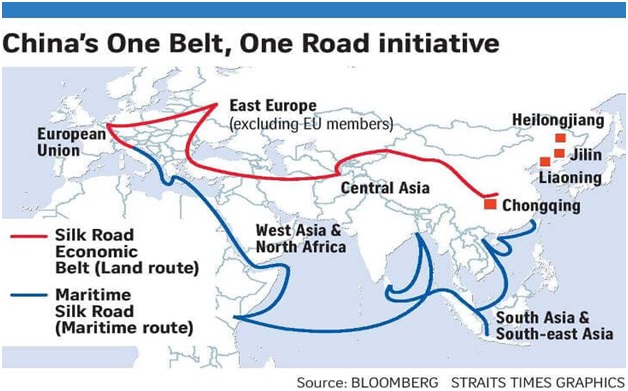
- 20 Oct 2023
Why is it in the News?
Recently Chinese President Xi Jinping commemorated the 10th anniversary of the Belt and Road Initiative (BRI).
What is the Belt and Road Initiative (BRI)?
- The Belt and Road Initiative (BRI), also known as the One Belt, One Road (OBOR) initiative, is a massive infrastructure and economic development project launched by China.
- It was introduced by Chinese President Xi Jinping in 2013 and aims to enhance trade and investment connectivity between China and various countries in Asia, Europe, Africa, and beyond.
- The initiative comprises two main components:
- The Silk Road Economic Belt: This land-based component envisions the construction of a network of roads, railways, and pipelines connecting China to Europe through Central Asia, the Middle East, and Eastern Europe.
- Maritime Silk Road: This sea-based component focuses on developing a network of ports and coastal infrastructure, linking China to Southeast Asia, South Asia, Africa, and Europe via the Indian Ocean and South China Sea.
What are the objective of the Belt and Road Initiative (BRI)?
- The BRI aims to stimulate economic development, improve trade relationships, and foster cultural exchanges across participating countries.
- It involves extensive investments in infrastructure, including roads, railways, ports, and energy projects, with the goal of boosting economic growth and connectivity.
- The initiative has been met with both enthusiasm and scrutiny, as it has the potential to reshape global trade and geopolitical dynamics.
- It is scheduled to be finished in 2049, to coincide with the centennial of the People's Republic of China.
Geographic Corridors:
The land-based Silk Road Economic Belt envisions six key development corridors:
- China-Pakistan Economic Corridor (CPEC).
- New Eurasian Land Bridge Economic Corridor.
- China-Indochina Peninsula Economic Corridor.
- China-Mongolia-Russia Economic Corridor.
- China-Central Asia-West Asia Economic Corridor.
- China-Myanmar Economic Corridor.
What is India's position on BRI?
- India objects to the project on the grounds of transparency and national sovereignty. India has boycotted China's BRI summits in 2017 and 2019 and has not endorsed the BRI joint statements issued by the Shanghai Cooperation Organization (SCO).
- The main reason India opposes the BRI is that it includes the China-Pakistan Economic Corridor (CPEC), which passes through Pakistan-occupied Kashmir (PoK), which India claims as its own territory.
- India also contends that BRI projects must adhere to international norms, the rule of law, and financial sustainability, and must not create debt traps or environmental and social risks for host countries.
- India has instead advocated for other connectivity programs, such as the Partnership for Global Infrastructure and Investment (PGII), a G7 program to finance infrastructure projects in developing nations.
What are the concerns related to the Belt and Road Initiative (BRI)?
- Debt burden: The debt sustainability and transparency of BRI projects, particularly in countries with weak governance, high corruption, and low credit ratings.
- Some critics have accused China of engaging in "debt-trap diplomacy" by lending money to countries like Sri Lanka and Zambia that eventually find themselves unable to repay, and then seizing strategic assets or extracting political concessions in exchange.
- Geostrategic Concerns: The Belt and Road Initiative has raised geopolitical concerns, particularly about China's growing influence and control over critical infrastructure in partner countries.
- Because of these concerns, some countries have reconsidered their participation in the initiative.
- Political Tensions: Geopolitical rivalries and disputes, such as the India-China border dispute, have hampered BRI project implementation in some regions.
- The progress of the initiative could be hampered by these political tenses.
- Multilateral Governance: The BRI is not a multilateral initiative, but rather a collection of mostly bilateral projects. This decentralized approach may cause coordination and governance issues.
- Unlike initiatives such as the Asian Infrastructure Investment Bank (AIIB), the BRI lacks a centralized governing structure, making collective action difficult.
- Environmental and social concerns: The BRI's infrastructure development projects have been criticized for their potential environmental and social impacts.
- It is difficult to ensure that BRI projects are environmentally sustainable and take into account the well-being of local communities.
Alternatives to BRI concerns include:
- Blue Dot Network (BDN): A multi-stakeholder initiative led by the United States, Japan, and Australia to promote high-quality global infrastructure development standards.
- B3W Initiative: The B3W Initiative, led by the G7, seeks to address the infrastructure gap in developing and low-income countries.
- Global Gateway: The European Union launched the Global Gateway to compete with BRI, focusing on various sectors such as climate change, digitalization, health, and education.
- PGII (Partnership for Global Infrastructure and Investment): A rebranded version of B3W. It is a G7 initiative to fund infrastructure projects in developing countries. India is in favor of it.
- India's Efforts:
- India's counter to BRI, supported by Lines of Credit (LOCs) to countries in Asia, Africa, the Commonwealth of Independent States (CIS), and Latin America.
- It includes projects such as IMEC and INSTC.
- During the recent G20 summit, India-Middle East-Europe Economic Corridor (IMEC) initiative
- International North-South Transport Corridor (INSTC) connecting India to the Middle East and Russia
To protect its own interests, China has established a network of investments that has left several low- and middle-income countries in severe debt; thus, global initiatives have provided a counter-block for monopoly and taken steps to focus on more inclusive and sustainable development.
Electoral Bonds Case Referred to 5-Judge Constitution Bench for Hearing (The Hindu)
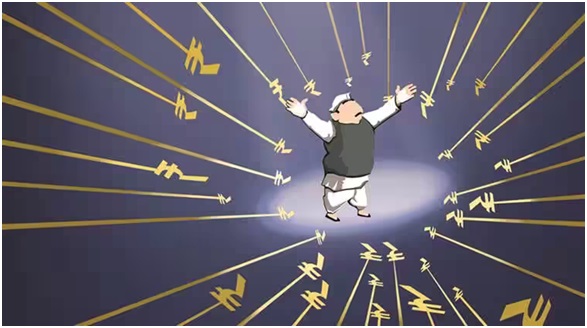
- 16 Oct 2023
Why is it in the News?
- Electoral Bonds Case Referred to 5-Judge Constitution Bench for Hearing on October 31 by Supreme Court.
- Two NGOs, Common Cause and Association for Democratic Reforms (ADR), have filed petitions challenging the electoral bonds scheme.
- The petitioners argue that anonymous funding through these bonds promotes corruption and infringes on citizens' right to a corruption-free nation.
What Are Electoral Bonds (EBs)?
- Electoral bonds, introduced by the Government of India in 2018, serve as a financial instrument to facilitate anonymous political donations.
Key Points:
- An electoral bond is a bearer instrument, akin to a promissory note, allowing the bearer to make contributions to political parties.
- Eligibility to Receive Electoral Bonds: Only registered political parties qualify to receive electoral bonds. Specific criteria apply:
- Recognition: The party must be registered under Section 29A of the Representation of the People Act, 1951.
- Recent Election Performance: The party must have secured at least 1% of the votes polled in the most recent Lok Sabha or State Assembly election.
- Available Denominations: The Government has specified various denominations for electoral bonds, ranging from Rs. 1,000 to Rs. 1 crore.
- Authorized Bank: The State Bank of India (SBI) is the sole authorized institution for the sale of electoral bonds.
How They Work:
- Eligibility to Purchase: Indian citizens or entities incorporated in India are eligible to buy these bonds.
- Denominations: Electoral bonds are available in various denominations, such as Rs. 1,000, Rs. 10,000, Rs. 1,00,000, Rs. 10,00,000, and Rs. 1,00,00,000.
- Lifespan: These bonds have a short life of 15 days, during which they can be used solely for making donations to registered political parties.
- Availability: Electoral bonds can be purchased during specific periods, typically 10 days in the months of January, April, July, and October as specified by the Central Government.
- Encashment: Eligible political parties can encash these bonds through a designated bank account with the authorized bank.
- Disclosure: Political parties are required to disclose the amount received from electoral bonds to the Election Commission.
Key Features of Electoral Bonds:
- Anonymity: Electoral bonds ensure donor anonymity by keeping the identity of the donor confidential, both to the public and the recipient’s political party.
- Purchase and Redemption: These bonds can be purchased from authorized banks using legal tender.
- They are available in fixed denominations, with the minimum value set by the government.
- Redemption is exclusive to registered political parties within a specified time frame.
- Validity: Electoral bonds have limited validity, typically 15 days, during which they can be utilized for making donations to eligible political parties.
- Exclusivity: Only political parties that have garnered at least 1% of the votes in the most recent Lok Sabha or State Assembly election are qualified to receive electoral bond donations.
- Transparency: While donor identities are kept confidential, political parties receiving electoral bond donations are obligated to disclose donation details in their financial statements submitted to the Election Commission of India.
What are the Reasons for Introducing Electoral Bonds?
- Promoting Digital Transactions: The electoral bond scheme was introduced to encourage the transition from cash-based political donations to digital transactions.
- This shift aimed to reduce the use of unaccounted or black money in political funding.
- Ensuring Donor Anonymity: The scheme's objective was to safeguard donor anonymity.
- The donor's name is not disclosed on the bond. Donors contributing less than Rs 20,000 to political parties through the purchase of electoral bonds are not required to provide identity details like PAN, enhancing protection against potential backlash due to their political affiliations.
- Formalizing Political Contributions: Electoral bonds aimed to formalize political contributions by routing donations through the banking system.
- This formalization establishes a documented record of donations, making the process more transparent and accountable.
- Enhancing Transparency: While donor identities are shielded, the electoral bond scheme sought to enhance transparency in political funding.
- This is achieved by mandating political parties to disclose the details of electoral bond donations in their financial statements.
Criticisms of Electoral Bonds:
- Lack of Transparency: While political parties must disclose the amount of donations received through electoral bonds, the identity of donors remains confidential.
- Potential for Money Laundering: Critics argue that the anonymity provided by electoral bonds can be exploited for money laundering or funneling black money into the political system.
- Unequal Advantage to Ruling Parties: The sale of such bonds via a government-owned bank (SBI) raises concerns that the government could discern who is funding its opponents.
- This may create opportunities for extortion or victimization of companies that don't support the ruling party.
- Bypassing Election Commission Scrutiny: Unlike other forms of political funding, electoral bonds do not necessitate approval or verification by the Election Commission of India (ECI), potentially undermining the ECI's oversight role in regulating political funding and ensuring a level playing field.
- No Upper Limit on Funding: The removal of the cap on corporate donations to political parties has raised concerns about unlimited corporate funding.
- Concerns by RBI and EC: Both the Reserve Bank of India (RBI) and the ECI have expressed concerns about electoral bonds, highlighting the potential for increased black money circulation, money laundering, counterfeiting, and forgery.
- They also worry about setting a precedent for money laundering, eroding trust in Indian banknotes, undermining central banking legislation, legitimizing opacity in election funding, and facilitating money laundering for shell companies and foreign donations.
What are the Challenges Associated with Electoral Bonds?
- Compromising the Right to Know: Electoral bonds, by concealing the identities of donors and recipients, may pose challenges to the right to know, which is a component of the right to freedom of expression under Article 19 of the Constitution.
- Government Access to Donor Data: The risk of anonymity compromise arises from government access to donor data, enabling the government in power to exploit this information, potentially impacting the fairness of elections.
- Unauthorized Donations Violating Regulations: There is a risk of unauthorized donations violating existing regulations and guidelines.
- Crony Capitalism and Black Money: Electoral bonds may create a risk of crony capitalism, which entails mutually beneficial relationships between business leaders and government officials. It also opens the door to the infusion of black money into political funding.
- Loopholes in Corporate Transparency and Donation Limits: Concerns arise from loopholes regarding transparency for corporate entities and the removal of the 7.5% clause in the Companies Act 2013. This change raises concerns about the potential use of shell companies for political funding, including the circulation of black money.
Way forward
- Enhance Transparency: Take steps to improve transparency within the Electoral Bond Scheme.
- Stricter Regulation and Disclosure: Enforce more stringent regulations for political parties, mandating full disclosure and permitting the Election Commission of India (ECI) to scrutinize donations, both in terms of bonds and expenditure.
- Address Loopholes: Identify and rectify any existing loopholes in the Electoral Bond system to mitigate the potential for misuse, violation of donation limits, and risks like crony capitalism and the infusion of black money.
- Ongoing Monitoring and Review: Establish a system for continuous monitoring and review of the Electoral Bond Scheme.
- This can be achieved through judicial oversight, periodic assessments, and engagement with the public.
- This approach will help address emerging concerns and adapt to evolving political landscapes, ultimately promoting a more inclusive decision-making process.
Key Findings from the Association of Democratic Reforms (ADR) Report:
Donations and Funding Sources Analysis:
- The highest donations from Electoral Bonds, amounting to ?3,438.8237 crore, were received in the year 2019-20, coinciding with the general elections.
- In 2021-22, a year with 11 Assembly elections, donations through Electoral Bonds reached ?2,664.2725 crore.
- Out of the total donations of ?16,437.635 crore received by the 31 political parties analyzed, 55.90% came from Electoral Bonds, 28.07% from the corporate sector, and 16.03% from other sources.
National Parties:
- National parties experienced a significant surge in donations through Electoral Bonds, with a 743% increase from FY 2017-18 to FY 2021-22.
- In contrast, corporate donations to national parties increased by only 48% during the same period.
Regional Parties and Electoral Bond Contributions:
- Regional parties also witnessed a substantial proportion of their donations coming from Electoral Bonds.
Power-Biased Donations via Electoral Bonds:
- The BJP, as the ruling party, received the highest donation among national political parties, with more than 52% of its total donations sourced from Electoral Bonds, totaling ?5,271.9751 crore.
- The Congress secured the second-highest Electoral Bond donations, with ?952.2955 crore, constituting 61.54% of its total donations.
- The Trinamool Congress received ?767.8876 crore through Electoral Bonds, accounting for 93.27% of its total donations.
Digital India Act, 2023
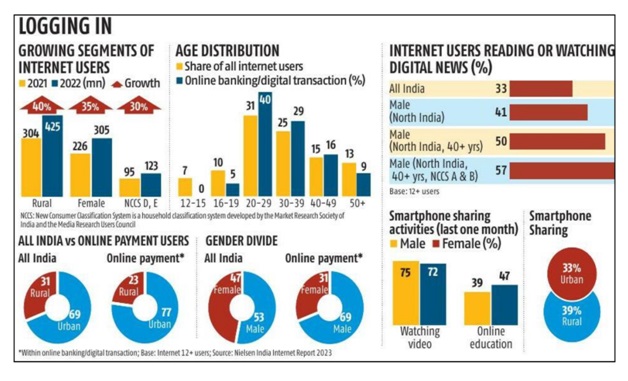
- 09 Oct 2023
Why in the News?
The recent announcement of the Digital India Act, 2023 (DIA) marks a substantial step forward in constructing a forward-looking legal framework for India's thriving digital environment. This development is particularly timely, coinciding with the nation's ongoing digital transformation. The proactive approach by the Ministry of Electronics and Information Technology (MeitY) harmonizes with India's ambitious 'Digital India' initiative.
Current Status of Internet Usage in India:
- As of May 2023, India boasted a substantial 759 million Internet users.
- According to Statista, the Internet penetration rate in India reached 47.0% of the total population in early 2022.
- India stands as the second-largest online market across the globe, following China.
- This achievement is attributed to the growing affordability of smartphones, the extensive reach of mobile broadband networks, and the government's initiatives to bolster digital literacy.
- The character of internet usage has also transformed, with the rise of various intermediaries and the proliferation of new forms of user harm, including cyberstalking, trolling, and doxing.
What is the Digital India Act, 2023?
Objectives:
- To establish adaptable regulations that align with the evolving trends in technology and are amenable to updates according to the nation's digital infrastructure requirements.
- To provide a readily accessible adjudication mechanism for addressing online civil and criminal offenses.
- To ensure timely remedies for citizens, resolving cyber disputes and upholding the rule of law on the internet.
- To create a legislative framework grounded in overarching guiding principles to ensure compliance.
Key Components:
- Open Internet: As envisioned by the Indian government, an open internet should embody elements such as choice, competition, online diversity, fair market access, ease of doing business, and streamlined compliance for startups.
- These attributes serve to prevent the concentration of power and gatekeeping.
- Online Safety and Trust: The Act places a significant focus on protecting users from cyber threats, including issues like revenge porn, defamation, and cyberbullying.
- It aims to advocate for digital rights such as the Right to be Forgotten and the Right to Digital Inheritance (the passing down of digital assets to designated beneficiaries), safeguard minors and their data from addictive technology, and moderate the spread of fake news on social media platforms.
- Accountable Internet: The Act seeks to enhance accountability in internet use and activities.
- It introduces legal mechanisms for addressing complaints, upholds constitutional rights in cyberspace, promotes algorithmic transparency, periodic risk assessments, and disclosure norms for data collected by intermediaries.
Salient Features:
- The Digital India Act, 2023 (DIA) will serve as a replacement for the Information Technology Act of 2000 (IT Act), which has become inadequate in addressing the evolving challenges and opportunities brought about by the rapid growth of the internet and emerging technologies.
- DIA's framework will prioritize crucial aspects including online safety, fostering trust, ensuring accountability, upholding the principles of an open internet, and regulating cutting-edge technologies like artificial intelligence and blockchain.
- DIA will collaborate with other pertinent laws and policies, encompassing the Digital Personal Data Protection Act, Digital India Act Rules, National Data Governance Policy, and amendments to the Indian Penal Code pertaining to Cyber Crimes.
- DIA will reassess the 'safe harbor' principle, which provides legal protection to online platforms such as Twitter and Facebook against liability for user-generated content.
- DIA introduces stringent Know Your Customer (KYC) requirements for wearable devices used in retail sales, backed by criminal law provisions and penalties.
- DIA aligns with the Digital India Goals for 2026, aimed at cultivating a USD 1 trillion digital economy and shaping the trajectory of global technologies.
Why the Digital India Act is Necessary?
- Outdated Regulations: The current IT Act of 2000 was conceived during a time when the internet had a mere 5.5 million users and is now inadequate to address the complexities of today's internet landscape.
- With 850 million users, numerous intermediaries, and emerging issues like cyberstalking and doxing, the IT Act falls short of addressing these modern challenges.
- Inadequacy of Existing Regulations: Despite the presence of regulatory components such as Intermediary Guidelines, Digital Media Ethics Code, and data protection rules, they prove insufficient in governing cutting-edge technologies.
- Adapting to Technological Advancements: With advancements like AI, Blockchain, and IoT, the legal framework must evolve to effectively address their distinctive challenges.
- This entails enhancing cybersecurity measures, fortifying data protection, and regulating emerging tech sectors.
- Addressing E-commerce and Online Content: The surge in e-commerce, digital transactions, and online content sharing necessitates up-to-date regulations.
- The Digital India Act will handle matters concerning consumer protection, electronic contracts, and content moderation on social media platforms.
- Global Alignment and Best Practices: To actively engage in the global digital landscape, India's regulations must be in harmony with international standards and best practices.
Challenges in Implementing Digital India Act (DIA), 2023:
- Balancing regulation with innovation and economic growth: Tighter regulations, especially in emerging tech sectors, might unintentionally hinder entrepreneurial endeavors and discourage foreign investments.
- Freedom of Expression: The review of the 'safe harbor' principle for online platforms has the potential to affect freedom of expression.
- Balancing regulatory needs without curbing this fundamental right is a delicate task.
- Resource and Infrastructure Requirements: Effective enforcement of the DIA will demand substantial resources, expertise, and infrastructure.
- Investments in these areas are essential.
- Balancing Stakeholder Interests: Striking a balance between the interests of various stakeholders, including tech giants and citizens' rights, presents a significant challenge.
- Ensuring that all perspectives are considered in the implementation process is crucial.
- Surveillance and Privacy Concerns: Critics argue that certain provisions of the act may grant excessive surveillance powers to the government, potentially compromising privacy rights.
- Strong safeguards should be integrated to prevent abuse of power and privacy violations.
- Data Localization and Cross-Border Data Flows: The act's stance on data localization is a contentious issue.
- While localization can enhance data protection and security, it may disrupt cross-border data flows, impacting global businesses reliant on efficient data transfers.
How Other Countries Approach Data Privacy Regulation:
- Approximately 70% of countries globally have implemented data protection legislation, as reported by the United Nations trade agency UNCTAD.
- The European Union's General Data Protection Regulation (GDPR), enacted in 2018, is often considered the most stringent privacy and security law globally and serves as a global standard.
- Various nations, including China and Vietnam, have recently strengthened regulations concerning the cross-border transfer of personal data.
- In 2018, Australia enacted a bill that granted law enforcement access to encrypted data.
Way Forward for Effective Implementation of Digital India Act (DIA), 2023:
- Stakeholder Involvement: Engage all relevant stakeholders, including government bodies, tech companies, legal experts, and civil society, in the drafting and execution of the act.
- This collaborative effort will lead to a balanced and comprehensive legal framework.
- Balancing Regulation and Innovation: While stricter regulations, particularly in emerging tech fields, are essential, they should be carefully designed to avoid unintentionally stifling entrepreneurship and deterring foreign investments.
- Striking the right balance between regulation and innovation is imperative.
- Collaboration and Capacity Enhancement: Invest in building the capacity of law enforcement agencies, the judiciary, and regulatory bodies to ensure effective enforcement of the DIA.
- International Alignment: Collaborate with other countries and international organizations to align the DIA with global best practices and standards in the digital sphere.
- Public Awareness: Conduct public awareness campaigns to educate citizens about their rights and responsibilities in the digital realm, promoting a culture of digital literacy.
Conclusion
The effectiveness of the Digital India Act, 2023 will hinge on its practical implementation. Striking the right balance between enforceability, privacy protection, and fostering innovation is key. Addressing these considerations with care, this act holds the promise of sculpting a digital environment that benefits not only individuals and businesses but the entire nation.
Controversies Arising from a Potential Nobel Prize for mRNA COVID Vaccines (The Hindu)
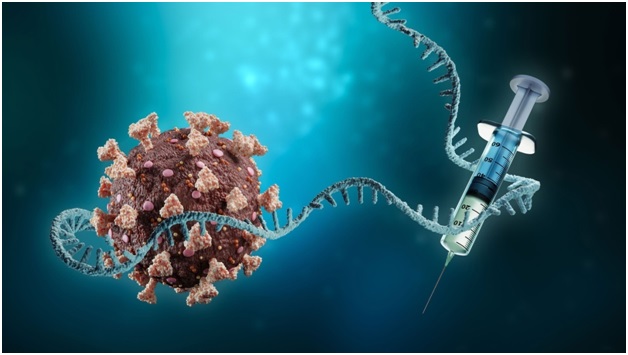
- 05 Oct 2023
Why is it in the News?
The 2023 Nobel Prize for Physiology or Medicine has been granted to Katalin Karikó and Drew Weissman in recognition of their contribution to the development of mRNA vaccine technology. While the Nobel Prizes are intended to honor achievements that have benefited humanity, a strict assessment of scientific accomplishments raises questions about whether the subset of mRNA vaccines used during the COVID-19 pandemic fully aligns with these standards.
What is an mRNA Vaccine?
- Messenger RNA (mRNA) is a type of single-stranded RNA crucial for protein synthesis.
- It is synthesized from a DNA template during the transcription process.
- mRNA vaccines function by introducing a specific mRNA fragment that corresponds to a viral protein, often a segment of a protein located on the virus's outer surface.
- When this mRNA enters cells, it instructs them to produce the viral protein.
- As part of the body's natural immune response, the immune system recognizes this foreign protein and generates specialized proteins known as antibodies.
- Antibodies play a vital role in defending the body against infections by identifying individual viruses or pathogens, binding to them, and marking them for elimination.
- Even after the body has cleared the pathogen, these antibodies persist in the body, providing long-lasting immunity and enabling a rapid response if the same pathogen is encountered again.
Challenges Surrounding Nobel Recognition for mRNA Vaccines:
Prioritizing Profit over Ethics
- Katalin Karikó and Dr. Weissman initiated their collaboration on mRNA technology while at the University of Pennsylvania in the late 1990s.
- The University granted patents for this technology to mRNA RiboTherapeutics, which subsequently sublicensed them to CellScript.
- CellScript, in turn, sublicensed the technology to Moderna and BioNTech for substantial sums of $75 million each.
- Karikó joined BioNTech as a senior vice president in 2013, leading to the company's partnership with Pfizer to develop an mRNA-based COVID-19 vaccine in 2020.
Substantial Research Supported by Public Funds
- A considerable portion of the research underpinning many new drugs and vaccines is conducted with funding from governments and public resources.
- This phase of drug development is both risky and time-consuming, involving the exploration of potential biomolecular targets within the body that can be targeted by drugs to treat specific ailments, as well as the identification of suitable chemical candidates.
- The estimated costs and timeframes for this stage typically range from $1 billion to $2.5 billion and several decades, respectively.
Later Commercialization of Publicly Funded Research by Private Entities
- Private companies then proceed to commodify and commercialize the outcomes of this research, often reaping substantial profits—frequently at the expense of the very taxpayers who funded the initial research.
- For instance, when Moderna and Pfizer began manufacturing their mRNA-based COVID-19 vaccines, they prioritized securing ample supplies for themselves before allowing exports to the global community.
- Furthermore, the use of these vaccines in other countries, including India, faced complications due to protracted negotiations related to pricing and liability.
The Challenges Encountered by the COVAX Program:
The COVAX Program
- The COVID-19 Vaccines Global Access program, abbreviated as COVAX, was a global initiative with the goal of ensuring fair access to COVID-19 vaccines. It was led by the GAVI vaccine alliance.
- COVAX constituted one of the four essential components of the Access to COVID-19 Tools Accelerator, initiated in 2020 by the WHO, the European Commission, and the government of France in response to the COVID-19 pandemic.
- This initiative orchestrated international efforts to provide equitable access to COVID-19 tests, treatments, and vaccines for low- and middle-income countries.
- UNICEF played a crucial role as the primary delivery partner, leveraging its extensive experience as the world's largest vaccine purchaser.
- UNICEF was responsible for procuring COVID-19 vaccine doses, managing logistics, ensuring country readiness, and overseeing in-country vaccine distribution.
- As of October 19, 2020, 184 countries had become participants in the COVAX program.
Challenges Faced by the COVAX Program
- Unfortunately, the COVAX program encountered significant obstacles in achieving its objectives.
- Notably, India, Russia, and China were notable exporters of billions of vaccine doses.
- However, their efforts faced issues related to the potential overestimation of manufacturing capacity in India, as well as concerns about the quality of vaccines from Russia and China.
- Moreover, there were reports of several African countries having to discard large quantities of vaccine doses due to their proximity to expiration dates when they were exported.
The Corbevax Initiative: Contrasting Dr. Karikó's Journey
- A team of researchers from the Baylor College of Medicine in Houston, among others, pioneered the development of a protein sub-unit vaccine called Corbevax.
- This vaccine was subsequently licensed to India's Biological E for production, notably without pursuing a patent.
- In February 2022, a Texas politician penned a letter recommending the vaccine's creators for the Nobel Peace Prize.
- They were acknowledged for their remarkable efforts in developing and distributing an affordable COVID-19 vaccine worldwide, free from patent constraints.
- Kenya's Ambassador to the United Nations also lauded these researchers for providing essential ethical and scientific guidance on a global scale.
In Conclusion
- Scientists should not be faulted for seeking to benefit from their research.
- However, the narrative of mRNA vaccines during the COVID-19 pandemic has raised questions about this selflessness.
- Throughout the pandemic, this technology had the potential to benefit everyone but faced certain limitations.
- Therefore, it is essential for history to accurately record the events that unfolded during the pandemic, contrasting with what the 2023 Nobel Prize in Medicine signifies.
Cancer Screening in India (The Hindu)

- 04 Oct 2023
Why is it in the News?
As only a handful of Indian districts currently meet the Health Ministry's cancer screening standards, the ICMR is preparing to address this issue.
The Indian Council of Medical Research (ICMR) has called for Expressions of Interest to advance research aimed at speeding up cancer screening, early diagnosis, and treatment.
About Cancer:
Cancer is a complex and devastating group of diseases characterized by the uncontrolled growth and spread of abnormal cells in the body.
- Cellular Aberration: At its core, cancer begins with mutations in the DNA of normal cells.
- These mutations disrupt the intricate mechanisms that regulate cell growth and division.
- Uncontrolled Growth: Cancer cells multiply uncontrollably, forming a mass of tissue known as a tumor. Not all tumors are cancerous; benign tumors are non-cancerous and do not invade nearby tissues.
- Malignant Tumors: Cancerous or malignant tumors are invasive and can infiltrate nearby tissues and even spread to distant parts of the body through the bloodstream or lymphatic system.
- This process is called metastasis.
- Diverse Types: There are over 100 different types of cancer, each originating in specific cell types or tissues.
- Common types include breast, lung, prostate, and colon cancer.
- Risk Factors: Several factors can increase the risk of developing cancer, including genetics, exposure to carcinogens (such as tobacco and UV radiation), poor diet, lack of physical activity, and certain infections.
- Survival Rates: Cancer survival rates have improved over the years due to advances in research and treatment.
- Early diagnosis and prompt intervention often lead to better outcomes.
Cancer incidence and mortality in India:
- Cancer's Impact in India: Cancer is a formidable public health concern in India, where it stands as the third-highest country for cancer incidence, following China and the United States.
- Future Trends: Projections from the Global Cancer Observatory indicate a noteworthy 57.5% surge in cancer cases in India between 2020 and 2040.
Trends in cancer incidence and their contributing factors:
- Divergent Trends in Cancer Incidence: In India, there are varying trends in cancer incidence.
- Notably, cervical cancer rates have dropped from 45 to 10 cases per 100,000 people over the past five decades.
- In contrast, breast cancer rates are on the rise, especially in urban areas like Hyderabad, where it stands at 45 cases per 100,000.
- Factors Behind the Trends: Cervical cancer's decline can be attributed to factors like delayed marriages, smaller family sizes, improved hygiene practices, and the introduction of the human papillomavirus (HPV) vaccine.
- The increase in breast cancer cases is linked to late marriages, delayed childbirth, reduced breastfeeding, and diets high in protein.
- Unlike cervical cancer, there's no known specific cause for breast cancer, which makes screening crucial.
- Tobacco-related cancers, such as oral and esophageal cancer, have seen a decrease thanks to tobacco control laws that have curbed public smoking.
- Lung cancer, driven by both pollution and smoking, remains a concern.
- In regions like Arunachal Pradesh, indoor fires during winter contribute to high lung cancer rates.
- Unfortunately, lung cancer often goes undiagnosed until advanced stages, resulting in a low survival rate.
Improvements in cancer treatments and the infrastructure challenges in India:
- Advancements in Cancer Treatments: Progress in cancer treatment can be measured by examining cure rates for different types of cancers.
- For instance: Over the past half-century, the cure rate for pancreatic cancer has doubled, moving from 3% to 6%.
- The cure rate for prostate cancer has seen significant improvement, rising from 60% to 100%.
- Newer treatments have substantially boosted breast cancer survival rates, elevating them from 50% to 90%.
- Challenges in Cancer Care Infrastructure: Despite these treatment advancements, India faces challenges in its cancer care infrastructure, encompassing seven critical pillars: prevention, surgery, chemotherapy, radiotherapy, imaging, laboratory diagnostics, and palliative care.
- In developing countries, including India, the World Health Organization (WHO) recommends one radiotherapy machine per million people. Given India's population of 1.4 billion, this would require 1,400 machines. However, the country currently has only 700 such machines, highlighting a substantial deficit in cancer care infrastructure.
Steps required to reduce overall cancer mortality in India, similar to the approach in the US:
- Prioritize Screening: The initial step should focus on widespread cancer screening.
- The government has already initiated this process by upgrading health and wellness centers to screen for the three most prevalent cancers in India - breast, cervical, and oral (which together account for 34% of cancer cases).
- Accessible and Affordable Treatment: Effective screening should seamlessly lead to accessible and affordable hospital treatment.
- Ensuring that cancer care is within reach for all is crucial.
- Expand Cancer Care Facilities: The existing ratio of one cancer care facility for every 5 crore people in India must be improved.
- Increasing the number of facilities is essential to guarantee timely diagnosis and treatment.
- Early Diagnosis and Prompt Treatment: The key goal is to ensure early cancer diagnoses and prompt treatment to improve survival rates.
- Enhanced Coordination: Coordination is vital. Currently, various government programs operate independently and in isolation.
- Streamlining and synchronizing these efforts can enhance the overall impact of cancer control initiatives in India.
ICMR Project to Enhance Cancer Screening at the District Level:
- This project is scheduled to run for four years, including six months for preparatory activities and another six months for analysis and interpretation.
- It encompasses formative phases, implementation, and evaluation.
- The Indian Council of Medical Research (ICMR) aims to enhance both the coverage and quality of cancer screening within the existing healthcare system, employing established and validated methods.
- The plan involves engaging non-specialist physicians and other healthcare personnel within a supportive healthcare framework to conduct cancer and precancerous condition screenings.
- A key objective is to ensure that individuals testing positive are promptly connected to facilities for early diagnosis and treatment.
- Active involvement of local communities is crucial to motivate the target population to undergo screening for early detection and treatment.
- For instance, research has shown that frontline health workers like Accredited Social Health Activists (ASHAs) can promote and perform home-based cancer screening, which has led to higher participation rates due to the privacy and convenience it offers.
Mains Question:
- What strategies can be implemented to improve cancer screening rates and access to timely treatment in India, especially considering the existing deficit in cancer care facilities and the need for coordinated efforts? (10M)
Presidential Election in Maldives and India (The Hindu)
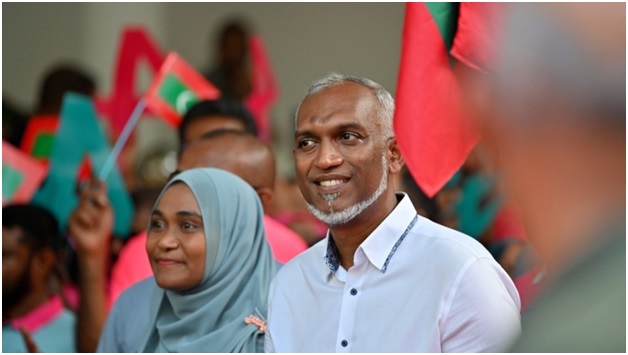
- 02 Oct 2023
Why is it in the News?
Mohamed Muizzu, the leading candidate from the Opposition, has secured the position of President in the Maldives. He emerged victorious in a closely contested election, defeating the incumbent Ibrahim Mohamed Solih, who had friendly relations with India.
News Summary About Maldives Presidential Election:
- The Maldives has chosen Mohamed Muizzu as its new president, ousting the incumbent Ibrahim Mohamed Solih, known for his pro-India stance.
- President Solih faced criticism from the Opposition for his 'India first' policy.
Key Points:
- In the second round of the Presidential Election, Mr. Muizzu secured approximately 54% of the vote, while Mr. Solih garnered nearly 46%.
- The run-off election witnessed a higher voter turnout of 86%, surpassing the 79.85% recorded in the first round, which was the lowest in Maldivian presidential election history.
- The initial round did not produce a clear winner, as no candidate managed to obtain more than 50% of the votes.
Electoral System in the Maldives:
- Parliament Name: The legislative body in the Maldives is known as Majlis or People's Majlis.
- Parliament Structure: Maldives follows a unicameral parliamentary structure.
- First-Past-the-Post Majority System: In the Maldives, both Parliament and Council elections utilize the first-past-the-post majority system, where voters cast their ballots for a single candidate.
- Term Duration: The Majlis consists of 87 members, each directly elected for a five-year term from 87 individual single-member constituencies.
- Two-Round System: The President of the Maldives is elected using a two-round system.
- If no candidate secures more than 50% of the votes in the first round, a second round or run-off is conducted.
- 2023 Maldives Election: The initial round of the election featured eight candidates, marking the highest number of candidates so far.
- The Maldives has a population of approximately 5.2 lakh people.
- As per the Election Commission of the Maldives, there are 2.8 lakh eligible voters, with around 1.6 lakh being members of various political parties.
Evolution of the Executive Presidency System in the Maldives:
- Single-Party System Until 2008: The Maldives operated under an Executive Presidency system since 1968.
- It adhered to a single-party system until 2008, where the President was elected for a five-year term through a referendum.
- Maumoon Abdul Gayoom's 30-Year Rule: Ibrahim Naseer served as the first executive President from 1968 to 1978.
- Due to political protests in 1978, Naseer did not seek re-election for a third term.
- In 1978, the Maldivian parliament selected Maumoon Abdul Gayoom as the succeeding President.
- Gayoom led the nation for an astonishing 30 years, until 2008, effectively managing protests and famously thwarting a coup attempt with India's assistance in 1988.
- Era of the Multi-Party System: In response to protests by various factions, Gayoom initiated political reforms in 2004.
- Political parties were officially registered in 2005, and a new Constitution was adopted in 2008.
- These changes paved the way for Presidential elections every five years, embracing a multi-party system.
India's Engagement with Maldivian Politics:
- India's relationship with Maldivian politics has been a blend of experiences, with the Solih government being the most favorable thus far.
- India collaborated closely with Abdul Gayoom's administration for three decades.
- When Mohamed Nasheed assumed power in 2008, India expressed its support through then Vice President Hamid Ansari's attendance at his inauguration ceremony.
- Tensions arose in 2012 when the Maldivian government terminated the GMR contract for the Maldives' airport, straining the bilateral relationship significantly.
- Following Yameen's rise to power in 2013, he pursued a more aggressive courtship with China.
- During his tenure, the Maldives joined President Xi Jinping's Belt and Road Initiative.
- When India and Western lenders hesitated to extend loans to Yameen's government due to allegations of human rights violations, he turned to Beijing, which provided funding without stringent conditions.
- Solih's victory in the 2018 elections was met with relief in Delhi.
- Prime Minister Modi even attended Solih's swearing-in ceremony during his visit to the Maldives.
Potential Shift in Maldives' Foreign Policy:
- The victory of Muizzu might indicate a possible adjustment in the Maldives' foreign policy.
- He enjoys the support of former President Abdulla Yameen, known for his pro-China stance and 'India out' campaign.
- Despite this, local observers in the Maldives believe that Mr. Muizzu is unlikely to abruptly sever ties with India.
- The newly elected leader is expected to pursue a balanced approach in managing India-China relations.
- Meanwhile, India hopes for the continuity of its various infrastructure projects in the Maldives.
- India's recent initiatives in the Maldives encompass a wide range of projects, including water and sanitation in 34 islands, road construction, land reclamation as part of the Addu development project, a cancer hospital, a port project, a cricket stadium, two airport development projects, the Greater Male connectivity project with bridges, causeways, and roads, social housing projects, mosque renovations, and the establishment of the national college for police.
- Estimates indicate that Indian aid to the Maldives from 2018 to 2022 exceeded Rs 1,100 crore, more than double the amount provided in the preceding five-year period (approximately Rs 500 crore).
Mains Question:
- Evaluate the potential shifts in the Maldives' foreign policy under President Mohamed Muizzu, and elucidate the impact on its relationship with India, given historical dynamics and infrastructure projects. (15M)
Law Commission against lowering the age of consent under the POCSO Act (The Hindu)
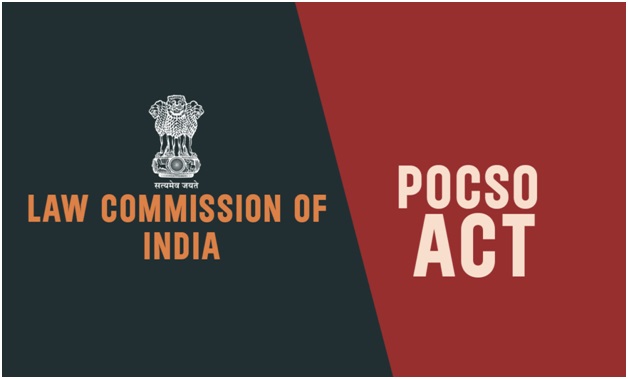
- 30 Sep 2023
Why is it in the News?
The Law Commission advises maintaining the current age of consent at 18 years under the Protection of Children from Sexual Offences (POCSO) Act. Reducing it could harm efforts to combat child marriage and trafficking.
Context:
- The Law Commission, led by Justice (Retired) Ritu Raj Awasthi, submitted Report No. 283 to the Law Ministry.
Key Points from the 22nd Law Commission Report:
- It advises against lowering the age of consent, citing potential negative impacts on combating child marriage and trafficking.
- The panel recommends amendments to the POCSO Act, 2012, addressing cases where 16 to 18-year-olds give tacit approval, not legal consent.
- Courts are advised to handle adolescent love cases with caution to maintain a balanced approach, prioritizing the child's best interests.
- The Law Commission also proposed phased implementation of e-FIR registration, starting with offenses carrying up to three years of imprisonment. This move aims to address delays in FIR registration and enable real-time reporting of crimes.
The Protection of Children from Sexual Offences (POCSO) Act:
- POCSO Act, enacted in 2012 and administered by the Ministry of Women and Child Development, is India's first comprehensive law addressing child sexual abuse.
- It aims to safeguard children from sexual assault, harassment, and pornography and establishes Special Courts for such cases.
- In 2019, amendments were made to enhance penalties for specific offenses, discouraging perpetrators and promoting a dignified upbringing.
- Key Features:
- Gender-neutral definition: The Act defines a child as "any person" below 18 years.
- Non-reporting as an offense: Those responsible for institutions must report sexual offenses involving subordinates, with penalties for failure to do so.
- No time limit for reporting abuse: Victims can report offenses at any time, even years later.
- Confidentiality of victim's identity: The Act prohibits the disclosure of the victim's identity in any media without authorization from special courts.
- Challenges:
- Rising abuse, especially during the Covid-19 pandemic, with the emergence of new forms of cybercrime.
- Lack of awareness among minors, parents, and society.
- Concerns about the criminalization of consensual sexual activity among adolescents prompted calls for legislative review by CJI D Y Chandrachud.
The Issue of Minors Facing Legal Action for Consensual Acts:
- Minors aged 16 to 18 engaging in consensual activities that could be considered sexual under the law face potential bookings under POCSO.
- Even though these cases of adolescent consensual activity may not always lead to the conviction of a minor, the legal framework could lead to the denial of bail and prolonged detention.
- A study revealed that in West Bengal, Assam, and Maharashtra, one in every four cases under the POCSO Act involved what could be termed as "romantic cases," where the victim was in a consensual relationship with the accused.
What Does 'Age of Consent' Mean?
- The 'age of consent' is the legal threshold at which a person is deemed capable of giving consent for sexual activities. Before the POCSO Act, this age was set at 16.
- Under the POCSO Act, any sexual activities involving individuals under 18 are classified as criminal offenses, regardless of whether mutual consent exists among minors.
- This determination is rooted in the legal assumption that individuals under 18 lack the capacity to provide consent within the legal framework.
China Rejects Expanding CPEC Cooperation in Energy, Water, and Climate with Pakistan (The Hindu)
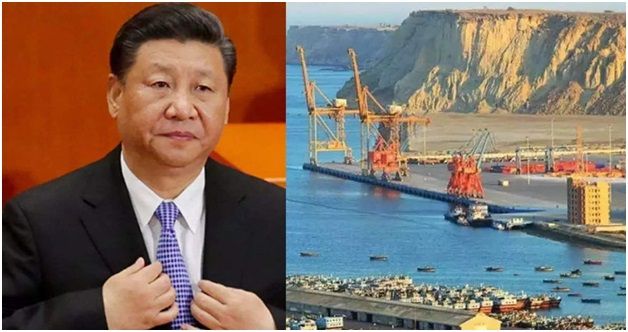
- 29 Sep 2023
Why is it in the News?
China has refused to further expand cooperation in the areas of energy, water management, and climate change under the multi-billion dollar China-Pakistan Economic Corridor (CPEC), it emerged on September 25, signalling a strain in the 'ironclad' friendship between the two all-weather allies.
Summary of News: Challenges Arise as China Rejects Pakistan's CPEC Expansion Proposals:
- In a significant development, Beijing has declined multiple investment proposals from Islamabad, spanning various sectors like energy, tourism, water management, and climate change, all within the ambit of the China-Pakistan Economic Corridor (CPEC).
- These decisions were revealed through the minutes of the 11th Joint Cooperation Committee (JCC) meeting, where the future of CPEC projects is discussed.
- The JCC serves as a pivotal decision-making body for CPEC matters.
- China's reluctance to expand cooperation in these specific areas within the CPEC framework highlights the current challenges faced by both nations in their efforts to further strengthen their economic partnership.
What is CPEC?
- CPEC, short for the China-Pakistan Economic Corridor, is a vast network of infrastructure projects spanning 3,000 kilometers.
- It connects China's northwest Xinjiang Uygur Autonomous Region to the Gwadar Port in Pakistan's western province of Balochistan.
- This initiative represents a bilateral partnership between Pakistan and China, designed to enhance connectivity within Pakistan through the development of highways, railways, pipelines, as well as energy and industrial infrastructure projects.
- The primary objective of CPEC is to enable China to establish access to the Middle East and Africa via the Gwadar Port, providing a strategic link to the Indian Ocean.
- In return, China actively supports various development projects in Pakistan, addressing the country's energy shortages and assisting in stabilizing its economic situation.
- It's important to note that CPEC is an integral part of the broader Belt and Road Initiative (BRI), initiated in 2013.
- The BRI aims to create an extensive network of land and sea routes connecting Southeast Asia, Central Asia, the Gulf region, Africa, and Europe, fostering international economic cooperation and development.
What are the Implications of CPEC for India?
- Challenges to Sovereignty: India has consistently voiced opposition to the CPEC project because it passes through the Pakistan-occupied Kashmir territory of Gilgit-Baltistan, a disputed region claimed by both India and Pakistan.
- The corridor is also perceived as a potential alternative economic route for the Indian-administered Kashmir Valley.
- Regional Optimism: Despite India's official stance, key stakeholders in the Indian state of Jammu and Kashmir have expressed optimism about the potential benefits of the CPEC project.
- Some local business and political leaders have even proposed declaring both sides of the Line of Control (LoC) in Kashmir as a 'Special Economic Zone.'
- Territorial Implications: The success of CPEC could bolster Gilgit-Baltistan's international recognition as part of Pakistani territory, undermining India's claim over this region, which spans 73,000 square kilometers and is home to over 1.8 million people.
- China's Maritime Influence: Once fully operational, CPEC could offer China a more efficient trade route to major U.S. ports on the East Coast, potentially reshaping international trade dynamics.
- This could grant China greater influence over global goods movement between the Atlantic and Pacific oceans.
- China's 'String of Pearls': CPEC aligns with China's broader strategy of expanding its presence in the Indian Ocean, often referred to as the 'String of Pearls.'
- This involves establishing a network of airfields and ports in countries surrounding India.
- Gwadar port's control would solidify China's dominance in the Indian Ocean region.
- Pakistan's Economic Boost: CPEC has the potential to accelerate Pakistan's economic development.
- With easier access to Chinese raw materials, Pakistan's textile and construction material industries could become regional leaders, potentially impacting Indian exports in similar sectors.
- Strengthening BRI and Chinese Influence: CPEC is a significant component of China's Belt and Road Initiative (BRI), aimed at enhancing trade connectivity with Eurasia.
- A more integrated China in the global economy may challenge India's aspirations for a permanent seat on the UN Security Council.
Way forward
- India has the opportunity to capitalize on its strategic positioning by collaborating with like-minded nations and actively engaging in multilateral endeavors such as:
- Asia-Africa Growth Corridor: This India-Japan economic cooperation agreement holds significant promise for India's strategic interests and serves as a potential counterbalance to China's influence.
- Blue Dot Network: Championed by the United States, the Blue Dot Network is a multi-stakeholder initiative that unites governments, the private sector, and civil society in the pursuit of establishing high-quality, trustworthy standards for global infrastructure development.
- It is poised to become a globally recognized system for evaluating and certifying infrastructure projects, particularly in the Indo-Pacific region.
Parliament Panel Findings on the New Education Policy, 2020 (The Hindu)
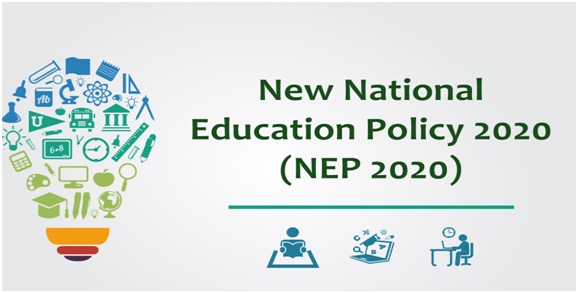
- 27 Sep 2023
Why is it in the News?
The Education Committee of the Parliament has just presented a report about how the National Education Policy (NEP) from 2020 is being put into action in higher education.
Assessment in the report:
- The report checks how well the National Education Policy (NEP) from 2020 is being used in higher education and what progress has been made.
- In India, there are currently 1043 universities.
- Most of them, around 70%, are run by state laws, while about 18% are managed by the Central Government.
- When it comes to students, 94% of them study at state or private institutions, and only 6% are in central institutions.
- The report says that more students are going to college now compared to a few years ago. This is measured using something called Gross Enrollment Ratio (GER), which has gone up from 24.1% in 2016-17 to 27.3% in 2020-21. It's also improved for ST and SC students during this time.
- GER is like a way to see how many students in the right age group (18-23 years) are in higher education compared to the total population.
Report's Status of Implementation:
- Things are going well with the implementation of NEP 2020, thanks to different initiatives like PM Schools for Rising India (PM SHRI), e-VIDHYA, and NIPUN Bharat. The goal is to change higher education to be more inclusive, flexible, and meet global standards.
- Jammu and Kashmir is leading the way by being one of the first places in India to start using NEP 2020 in all Higher Education Institutions starting from 2022.
- NEP 2020 wants students to become more creative and innovative. It encourages connections between colleges and industries and works on joint programs.
- Indian universities will get more freedom to set up campuses in other countries and welcome top 100 universities from around the world to work in India.
- NEP 2020 also allows students more flexibility with something called "Multi Entry and Multiple Exit (MEME)" options, which gives them more choices in their education.
Issues Related to NEP:
- Accessibility: Some students in economically disadvantaged areas can't easily access higher education because of money problems, where they live, and because they might feel like they don't belong due to stereotypes.
- Multiple Entry And Multiple Exit (MEME)System: Even though the MEME system seemed flexible, the report suggests it might not work as well in India as it does in Western countries.
- Language Barrier: Most higher education institutions use English to teach, but not many teach in local languages. This can be a problem for students who are more comfortable in their local language.
- Lack of Funding: India needs to spend more on education. Right now, it's only about 2.9% of the country's total income (GDP), but experts say it should be 6%. This means there's not enough funding for education.
Way Forward
- By 2030, the goal is to have at least one multi-purpose higher education institution in every district in India. And by 2035, they want 50% of students to be in higher education, including vocational training.
- They want to focus more on research and innovation to help India file more patents and improve its global ranking.
- To get more money for education, Higher Education Financing Agency (HEFA) should look for funds from sources other than the government, like private companies, foundations, and international banks.
- They plan to make better use of technology in education. Creating a National Educational Technology Forum (NETF) will help expand digital resources and make India a top place for knowledge.
- They also want to make it easier for students who study different subjects to get credit for their work. This will help them move between schools and colleges more smoothly.
National Education Policy (NEP) 2020:
- The National Education Policy, created in July 2020, shows what India's new education system will look like.
- A group led by Shri K. Kasturirangan made this policy.
- NEP 2020 has five important ideas: making education affordable, easy to access, high-quality, fair for everyone, and making sure everyone is responsible for learning.
- It's like a big plan to change both basic and higher education in India by 2040.
- This is the third big education plan since India became independent. The earlier ones were made in 1968 and 1986.
- The new policy focuses on things like studying different subjects, using technology, writing well, solving problems, thinking logically, and getting experience in different jobs.
The Geopolitical Significance of the Israel Link in an Economic Corridor (The Hindu)
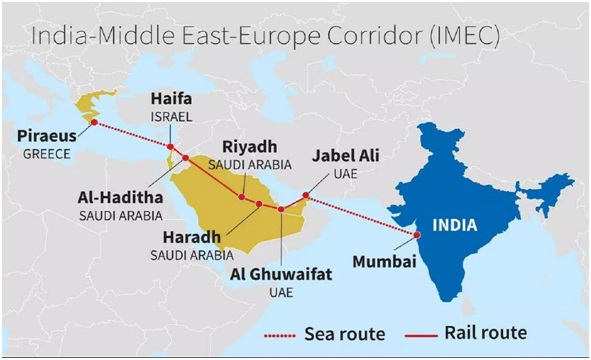
- 26 Sep 2023
Why is it in the News?
The G-20 Summit in 2023, hosted by India, achieved remarkable success despite the group's focus on economic matters in addressing global complexities. The global media recognized India's accomplishments during this summit for its diverse outcomes.
The significance of the G20 Delhi Declaration:
- A Collaborative Consensus: The declaration achieved a rare consensus among countries with diverse perspectives and interests.
- Balancing Act: The Delhi Declaration strikes a delicate balance by addressing global challenges without directly singling out specific nations for their actions.
- For instance, it refrains from naming Russia's aggression against Ukraine but underscores the importance of upholding the United Nations charter and principles of territorial sovereignty.
- Tailored to Diverse Interests: This balanced approach enables each member to identify elements in the declaration that align with their interests, contributing to its overall success.
- Showcasing India's Diplomatic Expertise: The declaration's significance lies in its ability to secure agreement from major world leaders, even in the midst of international power dynamics.
- Despite the absence of China's President Xi Jinping and Russian President Vladimir Putin at the summit, India demonstrated its diplomatic skill in bridging divides and fostering consensus among a diverse array of nations.
What is India-Middle East-Europe Economic Corridor (IMEEC)?
- One of the most significant outcomes of the G20 summit was the unveiling of the ambitious India-Middle East-Europe Economic Corridor, IMEEC.
- This corridor features a rail and sea route designed to facilitate the transportation of goods from India to Europe, passing through the UAE, Saudi Arabia, Jordan, and Israel.
- The project's implications extend beyond economic matters; it has the potential to reshape geopolitics in the future.
- Notably, it presents an intriguing challenge to China's Belt and Road Initiative, although this is just one aspect of its broader significance.
- The U.S. President hailed IMEEC as 'a truly monumental development,' emphasizing its transformative potential for all parties involved and the global community at large.
- The prompt endorsement of this project by the Israeli Prime Minister underscores Israel's eagerness to participate in this remarkable endeavor.
The Significance of IMEEC: A Game-Changer in Global Trade
- A Transformative Impact: IMEEC is poised to be a potential game-changer in the realm of global trade, offering an alternative to China's extensive strategic infrastructure investments.
- Enhancing Prosperity: This corridor promises to boost prosperity in the participating countries by facilitating the flow of energy and digital communications.
- It addresses the pressing need for infrastructure in lower- and middle-income nations, fostering economic growth.
- Strengthening Regional Ties: The improved infrastructure will not only drive economic growth but also promote closer ties among Middle Eastern countries.
- Countering China's Influence:
- IMEEC arrives at a juncture when Saudi Arabia and the UAE, traditional U.S. allies, have been strengthening their connections with China and the rapidly growing Eastern economies.
- China's role in the Middle East has expanded, including its involvement in brokering regional agreements.
- A Response to China's Belt and Road Initiative (BRI): Washington views IMEEC as an ambitious endeavor to counter China's Belt and Road Initiative, which aimed to enhance global connectivity with China's economy.
- Recent challenges, such as rising loan defaults and slowed investments, have cast doubts on the viability of China's BRI.
- Strategic Significance for India: For India, IMEEC holds immense geopolitical and trade importance.
- Concerns arose over China's connectivity projects in the region, and India faced hurdles, including Pakistan's refusal to grant overland access.
- India's attempts to establish credible connectivity through Iran faced challenges due to geopolitical complexities.
- IMEEC provides a solution by offering connectivity to both the Arabian Peninsula and Europe, addressing India's strategic concerns.
The Role of Israel in the Economic Corridor
- The U.S. initiative is designed to reshape the geoeconomic landscape of the Middle East through connectivity projects like IMEEC.
- The United States believes that these projects can address concerns among Gulf countries, reaffirm its commitment to the region, reduce tensions with Iran, and strengthen its leadership in the Gulf.
- However, achieving these strategic objectives hinges on advancing the normalization agenda outlined in the Abraham Accords, particularly with Saudi Arabia.
- Furthermore, the normalization of relations between Israel and Saudi Arabia is a critical prerequisite for the realization of this economic corridor.
Why Israel Wasn't Part of the Corridor Launch
- Unprecedented Middle Eastern Presence: India made history within the G20 by inviting the largest number of Middle Eastern countries ever to participate as guests in the summit.
- However, notably, India's strategic partner from the region, Israel, did not receive a similar invitation.
- Regional Considerations: India's decision to exclude Israel from the guest list may have been influenced by regional sensitivities, particularly regarding the preferences of Arab countries.
- U.S. Influence: The U.S. administration's avoidance of engaging with the Israeli Prime Minister for several months due to domestic politics may have played a role in Israel's role at the summit.
- Domestic Political Factors: In his statement following the corridor's launch, the Israeli Prime Minister expressed gratitude to the U.S. President but did not mention the Indian Prime Minister.
- This omission could be linked to Netanyahu's domestic political challenges and his previous inattention to U.S. foreign policy goals.
The Path Ahead
- Normalization of Saudi-Israel Relations: Saudi Arabia is open to ending its diplomatic boycott of Israel, but it comes with conditions.
- Saudis expect Israel to commit to the two-state solution and the well-being of the Palestinian people, even if the occupation persists for some time.
- Resolution of Israel-Palestine Conflict: Currently, on the sidelines of the UN General Assembly, Saudi Arabia, along with the Arab League and the EU, is collaborating with Egypt and Jordan to launch a 'Peace Day Effort.'
- This initiative aims to encourage Israelis and Palestinian leaders to find compromises.
- Achieving peace in the Israel-Palestine conflict is a formidable challenge, especially considering the rise of extremism on both sides.
- Waiting for Progress: The realization of the India-Middle East-Europe Economic Corridor may need to await progress in the Israel-Palestine situation.
The IMEEC plan faces a significant hurdle with Israel's aspiration for normalized relations with Saudi Arabia, which Riyadh does not currently endorse. Despite not formally joining, the new IMEEC effectively brings Saudi Arabia into the fold. With time, the corridor could create the economic and psychological conditions necessary for normalization.
Mains Question:
- Discuss the role of regional dynamics and international influences in the potential normalization of relations between Israel and Saudi Arabia, and how this could impact the progression of the India-Middle East-Europe Economic Corridor (IMEEC). (15M)
Latest NSO Data on Inflation in India (The Hindu)
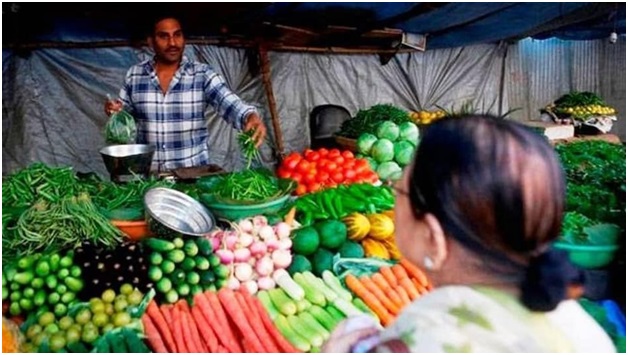
- 14 Sep 2023
Why it is in News?
- Recent data from the National Statistical Office (NSO) reveals that India's retail inflation rate decreased to 6.83% in August.
- This decline came after hitting a 15-month high of 7.44% in July 2023, primarily because of falling prices of food items, particularly vegetables.
- However, it's worth noting that the inflation rate still remains above the upper limit of the Reserve Bank of India's (RBI) medium-term inflation target range of 4+/-2%.
Key Points from the Recent NSO Data:
- In August 2023, retail inflation stood at 6.83%, marking the fourth instance this year and the seventh since August 2022 where it exceeded the upper limit of the target.
- Policymakers are increasingly concerned about high inflation rates.
- In its recent monetary policy review, the RBI maintained the key repo rate at 6.50% but raised the inflation projection for FY2024 from 5.1% to 5.4%.
- In the Index of Industrial Production (IIP), manufacturing showed improvement, rising to 141.2 in July from 135 a year ago and 141.1 in the previous month.
- Of concern, consumer durables contracted by 2.7% year-on-year in July 2023, indicating weaknesses and imbalances in consumption demand.
Key Insights from the Recent NSO Data:
- Consumer Confidence Declines: In August 2023, consumer sentiment dropped by 1.5%, breaking a streak of continuous increases since January 2023.
- This decline can impact the Indian economy and businesses, particularly in anticipation of the upcoming festive season.
- A significant contributor to this drop is a decrease in consumers' intentions to buy consumer durables like cars and TVs.
- This pessimism is not only due to stagnant perceived incomes but also concerns about future earnings.
- Persistent Inflation: According to RBI projections, inflation is expected to remain above 5% until the first quarter of 2024-25, with the likelihood of reaching 6.2% in the current quarter (July-September), which is beyond the RBI's comfort zone.
- Although overall food inflation has moderated, certain food items like cereals, pulses, and milk are experiencing upward price momentum.
- Factors such as irregular rainfall and low reservoir levels pose further risks to food inflation.
- Additionally, the recent surge in global crude oil prices is a cause for concern. However, the continuing deflation in the Wholesale Price Index (WPI) will have a delayed impact on Consumer Price Index (CPI) inflation.
- The government's decision to reduce cooking gas prices by Rs 200 per cylinder is expected to benefit domestic LPG consumers and those under the Pradhan Mantri Ujjwala Yojana (PMUY).
- India's GDP Growth Prospects: India's potential GDP growth rate has steadily decreased from around 8% just before the Global Financial Crisis of 2008-09 to 6% before the Covid pandemic.
- The potential GDP growth rate represents the rate at which an economy can expand without causing high inflation.
- The temporary increase in India's GDP growth rates in 2020-21 was primarily due to a lower base.
- The Indian economy faces various challenges, including a slowing global economy, elevated oil prices, and climate change. Economists estimate that, under a business-as-usual scenario, India's economy cannot grow more than 5% over the next decade.
- While this growth rate may be attractive from a global perspective, it may not be sufficient to meet the employment needs of India's large youth population.
What is Inflation?
- Inflation signifies an increase in prices, resulting in a decrease in the purchasing power of money over time.
- The rate at which purchasing power diminishes is measured by tracking the average price increase of a specific set of goods and services over a specified period.
- This price hike, typically expressed as a percentage, signifies that a unit of currency can purchase fewer goods and services compared to previous periods.
- In contrast, deflation occurs when prices fall, leading to an increase in purchasing power.
What are the causes of inflation?
- Demand-Pull Inflation: This occurs when the demand for goods and services exceeds their supply.
- When demand is high and supply is limited, businesses often raise prices, leading to inflation.
- It's often associated with strong economic growth.
- Cost-Push Inflation: In this scenario, rising production costs, such as increased wages or the cost of raw materials, force businesses to raise prices to maintain their profit margins.
- Oil price spikes are a classic example of cost-push inflation.
- Built-In Inflation: Sometimes called wage-price inflation, this happens when workers consistently demand higher wages to keep up with rising prices.
- Businesses then raise prices to cover increased labor costs, creating a cycle of inflation.
Categories:
- Consumer Price Index (CPI): This index calculates the weighted average of prices for a basket of goods and services at the consumer or retail level.
- Wholesale Price Index (WPI): The WPI monitors price changes for goods in stages before reaching the retail level.
Inflation Targeting in India:
- The RBI Act of 1934 establishes a legal and institutional framework for ensuring price stability while also considering growth objectives.
- In 2016, the Finance Act amended the RBI Act to establish a Monetary Policy Committee (MPC).
- The MPC issues a bi-monthly Monetary Policy Report to set India's benchmark interest rate, enhancing transparency and accountability in the country's monetary policy.
- The current mandate of the MPC is to maintain an annual inflation rate of 4% (with a tolerance range of +/-2%).
- If inflation exceeds this range for three consecutive quarters, the committee is accountable to the Government of India.
Mains Question:
- How does the RBI's inflation targeting framework impact India's economic stability and growth? Discuss the tools and effectiveness of RBI's strategies in controlling inflation. (10 M)
Ridding India of Food Insecurity (The Hindu)
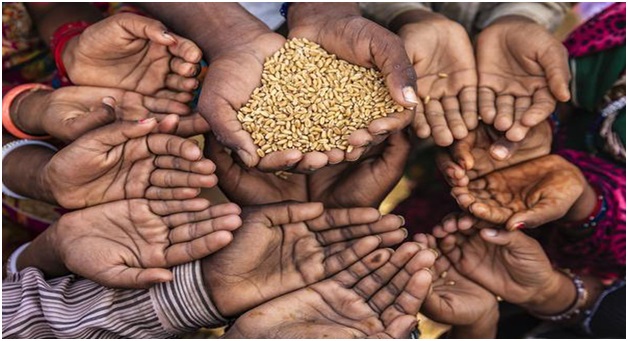
- 13 Sep 2023
Why it is in News?
- While India is currently the world's fastest-growing major economy, it is also grappling with a rapid increase in food-price inflation.
- The surge in food prices began to intensify notably in 2019 and has continued to rise in most subsequent years.
- In July of this year, annual inflation surpassed 11%, reaching its highest level in the past decade.
- One consequence of this sustained high food-price inflation is the possibility that a portion of the population may encounter difficulties in accessing food with sufficient nutritional value.
Key Findings of Concern:
- The 'State of Food Security and Nutrition in the World' report by the Food and Agriculture Organization (FAO) assesses the percentage of people in different countries who cannot afford a nutritious diet.
- Approximately 74% of the population is unable to afford a healthy diet.
- This likely results in decreased food consumption due to reduced purchasing power.
- Food prices in India have been on a consistent upward trend since 2019, with annual inflation exceeding 11% in July 2023, the highest rate in a decade.
- There has been a notable increase in the prevalence of anaemia, with over 50% of adult women estimated to be affected according to the latest National Family Health Survey conducted between 2019 and 2021.
- Critics argue that macroeconomic policies, including the Reserve Bank of India's focus on inflation control through measures like inflation targeting, are ineffective in addressing food inflation, which is primarily driven by supply-side factors.
Importance of Food Security:
- Enhanced Health and Nutrition: Food security plays a crucial role in improving the health and well-being of individuals by preventing malnutrition and its associated health issues, including stunted growth, cognitive impairment, and increased susceptibility to diseases.
- It's worth noting that malnutrition is responsible for the deaths of approximately 3.1 million children each year, accounting for nearly half of all child deaths under the age of 5.
- Economic and Social Stability: Food security contributes to the economic and social stability of individuals and nations by enabling increased productivity, income generation, and participation in trade.
- According to a World Bank study, the global cost of undernutrition, in terms of lost productivity and human capital, amounts to USD 3.5 trillion per year.
- Additionally, a United Nations report highlighted that food insecurity played a pivotal role in 58% of conflicts between 2017 and 2019.
- Poverty Alleviation: Food security is instrumental in reducing poverty as it enables people to afford and access nutritious food while also investing in other essential needs such as education and healthcare.
- These factors help break the cycle of poverty.
- National Security: Food security bolsters national security by ensuring a reliable food supply that is not vulnerable to external factors like global food prices or supply chain disruptions.
- Food insecurity can make nations susceptible to such factors, compromising their sovereignty.
- Sustainable Development: Food security aligns with sustainable development goals, particularly Goal 2: Zero Hunger.
- It also supports related goals such as poverty reduction, improved health, gender equality, and environmental sustainability, contributing to a holistic approach to sustainable development.
Causes of Food Insecurity:
- Impact of Russia-Ukraine Conflict: The Russia-Ukraine conflict has disrupted the global supply chain due to trade-related policies imposed by countries, exacerbating the global food crisis.
- Several nations have implemented food trade restrictions to bolster domestic supply and reduce prices.
- Rising Domestic Inflation: Many countries are grappling with domestic food inflation, which has intensified the issue of food insecurity.
- For instance, India has imposed bans on wheat and rice exports to support its domestic population.
- Climate Variability and Extremes: Climate change has significantly affected the availability and quality of critical resources like water, land, and biodiversity essential for food production.
- It has also led to shifts in the patterns and severity of pests, diseases, and natural disasters, resulting in reduced crop yields and livestock productivity.
- The Global Report on Food Crises highlights that weather and climate extremes were the primary drivers of acute food insecurity in 12 countries in 2021, impacting nearly 57 million people.
- Economic Slowdowns and Downturns: Economic slowdowns have diminished the income and job prospects of vulnerable populations, who typically allocate a substantial portion of their income to food purchases.
- These economic shocks have disrupted both the supply and demand for food, leading to increased food prices and reduced food quality.
Learning from the Green Revolution:
- India boasts a rich historical backdrop of the Green Revolution, a transformative period during the 1960s.
- The government initiated a supply-side approach, providing farmers with high-yield seeds, accessible credit, and guaranteed prices through procurement.
- This initiative achieved remarkable success, swiftly liberating India from dependence on food imports and fulfilling its ambition of self-sufficiency.
- However, certain strategic errors were made during this period.
- Excessive use of chemical fertilizers resulted in soil degradation.
- An overemphasis on procurement prices, rather than prioritizing productivity to enhance farm incomes, contributed to inflation.
- The policy primarily focused on cereals, neglecting pulses, a vital source of protein for the majority of Indians.
The Path Ahead: Suggested Actions
- Enhanced Agricultural Investment: Evaluate and optimize public expenditure on irrigation to improve its efficiency.
- Revitalize Research Institutes: Revamp India's network of public agricultural research institutes to rekindle their pivotal role, reminiscent of their contributions during the 1960s.
- Reinvigorate the Role of Local Village Representatives (Gram Sevak): Empower and elevate the role of the gram sevak in villages, making them instrumental in disseminating best agricultural practices.
- Boost Protein-Based Crop Production: Implement a comprehensive program to significantly increase protein production by incorporating various initiatives.
- Foster Cooperative Federalism: Encourage states to actively contribute to enhancing agricultural productivity rather than relying solely on food allocations from the central pool for their Public Distribution System.
- Ensure Permanent Access to a Balanced Diet: Prioritize measures consistent with ecological sustainability to ensure that all Indians have continuous access to a nutritious diet.
- Supply-Side Interventions: Implement interventions on the supply side to stabilize food prices by improving land yield.
- Focus on Cost Reduction: Concentrate on the specific objective of reducing food production costs.
- Multifaceted Approach: Extend irrigation coverage to 100% of the net sown area, eliminate land leasing restrictions, accelerate agricultural research efforts, and reinstate agricultural extension services.
Mains Question:
- Examine the key agricultural issues in India today, encompassing food security, sustainability, and economic stability. Propose a holistic approach that integrates government funding, research, inter-state collaboration, and supply-side interventions to pave the way for a resilient and prosperous future in Indian agriculture. (15M)
African Union Joined G20 (G20 Becomes G21) (The Hindu)
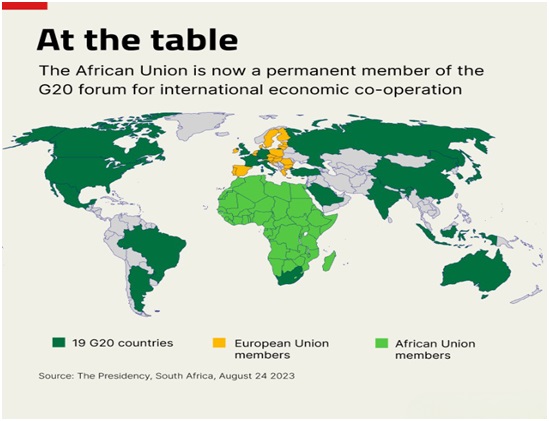
- 11 Sep 2023
Why it is in News?
At the 18th G20 Summit in India, the African Union (AU) became a new member of the G20, just three months after India proposed the idea of their inclusion.
Context:
- In June of this year, Prime Minister Modi suggested to G20 leaders that the African Union should be granted full membership at the upcoming G20 Summit in Delhi.
- This idea was born after the 'Voice of the Global South' Summit in January 2023, which saw participation from most of the African Union's 55 member countries.
- Up to that point, only one country from the African Union, South Africa, was a part of the G20.
- Several African leaders had emphasized that Europe had representation from five countries and the European Union (EU) within the G20, and they believed the African Union deserved similar representation.
What is the African Union (AU)?
- The African Union (AU) is a group of 55 member states representing the countries of the African Continent.
- In essence, it's a union that has various objectives aimed at enhancing the well-being of its member countries, both on their own and as a collective.
- It was formally established in 2002, succeeding the Organisation of African Unity (OAU, 1963-1999).
- The AU's main offices are located in Addis Ababa, Ethiopia.
Vision of the African Union (AU):
- The AU is driven by its vision of "A united, prosperous, and peaceful Africa, led by its own people and serving as a dynamic force on the global stage."
- To accomplish this mission, a target year of 2063 has been established, marking the 100th anniversary of the OAU's establishment.
- Agenda 2063's key objectives include:
- Fostering prosperity in Africa through inclusive growth and sustainable development.
- Achieving a politically unified and integrated continent, inspired by the principles of Pan-Africanism.
- Cultivating a Africa characterized by good governance, democracy, human rights, justice, and the rule of law.
- To realize the aims outlined in Agenda 2063, the AU has devised a series of five 10-year plans, with the initial plan spanning from 2014 to 2023.
Objectives of the African Union (AU):
- The AU dedicates its efforts and resources to fostering stronger unity and solidarity among African nations and their citizens.
- Its goal is to expedite the political and socio-economic integration of the continent, addressing the diverse social, economic, and political challenges faced by African nations.
- Additionally, the AU actively works to promote peace, stability, and security throughout the region.
The Role of the AU in Promoting Peace on the Continent:
- The AU strongly believes that resolving conflicts is essential for achieving prosperity.
- In pursuit of this goal, it established a Peace and Security Council in 2004.
- This council has the authority to intervene in conflicts, replacing the principle of non-interference with one of non-indifference.
- It can deploy military forces in situations involving genocide and crimes against humanity and can authorize peacekeeping missions.
- The AU also oversees the New Partnership for Africa's Development (Nepad), an anti-poverty plan that offers a partnership with the West.
- It promotes good political and economic practices in exchange for increased aid and investment.
- Many of the AU's peacekeeping missions have been instrumental in helping governments combat terrorism across Africa, from the Sahel to northern Mozambique.
- Diplomatic efforts by the AU have also successfully resolved conflicts in Africa, such as brokering a peace deal between the Ethiopian Government and the Tigray People's Liberation Front (TPLF) in South Africa in 2022.
- Another notable achievement is the establishment of the African Continental Free Trade Area (AfCFTA), which became operational in 2021.
- With 54 member countries as signatories, AfCFTA is the world's largest new free trade area since the creation of the WTO in 1994.
- Its aim is to boost intra-African trade by implementing deeper trade liberalization and improved regulatory harmonization.
- The AfCFTA is projected to increase Africa's income by $450 billion by 2035 and elevate intra-African exports by more than 81%.
Limitations of the African Union (AU):
- The AU has faced challenges in preventing coups in Africa, with over 200 coups occurring on the continent since the 1960s. Some of the most recent ones happened in Gabon and Niger.
- Another issue is the AU's struggle to ensure that its member nations fulfill their annual financial obligations.
- This has led to financial constraints, forcing the organization to rely on external funding, which can affect its independence.
Measurement of Unemployment in India? (The Hindu)
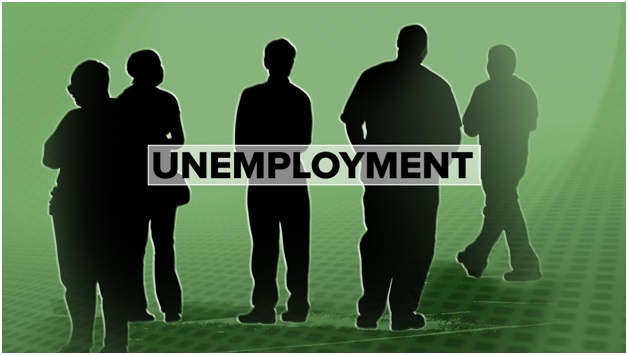
- 08 Sep 2023
Why in the News?
- Based on the Periodic Labour Force Survey (PLFS), India's unemployment rate reached a peak of 6.1% in 2017, which was the highest ever recorded.
- However, the latest PLFS data from 2021-22 indicates a decrease to 4.1% in unemployment.
- This article underscores the challenges in accurately measuring unemployment in India.
- While there has been a reduction in unemployment from 2017 to 2022, it is still higher than the rates observed in some developed economies, such as the United States, where it hovers around 3.5%.
What is the Meaning of Unemployment:
- As per the International Labour Organisation (ILO), unemployment involves being without a job, being ready to accept a job, and actively seeking employment.
- In other words, if someone loses their job but doesn't actively seek another, they are not considered unemployed. Hence, unemployment is distinct from being without a job.
Measuring the Unemployment Rate:
- The unemployment rate is calculated by dividing the number of unemployed individuals by the total labor force.
- The labor force is the combined count of both employed and unemployed individuals.
- People who are neither employed nor unemployed, like students and those involved in unpaid domestic work, are categorized as outside the labor force.
- It's important to note that the unemployment rate may also decrease when an economy doesn't create sufficient jobs or when individuals choose not to actively seek employment.
Challenges in Measuring Unemployment in India:
- Cultural Factors: Social norms and cultural constraints influence job search decisions in developing economies like India.
- A definition of unemployment that relies on active job seeking may underestimate the true situation.
- Informal Work: In contrast to developed economies, individuals in India often hold informal, intermittent jobs.
- This means someone might be unemployed one week but engaged in various roles over time, such as casual labor or farming.
- Varying Methodologies: Different organizations use distinct methodologies to measure unemployment.
- For instance, the Centre for Monitoring Indian Economy categorizes individuals based on their daily activity preceding the interview, leading to variations in unemployment rates and labor force participation rates.
- Data Timing: Timing can also impact unemployment rates.
- For example, the lockdown in March 2020 had a profound effect on the Indian economy, but this disruption was not immediately reflected in the PLFS unemployment rates, which cover a period from July of one year to June of the next.
- Trade-offs: Developing economies face trade-offs in choosing reference periods for data collection.
- Shorter periods yield higher unemployment rates and lower employment rates, while longer periods tend to show the opposite.
- This dilemma is less common in developed nations with more consistent, year-round employment.
Differences in Rural and Urban Unemployment Rates in India:
- The lenient criteria for categorizing someone as employed contribute to the lower unemployment rates in rural regions compared to urban areas.
- Agricultural economies provide individuals with opportunities like family farming or occasional agricultural work, increasing the likelihood of finding some form of employment in rural settings.
- While these definitions may seem to 'underestimate' unemployment, they were primarily crafted to account for the substantial informal economy prevalent in these areas.
Classifying Employment Status in India:
- The National Sample Survey Organisation (NSSO) employs two primary methods for this purpose: Usual Principal and Subsidiary Status (UPSS) and Current Weekly Status (CWS).
- UPSS determines an individual's primary employment status based on their predominant activity during the previous year, whether employed, unemployed, or out of the labor force.
- For instance, even if someone's principal status is not that of a worker, they would still be considered employed under UPSS if they engaged in economic activity in a subsidiary role for a period of not less than 30 days.
- CWS, on the other hand, uses a shorter reference period of one week. An individual is counted as employed if they worked for at least one hour on at least one day during the seven days leading up to the survey date.
- UPSS unemployment rates consistently tend to be lower than CWS rates because it is more likely that individuals will find employment over the course of a year compared to just one week.
Unemployment is becoming a significant issue in the upcoming election. To address it effectively, it's crucial to grasp how unemployment is defined and measured in a developing economy like India.
Mains Question:
- Discuss the challenges associated with measuring unemployment in India and how these measurement methods impact our understanding of the employment situation in the country. (15M)
Chandrayaan-3 | Vikram Hops on the Moon and Lands Safely (The Hindu)
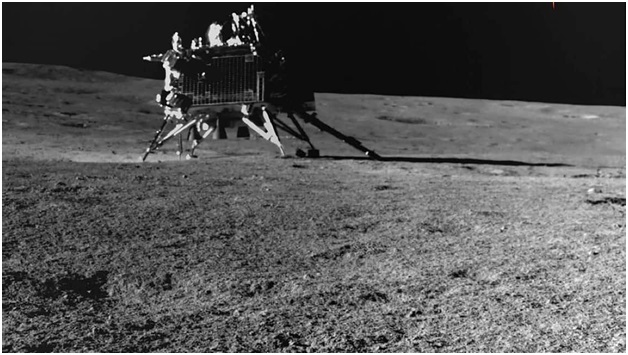
- 05 Sep 2023
Why in the News?
Surpassing its intended mission goals, the Chandrayaan-3 mission's lander, Vikram, has reached a noteworthy milestone by successfully conducting a hop experiment.
Context:
- The Indian Space Research Organisation (ISRO) announced on Tuesday that the lander completed a successful hop experiment.
- Upon receiving the command, it activated its engines, lifting itself by approximately 40 cm as planned and made a safe landing within a range of 30–40 cm.
- This achievement in the hop experiment is of significant importance for upcoming missions, especially those aimed at retrieving lunar samples and future human expeditions to the moon. The lander module, which carried the rover Pragyan, had previously executed a successful soft landing on August 23. Following that, Pragyan was carefully deployed onto the lunar surface.
What is Hop Test?
- In the context of space exploratiom a "hop test" is typically refers to an experiment where a spacecraft's lander or rover briefly lifts off or hops above the surface of a celestial body, such as the moon or Mars, before landing back safely.
- This test is conducted to demonstrate the spacecraft's ability to perform controlled vertical takeoffs and landings.
- In lunar missions, for example, a hop test is crucial for various reasons:
- Mobility: Hopping allows the lander or rover to move to a different location on the lunar surface, providing it with increased mobility and access to a wider range of scientific targets.
- Avoiding Obstacles: Hopping can help the spacecraft avoid obstacles or hazards on the surface, such as large rocks or rough terrain.
- Positioning: Hopping can reposition the spacecraft's instruments or cameras for better observations.
- The successful execution of a hop test demonstrates the spacecraft's precision in controlling its engines, which is crucial for safe landings, mobility, and conducting experiments on celestial bodies with low or no atmosphere.
Post Hop Experiment Updates:
- ISRO reported that the spacecraft and its onboard instruments remained in excellent working condition after the successful 'hop.'
- Instruments such as the deployed ramp, ChaSTE, and ILSA were folded back and redeployed without any issues following the experiment.
- Subsequently, the payloads onboard the lander were deactivated in anticipation of the approaching lunar night.
- The solar-powered instruments were not designed to endure the extremely frigid temperatures of the lunar night, which can plummet to below -120 degrees Celsius.
- Therefore, the instruments on the rover were placed in a sleep mode a few days ahead of the start of the lunar night, which lasts for 14 Earth days.
- If the battery retains some charge during this period, the instruments can be reactivated when sunlight becomes available once more.
- Additionally, the ISRO Chairman announced plans to extend the mission life of both the lander and rover shortly after the launch of the Aditya-L1 mission.
- Originally, the mission life for both the lander and rover was set at just one lunar day, equivalent to 14 Earth days.
Why is the Hop Test Significant?
- Even though ISRO has not officially disclosed subsequent lunar missions, scientists believe that a sample return mission is a logical progression after Chandrayaan-3.
- In fact, had Chandrayaan-2 succeeded in 2019, Chandrayaan-3 would have been designed as a sample return mission.
- A human lander mission is also anticipated in the future.
- China's Chang'e lunar program has followed a similar trajectory, starting with an orbiter in 2007 and advancing to a lander and sample return mission (most recently in 2020).
- Therefore, the hop test holds critical importance for upcoming lunar missions. In missions involving sample return or human landings, the lander must take off from the lunar surface and return to Earth, necessitating much higher thrust.
- Nevertheless, as a technology demonstration, the 'hop experiment' remains a noteworthy achievement within the Chandrayaan-3 mission.
- The successful hop experiment also showcases India's prowess in space exploration, which could potentially attract international investments to the country's space endeavors.
Equatorial-Origin Cyclones and Pacific Decadal Oscillation (The Hindu)
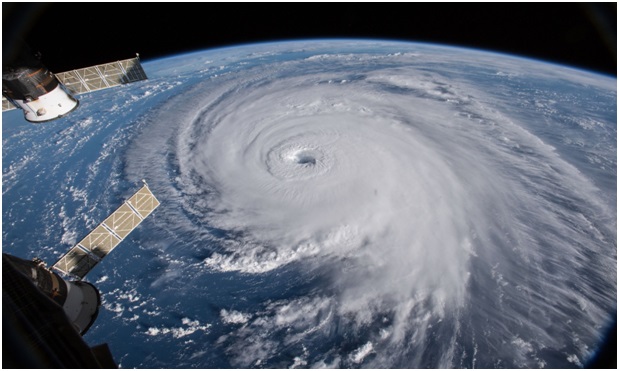
- 02 Sep 2023
Syllabus: Mains – GS I (Geography)
Why in the News?
- In recent decades, tropical cyclones starting near the Equator have been less destructive.
- The most recent big cyclone like this in the Indian area was Cyclone Okchi in 2017. It caused a lot of damage in Kerala, Tamil Nadu, and Sri Lanka.
- But, in the future, these cyclones might happen more often. This is because of two things: global warming and a repeating event called the Pacific Decadal Oscillation (PDO). The PDO comes back every 20-30 years.
What are Equatorial-Origin or Low Latitude Cyclones?
- Equatorial-Origin or Low Latitude Cyclones (LLCs) are cyclones that start between 5°N and 11°N.
- They are smaller in size than cyclones in higher areas but can get much stronger very quickly.
- Normally, cyclones don't form near the equator (low latitude), but when the water is warm, they can gather more moisture and become more powerful.
- Most of these cyclones begin in the Western Pacific Ocean.
- The last big cyclone like this in the Indian area was Cyclone Ockhi in 2017.
- It traveled more than 2000 km and caused a lot of damage in Kerala, Tamil Nadu, and Sri Lanka.
- In the post-monsoon season (Oct-Nov-Dec), the north Indian Ocean (NIO) is a hotspot for LLCs.
- They make up about 60% of all Tropical Cyclones in the NIO since 1951. However, they haven't received as much attention as they should have.
What is the Pacific Decadal Oscillation (PDO)?
- The Pacific Decadal Oscillation (PDO) is a long-term change in the Pacific Ocean.
- It's like a cycle that happens every 20-30 years, and it has both "cool" and "warm" phases.
- Positive (Warm) PDO: During this phase, the western part of the Pacific Ocean becomes cooler, while the eastern part gets warmer. It's the opposite during a negative PDO.
- The term Pacific Decadal Oscillation (PDO) was first used around 1996 by a scientist named Steven Hare.
- Impact of PDO:
- On Global Climate: The PDO's phase can have a big impact on the world's weather. It affects things like hurricanes in the Pacific and Atlantic, droughts and floods around the Pacific, how well marine life does, and patterns in global land temperatures.
- On Cyclones: When the PDO is warmer (positive phase), there tend to be fewer cyclones that start near the equator.
- In 2019, the PDO started getting cooler, going into a negative phase.
- If this continues, it could mean more of those equatorial-origin cyclones in the months after the monsoon.
ENSO and PDO:
- Positive PDO with ENSO is generally unfavorable, but a negative PDO brings more rain to India.
- When the Pacific Decadal Oscillation (PDO) is in a positive phase along with the El Niño-Southern Oscillation (ENSO), it's often not good.
- However, when the PDO is negative, it brings more rain to India.
- When Both ENSO and PDO Match:
- If both ENSO and PDO are in the same phase, it's believed that the impacts of El Niño or La Niña events may be stronger.
PDO vs. ENSO:
- Difference in Repeating:
- El Niño or La Niña events happen in the Pacific Ocean every 2-7 years, but the PDO has a pattern that lasts much longer, often over decades.
- Identifying Positive PDO Takes Time:
- You can figure out if the PDO is in a "positive" or "warmer phase," but it takes several years of measuring ocean temperatures and their interaction with the atmosphere.
- In contrast, you can determine the stage of an ENSO event in any given year.
What is El Niño-Southern Oscillation (ENSO)?
ENSO is one of the most important climate phenomena on Earth due to its ability to change the global atmospheric circulation, which in turn, influences temperature and precipitation across the globe. We also focus on ENSO because we can often predict its arrival many seasons in advance of its strongest impacts on weather and climate.
- The El Niño-Southern Oscillation (ENSO) is a recurring climate pattern involving changes in the temperature of waters in the central and eastern tropical Pacific Ocean.
- On periods ranging from about three to seven years, the surface waters across a large swath of the tropical Pacific Ocean warm or cool by anywhere from 1°C to 3°C, compared to normal.
- This oscillating warming and cooling pattern, referred to as the ENSO cycle, directly affects rainfall distribution in the tropics and can have a strong influence on weather across the United States and other parts of the world.
- El Niño and La Niña are the extreme phases of the ENSO cycle; between these two phases is a third phase called ENSO-neutral.
- El Niño: A warming of the ocean surface, or above-average sea surface temperatures (SST), in the central and eastern tropical Pacific Ocean.
- Over Indonesia, rainfall tends to become reduced while rainfall increases over the central and eastern tropical Pacific Ocean.
- The low-level surface winds, which normally blow from east to west along the equator (“easterly winds”), instead weaken or, in some cases, start blowing the other direction (from west to east or “westerly winds”).
- In general, the warmer the ocean temperature anomalies, the stronger the El Niño (and vice-versa).
- La Niña: A cooling of the ocean surface, or below-average sea surface temperatures (SST), in the central and eastern tropical Pacific Ocean.
- Over Indonesia, rainfall tends to increase while rainfall decreases over the central and eastern tropical Pacific Ocean.
- The normal easterly winds along the equator become even stronger.
- In general, the cooler the ocean temperature anomalies, the stronger the La Niña (and vice-versa).
- Neutral: Neither El Niño or La Niña. Often tropical Pacific SSTs are generally close to average.
- However, there are some instances when the ocean can look like it is in an El Niño or La Niña state, but the atmosphere is not playing along (or vice versa).
Mains Question:
- What are the key environmental and geographical factors that influence the formation and distribution of tropical cyclones in various ocean basins around the world, and how do they differ? (15M)
Curbs on Rice Exports (The Hindu)
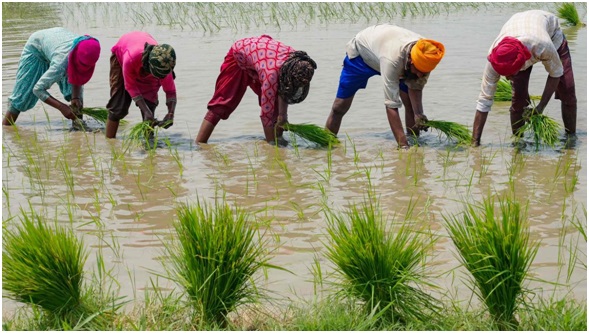
- 31 Aug 2023
Why in the News?
In a move to check domestic rice prices and ensure domestic food security, the Indian government has prohibited the export of white rice, levied a 20% export duty on par-boiled rice till October 15, and permitted the export of Basmati rice for contracts with value of $1,200 a tonne or above.
India's Rice Exports:
- India is the biggest rice seller in the whole world, making up 45% of the global rice market.
- In the months of April and May in 2023, the amount of rice sent out of the country was 21.1% more compared to the same time in the previous financial year.
- Just in May, the export of Basmati rice was 10.86% higher than how much was exported in May of 2022.
- The amount of non-Basmati rice being shipped out has been increasing for three years, and in the year 2022-2023, more Basmati rice was exported than the year before.
- According to the information the government provided, until August 17 this year, the total rice exports (not including broken rice) were 15% more, reaching 7.3 million tonnes.
- This is compared to 6.3 million tonnes during the same time last year.
- Thailand thinks it will produce almost 25% less rice in 2023-2024; Myanmar has stopped sending out raw rice; and it seems like there might be less rice available in Iraq and Iran too.
Rice Production in Current Season:
- The Department of Agriculture and Farmers Welfare has reported that during the Rabi season of 2022-2023, the amount of rice produced was 13.8% lower, reaching 158.95 lakh tonnes.
- This is compared to 184.71 lakh tonnes in the Rabi season of 2021-2022.
- For the Kharif season, the data about planting shows that rice has been planted on 384.05 lakh hectares this year as of August 25.
- This is more compared to 367.83 lakh hectares during the same time last year.
- People in the trading and rice milling business are saying that the new season's rice will start arriving after the first week of September.
- They also mentioned that the effects of El Nino might have some impact on how much rice arrives.
- Rice prices were ?27 per kilogram at this time last year, but now they've gone up to ?33 per kilogram.
Challenges in India’s Rice Export Strategy:
- India managed to export a record-breaking 21 million metric tonnes (MMT) of rice in the fiscal year 2021-22 (FY22), which made up around 41 percent of the global exports in a market of about 51.3 MMT.
- Exporting such large amounts of rice led to a drop in global rice prices by approximately 23 percent in March (compared to the previous year), while other cereal prices like wheat and maize were increasing significantly in the global market. In fact, in FY22, the price for each tonne of common rice exported was only $354, which was lower than the Minimum Support Price (MSP) for rice.
- Buying below MSP or issues with distribution which means that either rice exporters were buying rice (paddy) from farmers and millers at prices below the MSP, or a significant portion of rice provided for free under the PM Garib Kalyan Ann Yojana (PMGKAY) was being sent for export at prices below the MSP.
- Certain states, particularly Punjab, provide free electricity for irrigation, and highly subsidized fertilizers, especially urea, which gives Indian rice an artificial competitive edge in global markets.
What Can Indian Farmers and Consumers Anticipate?
- The government has raised the Minimum Support Price (MSP) for rice, and rice millers are now buying paddy at a price higher than the MSP.
- Because of this, farmers can expect that prices won't go down.
- Limits on exports will make sure that rice prices in the market don't suddenly go up by a lot.
- For people in India who are buying rice, there's a small increase in prices right now, but over time, there will still be enough rice available and prices aren't predicted to go way up.
Actions Taken by the Central Government:
- To control the prices of rice in the country and make sure there's enough food for people here, the Union government has stopped exporting regular (non-basmati) white rice.
- They have also put a 20% tax on exporting partially cooked rice until October 15.
- For Basmati rice, the government says it can be exported if the contract's value is $1,200 per tonne or more.
- Since last September, exporting broken rice has not been allowed.
- However, in some cases, the government can allow exporting broken rice if other countries need it for their food security and if their government asks for it.
Opinions of Rice Exporters:
- Indian par-boiled rice is still competitively priced in the global market, even with the 20% duty added.
- When the world rice market is strong, it can handle higher prices as well. Overall, there's a lot of demand from other countries.
- Countries like Indonesia, which usually sell rice, are now buying (raw rice) from other places.
- According to rice exporters, instead of dividing rice into Basmati and non-Basmati, the government should think about categorizing it as regular rice and special rice for making export decisions.
- Around 12 types of rice have something called Geographical Indication (GI) recognition, and these should be kept separate from general market rules.
- For Basmati rice, the government could have let exports continue or set a minimum value for exports at $900 per tonne.
- Basmati rice is unique, and there will be new rice arriving soon, so there's no real need for restrictions.
- Since Indian rice quality is good and supply is steady, other countries will want it even more in the future.
India and the Asian Development Bank to establish a climate change and health hub in Delhi (The Hindu)
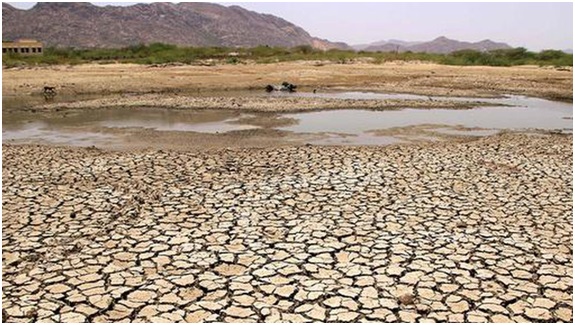
- 28 Aug 2023
Why in the News?
India's G-20 document states that the climate change and health hub will facilitate knowledge sharing, partnerships, and innovations to assist developing countries, while health systems will face challenges from infectious diseases and natural disasters driven by climate change.
Why in the news?
- India, in collaboration with the Asian Development Bank (ADB), is gearing up to inaugurate a climate change and health hub in the national capital.
- This initiative follows India's earlier achievement in hosting the inaugural WHO Centre for Global Traditional Medicine, located in Jamnagar, Gujarat.
- The forthcoming hub's mission is to foster knowledge exchange, cultivate partnerships, drive innovations, and extend support to nations beyond the G-20, with a special focus on developing countries.
The Significance of the Climate Change and Health Hub:
- Fostering Collaboration: This center holds paramount significance as it brings together diverse partners to engage in vital discussions regarding the far-reaching impacts of climate change.
- It provides a unique platform for shared learning and collaboration among stakeholders.
- Addressing Health Emergencies: India's recent G-20 outcome document highlights that climate change remains a key driver of health emergencies, including the resurgence of infectious diseases.
- Moreover, it exacerbates the frequency and severity of natural disasters, posing a significant threat to the capability of health systems to provide essential services.
- Boosting Resilience: Given this backdrop, it is imperative to bolster the resilience of health systems against the adverse effects of climate change.
- The G-20 outcome document outlines a commitment to prioritize the development of climate-resilient health systems, establish sustainable and eco-friendly healthcare supply chains, mobilize resources for resilient, low-carbon health systems, and promote collaboration through initiatives like the WHO-led Alliance for Transformative Action on Climate and Health (ATACH).
- Tackling Zoonotic Spillovers: The recent G-20 Health Ministers' meeting expressed concern about the rising incidence of zoonotic spillovers, leading to the emergence of new diseases.
- In this context, there is an urgent need to identify both new and existing drivers using a scientific and risk-based approach while reinforcing existing infectious disease surveillance systems.
- Global Impact: Situated in New Delhi, the Climate Change and Health Hub is poised to address these pressing issues on a global scale, serving as a hub for international collaboration and solutions.
About Asian Development Bank (ADB):
- Founded in 1966, the Asian Development Bank (ADB) is a multilateral institution that counts 68 members among its ownership, with 49 hailing from the Asian and Pacific region.
- ADB is unwavering in its commitment to fostering a prosperous, inclusive, resilient, and sustainable future for Asia and the Pacific, all while maintaining its steadfast resolve to eliminate extreme poverty.
- To achieve its noble objectives, ADB extends its support to member nations and partners through a comprehensive suite of financial instruments.
- This includes loans, technical assistance, grants, and equity investments, all aimed at catalyzing social and economic development across the region.
- In essence, ADB stands as a stalwart advocate for advancing social and economic development in Asia and the Pacific.
- As of December 31, 2019, ADB's five largest shareholders are Japan and the United States, each possessing 15.6% of total shares, followed by the People's Republic of China (6.4%), India (6.3%), and Australia (5.8%). The institution's headquarters are situated in Manila, Philippines.
About WHO Global Centre for Traditional Medicine (GCTM):
- The WHO Global Centre for Traditional Medicine (GCTM) is a pioneering knowledge hub dedicated to traditional medicine, recognized as the world's premier center of its kind.
- Situated in Jamnagar, Gujarat, it represents a remarkable collaboration between nations.
- India, as the primary investor in GCTM, has committed an approximate sum of US$ 250 million to facilitate the center's establishment, infrastructure development, and operational activities.
The GCTM is designed to achieve five key objectives:
- Archiving Traditional Wisdom: GCTM seeks to harness technology to construct a comprehensive database of traditional knowledge systems.
- Setting International Standards: It aspires to establish global standards for the testing and certification of traditional medicines, enhancing confidence in these age-old remedies.
- Global Knowledge Exchange: The center aims to serve as a global platform where experts in traditional medicine converge to share their experiences and expertise.
- Funding Research: GCTM endeavors to mobilize resources and funding for research in the field of traditional medicines, fostering innovation and scientific exploration.
- Holistic Healing Protocols: The center is dedicated to developing holistic treatment protocols for specific diseases, enabling patients to benefit from the complementary strengths of both traditional and modern medicine approaches.
BRICS Summit 2023 (The Hindu)
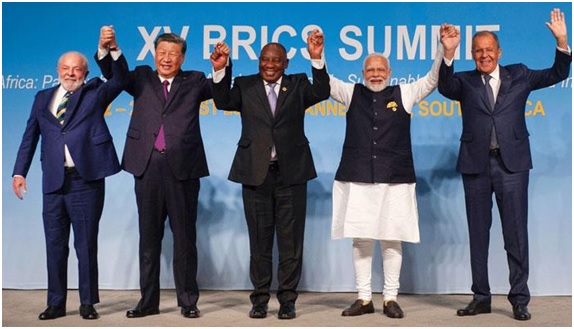
- 25 Aug 2023
Why in the News?
The 15th BRICS summit convened at the Sandton Convention Centre in South Africa from August 22nd to 24th. One of the significant outcomes of this summit was the unanimous agreement among BRICS leaders to broaden the group's membership by welcoming six new countries.
What are the Key Highlights of the Summit?
At the 15th BRICS Summit hosted in South Africa, the alliance extended invitations to six nations, marking a significant development that reinforces BRICS' position as a prominent 'voice of the Global South.' These new members, namely Iran, the United Arab Emirates, Saudi Arabia, Argentina, Egypt, and Ethiopia, are set to formally commence their participation in BRICS starting January 2024.
- Host: South Africa played host to this year's summit, taking on the role of Chair for BRICS since January 1, 2023.
- Theme: The overarching theme for the summit was "BRICS and Africa: Partnership for Mutually Accelerated Growth, Sustainable Development, and Inclusive Multilateralism."
- Five Priorities for 2023:
- The member nations focused on five key priorities:
- Advancing a partnership for a fair Just Transition.
- Revolutionizing education and skills development for the future.
- Exploiting opportunities through the African Continental Free Trade Area.
- Bolstering socio-economic recovery after the pandemic and working towards achieving the 2030 Agenda on Sustainable Development.
- Reinforcing multilateralism, which includes pursuing substantial reforms of global governance institutions and empowering women's meaningful participation in peace processes.
- Outcome Document: After the summit, member countries collectively adopted the Johannesburg II Declaration, which outlined their commitment to working on the following themes:
- Building a Partnership for Inclusive Multilateralism.
- Cultivating an Environment of Peace and Development.
- Fostering a Partnership for Mutually Accelerated Growth.
- Nurturing a Partnership for Sustainable Development.
- Deepening People-to-People Exchanges.
- Enhancing Institutional Development.
Significance of this Development:
- Amplified Advocate for Developing Nations: The inclusion of new member states bolsters BRICS' role as a prominent spokesperson for the interests of the developing world.
- Enhanced Global Influence: Currently representing approximately 40% of the global population and over a quarter of the world's GDP, BRICS' significance amplifies with these additions.
- The organization will now encompass nearly half of the world's population and incorporate three of the globe's major oil-producing nations, namely Saudi Arabia, the UAE, and Iran.
- China's Expanding Influence: This expansion also raises questions about China's growing dominance within BRICS, given its pivotal role in driving the group's enlargement.
- Noteworthy Regional Dynamics: The fact that regional rivals, Saudi Arabia and Iran, are both joining BRICS is particularly remarkable.
- China's role as the largest purchaser of Saudi Arabia's oil and its recent mediation in brokering a peace agreement between Tehran and Riyadh adds a distinctive dimension to this development.
The Recent Additions to BRICS:
The inclusion of new members in BRICS marks a noteworthy development in the alliance's composition:
- Iran: The invitation extended to Iran, a nation with strained ties with the West, is perceived as a move with strong backing from China and Russia.
- This signals Iran's strategic alignment with these major players on the global stage.
- Saudi Arabia: Historically, Saudi Arabia has been a staunch ally of the United States.
- However, recent trends suggest the kingdom's growing independence in its foreign policy decisions, and its decision to join BRICS aligns with this shift.
- Russia and Iran: For both Russia and Iran, BRICS membership serves as a diplomatic signal to the Western world, affirming that they maintain global friendships and strategic partnerships beyond Western alliances.
- Egypt and Ethiopia: Despite their longstanding ties with the United States, both Egypt and Ethiopia's involvement in BRICS indicates a diversification of their international partnerships and interests.
- Argentina: Amidst an economic crisis, Argentina's BRICS membership carries the expectation of potential financial assistance from the alliance, reflecting the nation's pursuit of economic stability and cooperation on the global stage.
Rationale for BRICS Expansion:
- Counterbalance to Anti-US Sentiment and Advocacy for Multipolarity: In light of significant anti-US sentiment prevailing worldwide, these countries seek a platform where they can harness this sentiment to unite effectively.
- Moreover, there's a growing demand for multipolarity, a forum through which Global South nations can demonstrate their solidarity.
- Emerging as a Counterweight to Western Hegemony: The conflict in Ukraine has resulted in Western nations coming together while simultaneously reinforcing the China-Russia partnership.
- Consequently, BRICS has evolved into an aspirational bloc capable of challenging the Western geopolitical perspective and serving as a counterweight to Western-dominated forums like the Group of 7 and the World Bank.
What BRICS Expansion Signifies for India's Global Positioning?
- India's recent participation in the G7 summit in Hiroshima and the informal Quad summit, alongside its continued engagement with the BRICS alliance, has sparked discussions about its foreign policy orientation.
- While some perceive these moves as indicative of India aligning more closely with the United States, it's crucial to underscore India's persistent commitment to the BRICS, often viewed as an 'anti-Western' bloc.
- Additionally, India maintains its presence within the Shanghai Cooperation Organisation (SCO) and maintains diplomatic relations with both Russia and China, despite occasional challenges.
- It is important to note that India's perspective on BRICS differs from China's. India sees BRICS as a forum that should remain non-aligned with Western powers, emphasizing its non-Western character.
- Regarding the recent expansion of BRICS to include new members, India views these additions as opportunities for valuable partnerships.
- However, concerns have arisen about the possibility of BRICS becoming more aligned with China's interests, potentially marginalizing India's influence within the group.
- This raises questions about how India will safeguard its voice and interests within BRICS as the alliance evolves.
Chandrayaan-3 Successfully Lands on the Moon (The Hindu)
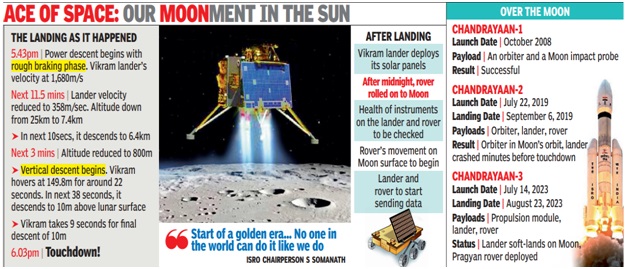
- 24 Aug 2023
Why in the News?
India's Chandrayaan-3 mission made an indelible mark in history with its successful lunar landing. Achieving a 'soft landing' at the Moon's south pole, India now stands as the sole nation to have accomplished this remarkable feat.
Nearly sixty years after the Soviet Union’s Luna 9 mission made history as the first soft landing on the Moon, a lunar landing remains elusive for many countries. Russia’s Luna-25 mission failed earlier this week, in the same year that the Japanese Hakuto mission crash-landed. In 2019, Chandrayaan-2’s crash was preceded by Israel’s Beresheet facing a similar fate.
What is Soft Landing?
- A 'soft landing' refers to the precise and controlled landing of a spacecraft at a gentle speed, ensuring minimal or no damage to the craft.
- This achievement highlights the technical prowess of the spacecraft.
- During a soft landing, the spacecraft executes a sequence of maneuvers and braking procedures aimed at diminishing its velocity and aligning it with the chosen landing area.
- Typically, this involves activating retro-rockets or thrusters to gradually reduce descent speed and maintain a carefully managed approach.
- The ultimate objective is to guide the spacecraft to the surface in a manner that avoids significant damage, showcasing the precision and expertise of the mission.
But why is it so difficult?
- The Moon has an extremely thin atmosphere. This means that spacecraft cannot rely on atmospheric friction to slow down considerably ahead of a landing which means that they will have to rely heavily on their propulsion systems to make a safe landing.
- Also, there is no GPS on the Moon, unlike here on Earth.
- This means that onboard computers will have to make quick calculations and maneuvers to land at a safe location without guidance from a massive network of satellites.
Why is ISRO Aiming for the Southern Pole?
- All of the spacecraft that have landed on the Moon previously have landed in the equatorial region, either a few degrees of latitude north or a few degrees south of the lunar equator.
- NASA’s Surveyor 7 is the mission that went farthest from the equator in history, landing as far away as 50 degrees south of the equator.
- It is not without reason that so many missions land near the equator.
- The terrain and temperature there are more welcoming, making the long and sustained operations of instruments easier.
- Also, the surface there is relatively smooth with very few steep slopes, hills, and craters.
- Due to the difficult environment, the polar regions of the Moon have largely remained unexplored.
- But if the data from many previous orbiter missions is anything to go by, these regions could be very interesting to explore.
- Chandrayaan-1 observed some evidence of the presence of ice molecules in the deep craters in the region.
- Also, the cold temperatures of the region mean that things trapped there would remain frozen for a long time.
- Essentially, that part of the Moon could act as a “time capsule.”
- This could help scientists discover clues about the early history of the solar system, including how the Earth and the Moon formed.
Why the South Pole of the Moon Holds Significance?
- Abundant Water Resources: Compelling evidence suggests the presence of water ice within the perpetually shadowed craters at the moon's south pole.
- This water resource holds immense value for future human lunar exploration, serving potential uses such as drinking water, food cultivation, and the production of rocket fuel.
- Various Volatiles: Beyond water ice, the moon's south pole may house other volatiles like methane and ammonia, offering additional resources for prospective lunar missions.
- Geological Fascination: The lunar south pole boasts intriguing geological features, notably the South Pole-Aitken basin, the moon's largest impact basin.
- Studying this basin could yield valuable insights into the moon's formation and evolutionary history.
- Prime for Astronomical Observations: The permanently shadowed craters at the moon's south pole provide an excellent vantage point for astronomical observations.
- Shielded from the Sun's radiation, these craters offer ideal conditions for studying radio waves and other forms of radiation that Earth's atmosphere tends to block.
What Has Changed Since the Chandrayaan-2 Setback?
- Enhanced Landing Gear: Chandrayaan-3's landing legs have been fortified to guarantee stability and secure touchdown, even at a velocity of 3 meters per second, equivalent to 10.8 kilometers per hour.
- Expanded Landing Flexibility: Unlike wheeled vehicles, a lunar lander employs stilts or legs to land.
- The potential landing area has been broadened, with Chandrayaan-3 now programmed to touch down safely within a 4-kilometer by 2.4-kilometer zone, rather than aiming for a specific 500-meter by 500-meter patch as previously targeted by Chandrayaan-2.
- Ample Fuel Reserves: Chandrayaan-3 carries an increased fuel load compared to Chandrayaan-2.
- This surplus fuel is on standby for last-minute adjustments to the landing site if required.
- Enhanced Solar Panels: The Chandrayaan-3 Lander is equipped with solar panels on all four sides, a significant upgrade from Chandrayaan-2's two-sided configuration.
- This design ensures the Lander can harness solar power consistently, even if it lands incorrectly or experiences tumbling.
- At least one or two sides will continually face the Sun, ensuring uninterrupted power generation.
What Next After Chandrayaan-3 successfully lands on the Moon?
- Payloads in Action: Typically, spacecraft carry specialized instruments and experiments, known as payloads, to observe and record events in space.
- Data Transmission to Earth: The data collected by these payloads is then transmitted back to Earth, where scientists analyze and study it for valuable insights.
- Consistent Payloads: In Chandrayaan-3, the six payloads on the Vikram lander and rover Pragyan remain consistent with the previous mission.
- Scientific Payloads on Lander: The lander hosts four scientific payloads that focus on various aspects, including the study of lunar quakes, thermal properties of the lunar surface, changes in the plasma near the surface, and a passive experiment aimed at precise measurements of the Earth-Moon distance. One of these payloads comes from NASA.
Rover Payloads: The rover carries two payloads designed to examine the chemical and mineral composition of the lunar surface. They are tasked with determining the presence and composition of elements like magnesium, aluminum, and iron in lunar soil and rocks.
India’s Smartphone Manufacturing Dreams and PIL Scheme (The Hindu)

- 23 Aug 2023
Why in the News?
In recent months, there has been an ongoing exchange of viewpoints between former RBI governor Raghuram Rajan and Minister of State for Electronics Rajeev Chandrasekhar regarding the performance of a Central government initiative aimed at enhancing the electronics manufacturing sector.
Context:
- In the backdrop of this discussion, it's important to highlight that former RBI governor Raghuram Rajan, along with two fellow economists, released a concise research paper in which they posited that the Production-Linked Incentive (PLI) program might not be effectively driving India toward self-reliance in manufacturing.
- They contended that taxpayer funds were potentially being used to establish an ecosystem centered around low-level assembly jobs, which could still heavily rely on imports.
What Is the Production-Linked Incentive (PLI) Scheme?
- The PLI scheme was designed with the overarching goals of bolstering domestic manufacturing capacity, augmenting import substitution, and fostering employment generation.
- Launched in March 2020, this initiative initially focused on three key industries:
- Mobile and related Component Manufacturing
- Electrical Component Manufacturing
- Medical Devices
- Incentives Offered by the Scheme:
- The incentives provided under this program are contingent on incremental sales and vary across sectors.
- They range from as low as 1% for electronics and technology products to as high as 20% for the production of critical key starting drugs and certain drug intermediaries.
- In certain sectors like advanced chemistry cell batteries, textile products, and the drone industry, incentives are calculated based on sales performance and local value addition over five years.
- Sectors Covered by the PLI Scheme:
- To date, the government has unveiled PLI schemes encompassing 14 sectors, including but not limited to the automobile and auto components industry, electronics and IT hardware, telecom, pharmaceuticals, solar modules, metals and mining, textiles and apparel, white goods, drones, and advanced chemistry cell batteries.
- The introduction of this scheme aligns with several key objectives:
- Reducing India's reliance on imports from countries like China and other foreign nations.
- Bolstering labor-intensive sectors to enhance the employment ratio within India.
- Mitigating import bills while promoting domestic production.
- It's important to note that the PLI Yojana also extends an invitation to foreign companies to establish their operations in India and encourages domestic enterprises to expand their manufacturing capabilities.
What is the PLI Program in the Smartphone Manufacturing Sector?
- Among the sectors, the smartphone manufacturing industry has exhibited remarkable enthusiasm for the PLI program.
- Companies such as Micromax, Samsung, and Foxconn (known for manufacturing Apple phones) stand to benefit by receiving incentives of up to 6% of their incremental sales revenue through the PLI initiative.
- This program has yielded remarkable results, as evidenced by the staggering growth in mobile phone exports.
- The exports of mobile phones surged from a modest $300 million in FY2018 to an astonishing $11 billion in FY23.
- Additionally, the import figures tell a compelling story; while India imported mobile phones valued at $3.6 billion in FY2018, this figure significantly dwindled to just $1.6 billion in FY23.
- Central government Ministers, including Mr. Chandrasekhar, frequently cite these statistics as compelling evidence of the resounding success of the PLI scheme.
Former RBI Governor Raghuram Rajan's Perspective:
- In his research paper, the former head of the Central Bank presented the argument that while the imports of fully assembled mobile phones have indeed decreased, the imports of mobile phone components, encompassing items such as display screens, cameras, batteries, and printed circuit boards, experienced a significant upsurge between FY21 and FY23.
- Interestingly, these two years also marked the period during which mobile phone exports experienced their most substantial growth.
- His contention revolves around the observation that manufacturers in India are not fundamentally engaged in the traditional sense of mobile phone production, which would involve the localization of the entire supply chain and the domestic production of most components.
- Instead, what these companies are primarily doing is importing all the requisite parts and subsequently assembling them in India to produce a product labeled as 'Made in India.'
- Furthermore, Rajan's critique extends to the assertion that low-level assembly work, as opposed to comprehensive manufacturing, does not generate well-paying jobs and lacks the robust multiplier effect that genuine manufacturing might provide to the economy.
What is the Union Government Response:
- Minister of State for Electronics, Rajeev Chandrasekhar, presents a two-part counter-argument.
- Firstly, he contends that Mr. Rajan's assumption that all imports of items like screens and batteries are exclusively intended for mobile phone manufacturing is inaccurate.
- These imported components could also be utilized in the production of other devices such as computer monitors, DSLR cameras, and electric vehicles, among others.
- Secondly, he points out that not all mobile phone production in India benefits from the PLI scheme; only approximately 22% of the industry has been covered by the scheme thus far.
- The Minister's primary assertion is that import dependency isn't as severe as Mr. Rajan portrays it to be, given the potential diversity of applications for these imported components and the limited coverage of mobile phone production under the PLI scheme.
In Conclusion:
- The former RBI Governor contends that even if we assume that only 60% of imports are utilized for production, India's net exports would remain in the negative territory.
- This means that even if just 60% of components like screens and batteries are dedicated to mobile phone manufacturing, the total imports would still surpass the overall exports.
- The fundamental divide in this debate revolves around the question of whether the PLI program can effectively generate sustainable employment opportunities and firmly position India as a manufacturing and supply hub that contributes substantial value to the production process.
- The Union Government's perspective is that the results of the PLI Scheme may require time to become fully apparent and impactful.
MoEFCC’s U-turn to Merge Autonomous Bodies (The Hindu)

- 18 Aug 2023
Why in the News?
In June, the Ministry of Environment, Forests and Climate Change (MoEFCC) issued a notification quietly walking back on its move to establish integrated regional offices by merging offices of the Forest Survey of India (FSI), the National Tiger Conservation Authority (NTCA), the Wildlife Crime Control Bureau (WCCB), and the Central Zoo Authority (CZA), and thus bring them under the Ministry.
What's in the News?
- Amidst the Covid-19 pandemic, the central government suggested the consolidation of four entities – NTCA, CZA, WCCB, and FSI – into a single organization.
- This proposition faced intense criticism from activists who argued that it could strip key environmental bodies of their effectiveness.
- To illustrate, within the current structure, the NTCA possesses the ability to contest forest clearances for projects that involve diverting areas within Tiger Reserves.
- However, the proposed amalgamation might have complicated this process, as the NTCA would have fallen under the authority of the Deputy Director General of Forests. This individual oversees the Integrated Regional Office and reports to the Ministry of Environment, Forest and Climate Change (MoEF&CC).
About the Forest Survey of India (FSI):
- The inception of the Forest Survey of India dates back to 1981, a product of the National Commission on Agriculture's (NCA) suggestions.
- FSI conducts a biennial evaluation of the nation's forest coverage through digital analysis of satellite data from remote sensing technology. This assessment culminates in the publication of the 'State of Forest Report' (SFR).
- FSI plays an instrumental role in imparting training to forest officers from diverse Indian states.
- The base of Operations: Dehradun, Uttarakhand.
About the National Tiger Conservation Authority (NTCA):
- The National Tiger Conservation Authority, established under the Wildlife (Protection) Act of 1972, operates as a statutory body.
- Established in 2005 as a result of the recommendations of the Tiger Task Force, its core aims encompass:
- Granting legal authority to Project Tiger, thereby rendering adherence to its directives a matter of legality.
- Enhancing the accountability of both the central and state governments in managing Tiger Reserves.
- Addressing the livelihood concerns of local communities residing in the vicinity of Tiger Reserves.
- Key Responsibilities:
- Approval of tiger conservation plans devised by state governments.
- Ensuring that the integrity of tiger reserves and the ecological connectivity between different protected areas and reserves remain intact, avoiding unsustainable ecological utilization.
- Providing support and facilitation for the management of tiger reserves within states, aimed at conserving biodiversity.
- NTCA undertakes a comprehensive Tiger Census across India every four years.
- Leadership: The chairman of NTCA is the Union Minister of Environment, Forest and Climate Change.
About the Wildlife Crime Control Bureau (WCCB):
- The Wildlife Crime Control Bureau was established in 2007 as a statutory body under the Wildlife (Protection) Act of 1972.
- Main Responsibilities:
- Gathering and organizing information about organized wildlife crimes and quickly sharing it with state and other enforcement agencies to catch the criminals promptly.
- Creating a central place to store data about wildlife crimes.
- Coordinating efforts from different agencies to enforce the rules of the Act.
- Helping other countries and international groups work together to control wildlife crimes.
- Helping enforcement agencies improve their skills in investigating wildlife crimes.
- Guiding State Governments to successfully handle cases related to wildlife crimes.
- The WCCB also assists Customs authorities in checking shipments of plants and animals according to the rules of the Wildlife Protection Act, CITES, and EXIM Policy.
- The headquarters is based in New Delhi.
About the Central Zoo Authority (CZA):
- The Central Zoo Authority, established in 1992 as a legal body under the Wildlife (Protection) Act of 1972, has a specific purpose.
- What It Aims to Achieve:
- To support and enhance the national mission to conserve the diverse and valuable biodiversity of the country, especially its animals, following the guidelines of the National Zoo Policy from 1998.
- Every zoo in the nation must gain recognition from this Authority to operate.
- The Authority's main role is more about helping than controlling. It offers technical and financial assistance to zoos that have the potential to meet the desired standards in animal management.
- It sets rules and guidelines for transferring animals among zoos within the country and globally.
- It coordinates and puts into action plans for improving the skills of zoo staff, organized breeding efforts, and research done outside the natural habitat (ex-situ research).
- Headquarters: New Delhi
Why Did MoEF&CC Put Forward the Proposal?
MoEF&CC explained that the proposal was not about merging but about bringing together the different authorities to operate from 19 regional offices under one central hub.
However, in June 2023, MoEF&CC decided not to go ahead with the merger plan, possibly due to challenges in combining the involved institutions from technical and administrative standpoints.
Consumption-Based Poverty Estimates (The Hindu)
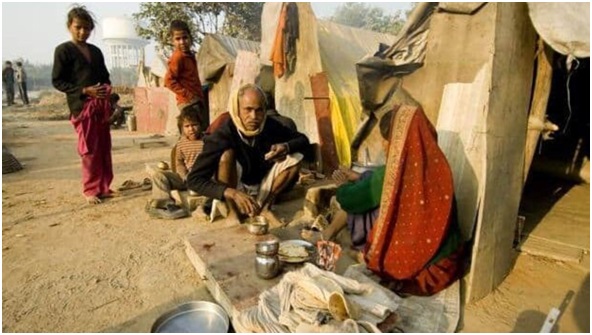
- 17 Aug 2023
Why in the News?
- In a recent assessment of multidimensional poverty conducted by NITI Aayog, the findings reveal a decline in the poverty rate from 25% in 2015-16 to 15% in 2019-21.
- Notably, approximately 135 million individuals were elevated from impoverished conditions within this timeframe.
- Consequently, it becomes imperative to scrutinize the methodologies underpinning the multidimensional poverty index and ascertain the continued pertinence of poverty evaluations based solely on consumption.
What is Multidimensional Poverty?
- Traditionally, poverty has been predominantly gauged through single-dimensional indicators, frequently revolving around income levels.
- Multidimensional poverty, in contrast, comprehensively addresses the array of deficiencies that individuals grappling with poverty encounter in their daily existence.
- These deficiencies encompass compromised health, limited access to education, insufficient living conditions, disempowerment, subpar employment situations, exposure to violence, and inhabiting environmentally precarious regions, among other factors.
Distinguishing Between Consumption-Based and Multidimensional Poverty Indices (MPI):
- Poverty gauges based on consumption levels primarily address one aspect of deprivation, without accounting for other dimensions.
- The global MPI encapsulates both the extent of multidimensional poverty (the percentage of individuals within a population grappling with multidimensional poverty) and its depth (the average number of deprivations experienced by each impoverished individual).
- Nonetheless, it's important to recognize that while Multidimensional poverty estimates offer valuable insights, they are not intended to replace the National Sample Survey (NSS) consumption-based poverty ratios.
Recent Findings on Multidimensional Poverty in India:
- Within a mere 15-year span, from 2005/2006 to 2019/2021, a striking 415 million individuals in India have successfully transcended poverty, showcasing a commendable accomplishment by the world's most populous nation.
- These revelations stem from the latest global release of the Multidimensional Poverty Index (MPI) by the United Nations Development Programme (UNDP) and the Oxford Poverty and Human Development Initiative (OPHI) based at the University of Oxford.
- The global MPI stands as a comprehensive measure of poverty, encapsulating the various deprivations that underprivileged individuals encounter in the realms of education, health, and living conditions.
- In the year 2005/2006, approximately 645 million people grappled with multidimensional poverty in India; this figure dwindled to around 370 million in 2015/2016 and further down to 230 million in 2019/2021.
Challenges Associated with the Multidimensional Poverty Index:
- The Global MPI's Findings Are Not a Novel Revelation
- The application of the Global MPI as a conclusive breakthrough isn't unprecedented.
- Poverty estimations grounded in consumer spending and utilizing the Tendulkar committee's framework revealed a reduction of 137 million individuals living in poverty between 2004-05 and 2011-12, despite population growth.
- Following the Rangarajan Committee's methodology, the decrease from 2009-10 to 2011-12 stands at 92 million, equating to an annual reduction of 46 million.
- Myriad Indicators to Consider
- Given the extensive array of dimensions and indicators, it becomes imperative to engage in meticulous asset mapping to pinpoint the most pertinent parameters.
- However, owing to the abundance of indicators spanning multiple dimensions, the accurate evaluation, and consequent effective policy implementation might pose challenges.
- Aggregating Across Indicators
- This presents yet another predicament, as these indicators should ideally remain independent of each other.
- For instance, indicators like access to clean drinking water should not be aggregated with factors such as child mortality."
Challenges Regarding Consumption Expenditure Surveys:
- After 2011-12, there is a lack of accessible official records on consumer expenditure, which inhibits the capacity to juxtapose it with trends in the multidimensional poverty index.
- The survey outcomes about consumption expenditures from 2017-18 have not been officially disseminated.
- Given the dearth of this information, various studies have attempted to investigate poverty utilizing indirect techniques along with resources such as the Centre for Monitoring Indian Economy (CMIE) and the Periodic Labour Force Survey (PLFS). These endeavors, however, have yielded disparate findings.
Approaches to Tackle MPI Challenges:
- Integration of MPI with Consumption-Based Poverty Assessments
- Examining the advancements in non-monetary aspects like education, healthcare, sanitation, access to clean water, and child survival alongside income or consumption poverty can provide valuable insights.
- However, the conversion of all these variables into a single index introduces complexities.
- Incorporating Public Services as an Additional Dimension: Regarding multidimensional matters, considering public services as an independent dimension, beyond consumption, can yield more comprehensive results.
Reforming Consumption Expenditure Surveys: A Necessity
- Enhancing Data Collection Practices
- An imperative concern revolves around the disparities observed in aggregate consumption estimations between National Accounts Statistics (NAS) and National Sample Survey (NSS) data.
- It's worth noting that across all nations, the NSS and NAS consumption estimates invariably diverge – a trend India also follows.
- What is particularly perplexing is the escalating dissimilarity in India between NSS and NAS consumption figures over the years.
- From a divergence of under 10% in the late 1970s, this gap has widened to a substantial 53.1% in 2011-12. This disparity is too significant to disregard.
- The National Statistical Office ought to meticulously analyze this issue and proffer potential solutions to enhance data collection through both avenues.
- Moreover, it's essential to complement the outcomes of consumption surveys with an evaluation of the impact of public expenditure on the health and education of distinct expenditure strata.
A prevalent perception associates wealth or destitution with high or low-income levels. The insufficiency of income is mirrored in numerous non-income poverty indicators.
Defining poverty in terms of income, or when income data is lacking, in terms of expenditure, appears to be the most pertinent approach, and this methodology is prevalent across the majority of countries.
Why India Needs an Industrial Policy? (The Hindu)
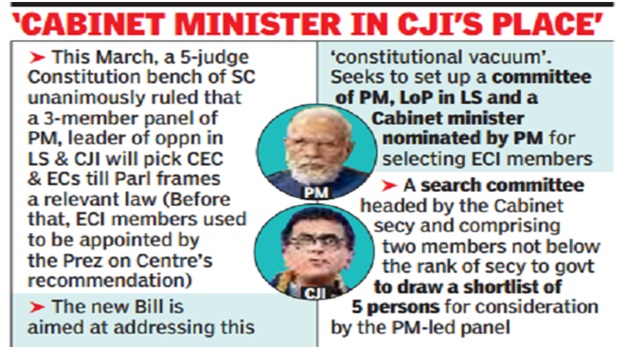
- 12 Aug 2023
Why in the News?
The Union Government on Thursday introduced a Bill removing the Chief Justice of India (CJI) from a three-member panel to select the Chief Election Commissioner (CEC) and Election Commissioners.
What's in the News?
- The government has brought the Chief Election Commissioner and other Election Commissioners (Appointment, Conditions of Service and Term of Office) Bill, 2023, in the Rajya Sabha.
- This bill aims to eliminate the Chief Justice of India (CJI) from the group responsible for selecting the Chief Election Commissioner and Election Commissioners.
- In an earlier development in March 2023, the Supreme Court decreed that a three-member committee should oversee the selection process for Chief Election Commissioner and Election Commissioners.
- The committee, according to this ruling, should consist of the Prime Minister, the Leader of the Opposition in the Lok Sabha, and the Chief Justice of India.
Supreme Court's Stand on Election Commission Appointments:
- A Constitution Bench of the Supreme Court, comprising five judges, was engaged in hearing a collection of petitions requesting a selection procedure akin to that observed in the appointment of the Director of the Central Bureau of Investigation (CBI).
- The Director of the CBI is appointed through a committee, which includes the Prime Minister, the Leader of the Largest Opposition Party, and the Chief Justice of India.
- In a unanimous decision reached in March 2023, the Court expressed its dissent regarding the existing approach of the Central Government in nominating members of the electoral oversight body.
- Citing Article 324(2) of the Constitution, the Court urged the Parliament to establish legislation governing the criteria for selection, terms of service, and duration of office for the Chief Election Commissioner (CEC) and Election Commissioners (ECs).
- Pending the formulation of such legislation, the highest court convened a panel comprised of the Prime Minister, the Chief Justice of India, and the leader of the opposition to undertake these appointments.
Proposed Bill to Remove CJI from Panel for Election Commissioner Selection:
The Chief Election Commissioner and other Election Commissioners (Appointment, Conditions of Service and Term of Office) Bill, 2023, has been introduced by the Law Minister in the Rajya Sabha.
Highlighted Aspects of the Bill:
- Exclusion of CJI:
- The bill endeavors to substitute the Chief Justice of India with a Cabinet Minister nominated by the Prime Minister within the committee tasked with choosing the Chief Election Commissioners (CECs) and Election Commissioners (ECs).
- Addition of Opposition Leader:
- The bill adds the Leader of the Opposition in Lok Sabha as a member of the selection committee.
- Eligibility Criteria:
- The bill stipulates that individuals for the ECI, including CEC and ECs, must be individuals who hold or have held positions equivalent to Secretary to the Government of India.
- They should possess integrity, coupled with expertise and familiarity in election management and administration.
- Selection Process:
- Initially, a Search Committee, headed by the Cabinet Secretary and encompassing two members not below the rank of Secretary with election-related knowledge, will craft a list of five candidates.
- This list will then be submitted to the Selection Committee.
- Composition of Selection Committee:
- Chaired by the Prime Minister, the Selection Committee comprises the Leader of the Opposition or the leader of the largest Opposition party in Lok Sabha, alongside a Cabinet Minister designated by the Prime Minister.
- The Selection Committee is empowered to consider candidates outside the Search Committee's list.
- Tenure and Terms:
- The CEC and ECs continue to hold their positions for a six-year term or until reaching the age of 65, whichever comes earlier.
- The Bill aligns their remuneration with that of the Cabinet Secretary.
- This diverges from the current practice under the Election Commission (Conditions of Service of Election Commissioners and Transaction of Business) Act, 1991, which equates their salary with that of a Supreme Court judge. Despite the change, the monetary amount remains consistent.
- Repealing the 1991 Act:
- The bill revokes the Election Commission (Conditions of Service of Election Commissioners and Transaction of Business) Act, 1991, which hitherto guided the operations of the ECI.
- The Bill mandates that the ECI's proceedings be conducted with unanimity whenever possible; in the case of divergent opinions, the majority's viewpoint prevails.
About Election Commission of India:
- The Election Commission of India (ECI) is an autonomous constitutional authority responsible for administering Union and State election processes in India.
- It was established in accordance with the Constitution on 25th January 1950 (celebrated as national voters' day). The secretariat of the commission is in New Delhi.
- The body administers elections to the Lok Sabha, Rajya Sabha, and State Legislative Assemblies in India, and the offices of the President and Vice President in the country.
- It is not concerned with the elections to panchayats and municipalities in the states. For this, the Constitution of India provides for a separate State Election Commission.
- By Article 324 of the Constitution of India, it is vested with the power of conducting elections to Parliament, State Legislatures, Office of President and Vice-President of India.
Structure of ECI:
- Initially, the commission had a single election commissioner. Yet, the Election Commissioner Amendment Act 1989 transformed it into a group with multiple members.
- The Election Commission is made up of the Chief Election Commissioner (CEC) along with additional election commissioners, determined by the President as needed.
- Currently, it comprises the CEC and two Election Commissioners.
- On a state level, the Chief Electoral Officer, an IAS rank Officer, supports the election commission.
Appointment & Term of Commissioners:
- The President designates the Chief Election Commissioner (CEC) and Election Commissioners.
- Their service spans six years or until they reach 65 years of age, whichever comes first.
- They are accorded equivalent status and entitlements to those enjoyed by Supreme Court (SC) Judges in India.
Removal:
- They possess the option to resign at any point or may face premature removal.
- In the case of the Chief Election Commissioner (CEC), dismissal can only occur through a procedure akin to the removal of a Supreme Court judge, executed by Parliament.
Limitations:
- The Constitution doesn't outline the prerequisites (legal, educational, administrative, or judicial) for Election Commission members.
- It doesn't define the duration of service for Election Commission members.
- It doesn't prevent former election commissioners from securing subsequent government appointments.
Mains Question:
- Analyze the constitutional mechanisms established to safeguard the autonomy and neutrality of the Election Commission of India. Discuss the constraints that can potentially influence the functioning of the Election Commission of India at the university level. (15M)
Select Committee for Delhi Services Bill (The Hindu)
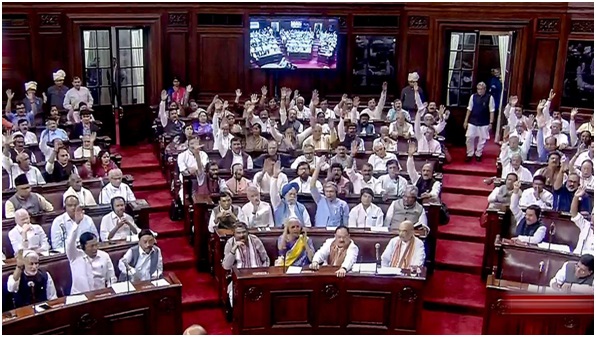
- 09 Aug 2023
Why in the News?
- Following complaints from a minimum of four Members of Parliament who expressed their objection to their names being added to a prospective Select Committee for the Delhi Services Bill without their prior consent, an important development unfolded.
- The proposition for the Select Committee had been put forth by Raghav Chadha, a Member of Parliament representing the Aam Aadmi Party (AAP), within the Upper House. Consequently, in light of these concerns, the Deputy Chairman of the Rajya Sabha made an announcement about initiating an inquiry into the matter.
Select Committee Overview:
- In India's Parliament, a diverse range of committees serves distinct functions.
- Among these, 12 Standing Committees are permanent entities, their members nominated periodically by the Chairman.
- Amit Shah's preference for the Privileges Committee to address the Raghav Chadha issue aligns with this category.
- Additionally, there exist ad hoc or temporary committees established for specific purposes, such as the examination of specific Bills, and their dissolution upon fulfilling their role.
- A Select Committee belongs to this transient category.
Select Committee Procedure:
- Although transient, a Select Committee adheres to a defined procedure outlined in the Rules of Procedure.
- According to Rule 125 of the Rajya Sabha Rules and Procedures, any member can propose an amendment, advocating Bill's referral to a Select Committee.
- This motion can originate from the Bill's sponsoring member or any other parliamentarian.
How members are chosen for a Select Committee:
- In accordance with the rules of the Rajya Sabha, Bills earmarked for Select Committees are accompanied by motions passed by the House, specifying the individuals designated for the Committee.
- When a motion proposes Bill's referral to a Select Committee, the House is responsible for appointing the Committee members.
- It is a foundational principle that no member can be included in a Select Committee unless they willingly participate.
- The onus lies with the proposer of the motion to confirm the intended member's willingness to serve on the Committee. While rules mandate obtaining a member's consent before their inclusion, they do not explicitly address the collection of signatures.
- The actual composition of a Select Committee is variable, differing across Committees.
- In the context of Joint Committees, members are apportioned in a 1:2 ratio between the Rajya Sabha and the Lok Sabha.
- The Chairman of the Committee is typically selected by the Chairman of the Rajya Sabha from among the Committee members.
- Additionally, the member or Minister overseeing the Bill is usually included as a Committee member.
What is the functioning process of a Select Committee?
- To commence proceedings, a minimum of one-third of the total committee members must be present, constituting a quorum.
- In instances where votes are tied on a particular issue, the chairman (or another designated presiding individual) holds the authority for a decisive or casting vote.
- For a focused examination of specific aspects linked to the Bill, a sub-committee may be established by a select committee.
- The committee's chairperson will endorse the report, which can include dissenting opinions from any member.
- Following endorsement, the report and any dissenting viewpoints will be submitted, printed, and circulated among all members of the Rajya Sabha."
What are the roles of a Select Committee?
- The core responsibility of the Committee involves meticulously reviewing each clause within the Bill's text.
- This is carried out to ensure that the Bill effectively captures the original intention and proposed objectives.
- To facilitate this, the Committee can call upon experts, interested parties, and organizations for written input or oral testimonies.
- Furthermore, the Committee possesses the authority to seek elucidation from government officials regarding the underlying policy of different provisions in the Bill, as well as to obtain necessary background information.
- Upon collecting and analyzing the evidence, the Committee deliberates on the Bill's individual components and crafts its conclusions, potentially amending clauses as necessary.
- Additionally, the Committee holds the prerogative to physically visit relevant institutions and organizations to gain firsthand insights into matters tied to the Bill."
What happens following the submission of a Select Committee's report?
- The committee's report holds a suggestive character, allowing the government the flexibility to adopt or decline the recommendations presented.
- Furthermore, a Select Committee has the option to present its revised iteration of the Bill.
- Should this transpire, the minister responsible for the respective Bill can propose that the committee's version of the Bill be deliberated upon and approved within the legislative assembly."
Importance of Parliamentary Committees?
- Expertise in Legislation:
- Given that many Members of Parliament lack specialized knowledge in specific fields, relying on insights from experts and stakeholders is crucial for informed decision-making.
- Parliamentary committees play a pivotal role in aiding MPs to access expertise and allocate sufficient time to thoroughly analyze issues.
- Simulating Parliament's Functions:
- These committees effectively emulate the functions of the larger parliamentary body.
- Comprising MPs from various parties, they are elected using the single transferable vote method, reflecting the overall party distribution in Parliament.
- Thorough Examination Tool:
- Bills directed to these committees undergo meticulous scrutiny, with active engagement from external stakeholders, including the general public, to solicit diverse perspectives.
- Government Oversight Mechanism:
- Despite non-binding recommendations, committee reports serve as public records of inclusive consultations.
- They compel the government to reevaluate contentious provisions, adding a degree of accountability.
- Fostering Collaborative Discussions:
- Conducted behind closed doors, committee meetings encourage collaborative discussions among MPs.
- The absence of public scrutiny diminishes the need for grandstanding, enabling more productive exchanges."
Organ Shortage and Transplants in India (The Hindu)

- 08 Aug 2023
Why in the News?
Around three lakh patients wait for organ donation in the country and the country’s increase in donors has not kept pace with demand; experts say country urgently needs to increase its deceased donation rate, and there should be greater awareness among ICU doctors and families on how one deceased donor can save several lives.
Key Data Highlights:
Health Ministry's Insights:
- The count of donors, comprising both living and deceased, witnessed a growth from 6,916 in 2014 to approximately 16,041 in 2022.
- Within the domain of deceased donors, the nation achieved notable milestones with 1,589 kidney transplants, 761 liver transplants, and 250 heart transplants during 2022.
- A substantial progression was seen in kidney and pancreas transplants, ascending from merely three in 2014 to a significant 22 in 2022.
- Analysis of the statistics reveals a compelling trend where approximately 70% to 75% of donors are female. The roles of wives, mothers, and sisters have prominently emerged as major sources of organ donation.
Global Perspective:
- On a global scale, the reality remains that a mere 10% of individuals necessitating organ transplants are able to access them in a timely manner.
- Noteworthy examples of more robust organ donation systems can be observed in countries such as Spain and the United States. These nations exhibit higher numbers, with 30 to 50 organ donations per million people, showcasing a commendable commitment to addressing the shortage of organs.
Current Scenario of Organ Donation and Transplantation in India:
- The practice of organ transplants in India has witnessed a remarkable surge, growing by more than threefold, escalating from 4,990 instances in 2013 to an impressive 15,561 cases in 2022.
- The foremost among organ transplants remains the kidney transplant, followed by liver, heart, lung, pancreas, and small bowel transplants, collectively contributing to the medical landscape.
- The year 2022 stood out with the execution of nearly 12,791 living donor transplants and an additional 2,765 transplants from deceased donors.
- Of note, a notable proportion of these transplants (14%) were sourced from deceased donors, underscoring the significant role of living donors, particularly in kidney and liver contributions.
- In terms of geographic distribution, the organ donation dynamic is concentrated. In 2021, the bulk of deceased organ donations occurred within 15 specific states, with the top five states collectively accounting for an impressive 85% of the total contributions.
Why India Needs More Organ Donations?
- India boasts the distinction of being the world's third-largest performer of transplants. However, the demand for organs significantly outstrips the supply of available transplants.
- The surge in lifestyle-related illnesses is amplifying the call for organs, particularly for vital organs like hearts and lungs that are solely obtainable from deceased donors.
- An alarming number of approximately 1.5 lakh individuals succumb to road traffic accidents each year in India. This presents an opportunity to potentially harness organs from these cases, contributing to a more robust supply.
- Beyond saving lives, the practice of organ transplantation serves to alleviate the burden on healthcare systems. This includes a reduction in hospital stays, the need for repeat surgeries, and extended treatments.
- India's existing organ donation rate stands at a modest 0.52 per million population, notably lower than the figure in countries like Spain, which boasts a rate of 49.6 per million.
- One of the most compelling aspects of organ donation is its capacity to impact multiple lives simultaneously. A single donor can serve as a source of numerous organs and tissues, magnifying the potential to save and enhance multiple lives.
Issues, Challenges and Ethics in Organ Transplantation:
- Lack of Public Awareness:
- A prevailing challenge revolves around inadequate public awareness regarding the significance of organ donation and the subsequent transplantation process.
- This lack of understanding contributes to a dearth of available donated organs.
- Shortfall in Donors:
- Despite heightened efforts in awareness campaigns, a shortage of willing organ donors persists due to factors such as religious beliefs and a lack of trust in the healthcare system.
- Ethical and Legal Complexities:
- The arena of organ donation faces intricate ethical and legal dilemmas. These encompass matters like consent, the fair allotment of organs, and equitable distribution, presenting multifaceted challenges.
- Transportation and Preservation:
- The preservation and transportation of organs demand specific conditions to maintain their transplant viability.
- These logistical hurdles are especially pronounced for organs with limited shelf lives.
- Medical Suitability Constraints:
- The suitability of donated organs for transplantation can be impeded by medical conditions or other considerations.
- This dynamic can impose restrictions on the available pool of organs for potential transplant recipients.
- Financial Implications:
- A significant challenge arises in the form of the associated costs linked with organ transplantation.
- These financial burdens can potentially restrict access to treatment for certain patients, creating disparities in care.
What are the Government Steps Taken to Promote Organ Donation in the Country?
- National Organ Donation Day:
- Designating November 27 as National Organ Donation Day, the Indian government seeks to heighten public awareness about the significance of organ donation and encourage individuals to pledge their organs.
- National Organ Transplant Programme (NOTP):
- Launched in 2014, NOTP is a comprehensive endeavor.
- It aims to create a national registry encompassing both organ donors and recipients, bolster the presence of organ transplant centers, and foster greater awareness about the critical nature of organ donation.
- Deceased Organ Donation Program:
- The Ministry of Health and Family Welfare introduced this program to actively encourage organ donations from individuals who have passed away.
- Transplantation of Human Organs and Tissues Act (THOTA):
- Instituted in 1994, THOTA serves as the framework regulating organ transplantation within India.
- This legislative act also establishes the National Organ and Tissue Transplant Organization (NOTTO) and State Organ and Tissue Transplant Organizations (SOTTO).
- Their roles encompass overseeing organ transplantation activities and donations.
- Swasth Bharat Yatra:
- Spearheaded by the government, this campaign is dedicated to promoting a health-conscious lifestyle, preventing lifestyle diseases, raising awareness about organ donation, and motivating individuals to pledge their organs.
- National Organ and Tissue Transplant Registry:
- Establishing a dedicated National Organ and Tissue Transplant Registry, India now maintains comprehensive records of organ donations and transplantations across the nation.
- This database aids in formulating effective policies and strategies for fostering organ donation and transplantation.
- Organ Retrieval Banking Organization:
- Housed within the All India Institute of Medical Sciences (AIIMS) in New Delhi, this organization assumes responsibility for retrieving, preserving, and efficiently distributing organs for transplantation in the Delhi-NCR region.
Moving Ahead:
At present, India is witnessing an enhanced consciousness regarding organ donation, with a growing number of families expressing willingness to engage in this altruistic endeavor, as reported by medical professionals. In the journey forward, it is imperative to emphasize awareness, cultivate trust, and augment the cadre of medically proficient transplant coordinators. This collective effort holds the potential to amplify deceased donations significantly. In the broader spectrum, organ transplantation stands as a pivotal pillar in the medical domain. It not only bestows hope upon individuals grappling with organ failure but also elevates their quality of life, embodying a profound impact on healthcare.
Mains Question:
- Discuss the impact of government initiatives like the National Organ Transplant Programme and the Deceased Organ Donation Program on addressing challenges and increasing awareness in organ transplantation in India. (15M)
Incremental injustice (The Hindu)
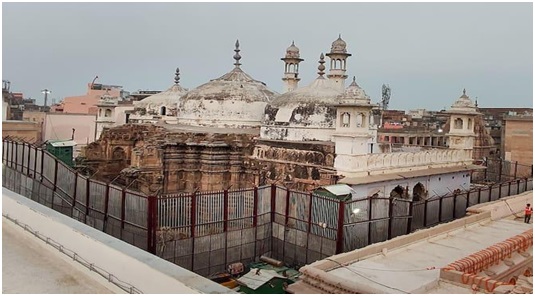
- 07 Aug 2023
Why in the News?
Recently, the Varanasi District Court issued an order for the Archaeological Survey of India (ASI) to conduct a survey of the Gyanvapi mosque.
Background:
In 1984, around 558 Hindus assembled in Delhi to hold the first religious parliament. During this gathering, they made a unanimous decision to initiate a nationwide campaign for Hindus to assert their rights over the sacred shrines located in Varanasi, Mathura, and Ayodhya. The movement gained momentum after the Ram Janma Bhumi-Babri Masjid dispute in 1990. Although the initial call was to claim about 3000 mosques in the mentioned areas, Hindu religious groups focused their efforts on two particular mosques: (1) The Shahi Idgah mosque, situated adjacent to the Lord Krishna temple in Mathura, and (2) The Gyanvapi mosque, located next to the Kashi Vishwanath temple in Varanasi.
What is Gyanvapi Mosque Dispute?
Historical Background:
- There is a prevailing belief that the Gyanvapi Mosque was constructed in 1669 under the rule of the Mughal Emperor Aurangzeb. The mosque is said to have been built on the site where the ancient Vishweshwar temple once stood.
- According to Saqib Khan's book 'Yasir Alamgiri', it is mentioned that Aurangzeb ordered Governor Abul Hassan to demolish the Vishweshwar temple in 1669, paving the way for the construction of the Gyanvapi Mosque.
Judicial Intervention in the Gyanvapi Mosque Dispute:
- The legal case pertaining to the Gyanvapi mosque dates back to 1991 when three individuals, including Pandit Somnath Vyas, a descendant of the Kashi Vishwanath temple priests, filed a lawsuit in the civil court of Varanasi. Their claim asserted that Aurangzeb had demolished the original Lord Vishweshwar temple and constructed a mosque in its place, urging that the land should be restored to them.
- In 2021, five women lodged a petition in the same Varanasi court, seeking permission to worship at the temple of Mother Gauri. Consequently, the court appointed a commission to investigate the present status of the Makeup Gauri Temple.
- As part of the commission's task, the court instructed the survey report to be documented through video-graphing, covering the idol of Makeup Gauri and the Gyanvapi complex.
- This development sparked controversy as questions arose about the impartiality of the court-appointed commissioner representing the Muslim side in the survey process.
Arguments From Hindu Side:
- Vijay Shankar Rastogi, representing the Hindu side, presented a map of the entire Gyanvapi complex as evidence in court.
- The map indicates the presence of Hindu deities' temples beyond the mosque's entrance, along with the Vishweshwar temple, Gyankoop, the big Nandi, and the basement of the Vyas family.
- There has been a contentious issue regarding the survey and videography of the basement in question.
Arguments From Muslim Side:
- The Muslim side contends that the dispute cannot be adjudicated under the Religious Places Act of 1991.
- According to Section 3 of the Places of Worship (Special Provisions) Act, 1991, it is forbidden to convert a place of worship, including its precincts, into a place of worship of a different religious denomination or a different class within the same religious denomination.
- Section 4(2) of the Act stipulates that all ongoing litigations, appeals, or other proceedings concerning the alteration of the place of worship (which were pending until August 15, 1947) shall be terminated after the enactment of this Act, and no new actions can be initiated on such cases.
- However, legal action can be pursued if the alteration in the nature of the place of worship occurred after the cut-off date of August 15, 1947 (after the act came into force).
- For instance, the disputed site of Ayodhya (Ram Janmabhoomi-Babri Masjid) was exempted from the Act.
About Archaeological Survey of India (ASI):
- The Archaeological Survey of India (ASI) is a government agency responsible for preserving, conserving, and excavating archaeological sites and monuments in India.
- It was founded in 1861 and established by ‘Alexander Cunningham’
- It operates under the Ministry of Culture and it’s HQ is in Delhi.
- ASI's main objective is to protect and maintain India's rich cultural heritage, including ancient temples, forts, caves, sculptures, and archaeological remains.
- The organization conducts excavations and research to uncover historical insights and restore significant monuments to their original state.
- ASI plays a crucial role in promoting tourism and fostering a deeper understanding of India's history and cultural diversity.
- Its efforts contribute significantly to preserving invaluable historical treasures for future generations.
- It also regulates the Antiquities and Art Treasure Act, of 1972.
Places of Worship (Special Provisions) Act, 1991:
The Act prohibits converting any place of worship and ensures the maintenance of its religious character as it existed on August 15, 1947. It applies to the entire India, except Jammu and Kashmir.
- Bar of Conversion of Places of Worship:
- No person can convert any place of worship or its religious denomination into another religious sect or section of the same denomination.
- Declaration on Religious Character and Jurisdiction Bar:
- The religious character of a place of worship on August 15, 1947, remains unchanged.
- Pending suits or proceedings related to religious conversion shall abate, and no new suits can be filed after the Act's commencement.
- Exceptions include ancient and historical monuments, settled disputes, conversions before the Act, and barred challenges under limitations.
- Exemption for Ram Janma Bhumi-Babri Masjid:
- The Act does not apply to the Ram Janma Bhumi-Babri Masjid in Ayodhya, Uttar Pradesh, and related suits or proceedings.
- Punishment under the Act:
- Violation of Section 3 results in imprisonment up to three years and a fine.
- Attempting or abetting the offence carries similar penalties as provided under relevant IPC sections."
Preserving tribal culture: Odisha’s Special Development Councils model is worth emulating (The Hindu)
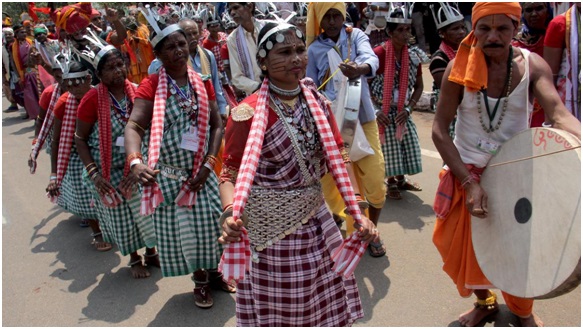
- 02 Aug 2023
Why in the News?
In Odisha's development model driven by the 5T principles (transparency, technology, teamwork, time limit, and transformation), the vision of inclusive growth and community-led development goes beyond being a mere idea; it stands as an actionable strategy with tangible outcomes.
Tribal population in India:
- India encompasses a significant tribal population of 8.6%, possessing a vast repository of indigenous knowledge that holds the potential to offer sustainable solutions through recognition, adoption, and integration into mainstream practices.
- As per Article 342 of the Indian Constitution, the President has the authority to specify, with respect to any State or Union territory, the tribes, tribal communities, parts of, or groups within tribes or tribal communities as Scheduled Tribes.
Tribal Culture: A Glimpse
- Communal Bond: Many tribal communities in India embrace a strong sense of communal living, where resources are shared, and decisions are collectively made within close-knit communities.
- Connection with Nature: Tribals deeply connect with nature, embracing traditional beliefs and practices centered around forests and animals.
- Self-Sufficiency: A tribe embodies self-reliance, forming relatively closed societies where their self-sufficiency pursuits define their openness to the outside world.
- Spiritual Traditions: Tribals nurture distinct spiritual beliefs, often venerating ancestors, nature spirits, or deities, adding uniqueness to their cultural tapestry.
- Expressive Artistry: Tribals are celebrated for their exquisite art forms, such as pottery, weaving, and jewelry making. These crafts hold spiritual and cultural significance, passing down through generations.
Tribal Lifestyle and Sustainable Development:
- Harmony with Nature: The tribal lifestyle upholds profound respect for the natural environment, incorporating sustainable practices like using natural materials for housing, food, and medicine, and living in sync with nature's cycles.
- Community-Centric Decision-Making: Their collective decision-making process prioritizes the needs of the entire community, ensuring sustainable and equitable choices.
- Biodiversity Preservation: Tribals actively promote biodiversity by employing traditional agricultural techniques like intercropping and seed saving, as well as safeguarding sacred sites vital for biodiversity conservation.
- Resource Conservation: Sustainable practices involve judicious resource usage, such as rotational farming and allowing forests to regenerate before harvesting timber, ensuring their long-term availability.
- Intergenerational Knowledge Transfer: Passing down knowledge to future generations includes traditional wisdom about the natural environment and sustainable resource management.
- Water Resource Protection: Tribal communities have devised practices to safeguard water resources, guaranteeing their availability for future generations while reducing greenhouse gas emissions.
- Regenerative Agriculture: For centuries, tribal communities have practiced regenerative agriculture, incorporating crop rotation, intercropping, and organic matter to enrich soils and sequester carbon, contributing to climate change mitigation.
- Embracing Renewable Energy: Traditional reliance on renewable energy sources like wind, solar, and hydropower offers a model for expanding and modernizing clean energy solutions for broader communities.
Challenges Confronting Tribal Lifestyles:
- Discrimination: Tribal communities frequently encounter discrimination and bias from the dominant society, leading to restricted access to education, healthcare, and essential services.
- Land Rights: Displacement from ancestral lands due to industrialization and mining has led to the loss of cultural identity and socio-economic marginalization among tribal communities.
- Climate Change and Environmental Degradation: Adverse effects of climate change, such as altered rainfall patterns, more frequent natural disasters, biodiversity loss, deforestation, pollution, and habitat destruction, have severely impacted their traditional livelihoods and ways of life.
- Socioeconomic Marginalization: Limited access to education, healthcare, and economic opportunities has resulted in poverty and social exclusion for many tribal communities.
- Lack of Political Representation: Tribal communities often lack political representation, depriving them of a voice in decision-making processes that directly influence their lives.
- Cultural Assimilation: Pressures to conform to the dominant culture impose a risk of losing traditional knowledge, language, and cultural practices within many tribal communities.
What is Odisha's Special Development Councils (SDCs) Initiative?
- In a momentous stride towards preserving, promoting, and celebrating tribal culture while advancing the trajectory of development, the Odisha government introduced the Special Development Councils (SDCs) initiative in 2017.
- The primary objective is to safeguard the rich culture and heritage of 62 tribes in the State under a unified approach while ensuring continued economic progress in the regions.
- Originally encompassing 9 tribal-dominated districts and benefiting 60 lakh tribal households across 117 blocks, the initiative has now expanded to cover 23 districts, extending its benefits to over 84 lakh tribal individuals.
Government Initiatives for Tribal Culture Conservation:
- National Scheduled Tribes Finance and Development Corporation (NSTFDC): Established in 2001 under the Ministry of Tribal Affairs, NSTFDC aims to uplift Scheduled Tribes economically through concessional financial assistance under various schemes.
- TRIFED's Tribal Initiatives: The government plans to establish 50,000 Van Dhan Vikas Kendras and 3,000 Haat Bazaars, fostering economic opportunities for tribal populations.
- Central Sector Scheme: Supporting Institutional Development & Marketing of Tribal Products/Produce.
- Centrally Sponsored Scheme: Ensuring a sustainable mechanism for Marketing Minor Forest Produce (MFP) through Minimum Support Price (MSP) and developing value chains, providing social safety for MFP gatherers.
- Pradhan Mantri Van Dhan Yojana: A market-linked tribal entrepreneurship development program promoting the formation and strengthening of Tribal Producer Companies through clusters of tribal Self Help Groups (SHGs).
- Scholarships: Government-funded scholarships for pre-matric, post-matric, and overseas education, facilitating educational access for tribal students.
- Support to NSTFDC: Assistance to the National Scheduled Tribes Finance and Development Corporation for further empowerment initiatives.
- Development of Particularly Vulnerable Tribal Groups (PVTGs): Comprehensive support encompassing housing, land distribution, agricultural and animal husbandry development, link road construction, and more.
- Vocational Training in Tribal Areas: Focused on enhancing the skills of ST youth for diverse job opportunities and self-employment, elevating their socio-economic status.
Mains Question:
- Examine the challenges faced by tribal lifestyles and evaluate the effectiveness of government initiatives for tribal culture conservation in improving socio-economic conditions and preserving cultural heritage among tribals. (15M)
The Forest (Conservation) Amendment Bill, 2023 (The Hindu)
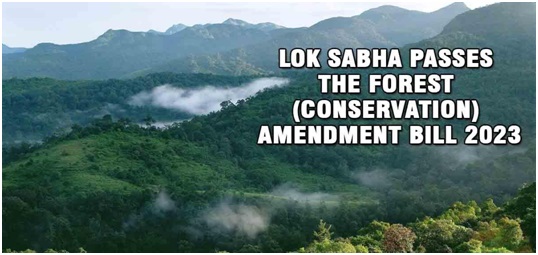
- 28 Jul 2023
Why in the News?
Amidst pandemonium, the Lok Sabha passed the Forest Conservation (Amendment) Bill on July 26, without any changes from the version first introduced on March 29. The contentious Bill was introduced to amend the Forest Conservation Act, 1980.
Context:
- The Forest (Conservation) Act, 1980, was enacted to prevent large-scale deforestation and mandates central government approval for diverting forest land for non-forest purposes.
- The pressure on forest land has increased due to various factors like industry demands, agriculture, and the need for forest produce, as noted by the Standing Committee on Science and Technology, Environment, and Forests (2019).
- The Forest (Conservation) Amendment Bill alters the criteria for including and excluding forest land from the Act's scope, presenting modifications to address the evolving challenges faced in forest conservation.
What is The Forest (Conservation) Act 1980?
- The Forest (Conservation) Act of 1980 was implemented to safeguard India's forest land from unauthorized encroachments for non-forestry activities.
- It grants the Central government the authority to demand appropriate compensation when forest land is diverted for non-forestry purposes.
- Furthermore, the Act extends its scope to encompass areas not officially classified as "forest" in State or Central government records.
Need for the recent amendments:
- The process of obtaining forest-clearance approval in India is challenging, involving significant delays and potential corruption.
- Inconsistent land records add to the complexity, as parcels marked as forests in one record may have different classifications elsewhere.
- A court order inadvertently discouraged states from reclassifying forests, complicating matters further.
- The amendments aim to eliminate ambiguities and provide clear guidelines for the Act's application to different types of lands.
Key Features of the Forest (Conservation) Amendment Bill, 2023:
- Land under the Act:
- The Bill includes two categories of land under its purview, including officially declared forest land and land notified as a forest after October 25, 1980.
- Exemptions:
- Certain land types, such as forest land along railways or public roads maintained by the government, are exempted from the Act's provisions.
- Assignment/Leasing of Forest Land:
- Prior approval of the central government is required for assigning forest land to any entity, including those owned and controlled by the government, with specific terms and conditions.
- Permitted Activities:
- The Bill expands the list of activities excluded from non-forest purposes, including zoos, ecotourism facilities, silvicultural operations, and others specified by the central government.
- Power to Issue Directions:
- The central government may issue implementation directions to any recognized authority or organization under the central, state, or union territory.
Upsides of the Forest Amendment Bill:
- Certain amendments outline exclusions where the Act won't apply.
- Other amendments promote plantation cultivation on non-forest land, potentially increasing tree cover, acting as a carbon sink, and supporting India's emissions reduction goals.
- The bill would lift restrictions on infrastructure development for national security and livelihood opportunities for forest-adjacent communities.
Environmentalists' Concerns with the Forest Amendment Bill:
- Changing the Act's name to Van (Sanrakshan Evam Samvardhan) Adhiniyam raises confusion.
- Reclassifying forest areas may invalidate past judgments and reduce protection for vast forest tracts.
- The Bill doesn't consider the real scenario of deforestation and its impact on ecological functions.
- Exemptions in border areas may hinder the rights of forest-dwelling tribes and reduce the necessity of forest clearances.
- The Bill was referred to a joint committee instead of the standing committee, raising concerns about the potential lack of scrutiny.
Government's Intention with the Forest Amendment Bill:
- The government sees this as a crucial opportunity to address a 27-year-old policy deadlock that hinders growth and employment while not effectively conserving forests.
- The amendments are necessary to align with India's evolving ecological, strategic, and economic aspirations. They aim to:
- Support India's objective of increasing forest and tree cover to a third of its land area.
- Help achieve Net Zero emissions by 2070 and enhance forest carbon stocks through sustainable development.
- Create a carbon sink of 2.5-3 billion tonnes of CO2-equivalent by 2030 under the Nationally Determined Contribution targets.
- Enable the act to address emerging ecological challenges related to forest conservation, restoration, compensatory mechanisms, and mitigation measures.
Striking a Balance between Forest Conservation and Economic Activities:
- The 1980 Act aimed to combat deforestation, necessitating central government approval for diverting forest land for non-forest purposes. Additionally, only certain conservation and wildlife management activities were allowed without prior approval.
- The Bill introduces new activities like silvicultural operations, safaris, and eco-tourism facilities to this list. It also permits certain surveys without central government approval.
- These activities can contribute to economic development and align with national priorities such as energy security and industrial growth, especially in cases like mineral prospecting.
- However, achieving a balance between economic benefits and forest conservation is crucial. The shift from case-by-case examination by the central government to a blanket exemption raises questions about the mechanism for striking this balance.
The Forest (Conservation) Amendment Bill, 2023, warrants meticulous examination to reconcile the noble aspirations outlined in its Preamble with the possible detrimental impact of its operative provisions. An inclusive approach encompassing expanded forest definitions, safeguards for delicate ecosystems, and active involvement of forest communities is imperative. Sustainable development should not entail forest degradation, but instead, harmonize efforts to safeguard India's natural legacy for generations to come. Responsible and holistic conservation endeavors are vital to fulfilling India's net-zero carbon commitments and preserving its invaluable ecosystems.
Mains Question:
- Evaluate the Forest (Conservation) Amendment Bill, 2023, considering its impact on forest preservation, sustainability, and environmental concerns. Suggest measures for balancing economic activities with responsible forest conservation to achieve net-zero carbon commitments. (15 M)
Gaganyaan Human Spaceflight Mission (The Hindu)
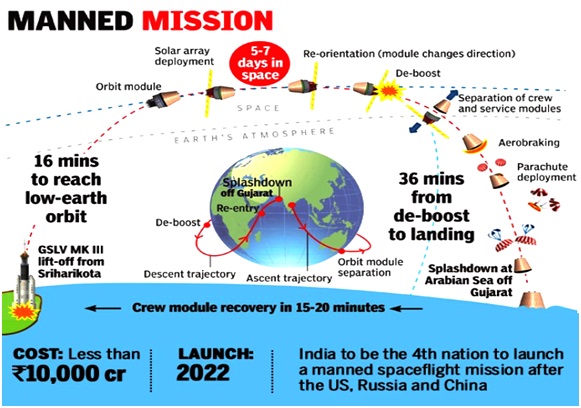
- 27 Jul 2023
Why in the News?
Indian Space Research Organisation (ISRO) successfully carried out two more hot tests on the Gaganyaan Service Module Propulsion System (SMPS) at ISRO Propulsion Complex (IPRC), Mahendragiri (Tirunelveli District), Tamil Nadu.
About Gaganyaan Mission:
- The Gaganyaan program is an indigenous manned mission aiming to send Indian astronauts to space.
- As part of the Indian Human Spaceflight Programme, this Indian crewed orbital spacecraft plans to carry 3 astronauts to space by the end of 2023 or in 2024.
- Upon its successful execution, India will become the 4th nation after US, Russia and China to achieve a Human Spaceflight Mission.
- It is launched by ISRO's Geosynchronous Satellite Launch Vehicle GSLV Mk III (3 stages heavy-lift vehicle).
What is the Significance of Gaganyaan Mission for India:
- Self-reliance and Make in India: The Gaganyaan mission contributes to India's aspiration of achieving self-reliance by boosting the Make in India initiative, reducing reliance on external support for satellite launches.
- Advancing R&D and Robotics: The mission propels scientific and technological research and development, especially in space exploration, facilitating India's long-term and cost-effective plans for robotic and human exploration beyond the solar system.
- Addressing Regional Demands: Gaganyaan's focus on regional requirements becomes essential, given the limited availability of International Space Stations (ISS) worldwide, making it a relevant initiative for regional space exploration.
- Strengthening International Ties: By promoting collaborative and peaceful endeavors, the Gaganyaan mission fosters international partnerships and contributes to global security.
- Boost to Academic Organizations: The Gaganyaan Programme is a collective national endeavor, fostering active involvement from academia and National Agencies. It will establish an extensive framework for collaboration, uniting ISRO, academia, industry, national agencies, and other scientific organizations in a collaborative effort.
- Elevated Prestige: Gaganyaan's successful mission will position India as the 4th country to achieve human spaceflight, elevating the nation's prestige on the global stage. Also, it will solidify India's significant role as a key player in the space industry.
Challenges in the Mission:
- Launch Reliability: The GSLV Mk III requires significant modifications to meet human-rated and fail-safe criteria, with the challenge of achieving a reliability of 98% or higher, posing a daunting task.
- Crew Escape System: Developing a reliable crew escape system is crucial to prepare for emergencies from the launch phase onwards. The Environmental Control & Life Support System (ELCSS), space suit, and crew support systems are still in the developmental stage.
- Astronaut Training: India lacks facilities for comprehensive training, including centrifuges to simulate g-forces and aircraft for zero-gravity simulations, posing a hurdle in preparing astronauts adequately.
- Threat of Space Debris: The increasing threat of space debris in low earth orbits raises concerns about potential collisions with small debris, leading to cabin depressurization in the crew module.
- Financial Implications: Human space flight missions are not one-time investments but an ongoing pursuit with national benefits, raising financial concerns regarding long-term funding requirements.
Problems Faced by Gaganyaan Astronauts:
- Environmental Hazards: Astronauts encounter radiation risks and navigate a hostile space environment devoid of gravity and atmosphere.
- Artificial Atmosphere: Two primary options for creating a suitable atmosphere are pure oxygen or a combination of oxygen and an inert gas like nitrogen, helium, or argon.
- Medical Issues: Microgravity can impact hand-eye and head-eye coordination, orientation, vision, muscle strength, aerobic capacity, etc. Additionally, isolation and reliance on limited resources may lead to behavioral issues such as depression, cabin fever, fatigue, sleep disorders, and psychiatric disorders.
- Aerospace Technology Challenges: Space travel demands significantly higher speeds than regular air travel, with rockets accelerating to approximately 25,000 km per hour within minutes. Launch, pre-launch, and post-launch periods pose potential risks, including rocket malfunctions.
Way Forward for India's Space Programme:
- Private Sector Involvement: Encouraging the participation of the private sector in supporting ISRO and developing critical space technologies is vital.
- Promoting Youth Engagement: Initiating campaigns and media outreach to stimulate the interest of young individuals in space activities will help nurture future talent.
- Continued Government Support: The government should persist in its encouragement and support of ISRO's endeavors, while also engaging the private sector in space activities.
Pursuing a manned space programme becomes the logical progression for India. Gaganyaan's success will elevate India to the elite club of space superpowers and pave the way for developing its own space station. Overcoming technological challenges is crucial for ensuring the safety and success of future manned missions.
International Collaboration: Collaboration with other nations will be essential for acquiring the necessary technologies and expertise to further India's space exploration goals.
Zero Hunger and the Global Report on the Food Crises 2023 (The Hindu)
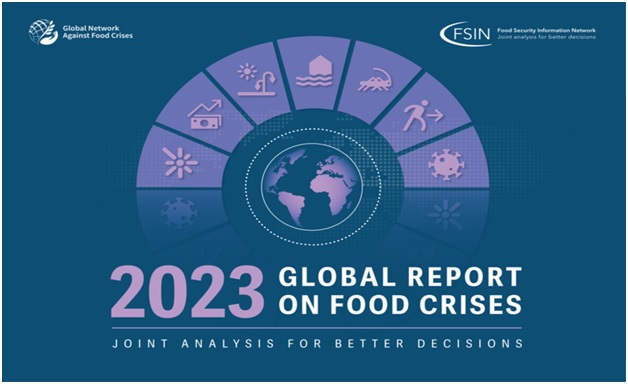
- 24 Jul 2023
Why in the News?
The Global Report on Food Crises (GRFC) 2023, produced by GNAFC (Global Network Against Food Crisis), offers crucial insights into global food insecurity. It sheds light on the scale of hunger and the obstacles in achieving Sustainable Development Goal 2 - Zero Hunger.
By analyzing factors contributing to food insecurity and undernourishment, the report presents vital solutions to tackle this urgent challenge.
What is GNAFC?
GNAFC, founded in 2016 by the European Union, FAO, and WFP, is an alliance of humanitarian and development organizations collaborating to prevent, prepare for, and respond to food crises. Their collective efforts aim to support the achievement of Sustainable Development Goal 2, which is to End Hunger.
Key Findings:
- Food Insecurity and Undernourishment: According to the GRFC, hunger affected between 691 million and 783 million people in 2022, a significant increase from pre-pandemic levels in 2019. The number of individuals lacking adequate access to food rose to 2.4 billion in 2022, up by 391 million compared to 2019. Additionally, undernourishment prevalence reached 9.2% of the global population in 2022, compared to 7.9% in 2019.
- Positive Developments: Despite concerning figures, the report highlights some positive trends. Stunting among children under five decreased from 204.2 million in 2000 to 148.1 million in 2022, while child wasting declined from 54.1 million to 45 million during the same period. However, there was a slight, non-significant increase in child overweight or obesity, rising from 5.3% (33 million) in 2000 to 5.6% (37 million) in 2022.
- Cost of a Healthy Diet: The GRFC's revised analysis indicates that nearly 3.2 billion people worldwide couldn't afford a healthy diet in 2020, with a slight improvement in 2021. The global cost of a healthy diet rose by 6.7% from 2019 to 2021. The report projects that approximately 600 million people will face chronic undernourishment in 2030.
What is food security?
- Food security, as defined by the World Food Summit of 1996, refers to a state where all individuals have continuous physical and economic access to an adequate supply of safe, nutritious food that fulfills their dietary requirements and preferences, supporting an active and healthy lifestyle.
- The prevalence of moderate or severe food insecurity in the population is assessed using the Food Insecurity Experience Scale (FIES).
Drivers of Food Insecurity:
- Pandemic-related Disruptions: The COVID-19 pandemic, along with its associated lockdowns, economic downturns, and job losses in 2020, has significantly contributed to food insecurity, aggravating existing challenges.
- Russia-Ukraine War: Ongoing conflicts, such as the war in Ukraine, have further impacted global food insecurity, causing disruptions in food supply chains.
- Governmental Policies: Certain governmental policies may inadequately address food insecurity, posing obstacles to achieving Zero Hunger.
- Urbanization: The increasing trend of urbanization has led to changes in agrifood systems, resulting in varying food security levels among different population groups.
- Weather and Climate Extremes: Extreme weather events and climate variations have become the primary drivers of acute food insecurity in 12 countries. Droughts, floods, and storms severely disrupt agricultural production and food supply chains.
- Conflict: Ongoing conflicts and insecurity remain the most significant drivers of acute food insecurity in 19 countries/territories, affecting food access and availability in these regions.
Solutions for Achieving Zero Hunger:
- Promoting Healthier Food Outlets: The report highlights the need for policy incentives to encourage shops to sell fresh and minimally processed foods, improving access to nutritious diets and positively impacting food security.
- Enhancing Street Food Safety: Addressing street food safety, considering its widespread consumption by approximately 2.5 billion people daily, is crucial. Improving infrastructure and regulations surrounding street food can enhance nutritional safety and quality.
- Investing in Rural Infrastructure: Building rural infrastructure, including quality rural roads and linkages to main networks, can enhance connectivity for small farms and enterprises, boosting food production and distribution.
- Empowering Local Governments: Local governments play a significant role in implementing policies to ensure healthy diets are available and affordable for all. Their active involvement can lead to effective multilevel and multi-stakeholder mechanisms for achieving food security.
The Global Report on Food Crises 2023 highlights the ongoing issue of food insecurity worldwide. Implementing the recommended solutions and addressing the drivers of food insecurity will enable the international community to make significant progress toward achieving Zero Hunger and ensuring sufficient and nutritious food for all.
Recent Government Initiatives to Address Food Insecurity:
The Indian government has introduced various initiatives aimed at tackling food insecurity and alleviating poverty within the country. Some of these initiatives include:
- One Nation One Ration Card: Beneficiaries can access subsidized food grains from the Public Distribution System (PDS) across the country, regardless of their location.
- PM Garib Kalyan Ann Yojana (PMGKAY): This scheme ensures free food grains for vulnerable populations during crises like the COVID-19 pandemic.
- Atmanirbhar Bharat Rozgar Yojana: Focused on generating employment opportunities and promoting self-reliance, indirectly impacting food security.
- Pradhan Mantri Kisan Samman Nidhi: This program provides income support to small and marginal farmers, contributing to their economic well-being and food security.
- Intensified Mission Indradhanush 3.0 Scheme: Aims to boost vaccination rates among children and pregnant women, indirectly impacting child nutrition and health.
